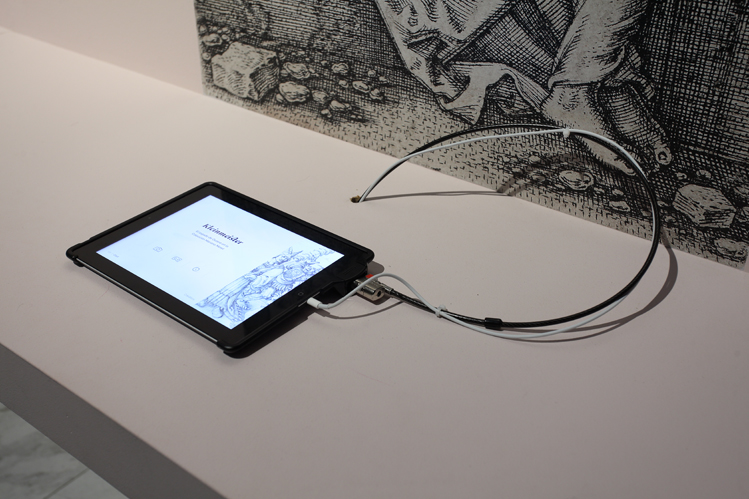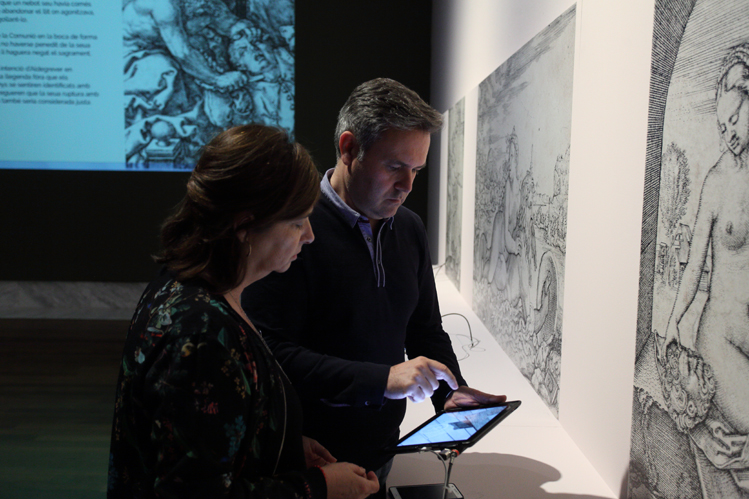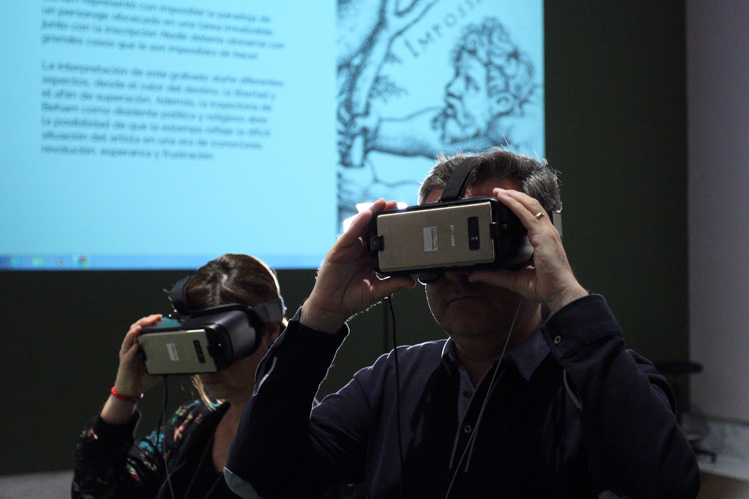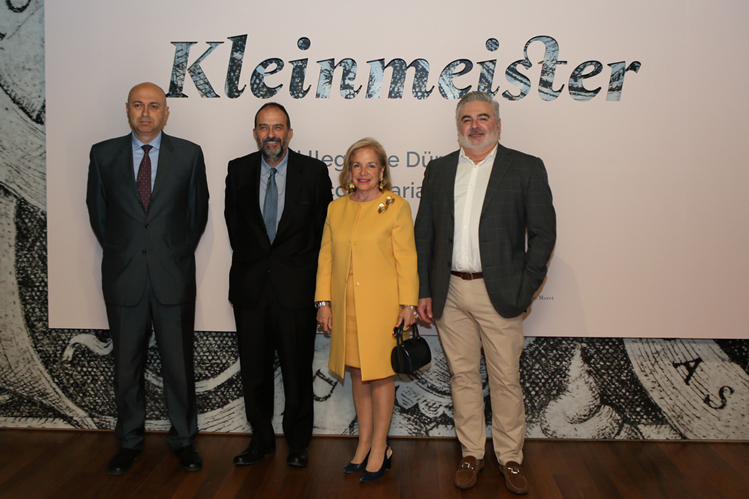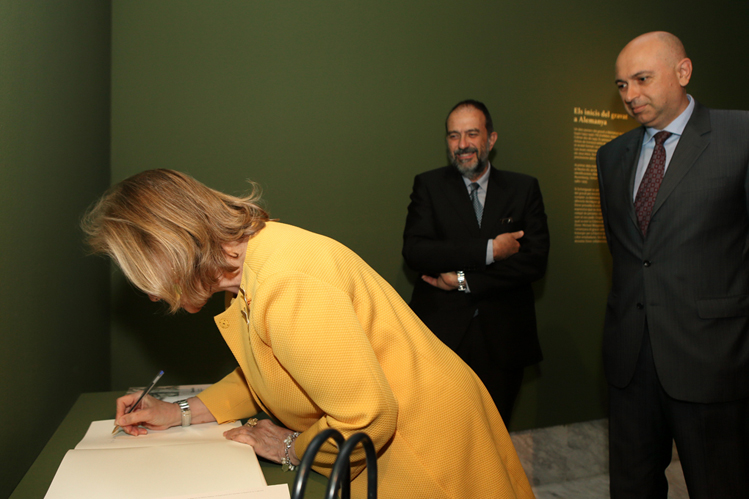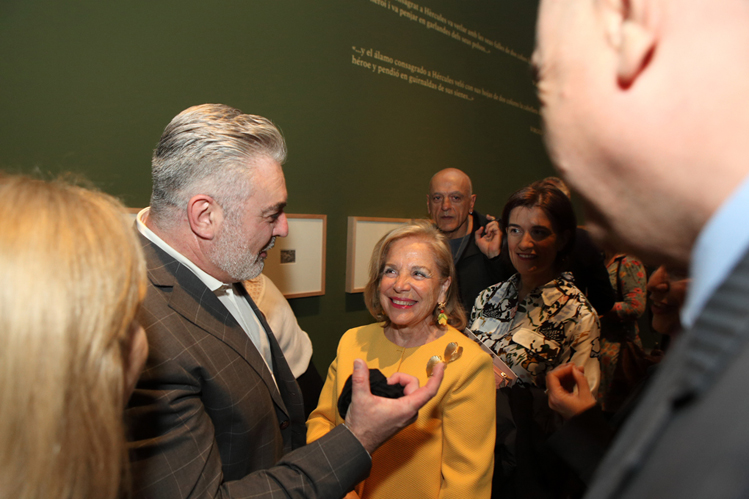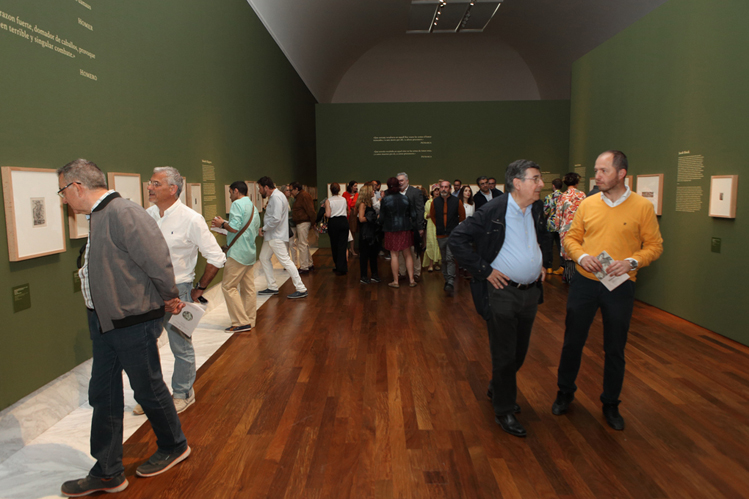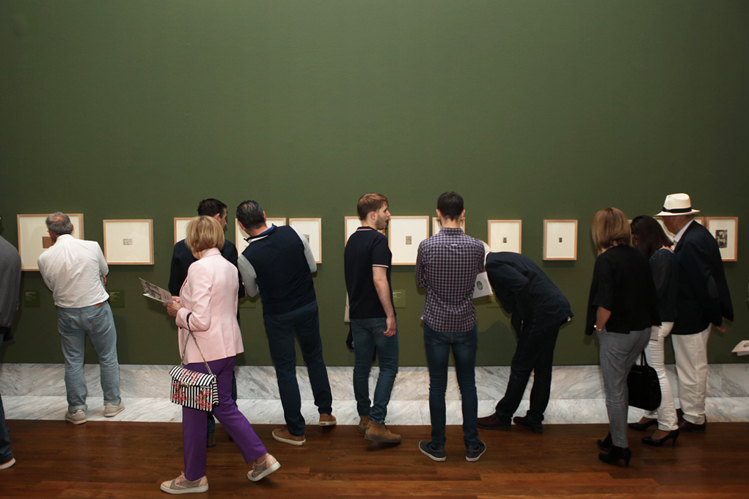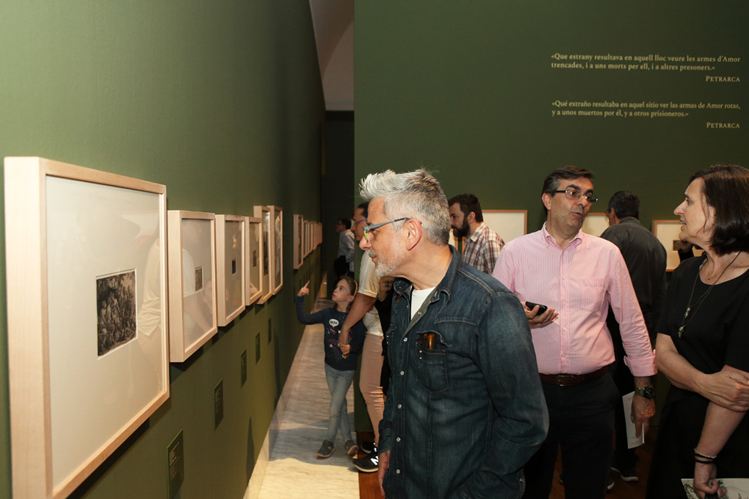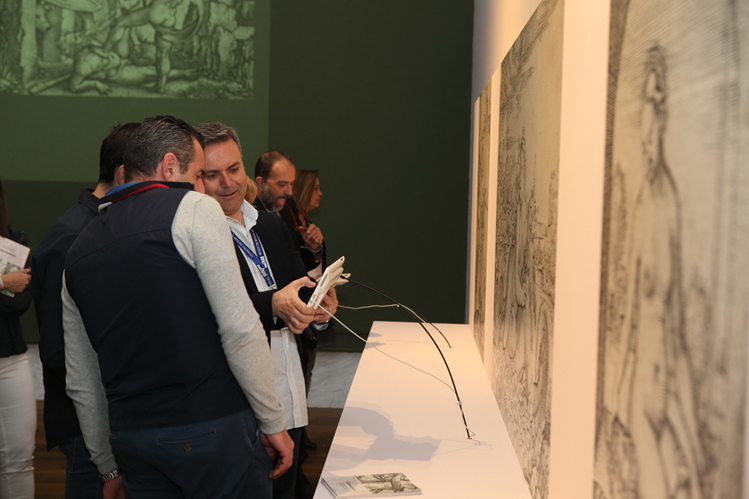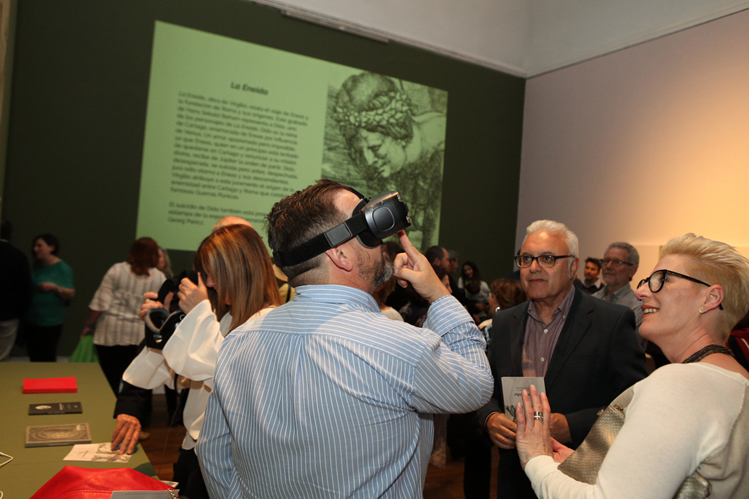
- The collection
-
Works
-
German prints
- Monogrammist AG
- Michael Wolgemut
- Martin Schongauer
- Daniel Hopfer
- Albrecht Altdorfer
- Hieronymus Hopfer
- Lambrecht Hopfer
- Monogrammist HL
- Jacob Binck
- Sebald Beham
- Barthel Beham
- Georg Pencz
- Heinrich Aldegrever
- Virgil Solis
- Monogrammist IB
- Monogrammist FG
- Theodor de Bry
- Jost Amman
- Johann Theodor de Bry
- Gilich Kilian Proger
- Monogrammist RDS
- Christoph Jamnitzer
- Paul Flindt
- Adam Fuchs
- Wenceslaus Hollar
- Christoph Schmidt
- Johann Wilhelm Heel
- Christoph Weigel
- Leonhard Heckenauer
- Maria Magdalena Küsel
- Johann Andreas I Pfeffel
- Maria Philippina Küsel
- Gottlieb Herrmann
- Gottfried Stein
- Martin Engelbrecht
- Johann Adam Delsenbach
- Johann Georg Hertel
- Matthäus Herz
- Johann Rudolph Schellenberg
- Balthasar Anton Dunker
- German anonymous c. 1780
- Carl Christian Glassbach
-
Flemish and Dutch prints
- Monogrammist FVB
- Lucas van Leyden
- Master of the Horse Heads
- Allaert Claesz.
- Gerard de Jode
- Hans Bol
- Philips Galle
- Harmen Jansz. Muller
- Johannes van Doetecum the Elder
- Lucas van Doetecum
- Hendrik Goltzius
- Arent van Bolten
- Jan Saenredam
- Adriaen Muntinck
- Nicolaas de Bruyn
- Jan Harmensz. Muller
- Jacob Hoefnagel
- Hendrik Hondius I
- Pierre Firens
- Jean Valdor the Elder
- Christoffel van Sichem III
- Willem Panneels
- Hans Janssen
- Theodoor van Thulden
- Michael Hayé
- Quirin Boel
- Dutch anonymous, c. 1650
- Jan de Bisschop
- Frederick de Witt
- Pieter Schenk I
- Gerrit Visscher
- Dutch anonymous, 1728
-
Italian prints
- Andrea Mantegna
- Jacopo de'Barbari
- Giovanni Antonio da Brescia
- Marcantonio Raimondi
- Agostino Veneziano
- Giovanni Jacopo Caraglio
- Battista Franco, il Samolei
- Enea Vico
- Monogrammist AP
- Antonio Tempesta
- Giovanni Andrea Maglioli
- Cherubino Alberti
- Italian anonymous, c. 1585
- Italian anonymous, c. 1591-1690
- Francesco Villamena
- Cesare Domenichi
- Odoardo Fialetti
- Giuseppe Caletti, il Cremonese
- Stefano della Bella
- Giovanni Battista Galestruzzi
- Pietro Santi Bartoli
- Girolamo Ferroni
- Francesco Bartolozzi
- Giovanni Folo
- Bartolomeo Pinelli
-
French prints
- Étienne Delaune
- René Boyvin
- Pierre Milan
- Jean Toutin
- Michel Lasne
- Antoine Jacquard
- Jacques Callot
- François Perrier le Bourguignon
- Jean de Saint-Igny
- Monogramist BL
- Louis Ferdinand Elle l'Aîné
- François Chauveau
- Jean Lepautre
- Jean Vauquer
- François de Poilly the Elder
- Paul Androuet du Cerceau
- Jean-Baptiste Monnoyer
- Jean Papillon the Elder
- Joseph Parrocel
- Étienne Gantrel
- Bernard Picart
- Nicolas Chasteau
- Jean Bourguet
- Anne Claude Philippe de Tubières, Comte de Caylus
- Claude Augustin Duflos
- Jean Baptiste Guelard
- Jacques Saly
- Gilles Demarteau
- French anonymous, c. 1750
- Pierre Demachy
- Juste-François Boucher
- Philippe Louis Parizeau
- Jean Démosthène Dugourc
- Henri Marais
- Alexis François Girard
- Spanish prints
- Ornament
- Weibermacht
- Emblemata / Alba Amicorum
- Vanitas / Memento Mori
- The 70 faces of Bruegel
- Buffoons & Jesters
-
German prints
- Exhibitions
- Publications
- News
- Commented works
"L’exposition se distingue par une mise en regard originale entre estampes et antiquités, les figures rouges sur fond noir des vases grecs dialoguant avec les gravures."
.- Eugène Dutuit, Trésors en noir & blanc, Paris, Palais de l’Industrie, 1869
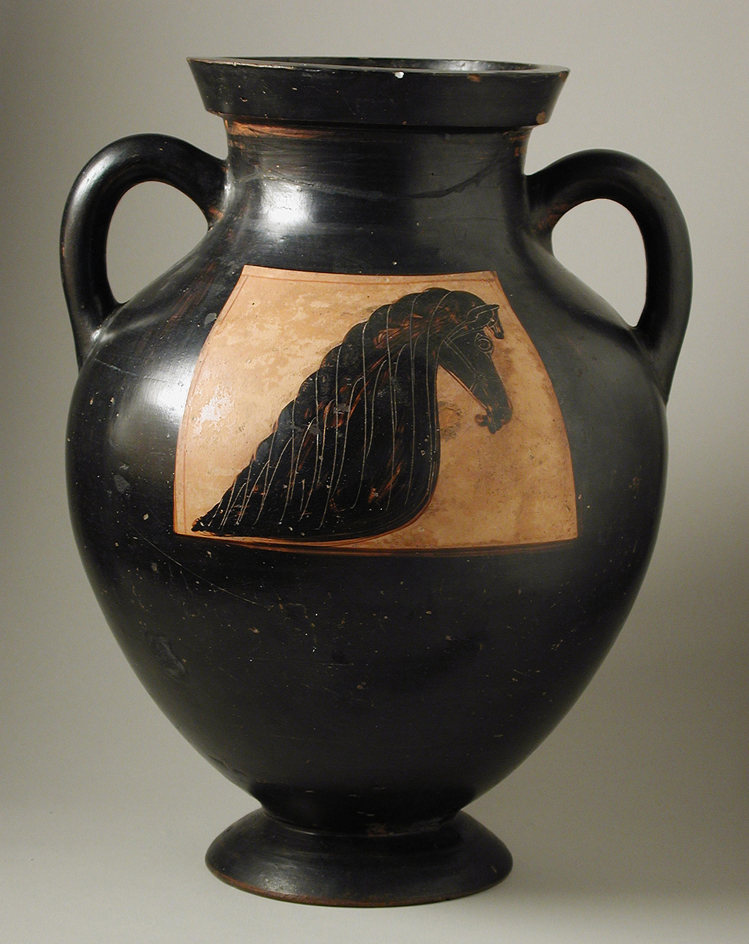 Attributed to the Painter of the Syracuse Horse-Head. Attic Black-figure Amphora with a Horse's Head on Both Sides. Greece, Athens, circa mid-6th century B.C. LACMA Los Angeles County Museum of Art
Attributed to the Painter of the Syracuse Horse-Head. Attic Black-figure Amphora with a Horse's Head on Both Sides. Greece, Athens, circa mid-6th century B.C. LACMA Los Angeles County Museum of Art 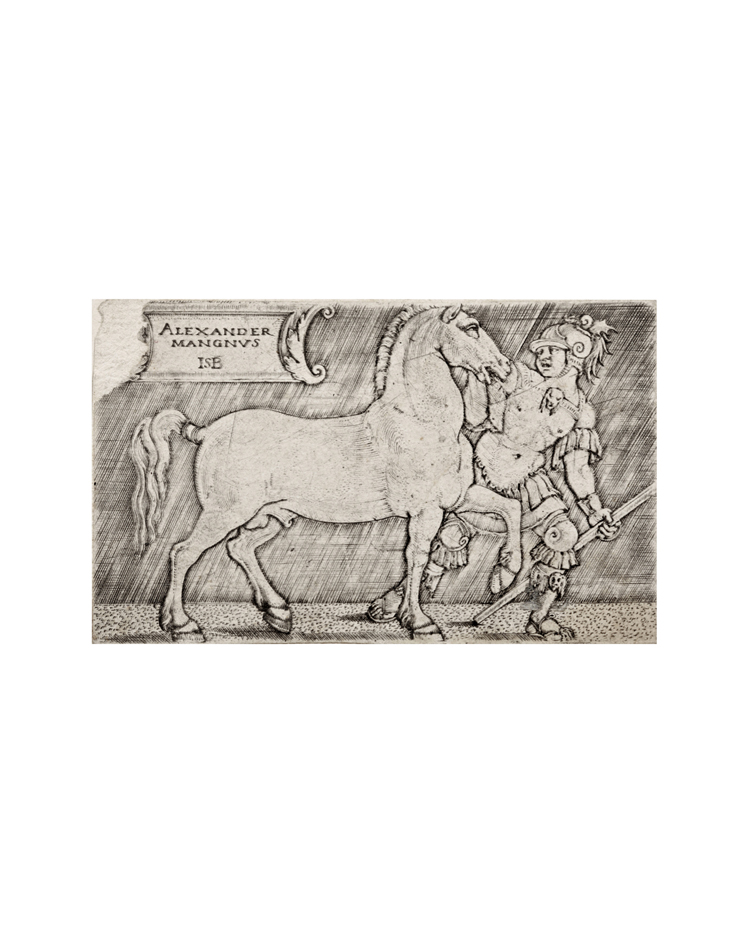 Sebald Beham. Alexander the Great. Engraving, c.1531–1550. Colección Mariano Moret ___________________________________________________________________________________________________________ THEME & VARIATIONS: MAISTER LUCAS DER IN KUPFER STICH As early as 1521 Albrecht Dürer called Lucas van Leyden ‘Maister Lucas der in Kupfer sticht’.
Sebald Beham. Alexander the Great. Engraving, c.1531–1550. Colección Mariano Moret ___________________________________________________________________________________________________________ THEME & VARIATIONS: MAISTER LUCAS DER IN KUPFER STICH As early as 1521 Albrecht Dürer called Lucas van Leyden ‘Maister Lucas der in Kupfer sticht’. 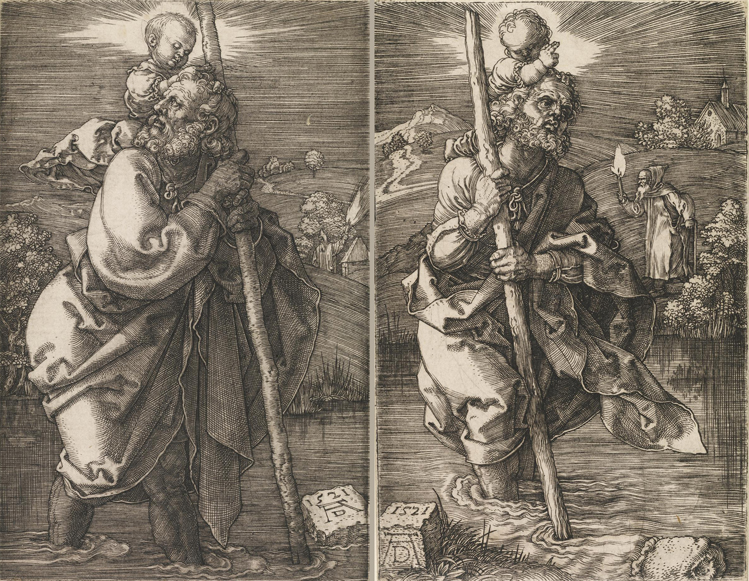 Albrecht Dürer. St Christopher facing left. Engraving, 1521. The British Museum Albrecht Dürer. St Christopher facing right. Engraving, 1521. The British Museum
Albrecht Dürer. St Christopher facing left. Engraving, 1521. The British Museum Albrecht Dürer. St Christopher facing right. Engraving, 1521. The British Museum 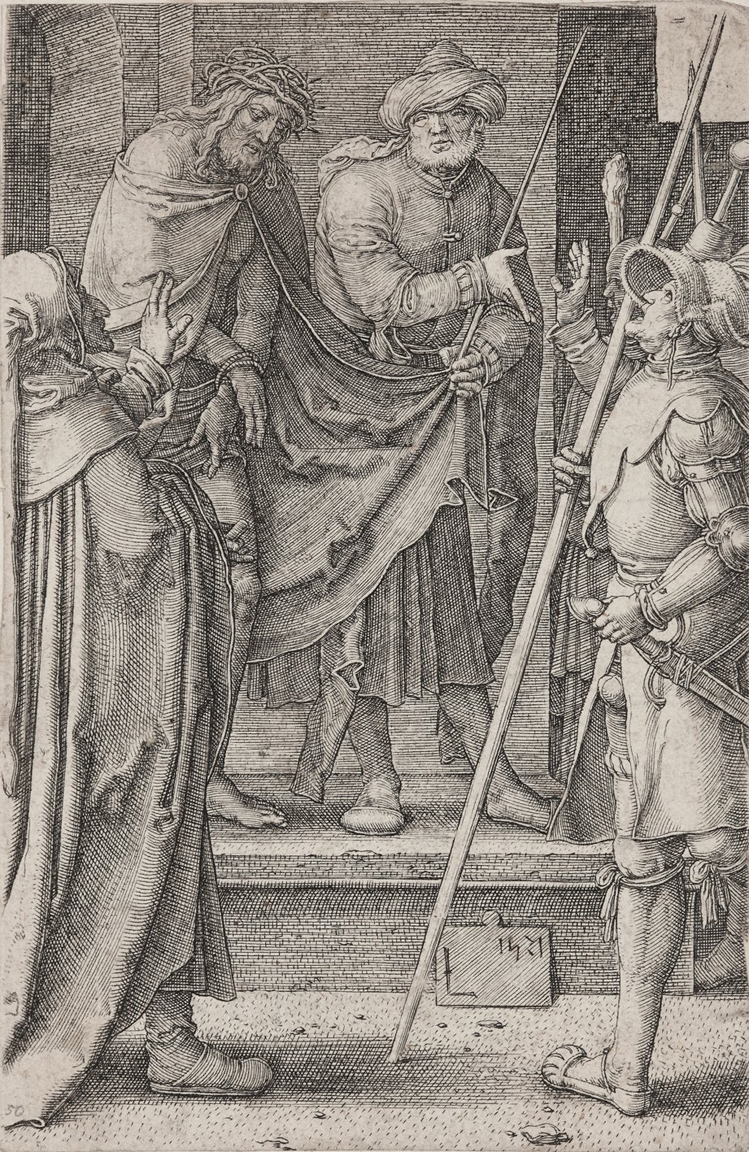 Lucas van Leyden. Ecce Homo. Engraving, 1521. Colección Mariano Moret ___________________________________________________________________________________________________________ THEME & VARIATIONS: THE FEAST OF HEROD
Lucas van Leyden. Ecce Homo. Engraving, 1521. Colección Mariano Moret ___________________________________________________________________________________________________________ THEME & VARIATIONS: THE FEAST OF HEROD 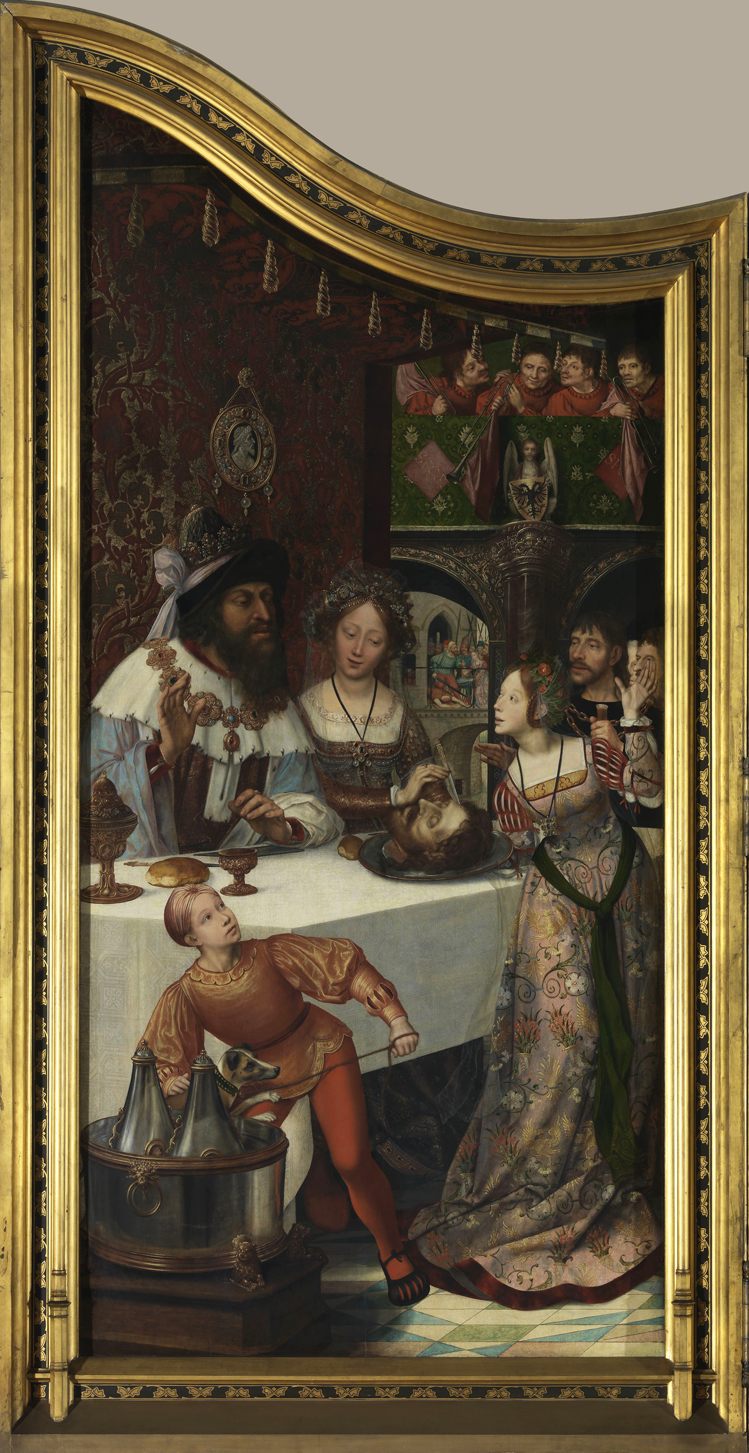 Quentin Metsys. The Feast of Herod. Oil on panel, 1511. Koninklijk Museum voor Schone Kunsten Antwerpen
Quentin Metsys. The Feast of Herod. Oil on panel, 1511. Koninklijk Museum voor Schone Kunsten Antwerpen 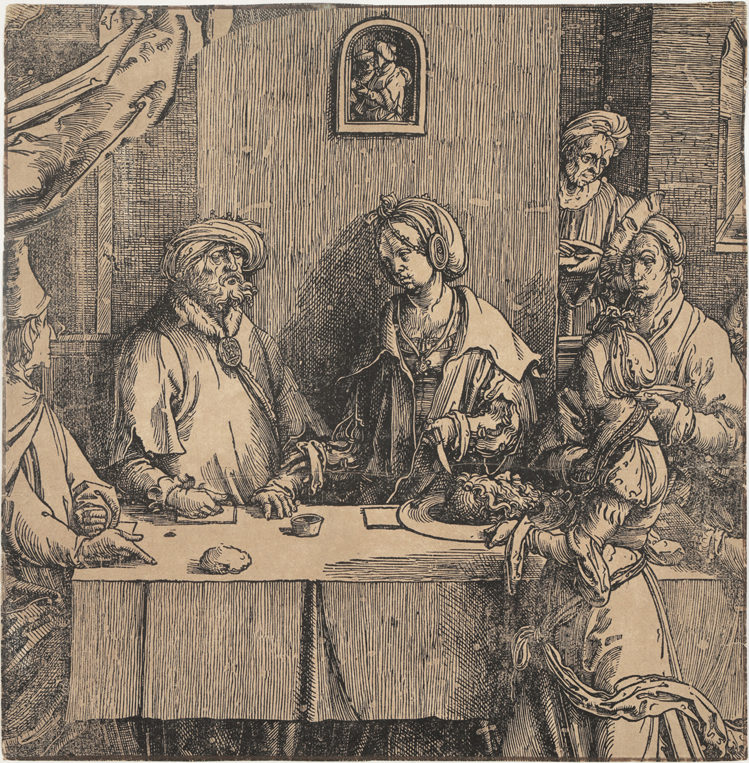 Lucas van Leyden. The Feast of Herod. Woodcut, 1514. Colección Mariano Moret ___________________________________________________________________________________________________________ THEME & VARIATIONS: IHS VERSUS YLE
Lucas van Leyden. The Feast of Herod. Woodcut, 1514. Colección Mariano Moret ___________________________________________________________________________________________________________ THEME & VARIATIONS: IHS VERSUS YLE 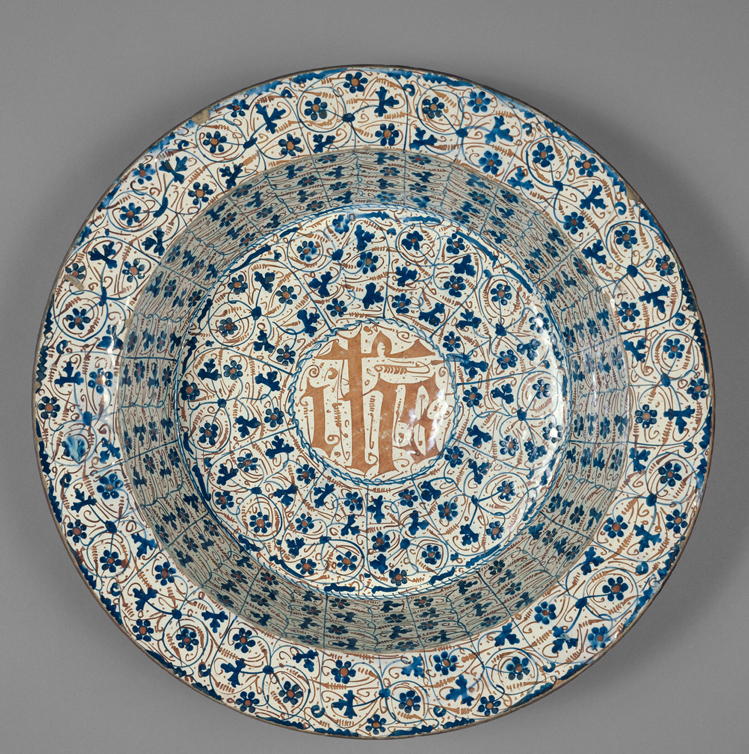 Hispano-Moresque Basin (Bací gran) inscribed with the monogram IHS (Iesus Hominum Salvator). Tin-glazed earthenware with copper luster. Manises or Paterna (Valencia), c. 1450. Getty Museum
Hispano-Moresque Basin (Bací gran) inscribed with the monogram IHS (Iesus Hominum Salvator). Tin-glazed earthenware with copper luster. Manises or Paterna (Valencia), c. 1450. Getty Museum 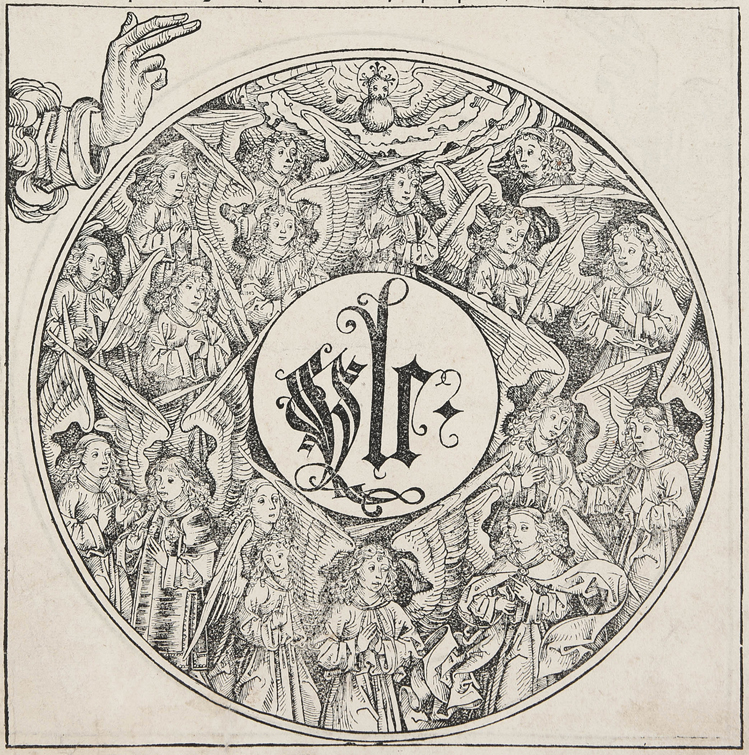 Michael Wolgemut. The Heavenly Chorus. Woodcut, 1493. Liber Chronicarum. Folio II (recto). Colección Mariano Moret ___________________________________________________________________________________________________________ THEME & VARIATIONS: VAN STALBENT THINKING ON CALETTI
Michael Wolgemut. The Heavenly Chorus. Woodcut, 1493. Liber Chronicarum. Folio II (recto). Colección Mariano Moret ___________________________________________________________________________________________________________ THEME & VARIATIONS: VAN STALBENT THINKING ON CALETTI 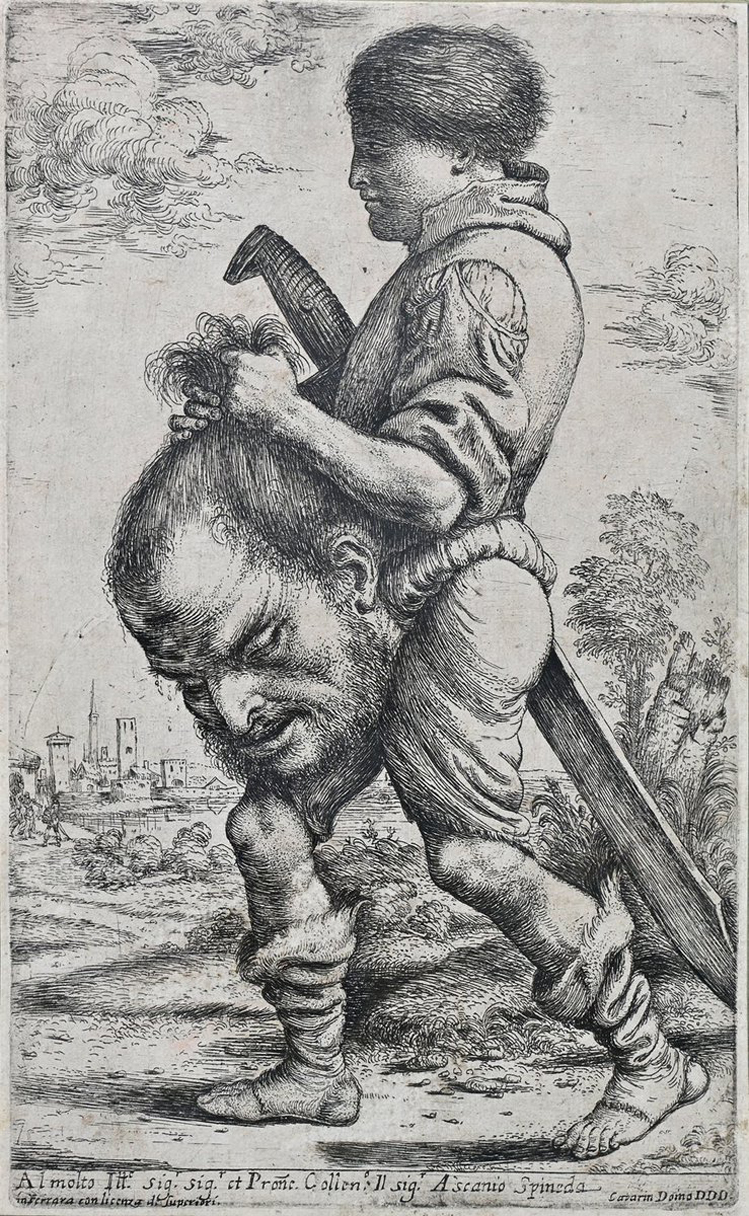 Giuseppe Caletti il Cremonese. David carrying the head of Goliath. Etching, c. 1620. Colección Mariano Moret
Giuseppe Caletti il Cremonese. David carrying the head of Goliath. Etching, c. 1620. Colección Mariano Moret 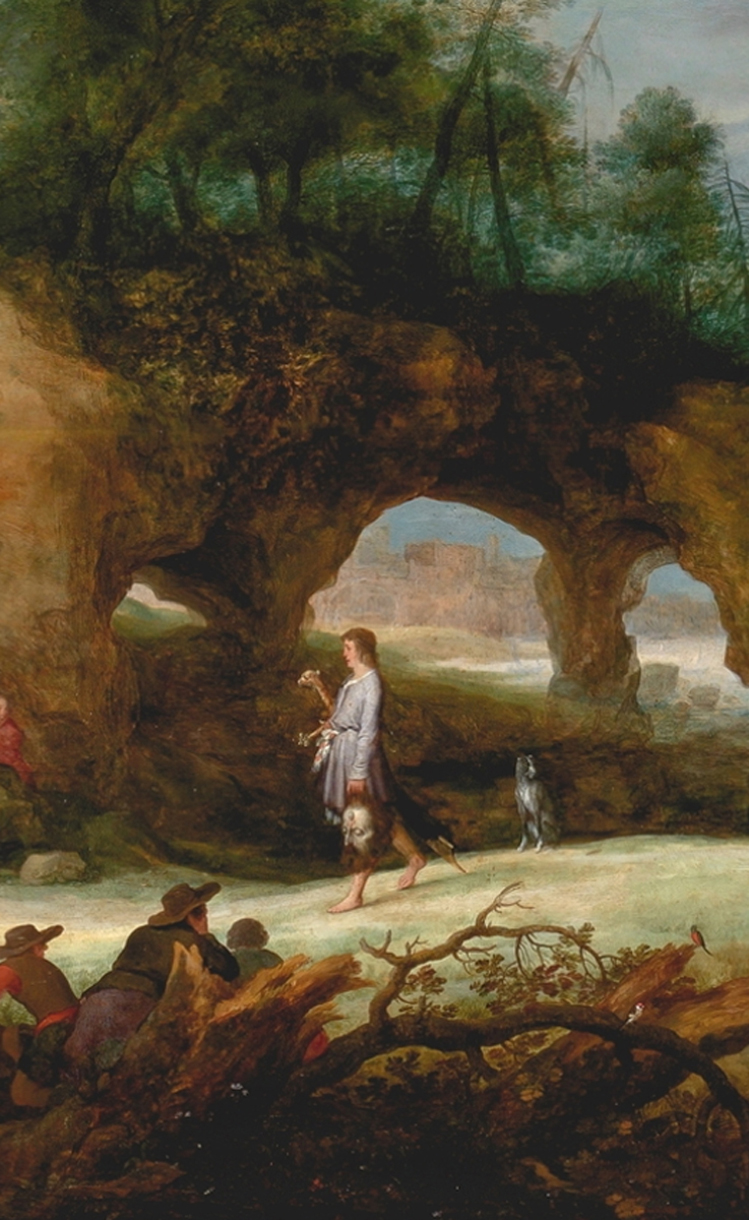
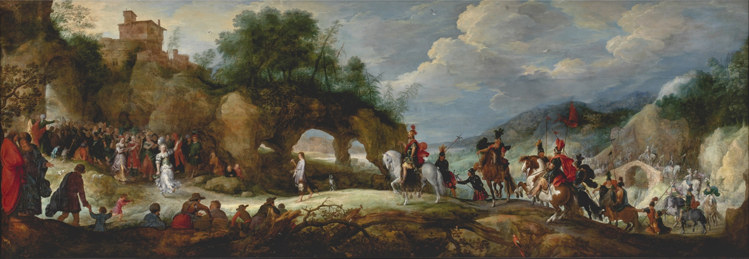 Adriaen van Stalbent & Pieter Brueghel the Younger. The Triumph of David over Goliath. Oil on panel, c. 1620. Museo del Prado ___________________________________________________________________________________________________________ THEME & VARIATIONS: CALETTI THINKING ON VAN LEYDEN
Adriaen van Stalbent & Pieter Brueghel the Younger. The Triumph of David over Goliath. Oil on panel, c. 1620. Museo del Prado ___________________________________________________________________________________________________________ THEME & VARIATIONS: CALETTI THINKING ON VAN LEYDEN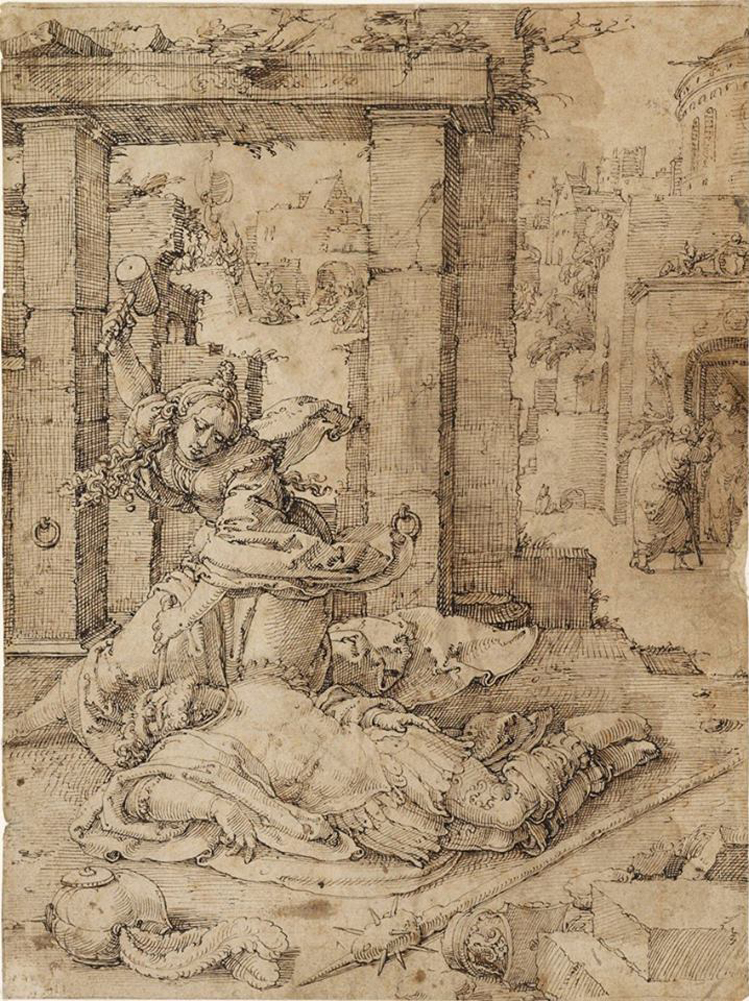 Lucas van Leyden. Jael and Sisera. Pen and brown ink, c. 1520-1525. Museum Boijmans Van Beuningen
Lucas van Leyden. Jael and Sisera. Pen and brown ink, c. 1520-1525. Museum Boijmans Van Beuningen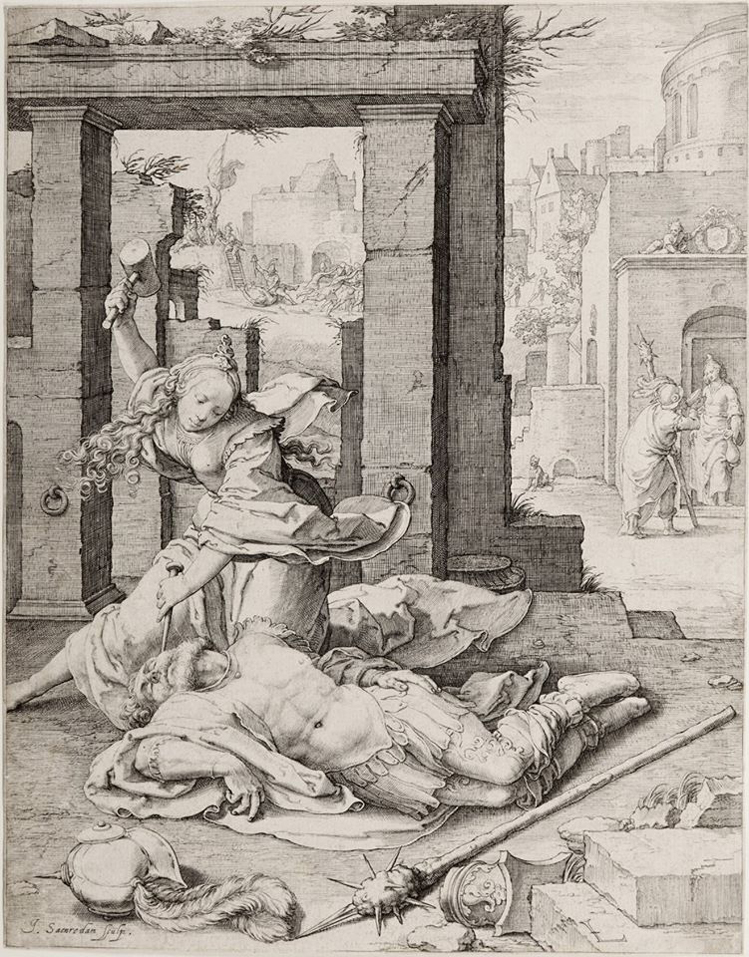 Jan Saenredam, after Lucas van Leyden. Jael and Sisera. Engraving, c. 1600. Colección Mariano Moret
Jan Saenredam, after Lucas van Leyden. Jael and Sisera. Engraving, c. 1600. Colección Mariano Moret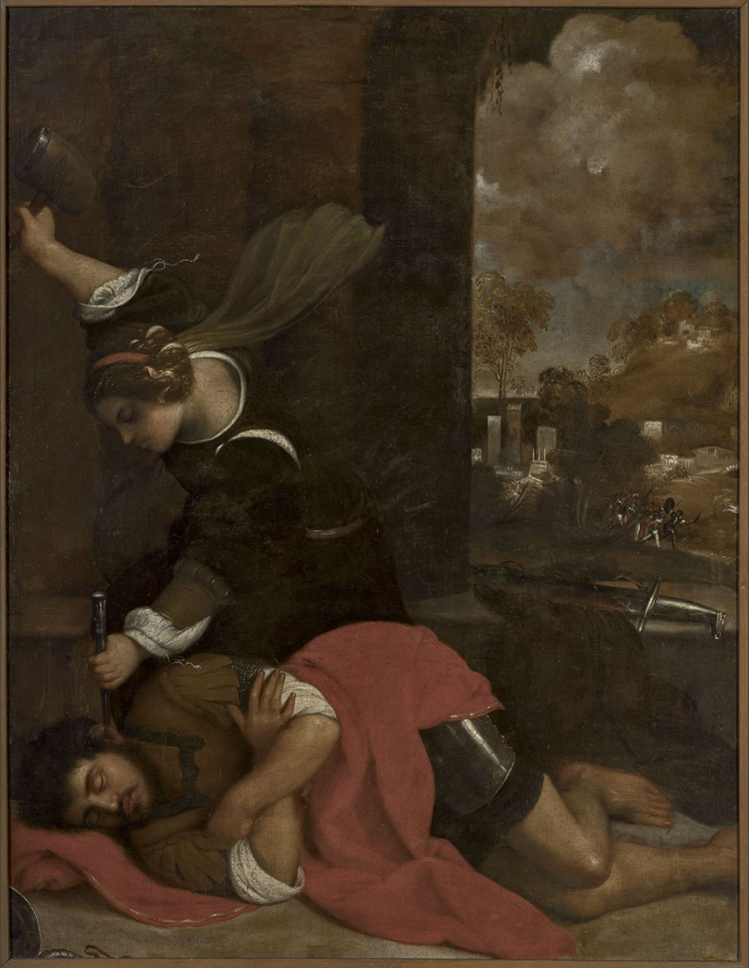 Giuseppe Maria Caletti il Cremonese. Jael and Sisera. Oil on canvas, c. 1630. Gallerie Estensi
Giuseppe Maria Caletti il Cremonese. Jael and Sisera. Oil on canvas, c. 1630. Gallerie Estensi___________________________________________________________________________________________________________ THEME & VARIATIONS: THE CREATION OF THE WORLD
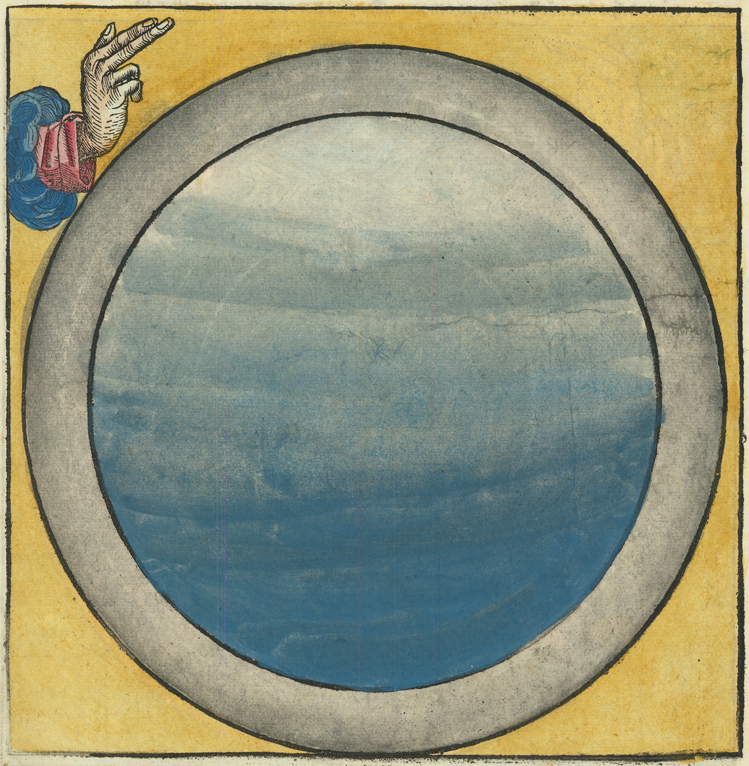 Michael Wolgemut. The First Day of the Creation of the World. Hand coloured woodcut, 1493. Colección Mariano Moret
Michael Wolgemut. The First Day of the Creation of the World. Hand coloured woodcut, 1493. Colección Mariano Moret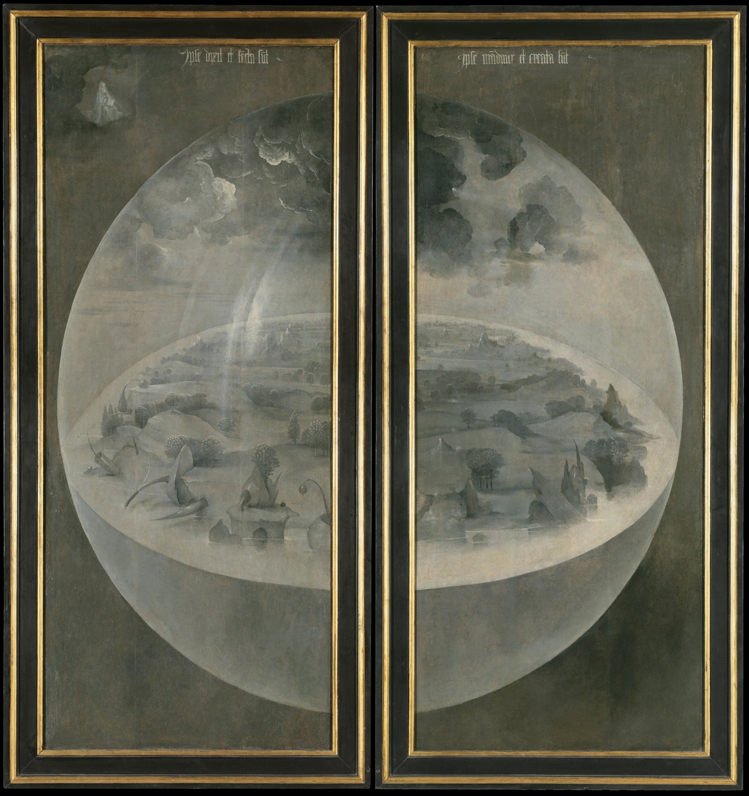 Hieronymus Bosch. The Third Day of the Creation of the World. (The Garden of Earthly Delights Triptych). Oil on oak panel, c. 1490-1500. Museo del Prado
Hieronymus Bosch. The Third Day of the Creation of the World. (The Garden of Earthly Delights Triptych). Oil on oak panel, c. 1490-1500. Museo del Prado_____________________________________________________________________________________________
THEME & VARIATIONS: MEDUSA
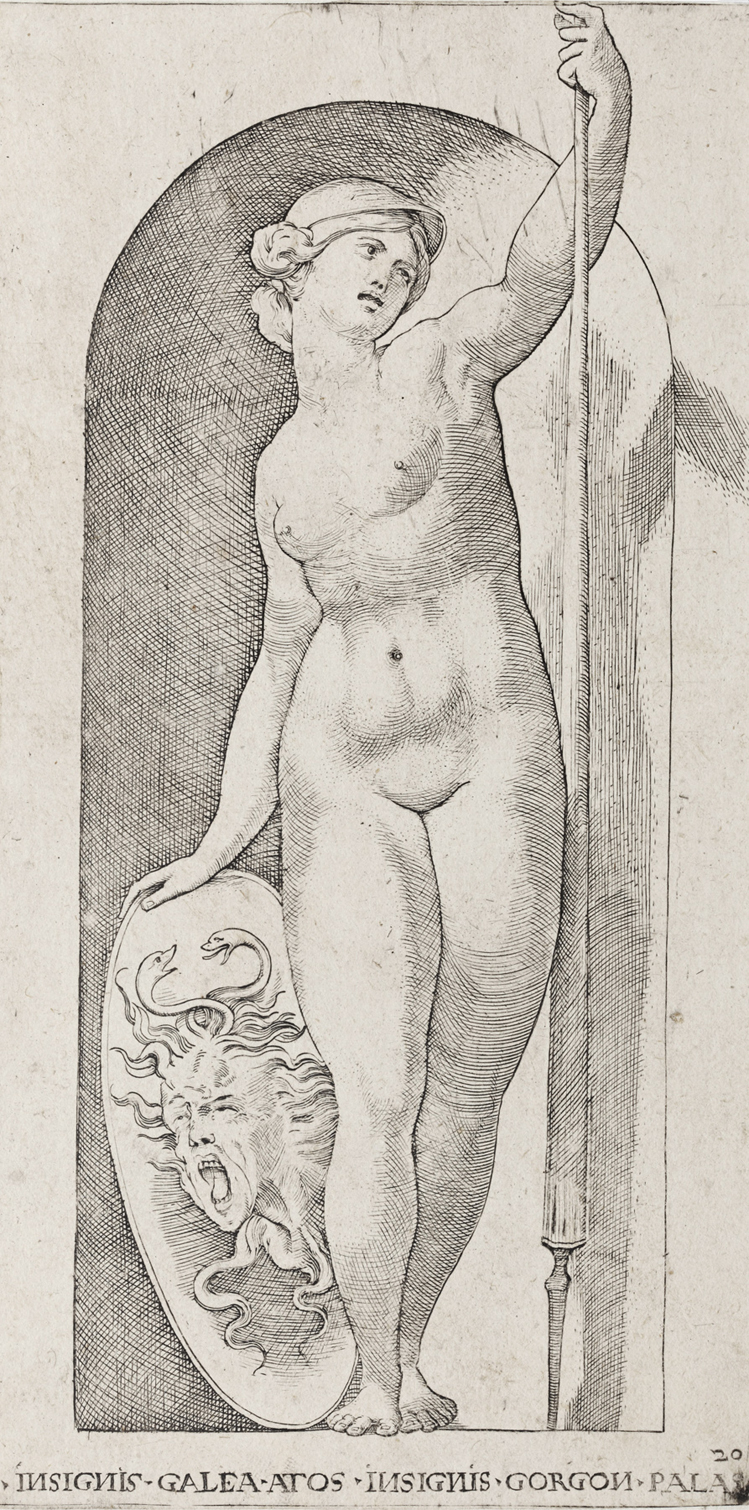 Jacob Binck, after Rosso Fiorentino. Pallas Athena. Buril, 1530. Colección Mariano Moret
Jacob Binck, after Rosso Fiorentino. Pallas Athena. Buril, 1530. Colección Mariano Moret 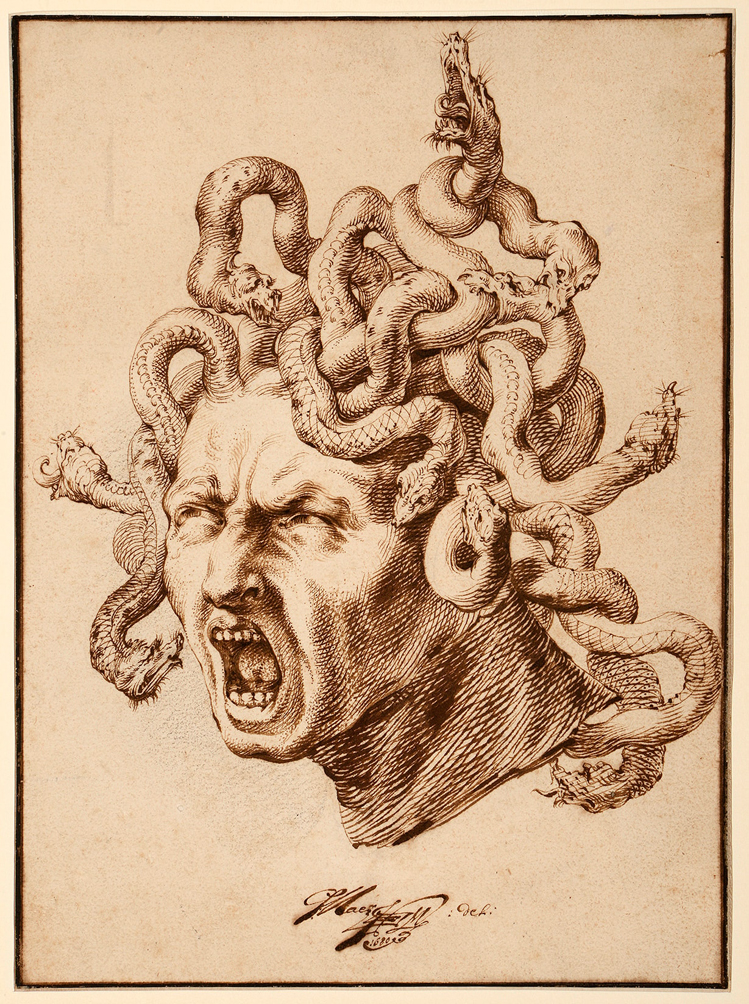 Godfried Maes. The head of Medusa. Pen and brown ink, with traces of black chalk, within framing lines in brown ink, 1680. Stephen Ongpin Fine Art _____________________________________________________________________________________________ THEME & VARIATIONS: LA MUSIQUE PHILIS
Godfried Maes. The head of Medusa. Pen and brown ink, with traces of black chalk, within framing lines in brown ink, 1680. Stephen Ongpin Fine Art _____________________________________________________________________________________________ THEME & VARIATIONS: LA MUSIQUE PHILIS 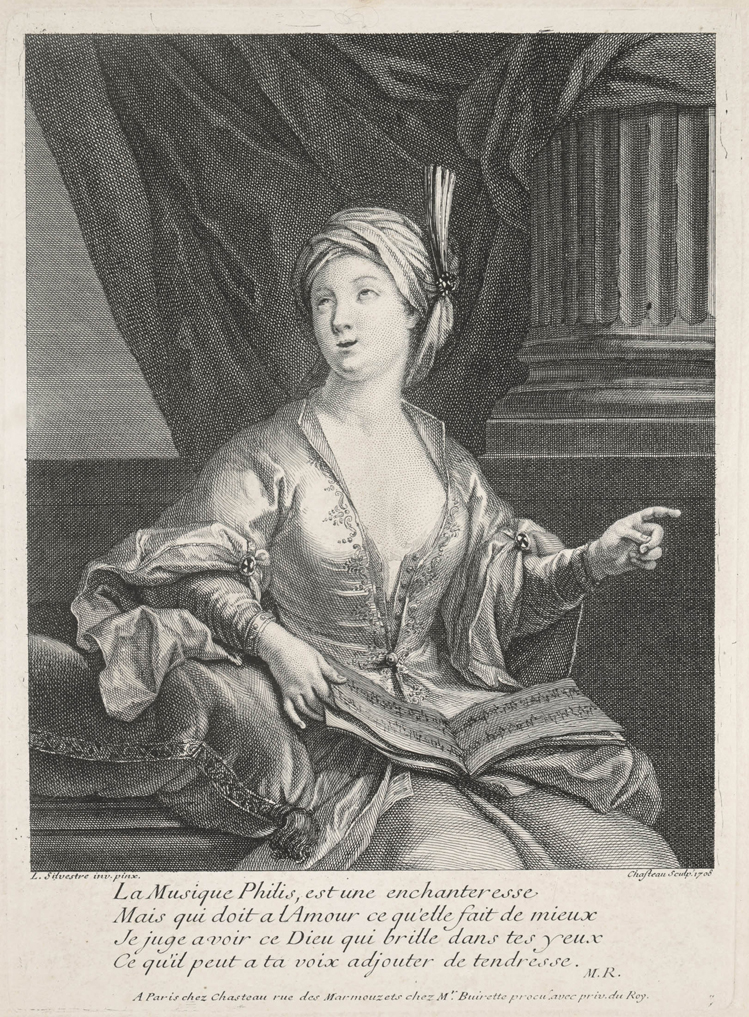 Nicolas Chasteau. La Musique Philis. Etching and stipple (Opus Mallei), 1708. Colección Mariano Moret
Nicolas Chasteau. La Musique Philis. Etching and stipple (Opus Mallei), 1708. Colección Mariano Moret 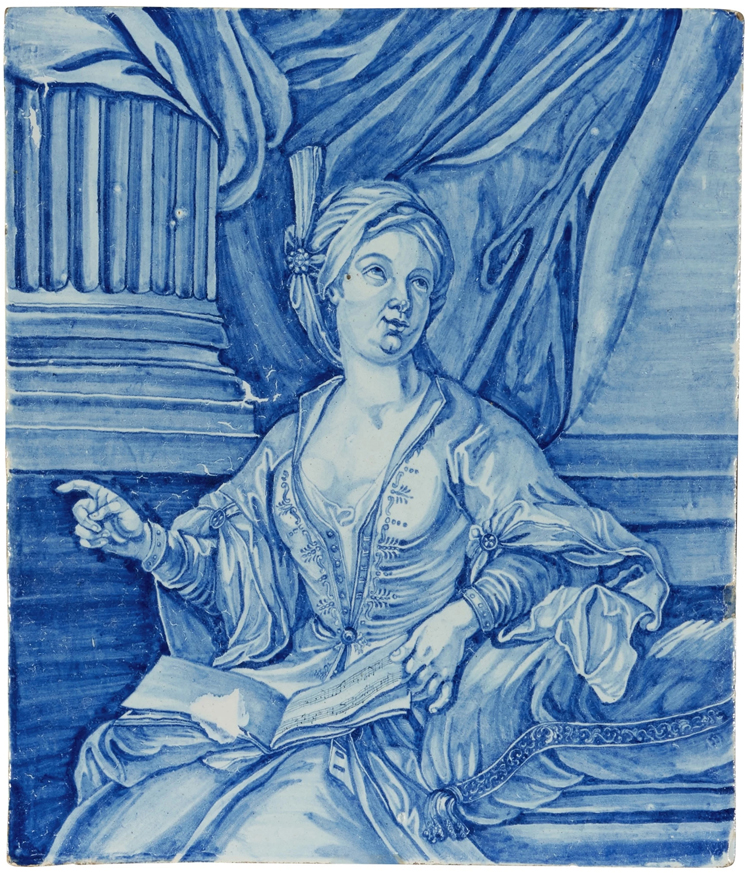 Dutch Delft Blue and White rectangular plaque of a Lady, c. 1750-1770. Aso O. Tavitian collection. Sotheby's ___________________________________________________________________________________________________________ THEME & VARIATIONS: COLD ROCK
Dutch Delft Blue and White rectangular plaque of a Lady, c. 1750-1770. Aso O. Tavitian collection. Sotheby's ___________________________________________________________________________________________________________ THEME & VARIATIONS: COLD ROCK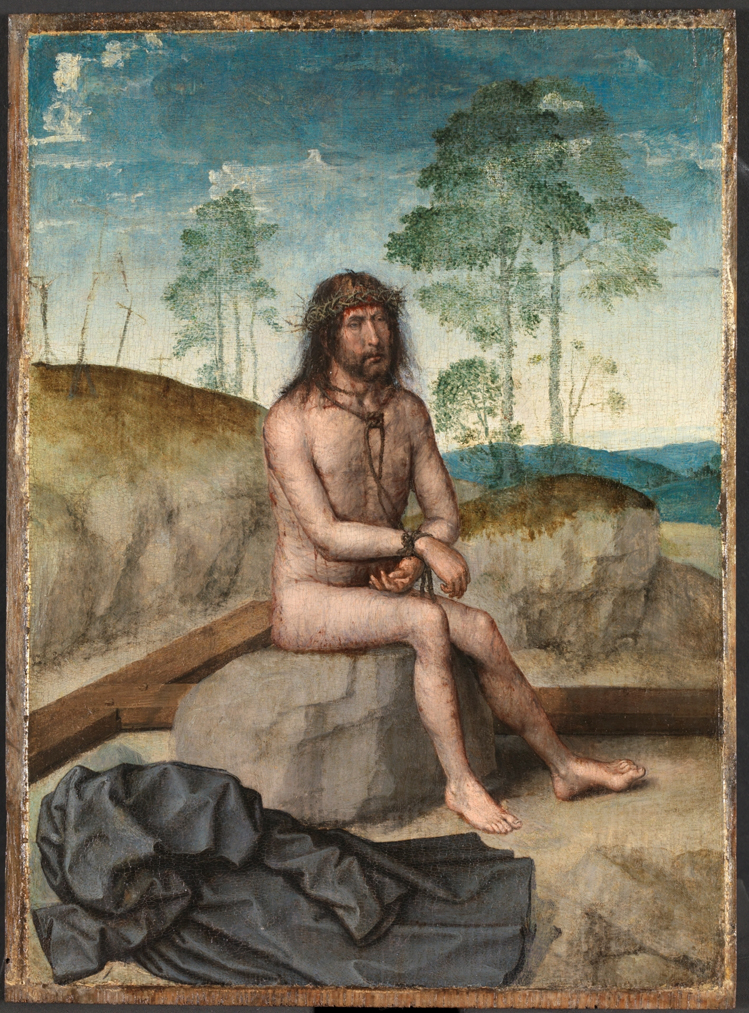 Juan de Flandes. Christ Seated on a Cold Rock. Oil on panel, 1496-1497. Museo del Prado
Juan de Flandes. Christ Seated on a Cold Rock. Oil on panel, 1496-1497. Museo del Prado 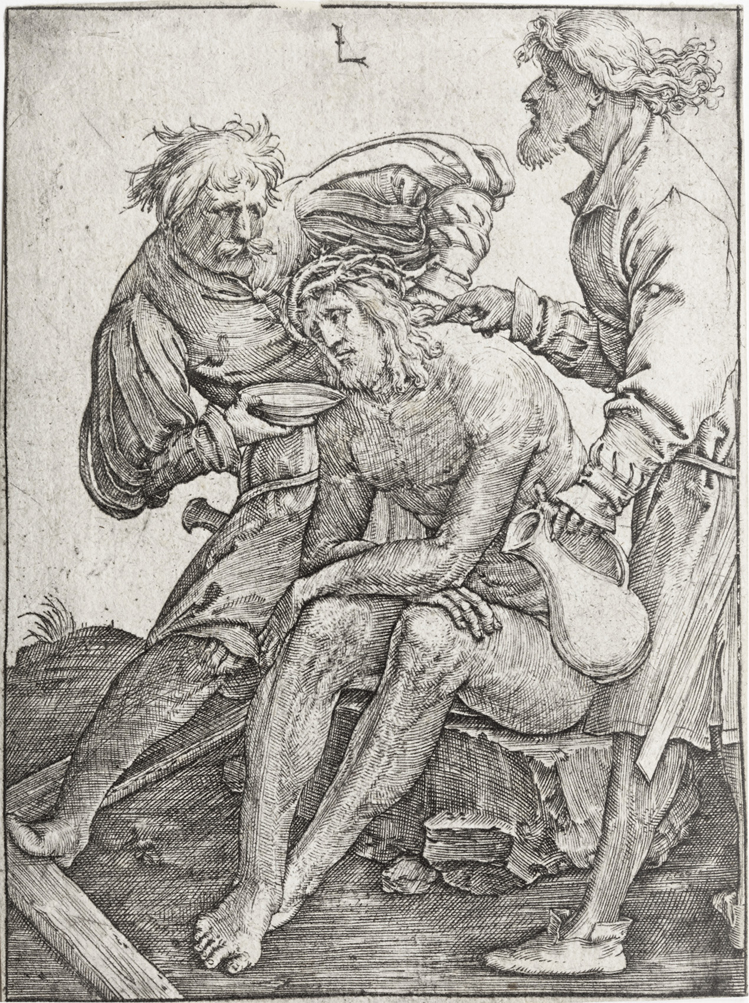 Lucas van Leyden. Soldiers giving Christ drink. Engraving, c. 1512. Colección Mariano Moret
Lucas van Leyden. Soldiers giving Christ drink. Engraving, c. 1512. Colección Mariano Moret 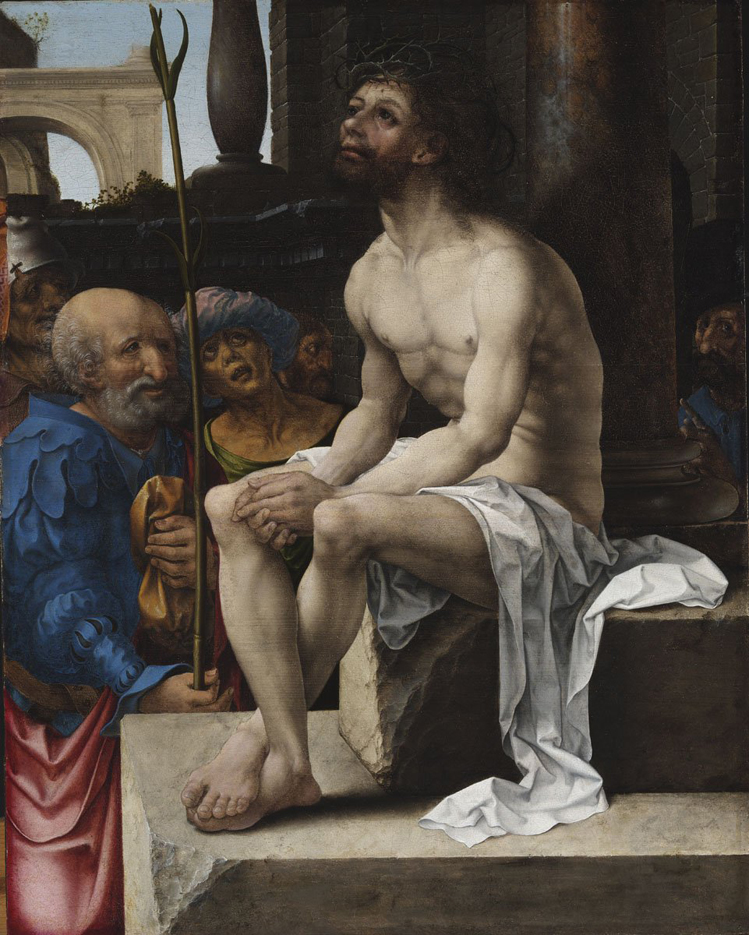 Jan Gossaert. The Mocking of Christ. Oil on panel, 1527. Szépművészeti Múzeum ___________________________________________________________________________________________________________ THEME & VARIATIONS: HORROR VACUI & CHAOS MAGNUM
Jan Gossaert. The Mocking of Christ. Oil on panel, 1527. Szépművészeti Múzeum ___________________________________________________________________________________________________________ THEME & VARIATIONS: HORROR VACUI & CHAOS MAGNUM
"Nel caso di Bosch, ad esempio, oltre al reperimento delle singole iconografie nel cosi detto Inferno musicale del Giardino delle delizie, occorre far atenzione alla resa di queste all'interno di in un caratteristico horror vacui che è, ovviamente, un richiamo stilistico alla generica tradizion e medioevale, ma allude molto francamente a una delle possibili iconografie dell'Inferno, che è quella del chaos magnum."
.- Caterina Limentani Virdis. Settantamila veli di luce e di ombra
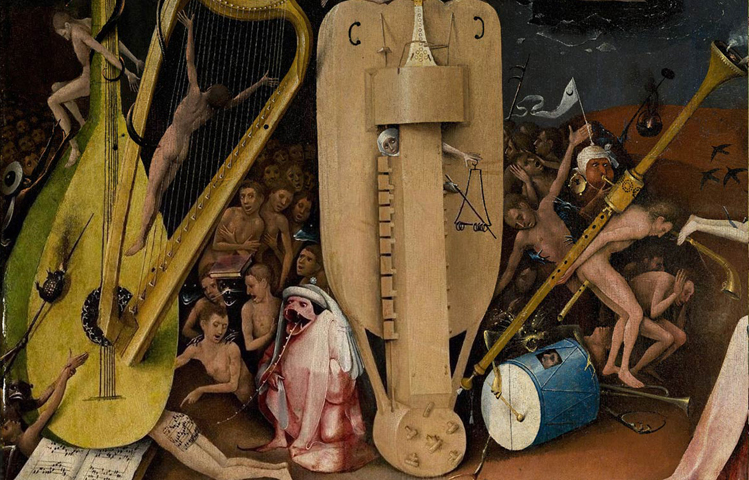 Hieronymus Bosch. Hell (detail). The Garden of Earthly Delights Triptych. Oil on panel, 1490-1500. Museo del Prado
Hieronymus Bosch. Hell (detail). The Garden of Earthly Delights Triptych. Oil on panel, 1490-1500. Museo del Prado 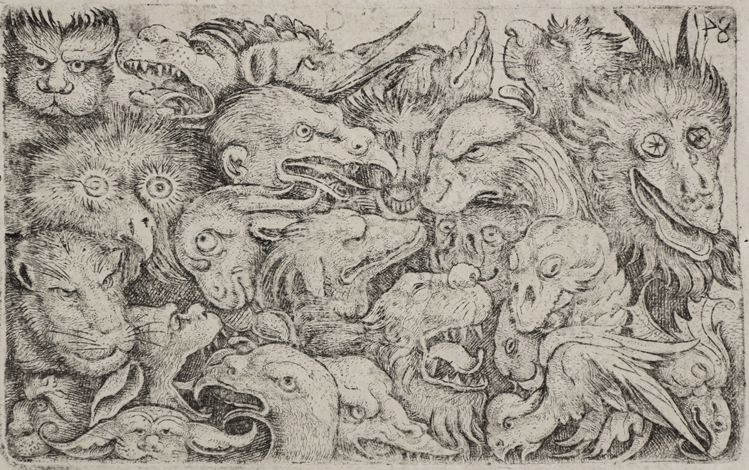 Daniel Hopfer. Heads of grotesque animals. Etching, c. 1505-1536. Colección Mariano Moret ___________________________________________________________________________________________________________ THEME & VARIATIONS: THE ISABELLA D'ESTE SERVICE
Daniel Hopfer. Heads of grotesque animals. Etching, c. 1505-1536. Colección Mariano Moret ___________________________________________________________________________________________________________ THEME & VARIATIONS: THE ISABELLA D'ESTE SERVICE 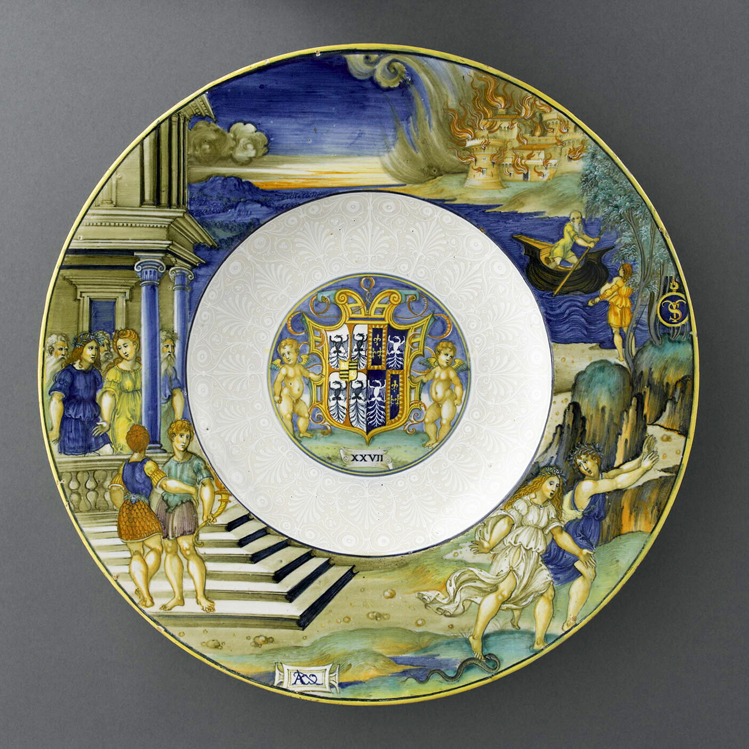
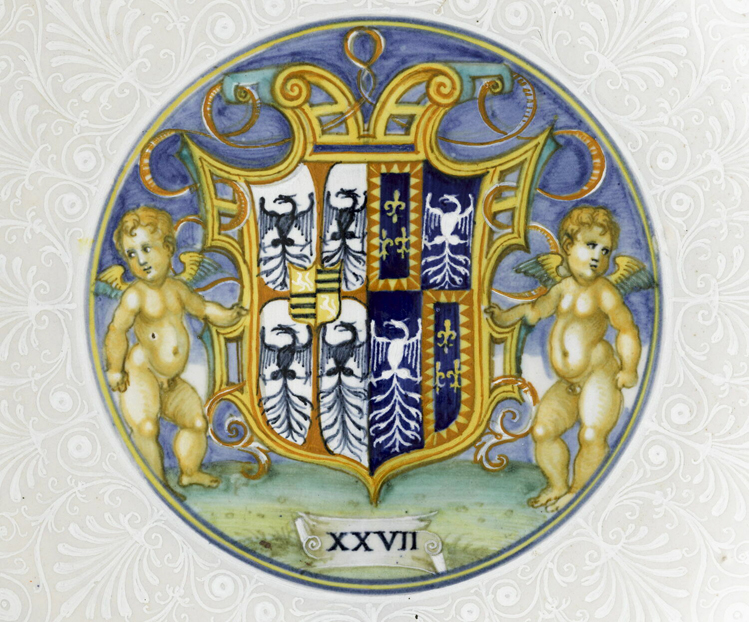 Nicola di Gabriele Sbraghe, Nicola da Urbino. Plate depicting the story of Orpheus and Eurydice. Isabella d'Este service. Tin-glazed earthenware (maiolica), c. 1524. Musée du Louvre
Nicola di Gabriele Sbraghe, Nicola da Urbino. Plate depicting the story of Orpheus and Eurydice. Isabella d'Este service. Tin-glazed earthenware (maiolica), c. 1524. Musée du Louvre 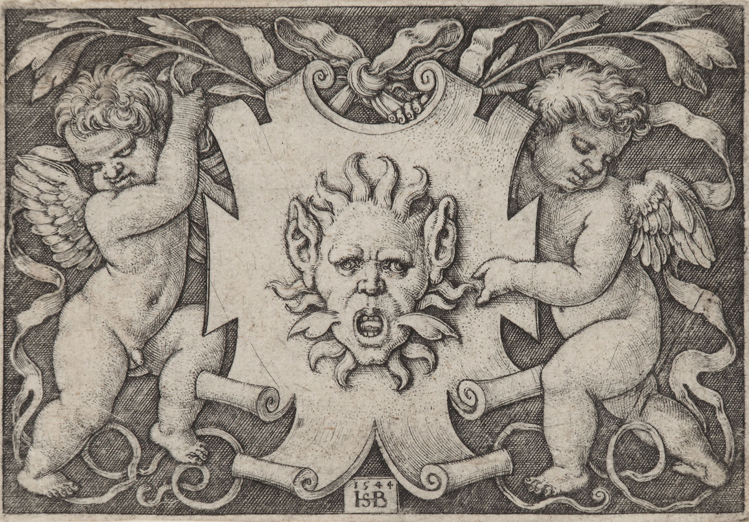 Sebald Beham. A mask on a shield held by two putti. Engraving, 1544. Colección Mariano Moret
Sebald Beham. A mask on a shield held by two putti. Engraving, 1544. Colección Mariano Moret 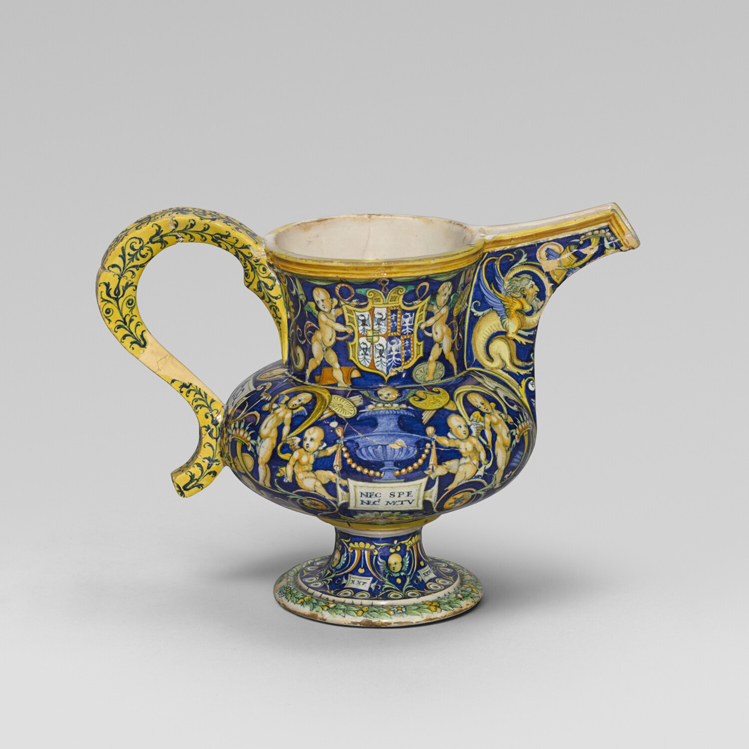
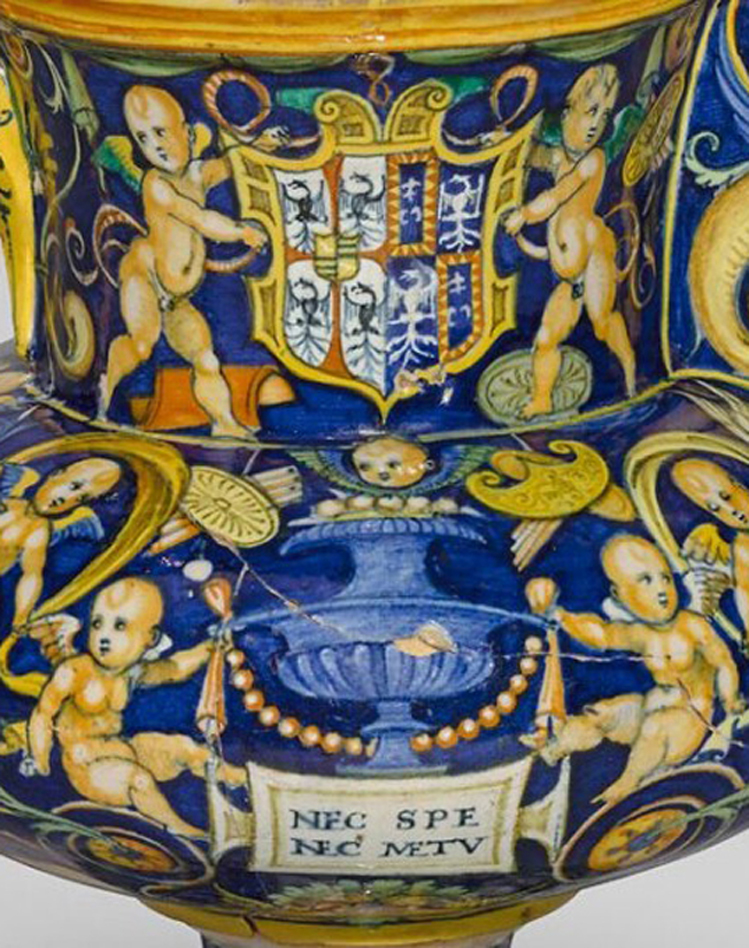 Nicola di Gabriele Sbraghe, Nicola da Urbino. Ewer. Isabella d'Este service. Tin-glazed earthenware (maiolica), c. 1524. Musée du Louvre
Nicola di Gabriele Sbraghe, Nicola da Urbino. Ewer. Isabella d'Este service. Tin-glazed earthenware (maiolica), c. 1524. Musée du Louvre 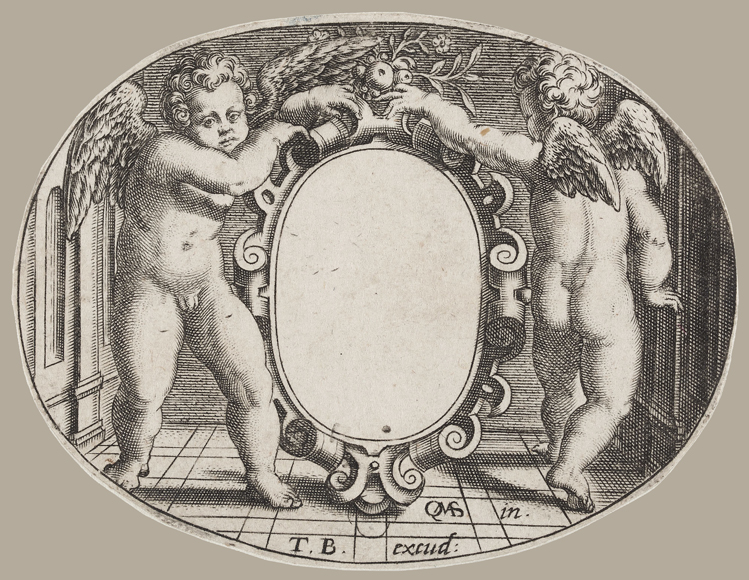 Theodor de Bry. Two putti holding an escutcheon. Engraving, c. 1580-1598. Colección Mariano Moret ___________________________________________________________________________________________________________ THEME & VARIATIONS: IN THE SHADOW OF THE FARNESE HERCULES
Theodor de Bry. Two putti holding an escutcheon. Engraving, c. 1580-1598. Colección Mariano Moret ___________________________________________________________________________________________________________ THEME & VARIATIONS: IN THE SHADOW OF THE FARNESE HERCULES 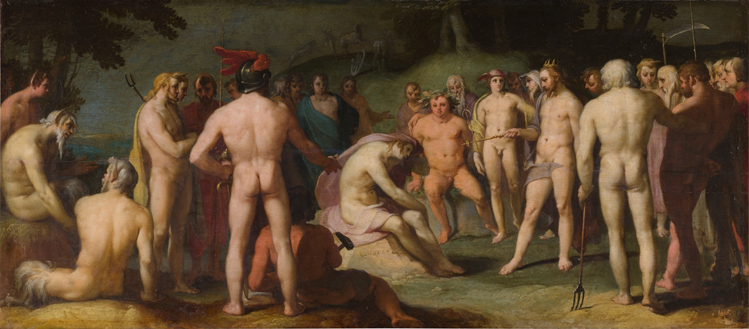 Cornelis Cornelisz van Haarlem. Jupiter and the Gods urging Apollo to take back the Reins of his Chariot. Oil on panel, 1594. Museo del Prado
Cornelis Cornelisz van Haarlem. Jupiter and the Gods urging Apollo to take back the Reins of his Chariot. Oil on panel, 1594. Museo del Prado 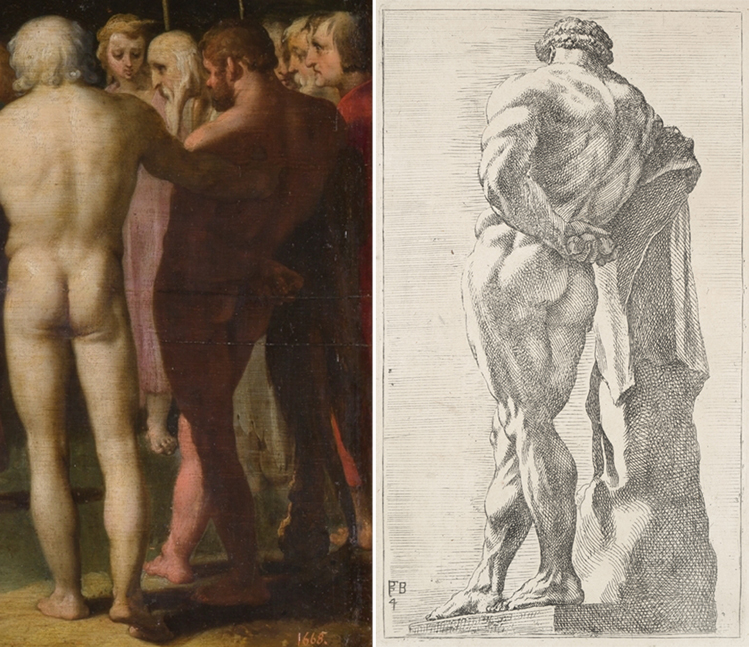 Cornelis Cornelisz van Haarlem. Jupiter and the Gods urging Apollo to take back the Reins of his Chariot (detail). Oil on panel, 1594. Museo del Prado François Perrier, le Bourguignon. The Farnese Hercules, seen from behind. Etching, 1638. Colección Mariano Moret
Cornelis Cornelisz van Haarlem. Jupiter and the Gods urging Apollo to take back the Reins of his Chariot (detail). Oil on panel, 1594. Museo del Prado François Perrier, le Bourguignon. The Farnese Hercules, seen from behind. Etching, 1638. Colección Mariano Moret ___________________________________________________________________________________________________________ THEME & VARIATIONS: CONTRAPPOSTO
"Although it was with the Adam and Eve of 1504 that Dürer chose to demonstrate the new mastery of human figure which he had acquired through studies of human proportion, the influence of his theoretical drawings is also evident in several earlier works (...) and the Standard Bearer all incorporate the classical 'contraposto' attitude which Dürer had acquired by studying copies of the Apollo Belvedere".
.- Dürer in America. Washington, 1971
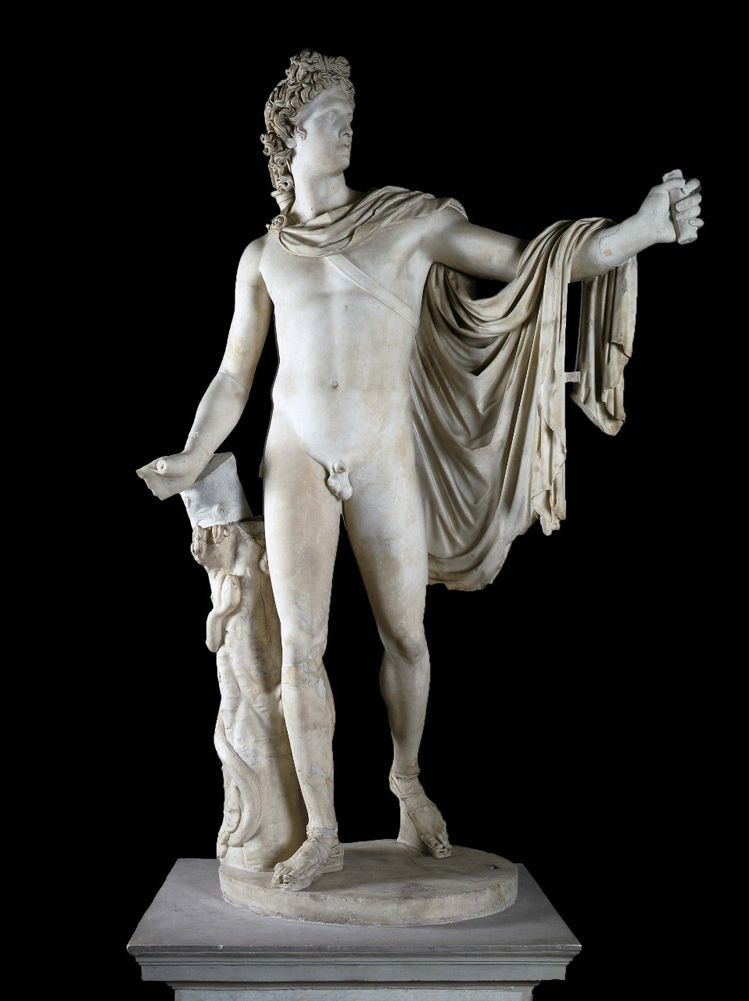 After Leochares. The Apollo Belvedere. White marble, c. 140-120 A.D. Musei Vaticani
After Leochares. The Apollo Belvedere. White marble, c. 140-120 A.D. Musei Vaticani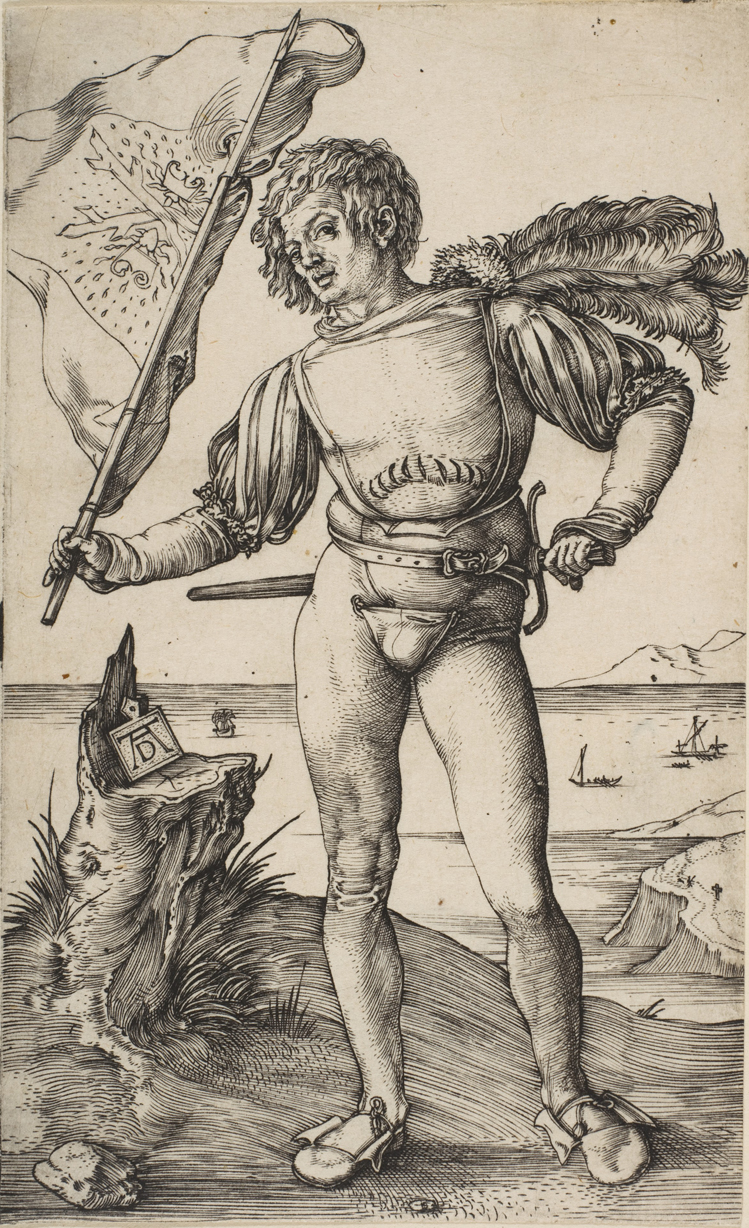 Albrecht Dürer. The Standard-bearer. Engraving, c. 1501. The Met
Albrecht Dürer. The Standard-bearer. Engraving, c. 1501. The Met
Lucas van Leyden. The Standard-bearer. Engraving, c. 1510. Colección Mariano Moret ___________________________________________________________________________________________________________ THEME & VARIATIONS: FROM FOUQUET TO GOLTZIUS
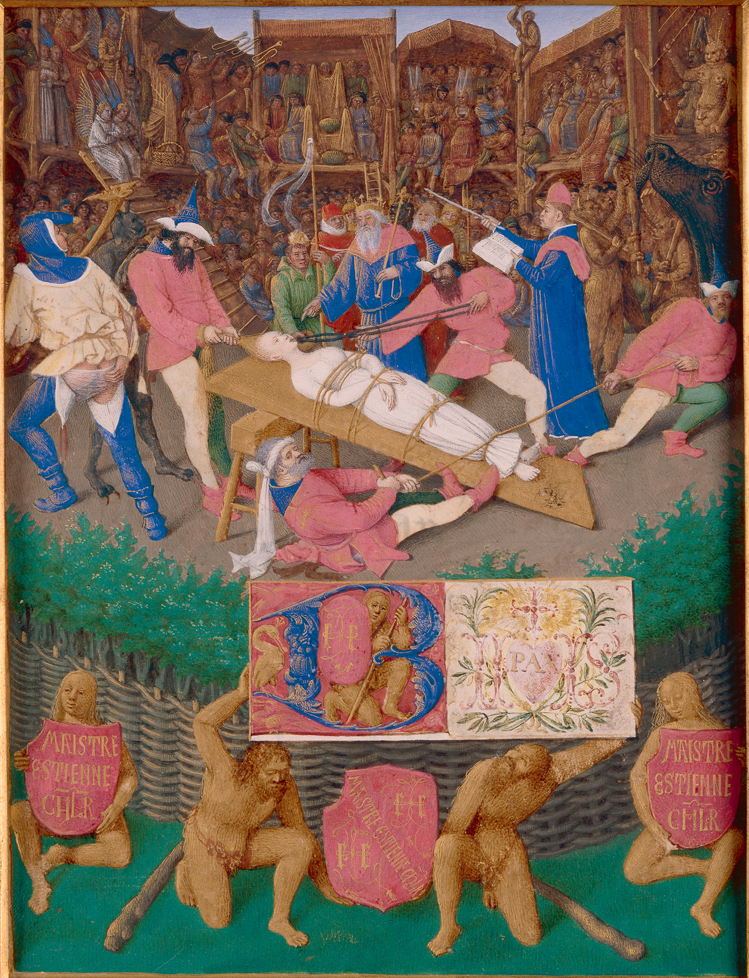 Jean Fouquet. The Martyrdom of St Apollonia (Hours of Étienne Chevalier). Tempera and gold on parchment, c. 1452-1460. Musée Condé, Chantilly
Jean Fouquet. The Martyrdom of St Apollonia (Hours of Étienne Chevalier). Tempera and gold on parchment, c. 1452-1460. Musée Condé, Chantilly 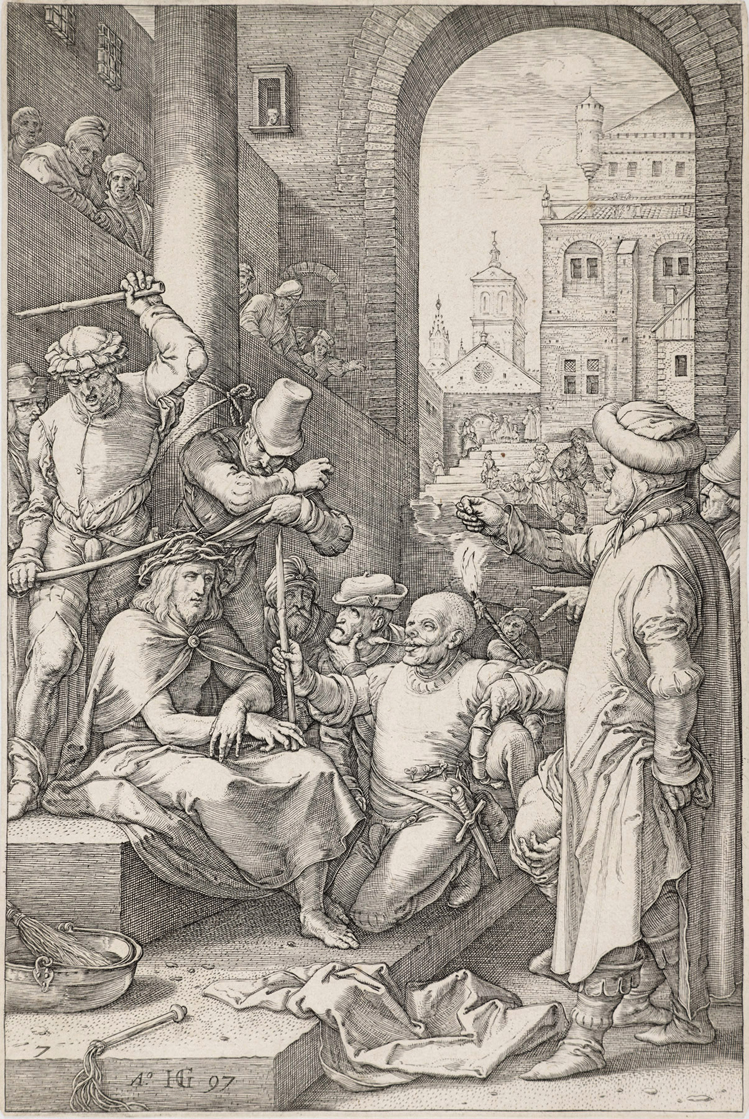 Hendrik Goltzius. Christ crowned with thorns. Engraving, 1597. Colección Mariano Moret
Hendrik Goltzius. Christ crowned with thorns. Engraving, 1597. Colección Mariano Moret 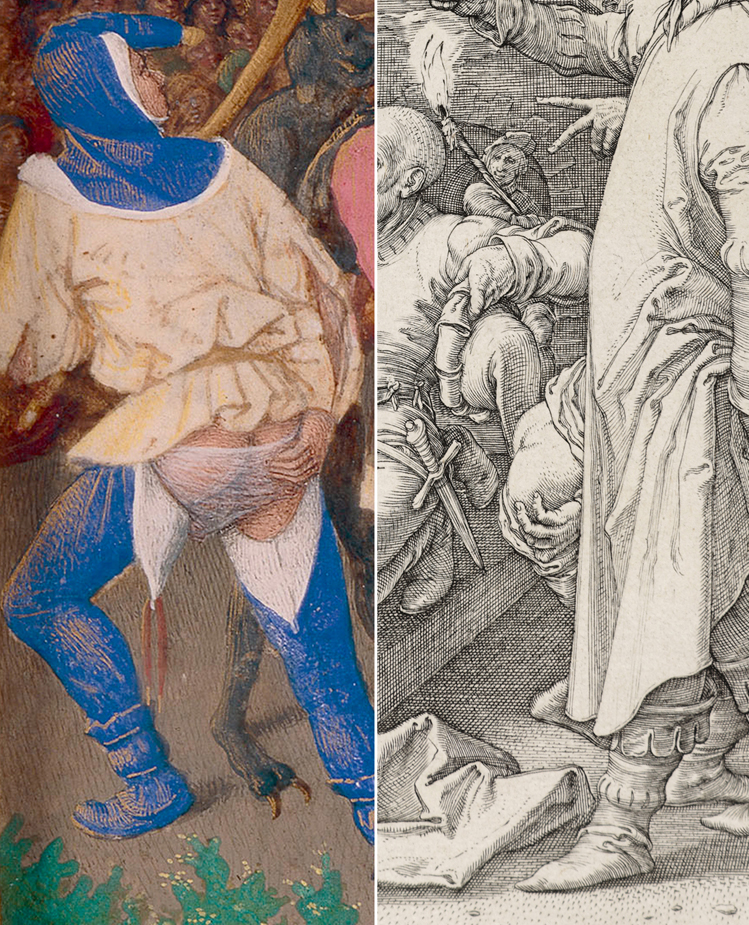 ___________________________________________________________________________________________________________ THEME & VARIATIONS: CRYSTAL SPHERES
___________________________________________________________________________________________________________ THEME & VARIATIONS: CRYSTAL SPHERES 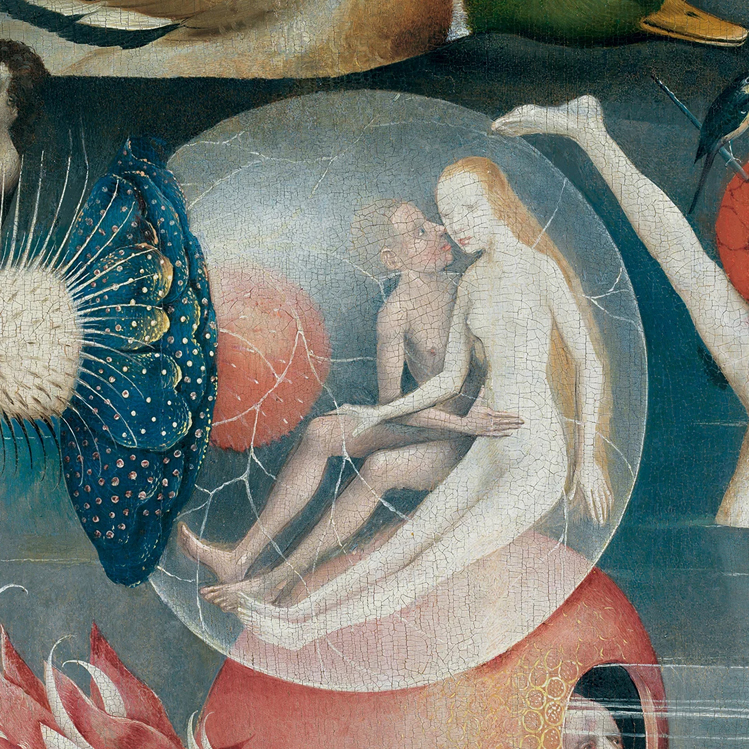 Hieronymus Bosch. The Garden of Earthly Delights (detail). Oil on oak panel, 1490-1500. Museo del Prado
Hieronymus Bosch. The Garden of Earthly Delights (detail). Oil on oak panel, 1490-1500. Museo del Prado 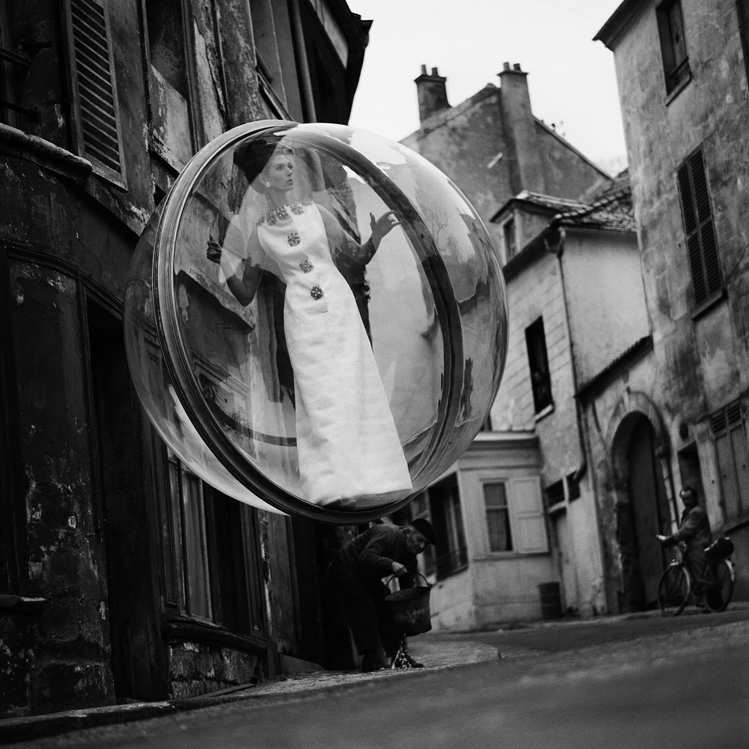 Melvin Sokolsky for Harper's Bazaar. Lumière Street, 1963. Gelatin silver print. Holden Luntz Gallery
Melvin Sokolsky for Harper's Bazaar. Lumière Street, 1963. Gelatin silver print. Holden Luntz Gallery 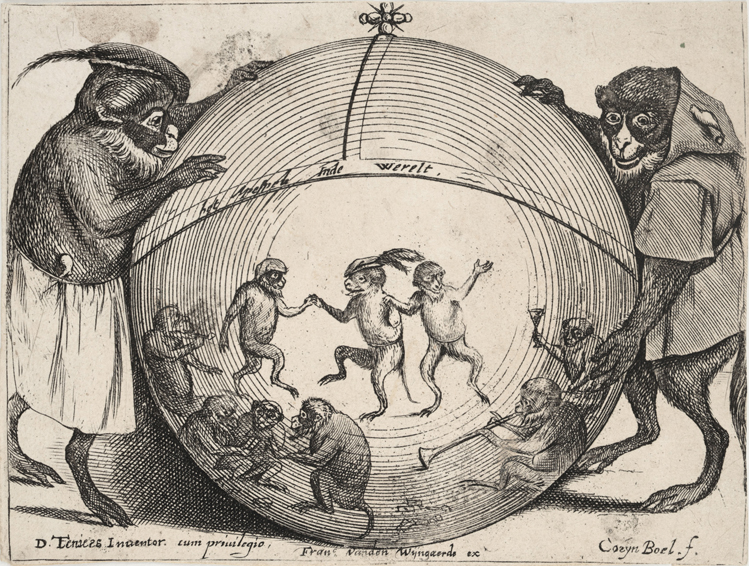 Quirin Boel. Singerie with two monkeys holding a globus cruciger. Etching, c. 1635-1668. Colección Mariano Moret.
Quirin Boel. Singerie with two monkeys holding a globus cruciger. Etching, c. 1635-1668. Colección Mariano Moret. 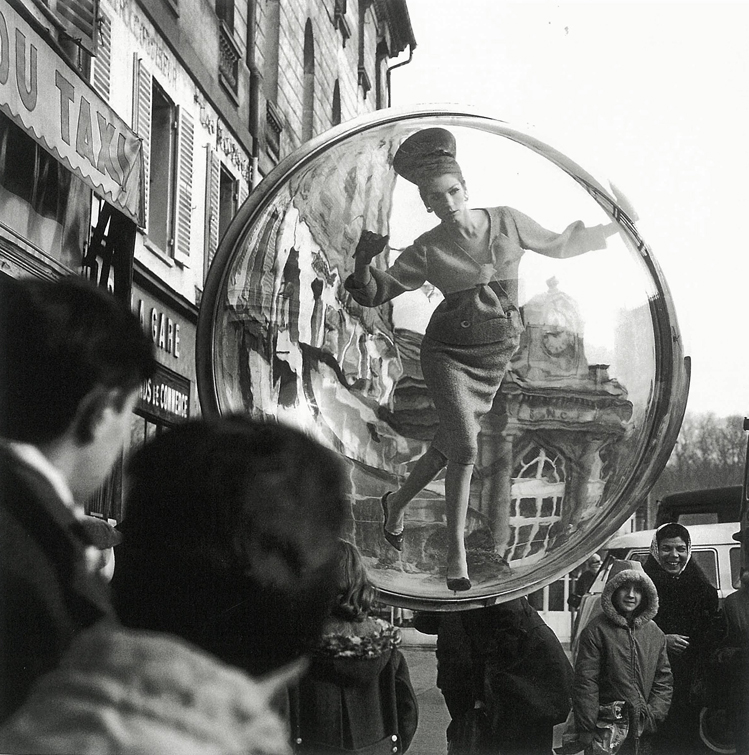 Melvin Sokolsky for Harper's Bazaar. Du Taxi, Paris, 1963. Gelatin silver print. Fondazione Sozzani
Melvin Sokolsky for Harper's Bazaar. Du Taxi, Paris, 1963. Gelatin silver print. Fondazione Sozzani 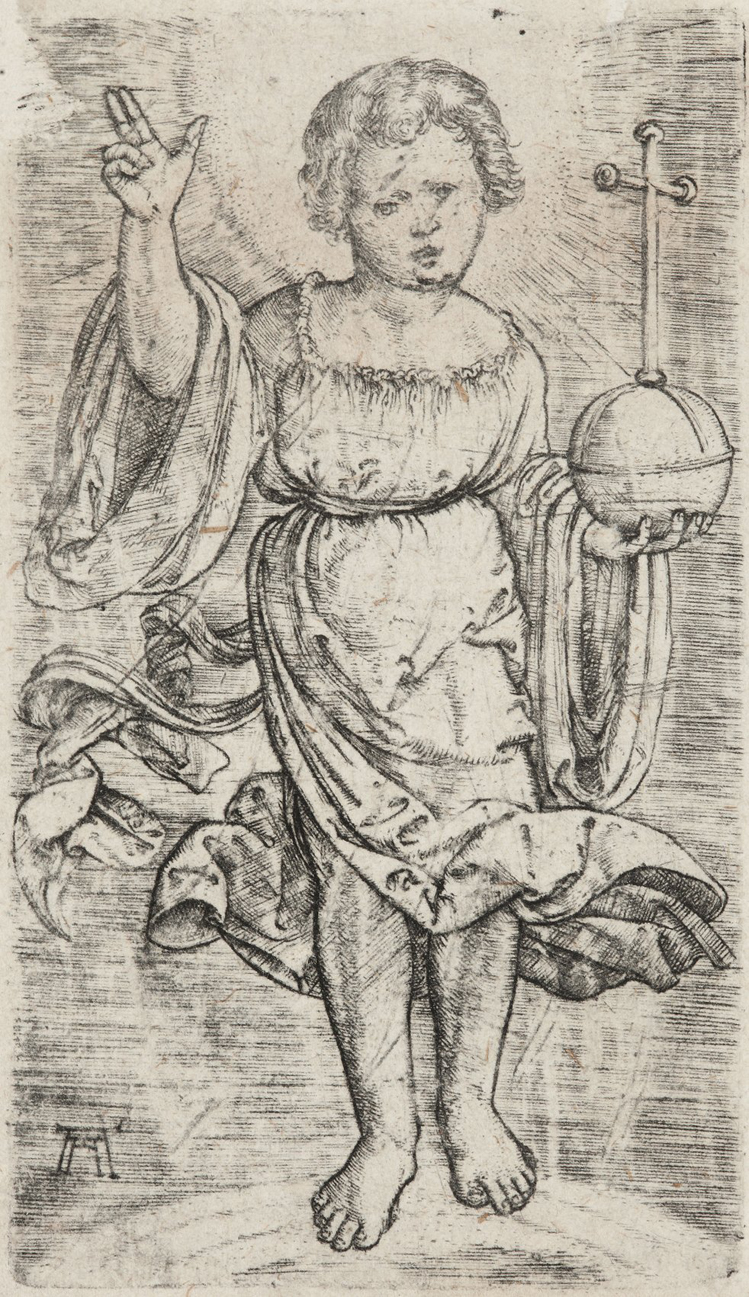 Albrecht Altdorfer. Christ the Child as Salvator Mundi. Engraving, c. 1512. Colección Mariano Moret
Albrecht Altdorfer. Christ the Child as Salvator Mundi. Engraving, c. 1512. Colección Mariano Moret 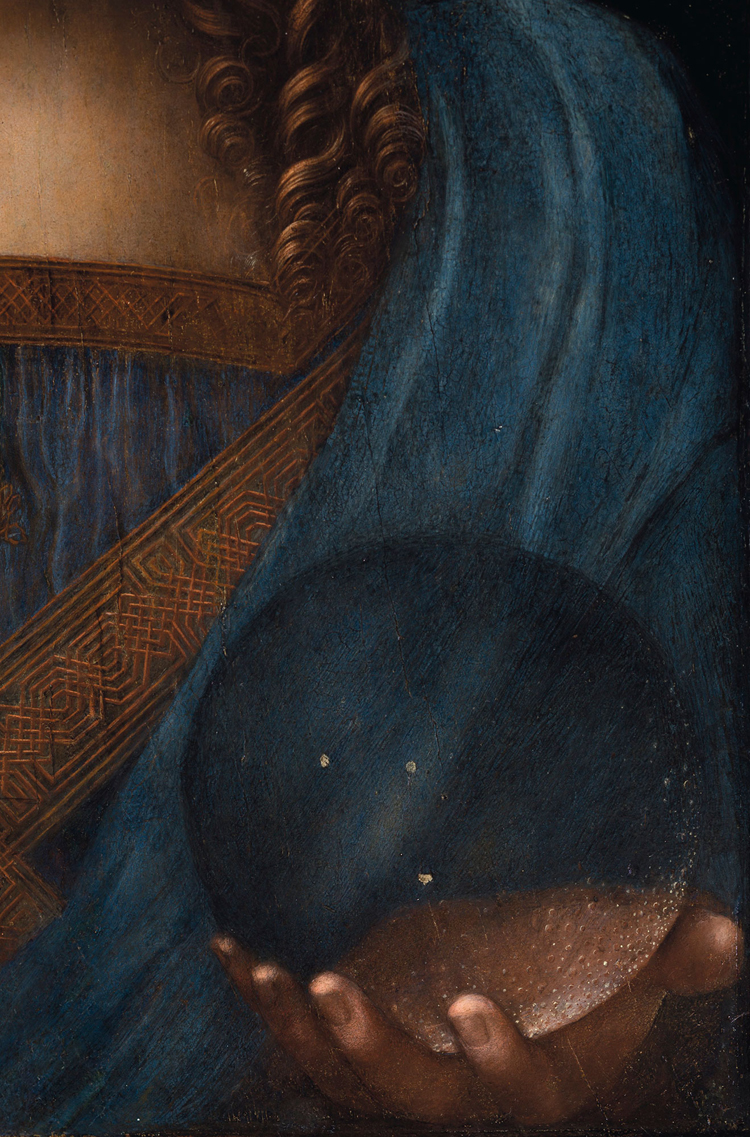 Leonardo da Vinci. Salvator Mundi (detail). Oil on panel, c. 1500. Private collection
Leonardo da Vinci. Salvator Mundi (detail). Oil on panel, c. 1500. Private collection 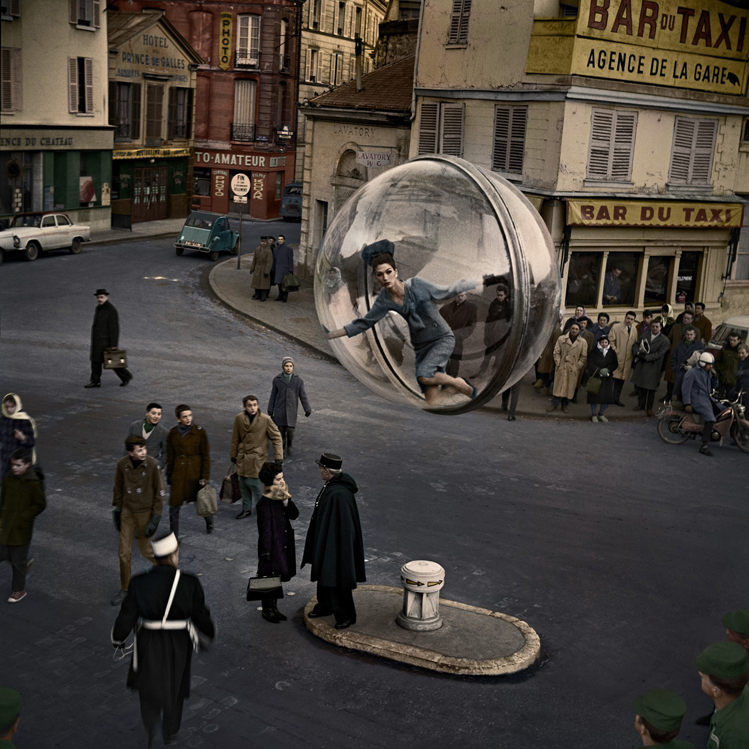 Melvin Sokolsky for Harper's Bazaar. Lumière Street, 1963. Gelatin silver print. Holden Luntz Gallery ___________________________________________________________________________________________________________
Melvin Sokolsky for Harper's Bazaar. Lumière Street, 1963. Gelatin silver print. Holden Luntz Gallery ___________________________________________________________________________________________________________THEME & VARIATIONS: LUCAS SAW IT FIRST
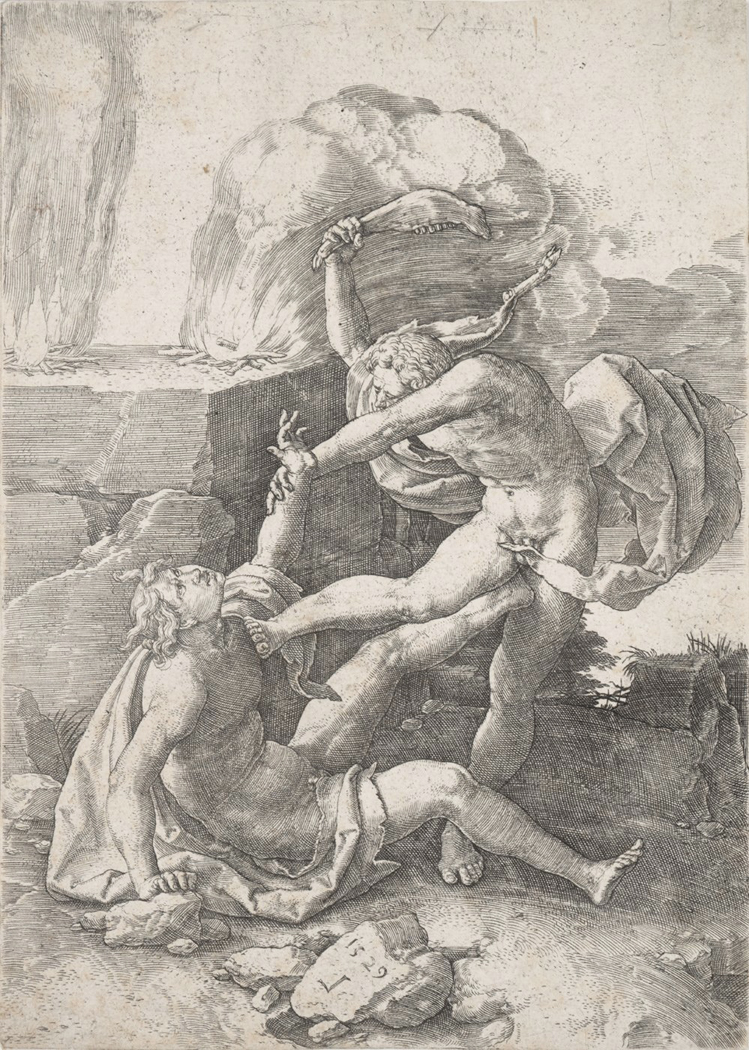 Lucas van Leyden. Cain killing Abel. Engraving, 1529. Colección Mariano Moret
Lucas van Leyden. Cain killing Abel. Engraving, 1529. Colección Mariano Moret 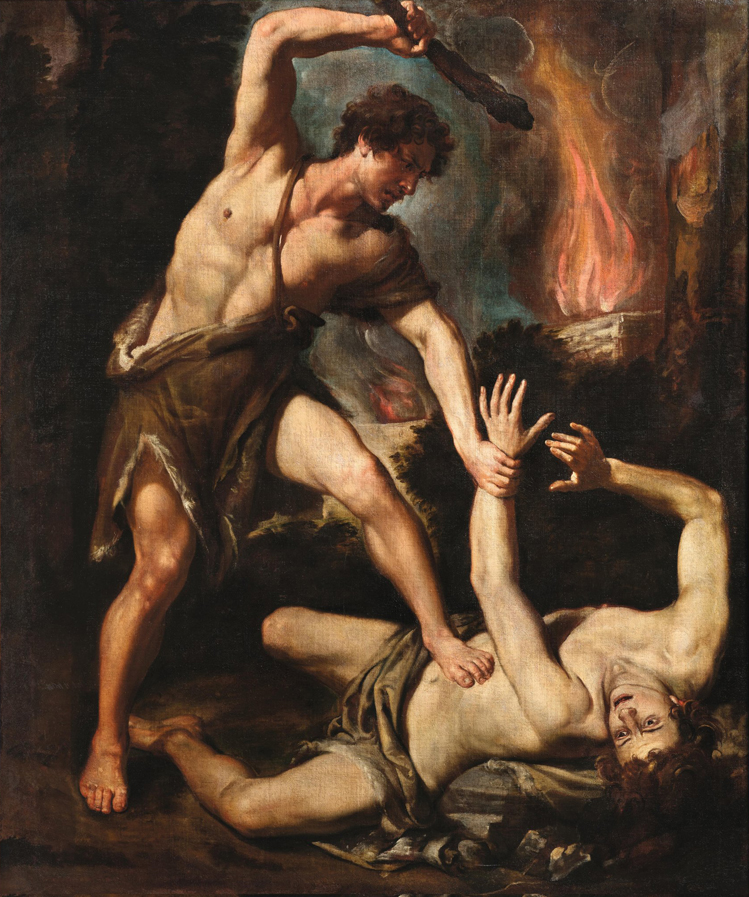 Domenico Fiasella. Cain killing Abel. Oil on canvas, c. 1615. Dorotheum
Domenico Fiasella. Cain killing Abel. Oil on canvas, c. 1615. Dorotheum
__________________________________________________________________________________________________________
THEME & VARIATIONS: RIBERA AND HIS LARGE GROTESQUE HEAD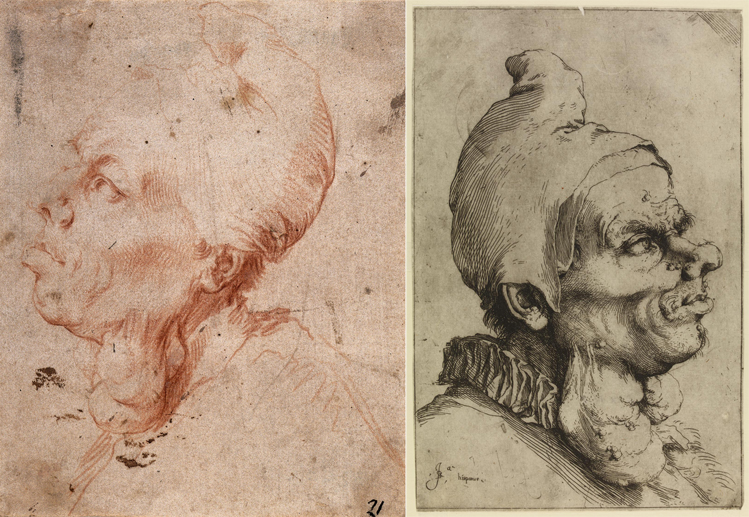 José de Ribera (Jusepe de Ribera lo Spagnoletto). Grotesque head. Red chalk, c. 1622. Wellcome Library José de Ribera (Jusepe de Ribera lo Spagnoletto). Large grotesque head. Etching and engraving, 1622. The British Museum
José de Ribera (Jusepe de Ribera lo Spagnoletto). Grotesque head. Red chalk, c. 1622. Wellcome Library José de Ribera (Jusepe de Ribera lo Spagnoletto). Large grotesque head. Etching and engraving, 1622. The British Museum 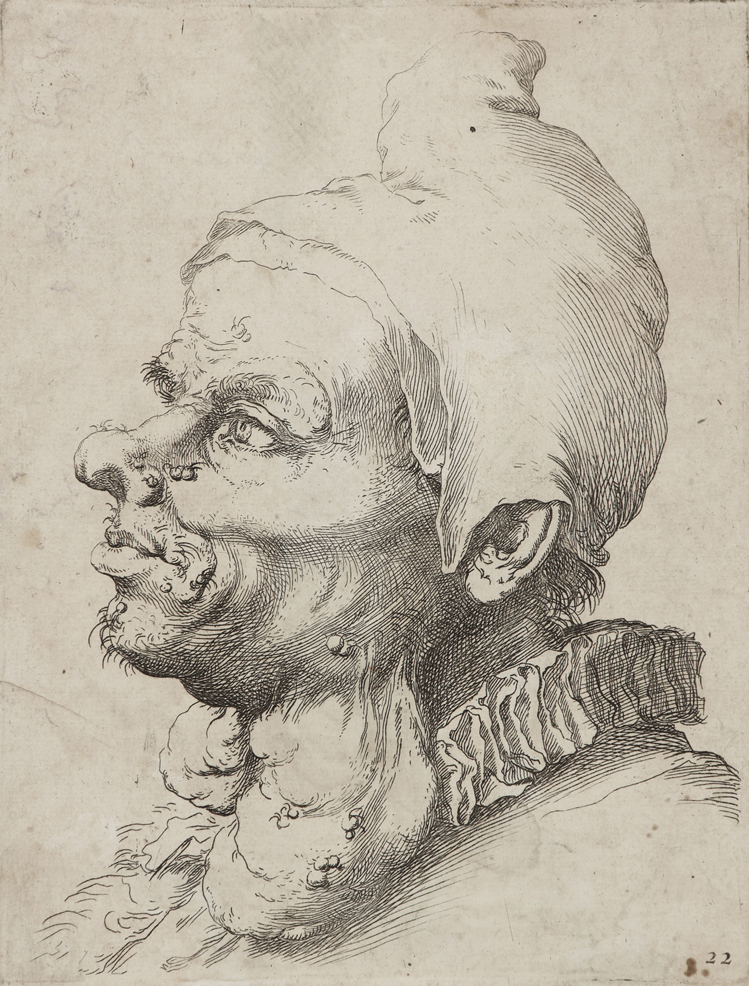 Louis Ferdinand Elle the Elder. Large grotesque head. Etching and engraving, 1650. Colección Mariano Moret
Louis Ferdinand Elle the Elder. Large grotesque head. Etching and engraving, 1650. Colección Mariano Moret 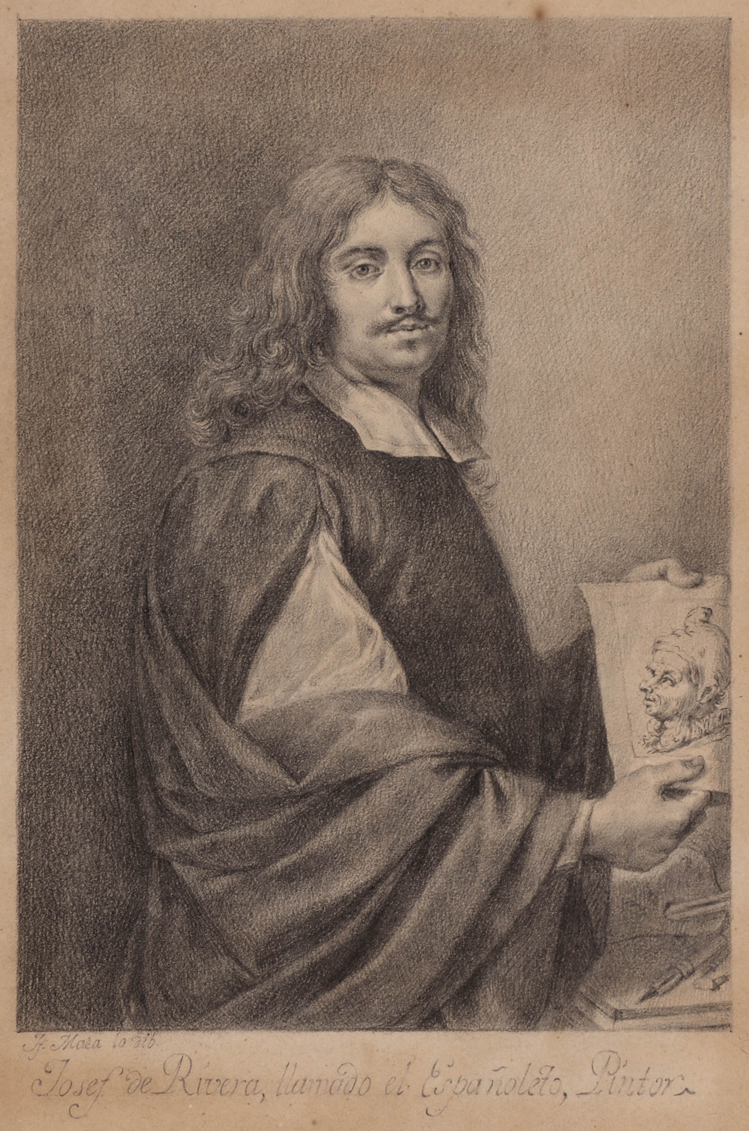 José Maea. Josef de Rivera, llamado el Españoleto, Pintor. Black chalk, 1796. Real Academia de Bellas Artes de San Fernando
José Maea. Josef de Rivera, llamado el Españoleto, Pintor. Black chalk, 1796. Real Academia de Bellas Artes de San Fernando 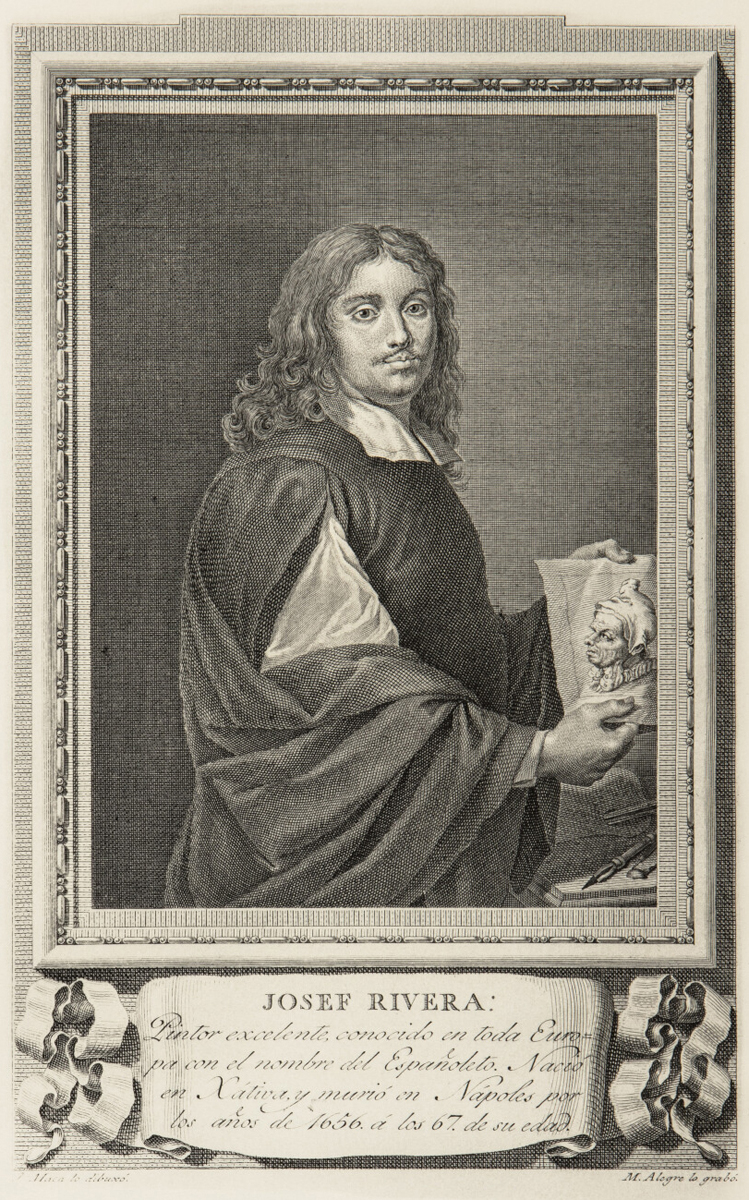 Manuel Alegre. Josef Rivera. Etching and engraving, 1796. Real Academia de Bellas Artes de San Fernando ___________________________________________________________________________________________________________ THEME & VARIATIONS: THE ALAIN DELON BEETLE
Manuel Alegre. Josef Rivera. Etching and engraving, 1796. Real Academia de Bellas Artes de San Fernando ___________________________________________________________________________________________________________ THEME & VARIATIONS: THE ALAIN DELON BEETLE 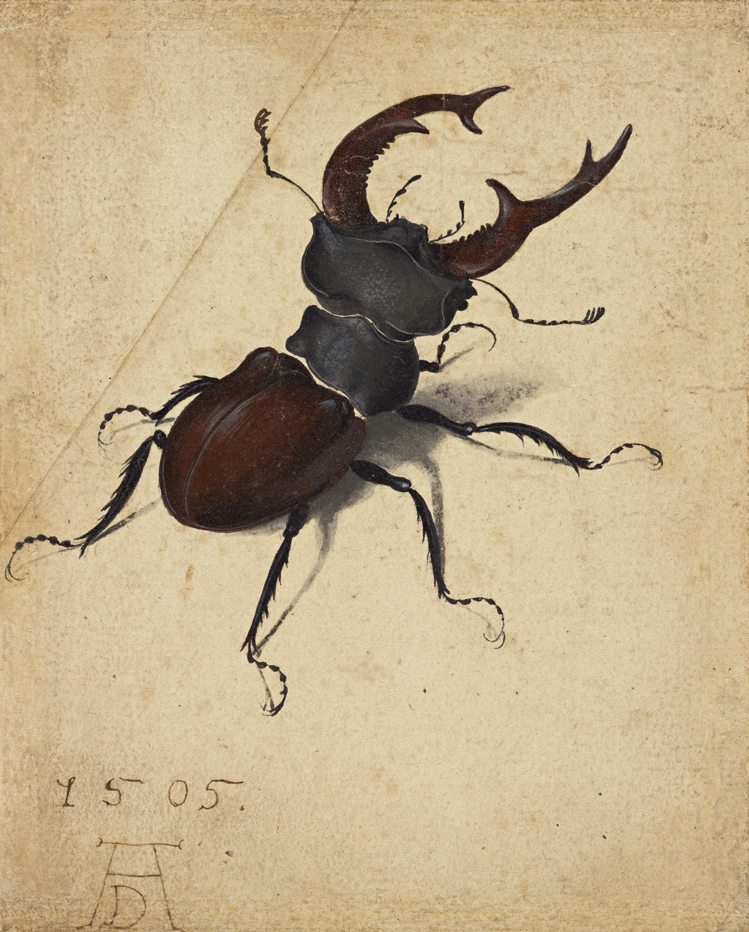 Albrecht Dürer. Stag Beetle. Watercolor and gouache, 1505. Ex-collection Alain Delon. J. Paul Getty Museum
Albrecht Dürer. Stag Beetle. Watercolor and gouache, 1505. Ex-collection Alain Delon. J. Paul Getty Museum  Jacob Hoefnagel. Scarabei umbra. Hand-coloured engraving, 1592. Colección Mariano Moret _____________________________________________________________________________________________ THEME & VARIATIONS: THE OTHER FARNESE HERCULES
Jacob Hoefnagel. Scarabei umbra. Hand-coloured engraving, 1592. Colección Mariano Moret _____________________________________________________________________________________________ THEME & VARIATIONS: THE OTHER FARNESE HERCULES 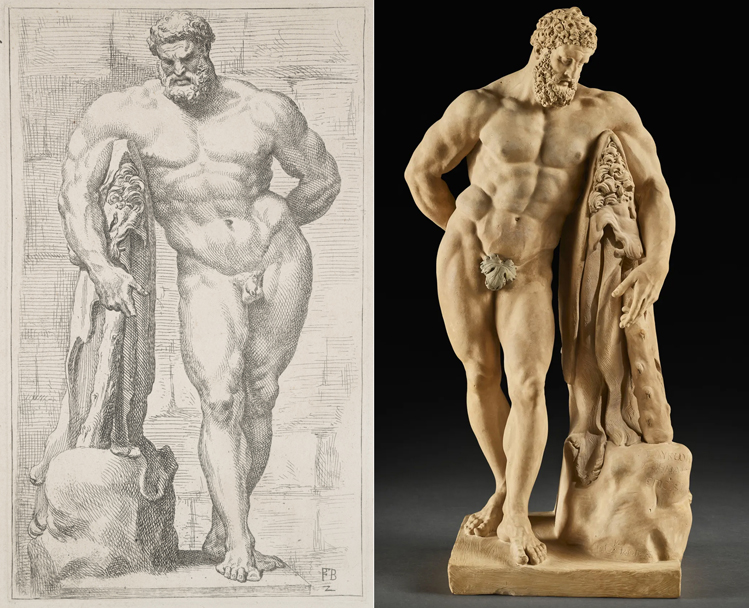 François Perrier, le Bourguignon. The Farnese Hercules, front view. Etching, 1638. Colección Mariano Moret Laurent Delvaux. The Farnese Hercules. Terracotta, 1728-1732. Artcurial
François Perrier, le Bourguignon. The Farnese Hercules, front view. Etching, 1638. Colección Mariano Moret Laurent Delvaux. The Farnese Hercules. Terracotta, 1728-1732. Artcurial 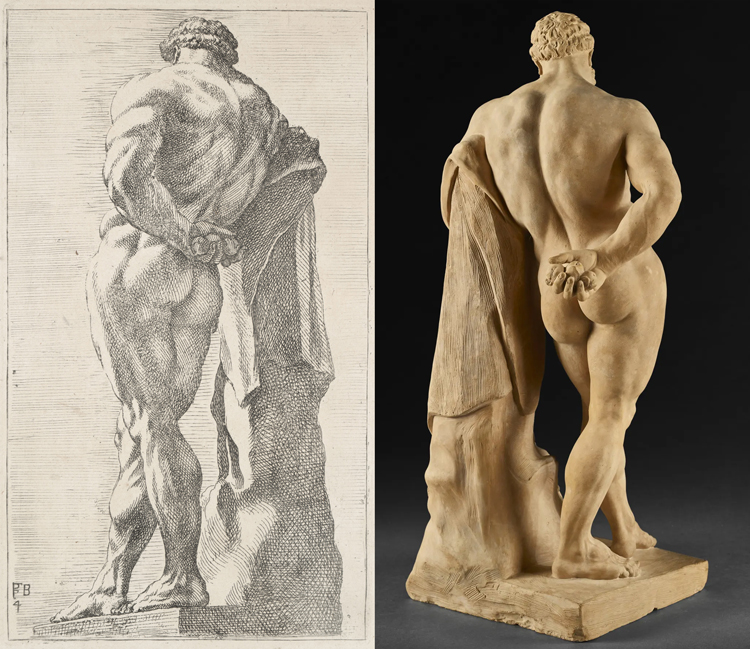 François Perrier, le Bourguignon. The Farnese Hercules, seen from behind. Etching, 1638. Colección Mariano Moret Laurent Delvaux. The Farnese Hercules. Terracotta, 1728-1732. Artcurial
François Perrier, le Bourguignon. The Farnese Hercules, seen from behind. Etching, 1638. Colección Mariano Moret Laurent Delvaux. The Farnese Hercules. Terracotta, 1728-1732. Artcurial 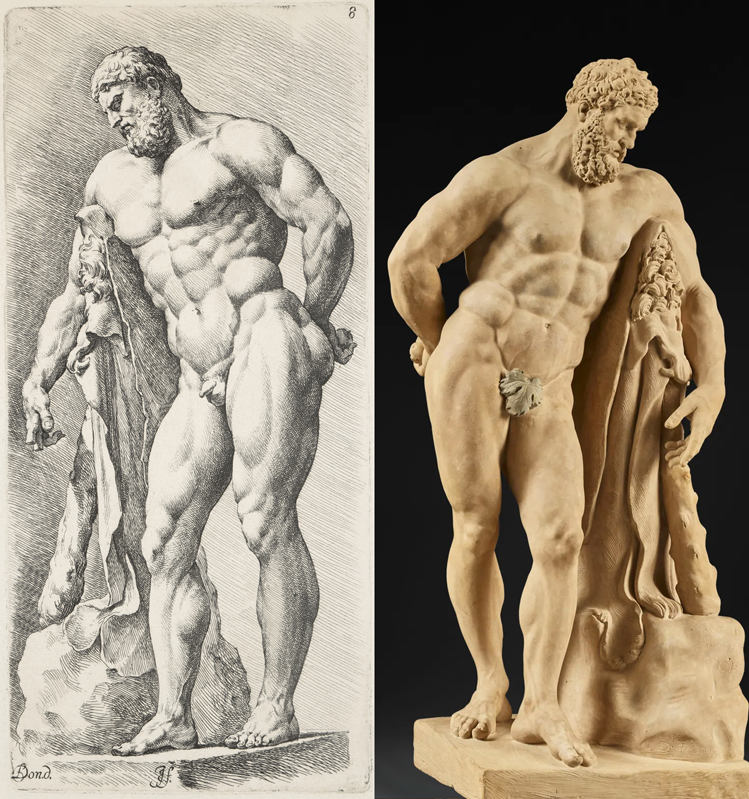 Jan de Bisschop. The Farnese Hercules, facing left. Etching, c. 1669-1671. Colección Mariano Moret Laurent Delvaux. The Farnese Hercules. Terracotta, 1728-1732. Artcurial ___________________________________________________________________________________________________________ THEME & VARIATIONS: EL BOLERO
Jan de Bisschop. The Farnese Hercules, facing left. Etching, c. 1669-1671. Colección Mariano Moret Laurent Delvaux. The Farnese Hercules. Terracotta, 1728-1732. Artcurial ___________________________________________________________________________________________________________ THEME & VARIATIONS: EL BOLERO 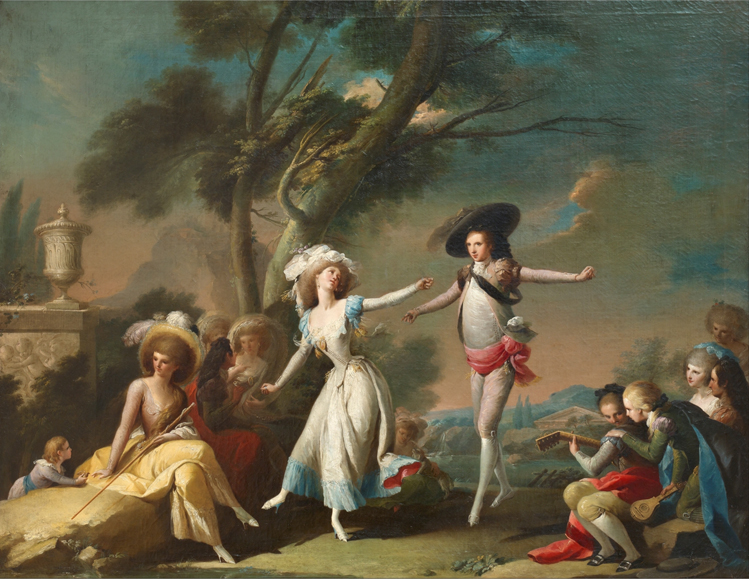 José Camarón (Segorbe, 1731- Valencia, 1803). A Festival. Oil on canvas, c. 1785. Museo del Prado
José Camarón (Segorbe, 1731- Valencia, 1803). A Festival. Oil on canvas, c. 1785. Museo del Prado 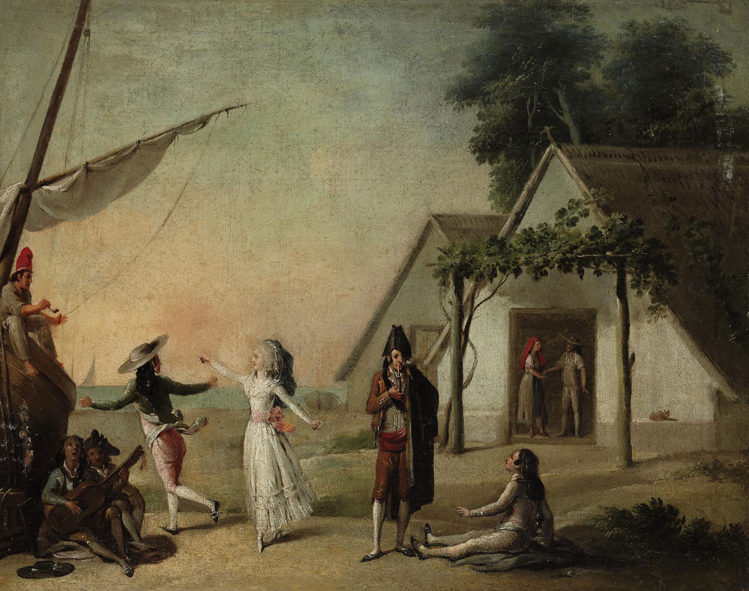 José Camarón. (Segorbe, 1731- Valencia, 1803). An elegant couple dancing the bolero. Oil on canvas. Christie's
José Camarón. (Segorbe, 1731- Valencia, 1803). An elegant couple dancing the bolero. Oil on canvas. Christie's 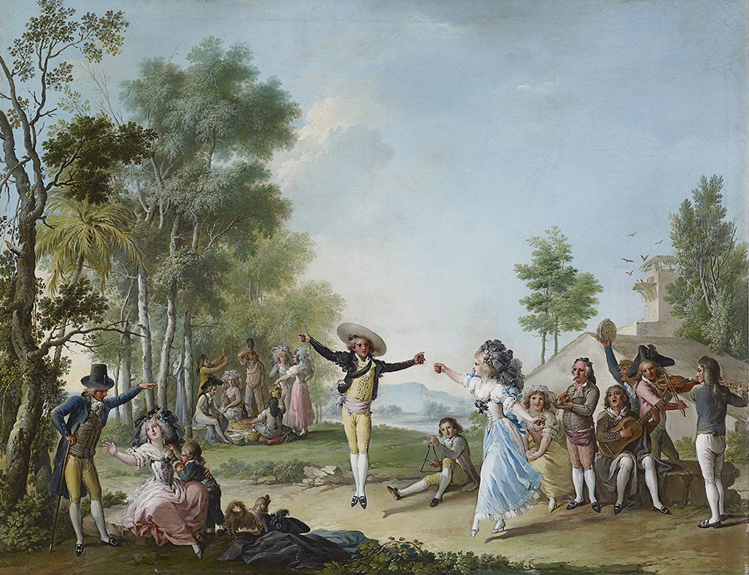 José Camarón. (Segorbe, 1731- Valencia, 1803). Fête galante. Oil on canvas. Colección Alicia Koplowitz
José Camarón. (Segorbe, 1731- Valencia, 1803). Fête galante. Oil on canvas. Colección Alicia Koplowitz 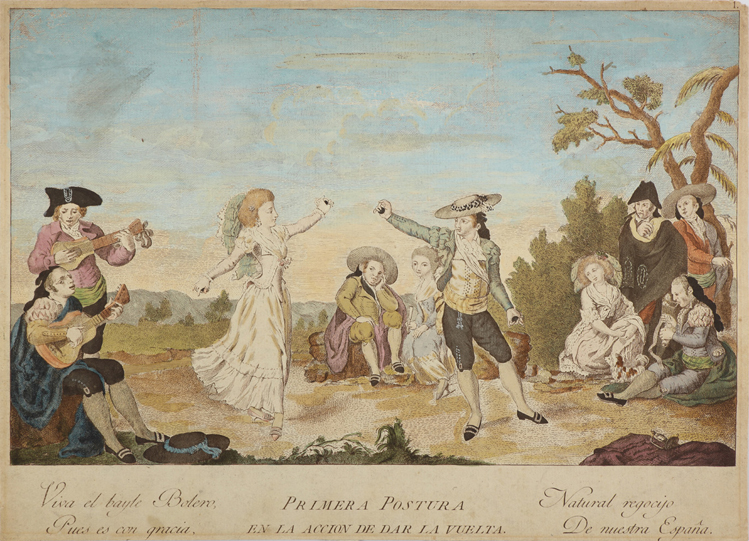 Anonymous copy after Pierre-Antoine de Machy. El Bolero. Primera postura en la acción de dar la vuelta. Hand coloured etching, 1790. Colección Mariano Moret _____________________________________________________________________________________________ THEME & VARIATIONS: JOSEPH AND POTIPHAR'S WIFE
Anonymous copy after Pierre-Antoine de Machy. El Bolero. Primera postura en la acción de dar la vuelta. Hand coloured etching, 1790. Colección Mariano Moret _____________________________________________________________________________________________ THEME & VARIATIONS: JOSEPH AND POTIPHAR'S WIFE 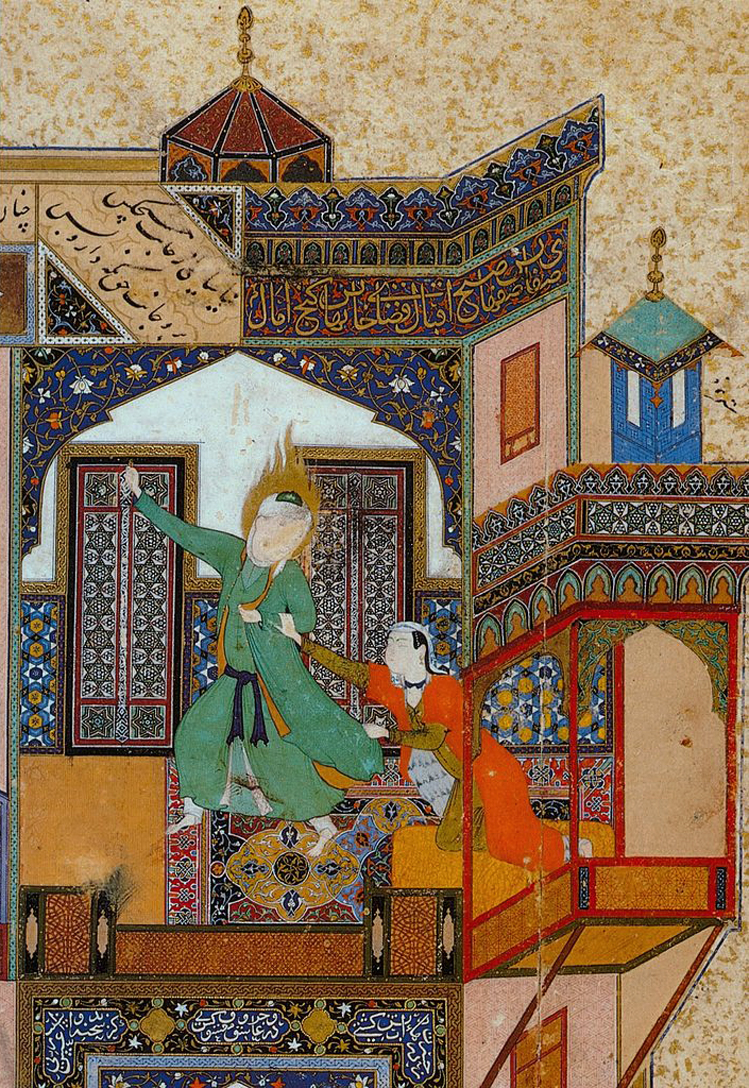 Bihzad, Kamal al-Din. Joseph and Potiphar's Wife. Ink and opaque watercolor on paper, 1488. Arab Farsi 908, f. 52v, Egyptian National Library
Bihzad, Kamal al-Din. Joseph and Potiphar's Wife. Ink and opaque watercolor on paper, 1488. Arab Farsi 908, f. 52v, Egyptian National Library 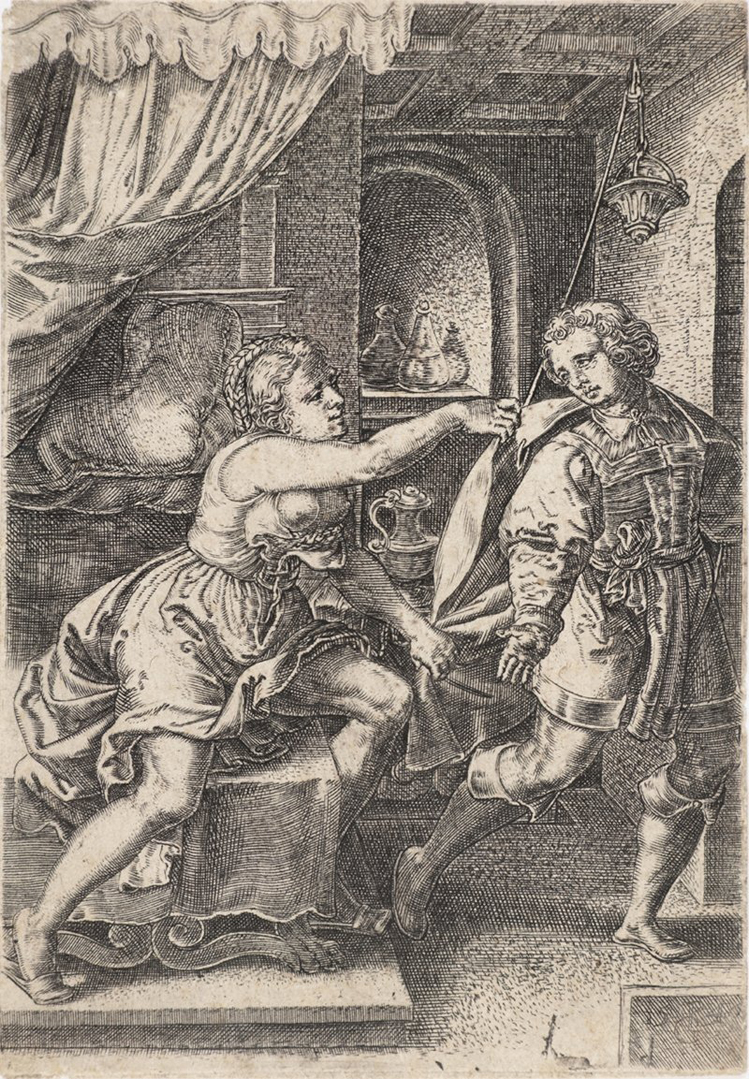 Anonymous reverse copy after Georg Pencz. Joseph and Potiphar's Wife. Engraving, c. 1546. Colección Mariano Moret
Anonymous reverse copy after Georg Pencz. Joseph and Potiphar's Wife. Engraving, c. 1546. Colección Mariano Moret 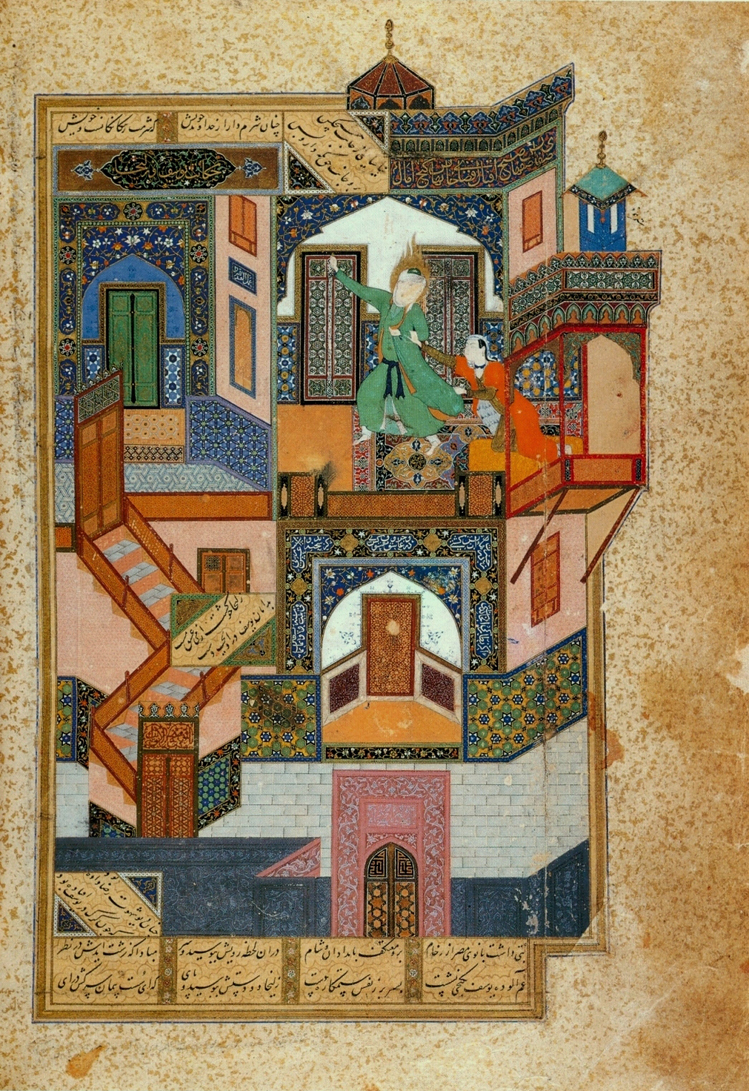 Afghanistan, Herat, 1488. Bihzad, Kamal al-Din. Joseph and Potiphar's Wife (Miniature from a Bustan of Sa`di). Ink and opaque watercolor on paper. Arab Farsi 908, f. 52v, Egyptian National Library
Afghanistan, Herat, 1488. Bihzad, Kamal al-Din. Joseph and Potiphar's Wife (Miniature from a Bustan of Sa`di). Ink and opaque watercolor on paper. Arab Farsi 908, f. 52v, Egyptian National Library 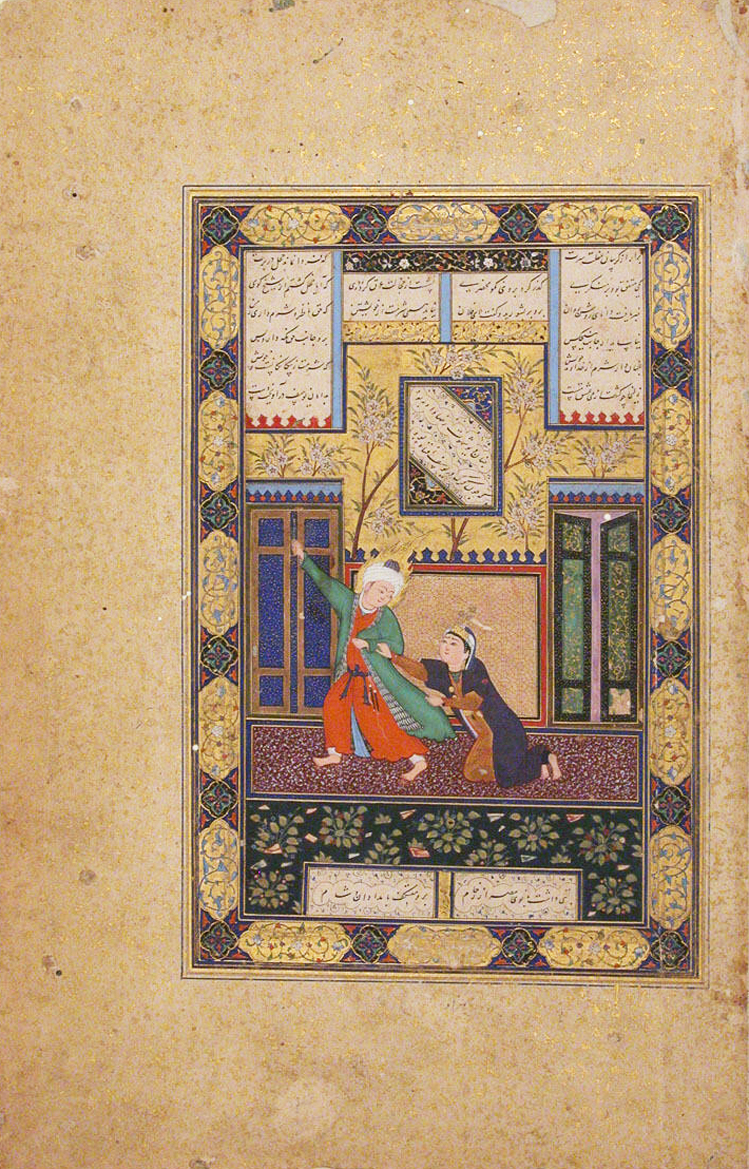 Uzbekistan, Bukhara, c. 1525-1535. Joseph and Potiphar's Wife (Miniature from a Bustan of Sa`di). Ink, opaque watercolor, and gold on paper. The Metropolitan Museum
Uzbekistan, Bukhara, c. 1525-1535. Joseph and Potiphar's Wife (Miniature from a Bustan of Sa`di). Ink, opaque watercolor, and gold on paper. The Metropolitan Museum _____________________________________________________________________________________________
THEME & VARIATIONS: STONE & PAPER
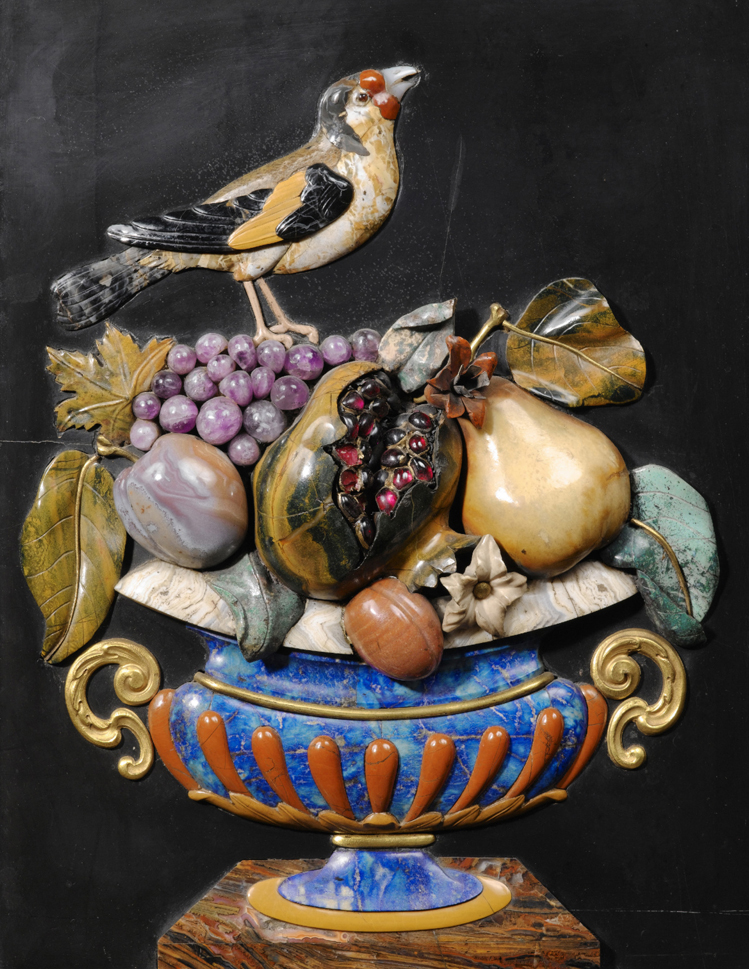 Pietra dura panel. Grand Ducal Workshops, Florence, c. 1650. Rothschild Collection. Christie's
Pietra dura panel. Grand Ducal Workshops, Florence, c. 1650. Rothschild Collection. Christie's 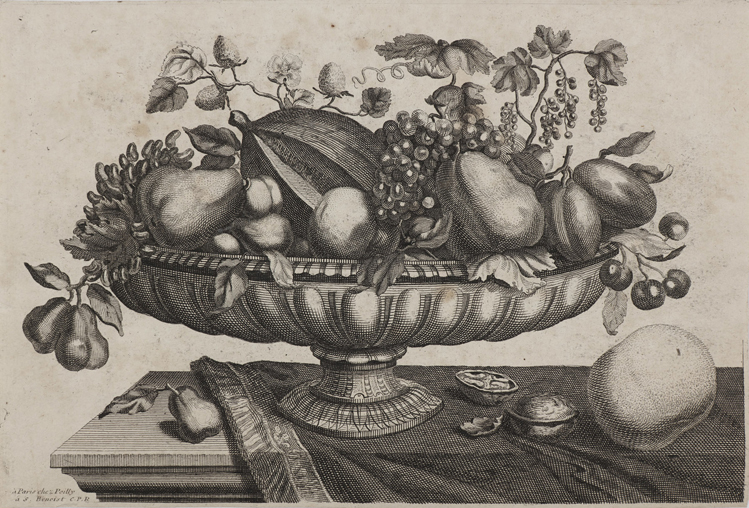 François de Poilly the Elder. Still life with fruits in a tazza with lobed decoration. Engraving, c. 1660-1680. Colección Mariano Moret ___________________________________________________________________________________________________________ THEME & VARIATIONS: STANGENGLASS
François de Poilly the Elder. Still life with fruits in a tazza with lobed decoration. Engraving, c. 1660-1680. Colección Mariano Moret ___________________________________________________________________________________________________________ THEME & VARIATIONS: STANGENGLASS 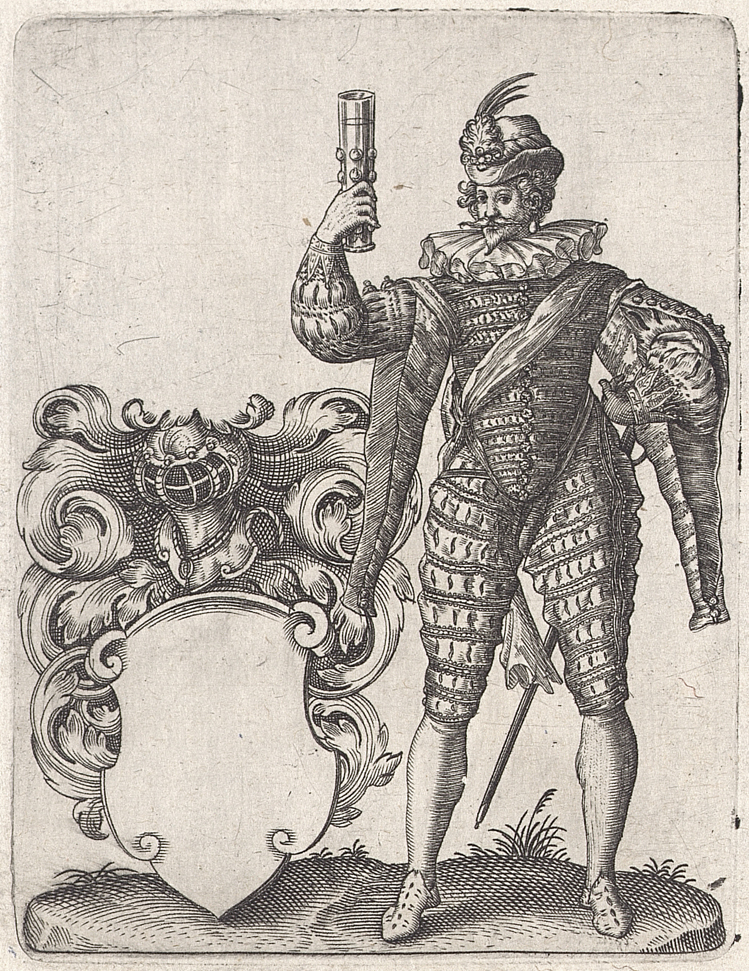 Theodor de Bry. A nobleman raising a Stangenglas besides a heraldic shield. Engraving, 1592. Colección Mariano Moret
Theodor de Bry. A nobleman raising a Stangenglas besides a heraldic shield. Engraving, 1592. Colección Mariano Moret 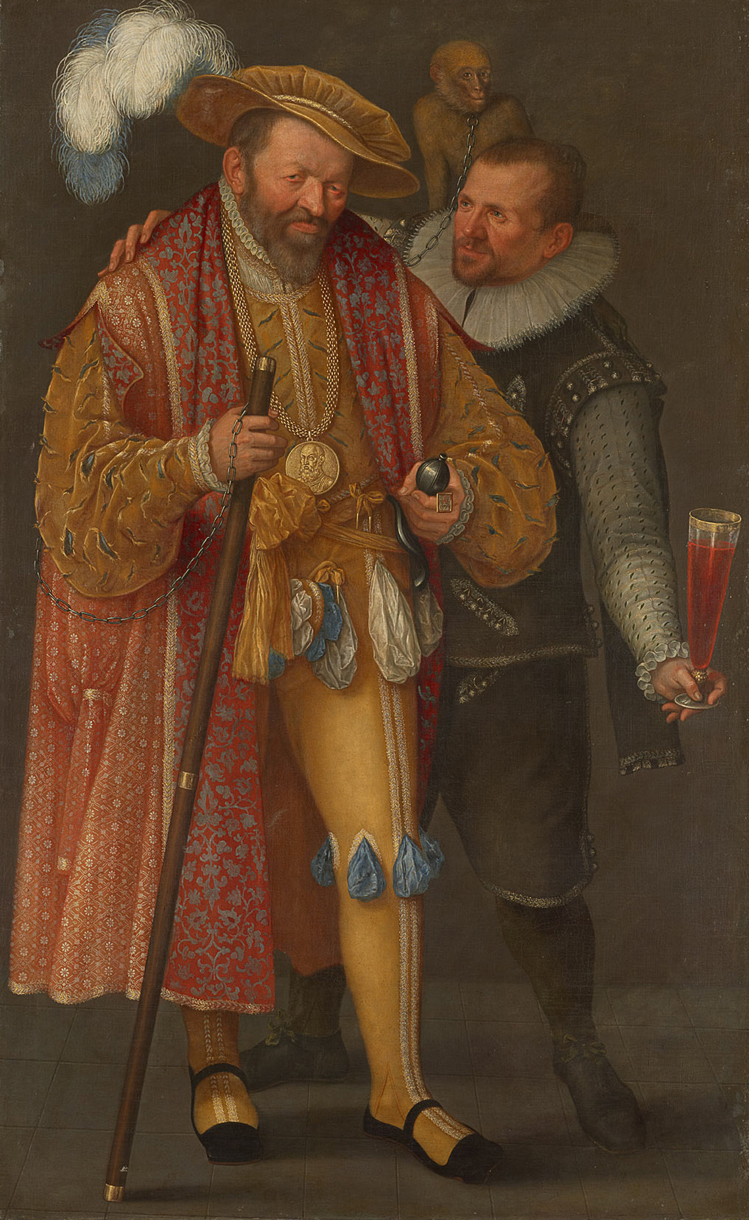 Dutch anonymous master. Portrait of a Nobleman and his Jester. Oil on canvas, Kunsthistorisches Museum ___________________________________________________________________________________________________________
Dutch anonymous master. Portrait of a Nobleman and his Jester. Oil on canvas, Kunsthistorisches Museum ___________________________________________________________________________________________________________ THEME & VARIATIONS: MARMORA
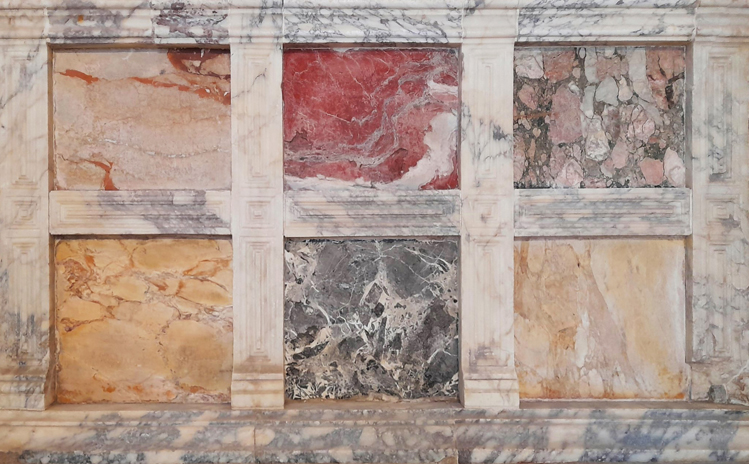 Marbles from the Temple of Romulus, 4th century. Rome
Marbles from the Temple of Romulus, 4th century. Rome 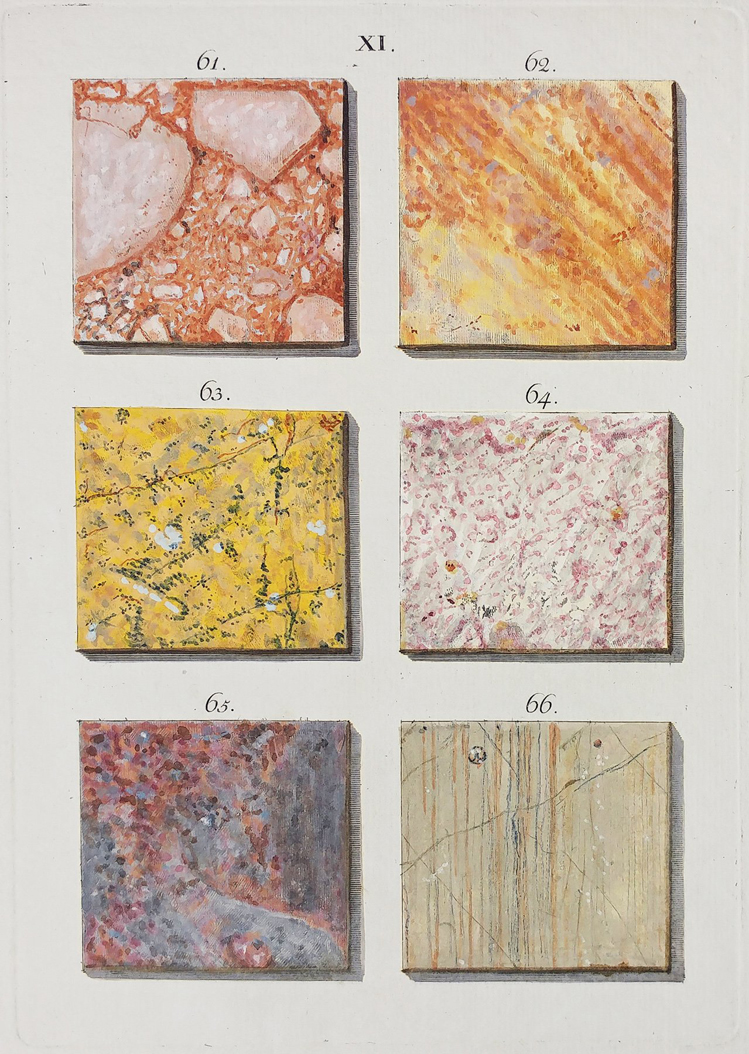 Adam Ludwig Wirsing. Württemberg Marbles (Marmora et adfines aliquos lapides coloribus suis). Etching and engraving hand-colored in watercolor and gouache, 1775. Colección Mariano Moret _____________________________________________________________________________________________ THEME & VARIATIONS: DÜRER AFTER DÜRER
Adam Ludwig Wirsing. Württemberg Marbles (Marmora et adfines aliquos lapides coloribus suis). Etching and engraving hand-colored in watercolor and gouache, 1775. Colección Mariano Moret _____________________________________________________________________________________________ THEME & VARIATIONS: DÜRER AFTER DÜRER 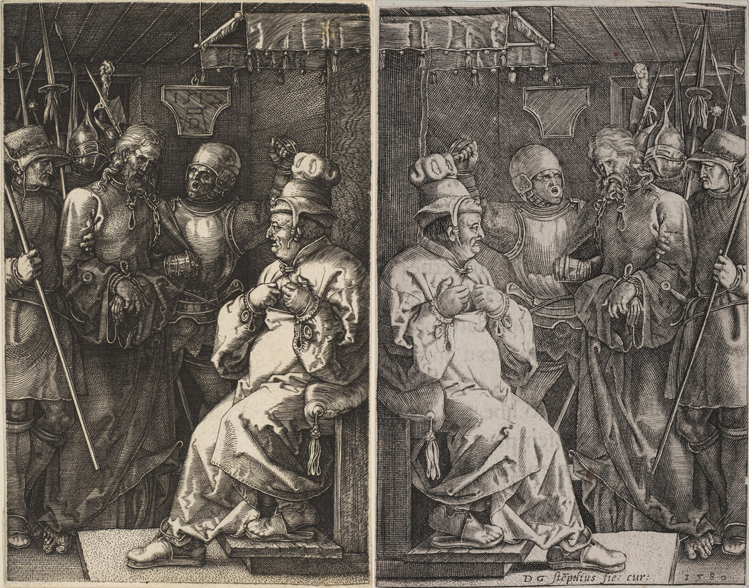 Albrecht Dürer. Christ before Caiaphas. Engraving, 1512. The Met Monogrammist RDS, after Albrecht Dürer. Christ before Caiaphas. Engraving, 1580. Colección Mariano Moret
Albrecht Dürer. Christ before Caiaphas. Engraving, 1512. The Met Monogrammist RDS, after Albrecht Dürer. Christ before Caiaphas. Engraving, 1580. Colección Mariano Moret 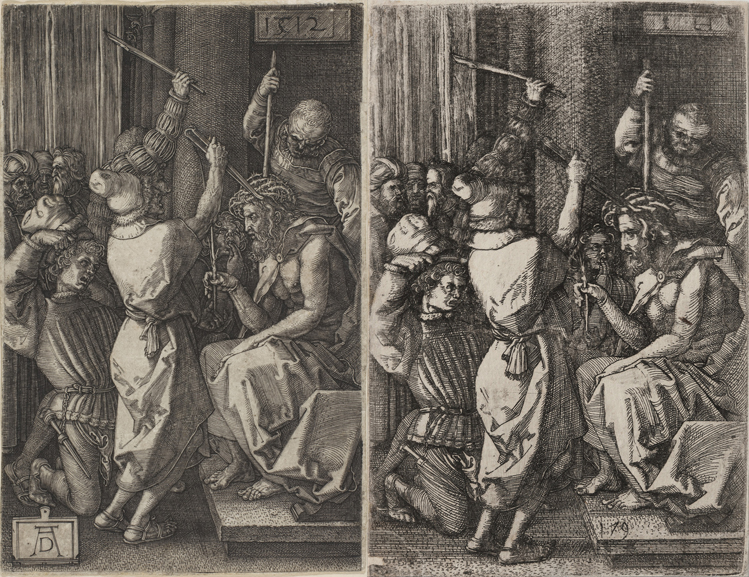 Albrecht Dürer. Christ Crowned with Thorns. Engraving, 1512. The Met Lambrecht Hopfer, after Albrecht Dürer. Christ crowned with thorns. Etching, c. 1530. Colección Mariano Moret
Albrecht Dürer. Christ Crowned with Thorns. Engraving, 1512. The Met Lambrecht Hopfer, after Albrecht Dürer. Christ crowned with thorns. Etching, c. 1530. Colección Mariano Moret 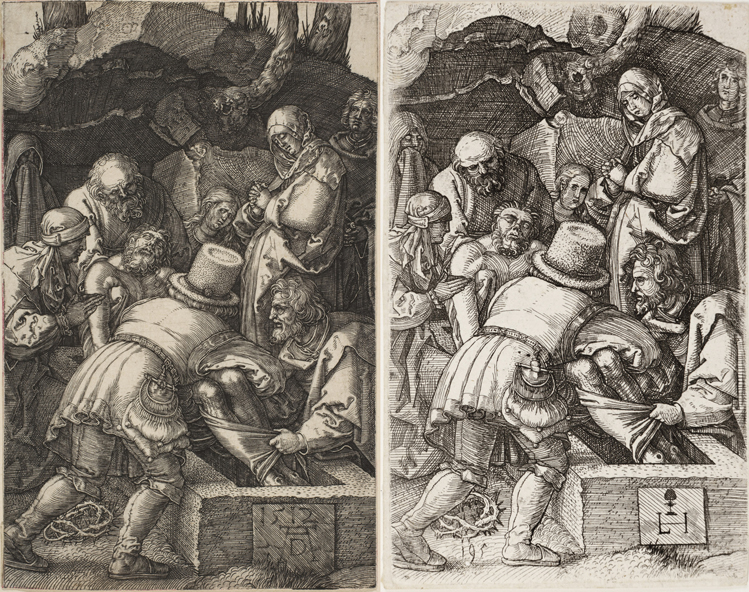 Albrecht Dürer. The Entombment. Engraving, 1512. The Met Lambrecht Hopfer, after Albrecht Dürer. The Entombment. Etching, c. 1530. Colección Mariano Moret ___________________________________________________________________________________________________________ THEME & VARIATIONS: THE PASSION IN THE PLATE
Albrecht Dürer. The Entombment. Engraving, 1512. The Met Lambrecht Hopfer, after Albrecht Dürer. The Entombment. Etching, c. 1530. Colección Mariano Moret ___________________________________________________________________________________________________________ THEME & VARIATIONS: THE PASSION IN THE PLATE 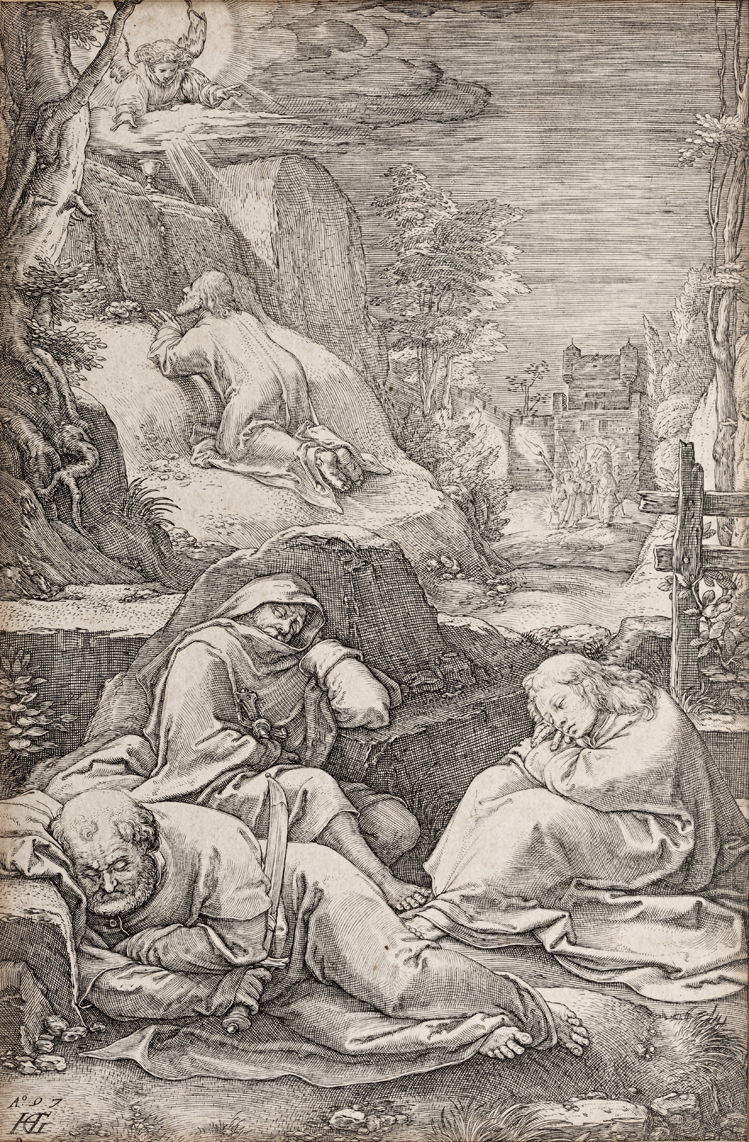 Hendrik Goltzius. Christ praying on the Mount of Olives at Gethsemane. Engraving, 1597. Colección Mariano Moret
Hendrik Goltzius. Christ praying on the Mount of Olives at Gethsemane. Engraving, 1597. Colección Mariano Moret 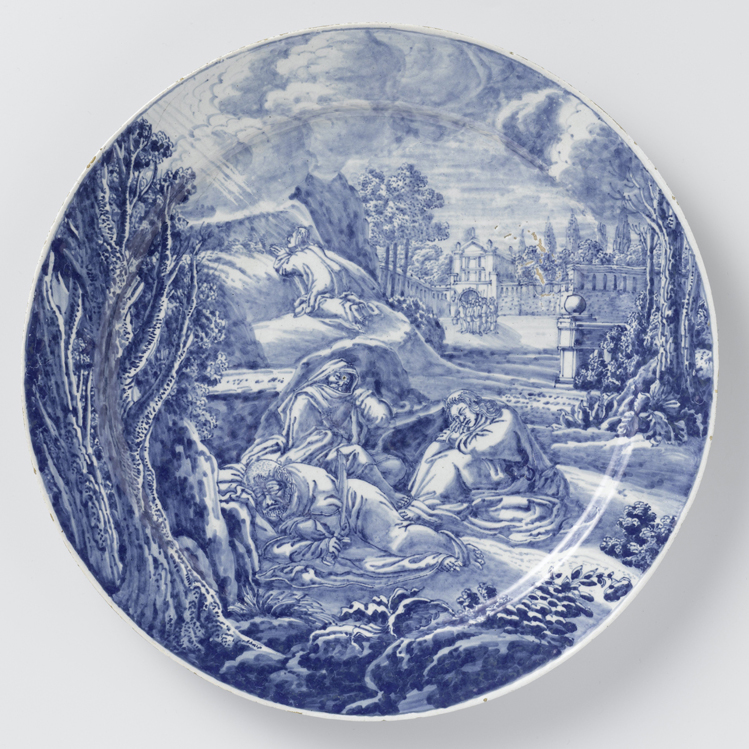 Dutch, Delft, attributed to De Roos Manufactory. Plate with Christ praying on the Mount of Olives at Gethsemane. Tin-glazed earthenware with cobalt blue pigment, c. 1700-1725. Rijksmuseum
Dutch, Delft, attributed to De Roos Manufactory. Plate with Christ praying on the Mount of Olives at Gethsemane. Tin-glazed earthenware with cobalt blue pigment, c. 1700-1725. Rijksmuseum 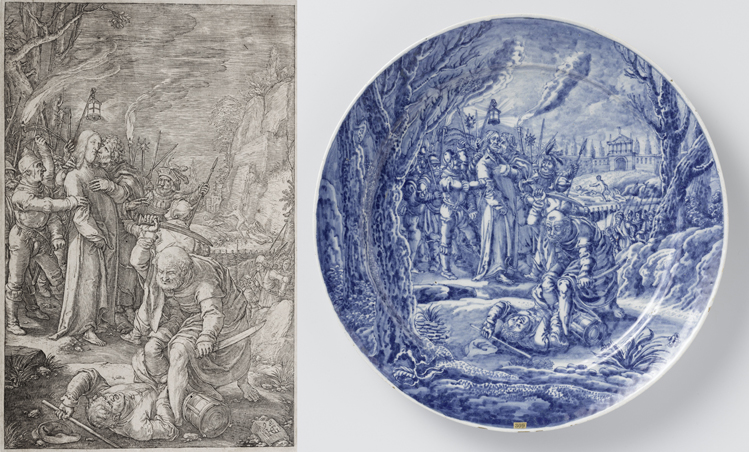 Hendrik Goltzius. The betrayal of Christ. Engraving, 1598. Colección Mariano Moret Dutch, Delft, attributed to De Roos Manufactory. The betrayal of Christ. Tin-glazed earthenware with cobalt blue pigment, c. 1700-1725. Rijksmuseum
Hendrik Goltzius. The betrayal of Christ. Engraving, 1598. Colección Mariano Moret Dutch, Delft, attributed to De Roos Manufactory. The betrayal of Christ. Tin-glazed earthenware with cobalt blue pigment, c. 1700-1725. Rijksmuseum 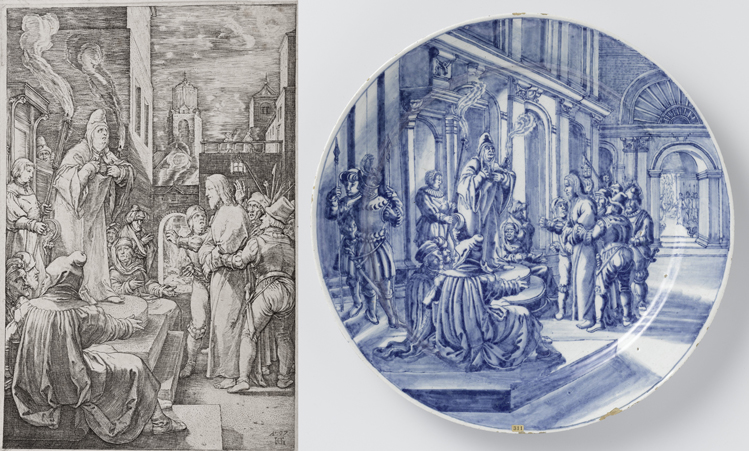 Hendrik Goltzius. Christ before Caiaphas. Engraving, 1597. Colección Mariano Moret Dutch, Delft, attributed to De Roos Manufactory. Plate with Christ before Caiaphas. Tin-glazed earthenware with cobalt blue pigment, c. 1700-1725. Rijksmuseum
Hendrik Goltzius. Christ before Caiaphas. Engraving, 1597. Colección Mariano Moret Dutch, Delft, attributed to De Roos Manufactory. Plate with Christ before Caiaphas. Tin-glazed earthenware with cobalt blue pigment, c. 1700-1725. Rijksmuseum 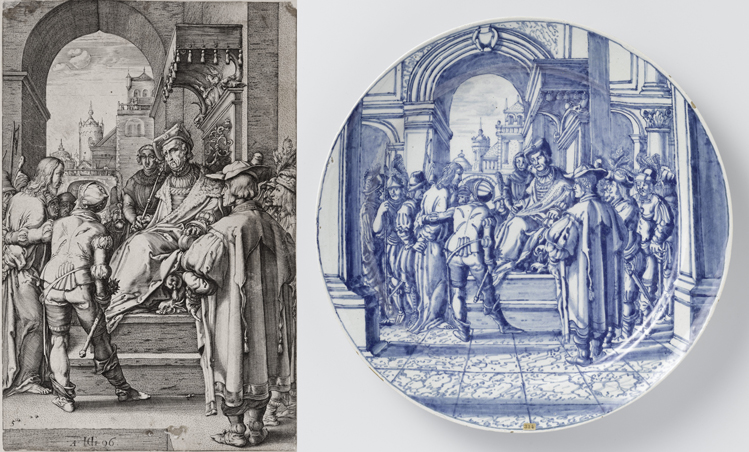 Hendrik Goltzius. Christ before Pilate. Engraving, 1596. Colección Mariano Moret Dutch, Delft, attributed to De Roos Manufactory. Plate with Christ before Pilate. Tin-glazed earthenware with cobalt blue pigment, c. 1700-1725. Rijksmuseum
Hendrik Goltzius. Christ before Pilate. Engraving, 1596. Colección Mariano Moret Dutch, Delft, attributed to De Roos Manufactory. Plate with Christ before Pilate. Tin-glazed earthenware with cobalt blue pigment, c. 1700-1725. Rijksmuseum 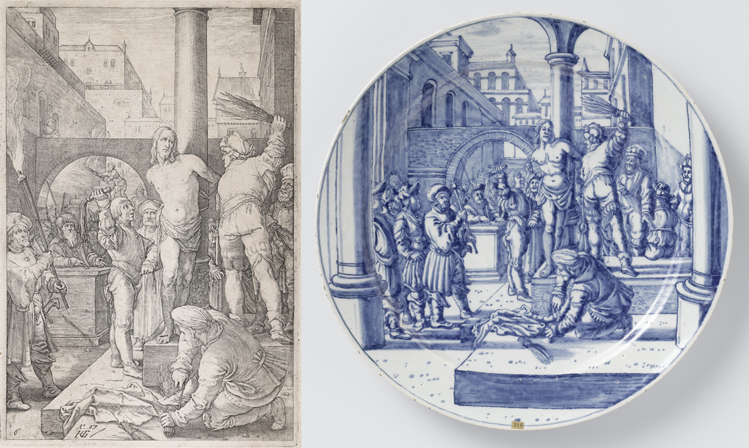 Hendrik Goltzius. The Flagellation. Engraving, 1597. Colección Mariano Moret Dutch, Delft, attributed to De Roos Manufactory. The Flagellation. Tin-glazed earthenware with cobalt blue pigment, c. 1700-1725. Rijksmuseum
Hendrik Goltzius. The Flagellation. Engraving, 1597. Colección Mariano Moret Dutch, Delft, attributed to De Roos Manufactory. The Flagellation. Tin-glazed earthenware with cobalt blue pigment, c. 1700-1725. Rijksmuseum 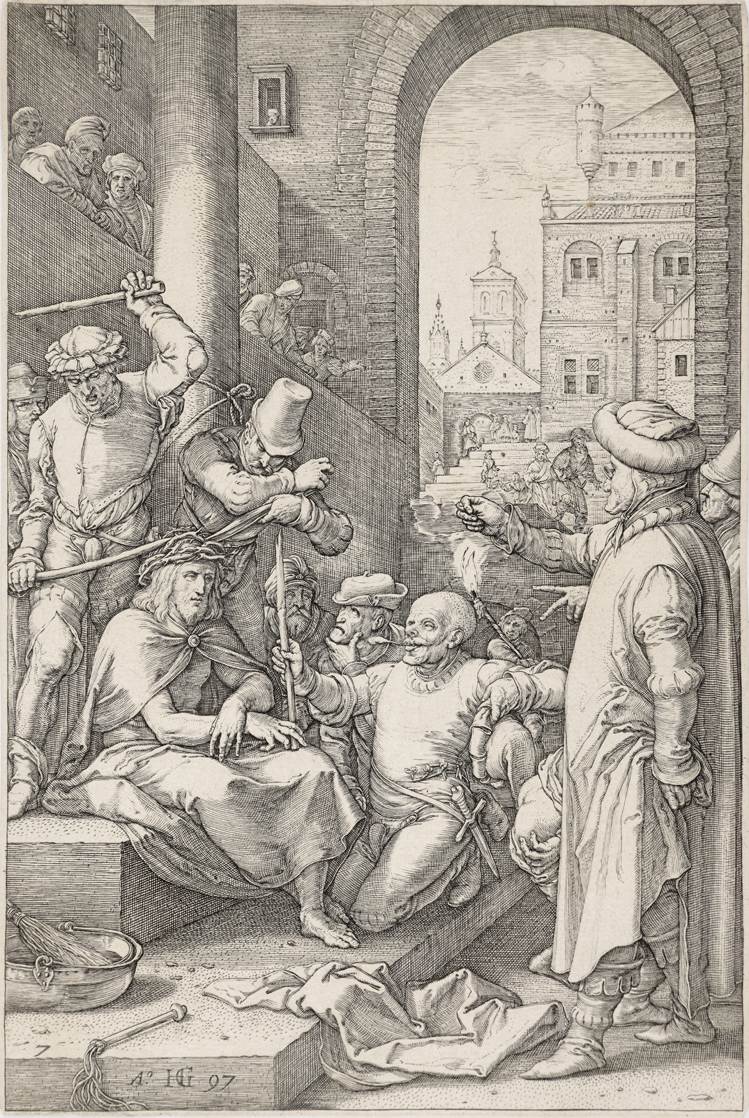 Hendrik Goltzius. Christ crowned with thorns. Engraving, 1597. Colección Mariano Moret
Hendrik Goltzius. Christ crowned with thorns. Engraving, 1597. Colección Mariano Moret 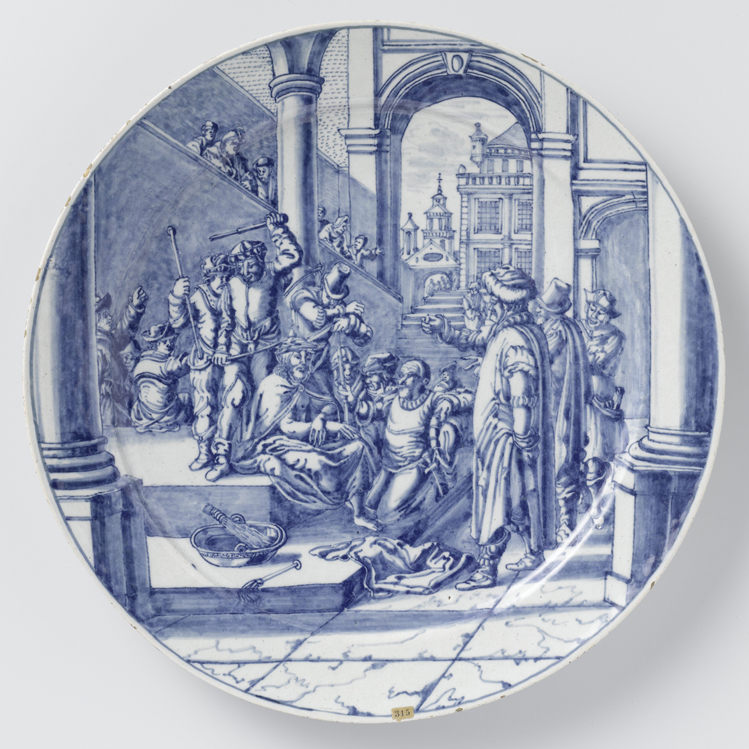 Dutch, Delft, attributed to De Roos Manufactory. Christ crowned with thorns. Tin-glazed earthenware with cobalt blue pigment, c. 1700-1725. Rijksmuseum
Dutch, Delft, attributed to De Roos Manufactory. Christ crowned with thorns. Tin-glazed earthenware with cobalt blue pigment, c. 1700-1725. Rijksmuseum 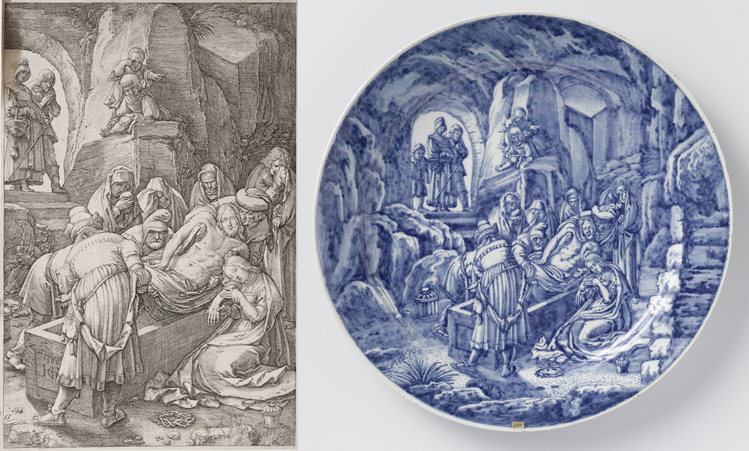 Hendrik Goltzius. The deposition. Engraving, 1596. Colección Mariano Moret Dutch, Delft, attributed to De Roos Manufactory. The deposition. Tin-glazed earthenware with cobalt blue pigment, c. 1700-1725. Rijksmuseum ___________________________________________________________________________________________________________
Hendrik Goltzius. The deposition. Engraving, 1596. Colección Mariano Moret Dutch, Delft, attributed to De Roos Manufactory. The deposition. Tin-glazed earthenware with cobalt blue pigment, c. 1700-1725. Rijksmuseum ___________________________________________________________________________________________________________ THEME & VARIATIONS: TO BE OR NOT TO BE
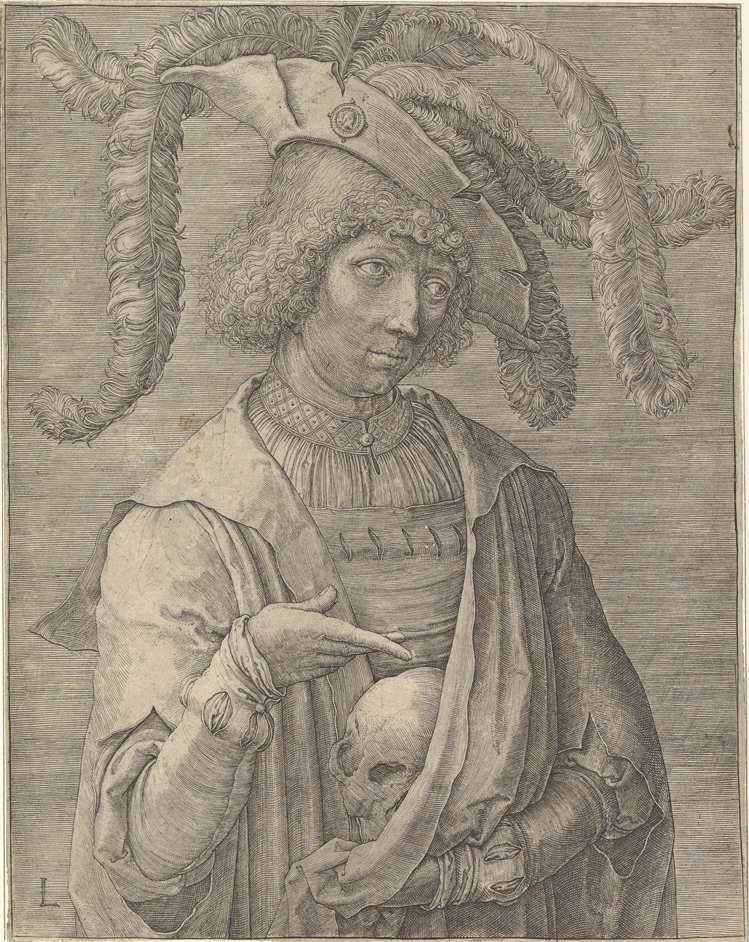 Lucas van Leyden. Young Man with a Skull. Engraving, 1519. The Met
Lucas van Leyden. Young Man with a Skull. Engraving, 1519. The Met 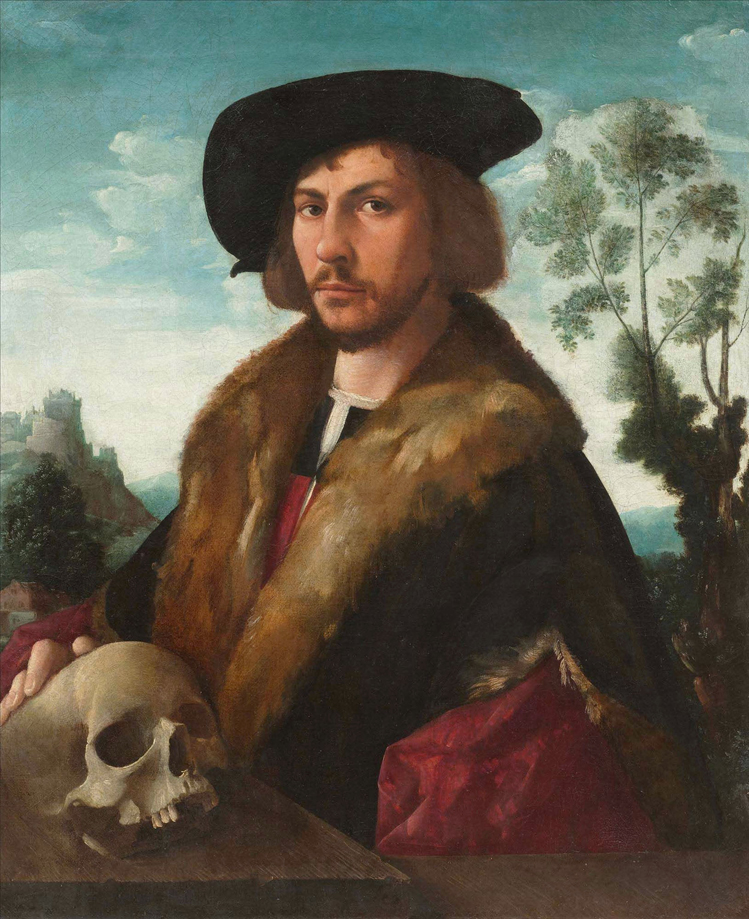 Attributed to Dirck Jacobsz. Young Man with a Skull. Oil on panel, c. 1520. Koller
Attributed to Dirck Jacobsz. Young Man with a Skull. Oil on panel, c. 1520. Koller 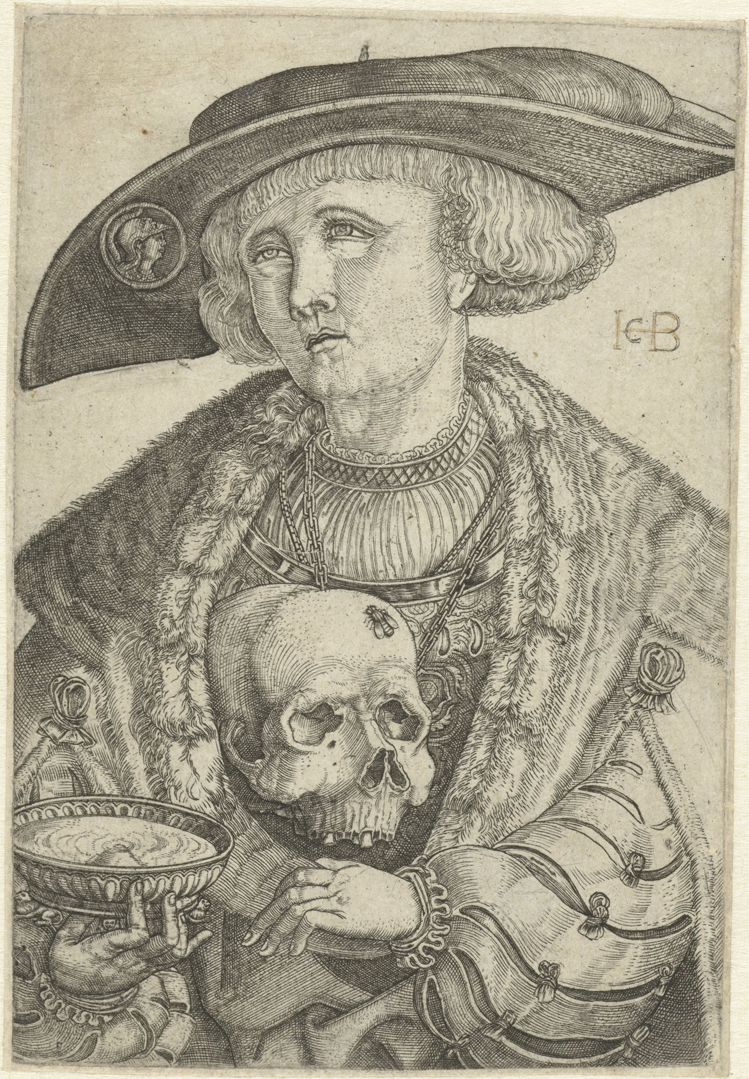 Jacob Binck. Self-portrait with a Skull. Engraving, c. 1525-1550. Rijksmuseum
Jacob Binck. Self-portrait with a Skull. Engraving, c. 1525-1550. Rijksmuseum 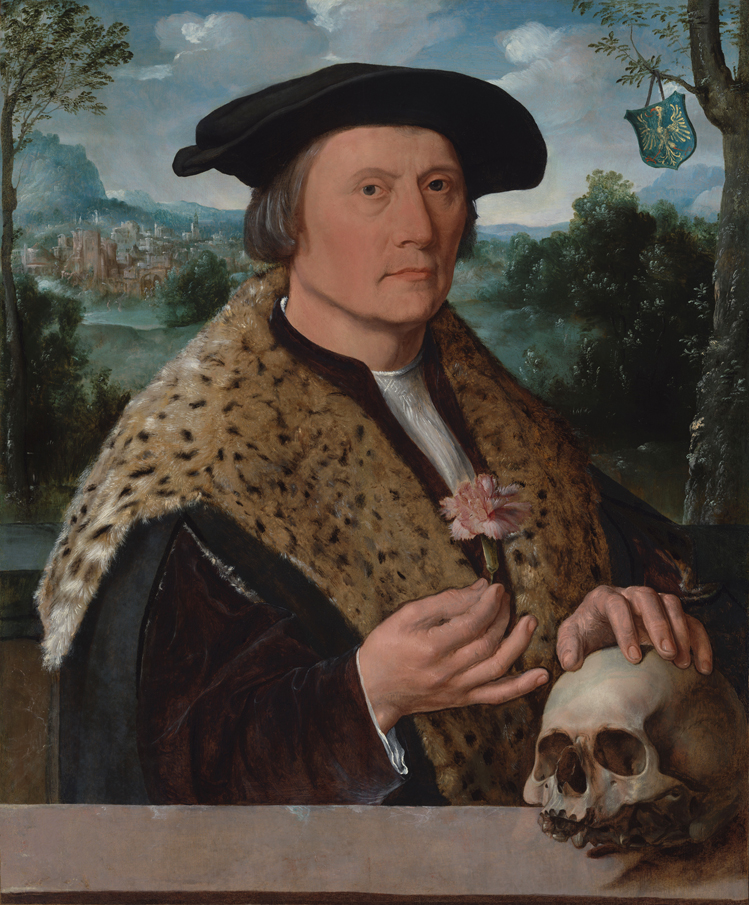 Dirck Jacobsz. Portrait of Pompeyo Occo with a Skull. Oil on panel, c. 1531. Rijksmuseum
Dirck Jacobsz. Portrait of Pompeyo Occo with a Skull. Oil on panel, c. 1531. Rijksmuseum 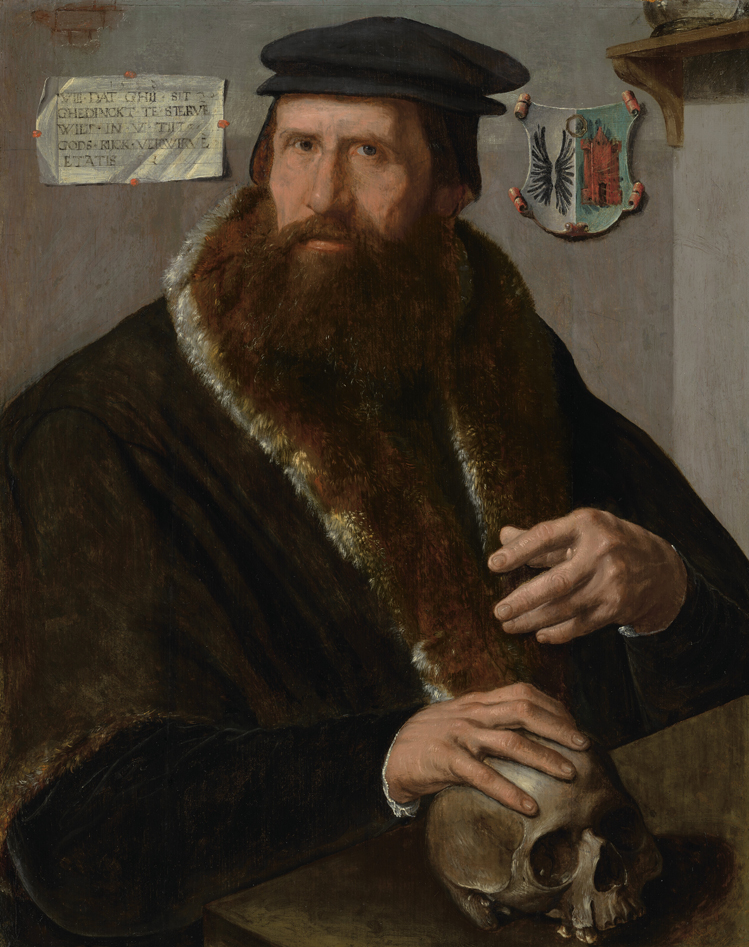 Dirck Jacobsz. Portrait of Pieter Jansz. Gaef, alias Spiegel, half-length, holding a skull. Oil on panel, 1558. Christie's
Dirck Jacobsz. Portrait of Pieter Jansz. Gaef, alias Spiegel, half-length, holding a skull. Oil on panel, 1558. Christie's 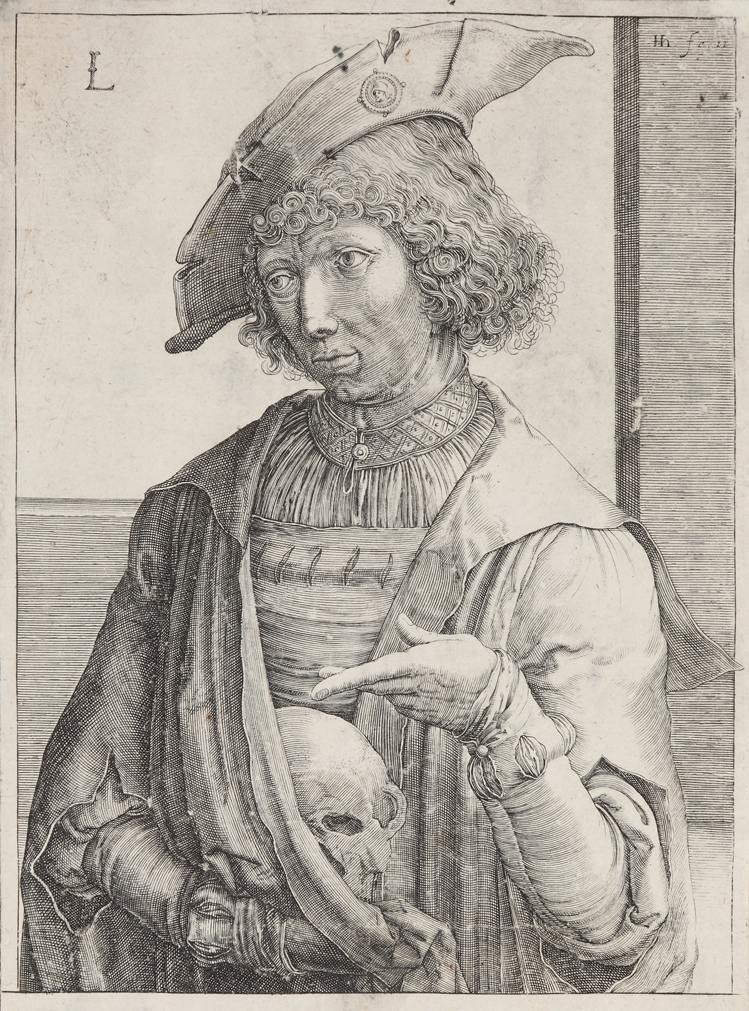 Hendrick Hondius I. Lucae Leidano Pictori, et Sculptori (Young Man with a Skull). Engraving, c. 1610. Colección Mariano Moret
Hendrick Hondius I. Lucae Leidano Pictori, et Sculptori (Young Man with a Skull). Engraving, c. 1610. Colección Mariano Moret
_____________________________________________________________________________________________
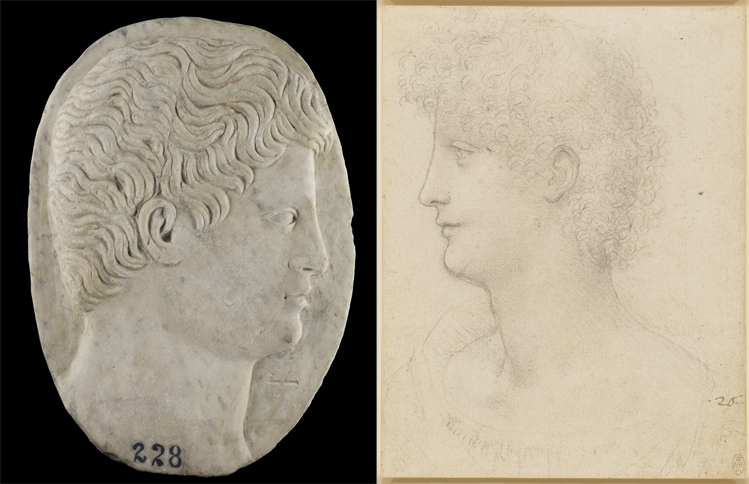 Attributed to the court of Emperor Frederick II Hohenstaufen workshop. The head of a youth. White marble, c. 1250. Museo Nacional del Prado Leonardo da Vinci. The head of a youth. Black chalk, c. 1517-1518. Royal Collection Trust
Attributed to the court of Emperor Frederick II Hohenstaufen workshop. The head of a youth. White marble, c. 1250. Museo Nacional del Prado Leonardo da Vinci. The head of a youth. Black chalk, c. 1517-1518. Royal Collection Trust 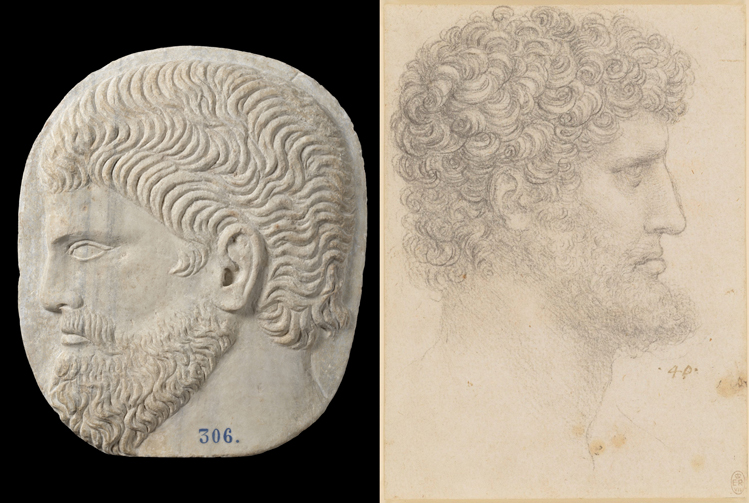 Attributed to the court of Emperor Frederick II Hohenstaufen workshop. The head of a bearded man. White marble, c. 1250. Museo Nacional del Prado Leonardo da Vinci. The head of a bearded man. Black chalk, c. 1517-1518. Royal Collection Trust Leonardo da Vinci looking to Antiquity. Wenceslaus Hollar looking to Leonardo da Vinci.
Attributed to the court of Emperor Frederick II Hohenstaufen workshop. The head of a bearded man. White marble, c. 1250. Museo Nacional del Prado Leonardo da Vinci. The head of a bearded man. Black chalk, c. 1517-1518. Royal Collection Trust Leonardo da Vinci looking to Antiquity. Wenceslaus Hollar looking to Leonardo da Vinci. 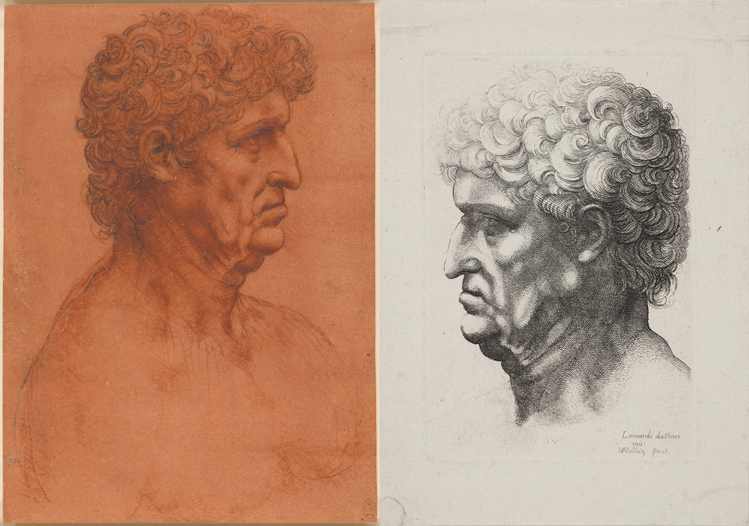 Leonardo da Vinci. The bust of a man. Red and black chalks on orange-red prepared paper, c. 1510. Royal Collection Trust Wenceslaus Hollar, after Leonardo da Vinci. The head of a man. Etching, c. 1644-1652. Colección Mariano Moret
Leonardo da Vinci. The bust of a man. Red and black chalks on orange-red prepared paper, c. 1510. Royal Collection Trust Wenceslaus Hollar, after Leonardo da Vinci. The head of a man. Etching, c. 1644-1652. Colección Mariano Moret
_____________________________________________________________________________________________
THEME & VARIATIONS: NARCISSO SPECULANDO
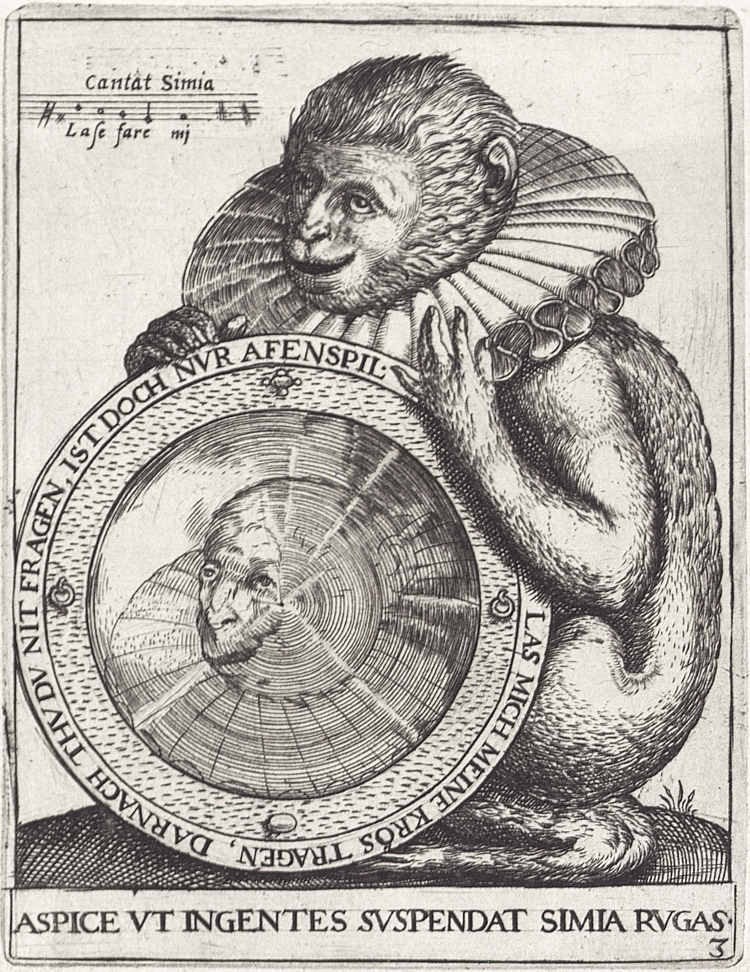 Johann Theodor de Bry. Emblemata: Cantat Simia. Engraving, 1596. Colección Mariano Moret
Johann Theodor de Bry. Emblemata: Cantat Simia. Engraving, 1596. Colección Mariano Moret 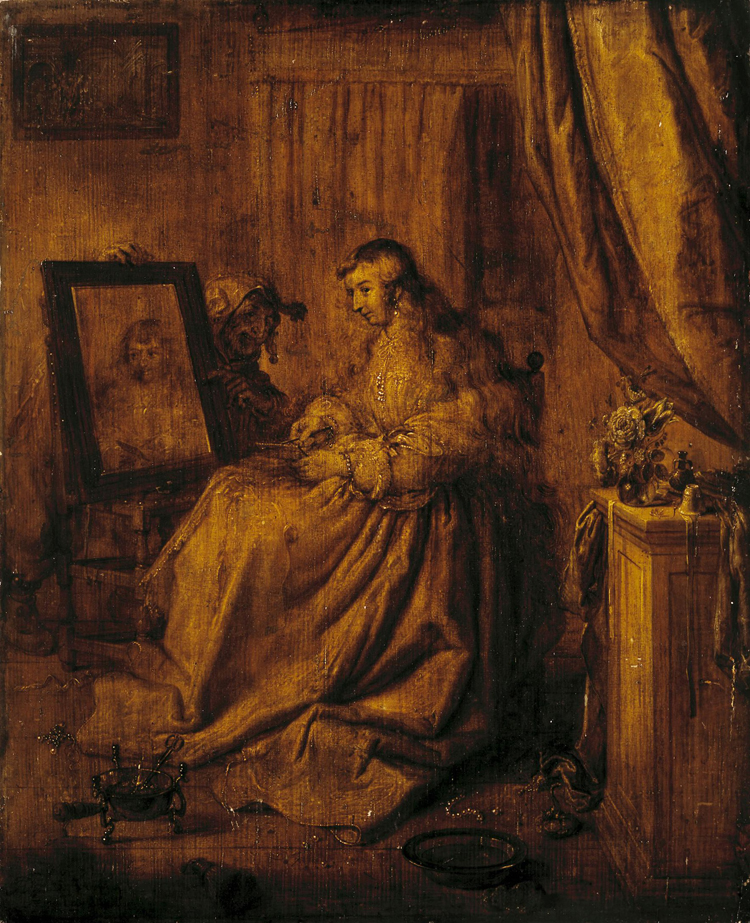 Adriaen van de Venne. Allegory of Vanity. Oil on panel, 1630. The State Hermitage Museum
Adriaen van de Venne. Allegory of Vanity. Oil on panel, 1630. The State Hermitage Museum 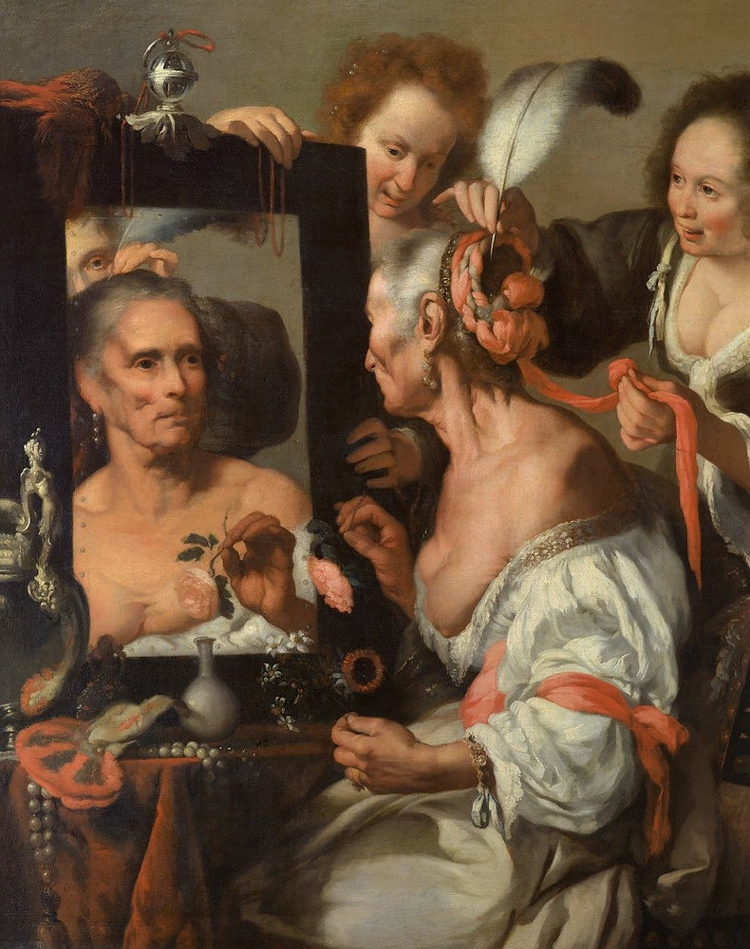 Bernardo Strozzi. Allegory of Vanity (Old Coquette). Oil on canvas, 1637. The Pushkin Museum of Fine Arts
Bernardo Strozzi. Allegory of Vanity (Old Coquette). Oil on canvas, 1637. The Pushkin Museum of Fine Arts 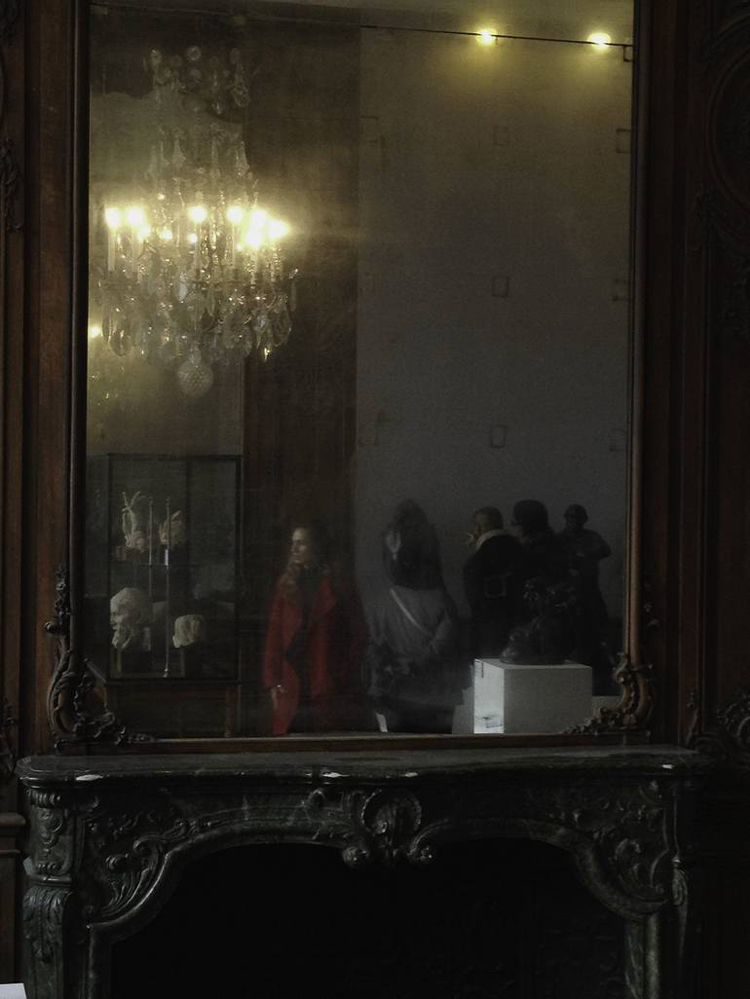 Barry Kootchin. Woman in red. Photography, Digital on Paper, 2012. Saatchi Gallery
Barry Kootchin. Woman in red. Photography, Digital on Paper, 2012. Saatchi Gallery
_____________________________________________________________________________________________
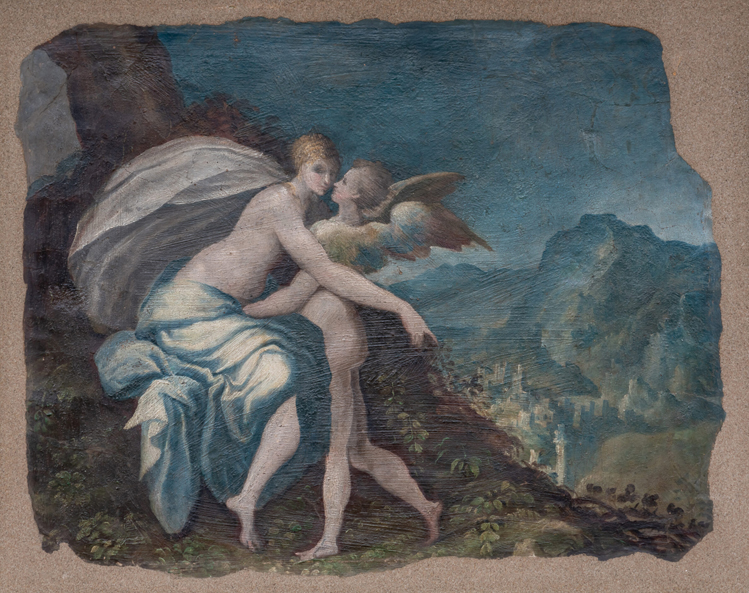 Jacopo Zanguidi, called il Bertoja. Cupid and Psyche. Oil on plaster laid down on canvas, c. 1566-1568. Parma, Palazzo del Giardino
Jacopo Zanguidi, called il Bertoja. Cupid and Psyche. Oil on plaster laid down on canvas, c. 1566-1568. Parma, Palazzo del Giardino 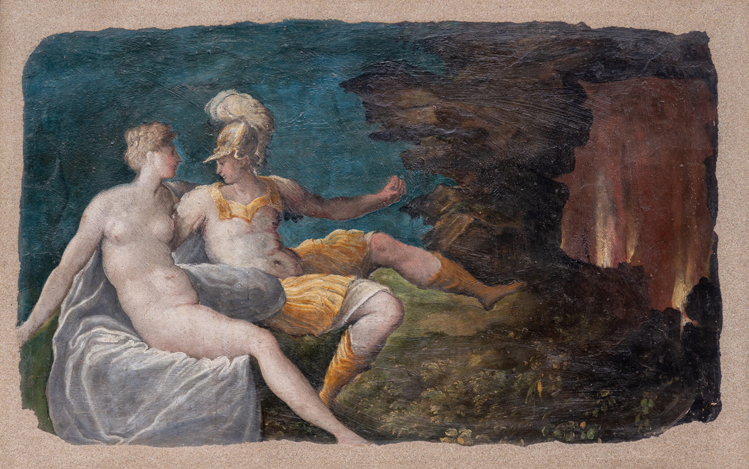 Jacopo Zanguidi, called il Bertoja. Mars and Venus. Oil on plaster laid down on canvas, c. 1566-1568. Parma, Palazzo del Giardino
Jacopo Zanguidi, called il Bertoja. Mars and Venus. Oil on plaster laid down on canvas, c. 1566-1568. Parma, Palazzo del Giardino 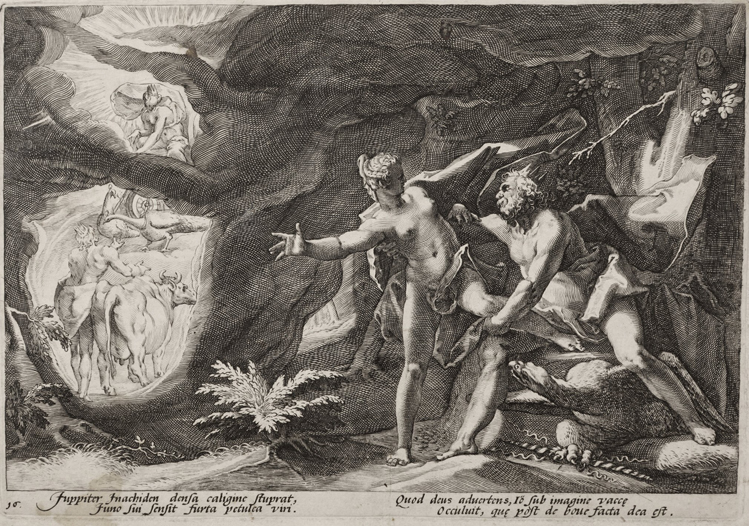 Hendrik Goltzius and workshop. Jupiter and Io. Engraving, 1589. Colección Mariano Moret
Hendrik Goltzius and workshop. Jupiter and Io. Engraving, 1589. Colección Mariano Moret
_____________________________________________________________________________________________
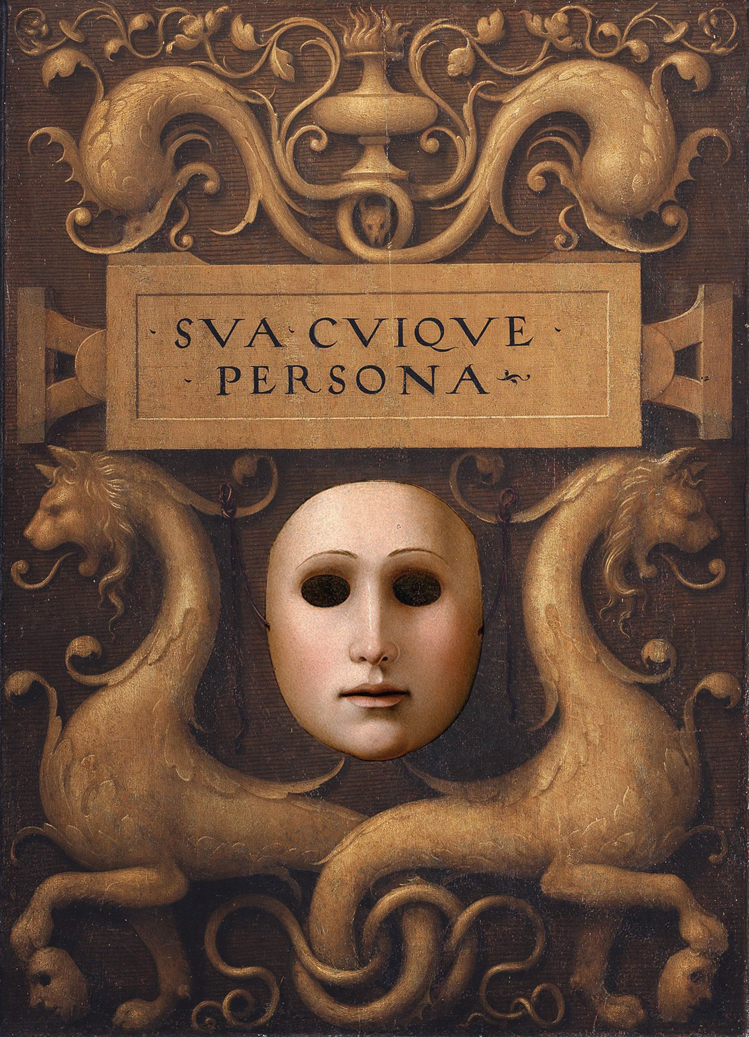 Attributed to Ridolfo Ghirlandaio. Grotesche with a mask. Oil on panel, c. 1510. Gallerie degli Uffizi
Attributed to Ridolfo Ghirlandaio. Grotesche with a mask. Oil on panel, c. 1510. Gallerie degli Uffizi 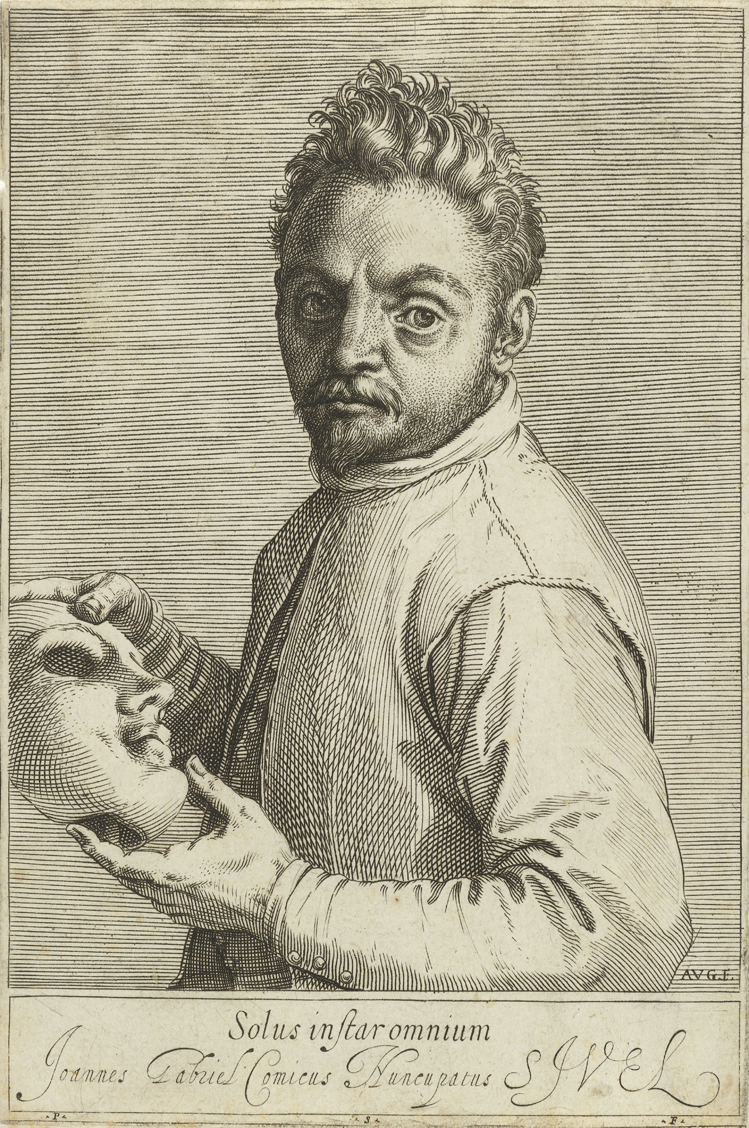 Agostino Carracci. Giovanni Gabrielli "Il Sivello". Engraving, c. 1559. Rijksmuseum
Agostino Carracci. Giovanni Gabrielli "Il Sivello". Engraving, c. 1559. Rijksmuseum 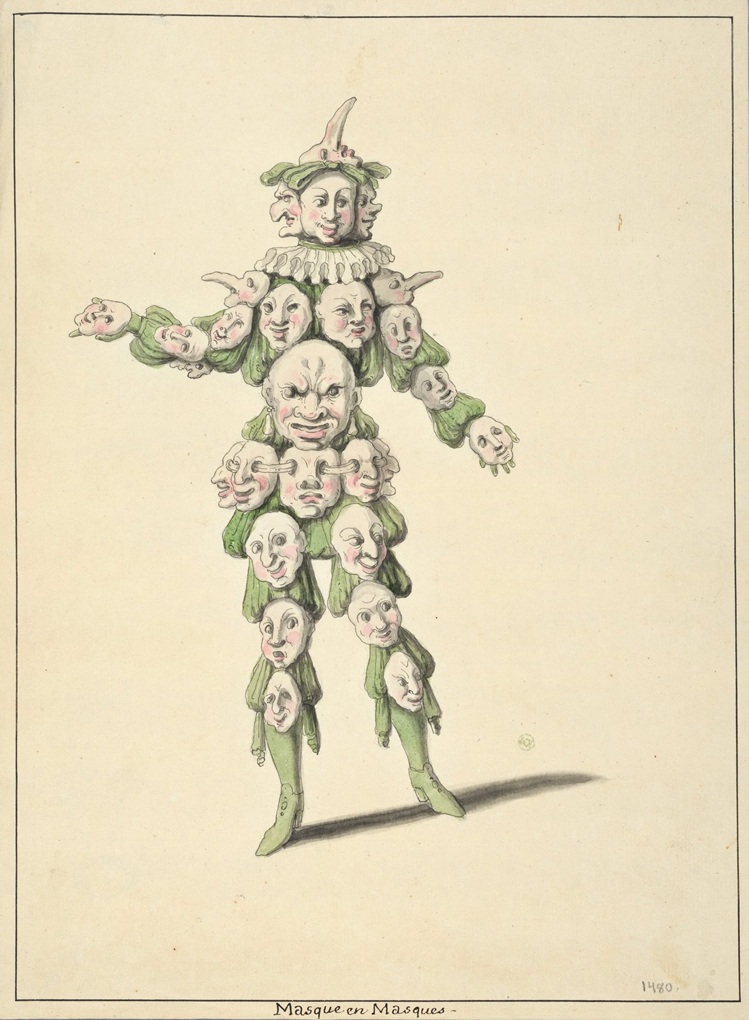 Jean Berain I. Masque en Masques, costume for masquerade. Pen and black ink, wash and watercolour on paper. Stockholm Nationalmuseum
Jean Berain I. Masque en Masques, costume for masquerade. Pen and black ink, wash and watercolour on paper. Stockholm Nationalmuseum 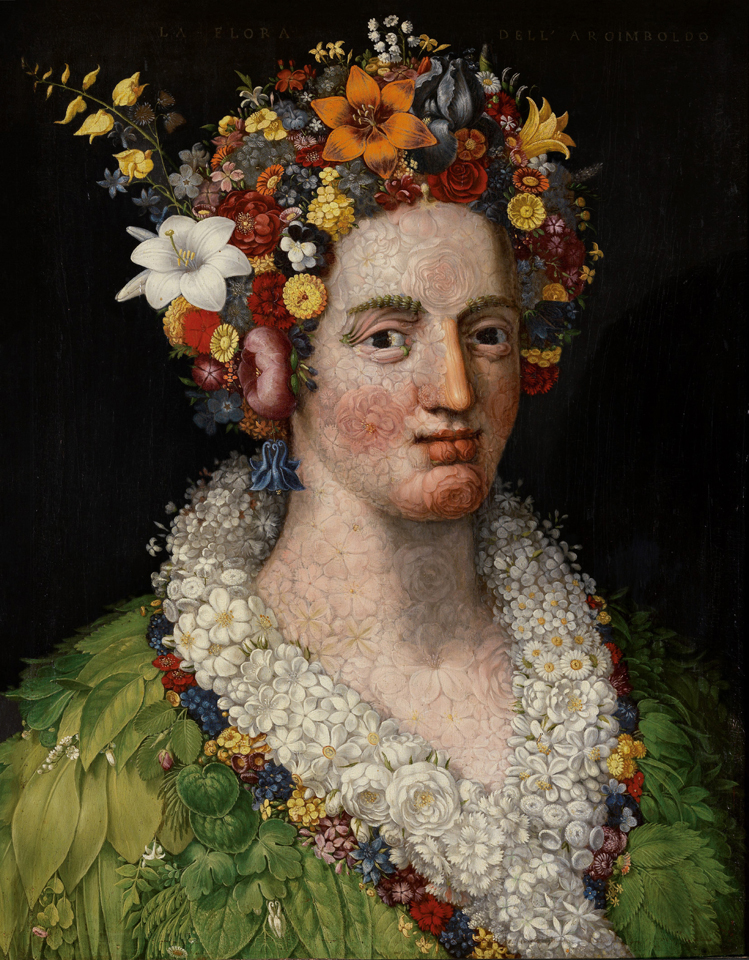 Giuseppe Arcimboldo. Flora. Oil on panel, c. 1589. Madrid, private collection.
Giuseppe Arcimboldo. Flora. Oil on panel, c. 1589. Madrid, private collection. 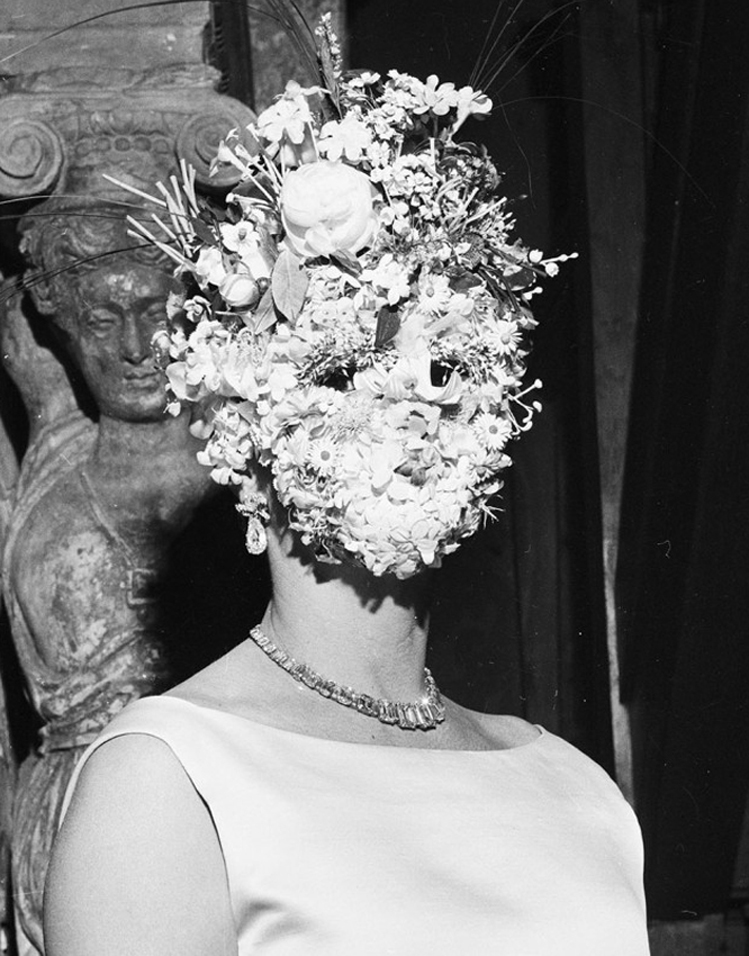 André Ostier. Patricia Lopez-Willshaw, Bal d'Hiver, Hôtel de Coulanges, 30 décembre 1958. © A. & A. Ostier
André Ostier. Patricia Lopez-Willshaw, Bal d'Hiver, Hôtel de Coulanges, 30 décembre 1958. © A. & A. Ostier 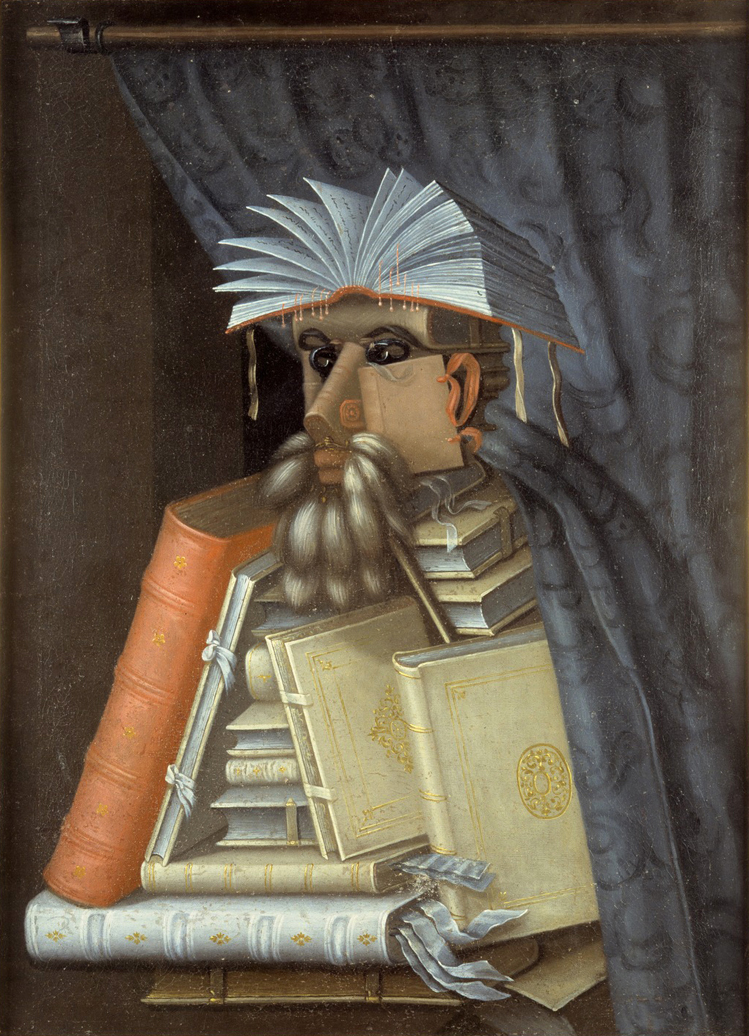 Giuseppe Arcimboldo. The Librarian. Oil on canvas, c. 1566. Skokloster Slott
Giuseppe Arcimboldo. The Librarian. Oil on canvas, c. 1566. Skokloster Slott 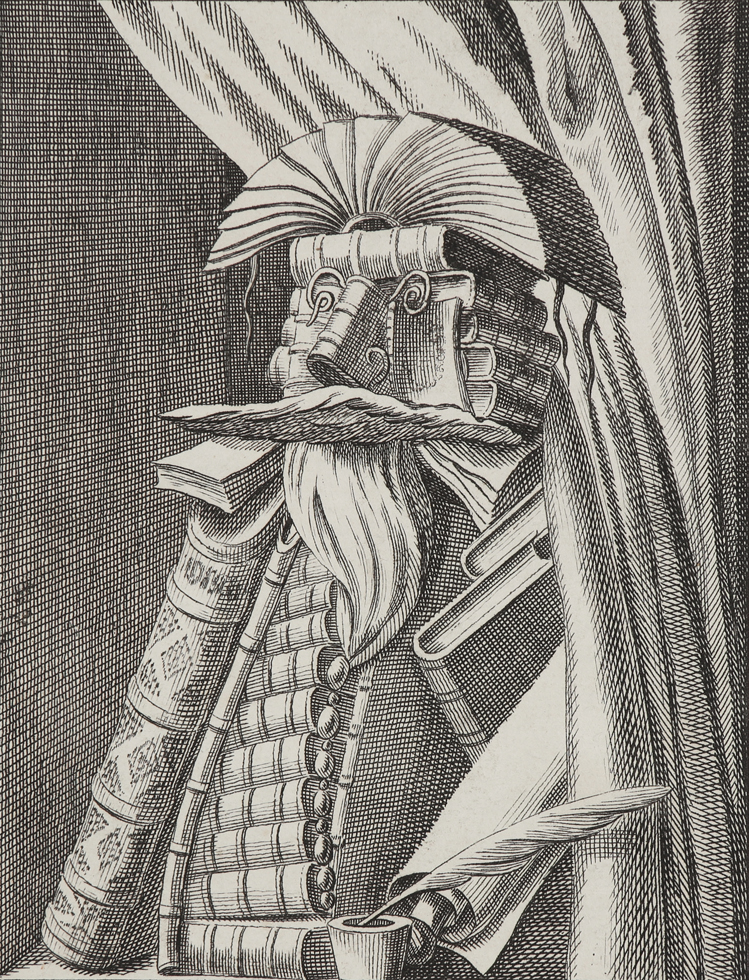
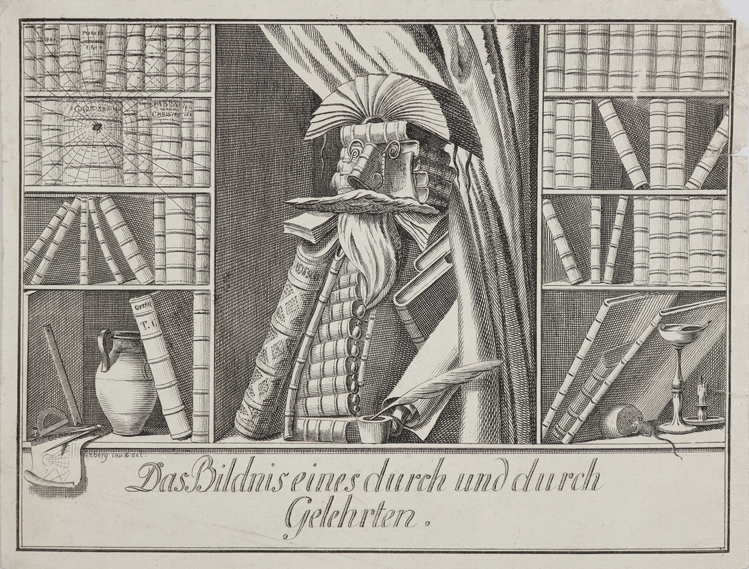 Carl C. Glassbach. The Librarian (Das Bildnis eines durch und durch Gelehrten). Etching, c. 1775. Colección Mariano Moret
Carl C. Glassbach. The Librarian (Das Bildnis eines durch und durch Gelehrten). Etching, c. 1775. Colección Mariano Moret
___________________________________________________________________________________
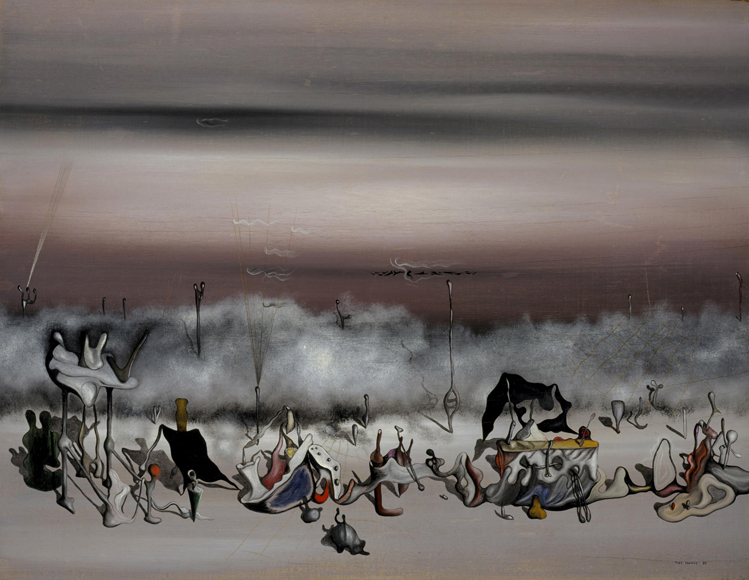 Yves Tanguy. Le Ruban des excès. Oil on wood, 1932. National Galleries of Scotland
Yves Tanguy. Le Ruban des excès. Oil on wood, 1932. National Galleries of Scotland 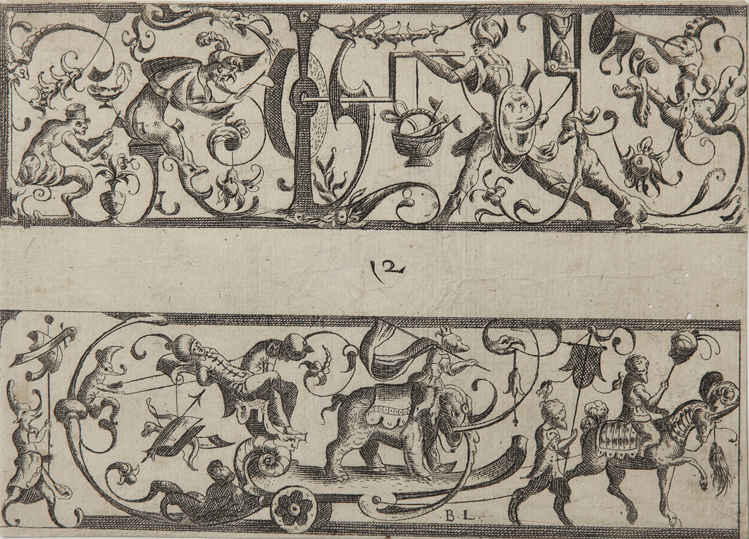 Monogrammist BL. LEMERCIER, Balthazar (?) or LEMKEN, Balthazar (?), (Paris, active 1626-1634), reverse copy after Lucas Kilian. Two panels with grotesque figures. Engraving, c. 1626-1634. Colección Mariano Moret
Monogrammist BL. LEMERCIER, Balthazar (?) or LEMKEN, Balthazar (?), (Paris, active 1626-1634), reverse copy after Lucas Kilian. Two panels with grotesque figures. Engraving, c. 1626-1634. Colección Mariano Moret
___________________________________________________________________________________
THEME & VARIATIONS: ALL'ANTICA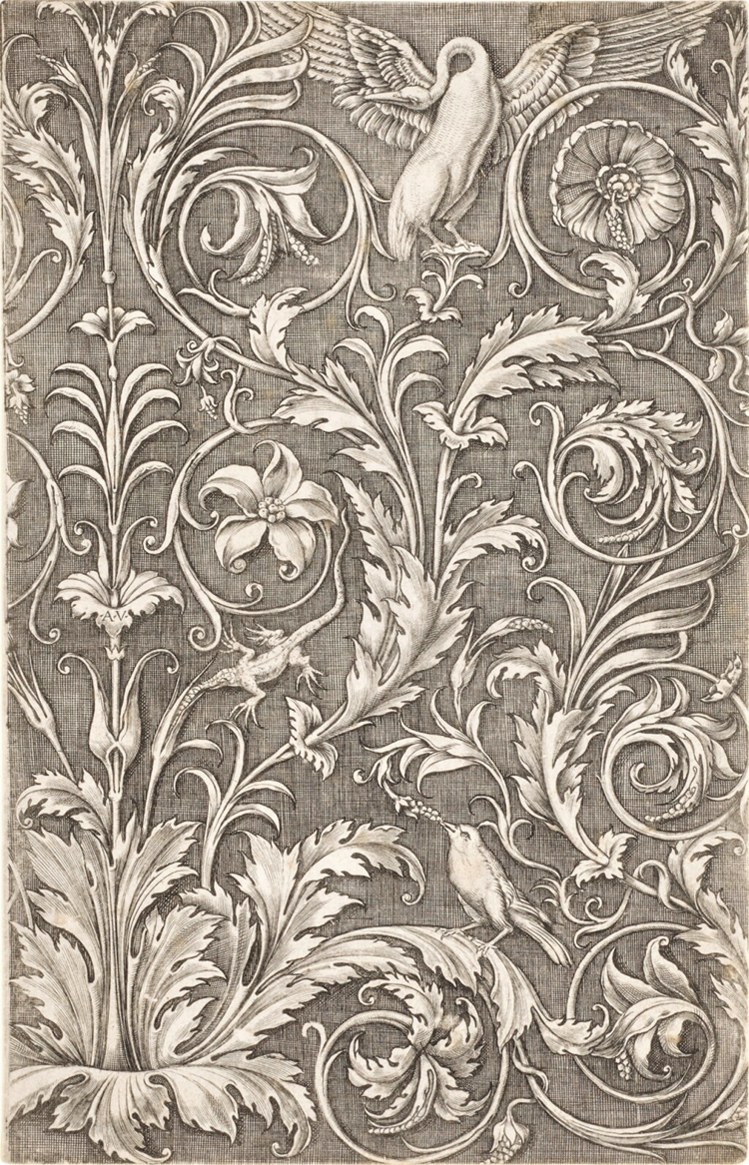
Agostino Veneziano. An ornamental pnel with a swan with outstretched wings. Engraving, c. 1530. Sotheby's
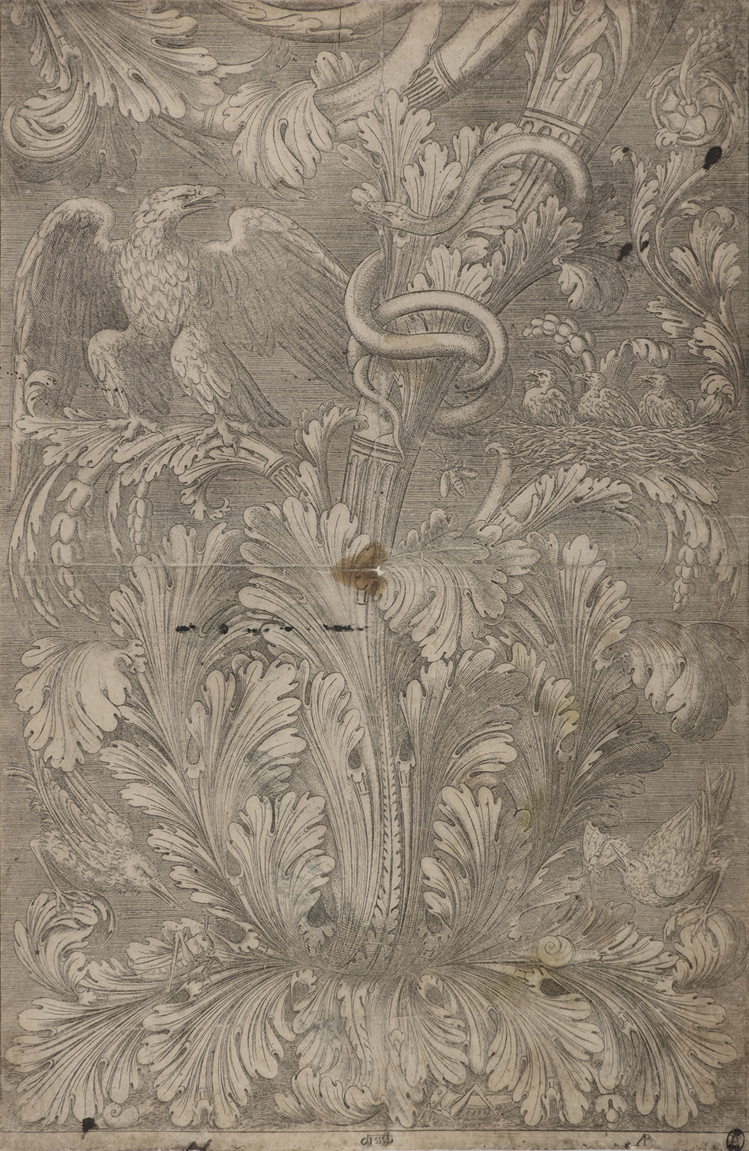 Monogrammist AP. An ornamental panel with acanthus leaves, eagle and other birds and insects. Etching, 1555. Colección Mariano Moret.
Monogrammist AP. An ornamental panel with acanthus leaves, eagle and other birds and insects. Etching, 1555. Colección Mariano Moret.
The Mariano Moret Collection preserves the only print by Master AP documented in Spain.
Master AP is a mysterious anonymous artist active in Rome between 1550 and 1560 who is distinguished by the AP monogram that appears in all his works, but, What identity is hidden behind these initials?
Could they correspond to the famous architect Andrea Palladio?
Michael J. Waters develops a proposal for the identification of the enigmatic AP Master in the following article: Who was Master AP?
___________________________________________________________________________________
THEME & VARIATIONS: NARCISSO SPECULANDO
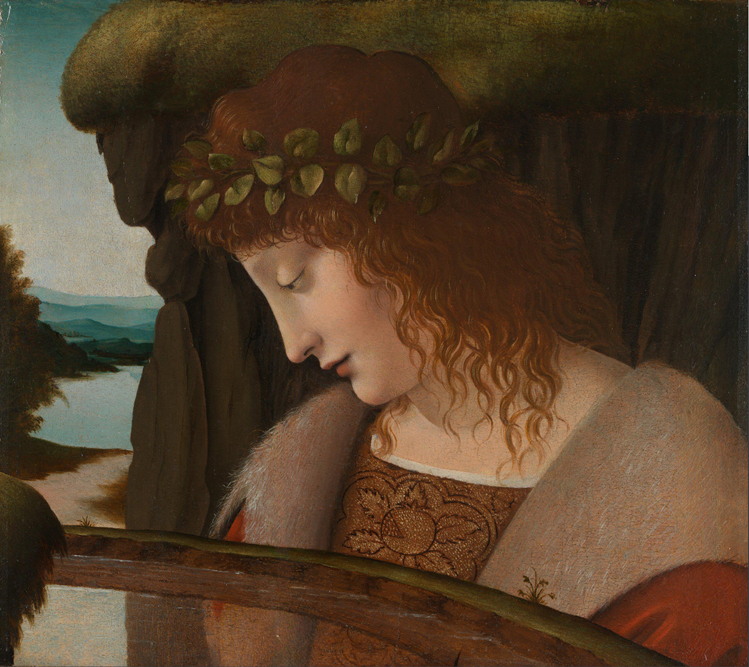 Follower of Giovanni Antonio Boltraffio. Narcissus. Oil on walnut, c. 1500. The National Gallery
Follower of Giovanni Antonio Boltraffio. Narcissus. Oil on walnut, c. 1500. The National Gallery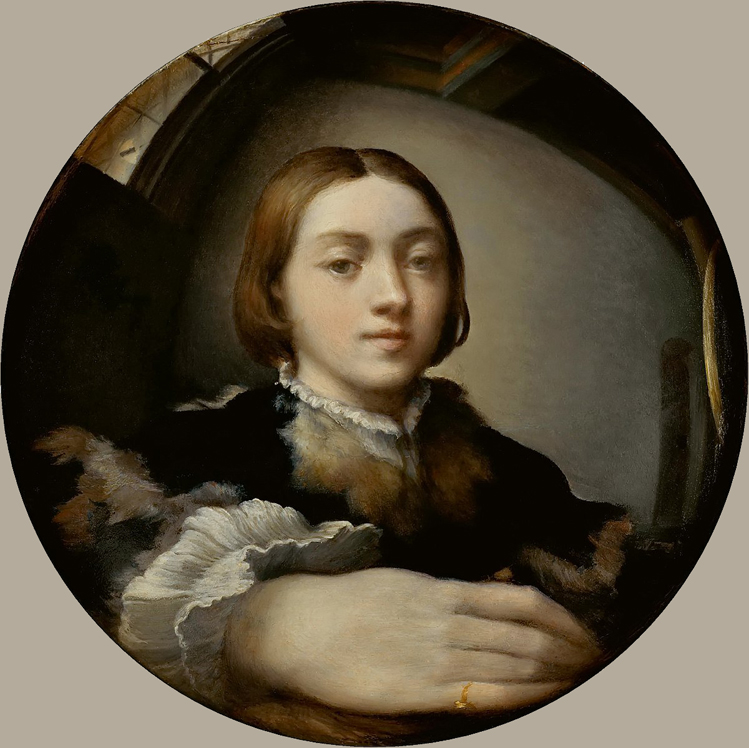 Francesco Mazzola, il Parmigianino. Self-portrait in a Convex Mirror. Oil on convex panel, c. 1524. Kunsthistorisches Museum
Francesco Mazzola, il Parmigianino. Self-portrait in a Convex Mirror. Oil on convex panel, c. 1524. Kunsthistorisches Museum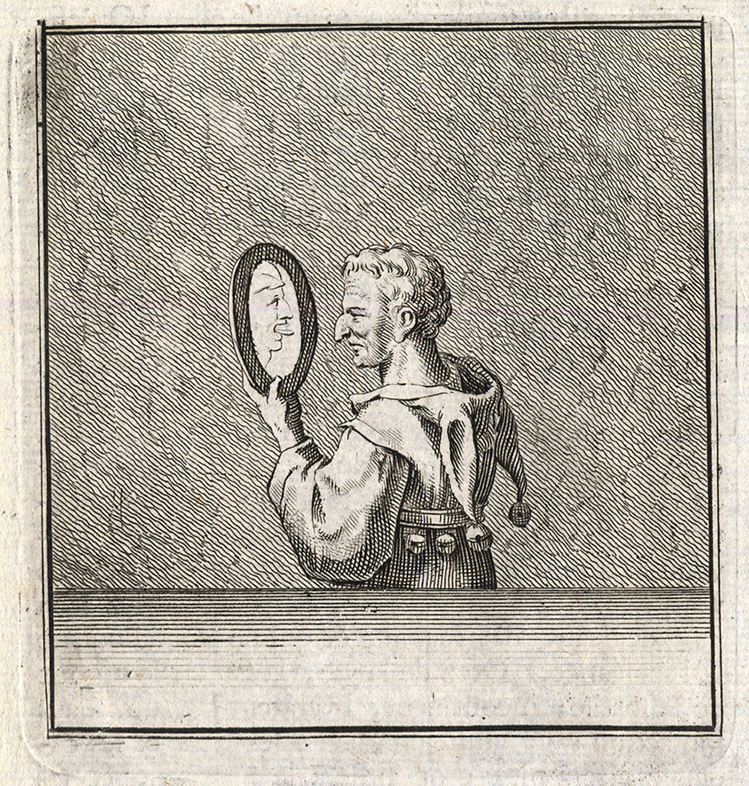 Anonymous Dutch engraver, after Hans Holbein the Younger. The fool admiring himself in a mirror, Engraving, h. 1728. Colección Mariano Moret
Anonymous Dutch engraver, after Hans Holbein the Younger. The fool admiring himself in a mirror, Engraving, h. 1728. Colección Mariano Moret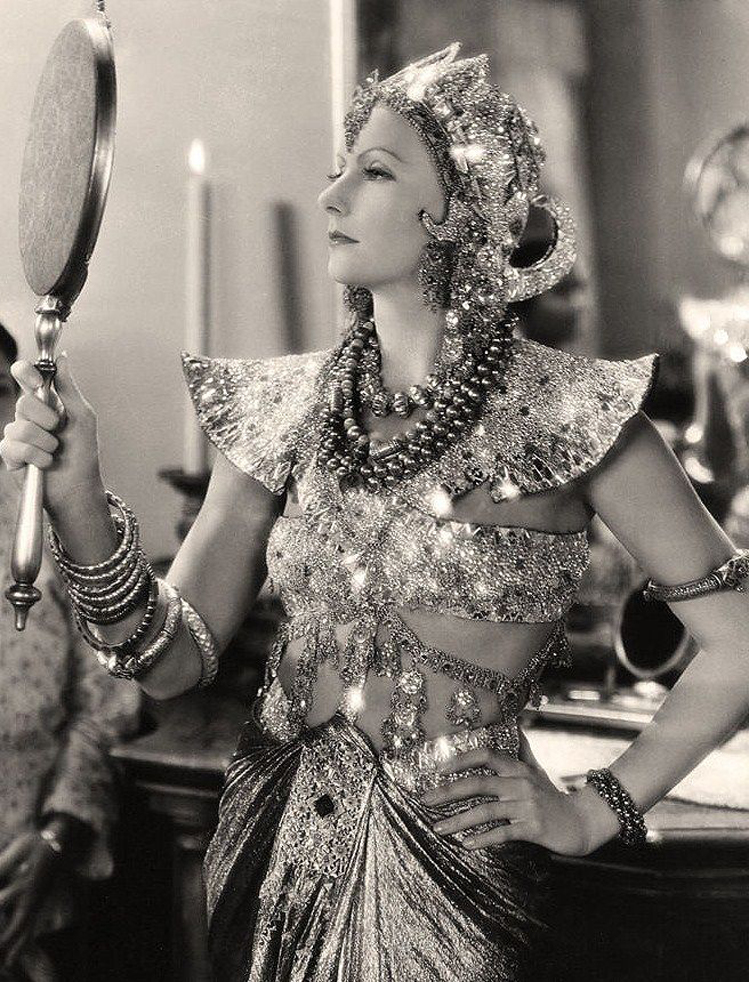 Greta Garbo in Wild Orchids. Sidney Franklin, 1929
Greta Garbo in Wild Orchids. Sidney Franklin, 1929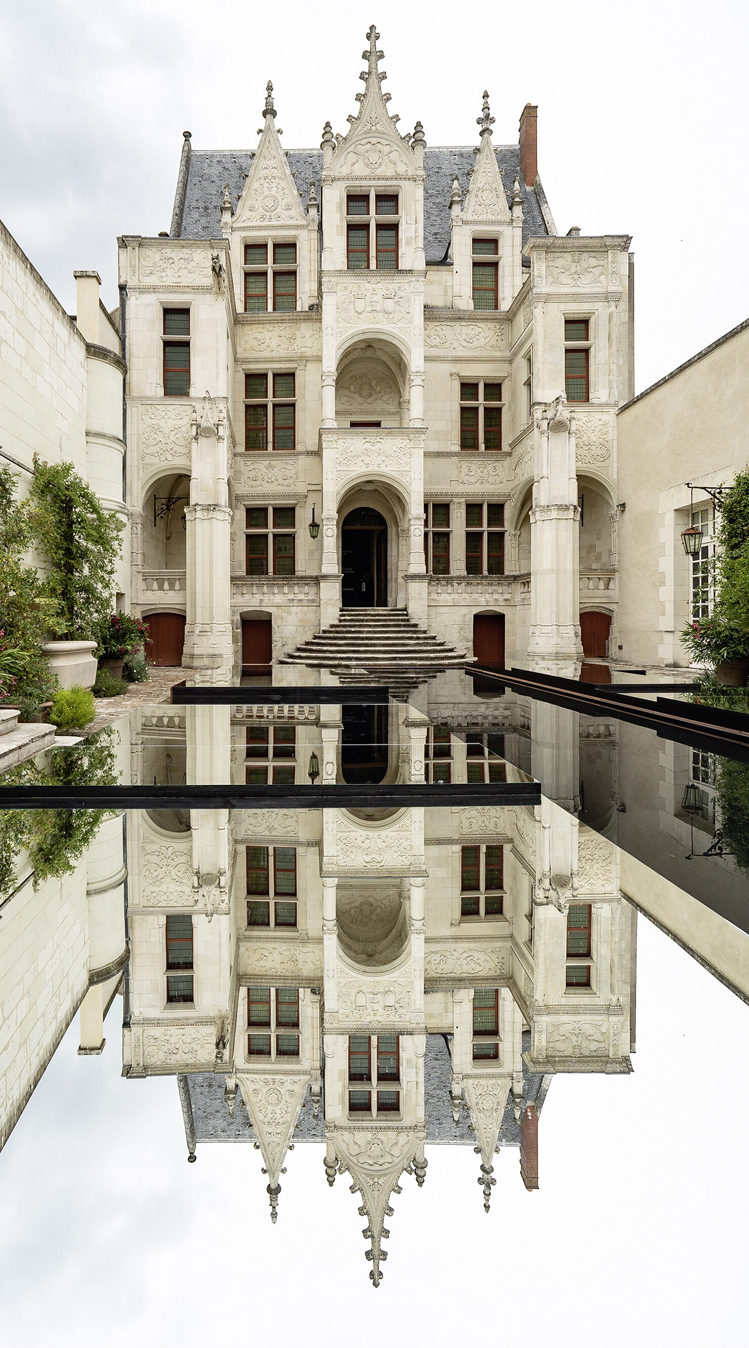 Alice & Nicolas Stadler. Miroir d'eau de l'Hôtel Goüin, 2018
Alice & Nicolas Stadler. Miroir d'eau de l'Hôtel Goüin, 2018___________________________________________________________________________________
THEME & VARIATIONS: MANET MISE EN ABYME
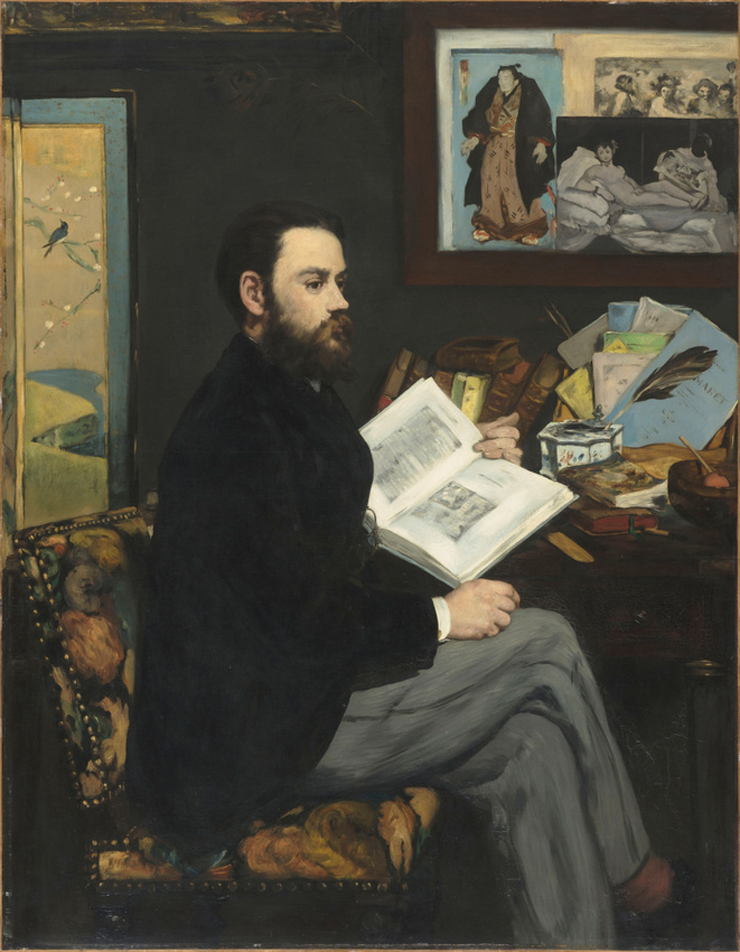 Édouard Manet. Portrait of Émile Zola (detail). Oil on canvas, 1868. Musée d'Orsay
Édouard Manet. Portrait of Émile Zola (detail). Oil on canvas, 1868. Musée d'Orsay 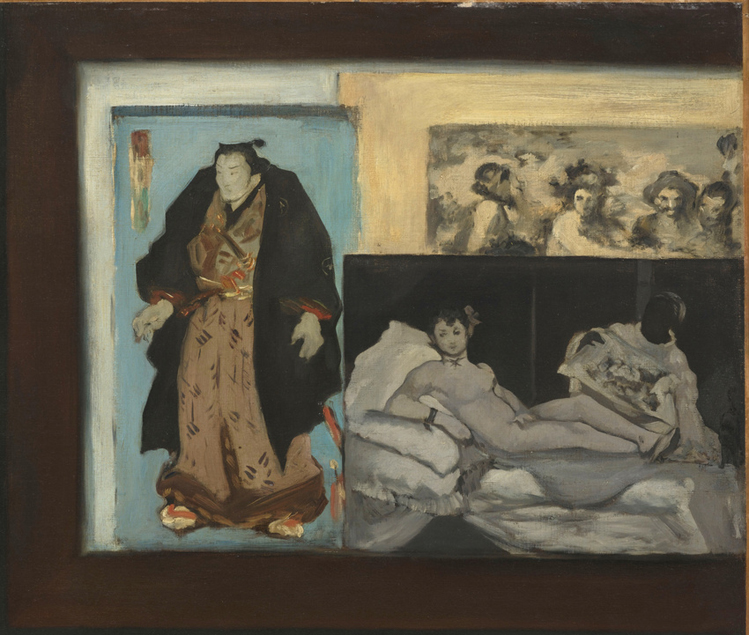
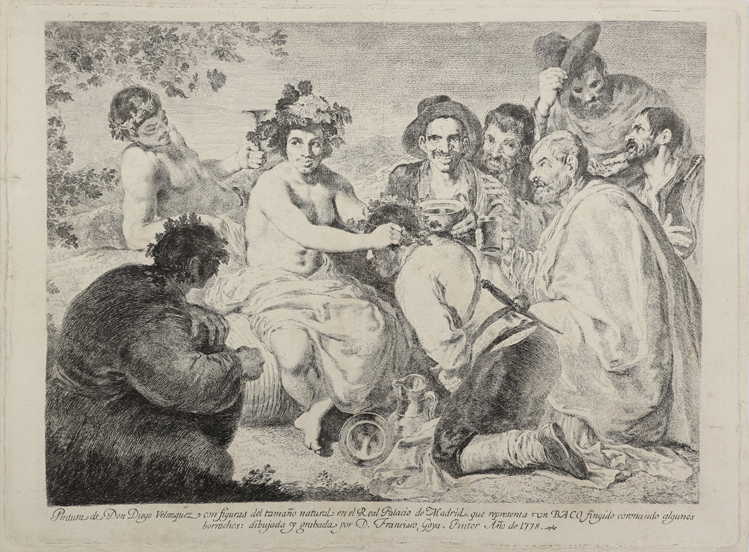 Francisco de Goya, after Diego Velázquez. The Feast of Bacchus. Etching, 1778. Colección Mariano Moret
Francisco de Goya, after Diego Velázquez. The Feast of Bacchus. Etching, 1778. Colección Mariano Moret 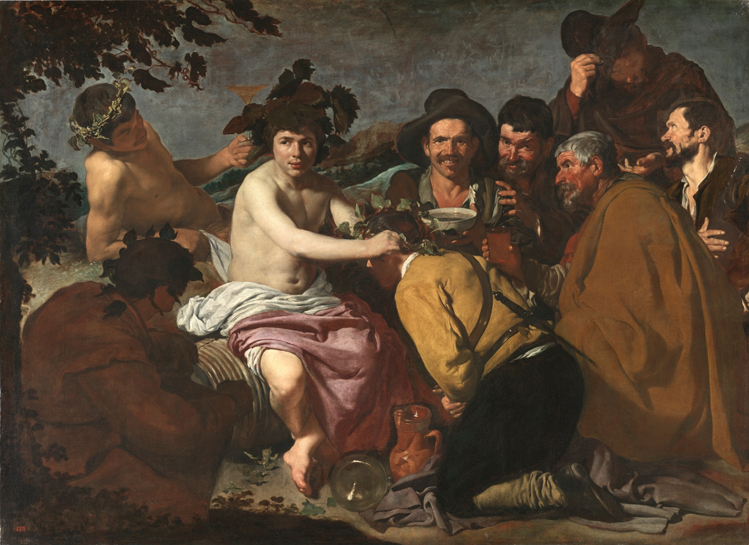 Diego Velázquez. The Feast of Bacchus. Oil on canvas, 1628-1629. Museo del Prado
Diego Velázquez. The Feast of Bacchus. Oil on canvas, 1628-1629. Museo del Prado ____________________________________________________________________________________
THEME & VARIATIONS: MARIE OR NOT MARIE?
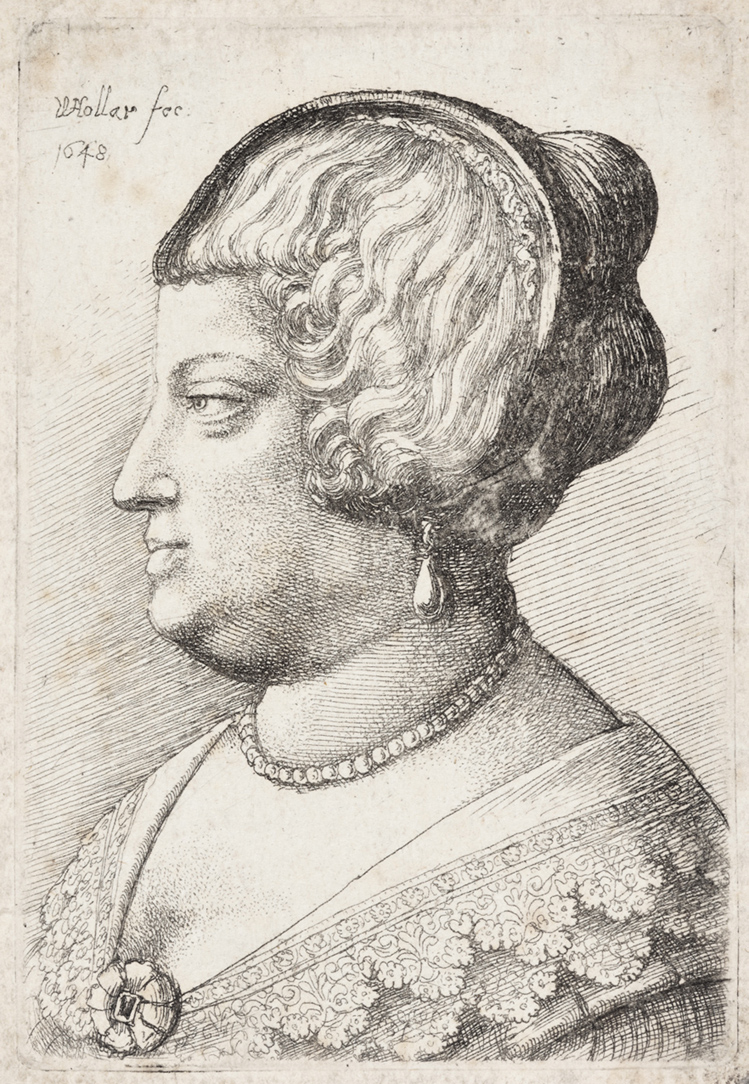 Wenceslaus Hollar. Portrait of a woman identified as Marie de Médicis. Etching, 1648. Colección Mariano Moret
Wenceslaus Hollar. Portrait of a woman identified as Marie de Médicis. Etching, 1648. Colección Mariano Moret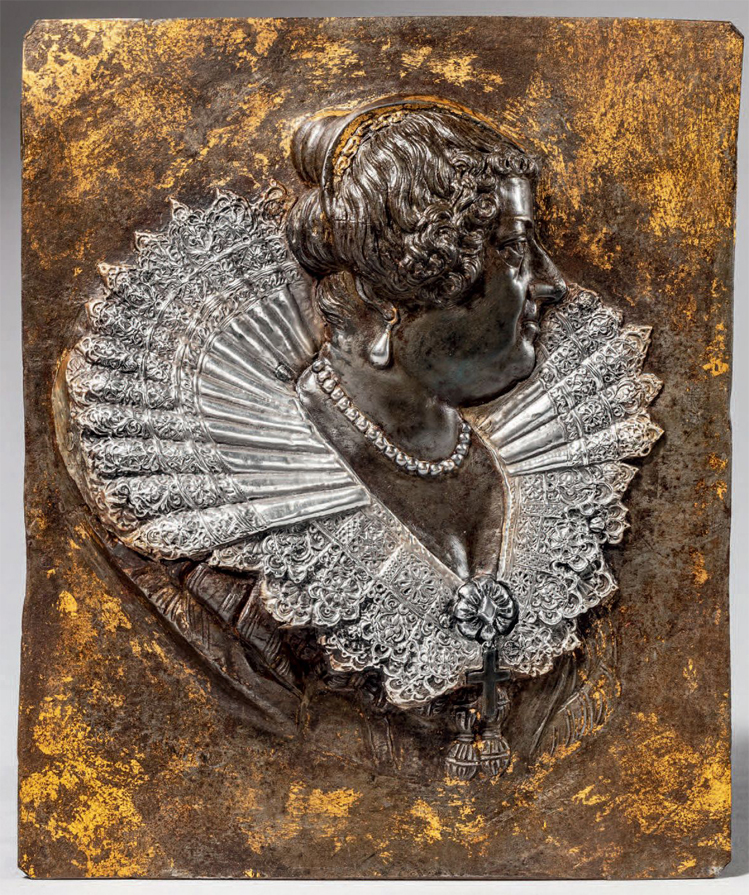 Workshop of Guillaume Dupré. Marie de Médicis, Queen of France. Silver plated repoussé iron with gilding, c. 1600-1625. Giquello
Workshop of Guillaume Dupré. Marie de Médicis, Queen of France. Silver plated repoussé iron with gilding, c. 1600-1625. Giquello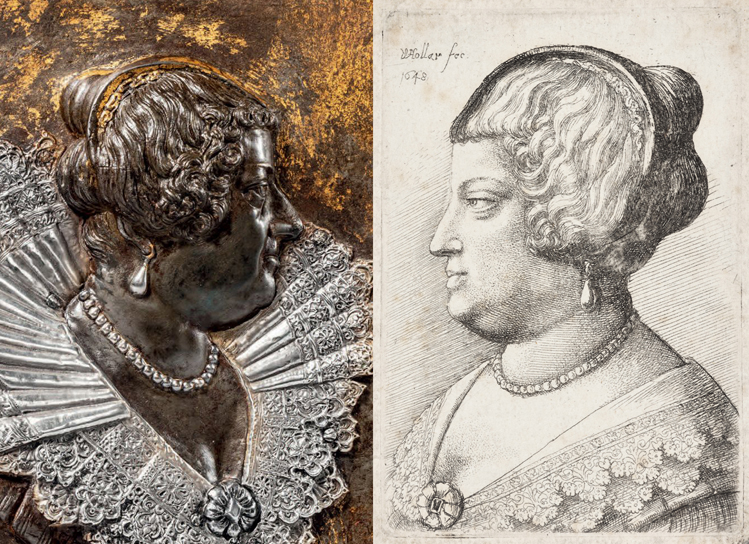
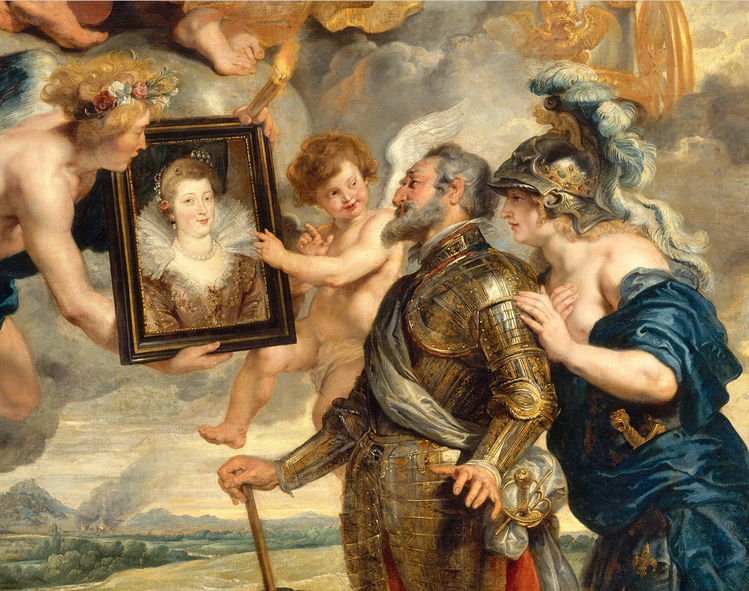 Peter Paul Rubens. Henri IV reçoit le portrait de Marie de Médicis et se laisse désarmer par l’Amour (detail). Oil on canvas, c. 1600-1650. Musée du Louvre
Peter Paul Rubens. Henri IV reçoit le portrait de Marie de Médicis et se laisse désarmer par l’Amour (detail). Oil on canvas, c. 1600-1650. Musée du Louvre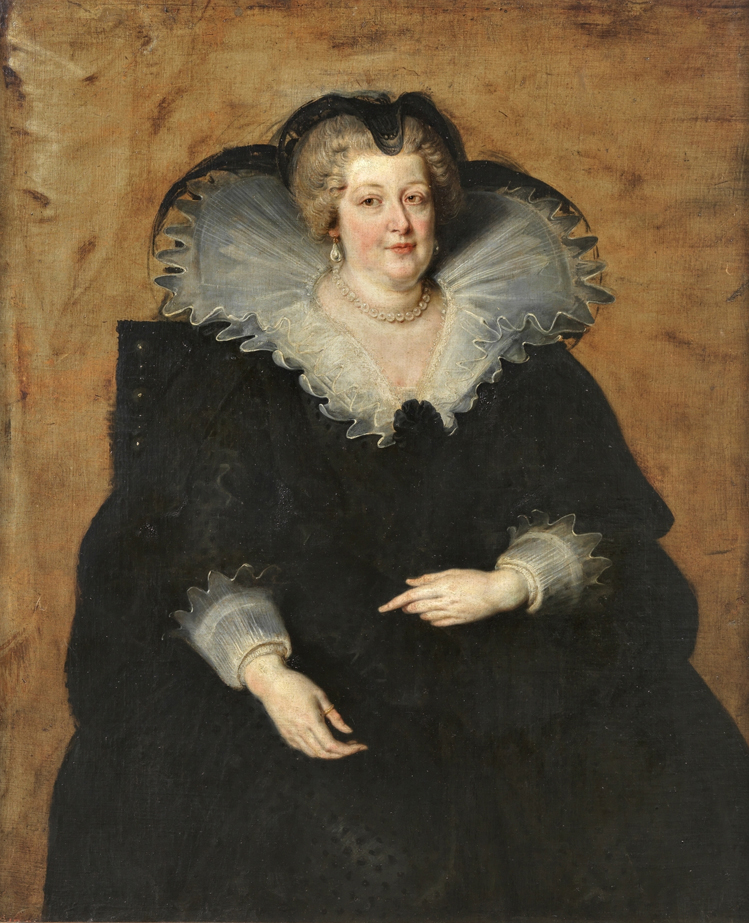 Peter Paul Rubens. Marie de Médicis, Queen of France. Oil on canvas, c. 1622. Museo del Prado
Peter Paul Rubens. Marie de Médicis, Queen of France. Oil on canvas, c. 1622. Museo del Prado____________________________________________________________________________________
THEME & VARIATIONS: FAMILY AND DEATH
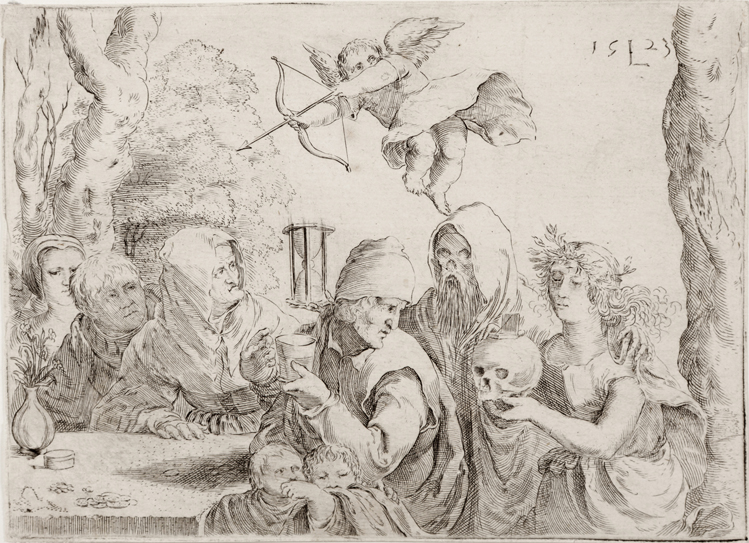 Follower of Lucas van Leyden. A Family Surprised by Death. Engraving, c. 1523-1599. Colección Mariano Moret
Follower of Lucas van Leyden. A Family Surprised by Death. Engraving, c. 1523-1599. Colección Mariano Moret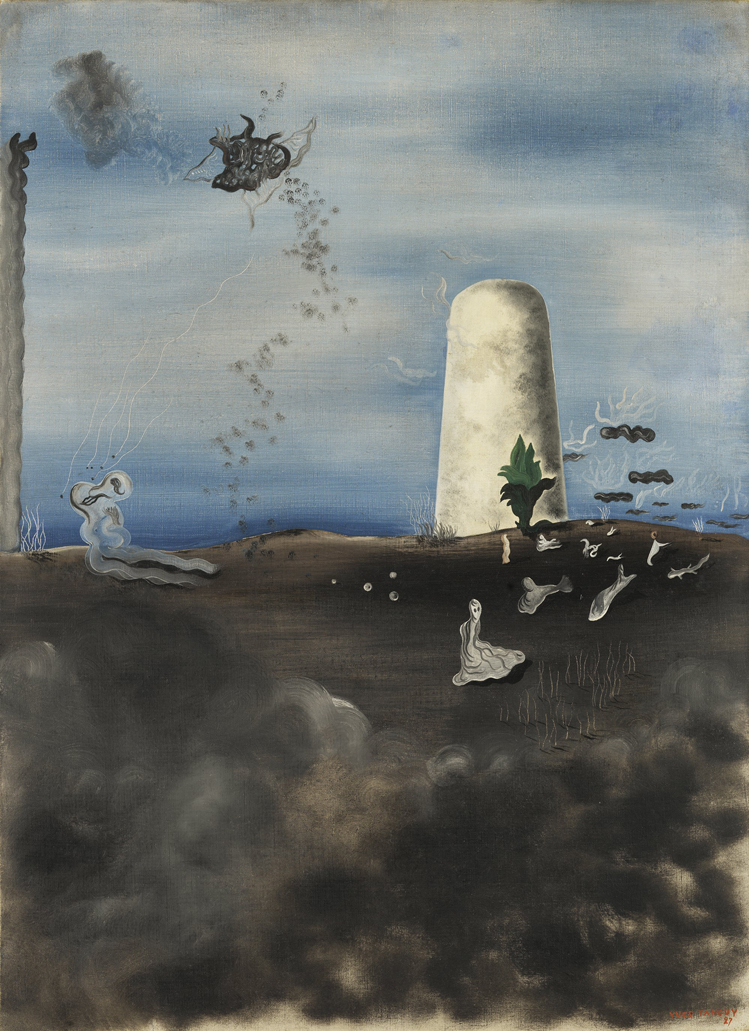 Yves Tanguy. Death Watching his Family. Oil on canvas, 1927. Museo Nacional Thyssen-Bornemisza
Yves Tanguy. Death Watching his Family. Oil on canvas, 1927. Museo Nacional Thyssen-Bornemisza____________________________________________________________________________________
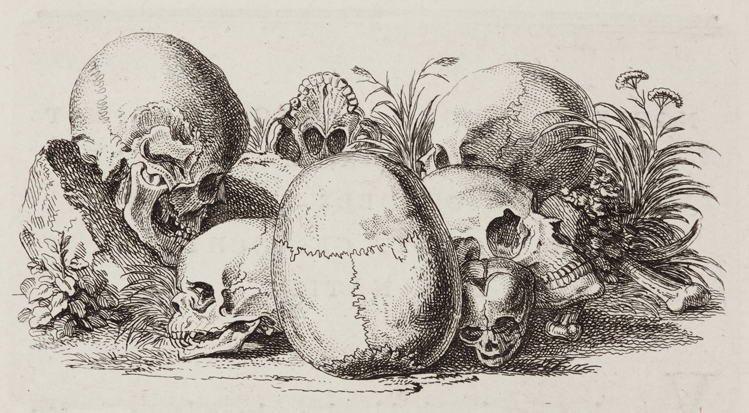 Johann Rudolph Schellenberg. Vanitas. Etching, c. 1775. Colección Mariano Moret
Johann Rudolph Schellenberg. Vanitas. Etching, c. 1775. Colección Mariano Moret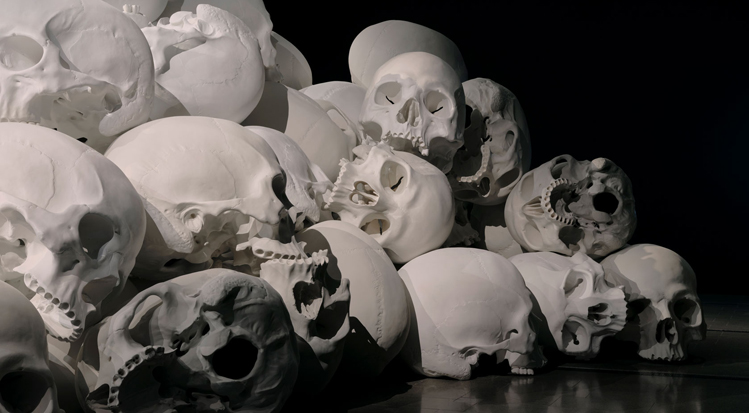 Ron Mueck. Mass 2016-2017. Synthetic polymer paint on fibreglass. National Gallery of Victoria, Felton Bequest, 2018
Ron Mueck. Mass 2016-2017. Synthetic polymer paint on fibreglass. National Gallery of Victoria, Felton Bequest, 2018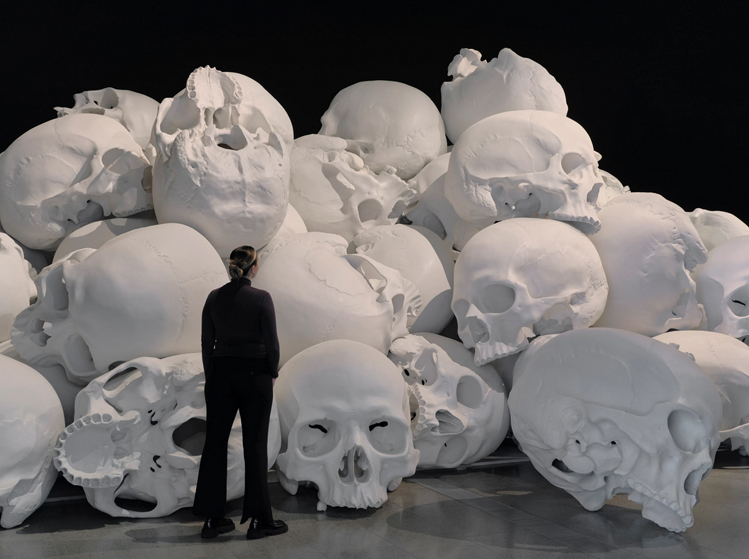
Ron Mueck. Mass 2016-2017. Synthetic polymer paint on fibreglass. National Gallery of Victoria, Felton Bequest, 2018. Fondation Cartier
____________________________________________________________________________________
CURRENT EXHIBITION
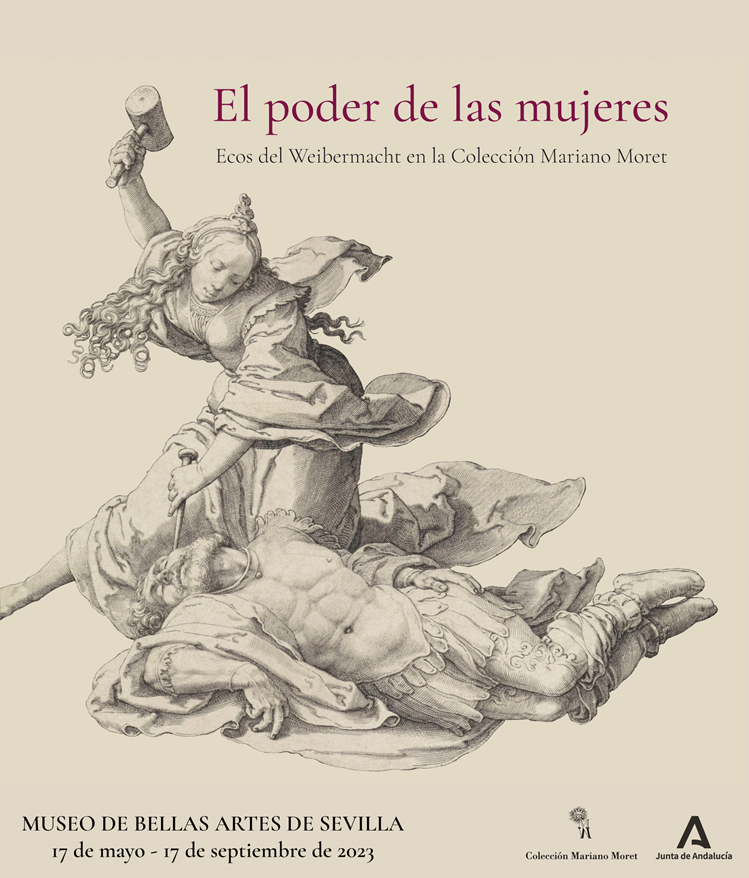 The Power of Women Echoes of the Weibermacht in the Mariano Moret Collection
The Power of Women Echoes of the Weibermacht in the Mariano Moret Collection Museo de Bellas Artes de Sevilla May 17 - September 17, 2023
EXHIBITION EXTENDED UNTIL OCTOBER 1
________________________________________________________________________________________________________________
THEME & VARIATIONS: PAPER WHIRLIGIGS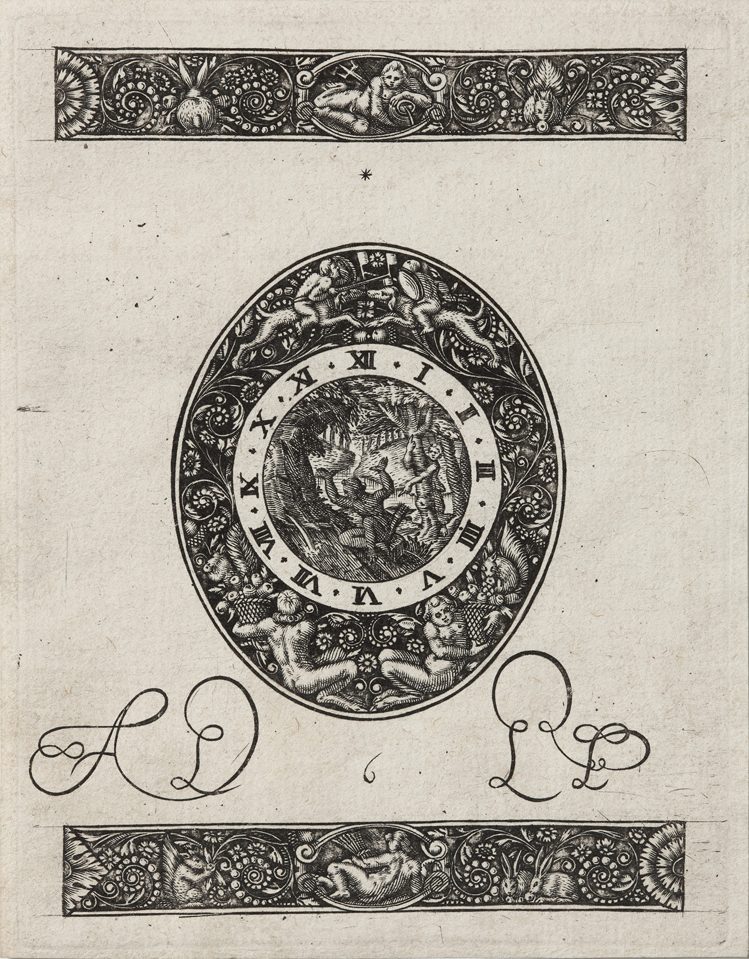 Antoine Jacquard. Diseño para esfera de reloj con Diana cazadora y dos frisos ornamentales en blackwork (detalle). Buril, h. 1610-1615. Colección Mariano Moret
Antoine Jacquard. Diseño para esfera de reloj con Diana cazadora y dos frisos ornamentales en blackwork (detalle). Buril, h. 1610-1615. Colección Mariano Moret 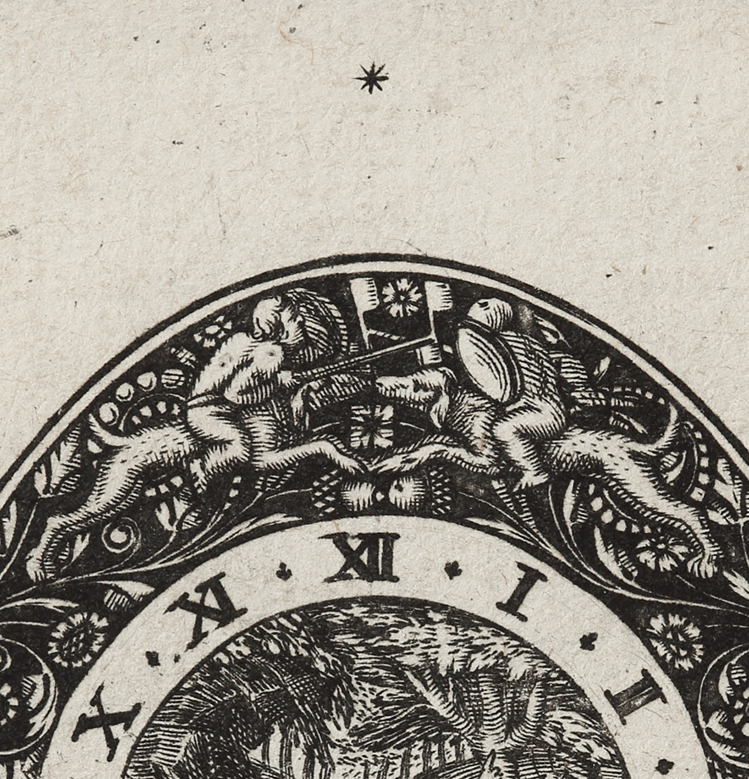
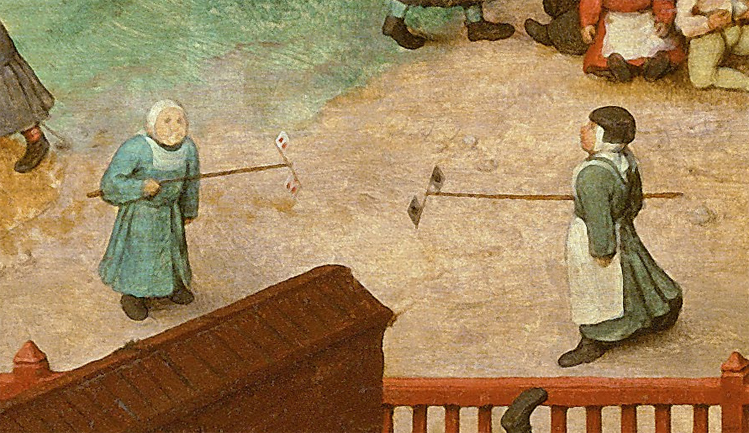 Pieter Bruegel. Children's Games (detail). Oil on panel, 1560. Kunsthistorisches Museum Wien
Pieter Bruegel. Children's Games (detail). Oil on panel, 1560. Kunsthistorisches Museum Wien 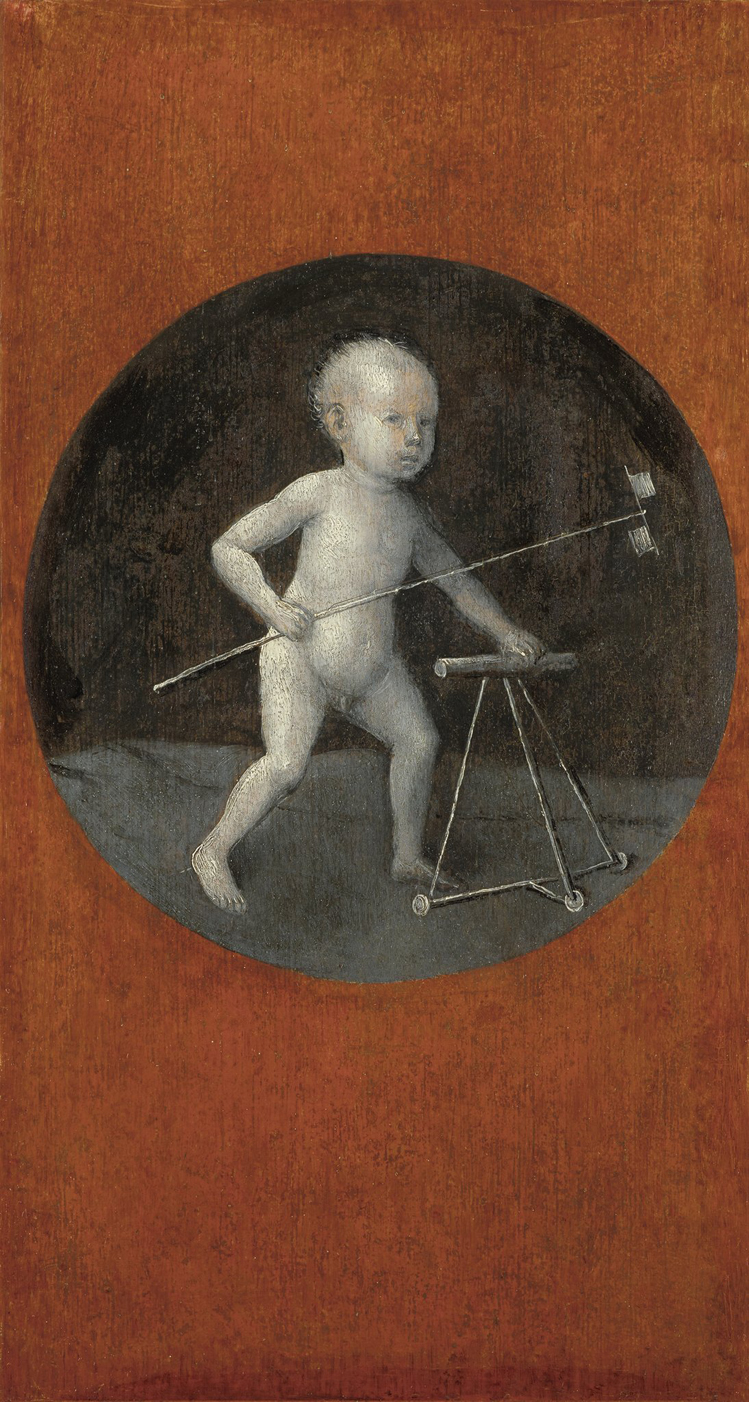 Hieronymus Bosch. Christ Child with a Walking Frame. Oil on panel, c. 1480. Kunsthistorisches Museum Wien
Hieronymus Bosch. Christ Child with a Walking Frame. Oil on panel, c. 1480. Kunsthistorisches Museum Wien
________________________________________________________________________________________________________________
THEME & VARIATIONS: WHEN FURY COMES FROM HEAVEN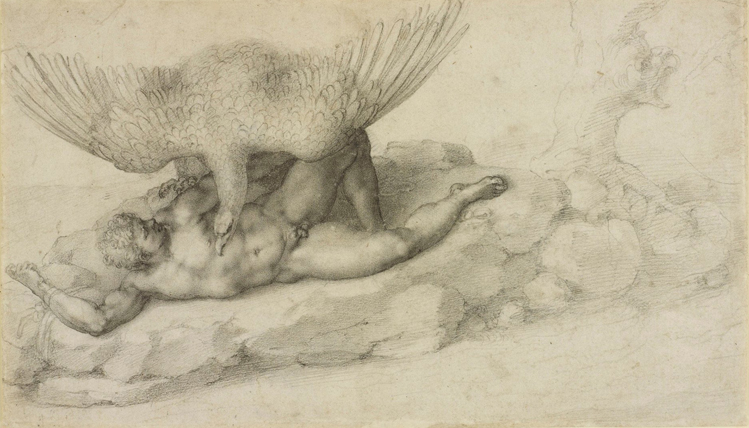
Michelangelo Buonarroti. The Punishment of Tityus. Black chalk, 1532. Royal Collection Trust
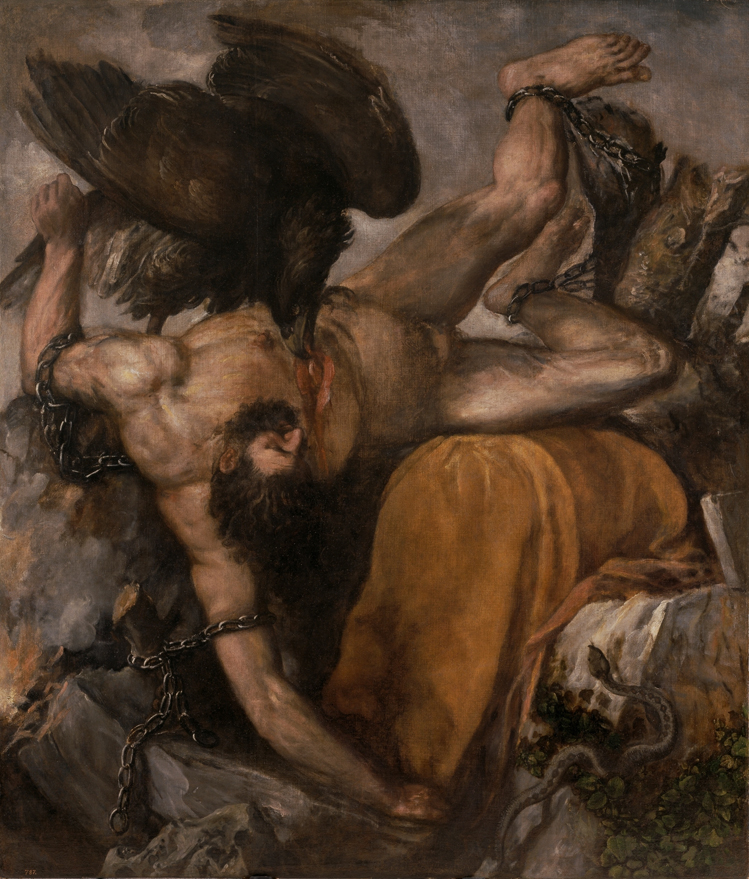 Titian. Tityus. Oil on canvas, c. 1565. Museo del Prado
Titian. Tityus. Oil on canvas, c. 1565. Museo del Prado 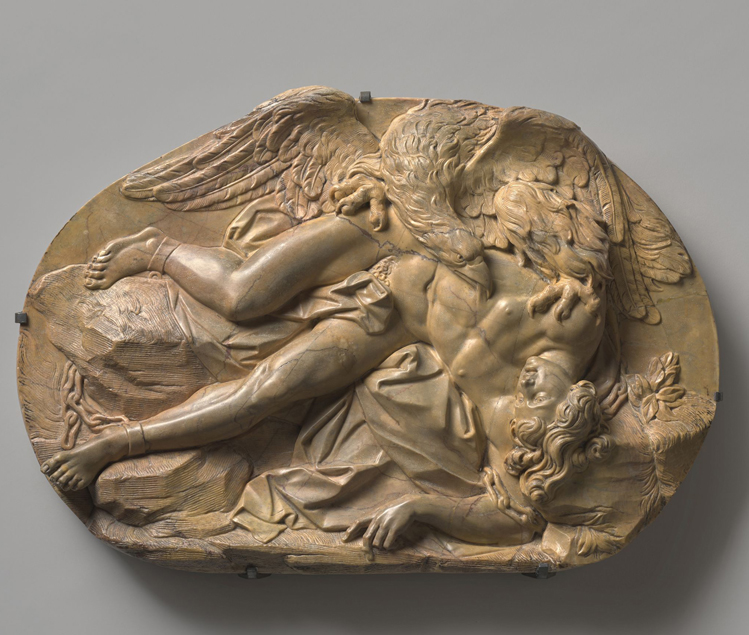 Anonymous, Northern Italy. Prometheus in Chains. Yellow marble, c. 1690. Artcurial
Anonymous, Northern Italy. Prometheus in Chains. Yellow marble, c. 1690. Artcurial 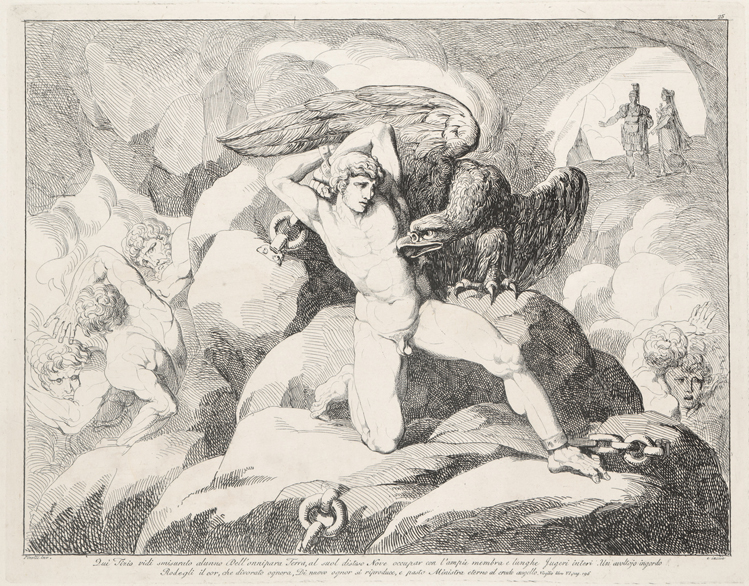 Bartolomeo Pinelli. Tityus in Chains. Etching, c. 1811. Colección Mariano Moret
Bartolomeo Pinelli. Tityus in Chains. Etching, c. 1811. Colección Mariano Moret
________________________________________________________________________________________________________________
THEME & VARIATIONS: CALLOT EN PIETRE DURE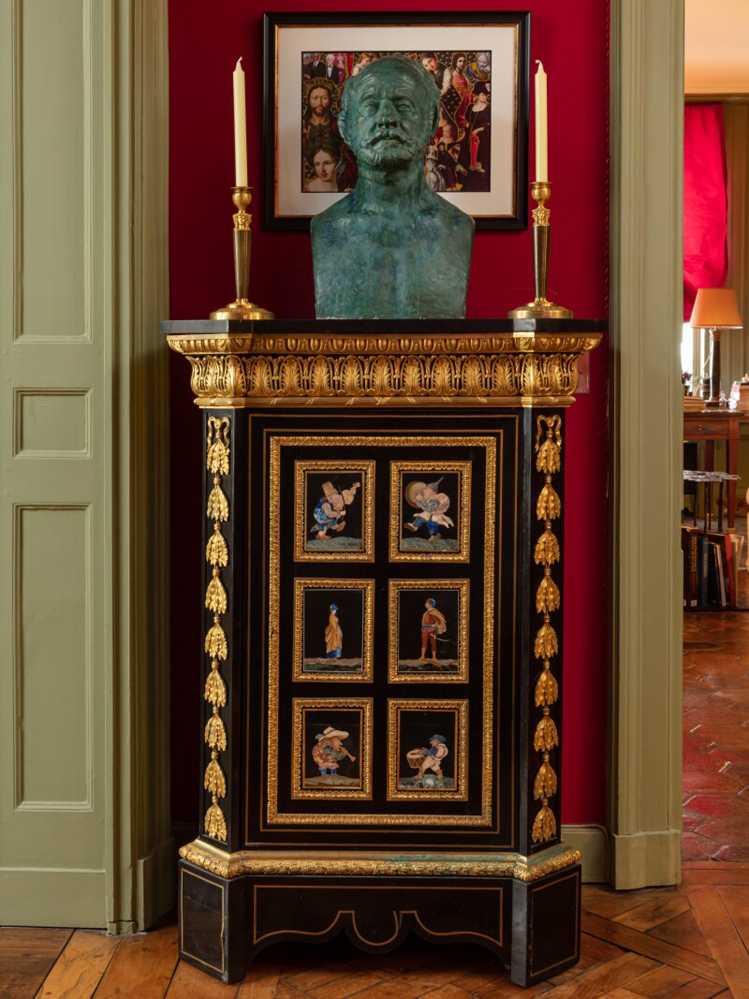 Alexandre Bellangé. Cabinet, c. 1840. Ebony veneered with gilt-bronze mounts and Italian hardstones plaques, the four musicians plaques, grand dukal workshop, Florence, late 18th. Jacques García at Champ de Bataille, Sotheby's
Alexandre Bellangé. Cabinet, c. 1840. Ebony veneered with gilt-bronze mounts and Italian hardstones plaques, the four musicians plaques, grand dukal workshop, Florence, late 18th. Jacques García at Champ de Bataille, Sotheby's 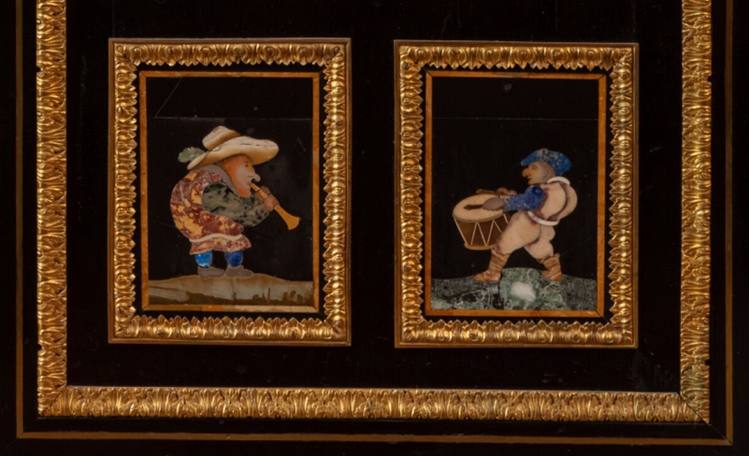
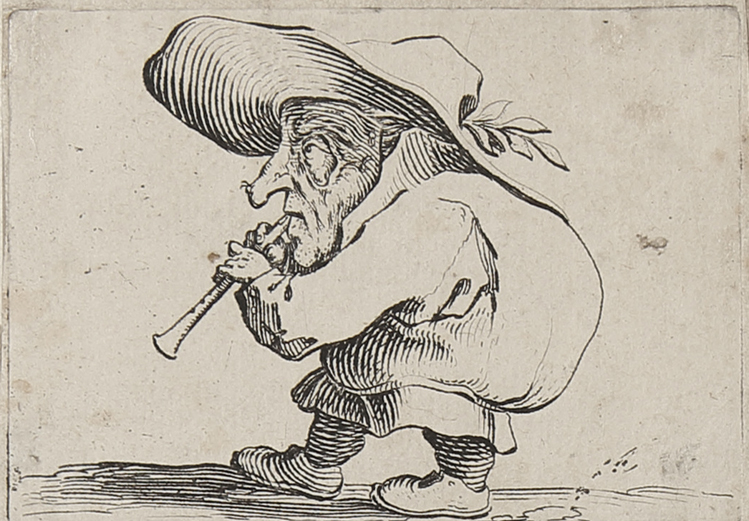 Jacques Callot. Dwarf playing flageolet. From the series "Varie figure gobbi di Iacopo Callot". Etching, c. 1621-1625. Colección Mariano Moret
Jacques Callot. Dwarf playing flageolet. From the series "Varie figure gobbi di Iacopo Callot". Etching, c. 1621-1625. Colección Mariano Moret
________________________________________________________________________________________________________________
THEME & VARIATIONS: FRUITS & FLOWERS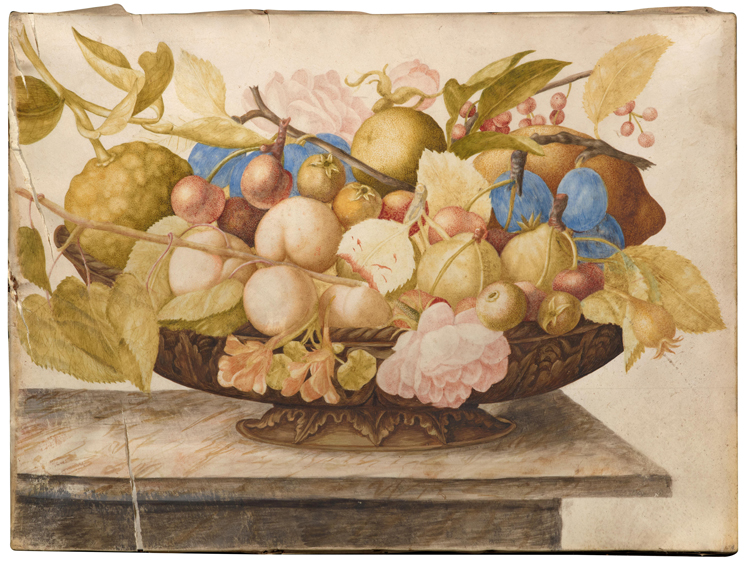 Attributed to Giovanna Garzoni. Peaches, plums, cherries, roses and other fruit in a metallic bowl on a stone ledge. Tempera on vellum. Dorotheum
Attributed to Giovanna Garzoni. Peaches, plums, cherries, roses and other fruit in a metallic bowl on a stone ledge. Tempera on vellum. Dorotheum 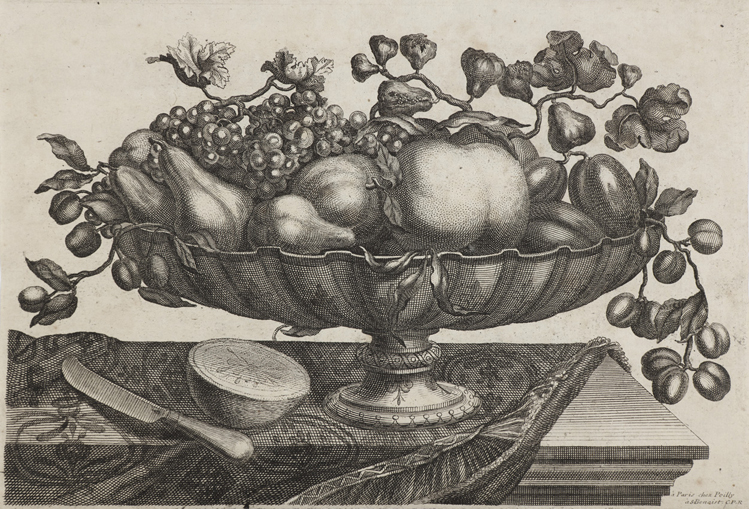 François de Poilly the Elder. Still life with fruits in a tazza with ribbed decoration. Engraving, c. 1660-1680. Colección Mariano Moret
François de Poilly the Elder. Still life with fruits in a tazza with ribbed decoration. Engraving, c. 1660-1680. Colección Mariano Moret 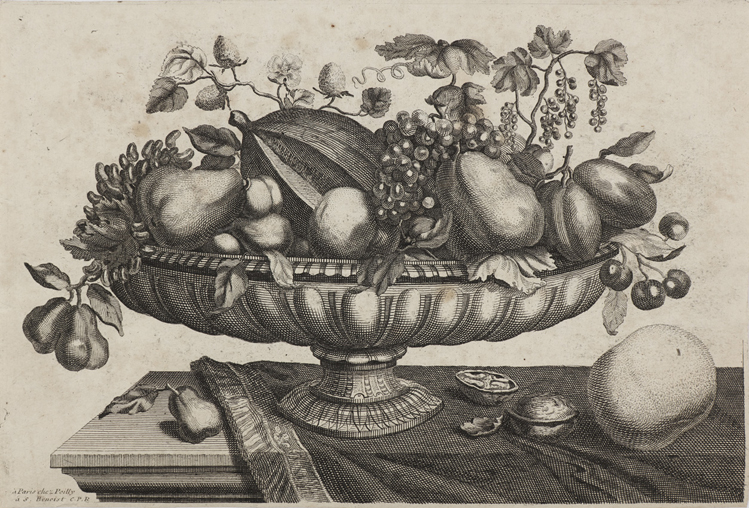 François de Poilly the Elder. Still life with fruits in a tazza with lobed decoration. Engraving, c. 1660-1680. Colección Mariano Moret
François de Poilly the Elder. Still life with fruits in a tazza with lobed decoration. Engraving, c. 1660-1680. Colección Mariano Moret
________________________________________________________________________________________________________________
THEME & VARIATIONS: CARRACCI'S CHRIST CROWNED WITH THORNS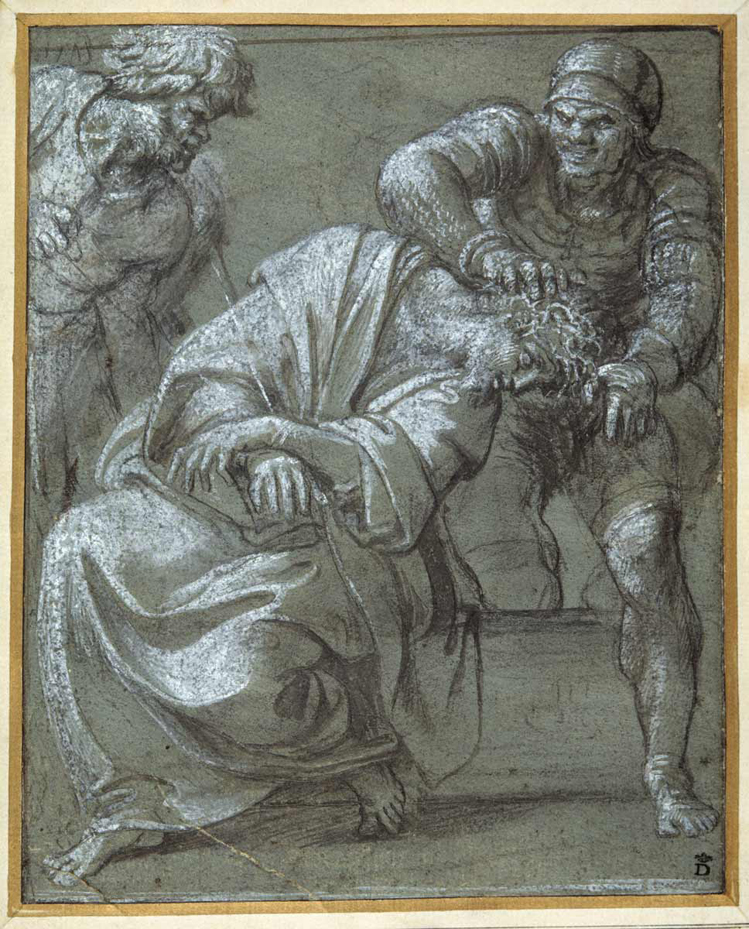 Annibale Carracci. Christ Crowned with Thorns. Black chalk and brown wash and heightening, c. 1605. Devonshire Collection, Chatsworth House
Annibale Carracci. Christ Crowned with Thorns. Black chalk and brown wash and heightening, c. 1605. Devonshire Collection, Chatsworth House 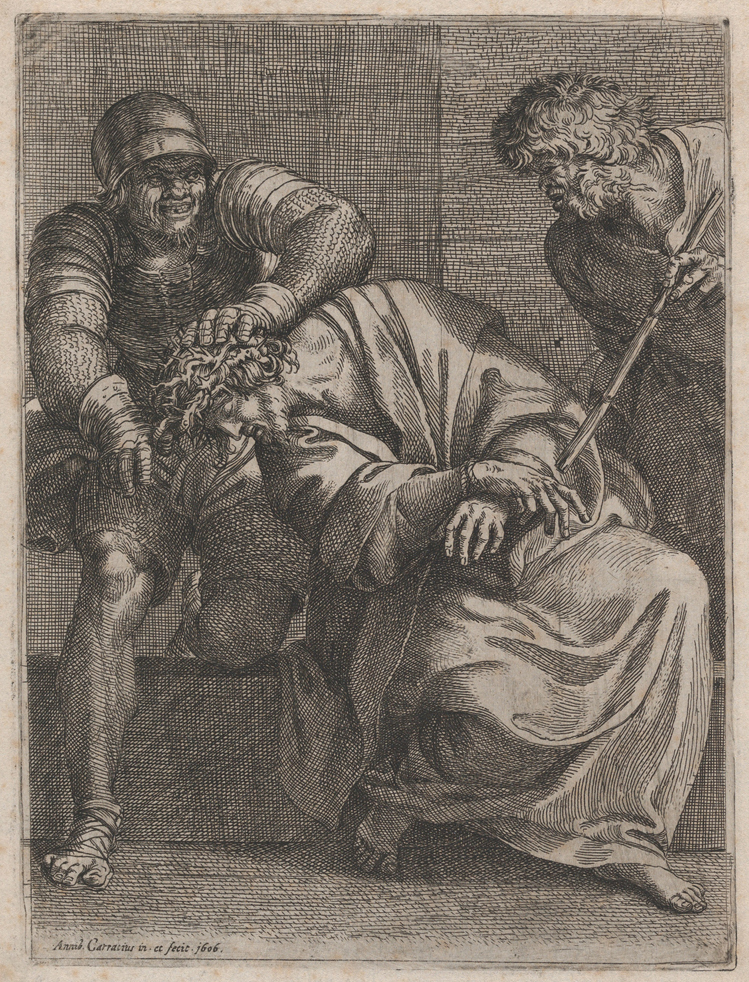 Annibale Carracci. Christ Crowned with Thorns. Etching, 1606. The Met
Annibale Carracci. Christ Crowned with Thorns. Etching, 1606. The Met 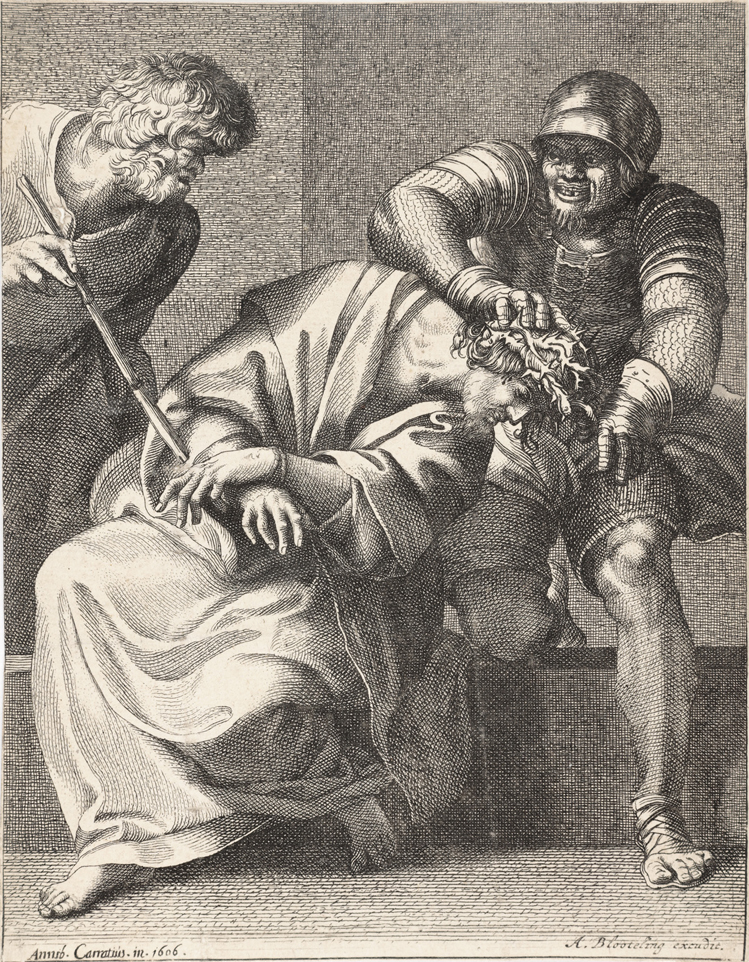 Abraham Blooteling, after Annibale Carracci. Christ Crowned with Thorns. Etching, c. 1606. Colección Mariano Moret
Abraham Blooteling, after Annibale Carracci. Christ Crowned with Thorns. Etching, c. 1606. Colección Mariano Moret 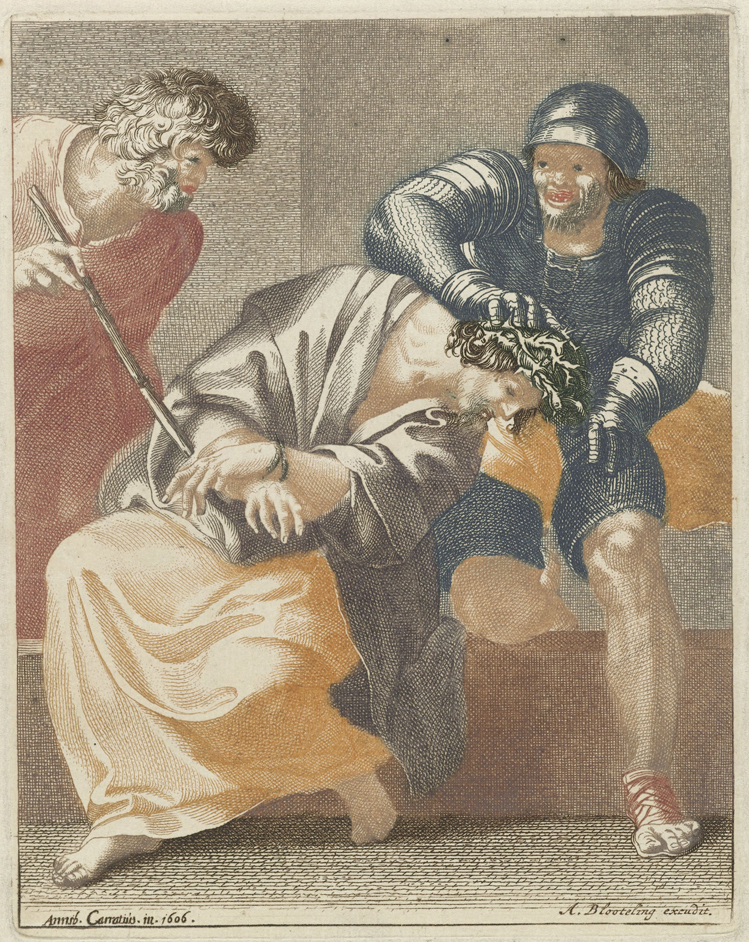 Attributed to Pieter Schenk, after Annibale Carracci. Christ Crowned with Thorns. Etching and engraving, c. 1689 - 1726. Rijksmuseum
Attributed to Pieter Schenk, after Annibale Carracci. Christ Crowned with Thorns. Etching and engraving, c. 1689 - 1726. Rijksmuseum
____________________________________________________________________________________
THEME & VARIATIONS: CONCERTO GROSSO
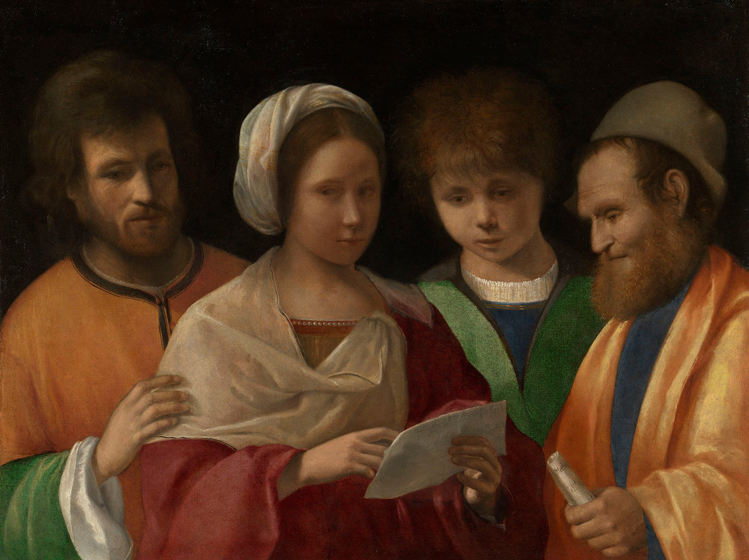 Attributed to Vittore Belliniano. The Concert. Oil on canvas, c. 1505-1515. Royal Collection Trust
Attributed to Vittore Belliniano. The Concert. Oil on canvas, c. 1505-1515. Royal Collection Trust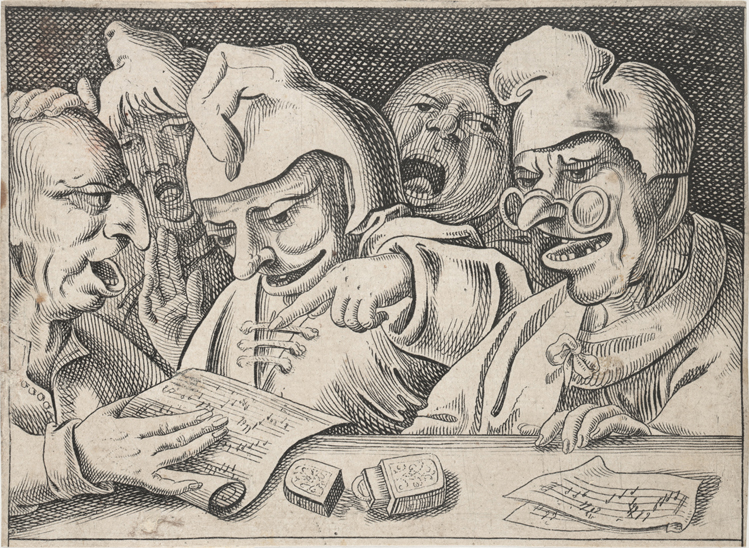
Jean de Saint-Igny. Son musico exellenté e so sonare del guitarin. Etching, c. 1630. Colección Mariano Moret
____________________________________________________________________________________
THEME & VARIATIONS: GROTESQUES
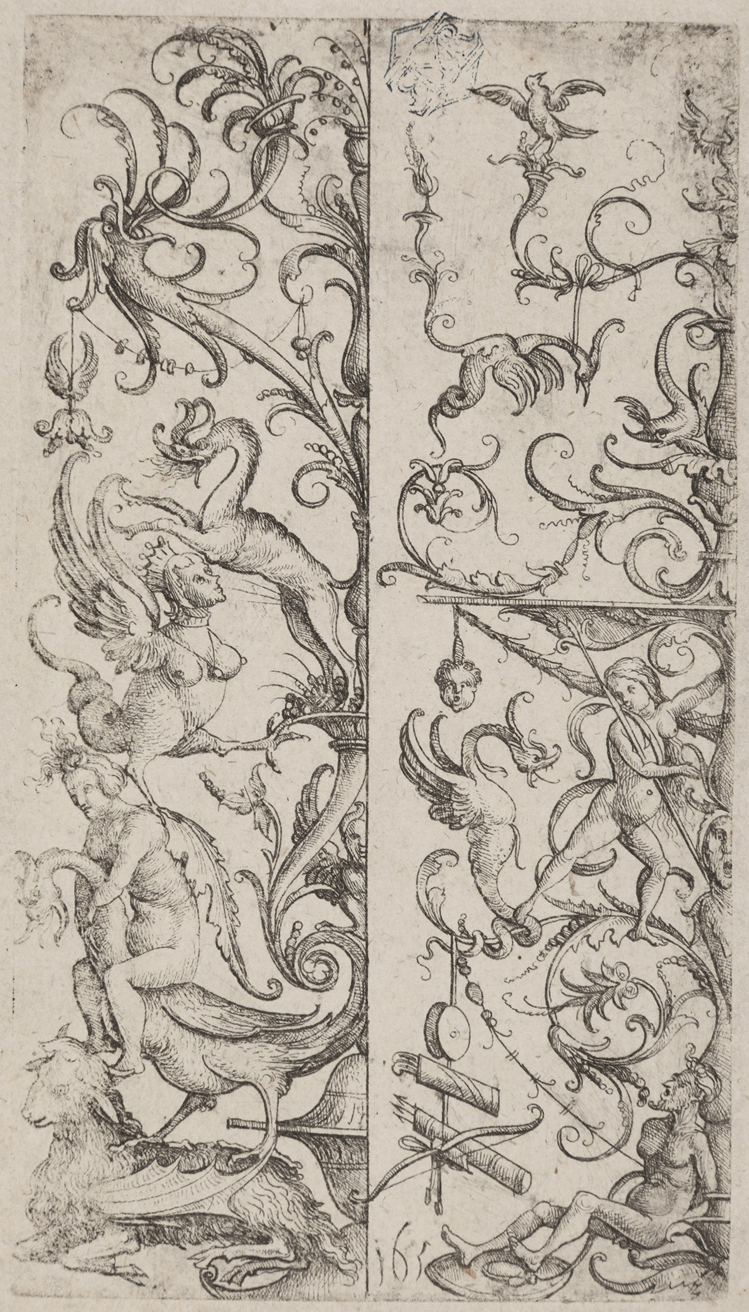 Daniel Hopfer. Two upright ornament panels with half-designs for candelabra. Etching, c. 1505-1536. Colección Mariano Moret
Daniel Hopfer. Two upright ornament panels with half-designs for candelabra. Etching, c. 1505-1536. Colección Mariano Moret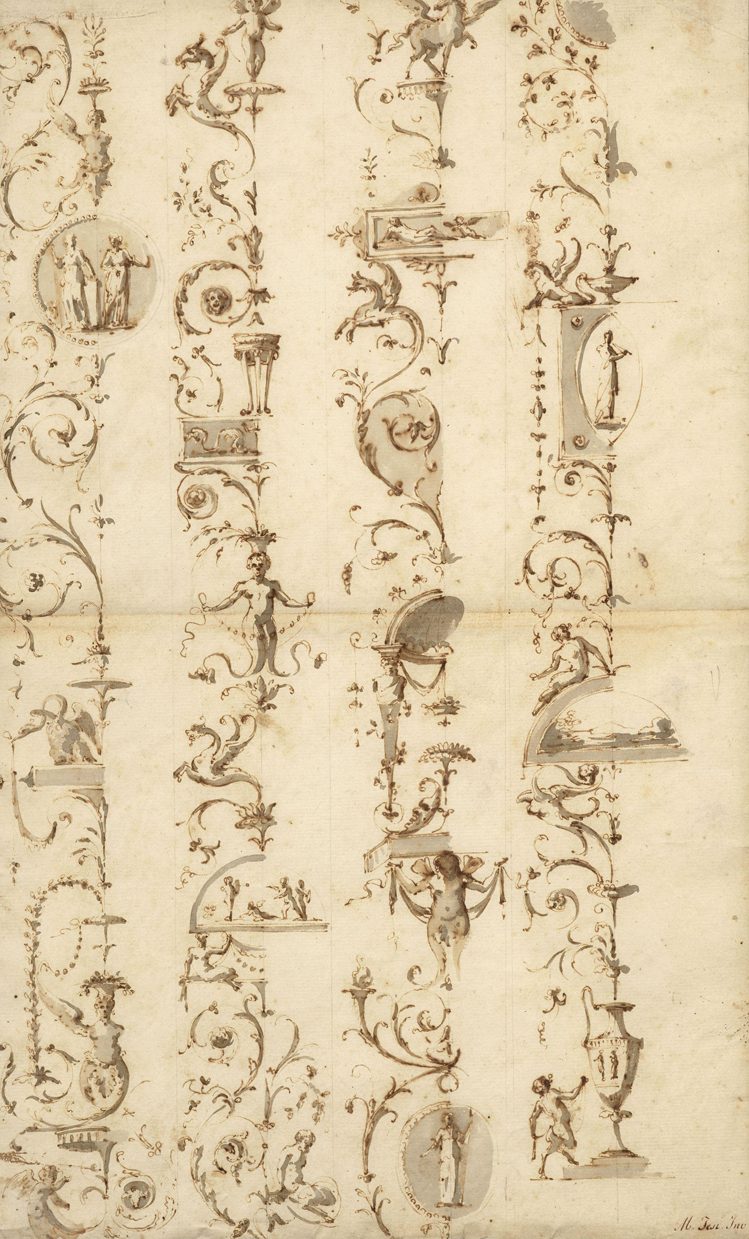 Mauro Tesi, il Maurino (Zocca, 1730 - Bologna, 1766). Study of grotesques. Pen and brown ink, grey wash. Artcurial
Mauro Tesi, il Maurino (Zocca, 1730 - Bologna, 1766). Study of grotesques. Pen and brown ink, grey wash. Artcurial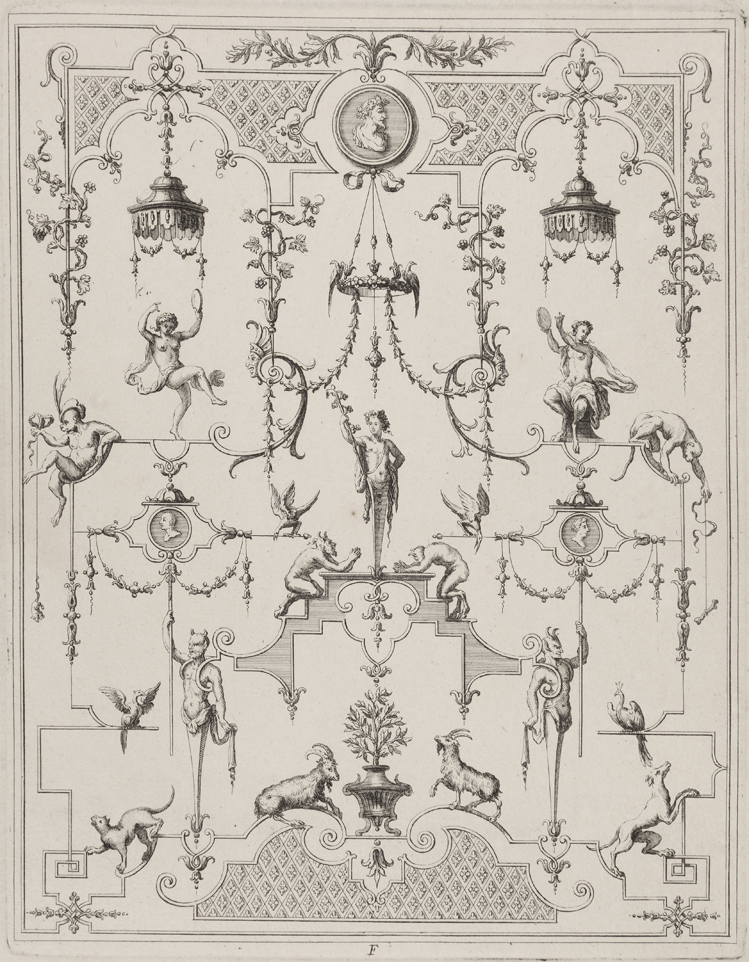 Attributed to Juan Dolivar, after Jean Berain. Panel of grotesques with Bacchus flanked by two kneeling satyrs. Engraving, c. 1700. Colección Mariano Moret
Attributed to Juan Dolivar, after Jean Berain. Panel of grotesques with Bacchus flanked by two kneeling satyrs. Engraving, c. 1700. Colección Mariano Moret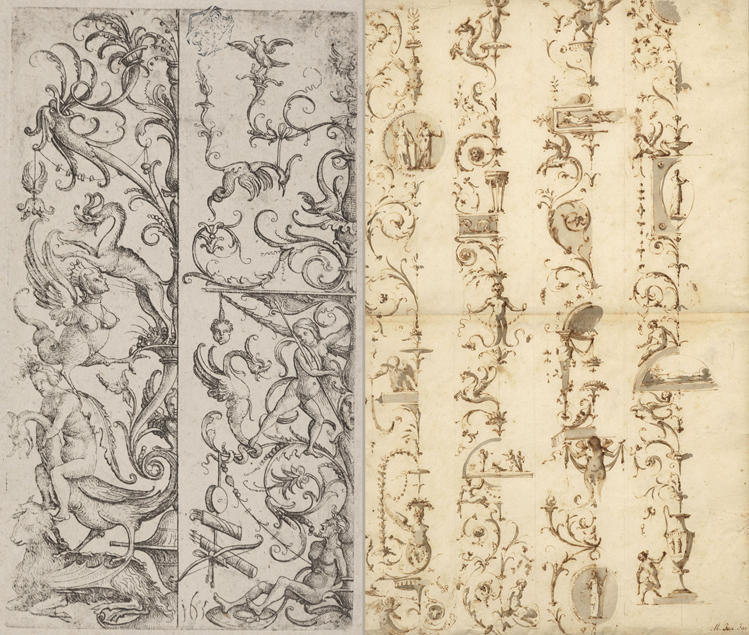
____________________________________________________________________________________
THEME & VARIATIONS: THE HEAVENLY CHORUS
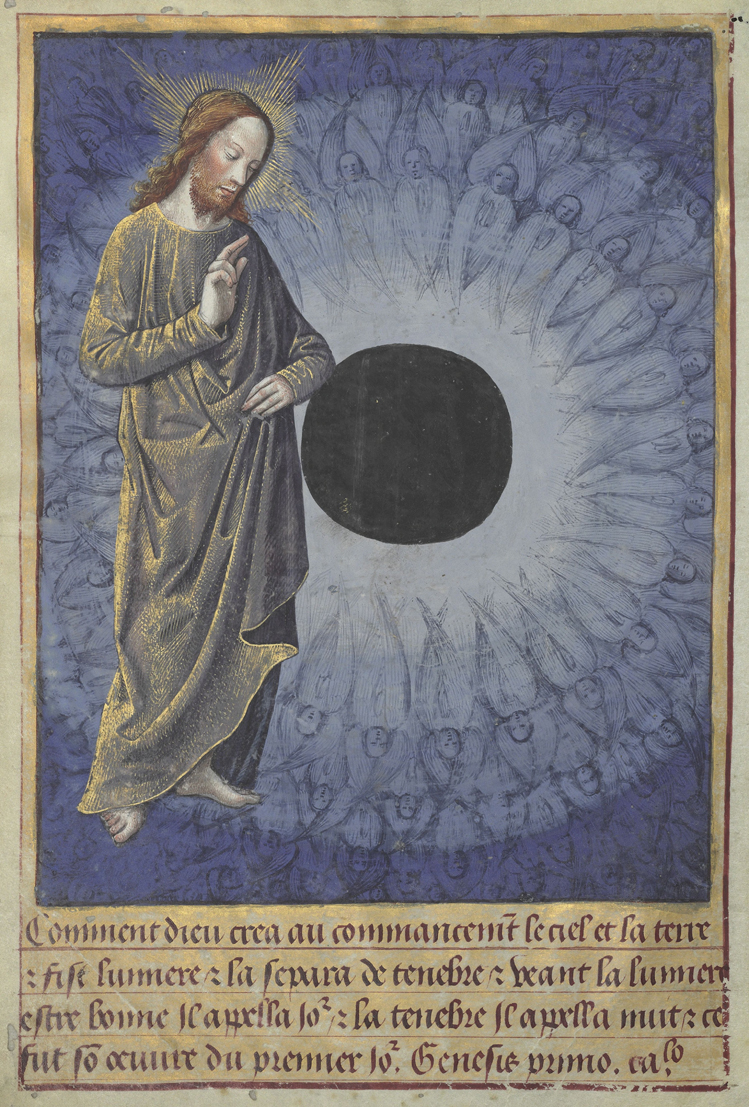 Jean Colombe. The Creation of the World. Day I : The Heavenly Chorus. Heures de Louis de Laval. Temple and gold on parchment, c. 1480-1485. Bibliothèque nationale de France
Jean Colombe. The Creation of the World. Day I : The Heavenly Chorus. Heures de Louis de Laval. Temple and gold on parchment, c. 1480-1485. Bibliothèque nationale de France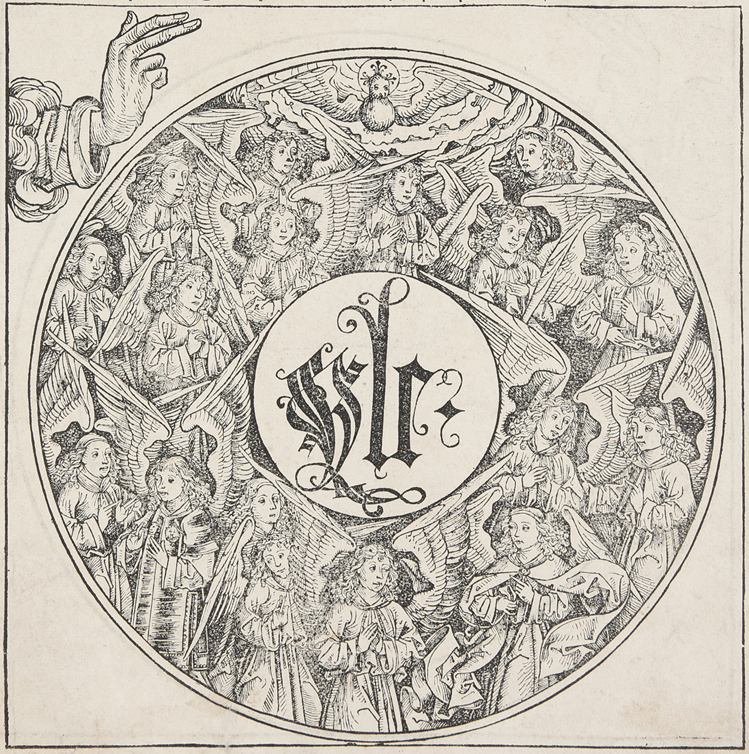 Michael Wolgemut. The Creation of the World. Day I : The Heavenly Chorus. Woodcut, 1493. Colección Mariano Moret
Michael Wolgemut. The Creation of the World. Day I : The Heavenly Chorus. Woodcut, 1493. Colección Mariano Moret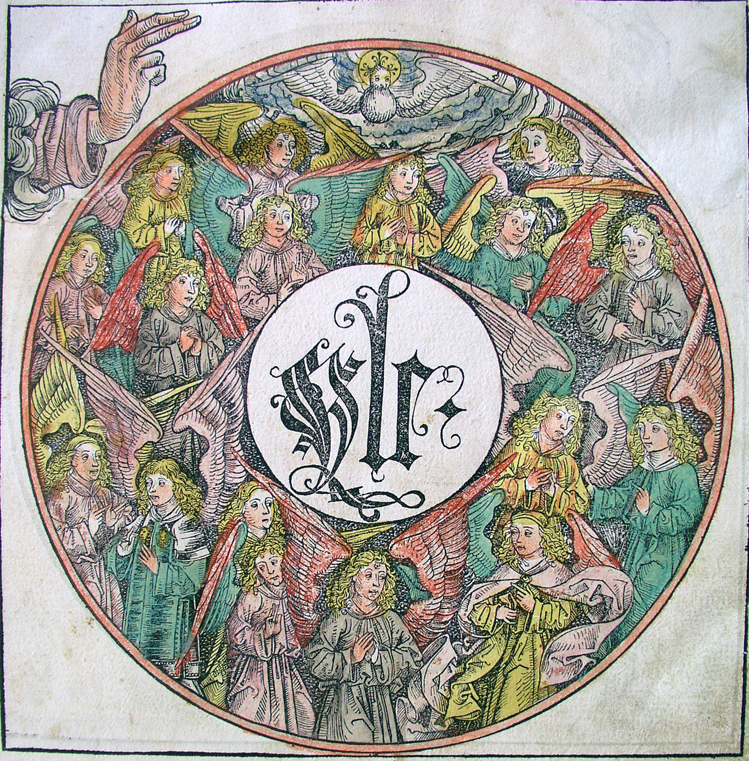 Michael Wolgemut. The Creation of the World. Day I : The Heavenly Chorus. Hand coloured woodcut, 1493. Guildhall Library
Michael Wolgemut. The Creation of the World. Day I : The Heavenly Chorus. Hand coloured woodcut, 1493. Guildhall Library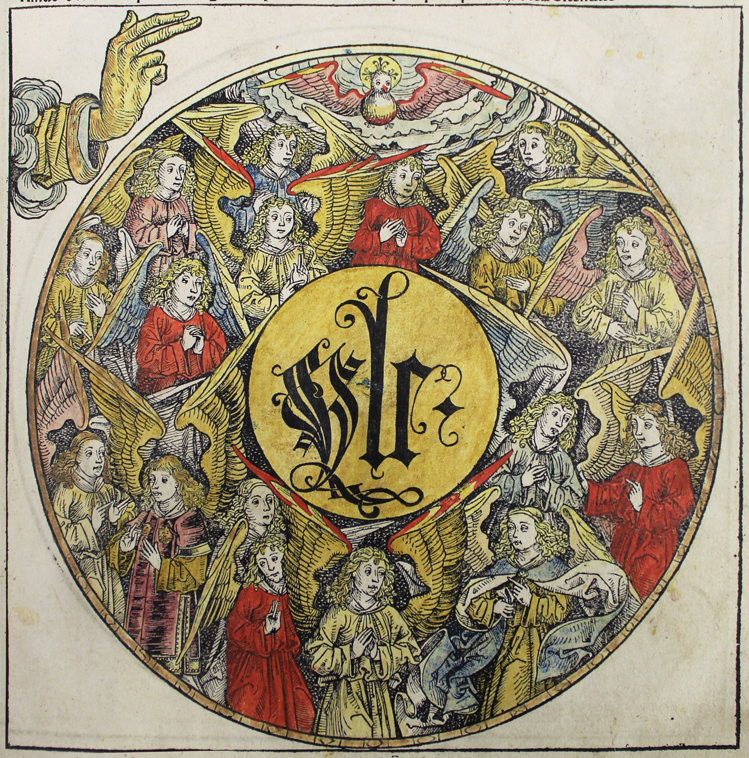 Michael Wolgemut. The Creation of the World. Day I : The Heavenly Chorus. Hand coloured woodcut, 1493. Morse Library, Beloit College
Michael Wolgemut. The Creation of the World. Day I : The Heavenly Chorus. Hand coloured woodcut, 1493. Morse Library, Beloit College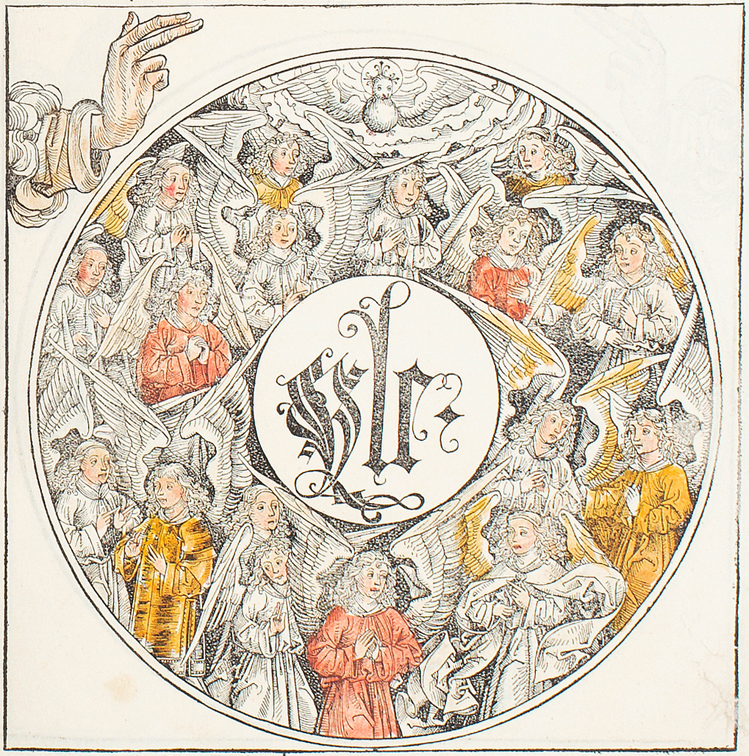 Michael Wolgemut. The Creation of the World. Day I : The Heavenly Chorus. Hand coloured woodcut, 1493. Bukowskis
Michael Wolgemut. The Creation of the World. Day I : The Heavenly Chorus. Hand coloured woodcut, 1493. Bukowskis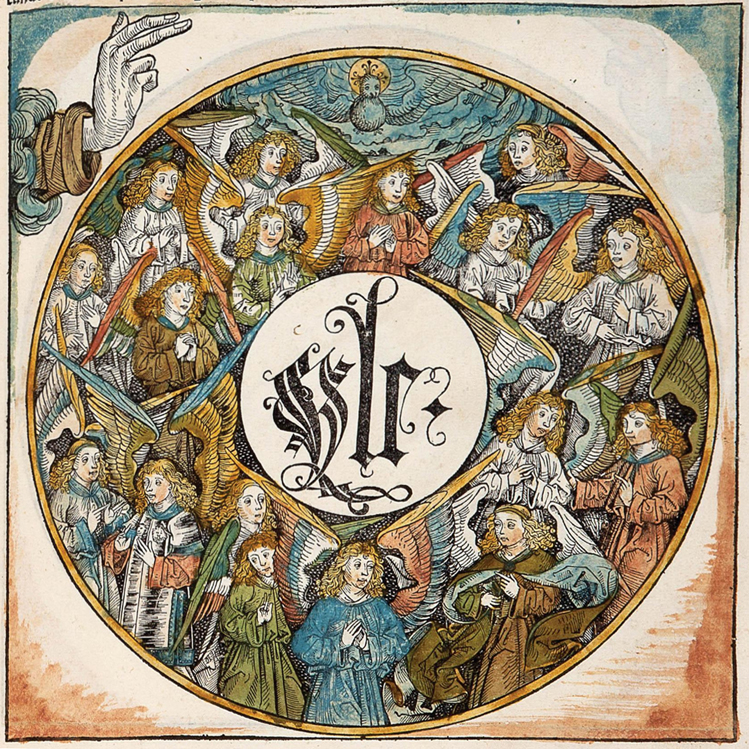 Michael Wolgemut. The Creation of the World. Day I : The Heavenly Chorus. Hand coloured woodcut, 1493. Aguttes
Michael Wolgemut. The Creation of the World. Day I : The Heavenly Chorus. Hand coloured woodcut, 1493. Aguttes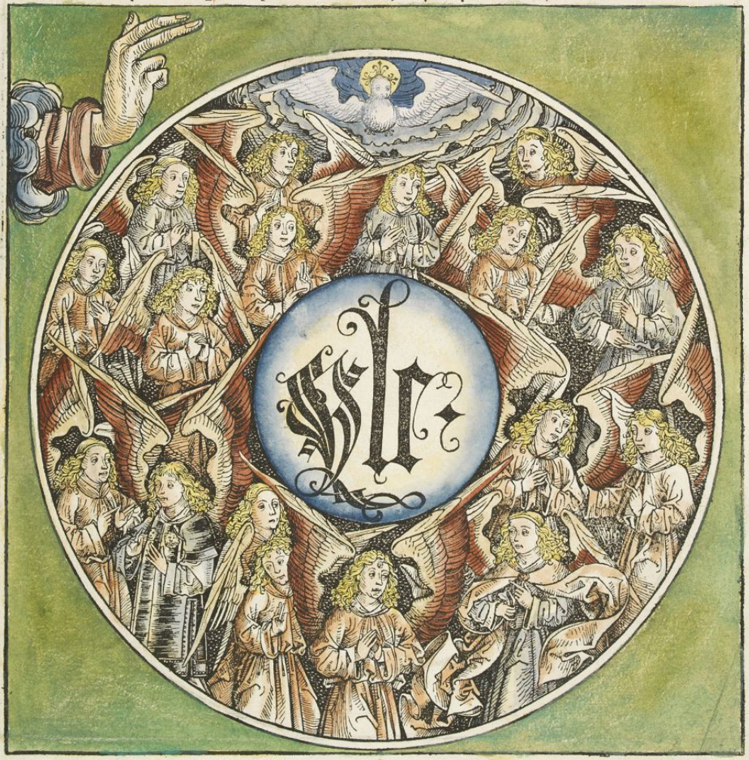 Michael Wolgemut. The Creation of the World. Day I : The Heavenly Chorus. Hand coloured woodcut, 1493. Paulus Swaen Old Maps & Prints
Michael Wolgemut. The Creation of the World. Day I : The Heavenly Chorus. Hand coloured woodcut, 1493. Paulus Swaen Old Maps & Prints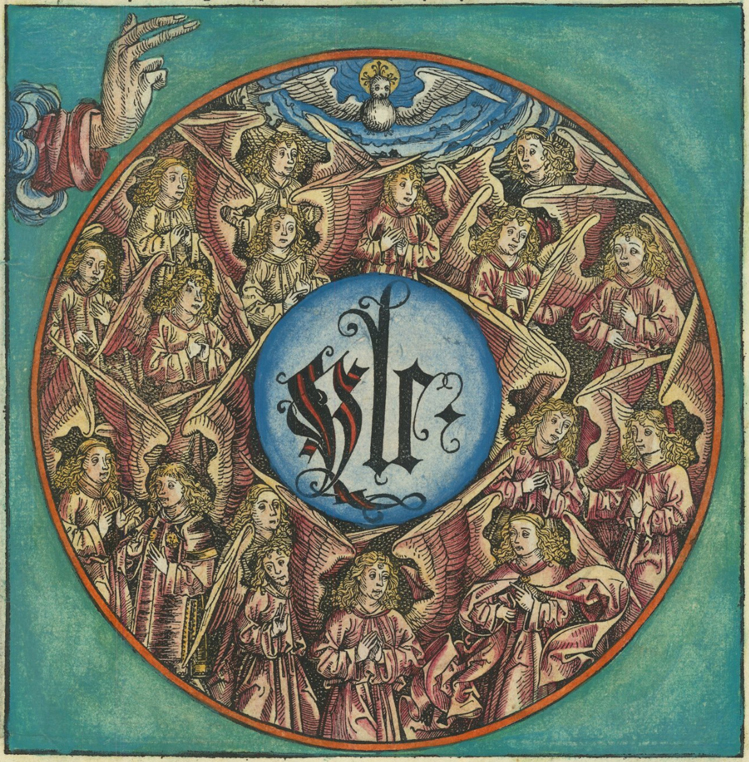 Michael Wolgemut. The Creation of the World. Day I : The Heavenly Chorus. Hand coloured woodcut, 1493. Colección Mariano Moret
Michael Wolgemut. The Creation of the World. Day I : The Heavenly Chorus. Hand coloured woodcut, 1493. Colección Mariano Moret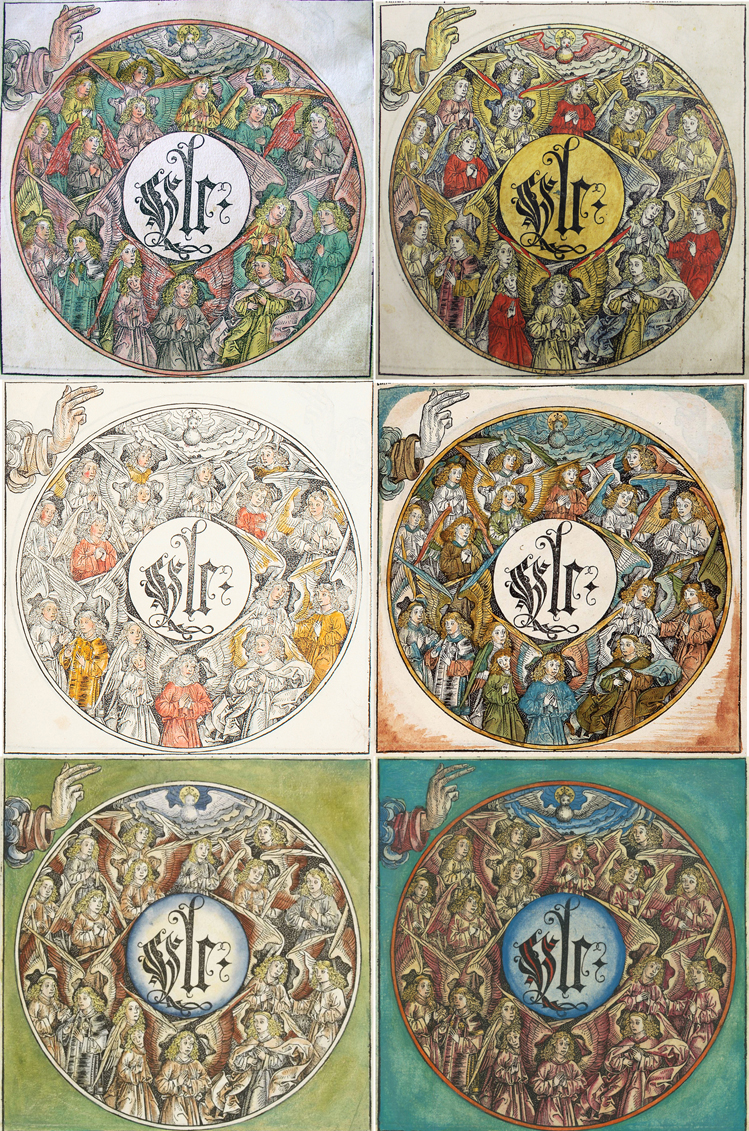
____________________________________________________________________________________
MÚSICA GROTESCA
The latest album by Capella de Ministrers has been released with the title Música Grotesca.
Mariano Moret has collaborated with a text on Leonardo da Vinci. The album cover and booklet are illustrated with etchings from the Mariano Moret Collection.
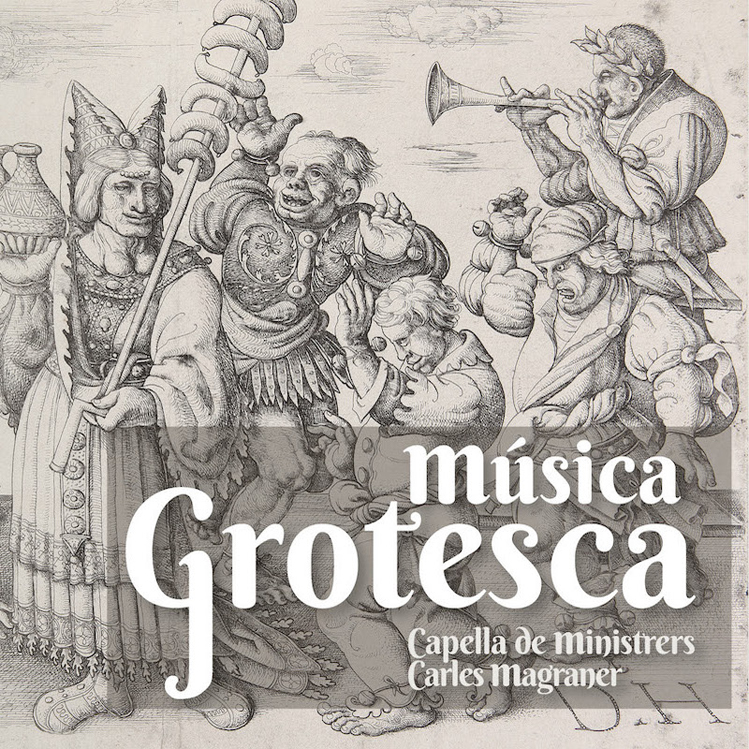
Teaser Música Grotesca
Link to the Capella de Ministrers website
____________________________________________________________________________________
EXHIBITION EXTENDED
Exhibition extended to 25 September 2022.
El arcoíris detrás del negro. Visiones homoeróticas en el grabado antiguo Biblioteca Valenciana Nicolau Primitiu Monasterio San Miguel de los Reyes
____________________________________________________________________________________
THEME & VARIATIONS: FROM LEONARDO TO BERRUGUETE
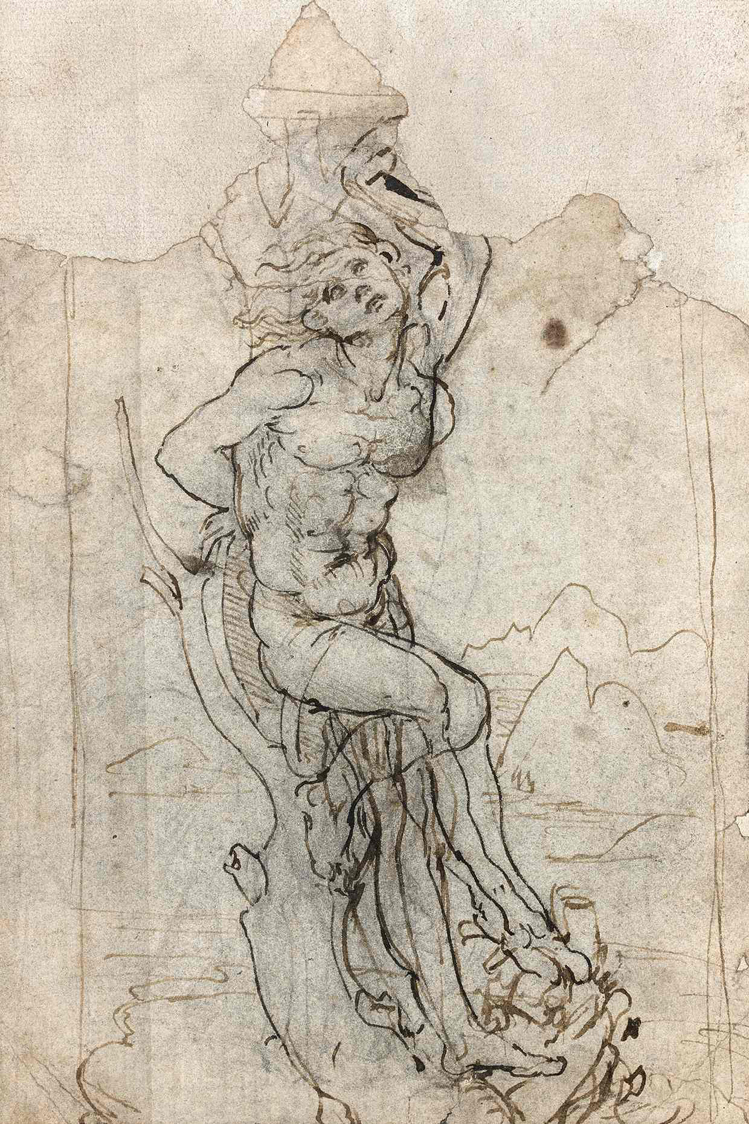 Leonardo da Vinci. St Sebastian. Pen and brown ink, c. 1478-1483. Tajan
Leonardo da Vinci. St Sebastian. Pen and brown ink, c. 1478-1483. Tajan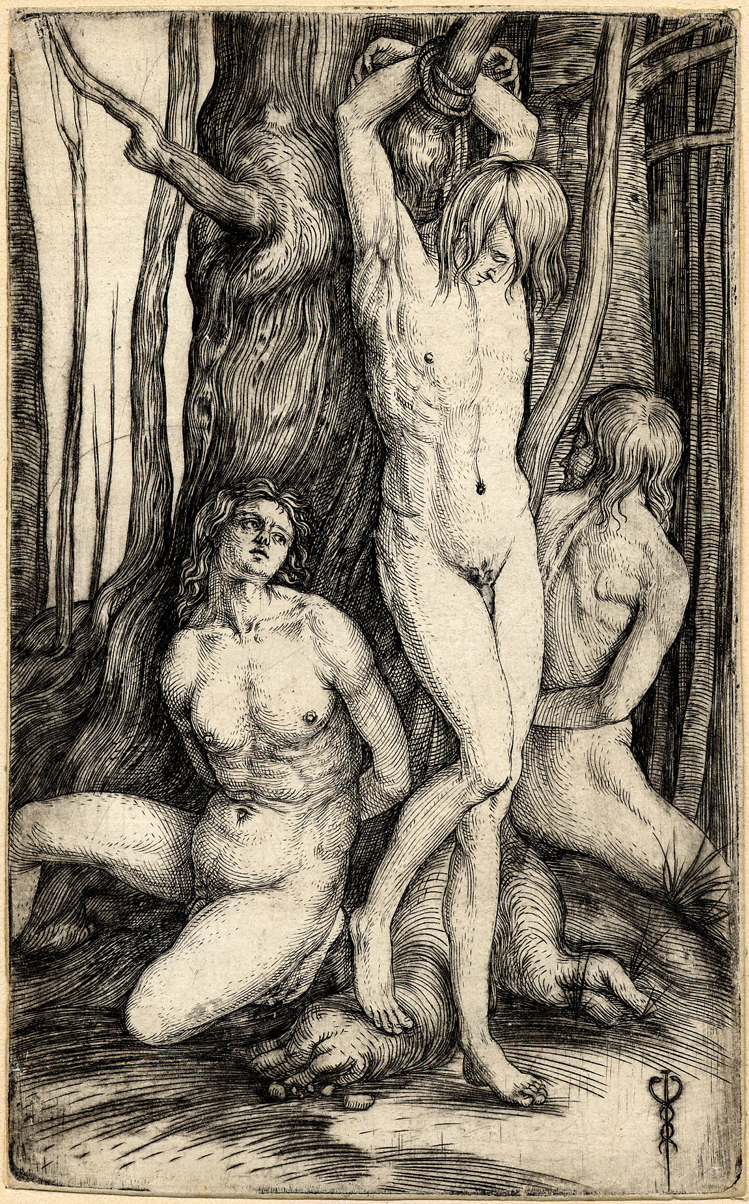 Jacopo de'Barbari. The three prisoners. Engraving, c. 1505. British Museum
Jacopo de'Barbari. The three prisoners. Engraving, c. 1505. British Museum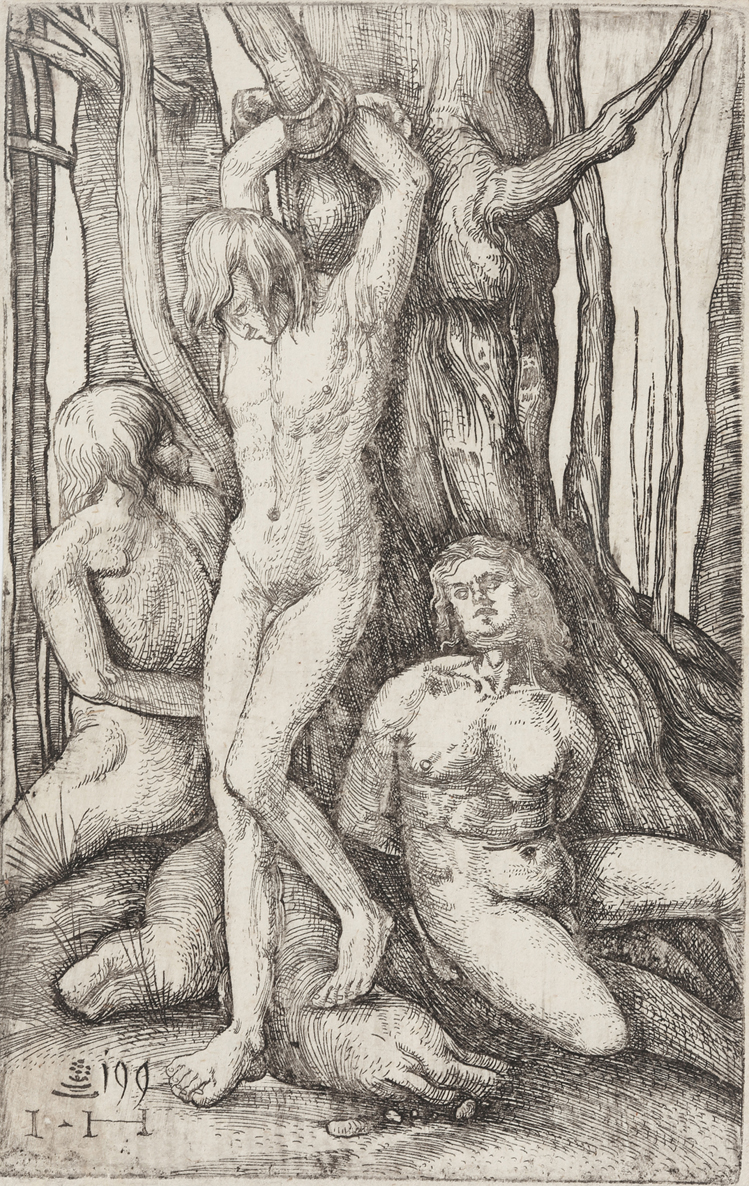 Hieronymus Hopfer. The three prisoners. Etching, c. 1528-1563. Colección Mariano Moret
Hieronymus Hopfer. The three prisoners. Etching, c. 1528-1563. Colección Mariano Moret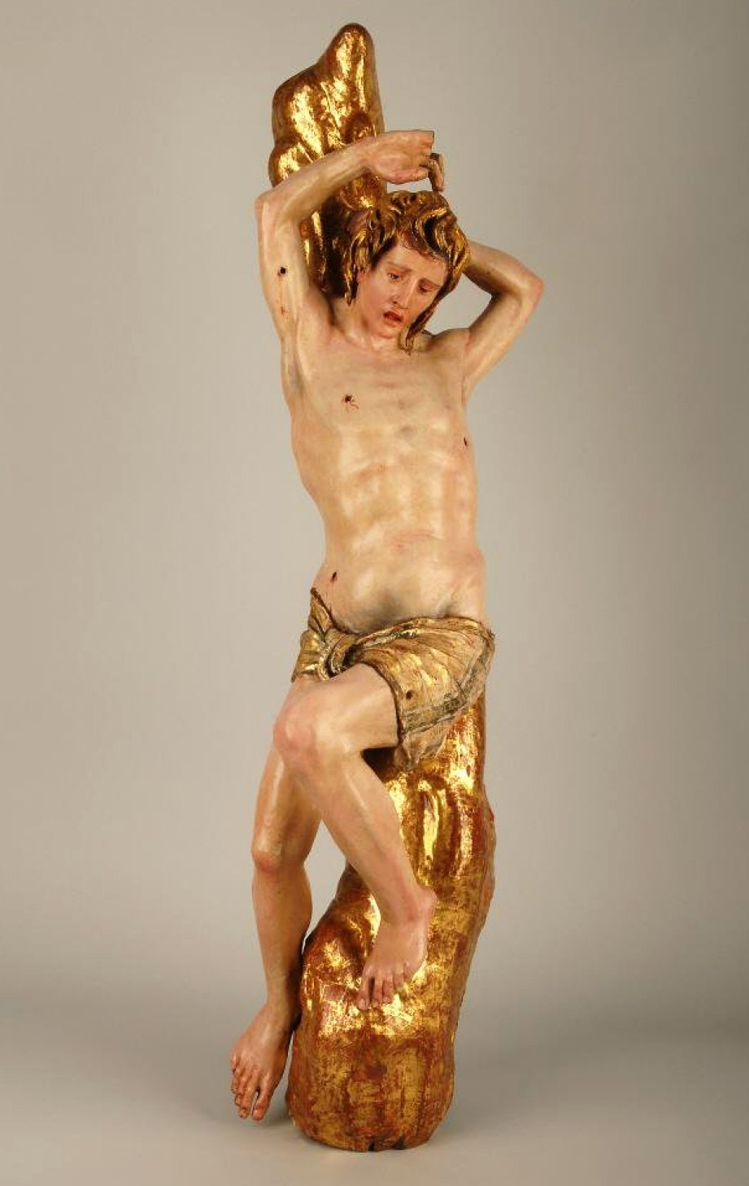 Alonso Berruguete. St Sebastian. Parcel-gilt and polychrome wood, c. 1526-1532. Museo Nacional de Escultura
Alonso Berruguete. St Sebastian. Parcel-gilt and polychrome wood, c. 1526-1532. Museo Nacional de Escultura____________________________________________________________________________________
LLETRAFERIT 30
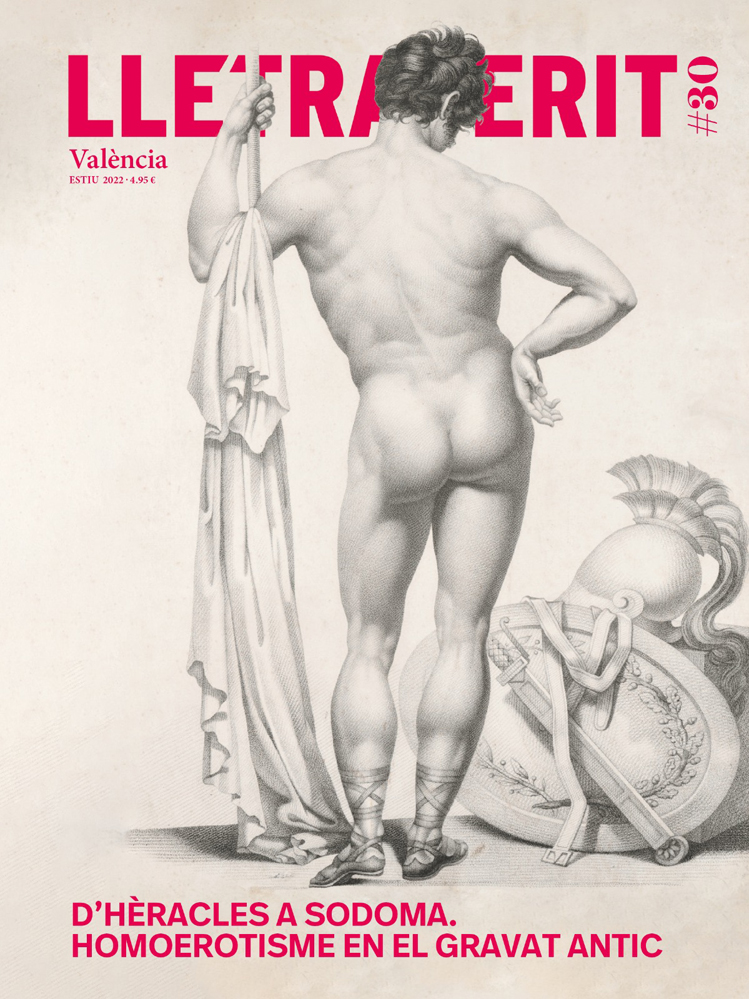
The Mariano Moret Collection featured on the cover of the Summer Issue of LLETRAFERIT Magazine
____________________________________________________________________________________
CURRENT EXHIBITION
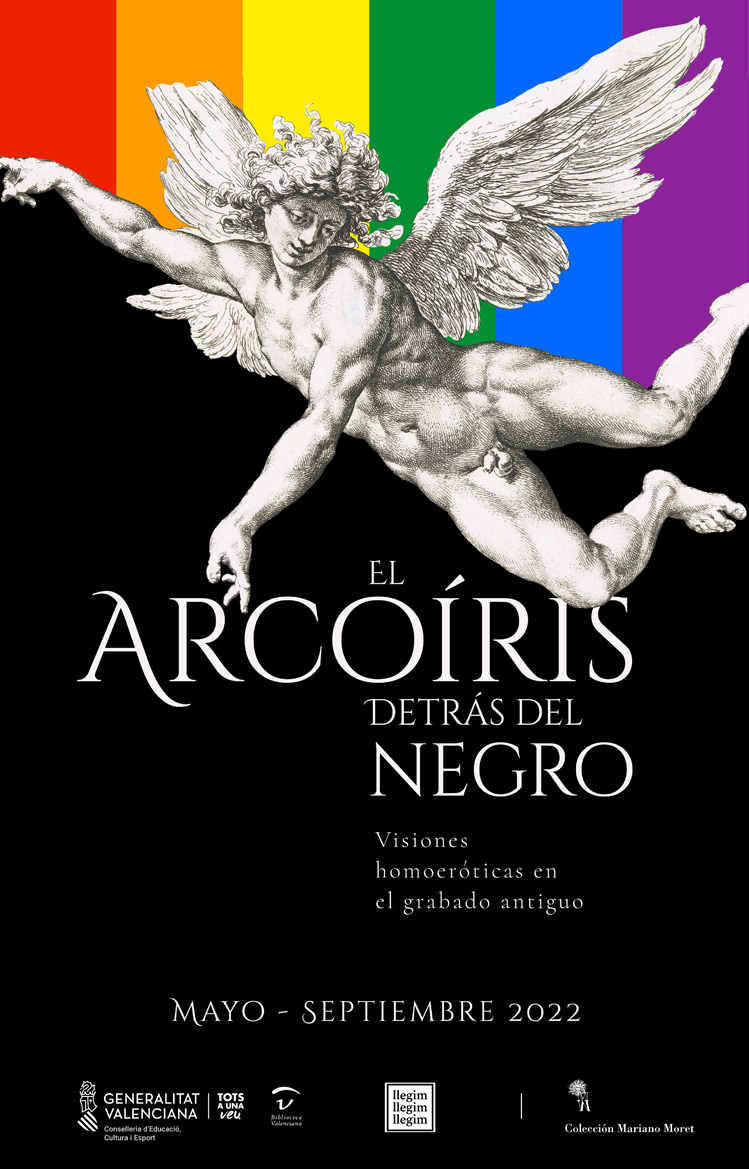
The Rainbow Beneath the Black Homoerotic Visions in Old Master Prints
Biblioteca Valenciana Nicolau Primitiu
Monasterio San Miguel de los Reyes May 31 - September 11, 2022
The Rainbow Beneath the Black. Homoerotic Visions in Old Master Prints offers an unprecedented look at early engravings and at the Mariano Moret Collection by investigating the mechanisms of desire and the proactive gaze, along with ways of observing and the desire to see.
The exhibition offers a journey through five centuries of homosexual desire in a collection of prints by some of the most important engravers in the history of this artistic discipline, covering a chronological arc that goes from the beginning of the 16th century to the end of the 19th century. Engravings by Marcantonio Raimondi, Jacopo de’Barbari, Giovanni Jacopo Caraglio, Barthel and Sebald Beham, Heinrich Aldegrever, Hieronymus Hopfer and Jan de Bisschop are juxtaposed with a careful selection of modern and contemporary works of art with the intention of showing the persistence of certain ideas and models over the centuries. These are works that introduce us to a masculine universe of prints about men, made by men for other men. To quote Juan Gil-Albert: “A labyrinth for men only”.
It is not a question of exclusively exhibiting works with a homosexual theme, which is very difficult in prints from this period, nor of solely including prints that have come from the burins of homosexual artists. The exhibition deals with the methods used to represent a sexuality that was proscribed and denied for centuries. That was considered a heinous and therefore unspeakable sin. Unthinkable and therefore unrepresentable. Not represented, only sketched. A cryptic, coded, barely expressed desire that feeds on flashes and snippets. An eye trained to identify clues, read between the lines and decipher codes. A look trained to detect other looks.
Male nudity does not seem exceptional today, but for centuries and until relatively recently, it was unusual and difficult to contemplate in a society that considered homosexuality a “socially repugnant vice, a sexual aberration, a psychological perversion and a hormonal defect”. Throughout this time, the prints that make up the exhibition served as a support for a forbidden desire and as a refuge for a proscribed gaze that was more accustomed to concealment than to representation. Visitors to the exhibition will have to decipher the symbols that, over the centuries, have served to encode a homoeroticism that is sometimes overt, but in many cases latent. A homoeroticism that is intuited, glimpsed or imagined as a vision or a mirage provoked by desire.
Every exhibition is an exercise in observation, but, on this occasion, observation becomes voyeurism. Through the vindication of passionate contemplation, we are invited to examine the works with an impure gaze and to unravel the mystery of desire, to determine whether it lies in the hand of the artist or in the eye of the beholder.
____________________________________________________________________________________
CURRENT EXHIBITION
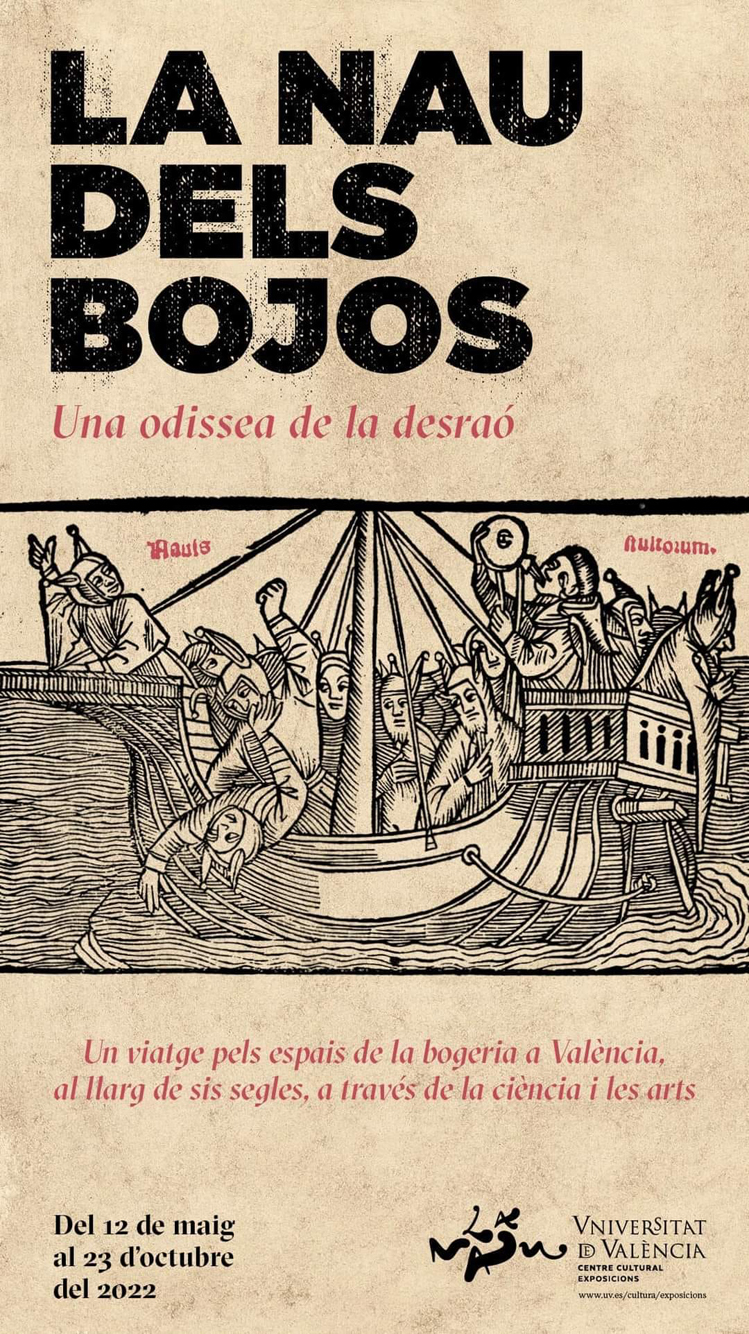
La Nave de los locos Una odisea de la sinrazón
Centre Cultural La Nau de la Universitat de València May 12 - October 23, 2022
The Mariano Moret Collection collaborates with the loan of 6 works to the exhibition La Nave de los locos. Una odisea de la sinrazón that is open to visits since May 12 at La Nau Cultural Center of the University of Valencia. A journey through the spaces of madness in Valencia, over six centuries, through science and the arts.
____________________________________________________________________________________
RECENT ACQUISITIONS 2021 / 2022
40 Old Master prints swelled the Mariano Moret Collection between February 2021 and April 2022:
Dutch Anonymous, c. 1650. The Extraction of the Stone of Madness Dutch Anonymous, c. 1650. Deux sots ne peuvent estre portez sur un asne Dutch Anonymous, c. 1650. Ut lapsu gaviore ruant Dutch Anonymous, 1728. The fool admiring himself in a mirror Bartolozzi, Francesco. Hermaphrodite Attributed to a follower of Beham, Sebald. Crucifixion with the three Marys on theright Blooteling, Abraham. Christ Crowned with Thorns Bry, Theodor de. Young man and Death Attributed to Bol, Hans. The Prodigal Son a as a Swineherd Boucher, Juste-François. 4e suite d’arabesques" (6 plates) Caraglio, Giovanni Jacopo. Hercules capturing Cerberus Caraglio, Giovanni Jacopo. Hercules fighting Cacus Caraglio, Giovanni Jacopo. Hercules killing the Hydra of Lerna Claesz., Allaert. Foot Soldier with Woman and Child Ferroni, Girolamo. Jael and Sisera Attributed to Flindt, Paul. Beaker with Mascarons, Strapwork and Rinceaux Decoration Galestruzzi, Giovanni Battista. Trofei di guerra e vasi (5 plates) Hayé, Michael. Jester with jingle bell belt and scepter rattle Heckenauer, Leonhard. Ornament with acanthus scrolls inhabited by a snake and an insect Heckenauer, Leonhard. Ornament with acanthus scrolls inhabited by a snake and a bird Jode, Gerard de. Love and Death Follower of Lencker the Elder, Hans. Alphabet within an ornamental cartouche Leyden, Lucas van. Cain Killing Abel Leyden, Lucas van. Two Nude Children Supporting a Blank Shield Leyden, Lucas van. Ornament with Two Sphinxes and a Winged Man Muller, Harmen Jansz. The unprofitable servant cast into darkness Monnoyer, Jean-Baptiste. Vanitas Still Life with Flowers Papillon, Jean I. Herod and Herodias Saint-Igny, Jean de. Son musico exellenté e so sonare del guitarin Tempesta, Antonio. La bella Bradamante Vico, Enea (copy). Grotesque panel depicting Mercury, Neptune and Venus
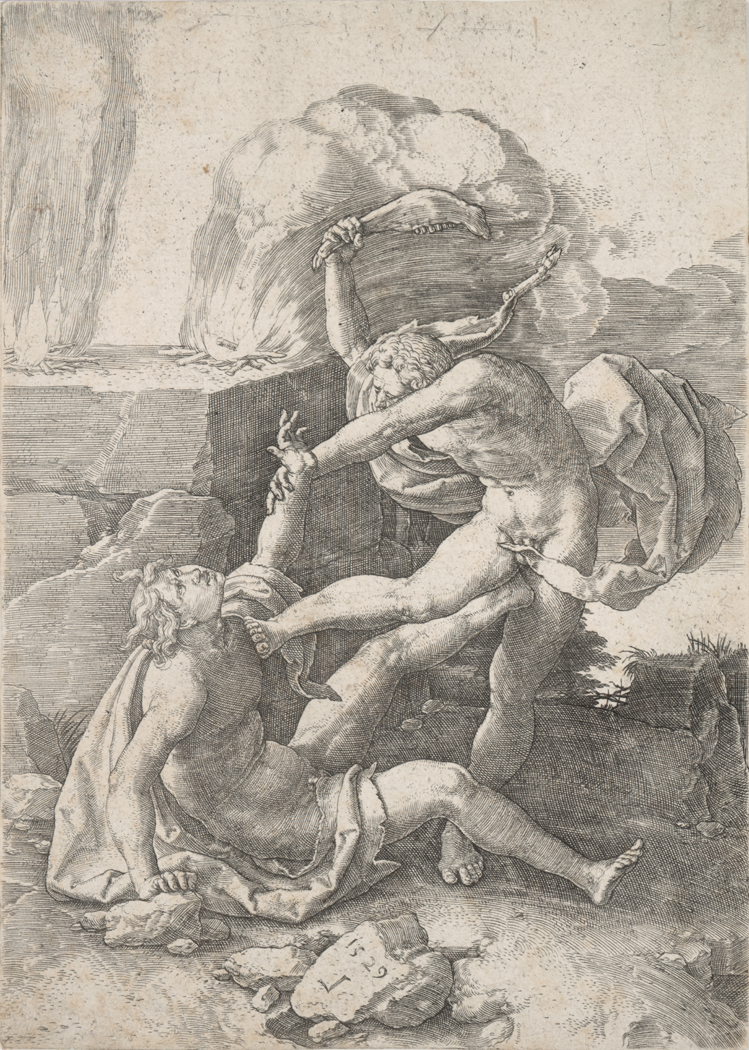 Lucas van Leyden. Cain Killing Abel. Engraving, 1529. Colección Mariano Moret
Lucas van Leyden. Cain Killing Abel. Engraving, 1529. Colección Mariano Moret
____________________________________________________________________________________
THEME & VARIATIONS: THE FLAGELLATION
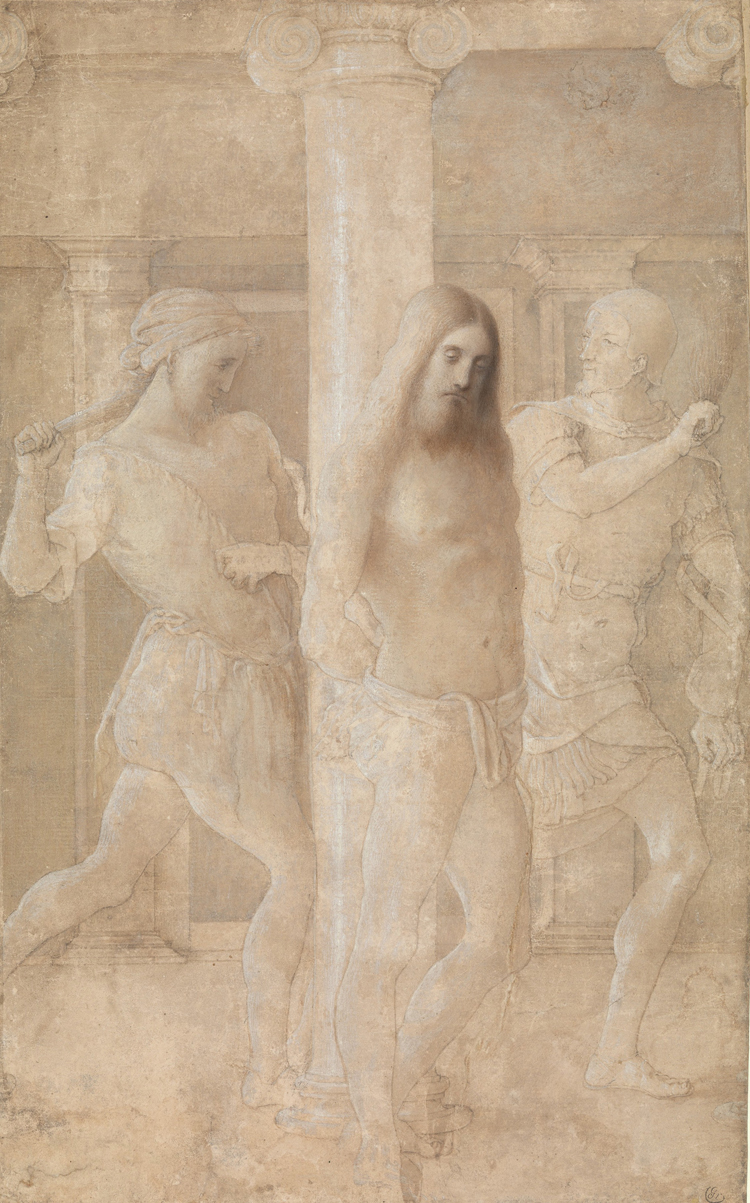 Lombardy (?) , late 15th century. The Flagellation. Point of the brush and brown and light gray ink, brown and grayish brown wash, over traces of black chalk, heightened with white (partly oxidized). The Met
Lombardy (?) , late 15th century. The Flagellation. Point of the brush and brown and light gray ink, brown and grayish brown wash, over traces of black chalk, heightened with white (partly oxidized). The Met
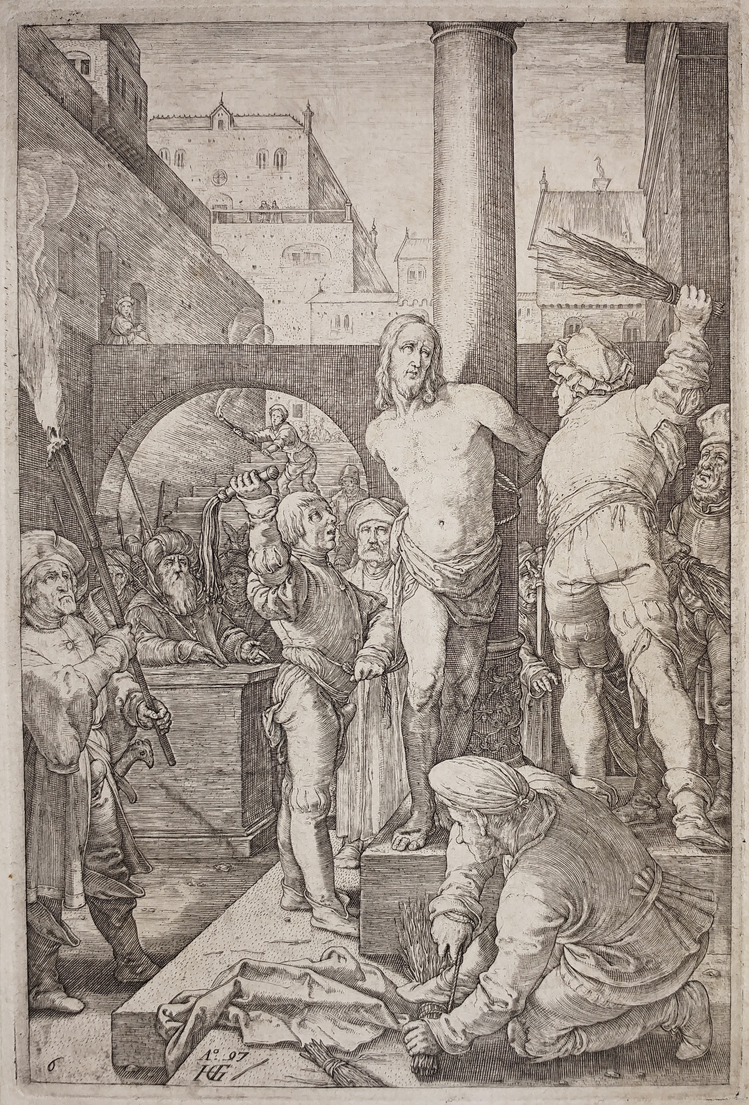 Hendrik Goltzius. The Flagellation. Engraving, 1597. Colección Mariano Moret
Hendrik Goltzius. The Flagellation. Engraving, 1597. Colección Mariano Moret
____________________________________________________________________________________
THEME & VARIATIONS: GOLTZIUS & RUBENS
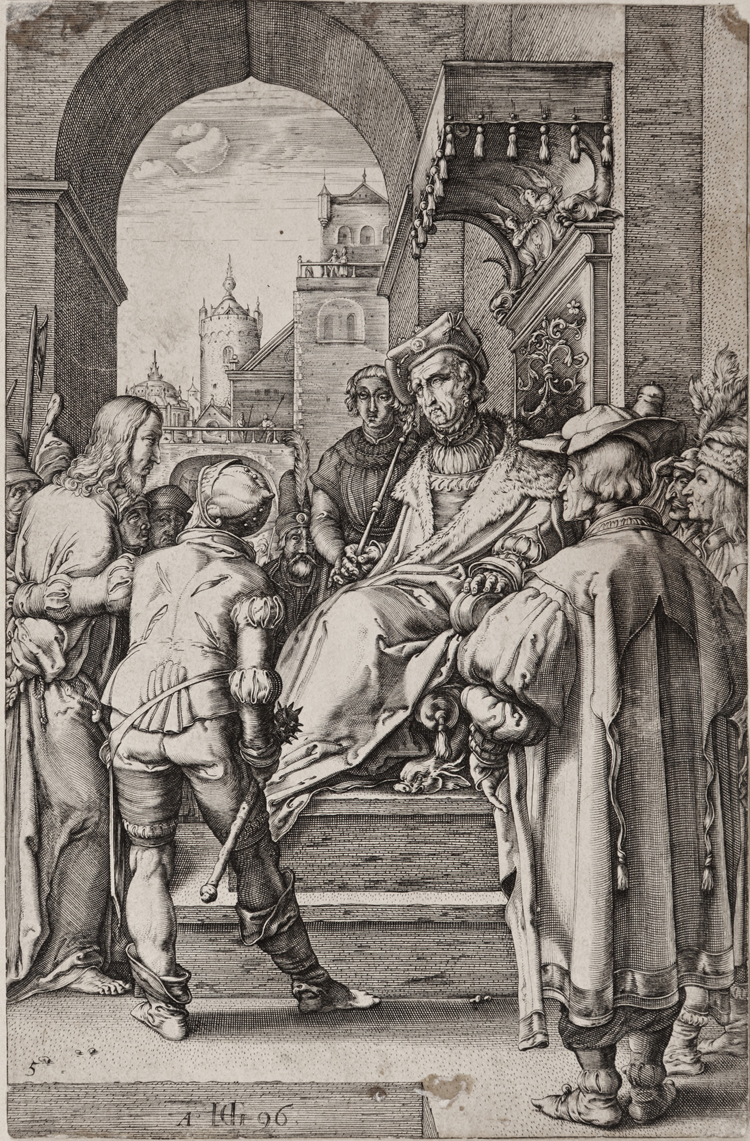 Hendrik Goltzius. Christ before Pilate. Engraving, 1596. Colección Mariano Moret
Hendrik Goltzius. Christ before Pilate. Engraving, 1596. Colección Mariano Moret
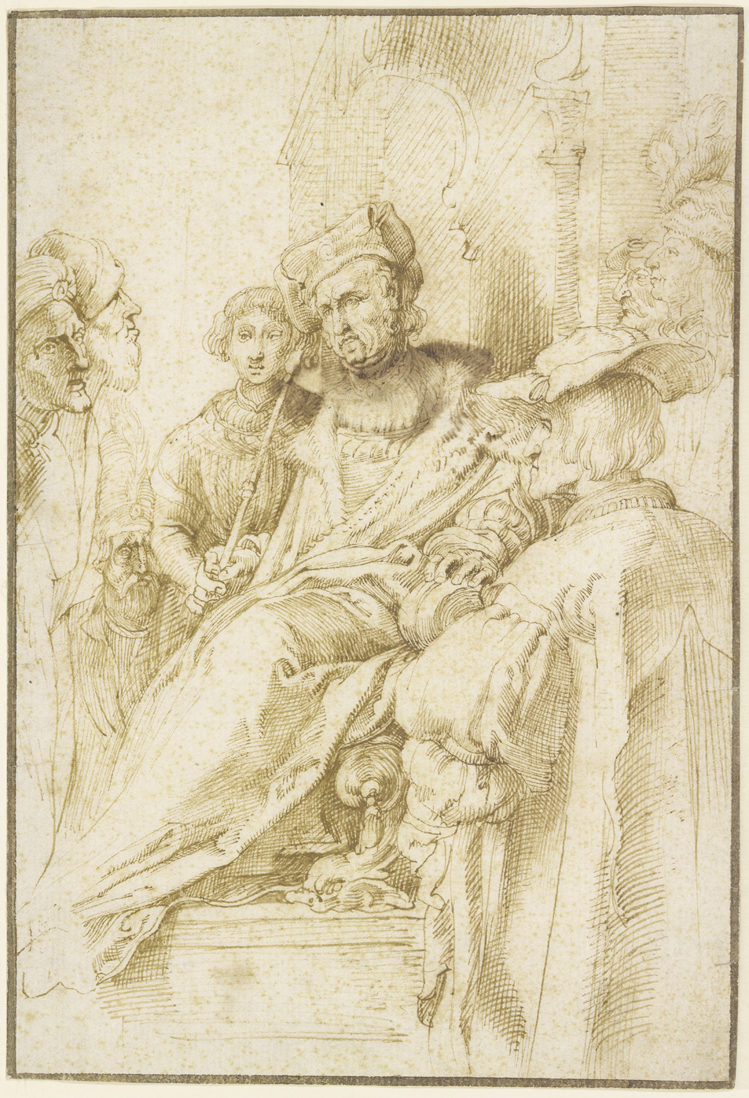 Peter Paul Rubens. Christ before Pilate. Pen and brown ink on laid paper, c. 1598-1600. Städel Museum
Peter Paul Rubens. Christ before Pilate. Pen and brown ink on laid paper, c. 1598-1600. Städel Museum
____________________________________________________________________________________
THEME & VARIATIONS: LEYDEN & Co.
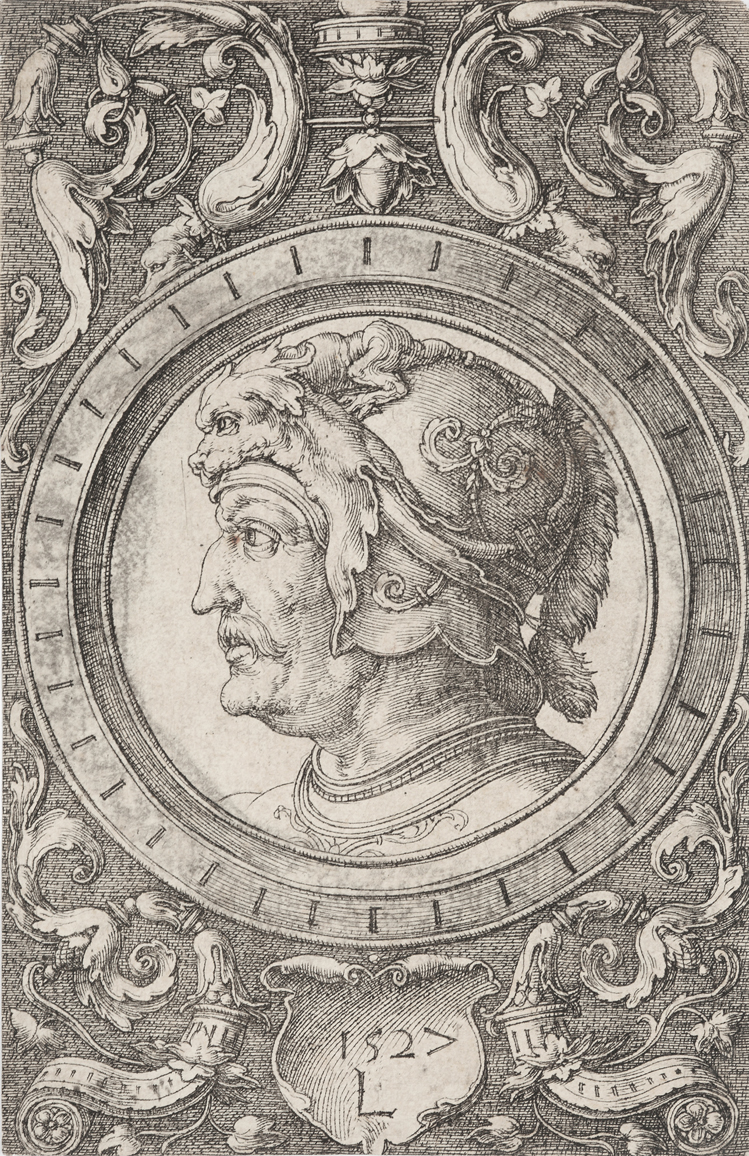 Lucas van Leyden. Ornament with the Head of Soldier. Engraving, 1527. Colección Mariano Moret
Lucas van Leyden. Ornament with the Head of Soldier. Engraving, 1527. Colección Mariano Moret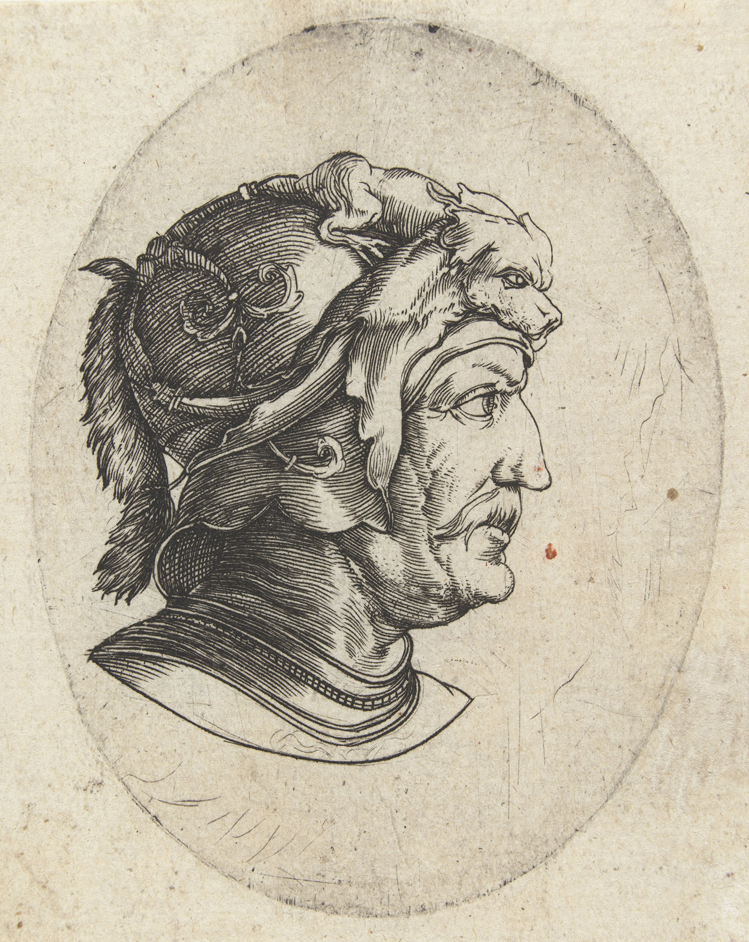 Anonymous, after Lucas van Leyden. Head of Soldier. Engraving, c, 1527-1583. Rijksmuseum
Anonymous, after Lucas van Leyden. Head of Soldier. Engraving, c, 1527-1583. Rijksmuseum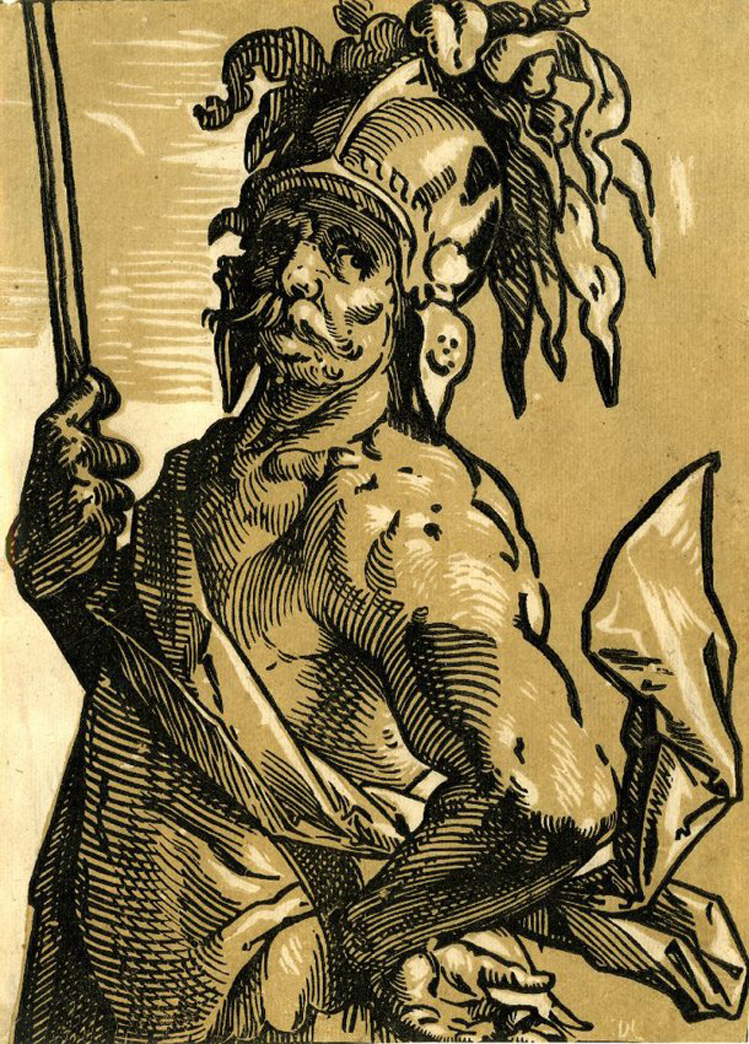 Hendrik Goltzius. Mars. Chiaroscuro woodcut, c. 1588. British Museum
Hendrik Goltzius. Mars. Chiaroscuro woodcut, c. 1588. British Museum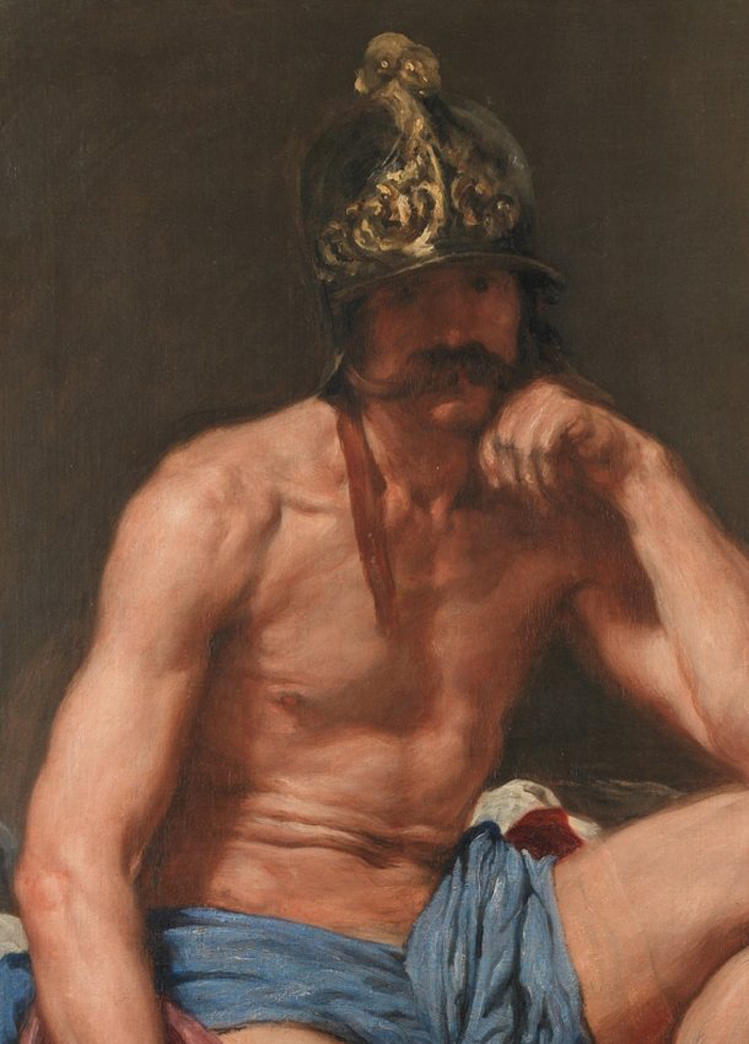 Diego Velázquez. Mars (detail). Oil on canvas, c. 1638. Museo del Prado
Diego Velázquez. Mars (detail). Oil on canvas, c. 1638. Museo del Prado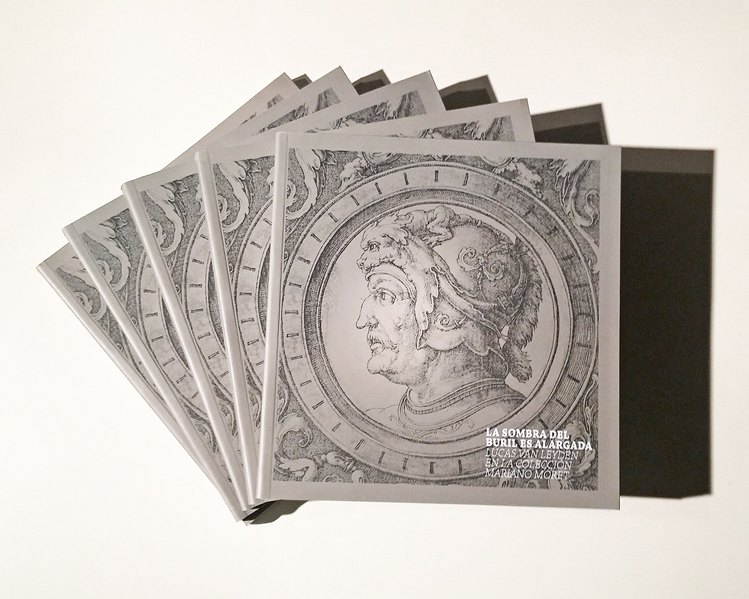
La sombra del buril es alargada. Lucas van Leyden en la Colección Mariano Moret
____________________________________________________________________________________
THEME & VARIATIONS: I TRIONFI
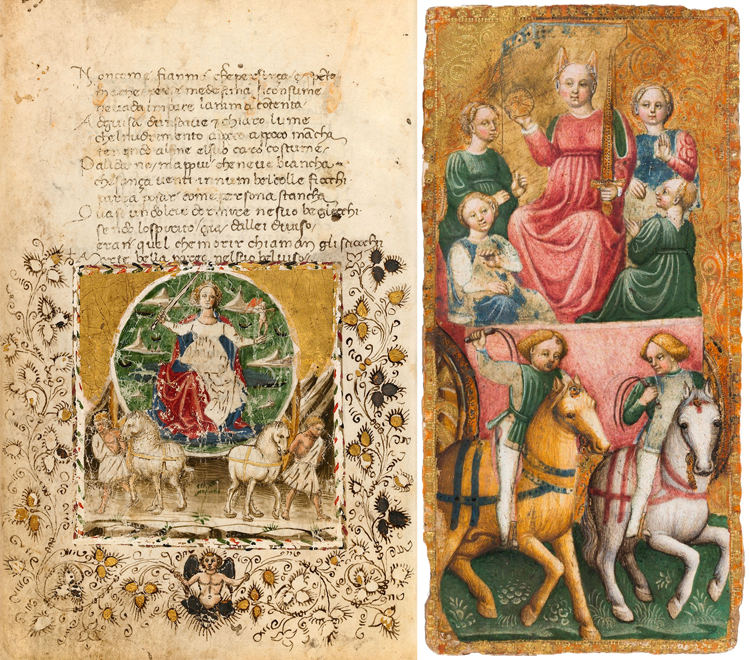 Apollonio di Giovanni. Triumph of Fame, c. 1442. Francesco Petrarca. I Trionfi. Biblioteca Medicea Laurenziana, ms. Strozzi 174 Anonymous Milanese Master, c. 1441. The Charriot. Tarot card commissioned on the occasion of the wedding of Francesco Sforza, Duke of Milan, with Bianca Maria Visconti. Musée français de la carte à jouer
Apollonio di Giovanni. Triumph of Fame, c. 1442. Francesco Petrarca. I Trionfi. Biblioteca Medicea Laurenziana, ms. Strozzi 174 Anonymous Milanese Master, c. 1441. The Charriot. Tarot card commissioned on the occasion of the wedding of Francesco Sforza, Duke of Milan, with Bianca Maria Visconti. Musée français de la carte à jouer“Quattro destrier vie più che neve bianchi sovr’un carro di foco un garzon crudo con arco in man e con saette a’ fianchi”.
Francesco Petrarca. I Trionfi.
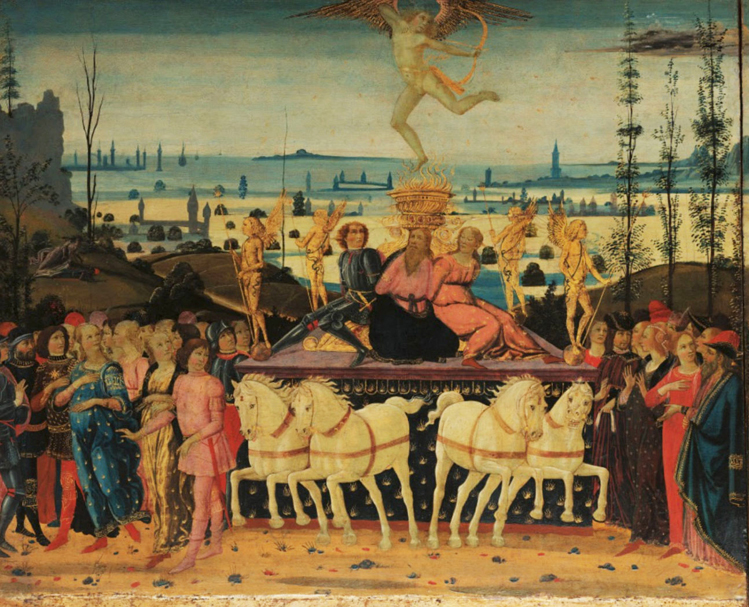 Jacopo del Sellaio. Triumph of Love. Tempera and gold on wood, c. 1485-1490. Museo Bandini
Jacopo del Sellaio. Triumph of Love. Tempera and gold on wood, c. 1485-1490. Museo Bandini Francesco di Stefano, Pesellino. Triumphs of Love, Chastity, and Death. Tempera and gold on wood, c. 1450. Isabella Stewart Gardner Museum
Francesco di Stefano, Pesellino. Triumphs of Love, Chastity, and Death. Tempera and gold on wood, c. 1450. Isabella Stewart Gardner Museum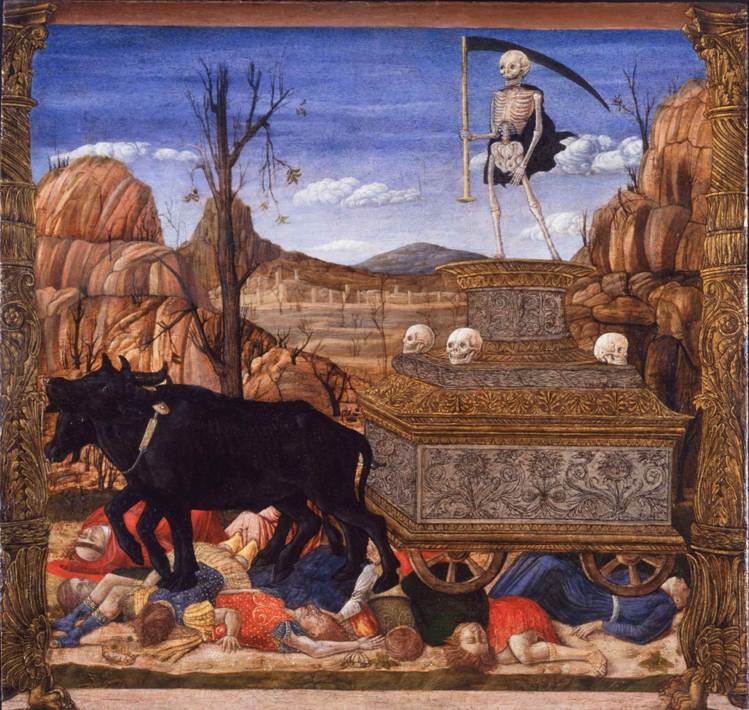 Girolamo da Cremona. Triumph of Death. Oil on panel, c. 1460. Denver Art Museum
Girolamo da Cremona. Triumph of Death. Oil on panel, c. 1460. Denver Art Museum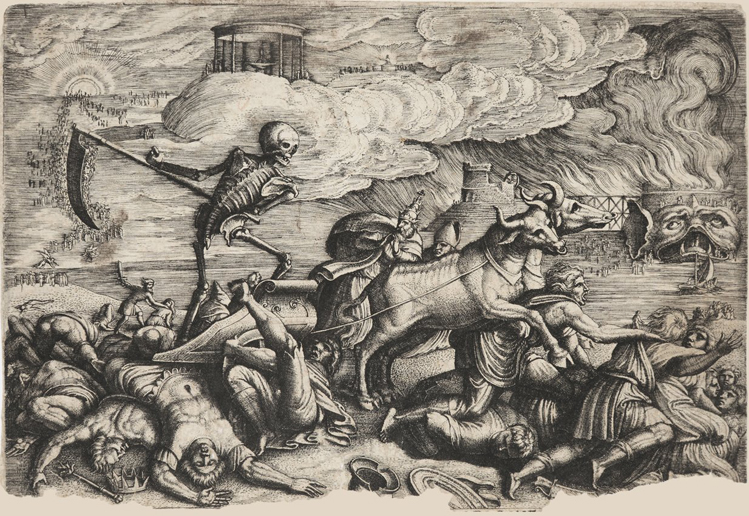 Georg Pencz. Triumph of Death. Engraving, c. 1539. Colección Mariano Moret
Georg Pencz. Triumph of Death. Engraving, c. 1539. Colección Mariano Moret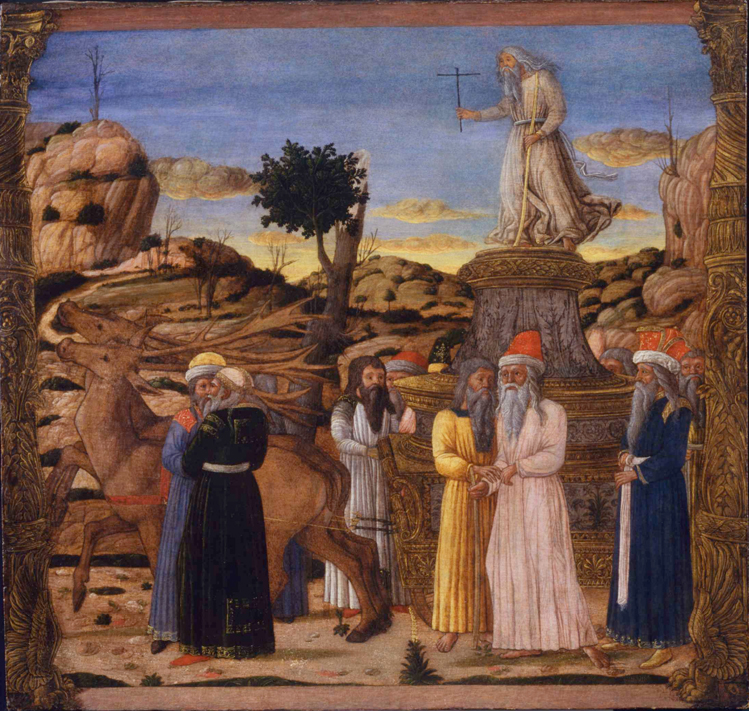 Girolamo da Cremona. Triumph of Time. Oil on panel, c. 1460. Denver Art Museum
Girolamo da Cremona. Triumph of Time. Oil on panel, c. 1460. Denver Art Museum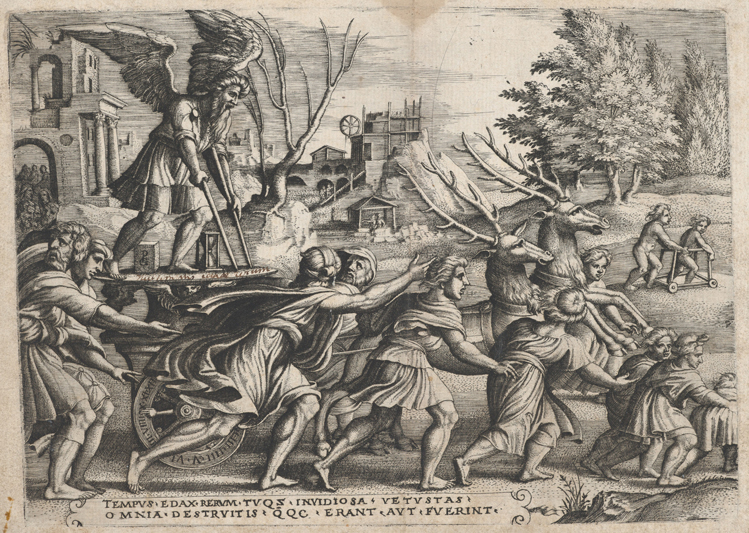 Georg Pencz. Triumph of Time. Engraving, c. 1539. The Met
Georg Pencz. Triumph of Time. Engraving, c. 1539. The Met___________________________________________________________________________________
THEME & VARIATIONS: THE GREAT DÜRER AND THE LITTLE MASTER
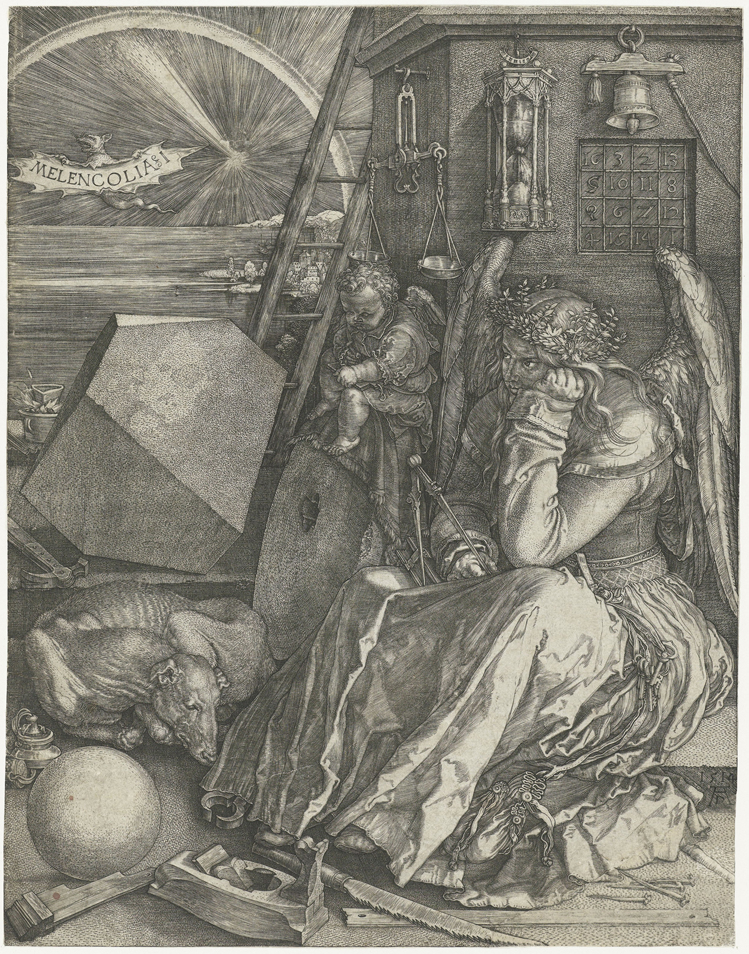 Albrecht Dürer. Melencolia I. Engraving, 1514. Rijksmuseum
Albrecht Dürer. Melencolia I. Engraving, 1514. Rijksmuseum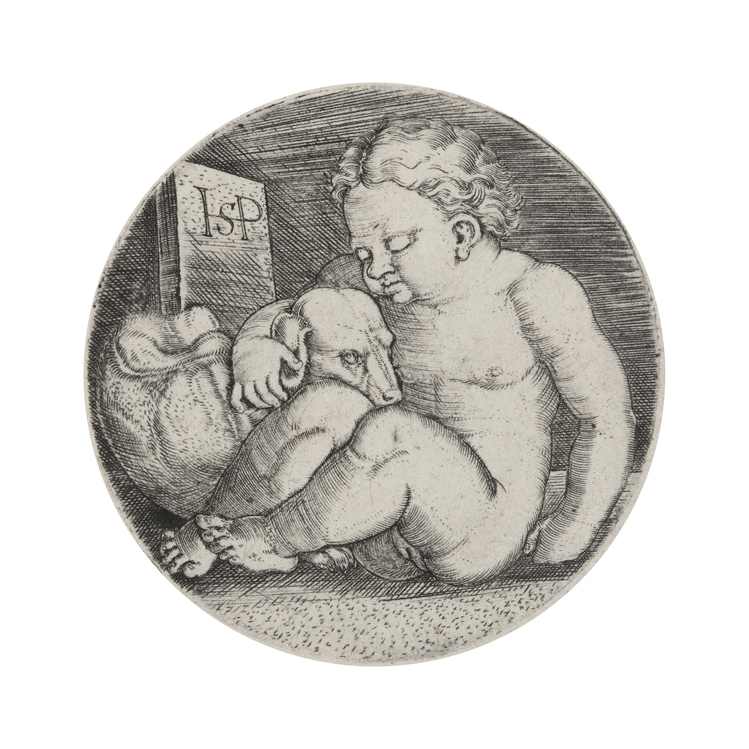 Sebald Beham. A sleeping girl with a dog. Engraving, c. 1518-1530. Colección Mariano Moret
Sebald Beham. A sleeping girl with a dog. Engraving, c. 1518-1530. Colección Mariano Moret____________________________________________________________________________________
THEME & VARIATIONS: GOLTZIUS' JESTER
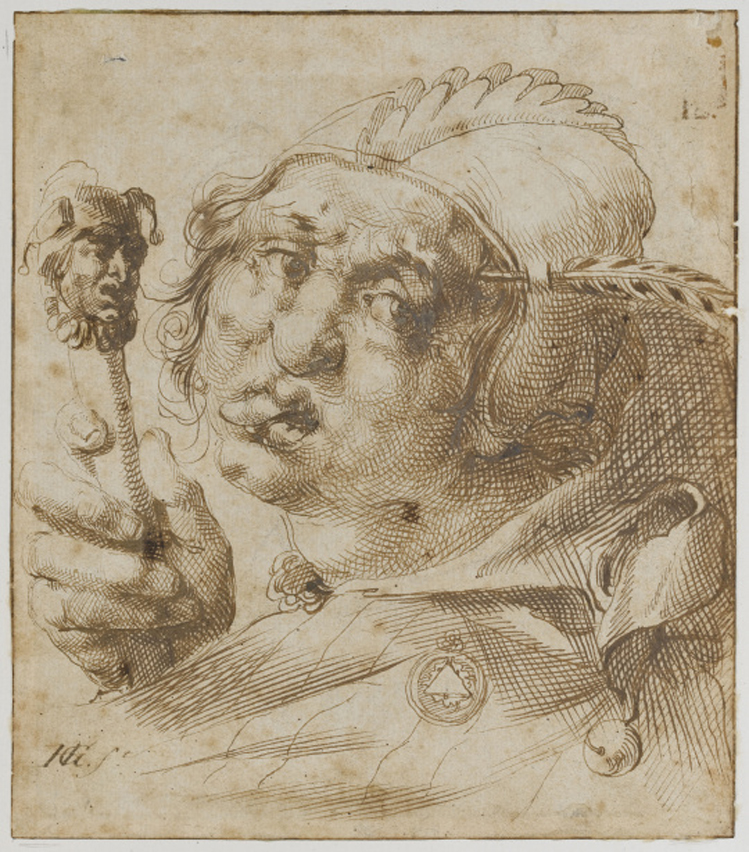 Hendrick Goltzius. Fool head. Pen and brown ink, and brown wash. Lille, Palais des Beaux-Arts
Hendrick Goltzius. Fool head. Pen and brown ink, and brown wash. Lille, Palais des Beaux-Arts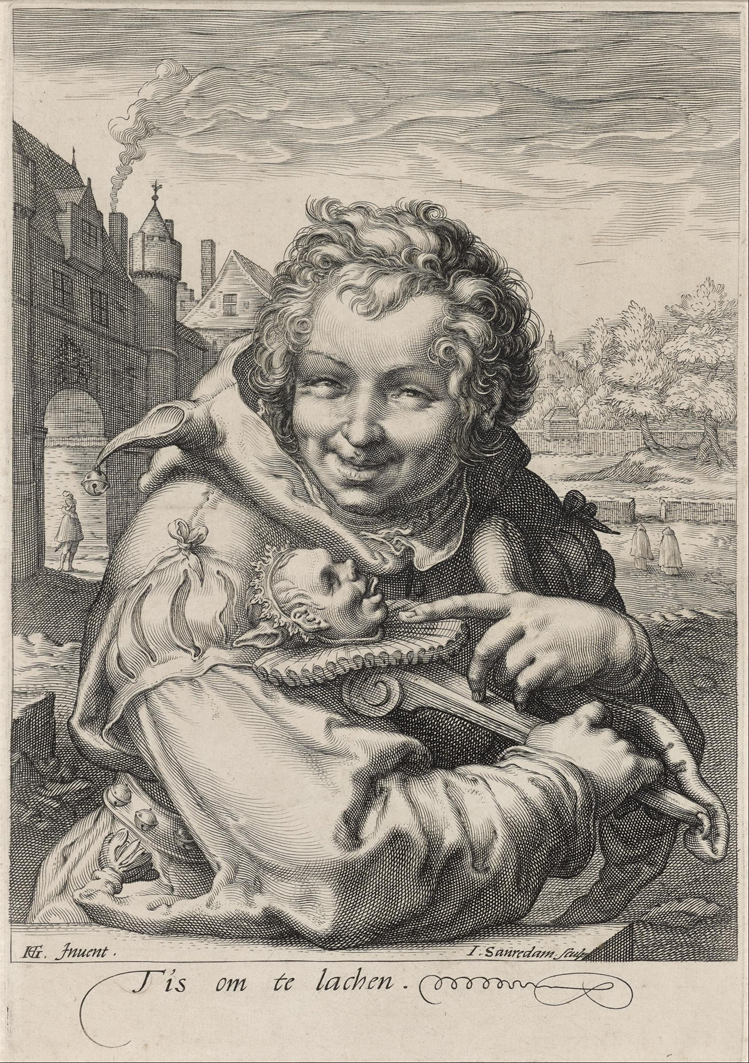 Jan Saenredam, after Hendrick Goltzius. Fool Holding a Staff. Engraving, c. 1595. The Museum of Fine Arts, Houston
Jan Saenredam, after Hendrick Goltzius. Fool Holding a Staff. Engraving, c. 1595. The Museum of Fine Arts, Houston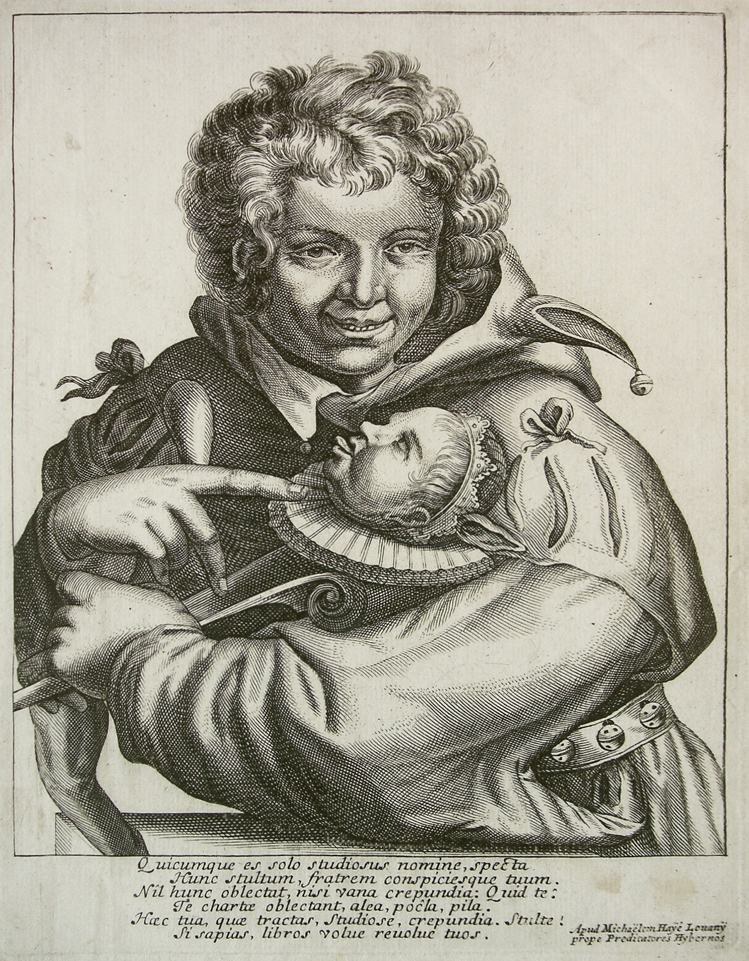 Michael Hayé, after Jan Saenredam, after Hendrick Goltzius. Fool Holding a Staff. Engraving, c. 1630. Colección Mariano Moret
Michael Hayé, after Jan Saenredam, after Hendrick Goltzius. Fool Holding a Staff. Engraving, c. 1630. Colección Mariano Moret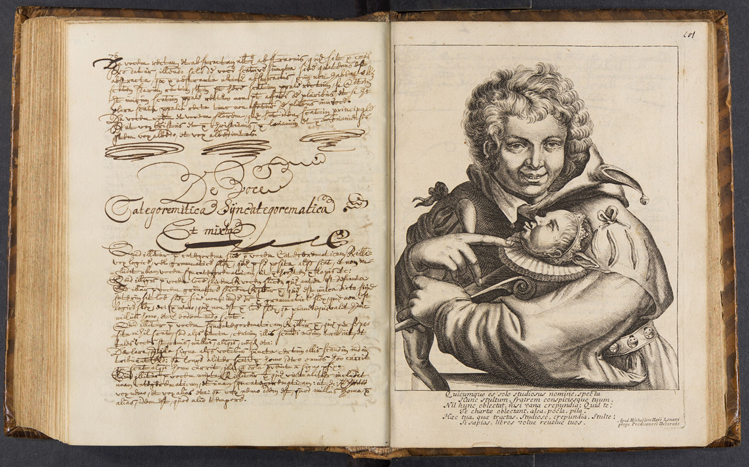 Michael Hayé, after Jan Saenredam, after Hendrick Goltzius. Fool Holding a Staff. Engraving, c. 1630. van Riethoven, Cornelius, Logica. KU Leuven, Faculty of Arts, 1751-1797. Ms. 19376. Koninklijke Bibliotheek van België / Bibliothèque royale de Belgique
Michael Hayé, after Jan Saenredam, after Hendrick Goltzius. Fool Holding a Staff. Engraving, c. 1630. van Riethoven, Cornelius, Logica. KU Leuven, Faculty of Arts, 1751-1797. Ms. 19376. Koninklijke Bibliotheek van België / Bibliothèque royale de Belgique 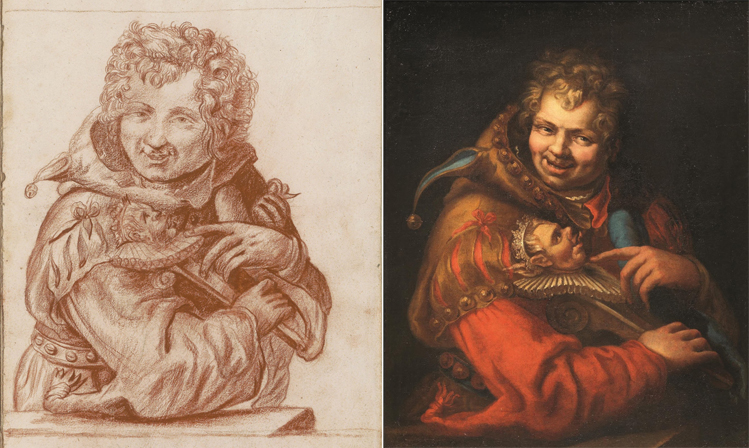
Hendrick van Beaumont, after Jan Saenredam, after Hendrick Goltzius. Fool Holding a Staff. Red chalk, 1696. Rijksmuseum Attributed to Werner van den Valckert (1585-1627), after Hendrick Goltzius. A jester pointing at his marotte. Oil on canvas. Jean Moust
____________________________________________________________________________________
THEME & VARIATIONS: HOLBEIN'S JESTER
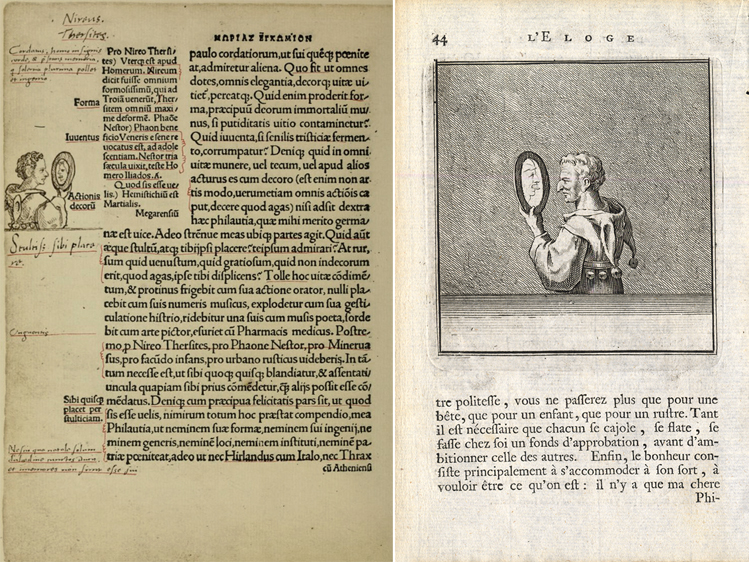 Erasmus Roterodami, Encomium Moriae, Basel: 1515. Universitätsbibliothek Basel Erasmus of Rotterdam, L'Eloge de la Folie, Amsterdam: 1728. Colección Mariano Moret
Erasmus Roterodami, Encomium Moriae, Basel: 1515. Universitätsbibliothek Basel Erasmus of Rotterdam, L'Eloge de la Folie, Amsterdam: 1728. Colección Mariano Moret 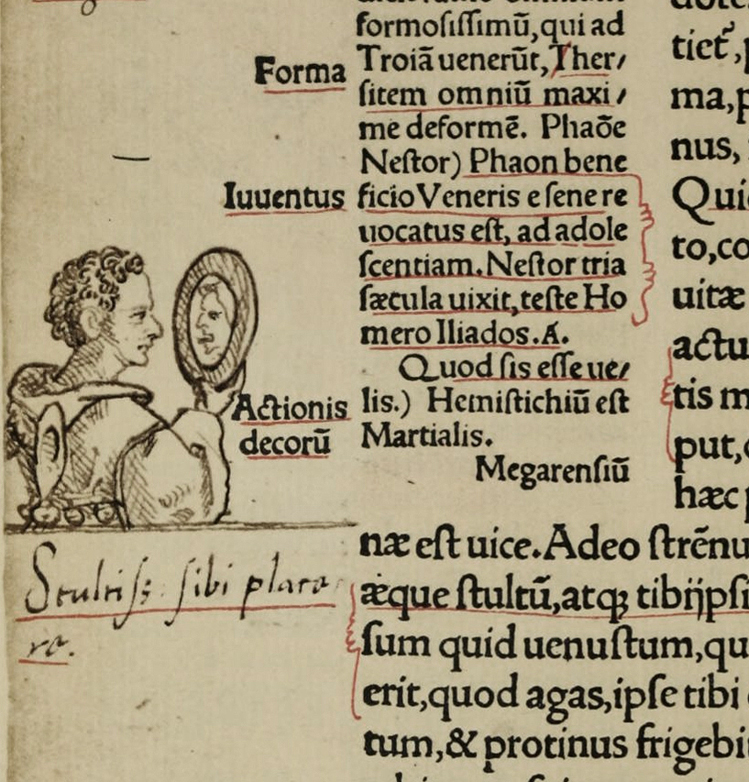 Hans Holbein the Younger. The fool admiring himself in a mirror. Pen and black ink, 1515. Universitätsbibliothek Basel
Hans Holbein the Younger. The fool admiring himself in a mirror. Pen and black ink, 1515. Universitätsbibliothek Basel Anonymous Dutch engraver, after Hans Holbein the Younger. The fool admiring himself in a mirror, Engraving, h. 1728. Colección Mariano Moret
Anonymous Dutch engraver, after Hans Holbein the Younger. The fool admiring himself in a mirror, Engraving, h. 1728. Colección Mariano Moret____________________________________________________________________________________
THEME & VARIATIONS: THE ACANTHUS OF THE MONOGRAMMIST AP
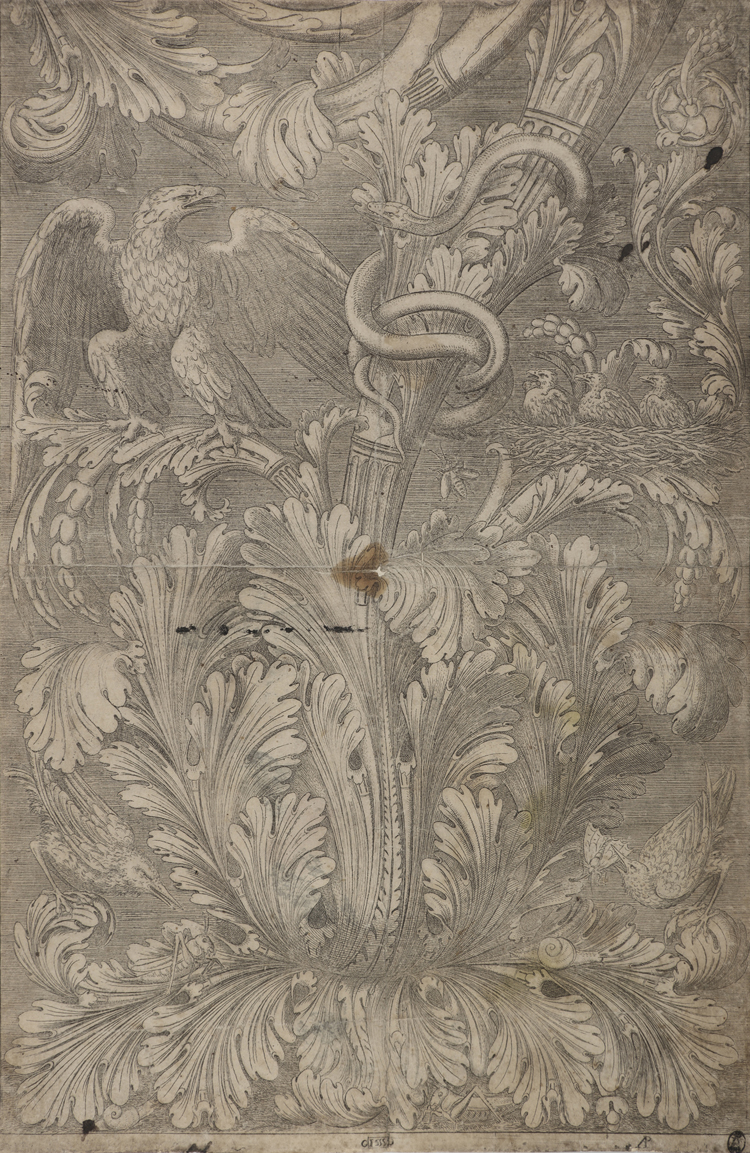 Monogrammist AP. Plate depicting lower part of a Roman pilaster with acanthus leaves, eagle and other birds and insects. Etching, 1555. Colección Mariano Moret
Monogrammist AP. Plate depicting lower part of a Roman pilaster with acanthus leaves, eagle and other birds and insects. Etching, 1555. Colección Mariano Moret
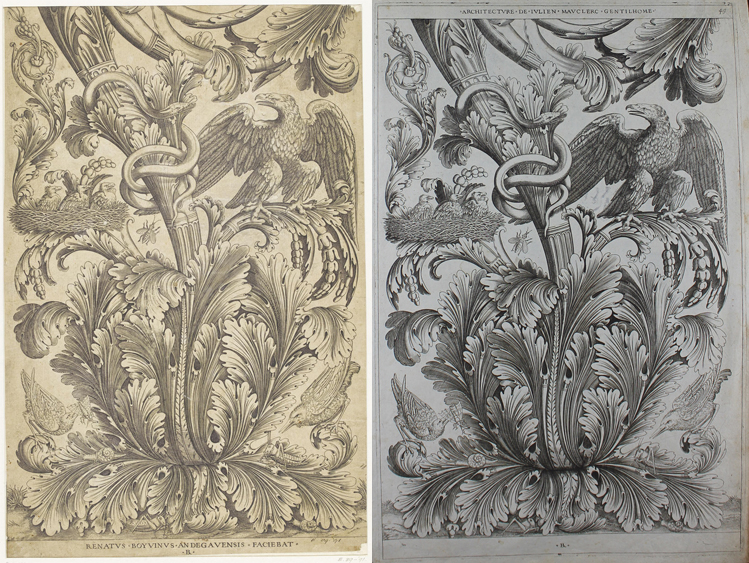 René Boyvin. Plate depicting lower part of a Roman pilaster with acanthus leaves, eagle and other birds and insects. Engraving, c. 1599. Victoria & Albert Museum René Boyvin. Plate depicting lower part of a Roman pilaster with acanthus leaves, eagle and other birds and insects. Engraving, c. 1599. Bibliothèque de Nancy
René Boyvin. Plate depicting lower part of a Roman pilaster with acanthus leaves, eagle and other birds and insects. Engraving, c. 1599. Victoria & Albert Museum René Boyvin. Plate depicting lower part of a Roman pilaster with acanthus leaves, eagle and other birds and insects. Engraving, c. 1599. Bibliothèque de Nancy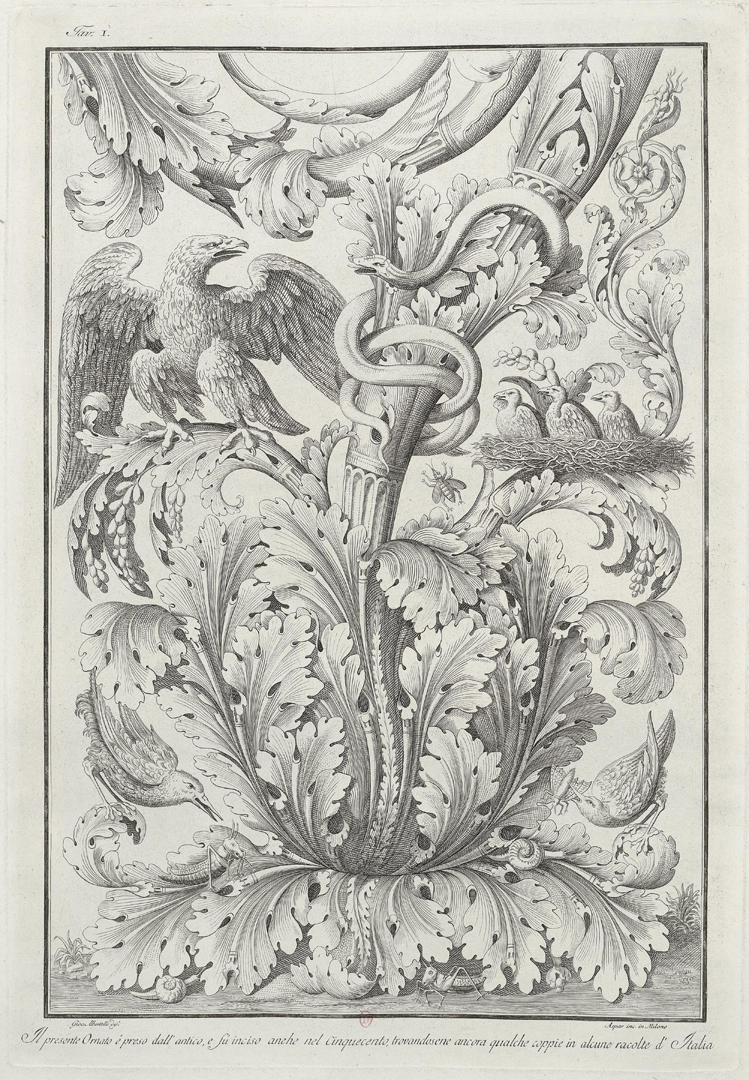 Carlo Antonio Aspari. Plate depicting lower part of a Roman pilaster with acanthus leaves, eagle and other birds and insects. Etching, c. 1782. Bibliothèque de l'Institut National d'Histoire de l'Art.
Carlo Antonio Aspari. Plate depicting lower part of a Roman pilaster with acanthus leaves, eagle and other birds and insects. Etching, c. 1782. Bibliothèque de l'Institut National d'Histoire de l'Art.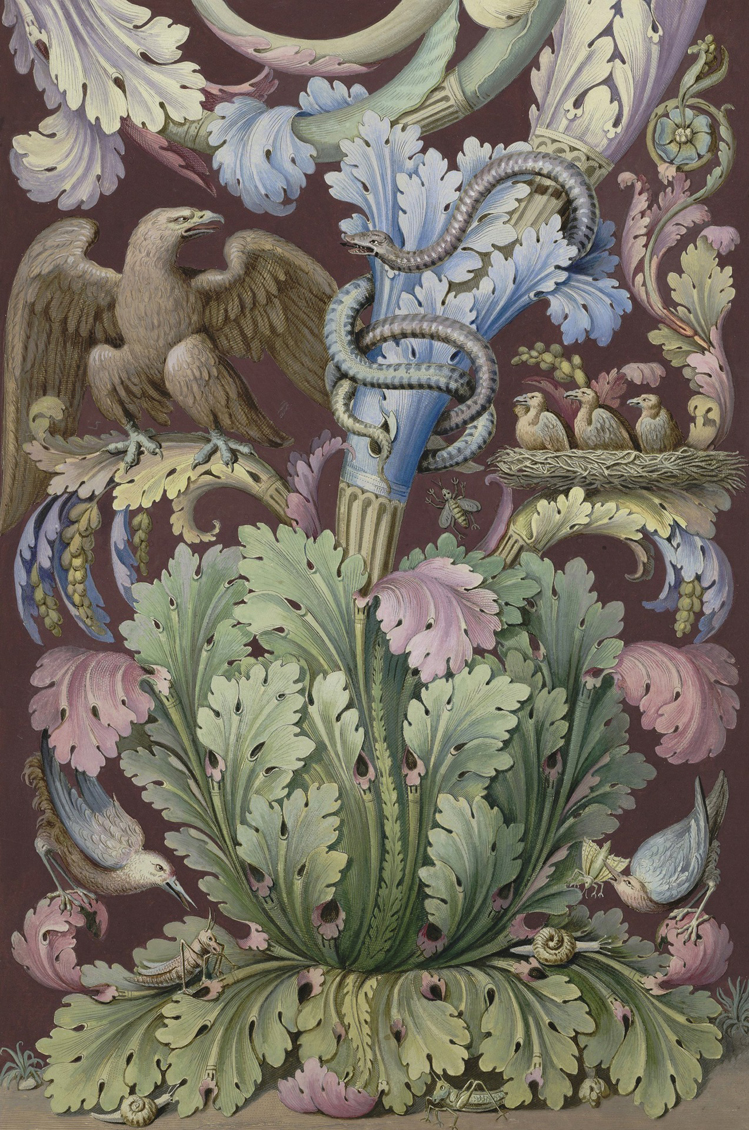 Carlo Antonio Aspari. Plate depicting lower part of a Roman pilaster with acanthus leaves, eagle and other birds and insects. Hand-coloured etching, c. 1782. Bibliothèque de l'Institut National d'Histoire de l'Art.
Carlo Antonio Aspari. Plate depicting lower part of a Roman pilaster with acanthus leaves, eagle and other birds and insects. Hand-coloured etching, c. 1782. Bibliothèque de l'Institut National d'Histoire de l'Art.___________________________________________________________________________________
THEME & VARIATIONS: THE RETURN OF THE PRODIGAL SON
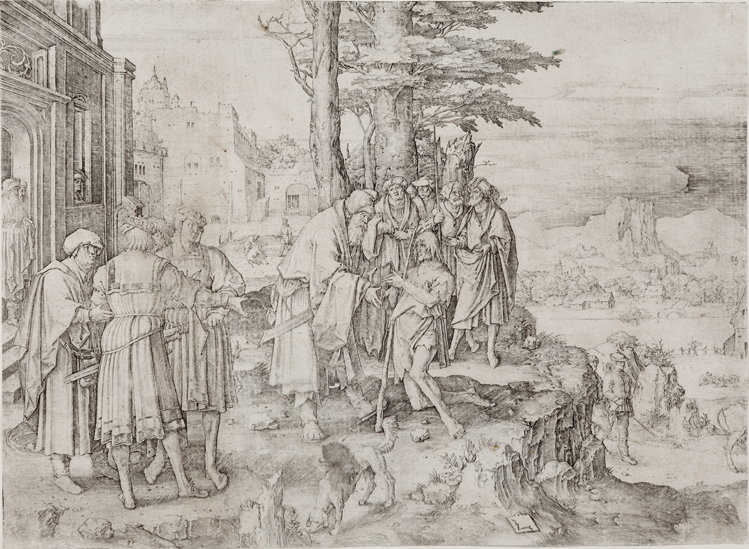
Lucas van Leyden. The Return of the Prodigal Son. Engraving and drypoint, c. 1510. Colección Mariano Moret
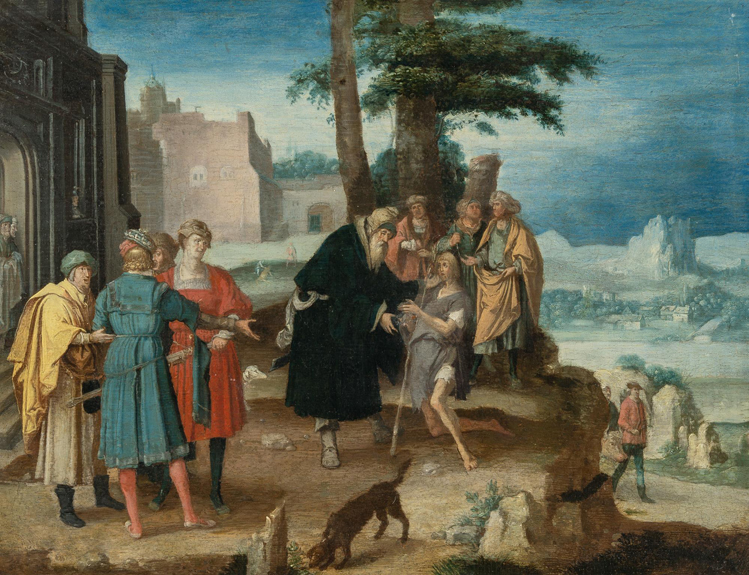 Follower of Lucas van Leyden. The Return of the Prodigal Son. Oil on panel, c. 1600. Karl & Faber
Follower of Lucas van Leyden. The Return of the Prodigal Son. Oil on panel, c. 1600. Karl & Faber____________________________________________________________________________________
THEME & VARIATIONS: THE BEAUTIFUL SUICIDES
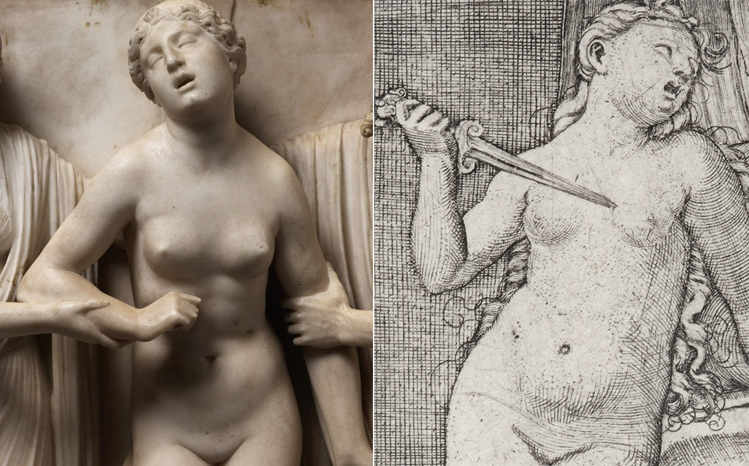 Attributed to Antonio Lombardo. The Death of Lucretia (detail). Marble, c. 1506-1518. Colnaghi Attributed to Georg Pencz. The Death of Dido (detail). Engraving, c. 1530. Colección Mariano Moret
Attributed to Antonio Lombardo. The Death of Lucretia (detail). Marble, c. 1506-1518. Colnaghi Attributed to Georg Pencz. The Death of Dido (detail). Engraving, c. 1530. Colección Mariano Moret 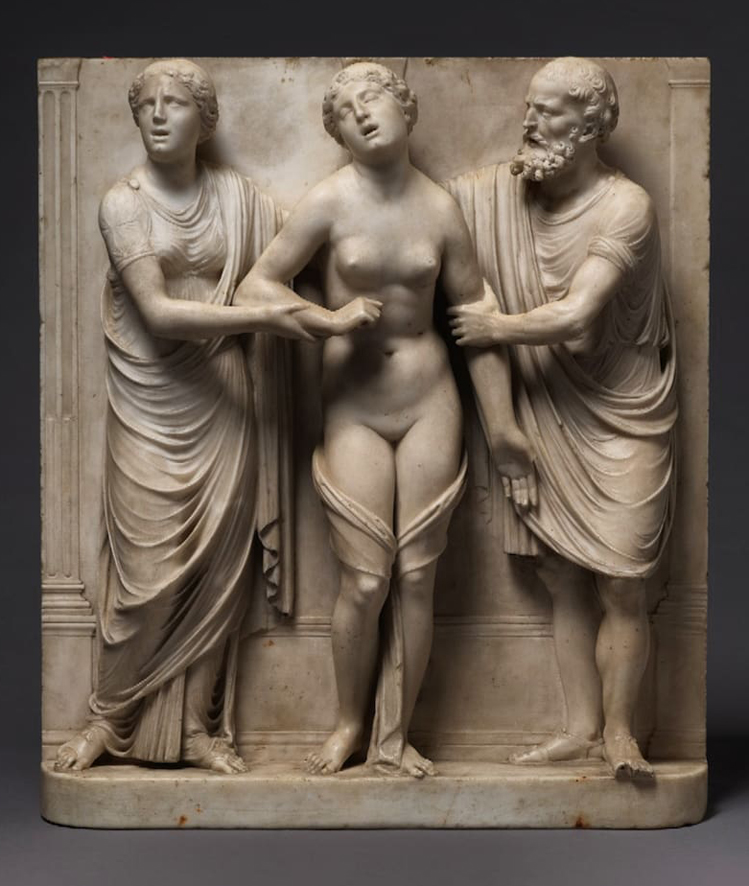 Attributed to Antonio Lombardo. The Death of Lucretia. Marble, c. 1506-1518. Colnaghi
Attributed to Antonio Lombardo. The Death of Lucretia. Marble, c. 1506-1518. Colnaghi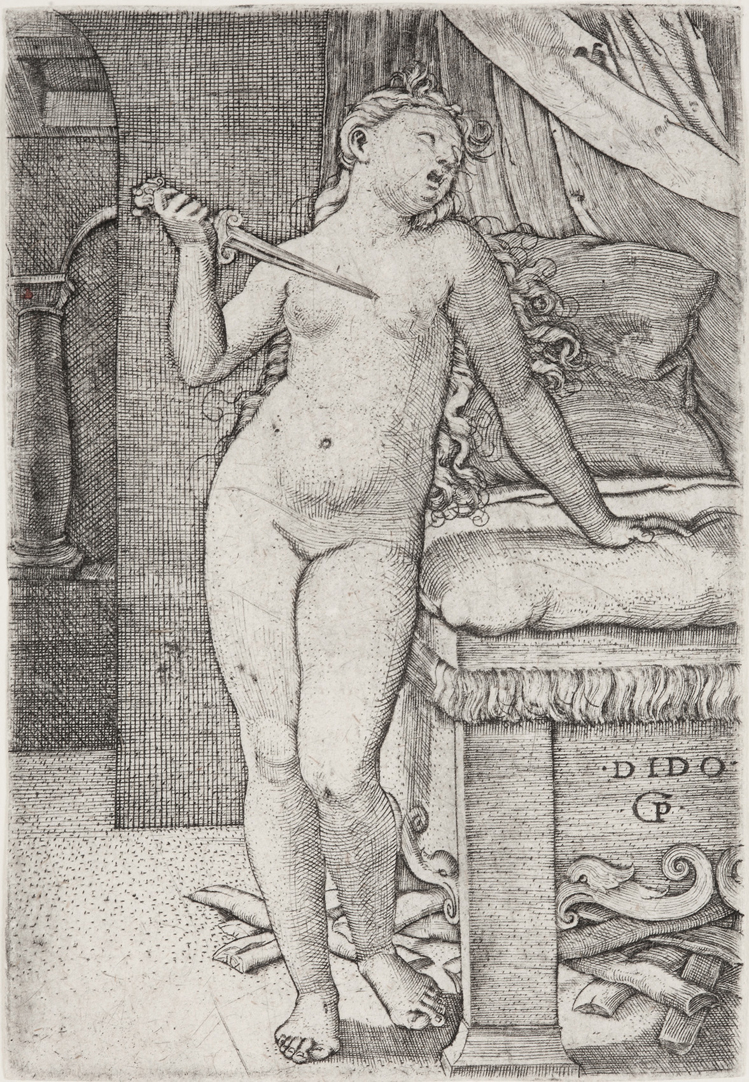 Attributed to Georg Pencz. The Death of Dido. Engraving, c. 1530. Colección Mariano Moret
Attributed to Georg Pencz. The Death of Dido. Engraving, c. 1530. Colección Mariano Moret____________________________________________________________________________________
THEME & VARIATIONS: THE FOUR EVANGELISTS BY LUCAS VAN LEYDEN
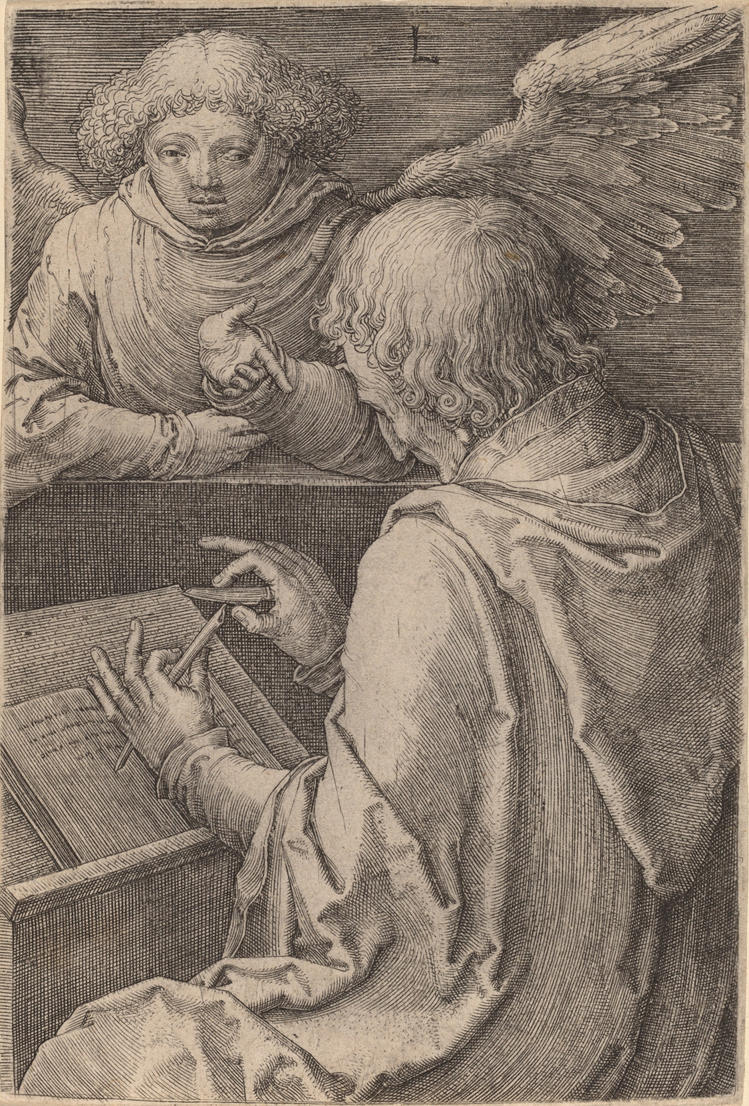 Lucas van Leyden. St Matthew. Engraving, 1518. The National Gallery of Art
Lucas van Leyden. St Matthew. Engraving, 1518. The National Gallery of Art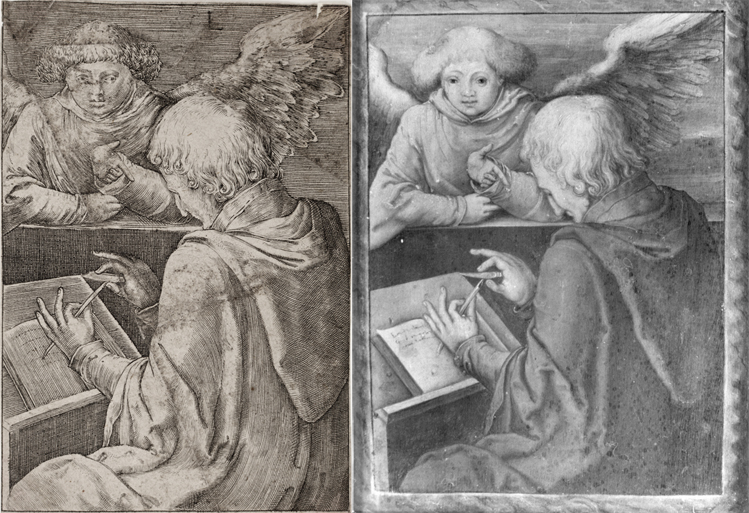 Jan Harmensz. Muller, after Lucas van Leyden. St Matthew. Engraving, 1518. Colección Mariano Moret After Lucas van Leyden. St Matthew. Oil on wood, c. 1550. Szépművészeti Múzeum
Jan Harmensz. Muller, after Lucas van Leyden. St Matthew. Engraving, 1518. Colección Mariano Moret After Lucas van Leyden. St Matthew. Oil on wood, c. 1550. Szépművészeti Múzeum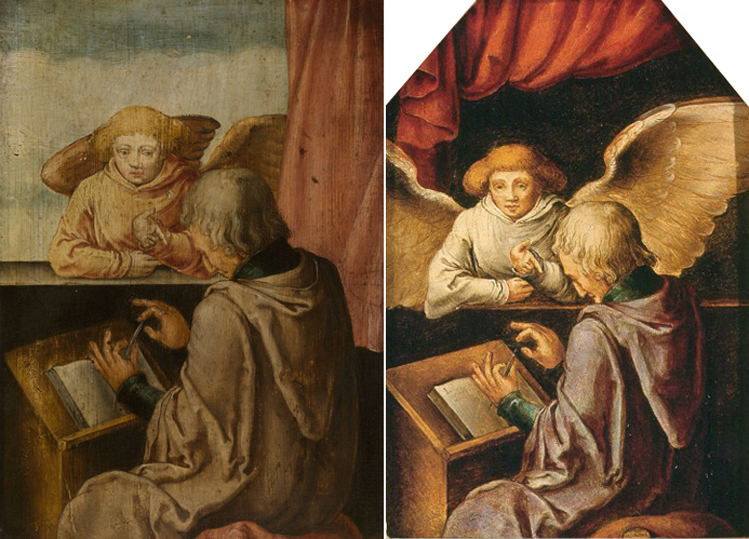 Dutch School after Lucas van Leyden. St Matthew. Oil on wood, c. 1600. Koninklijk Museum voor Schone Kunsten Dutch School after Lucas van Leyden. St Matthew. Oil on copper, c. 1600. Chrysler Museum of Art (deaccesioned)
Dutch School after Lucas van Leyden. St Matthew. Oil on wood, c. 1600. Koninklijk Museum voor Schone Kunsten Dutch School after Lucas van Leyden. St Matthew. Oil on copper, c. 1600. Chrysler Museum of Art (deaccesioned)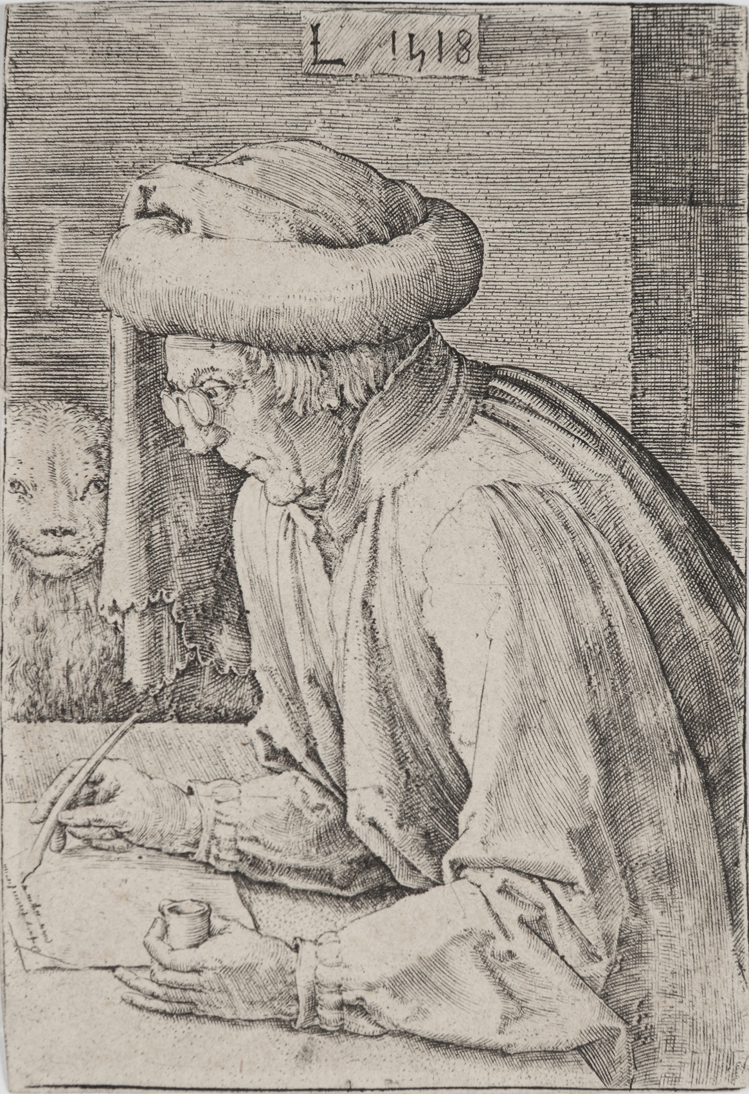 Lucas van Leyden. St Mark. Engraving, 1518. Colección Mariano Moret
Lucas van Leyden. St Mark. Engraving, 1518. Colección Mariano Moret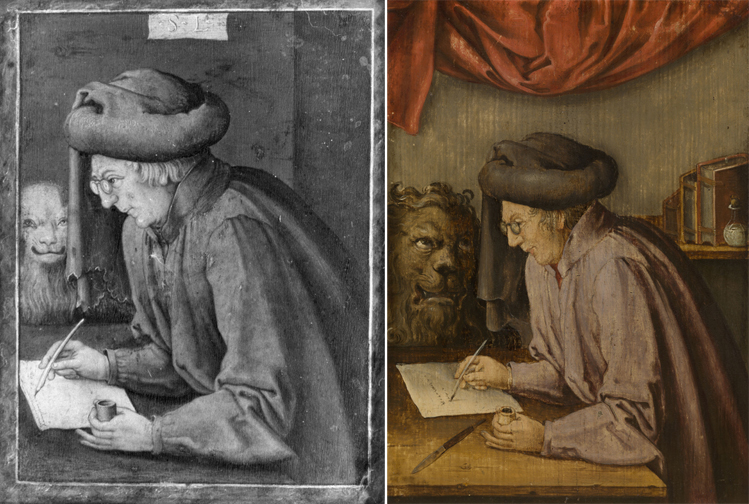 After Lucas van Leyden. St Mark. Oil on wood, c. 1550. Szépművészeti Múzeum Dutch School after Lucas van Leyden. St Mark. Oil on wood, c. 1600. Koninklijk Museum voor Schone Kunsten
After Lucas van Leyden. St Mark. Oil on wood, c. 1550. Szépművészeti Múzeum Dutch School after Lucas van Leyden. St Mark. Oil on wood, c. 1600. Koninklijk Museum voor Schone Kunsten 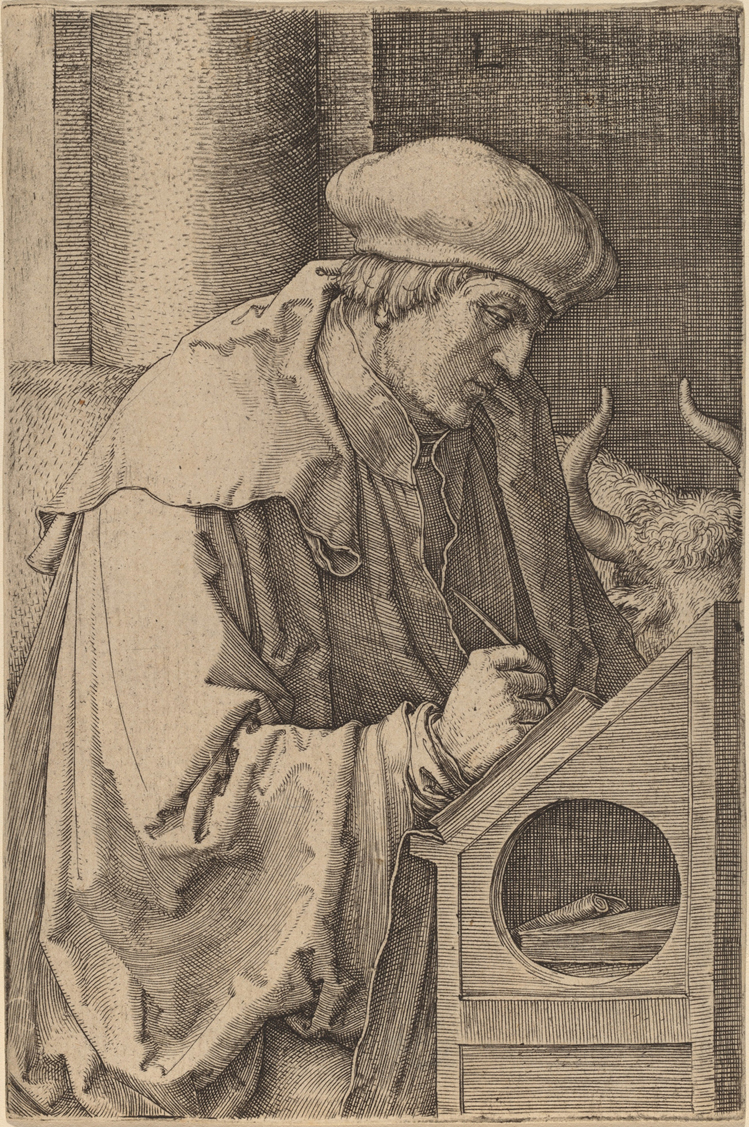 Lucas van Leyden. St Luke. Engraving, 1518. The National Gallery of Art
Lucas van Leyden. St Luke. Engraving, 1518. The National Gallery of Art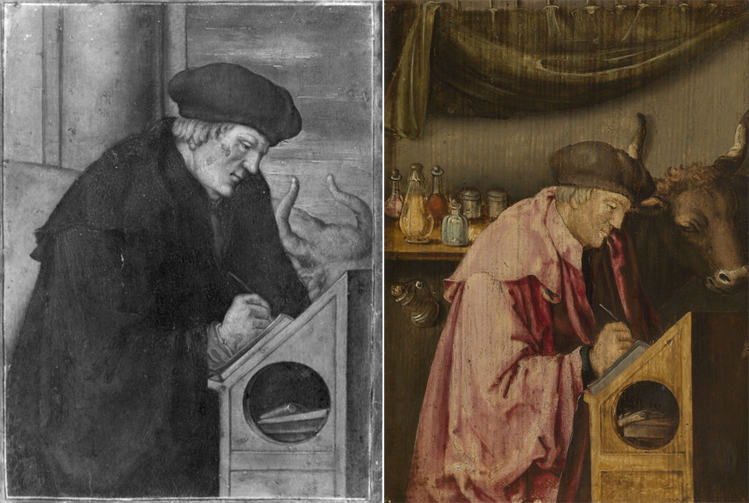 After Lucas van Leyden. St Luke. Oil on wood, c. 1550. Szépművészeti Múzeum Dutch School after Lucas van Leyden. St Luke. Oil on wood, c. 1600. Koninklijk Museum voor Schone Kunsten
After Lucas van Leyden. St Luke. Oil on wood, c. 1550. Szépművészeti Múzeum Dutch School after Lucas van Leyden. St Luke. Oil on wood, c. 1600. Koninklijk Museum voor Schone Kunsten 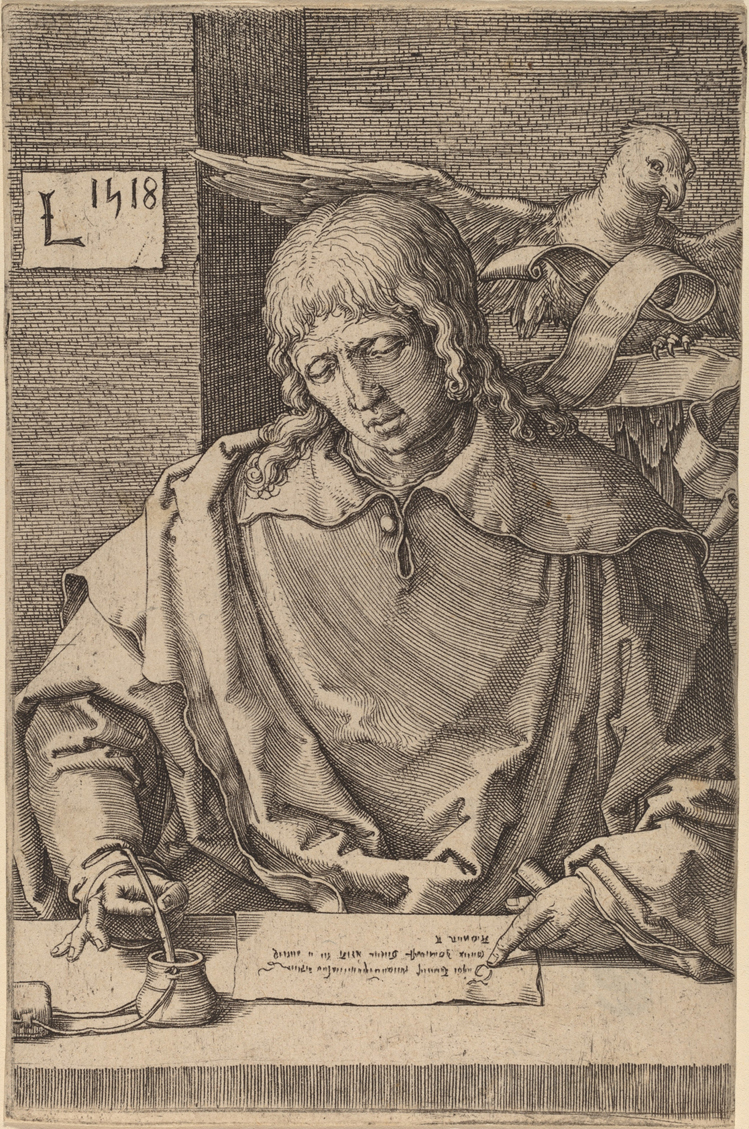 Lucas van Leyden. St John. Engraving, 1518. The National Gallery of Art
Lucas van Leyden. St John. Engraving, 1518. The National Gallery of Art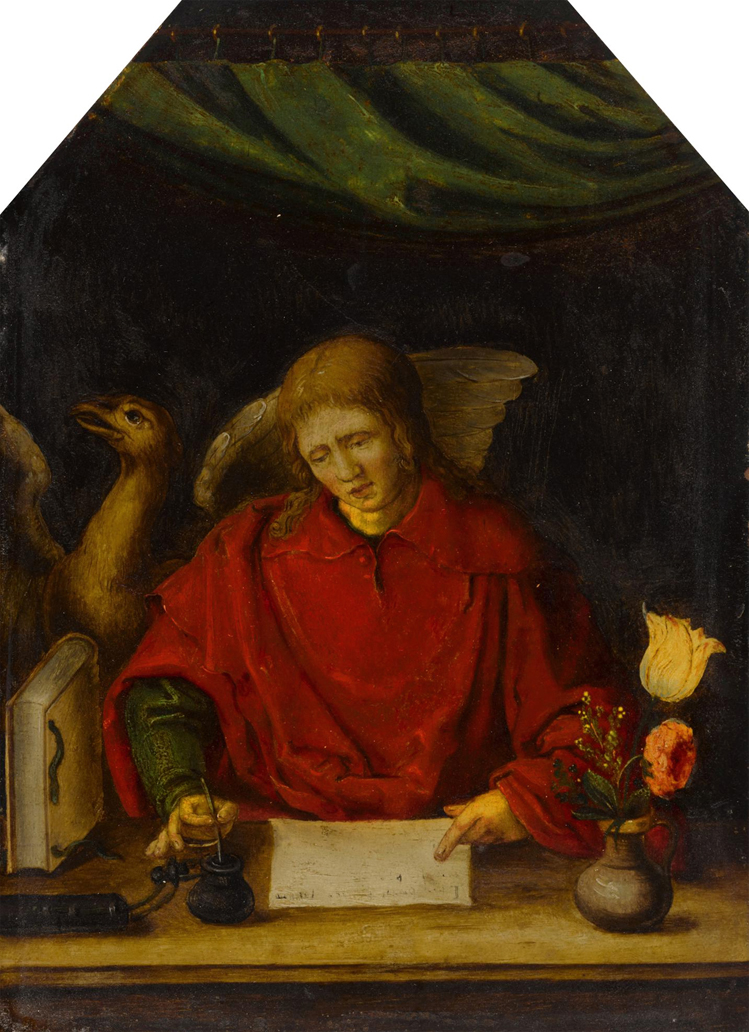 Dutch School after Lucas van Leyden. St John the Evangelist. Oil on copper, c. 1600. Sotheby's. Richard L. Feigen Collection
Dutch School after Lucas van Leyden. St John the Evangelist. Oil on copper, c. 1600. Sotheby's. Richard L. Feigen Collection____________________________________________________________________________________
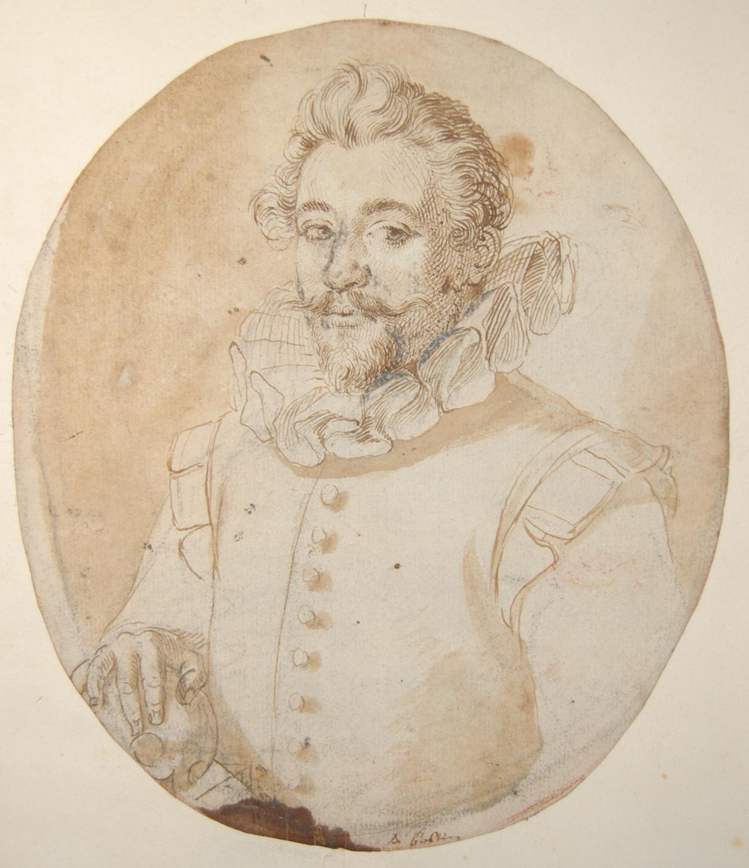 Arent van Bolten. Self-portrait (?). Pen and brown ink, with brown wash, touched with white (oxidised), over black chalk, c. 1588-1633. British Museum
Arent van Bolten. Self-portrait (?). Pen and brown ink, with brown wash, touched with white (oxidised), over black chalk, c. 1588-1633. British Museum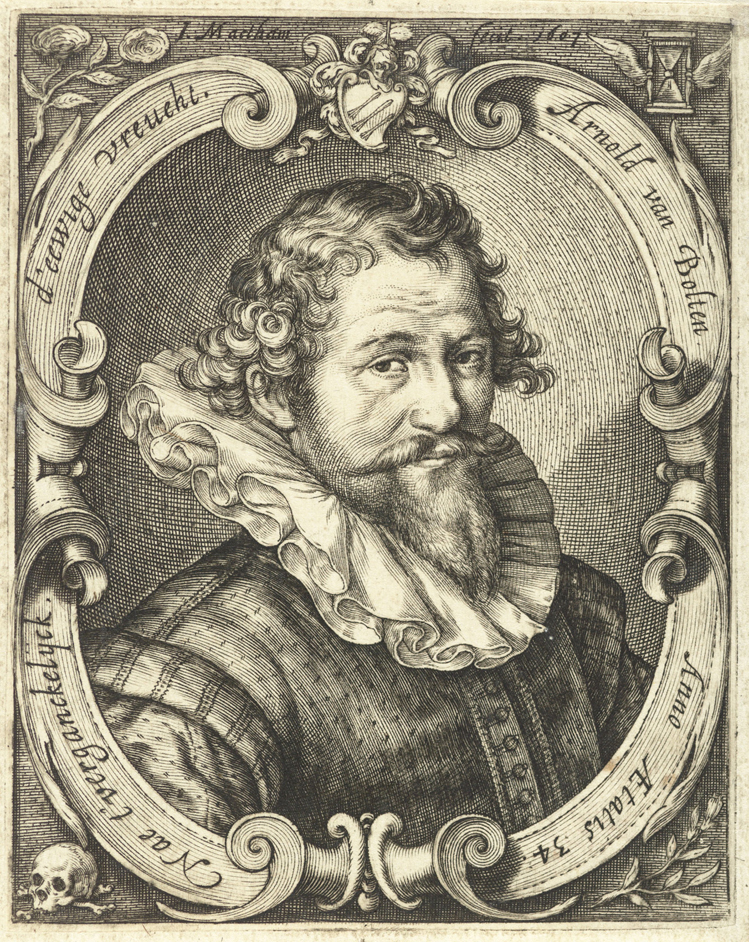 Jacob Matham. Portrait of Arent van Bolten. Engraving, 1607. Rijksmuseum
Jacob Matham. Portrait of Arent van Bolten. Engraving, 1607. Rijksmuseum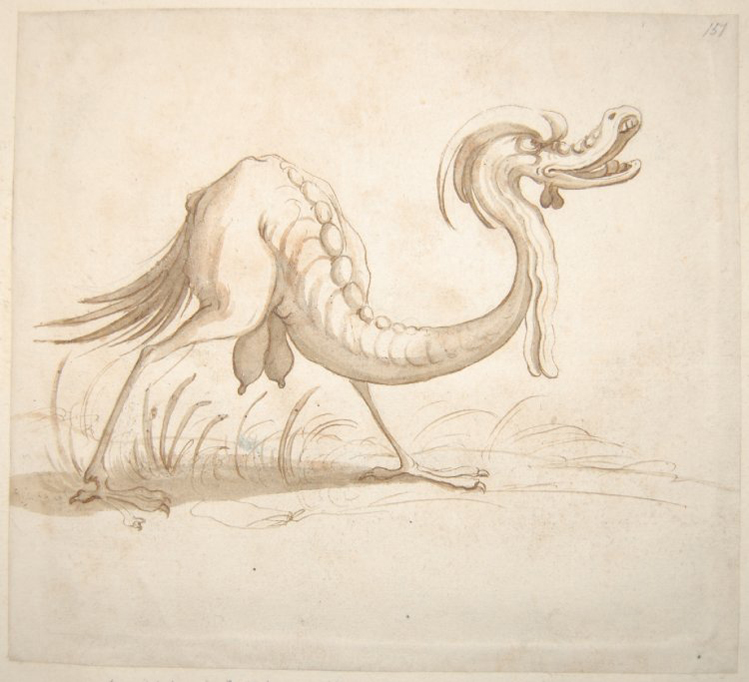 Arent van Bolten. A monster. Pen and brown ink, and grey-brown wash, over black chalk, c. 1588-1633. British Museum
Arent van Bolten. A monster. Pen and brown ink, and grey-brown wash, over black chalk, c. 1588-1633. British Museum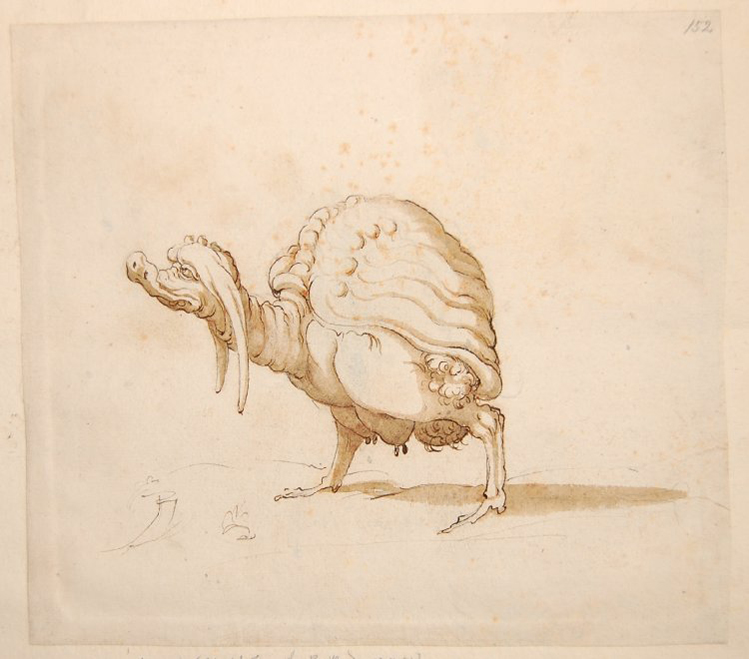 Arent van Bolten. A monster. Pen and brown ink, and grey-brown wash, over black chalk, c. 1588-1633. British Museum
Arent van Bolten. A monster. Pen and brown ink, and grey-brown wash, over black chalk, c. 1588-1633. British Museum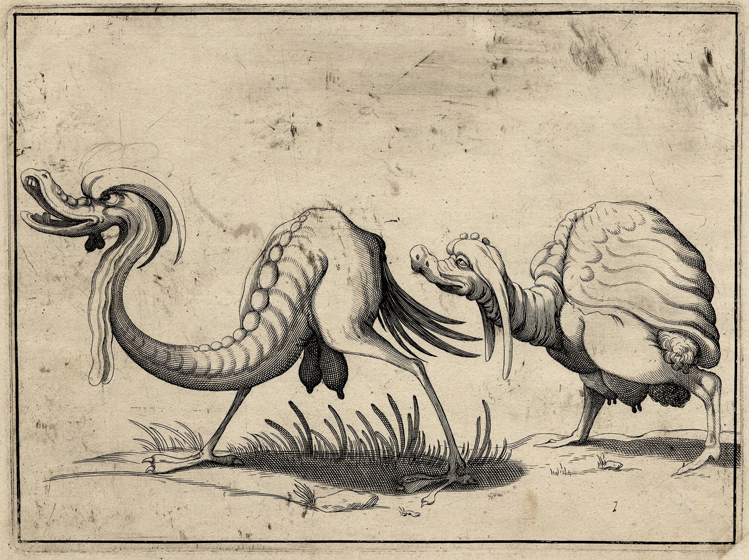 Arent van Bolten. Grotesque ornamental design with two monsters. Engraving, c. 1604-1616. British Museum
Arent van Bolten. Grotesque ornamental design with two monsters. Engraving, c. 1604-1616. British Museum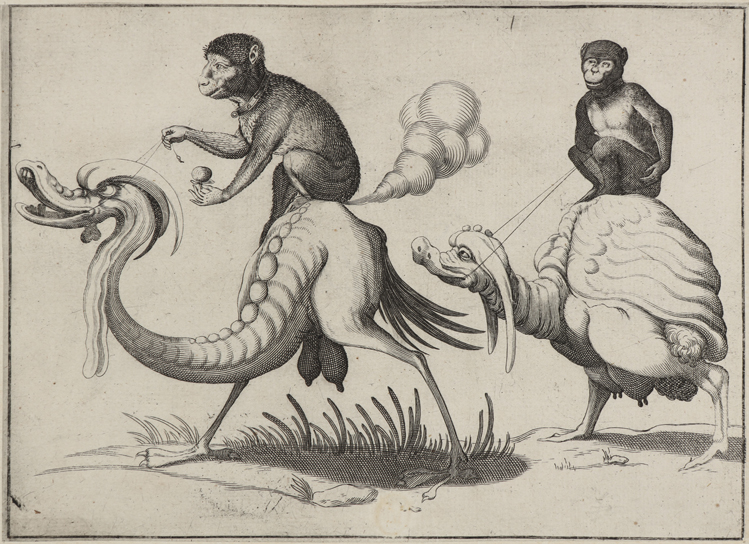 Anonymous after Arent van Bolten. Grotesque ornamental design with two monsters ridden by monkeys. Engraving, c. 1604-1616. Colección Mariano Moret
Anonymous after Arent van Bolten. Grotesque ornamental design with two monsters ridden by monkeys. Engraving, c. 1604-1616. Colección Mariano Moret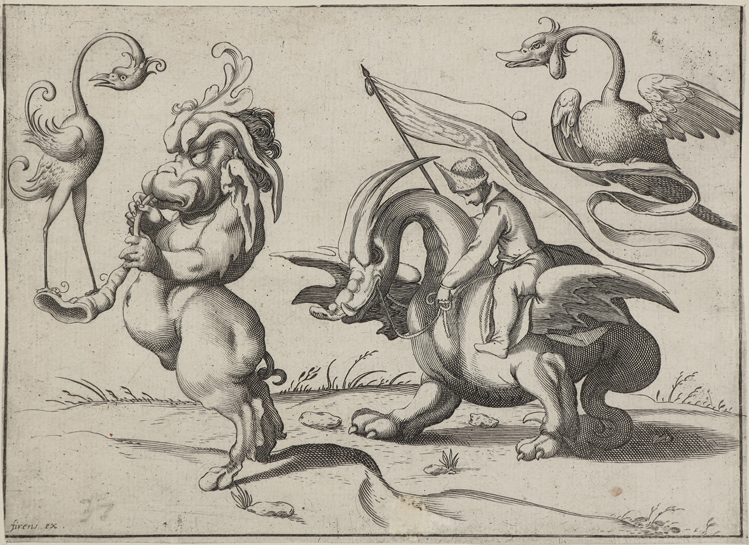 Anonymous after Arent van Bolten. Grotesque ornamental design with monstrous animals. Engraving, c. 1604-1616. Colección Mariano Moret
Anonymous after Arent van Bolten. Grotesque ornamental design with monstrous animals. Engraving, c. 1604-1616. Colección Mariano Moret
____________________________________________________________________________________
THEME & VARIATIONS: HOLDING PUTTI
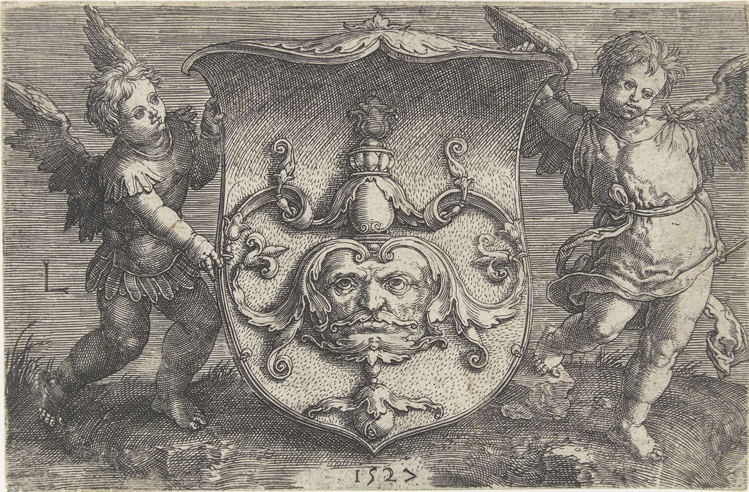
Lucas van Leyden. A mask on a shield held by two putti. Engraving, 1527. Rijksmuseum
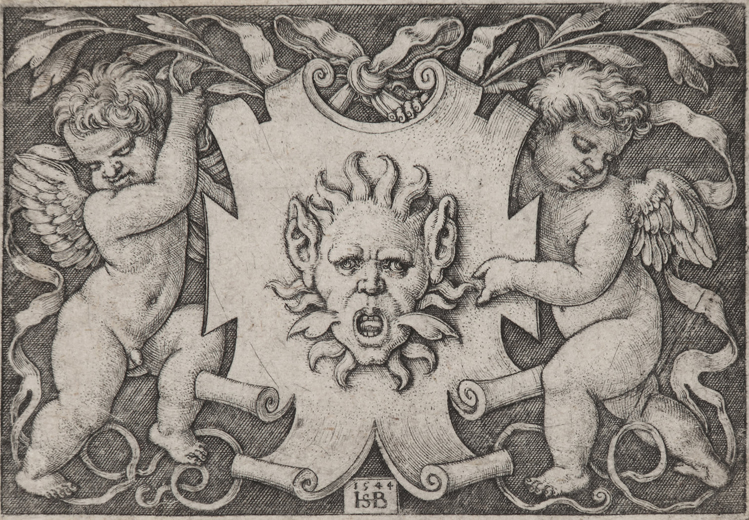 Sebald Beham. A mask on an escutcheon held by two putti. Engraving, 1544. Colección Mariano Moret
Sebald Beham. A mask on an escutcheon held by two putti. Engraving, 1544. Colección Mariano Moret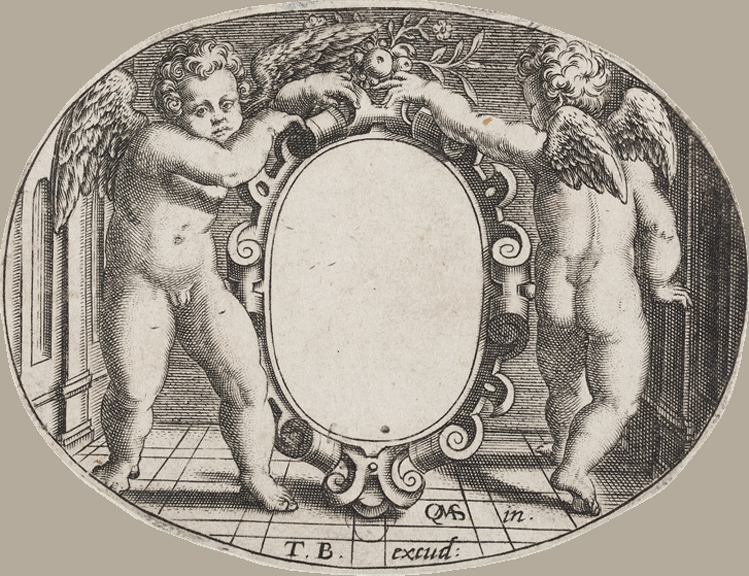 Theodor de Bry. Two puttii holding an escutcheon. Engraving, c. 1580-1598. Colección Mariano Moret
Theodor de Bry. Two puttii holding an escutcheon. Engraving, c. 1580-1598. Colección Mariano Moret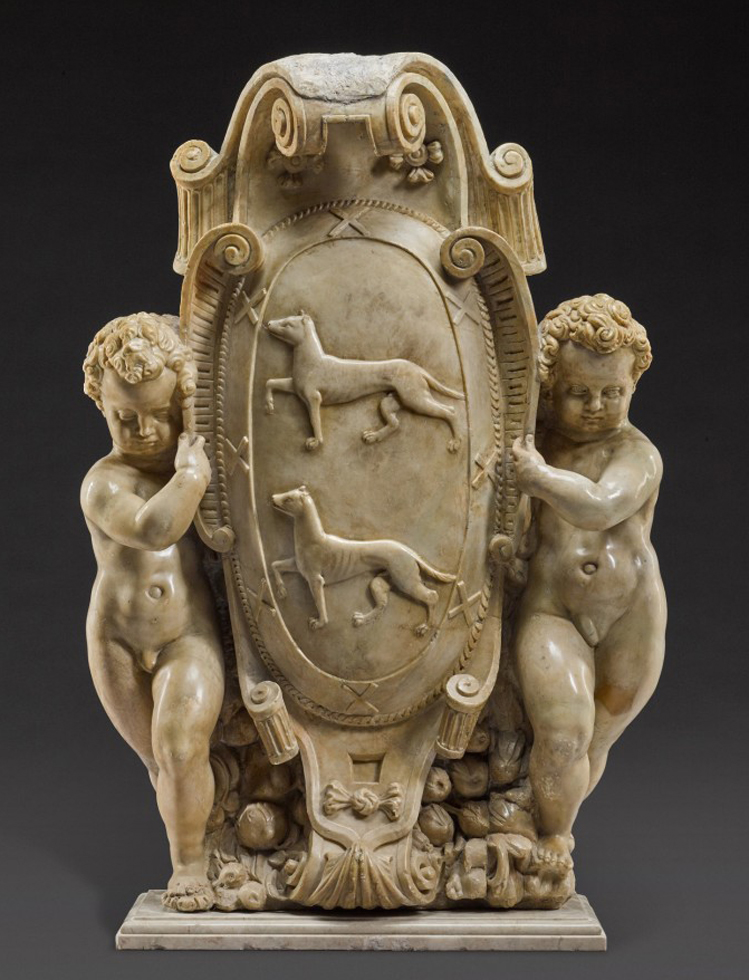
Spanish, Toledo (?), c. 1570-1590. Monumental escutcheon with the arms of the Ayala, flanked by putti. Sotheby's
___________________________________________________________________________________
THEME & VARIATIONS: EFFECTS OF WINE
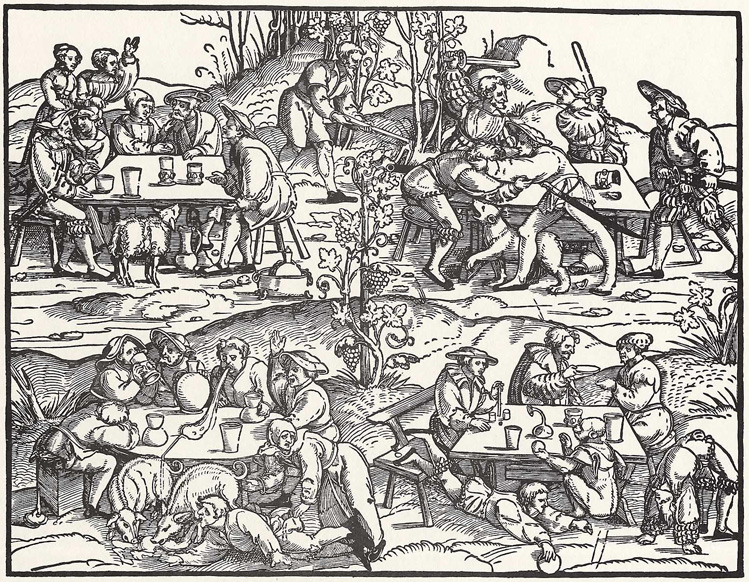
Erhard Schön. Vier Eigenschaften des Weines. Woodcut, 1528. Kunstsammlungen der Veste Coburg
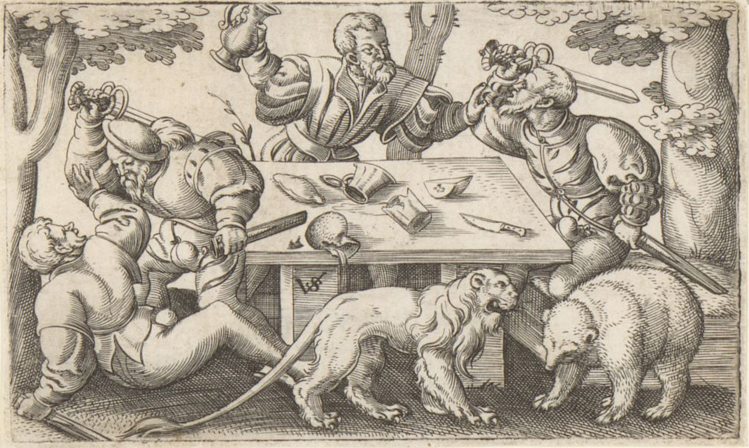 Virgil Solis. The drinkers' brawl. Engraving and etching, c. 1530-1562. Rijksmuseum
Virgil Solis. The drinkers' brawl. Engraving and etching, c. 1530-1562. Rijksmuseum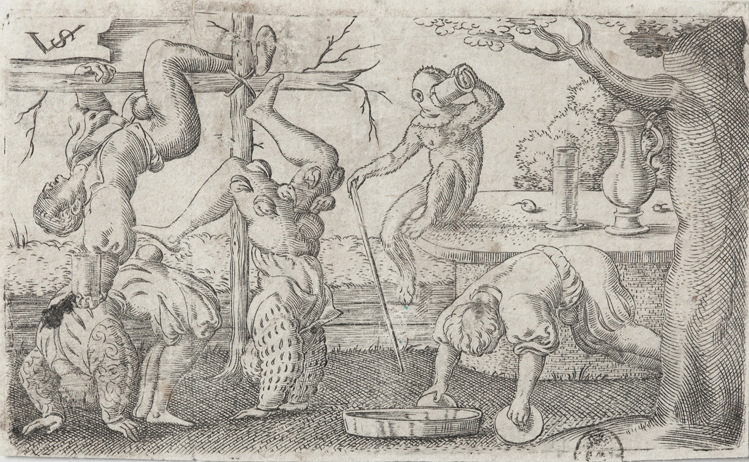 Virgil Solis. The acrobats. Engraving and etching, c. 1530-1562. Colección Mariano Moret
Virgil Solis. The acrobats. Engraving and etching, c. 1530-1562. Colección Mariano Moret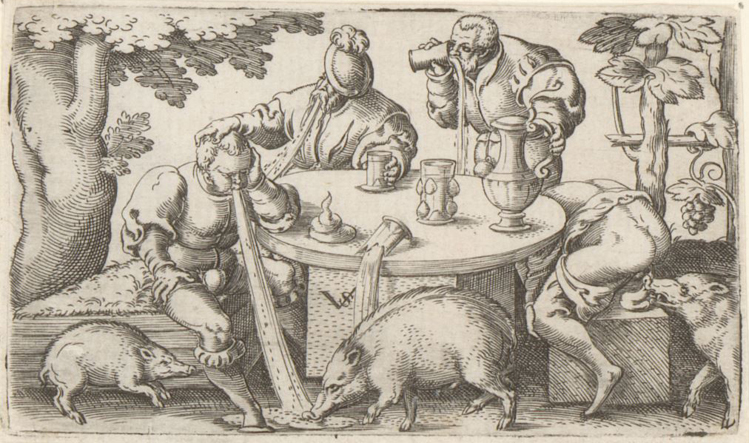 Virgil Solis. The drunkards and the pigs. Engraving and etching, c. 1530-1562. Rijksmuseum
Virgil Solis. The drunkards and the pigs. Engraving and etching, c. 1530-1562. Rijksmuseum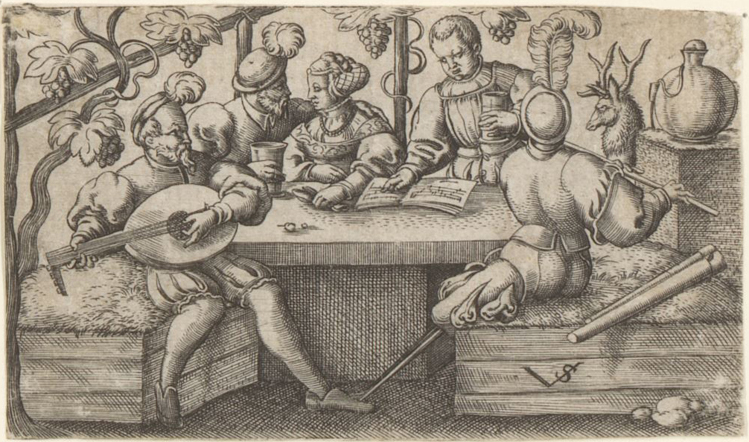 Virgil Solis. The musicians. Engraving and etching, c. 1530-1562. Rijksmuseum
Virgil Solis. The musicians. Engraving and etching, c. 1530-1562. Rijksmuseum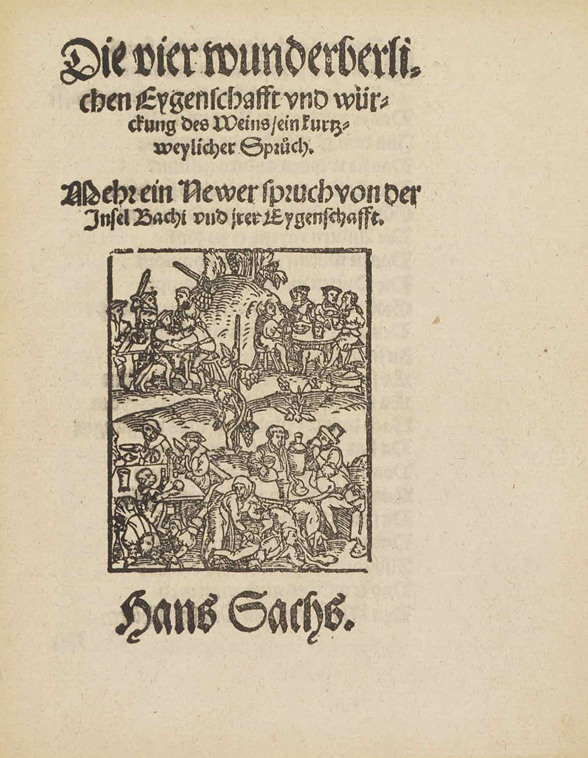 Sachs, Hans, Die vier wunderberlichen Eygenschafft vnd würckung des Weins, ein kürtzweylicher Spruoch, Nuremberg: Georg Merckel, 1553. Ketterer Kunst
Sachs, Hans, Die vier wunderberlichen Eygenschafft vnd würckung des Weins, ein kürtzweylicher Spruoch, Nuremberg: Georg Merckel, 1553. Ketterer Kunst____________________________________________________________________________________
THEME & VARIATIONS: GOLTZIUS' ST PETER
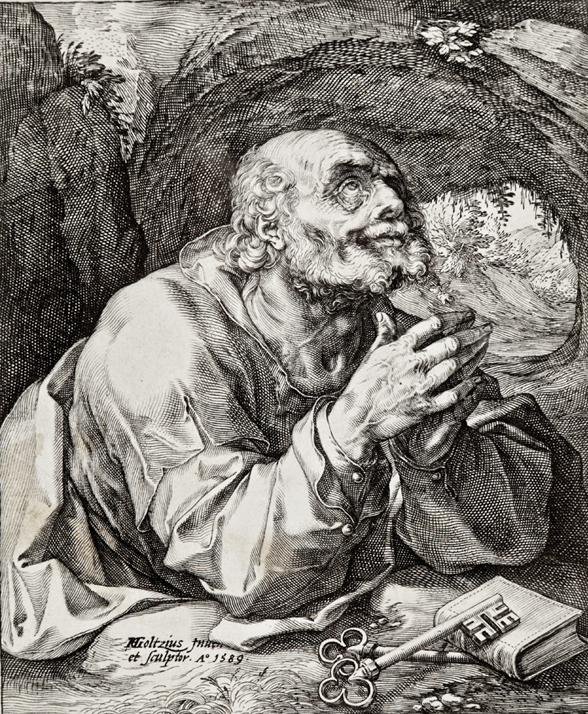 Hendrik Goltzius. St Peter. Engraving, 1589. Colección Mariano Moret
Hendrik Goltzius. St Peter. Engraving, 1589. Colección Mariano Moret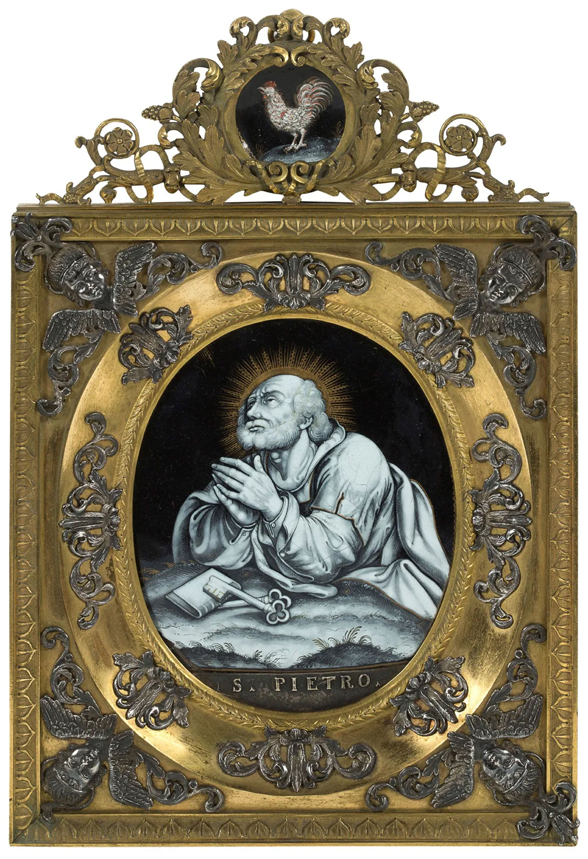 St Peter. Limoges grisaille enamel, 18th c. Aguttes
St Peter. Limoges grisaille enamel, 18th c. Aguttes____________________________________________________________________________________
THEME & VARIATIONS: STANGENGLASS
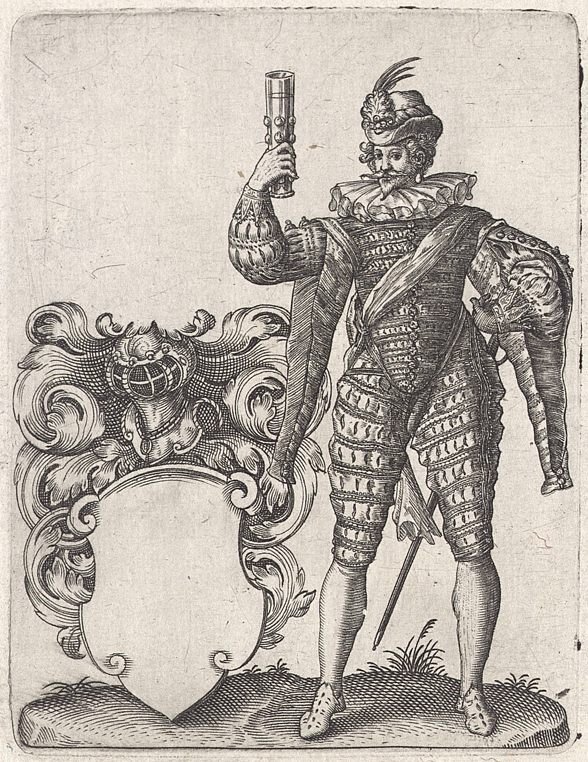 Theodor de Bry. A nobleman raising a Stangenglas besides a heraldic shield. Engraving, 1592. Colección Mariano Moret
Theodor de Bry. A nobleman raising a Stangenglas besides a heraldic shield. Engraving, 1592. Colección Mariano Moret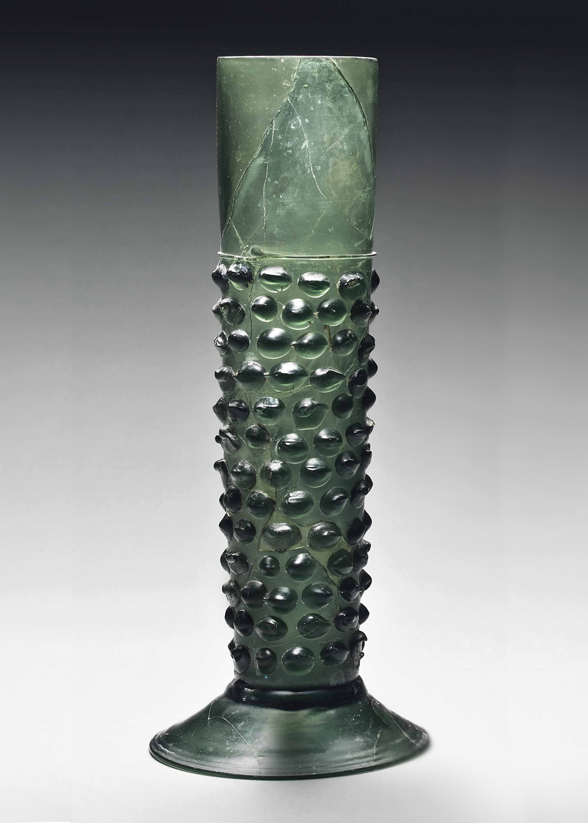 Waldglas Stangenglas. 16th century, Germany. Christie's
Waldglas Stangenglas. 16th century, Germany. Christie's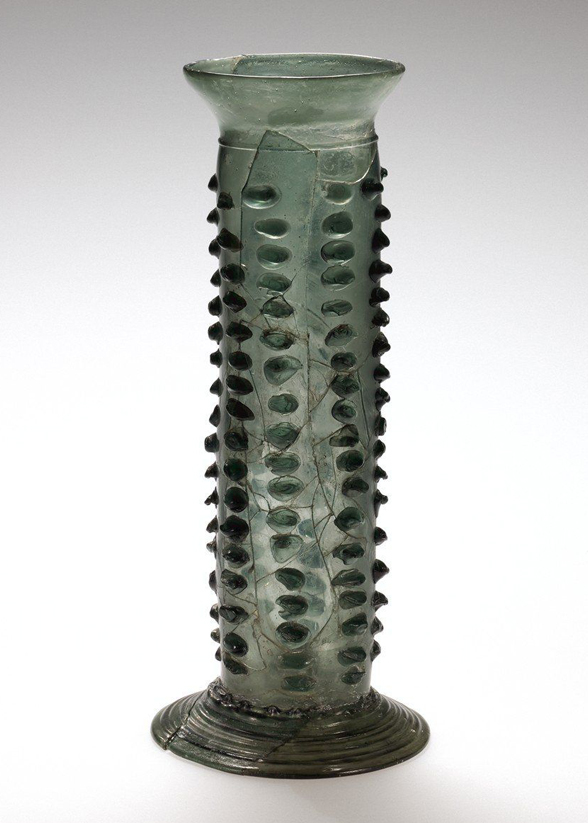 Stangenglas. 16th century, Germany. Corning Museum of Glass
Stangenglas. 16th century, Germany. Corning Museum of Glass____________________________________________________________________________________ç
THEME & VARIATIONS: DIDO'S TEARS
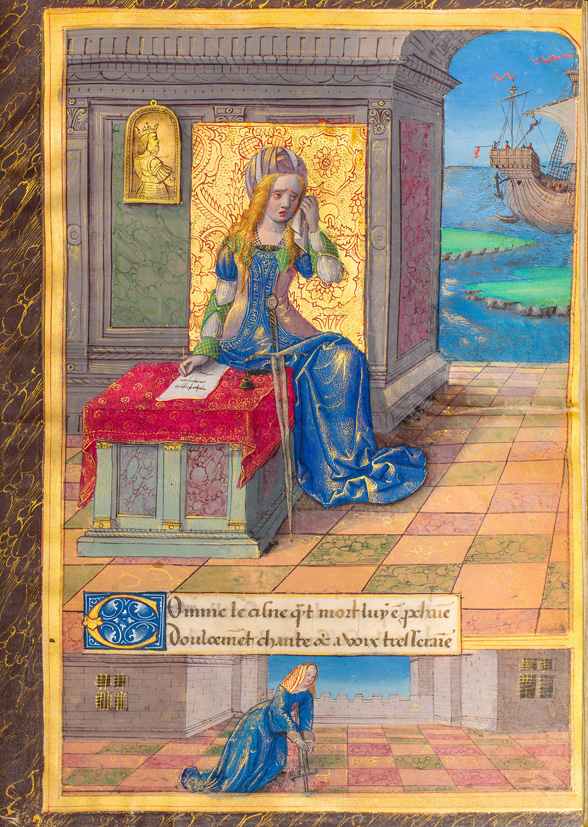 Master of the Chronique scandaleuse. Dido. Illumination in the 'Epistres d'Ovide' for Queen Anne de Bretagne. Paris, c. 1493. J. Paul Getty Museum
Master of the Chronique scandaleuse. Dido. Illumination in the 'Epistres d'Ovide' for Queen Anne de Bretagne. Paris, c. 1493. J. Paul Getty Museum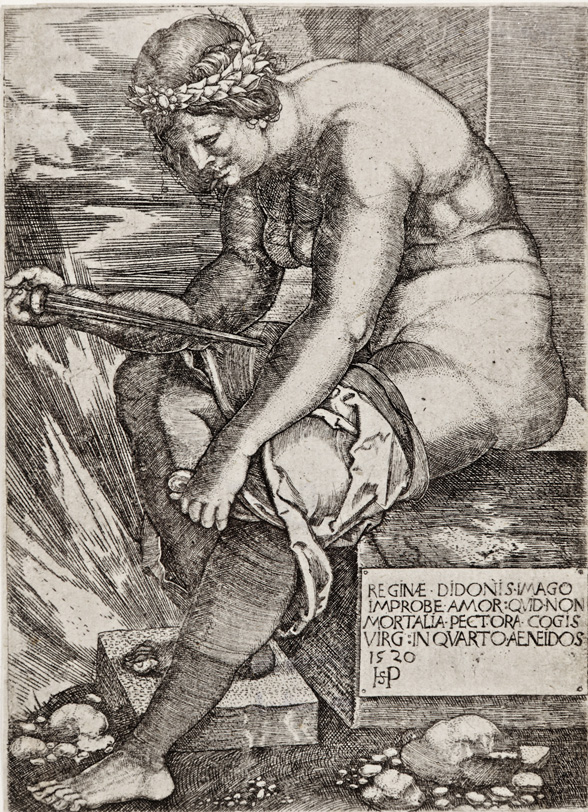 Sebald Beham. Dido. Engraving, 1520. Colección Mariano Moret
Sebald Beham. Dido. Engraving, 1520. Colección Mariano Moret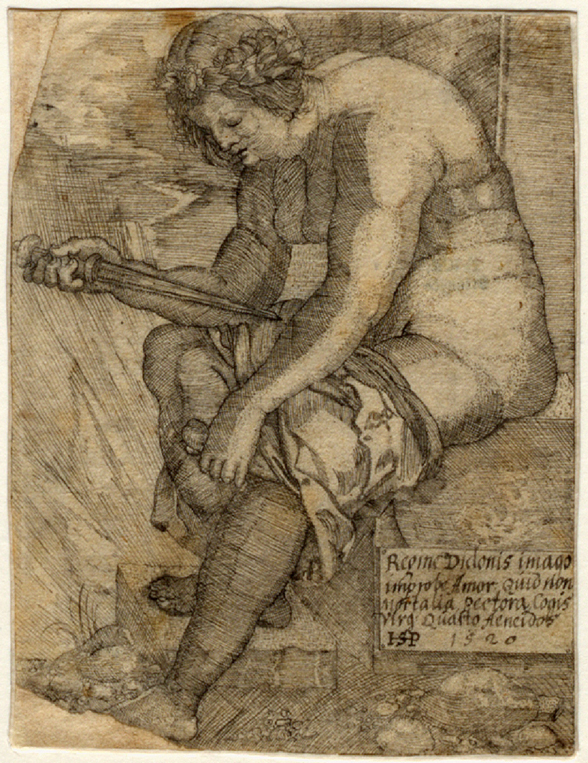
After Sebald Beham. Dido. Pen and black ink, c. 1525-1550. Friedrich-Alexander-Universität Erlangen-Nürnberg, Graphische Sammlung
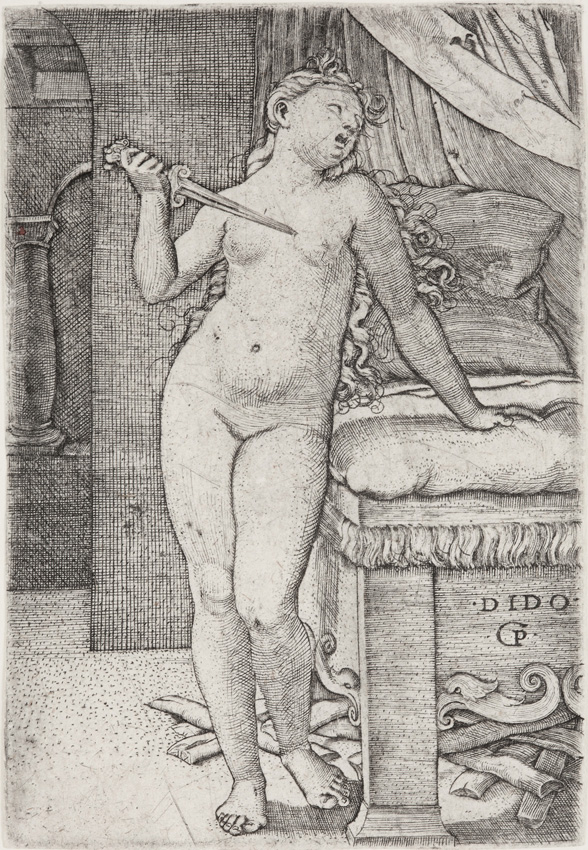 Attributed to Georg Pencz. The death of Dido. Engraving, c. 1530. Colección Mariano Moret
Attributed to Georg Pencz. The death of Dido. Engraving, c. 1530. Colección Mariano Moret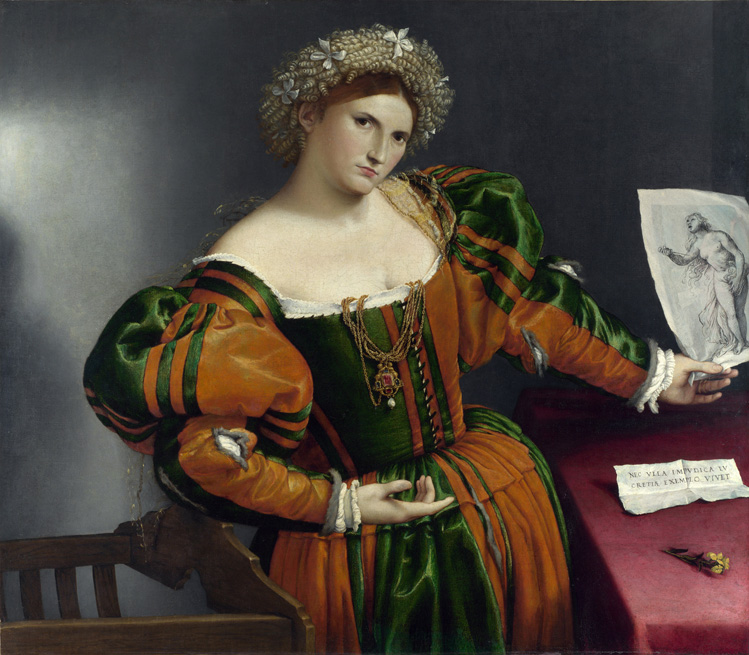 Lorenzo Lotto. Portrait of a Woman inspired by Lucretia. Oil on canvas, c. 1530-1533. The National Gallery
Lorenzo Lotto. Portrait of a Woman inspired by Lucretia. Oil on canvas, c. 1530-1533. The National Gallery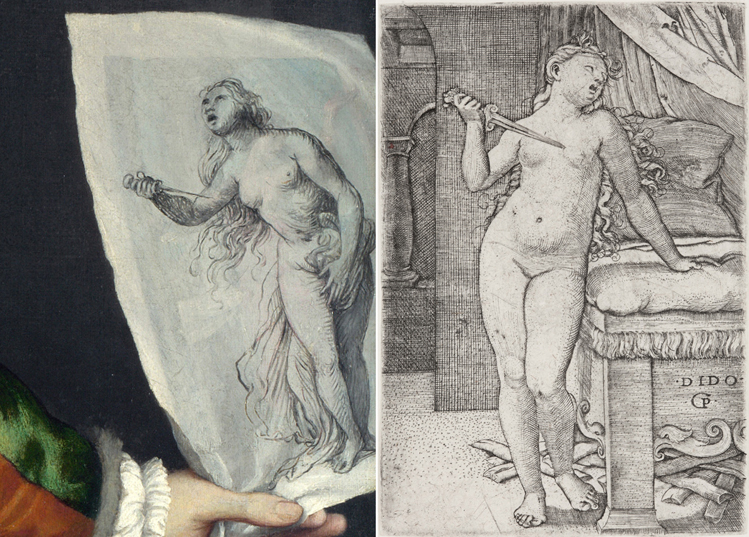
____________________________________________________________________________________
THEME & VARIATIONS: THE HELLMOUTH
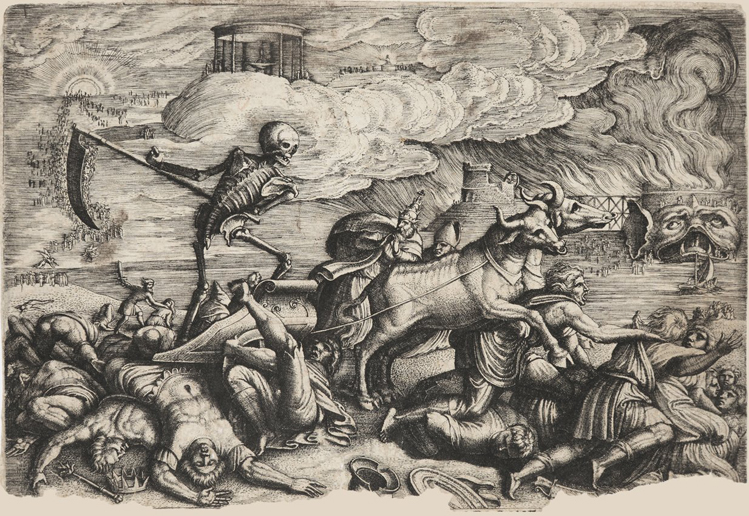 Georg Pencz. The Triumph of Death. Engraving, c. 1539. Colección Mariano Moret
Georg Pencz. The Triumph of Death. Engraving, c. 1539. Colección Mariano Moret 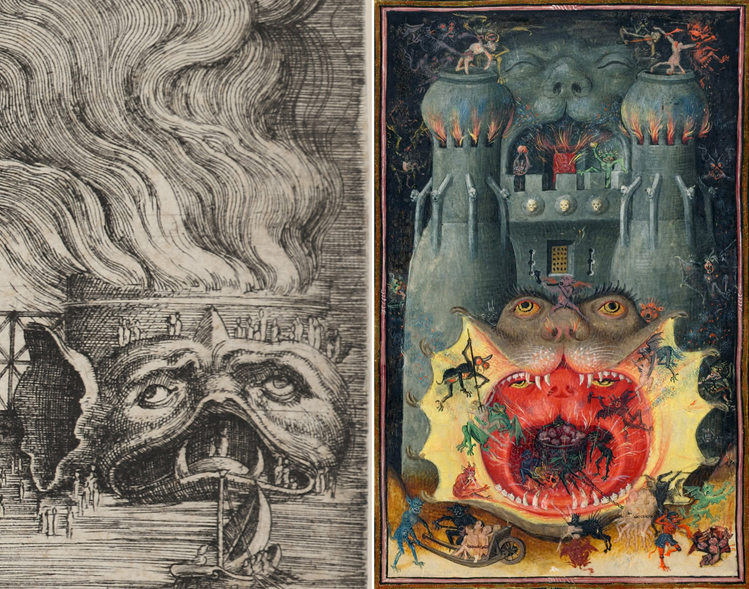 Georg Pencz. The Triumph of Death (detail). Engraving, c. 1539. Colección Mariano Moret Master of Catherine of Cleves. Mouth of Hell. The Hours of Catherine of Cleves. Tempera colors on parchment, c. 1440. Ms. M.945, fol.168V. The Morgan Library & Museum
Georg Pencz. The Triumph of Death (detail). Engraving, c. 1539. Colección Mariano Moret Master of Catherine of Cleves. Mouth of Hell. The Hours of Catherine of Cleves. Tempera colors on parchment, c. 1440. Ms. M.945, fol.168V. The Morgan Library & Museum 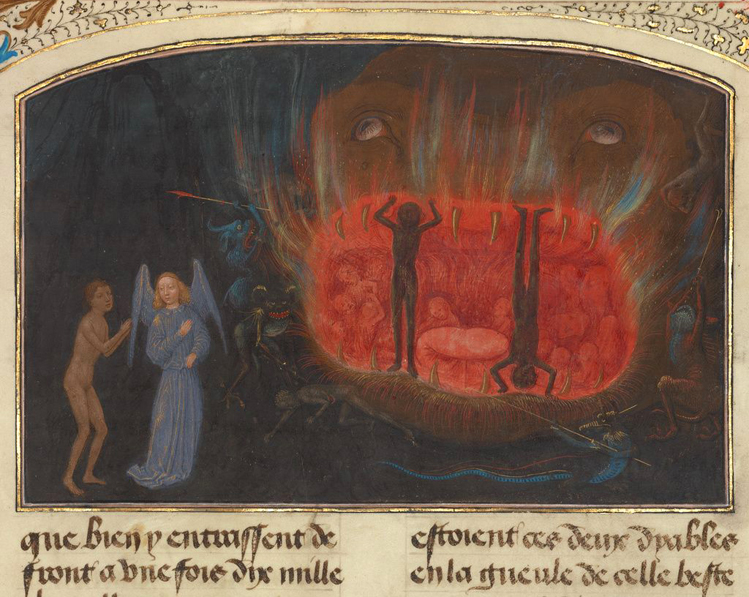 Simon Marmion. The Beast Acheron. Les visions du chevalier Tondal. Tempera colors on parchment, 1475. Ms. 30 (87.MN.141.17), fol. 17. The J. Paul Getty Museum
Simon Marmion. The Beast Acheron. Les visions du chevalier Tondal. Tempera colors on parchment, 1475. Ms. 30 (87.MN.141.17), fol. 17. The J. Paul Getty Museum 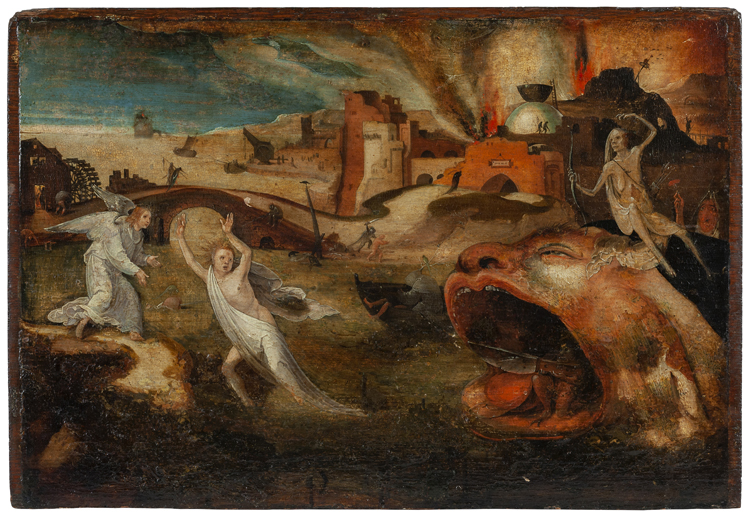 Flemish School early 16th c. Allegorical scene. Oil on board. Aste Boetto
Flemish School early 16th c. Allegorical scene. Oil on board. Aste Boetto ____________________________________________________________________________________
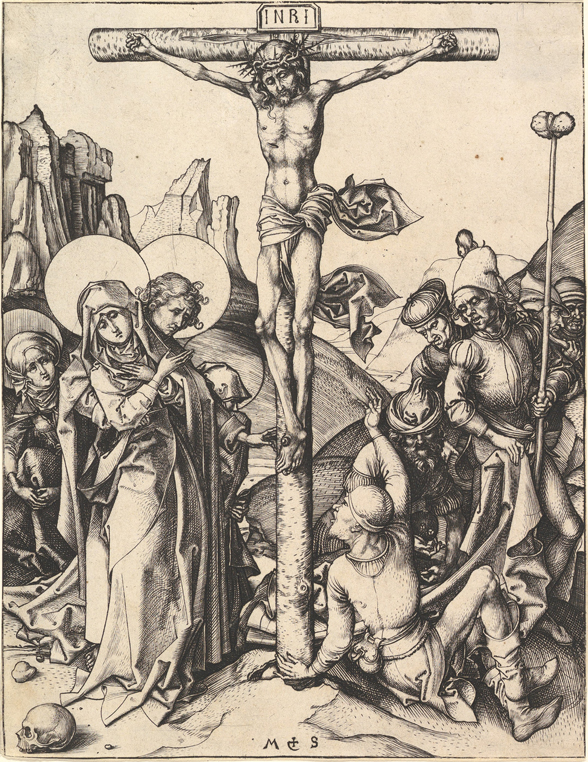 Martin Schongauer. Crucifixion. Engraving, c. 1435–1491. The Met.
Martin Schongauer. Crucifixion. Engraving, c. 1435–1491. The Met. 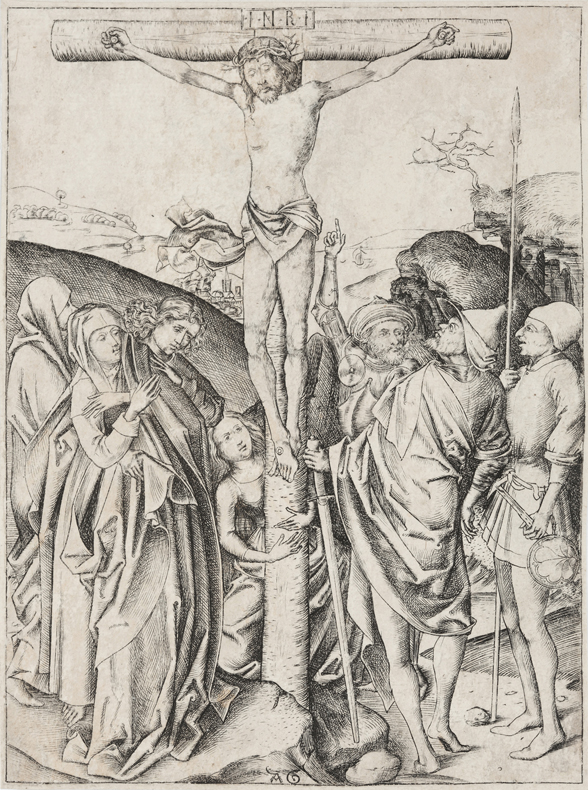 Monogrammist AG. Crucifixion. Engraving, c. 1460. Colección Mariano Moret
Monogrammist AG. Crucifixion. Engraving, c. 1460. Colección Mariano Moret 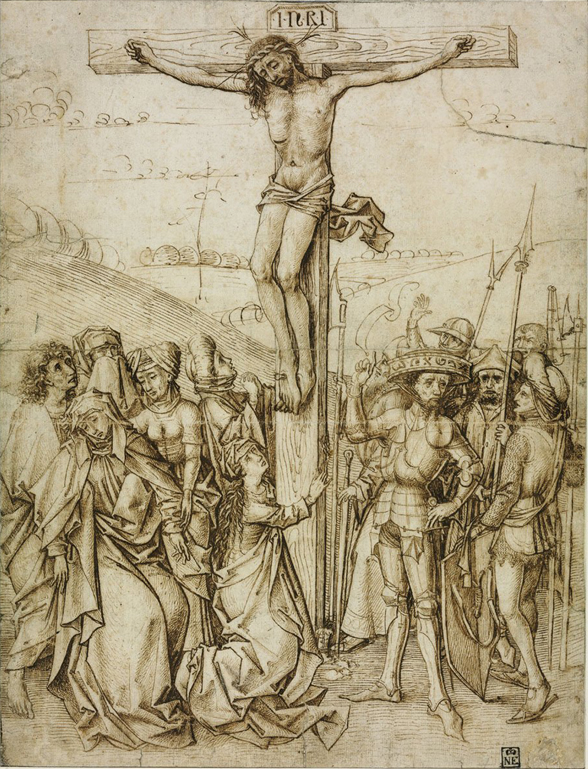 Hans Pleydenwurff. Crucifixion. Pen and brown ink, c. 1460. Szépművészeti Múzeum
Hans Pleydenwurff. Crucifixion. Pen and brown ink, c. 1460. Szépművészeti Múzeum 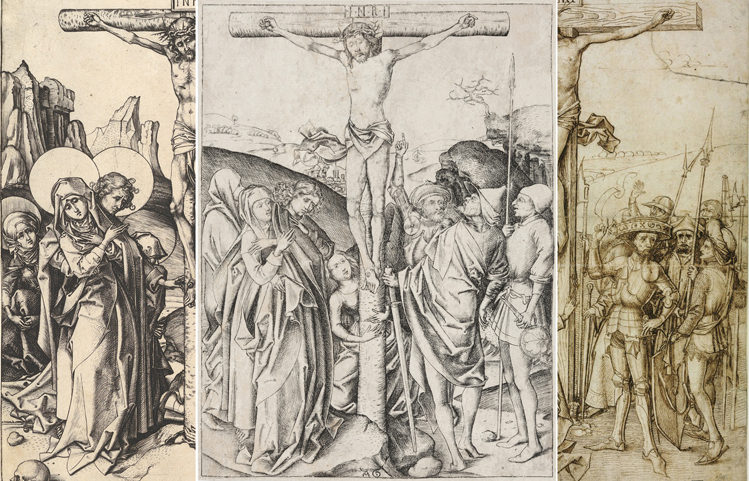
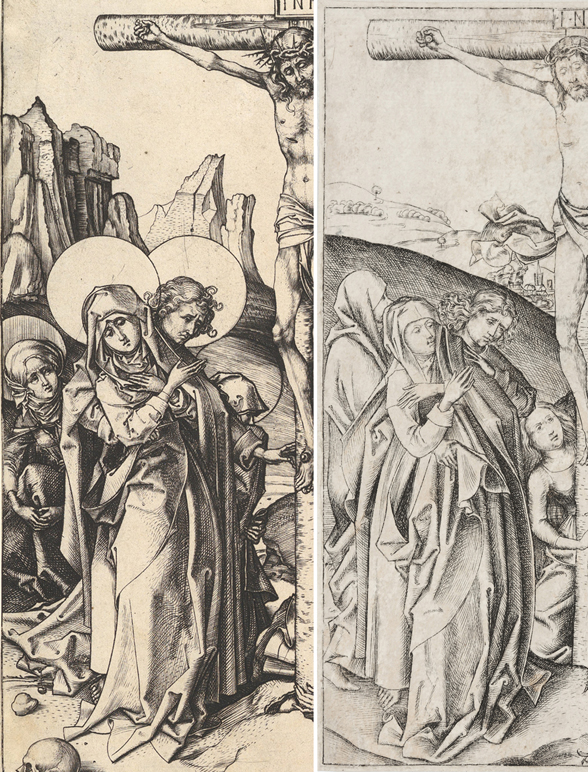
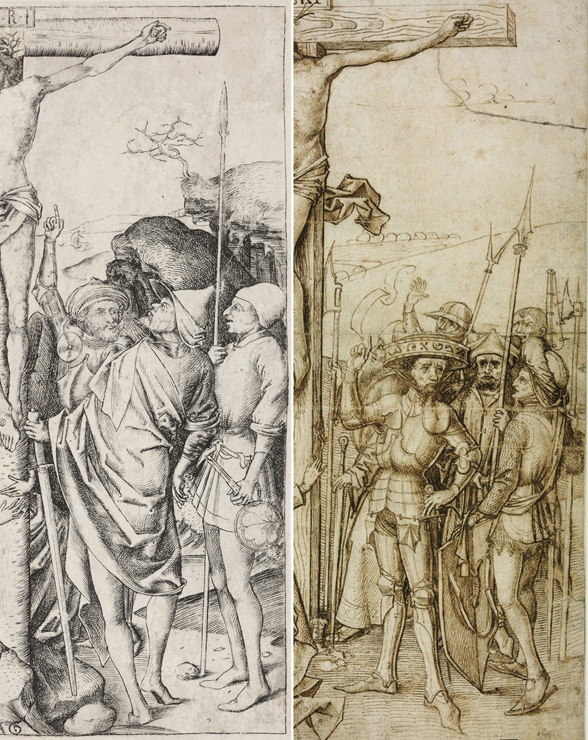
________________________________________________________________________________________________________________
THEME & VARIATIONS: THE CIRCULAR CRUCIFIXION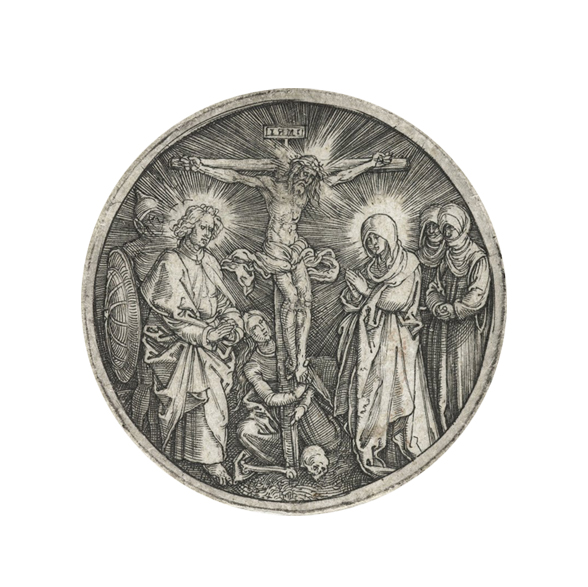 Albrecht Dürer. The Small Crucifixion. Engraving, c. 1517-1521. Rijksmuseum
Albrecht Dürer. The Small Crucifixion. Engraving, c. 1517-1521. Rijksmuseum 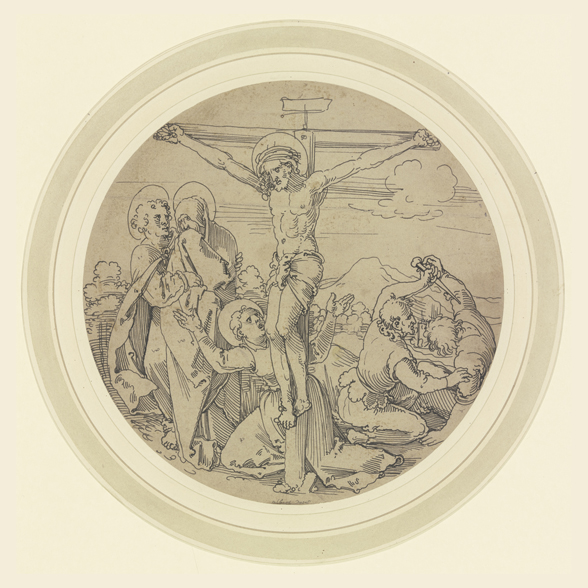 Sebald Beham. Crucifixion of Christ. Pen and black ink, c. 1518-1550. Städel Museum
Sebald Beham. Crucifixion of Christ. Pen and black ink, c. 1518-1550. Städel Museum 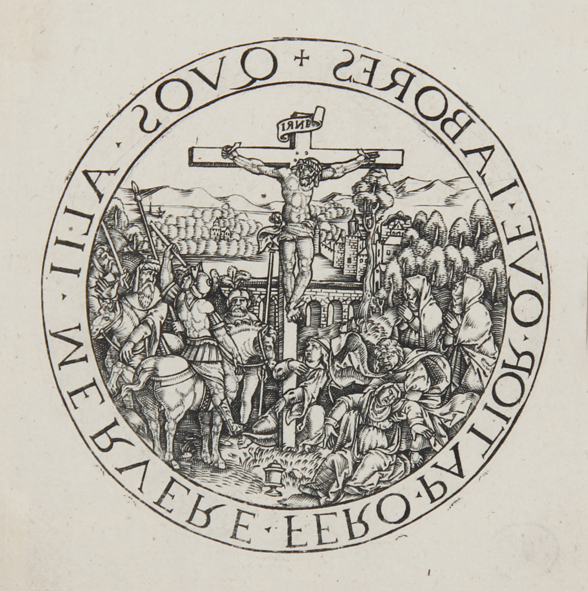 Anonymous German Artist (Attributed to a follower of Sebald Beham). Crucifixion with the three Marys on the right. Engraving, c. 1520-1550. Colección Mariano Moret
Anonymous German Artist (Attributed to a follower of Sebald Beham). Crucifixion with the three Marys on the right. Engraving, c. 1520-1550. Colección Mariano Moret
________________________________________________________________________________________________________________
THEME & VARIATIONS: HANS LEINBERGER AND MONOGRAMMIST HL
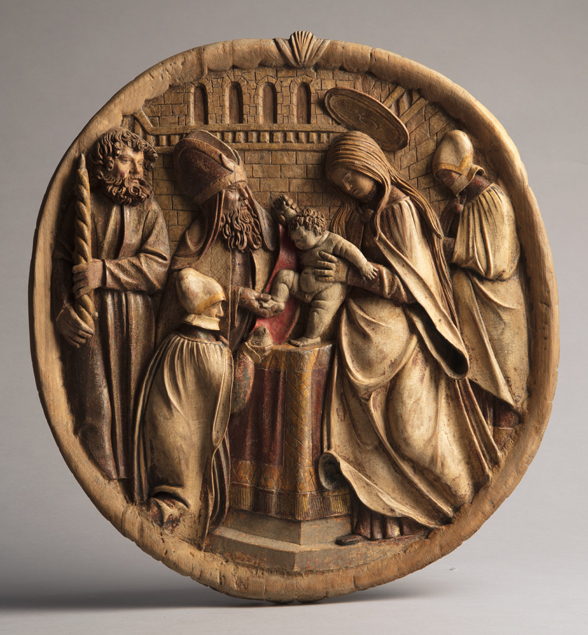 Hans Leinberger. The Presentation in the Temple. Limewood, c. 1516-1518. Sam Fogg
Hans Leinberger. The Presentation in the Temple. Limewood, c. 1516-1518. Sam Fogg 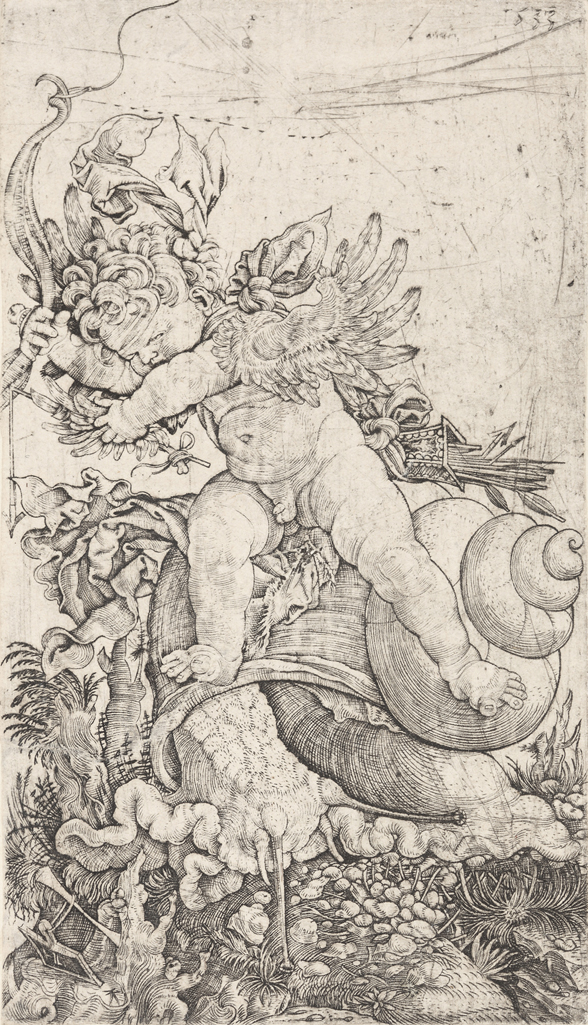 Monogrammist HL (Hans Leinberger?). Cupid riding a snail. Engraving, 1533. Colección Mariano Moret
Monogrammist HL (Hans Leinberger?). Cupid riding a snail. Engraving, 1533. Colección Mariano Moret 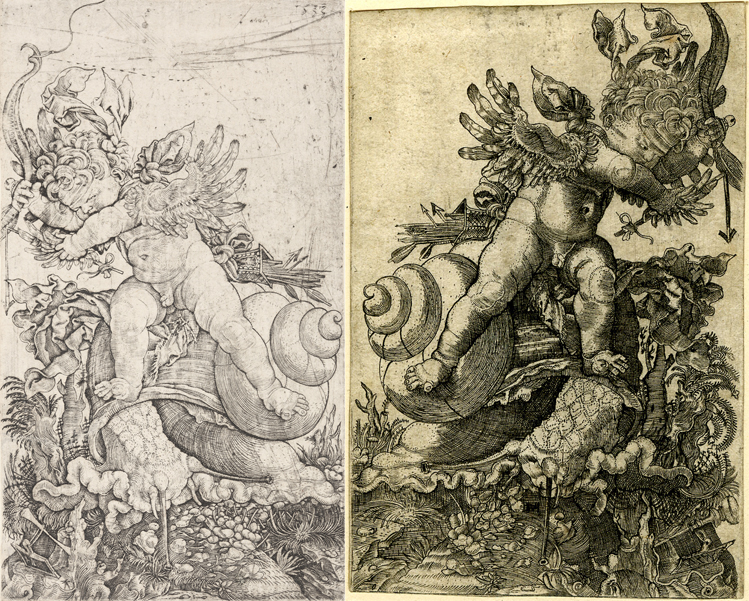 Monogrammist HL (Hans Leinberger?). Cupid riding a snail. Engraving, 1533. Colección Mariano Moret After Monogrammist HL. Cupid riding a snail. Engraving, c. 1533. British Museum
Monogrammist HL (Hans Leinberger?). Cupid riding a snail. Engraving, 1533. Colección Mariano Moret After Monogrammist HL. Cupid riding a snail. Engraving, c. 1533. British Museum 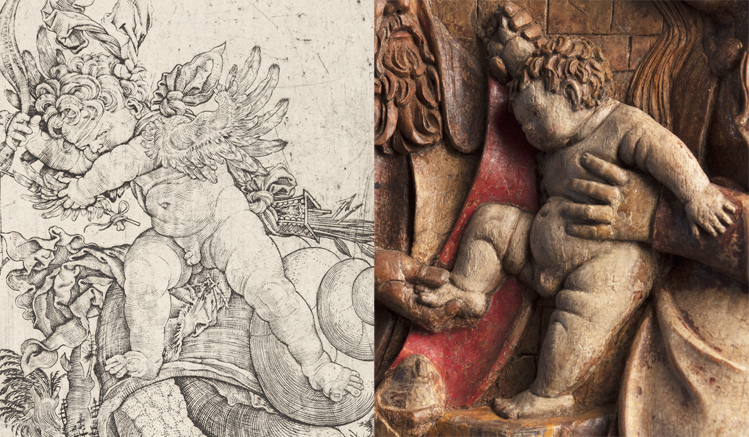 Monogrammist HL (Hans Leinberger?). Cupid riding a snail (detail). Engraving, 1533. Colección Mariano Moret Hans Leinberger. The Presentation in the Temple (detail). Limewood, c. 1516-1518. Sam Fogg
Monogrammist HL (Hans Leinberger?). Cupid riding a snail (detail). Engraving, 1533. Colección Mariano Moret Hans Leinberger. The Presentation in the Temple (detail). Limewood, c. 1516-1518. Sam Fogg
________________________________________________________________________________________________________________
THEME & VARIATIONS: THE FLIGHT
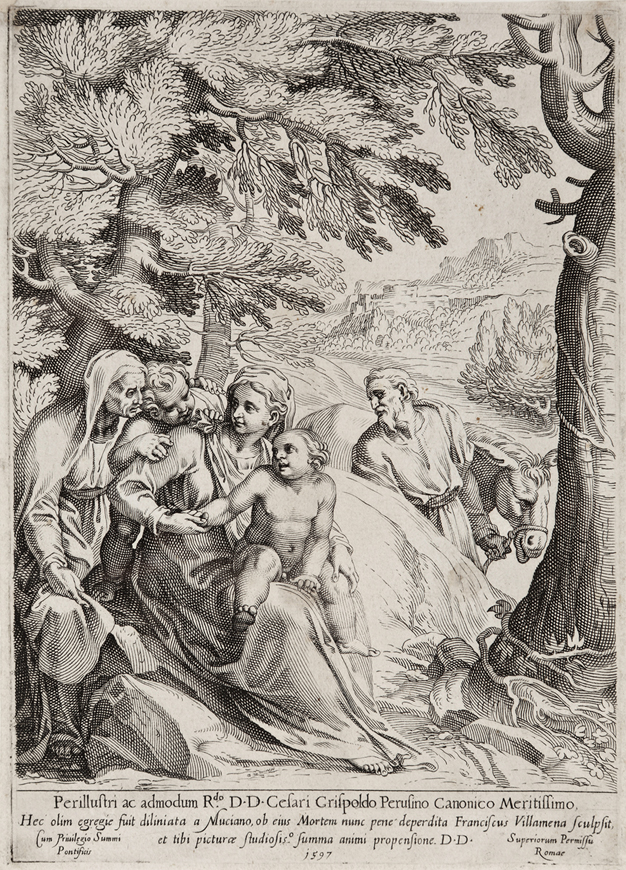 Francesco Villamena. The rest on the flight into Egypt. Engraving, 1597. Colección Mariano Moret
Francesco Villamena. The rest on the flight into Egypt. Engraving, 1597. Colección Mariano Moret 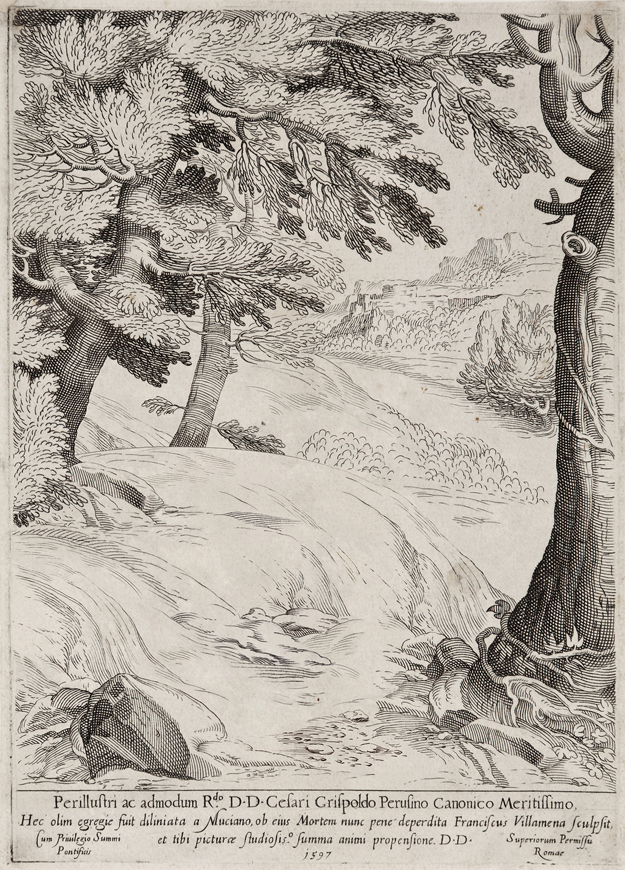 David Bokeh. Flight from the flight into Egypt. Digital art, 2021. ©David Bokeh/Colección Mariano Moret
David Bokeh. Flight from the flight into Egypt. Digital art, 2021. ©David Bokeh/Colección Mariano Moret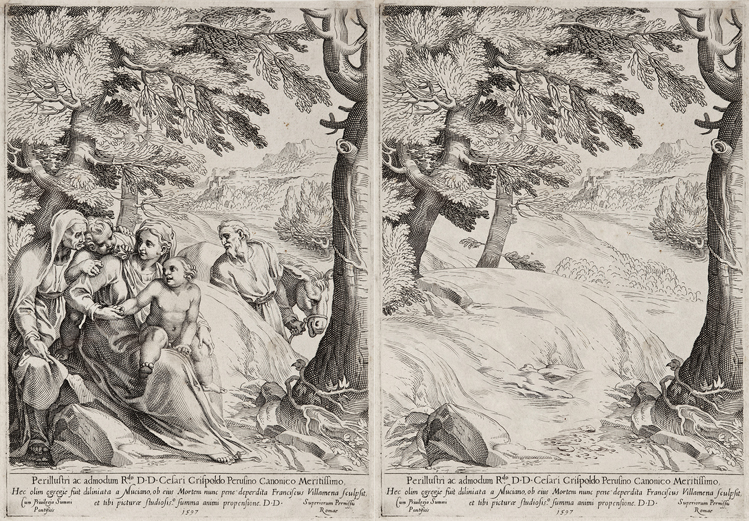
_______________________________________________________________________________________________________________
THEME & VARIATIONS: EVERYTHING IS IN THE BOOKS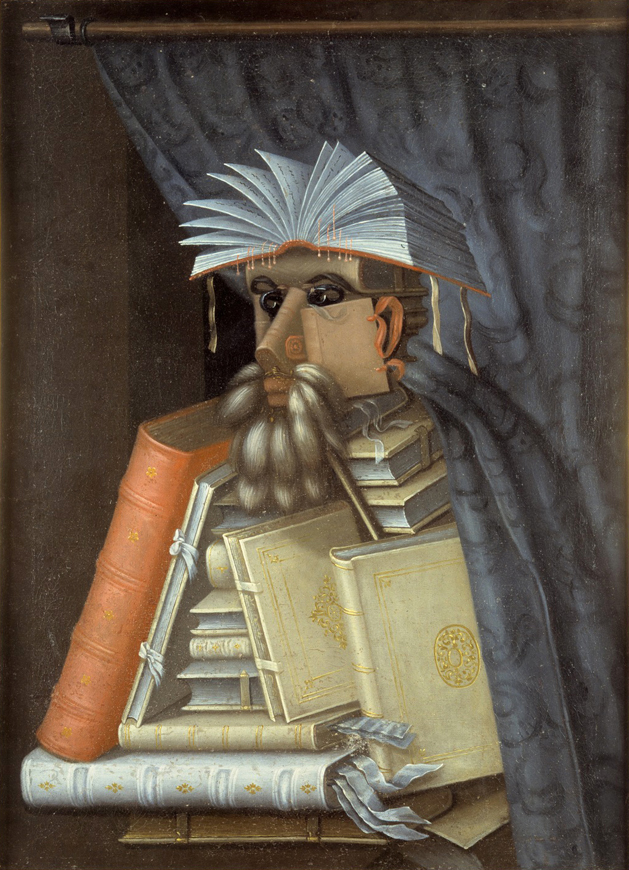 Giuseppe Arcimboldo. The Librarian. Oil on canvas, c. 1566. Skokloster Slott
Giuseppe Arcimboldo. The Librarian. Oil on canvas, c. 1566. Skokloster Slott 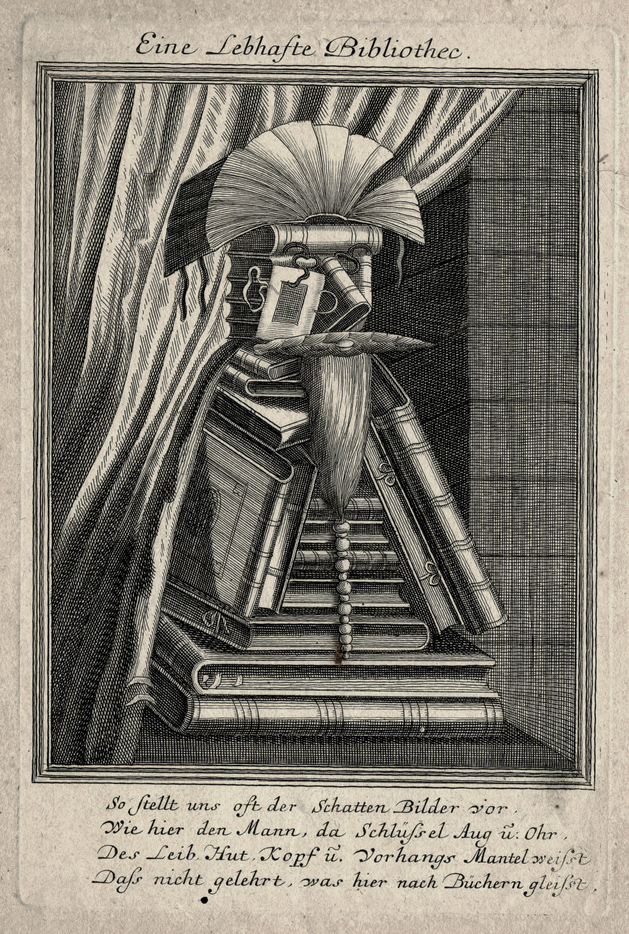 Manner of Giuseppe Arcimboldo. The Librarian (Eine Lebhafte Bibliothek). Etching, c. 1700-1750. British Museum
Manner of Giuseppe Arcimboldo. The Librarian (Eine Lebhafte Bibliothek). Etching, c. 1700-1750. British Museum 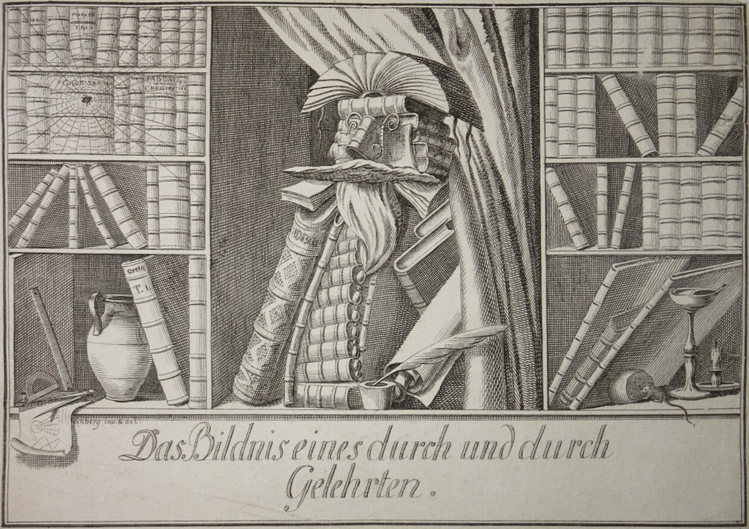 Carl C. Glassbach. The Librarian (Das Bildnis eines durch und durch Gelehrten). Etching, c. 1775. Colección Mariano Moret
Carl C. Glassbach. The Librarian (Das Bildnis eines durch und durch Gelehrten). Etching, c. 1775. Colección Mariano Moret
_______________________________________________________________________________________________________________
THEME & VARIATIONS: CHRIST CROWNED WITH THORNS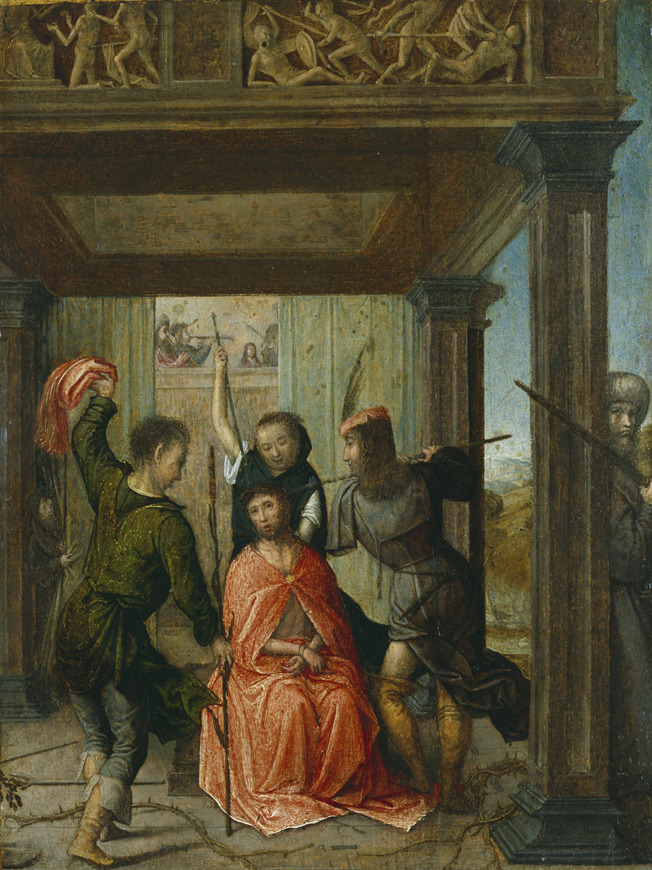 Juan de Flandes. Christ Crowned with Thorns. Oil on oak panel, c. 1505. Detroit Institute of Arts
Juan de Flandes. Christ Crowned with Thorns. Oil on oak panel, c. 1505. Detroit Institute of Arts 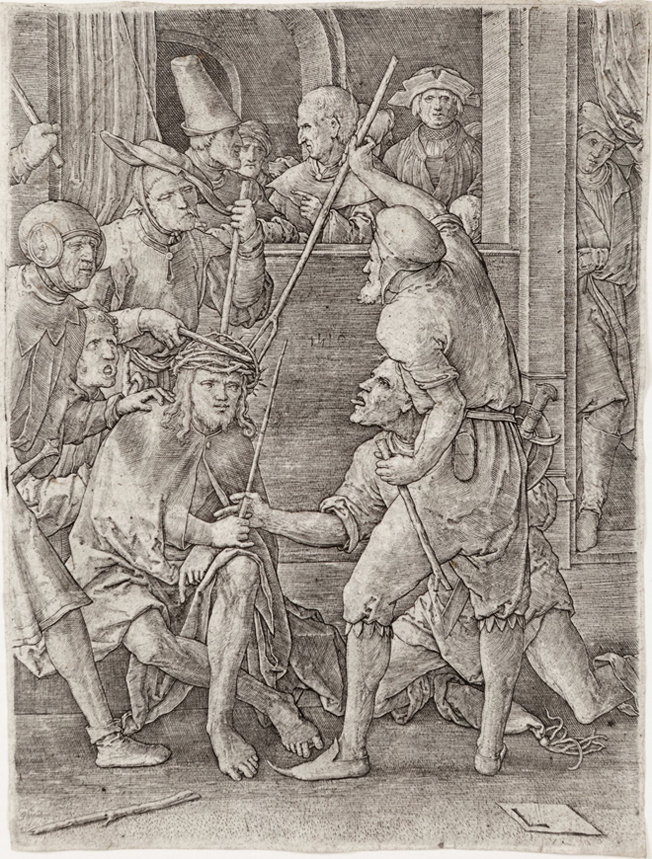 Lucas van Leyden. Christ Crowned with Thorns. Engraving, 1519. Colección Mariano Moret.
Lucas van Leyden. Christ Crowned with Thorns. Engraving, 1519. Colección Mariano Moret. 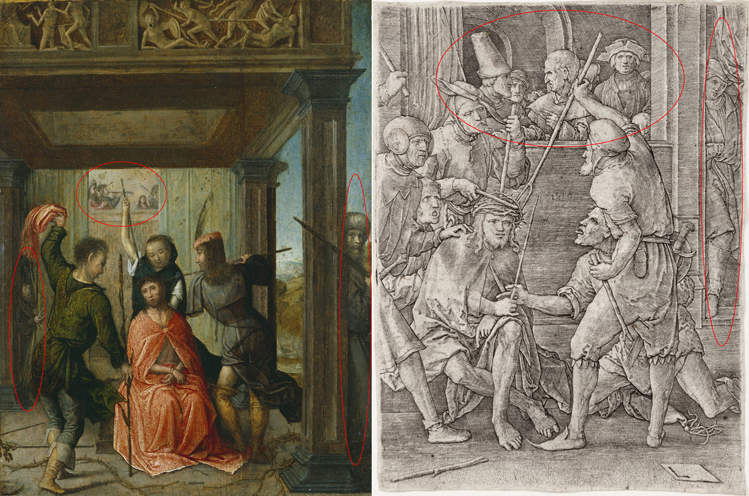
_______________________________________________________________________________________________________________
THEME & VARIATIONS: CROSSBOWMAN VERSUS ARCHER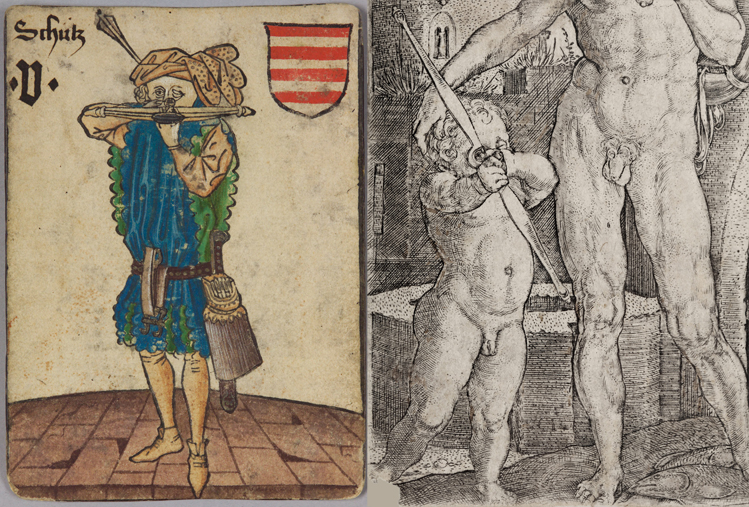 Anonymous. The Hungarian crossbowman card (5) in the Ambraser Hofämterspiel. Hand-coloured woodcut heightened with gold and silver, c. 1455. Kunsthistorisches Museum Wien, Kunstkammer Heinrich Aldegrever. Jupiter (detail). Engraving, 1533. Colección Mariano Moret
Anonymous. The Hungarian crossbowman card (5) in the Ambraser Hofämterspiel. Hand-coloured woodcut heightened with gold and silver, c. 1455. Kunsthistorisches Museum Wien, Kunstkammer Heinrich Aldegrever. Jupiter (detail). Engraving, 1533. Colección Mariano Moret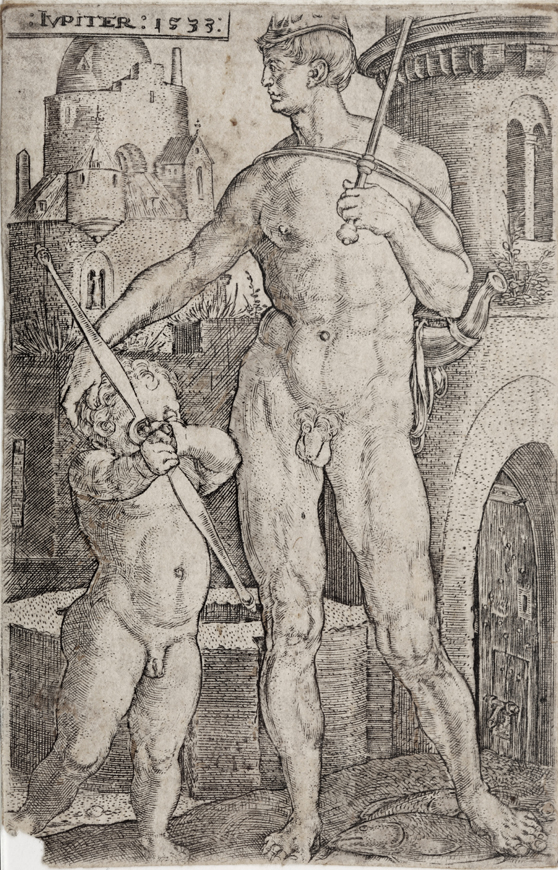 Heinrich Aldegrever. Júpiter. Engraving, 1533. Colección Mariano Moret
Heinrich Aldegrever. Júpiter. Engraving, 1533. Colección Mariano Moret____________________________________________________________________________________
RECENT ACQUISITIONS 2018/2020
130 Old Master prints swelled the Mariano Moret Collection between 2018 and 2020:
Aldegrever, Heinrich. Grotesque ornament panel with a mask and two tritons and putti Aldegrever, Heinrich. Samson and Delilah Aldegrever, Heinrich. Hannibal fighting Scipio Aldegrever, Heinrich. Pyramus and Thisbe Aldegrever, Heinrich. Ornamental design with foliage Aldegrever. Heinrich. Grotesque ornament panel with two putti Aldegrever. Heinrich. Upright ornament panel with tendrils rising from a cuirass Amman, Jost. Aurifabra Androuet Du Cerceau, Paul. Nouveau Livre d'Ornemens d'Orfevrerie. Plate 2 Androuet Du Cerceau, Paul. Nouveau Livre d'Ornemens d'Orfevrerie. Plate 3 Androuet Du Cerceau, Paul. Nouveau Livre d'Ornemens d'Orfevrerie. Plate 4 Anonymous Italian engraver after Lorenzo Sabatini. Judith with the head of Holofernes Anonymous Italian engraver after Domenichino. Judith with the head of Holofernes Bartoli, Pietro Santi. A nymph rides an ichthyocentaur, who fights against a Triton Beham, Sebald. Triton and Nereid Beham, Sebald. The triumph of the infant Bacchus Beham, Sebald. The Prodigal Son wasting his fortune Beham, Sebald. The marriage at Cana Beham, Sebald. A couple of fools Beham, Sebald. Three soldiers and a dog Beham, Sebald. A peasant at market Beham, Sebald. A peasant woman at market de Bisschop, Jan. Elder Son of Laocoon de Bisschop, Jan. Marsyas de Bisschop, Jan. The Farnese Hercules, facing left de Bisschop, Jan. An executioner seen from behind de Bisschop, Jan. Study for an Angel on the wing de Bisschop, Jan. Two male nudes laying on their backs Boel, Quirin. Singerie with two monkeys holding a globus cruciger van Bolten, Arent. Grotesque ornamental design with two monsters ridden by monkeys van Bolten, Arent. Grotesque ornamental design with monstrous animals Bourguet, Jean. Alphabet on black and stippled backgrounds Bourguet, Jean. Jewellery motifs with acanthus de Bry, Theodor. Emblemata Nobilitati (A pikeman and a squire with a blazon left blank) de Bry, Theodor. A pikeman besides an empty banderole and heraldic shield de Bry, Johann Theodor. Emblemata Saecularia (A crown and sceptre supported by a rabbit and dog) de Bry, Johann Theodor. Six dancing and courting couples de Bry, Johann Theodor. Frieze with sea monsters de Bry, Johann Theodor. Out of sight, out of mind de Bry, Johann Theodor. Emblemata Nobilitati (Soldiers fighting with weapons de Bry, Theodor and de Bry, Johann Theodor. Emblemata Nobilitati (An anvil with feathers and hammers) de Bry, Theodor and de Bry, Johann Theodor. Emblemata Nobilitati (The Death of Cleopatra) de Bry, Theodor and de Bry, Johann Theodor. Emblemata Nobilitati (Bees swarm around helmet) Domenichi, Cesare. An ornamental design for goldsmiths with Green Man and foliate scrolls Caletti, Giuseppe. Executioner holding up the head of St John the Baptist to Salome Callot, Jacques. Judith with the head of Holofernes Caylus, Comte de. Grotesque head of a satyr I Caylus, Comte de. Grotesque head of a satyr II Chauveau, François. Three grotesque masks Demarteau, Gilles. Nouveaux Desseins D'Arquebuseries (Pièces de pouce) Dunker, Balthasar Anton. Cat Concert Elle l'Aîné, Louis Ferdinand. Large grotesque head Elle l'Aîné, Louis Ferdinand. Detail from the Martyrdom of Saint Bartholomew Elle l'Aîné, Louis Ferdinand. Angel with trumpet Fialetti, Odoardo. Scrolls with a satyr carrying a satyress on his shoulders Flindt, Paul. Six heads with two leaf ornaments Folo, Giovanni. Altra Ermafrodito dormente Franco, Battista. Hurdy-Gurdy Player Fuchs, Adam. A putto holding on to a sea monster with goat head Galestruzzi, Giovanni Battista. Punishment of Niobe. Plate 1 Galestruzzi, Giovanni Battista. Punishment of Niobe. Plate 3 Galestruzzi, Giovanni Battista. Punishment of Niobe. Plate 4 Galestruzzi, Giovanni Battista. Punishment of Niobe. Plate 5 Galestruzzi, Giovanni Battista. Trofei di guerra e vasi Galle, Philips. Judith with the head of Holofernes Girard, Alexis François. Soldat au repos Glassbach, Carl Christian. Das Bildnis eines durch und durch Gelehrten Goltzius, Hendrik. Christ crowned with thorns Heel, Johann Wilhelm. Grotesque ornament fillet with a Putto surrounded by foliage Hertel, Johann Georg. A quarrel over cards Hollar, Wenceslaus. Portrait of Dürer the Elder Hollar, Wenceslaus. An old couple with deformed faces depicted bust-length Hollar, Wenceslaus. A couple with deformed faces depicted bust-length Hollar, Wenceslaus. Heads and shoulders of a couple with deformed faces Hollar, Wenceslaus. Head and shoulders of an old man with protruding chin in profile to left Hollar, Wenceslaus. Head and right shoulder of a middle-aged man with curly locks, in profile to left Hollar, Wenceslaus. Portrait of an elderly man in profile to right Hollar, Wenceslaus. Portrait of Charles de Solier de Morette Hollar, Wenceslaus. Portrait of a man with dark curly hair, moustache and beard (Jean de Dinteville) Hollar, Wenceslaus. Portrait of a young woman, nearly half-length to front (Catherine of Aragon) Hollar, Wenceslaus. Portrait of a man with a beard, beret, and chain Hollar, Wenceslaus. Portrait of a woman identified as Marie de Médicis Hollar, Wenceslaus. Landscape in the shape of the head of a bearded man Hollar, Wenzel (formerly attributed). Heads and shoulders of a couple with deformed faces Hopfer, Daniel. Design for a fountain Hopfer, Daniel. Design for a reliquary with the Pieta Hopfer, Daniel. Heads of grotesque animals Hopfer, Hieronymus. Fauns and bacchantes dancing and making music Hopfer, Hieronymus. Hercules and Antaeus wrestling Hopfer, Lambrecht. Three candelabra ornaments Jamnitzer, Christoph. Earth Jamnitzer, Christoph. Water Jamnitzer, Christoph. Grotesque chandelier with two burning candles and horses Jamnitzer, Christoph. Grotesque with a winged creature of auricular style Lasne, Michel. Fountain of Neptune Lepautre, Jean. Ewer with two entwined tritons van Leyden, Lucas. Potiphar's wife accusing Joseph van Leyden, Lucas (after). The Beggars van Leyden, Lucas (after). St John the Evangelist van Leyden, Lucas (after). St Paul Maglioli, Giovanni Andrea (attributed). A putto holding on to a sea monster with deer head Marais, Henri. Statue Antique Monogrammist IB. Sol Monogrammist MH. Dying Gladiator Panneels, Willem. St Sebastian Parizeau, Philippe Louis. Two designs for a fountain Pencz, Georg. Diana and Actaeon Pencz, Georg. Clothing the naked Pencz, Georg (after). Tobias leaving the table Perrier, François. The Farnese Hercules, front view Perrier, François. The Farnese Hercules, seen from behind Picart, Bernard. The head of the Baptist on a platter Pinelli, Bartolomeo. Tityus in Chains de Poilly the Elder, François. Still life with fruits in a tazza with lobed decoration de Poilly the Elder, François. Still life with fruits in a tazza with ribbed decoration Tempesta, Antonio. Il fortissimo Rodomonte Tempesta, Antonio. La Vaghissima Isabella van Thulden, Theodoor. The Slaughter of the Suitors by Odysseus and Telemachus Valdor the Elder, Jean. The head of the Baptist on a platter Veneziano, Agostino (after). Soldier attaching his breeches Weigel, Christoph. Der Harnischmacher Weigel, Christoph. Der Schwerdt-Feger Weigel, Christoph. Der Büchsenmacher Weigel, Christoph. Der Büchsenschiffter Weigel, Christoph. Der Ancker-Schmied Weigel, Christoph. Der Leuchter-Macher Weigel, Christoph. Der Rollenmacher Weigel, Christoph. Ring- und Taschen-beschläg-macher Weigel, Christoph. Der Messer-Schmid
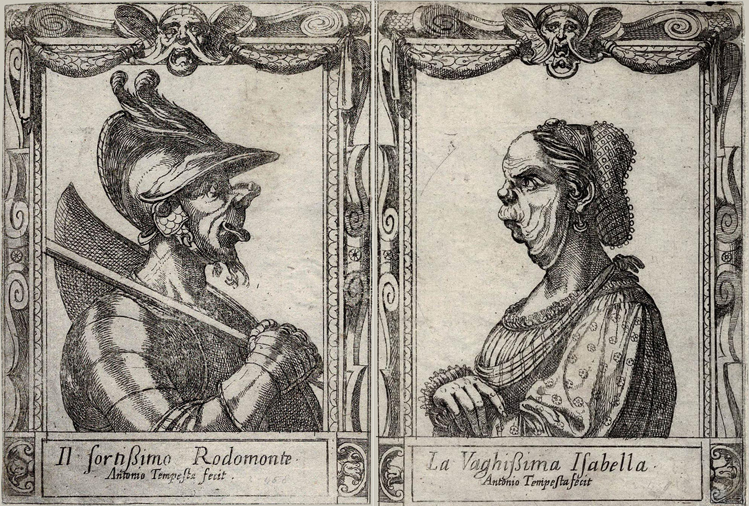
Antonio Tempesta. Il fortissimo Rodomonte. La Vaghissima Isabella. Etchings, c. 1592. Colección Mariano Moret
_______________________________________________________________________________________________________________
THEME & VARIATIONS: WHIPPETS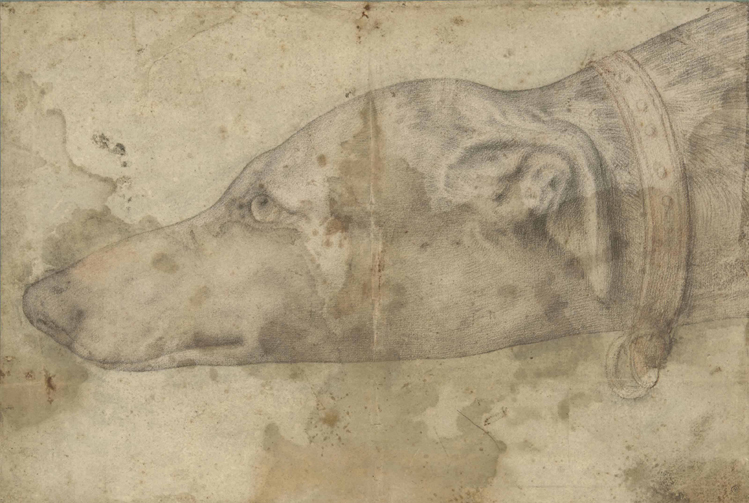 Follower of Antonio Pisanello. Study for a whippet head. Black and red chalk, c. 1450. Christie's
Follower of Antonio Pisanello. Study for a whippet head. Black and red chalk, c. 1450. Christie's 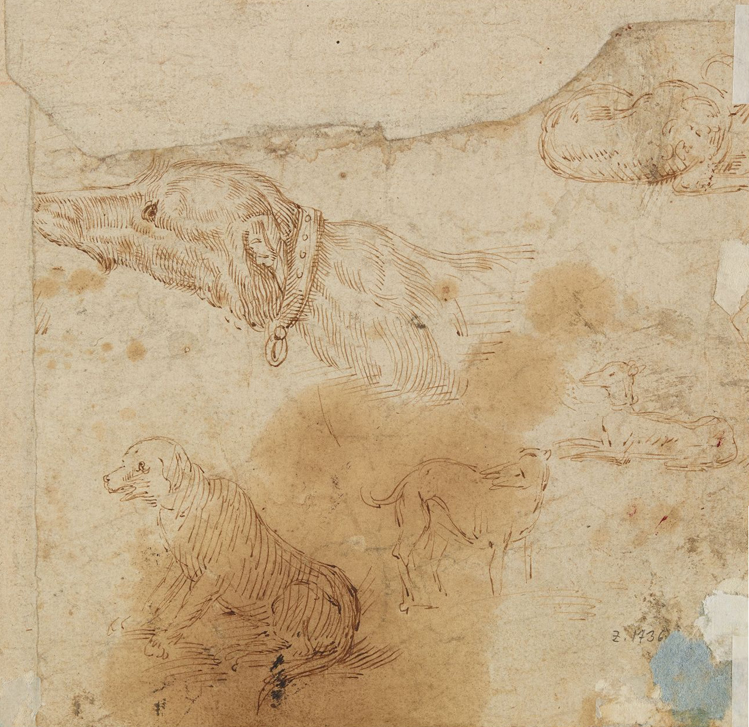 Battista Franco. Five studies of dogs. Brown ink, c. 1530-1561. Herzog Anton Ulrich-Museum
Battista Franco. Five studies of dogs. Brown ink, c. 1530-1561. Herzog Anton Ulrich-Museum 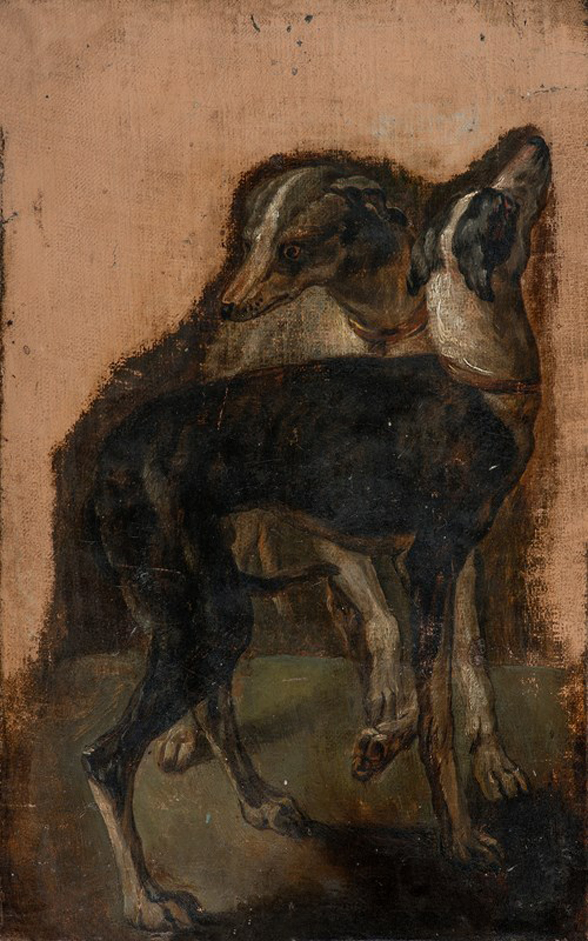 Jan Fyt. Preparatory Study for 'Diana the Huntress'. Oil on canvas, c. 1650. Klaas Muller
Jan Fyt. Preparatory Study for 'Diana the Huntress'. Oil on canvas, c. 1650. Klaas Muller 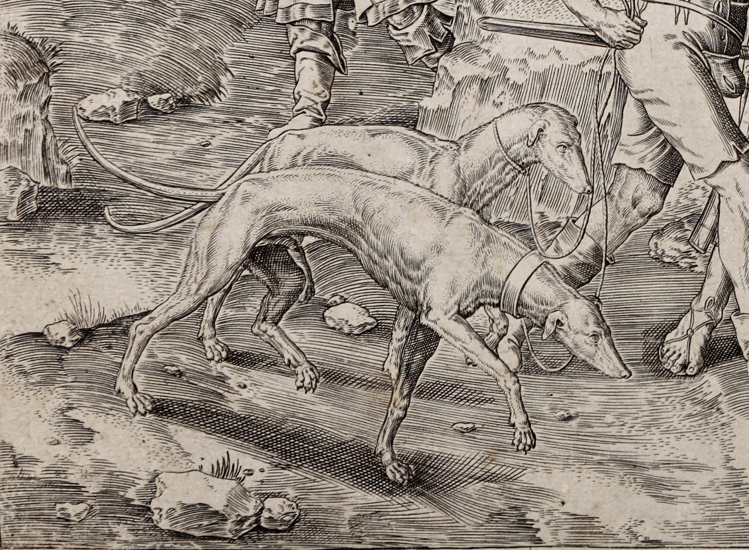 Lucas van Leyden. The Conversion of St Paul (detail). Engraving and drypoint, c. 1520-1540. Colección Mariano Moret
Lucas van Leyden. The Conversion of St Paul (detail). Engraving and drypoint, c. 1520-1540. Colección Mariano Moret 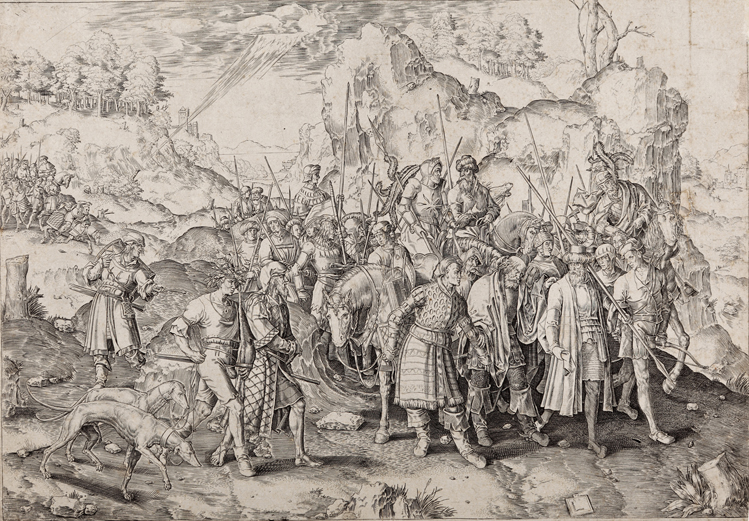 Lucas van Leyden. The Conversion of St Paul. Engraving and drypoint, c. 1520-1540. Colección Mariano Moret
Lucas van Leyden. The Conversion of St Paul. Engraving and drypoint, c. 1520-1540. Colección Mariano Moret
________________________________________________________________________________________________________________
THEME & VARIATIONS: VICTORIA'S PENITENT MAGDALENES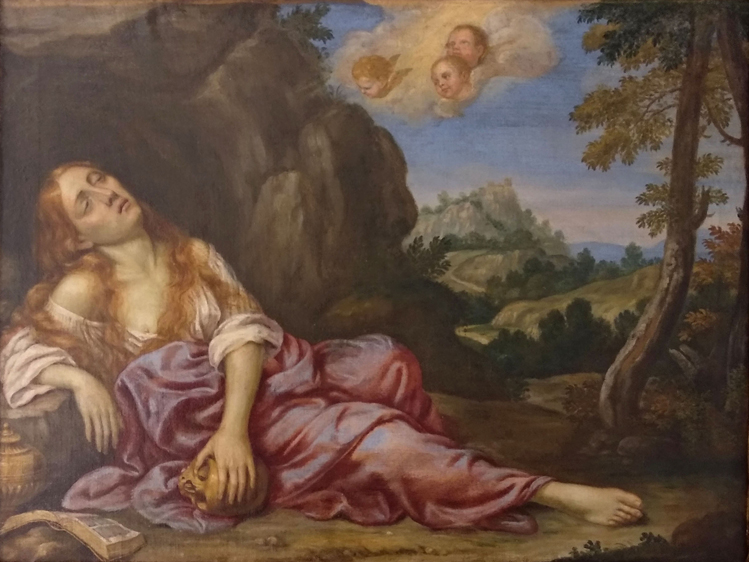
Vicente Victoria. Penitent Magdalene. Oil on canvas, c. 1673 - 1712. Museu de Belles Arts de Xàtiva
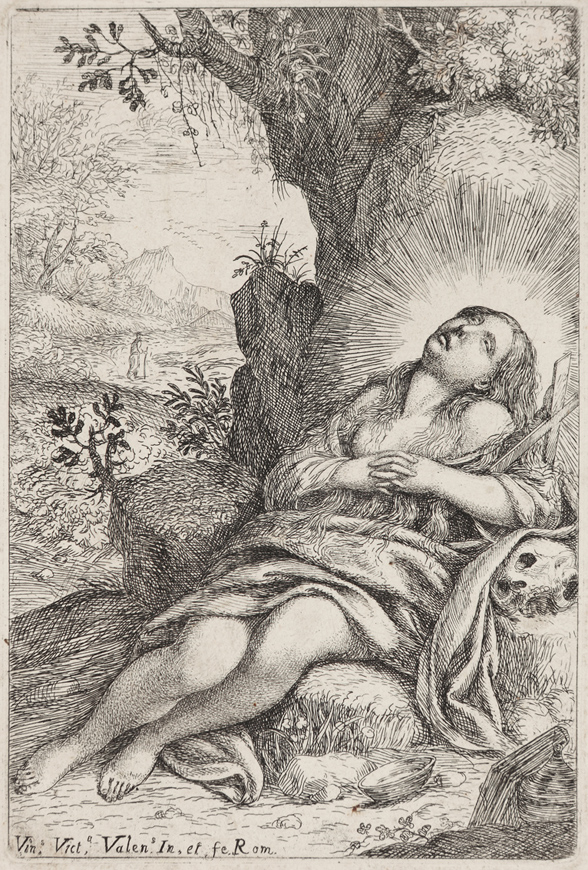 Vicente Victoria. Penitent Magdalene. Etching, c. 1673 - 1712. Colección Mariano Moret
Vicente Victoria. Penitent Magdalene. Etching, c. 1673 - 1712. Colección Mariano Moret
_______________________________________________________________________________________________________________
THEME & VARIATIONS: THE SLEEPING CHILD AND THE DEAD ONE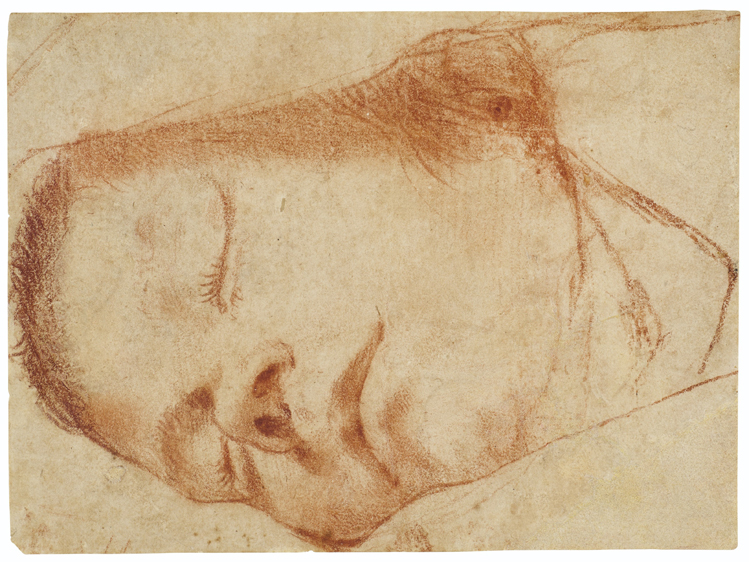
Ludovico Carracci (Bologna, 1555-1619). Head of a sleeping boy. Red chalk. Christie's.
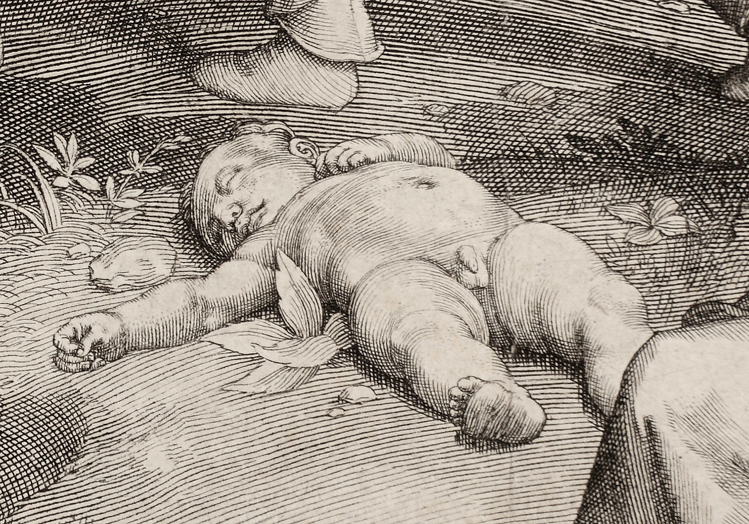 Nicolaas de Bruyn. The massacre of the innocents (detail). Engraving, 1612. Colección Mariano Moret.
Nicolaas de Bruyn. The massacre of the innocents (detail). Engraving, 1612. Colección Mariano Moret. 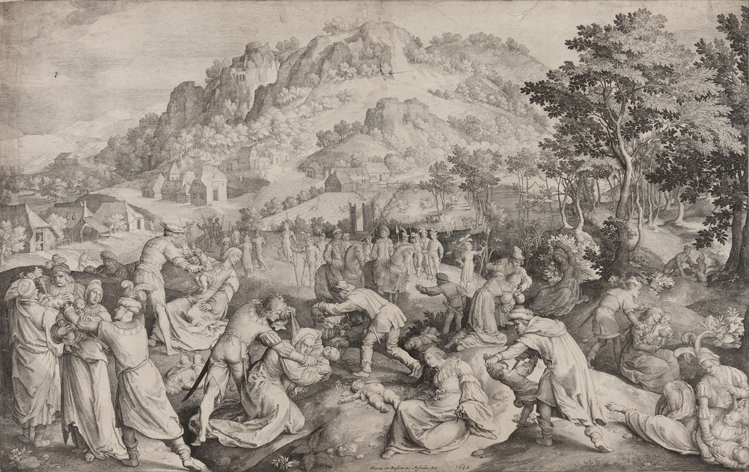 Nicolaas de Bruyn. The massacre of the innocents. Engraving, 1612. Colección Mariano Moret.
Nicolaas de Bruyn. The massacre of the innocents. Engraving, 1612. Colección Mariano Moret.
_______________________________________________________________________________________________________________
THE MARIANO MORET COLLECTION ON THE AUTUMN ISSUE OF G & E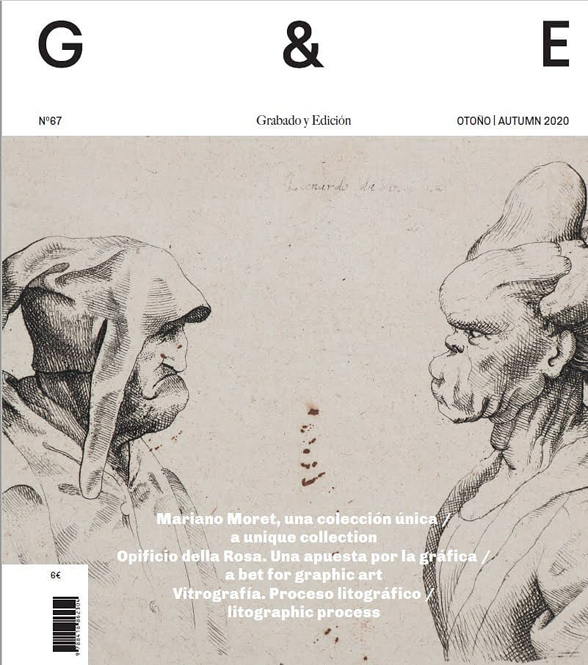
15-10-2020
The Mariano Moret Collection featured on the cover of the Autumn Issue of G & E Grabado y Edición
_______________________________________________________________________________________________________________ THEME & VARIATIONS: APOLLO THE ARCHER
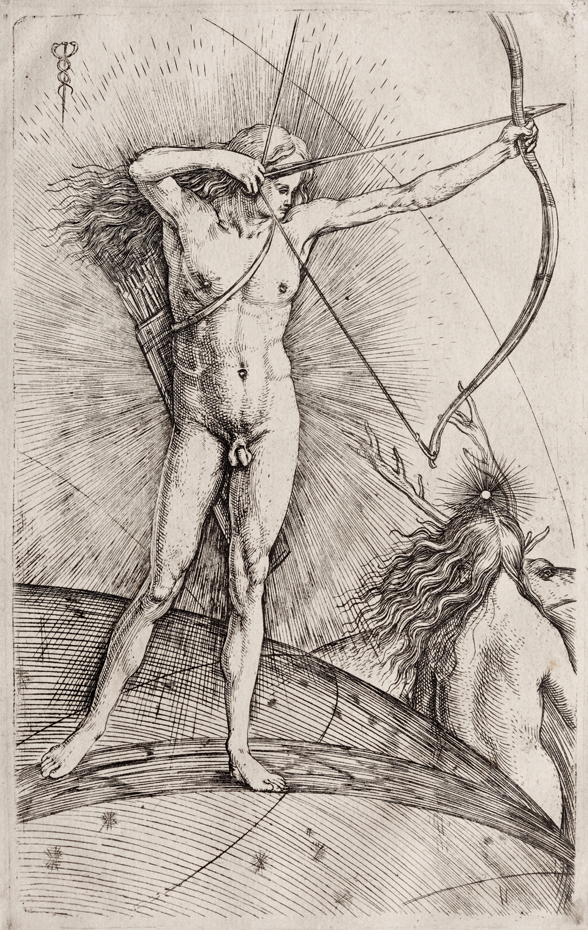
Jacopo de' Barbari. Apollo and Diana. Engraving, c. 1503. Colección Mariano Moret
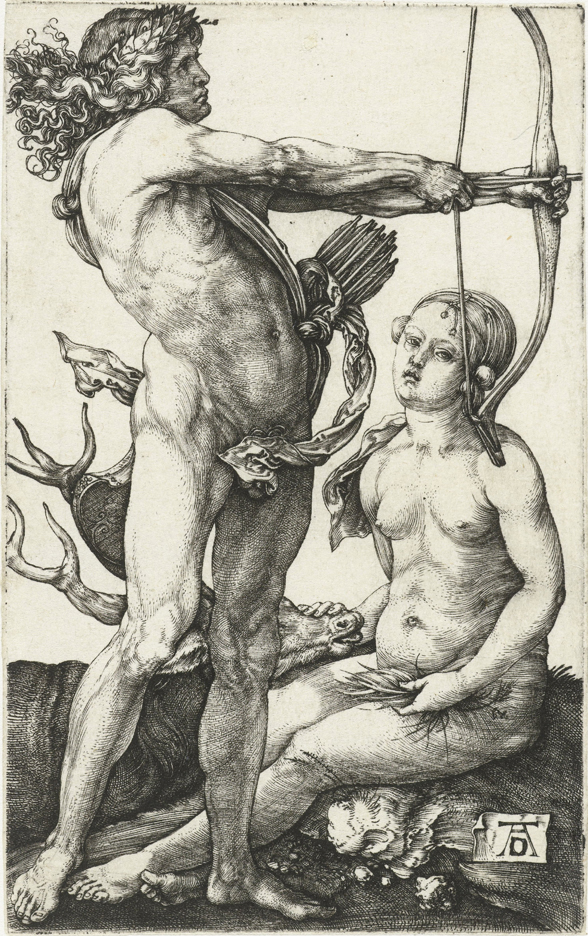 Albrecht Dürer. Apollo and Diana. Engraving, c. 1503-1506. Rijksmuseum
Albrecht Dürer. Apollo and Diana. Engraving, c. 1503-1506. Rijksmuseum 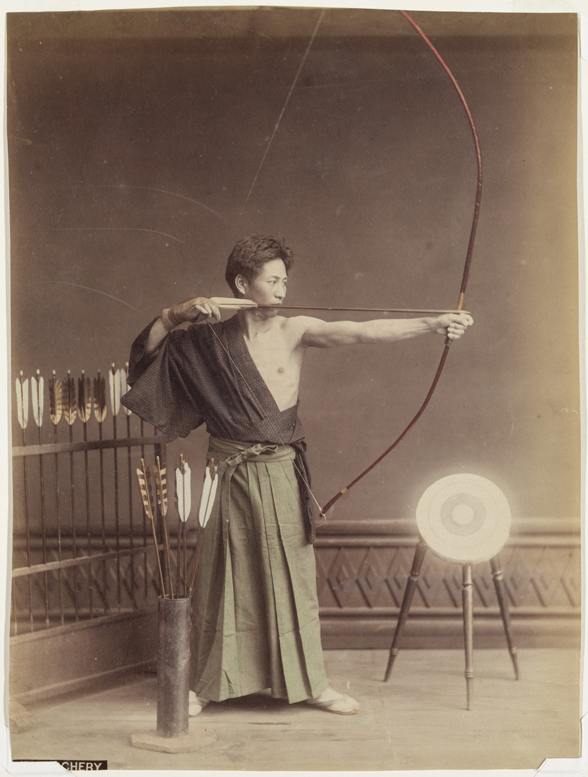 Unknown (Japanese). Japanese Archer. Hand-tinted albumen print, c. 1885. Detroit Institute of Arts ________________________________________________________________________________________
Unknown (Japanese). Japanese Archer. Hand-tinted albumen print, c. 1885. Detroit Institute of Arts ________________________________________________________________________________________ THE MARIANO MORET COLLECTION ON THE SEPTEMBER 2020 ISSUE OF GENTLEMAN
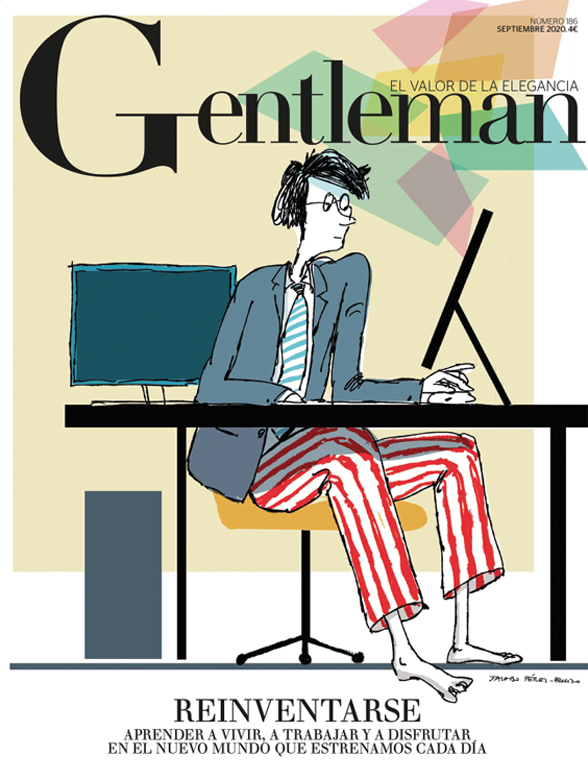
01/09/2020
Gentleman España magazine has interviewed Mariano Moret for its September issue and dedicates two pages to the Mariano Moret Collection.
________________________________________________________________________________________________________________
THEME & VARIATIONS: LUCAS VAN LEYDEN AND POTIPHAR´S WIFE
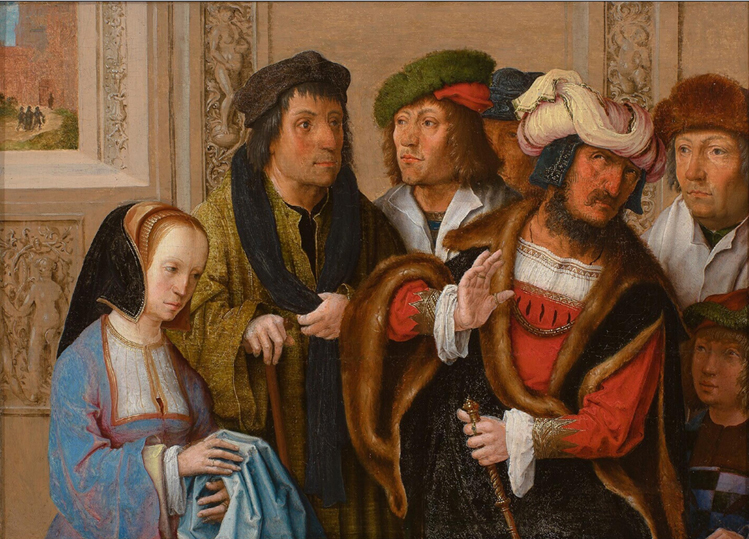 Lucas van Leyden. Potiphar's wife accusing Joseph. Oil on panel, c.1512. Museum Boijmans Van Beuningen
Lucas van Leyden. Potiphar's wife accusing Joseph. Oil on panel, c.1512. Museum Boijmans Van Beuningen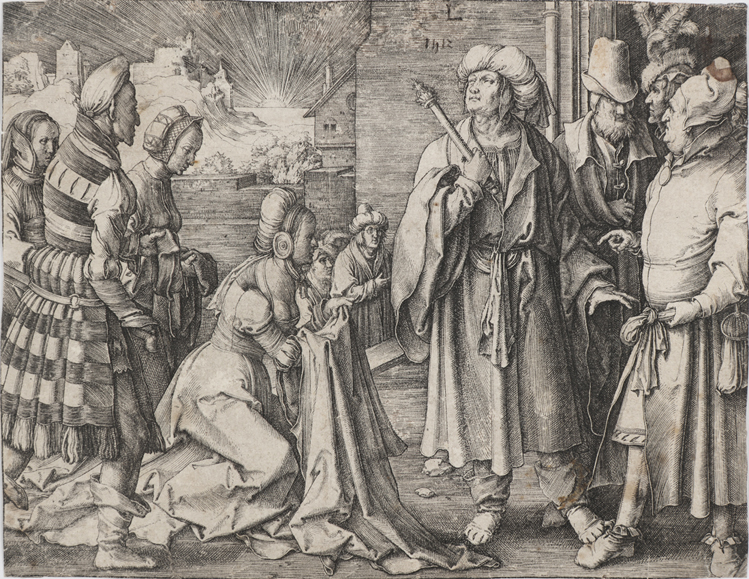 Lucas van Leyden. Potiphar's wife accusing Joseph. Engraving, 1512. Colección Mariano Moret
Lucas van Leyden. Potiphar's wife accusing Joseph. Engraving, 1512. Colección Mariano Moret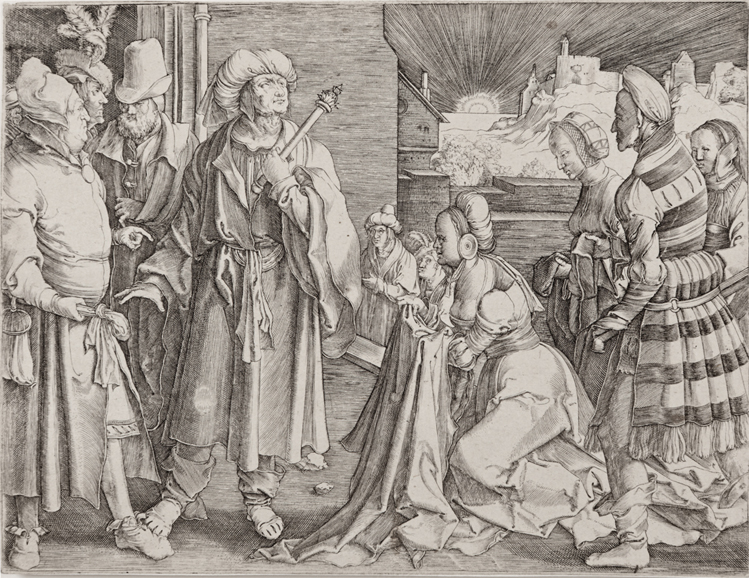 Anonymous reverse copy after Lucas van Leyden. Potiphar's wife accusing Joseph. Engraving, c.1520-1540. Colección Mariano Moret
Anonymous reverse copy after Lucas van Leyden. Potiphar's wife accusing Joseph. Engraving, c.1520-1540. Colección Mariano Moret________________________________________________________________________________________________________________
MARIANO MORET INTERVIEWED ON MUSEOS CON TELEOBJETIVO
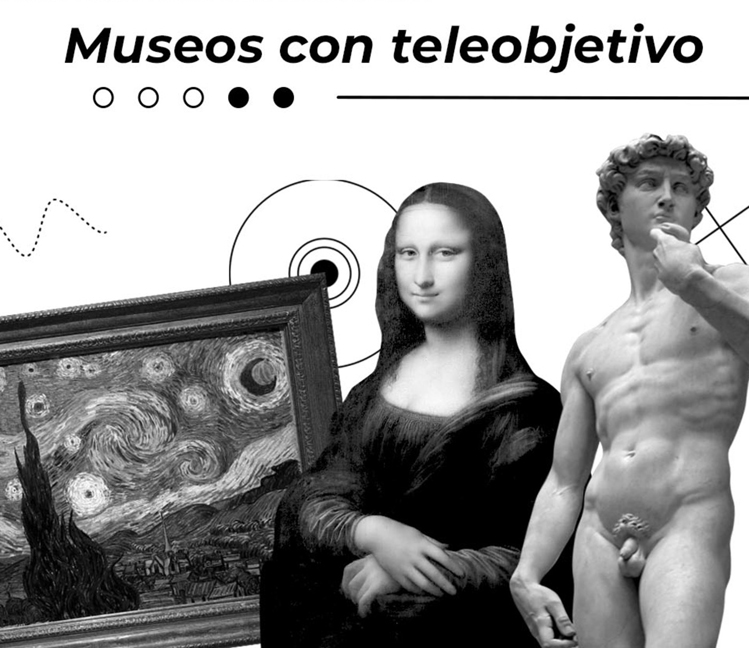
22/04/2020
Dr. María Molina León, Founding Director Museo Universidad Panamericana, interviews Mariano Moret on Museos con teleobjetivo.
________________________________________________________________________________________________________________
CURRENT EXHIBITIONTeste Grottesche Etchings after Leonardo da Vinci Grotesque Heads in the Mariano Moret Collection Valencia Fine Arts Museum
On the occasion of the exhibition Teste Grottesche. Etchings after Leonardo da Vinci Grotesque Heads in the Mariano Moret Collection an english catalogue has been published. You can buy the catalogue online at LLIG shop.
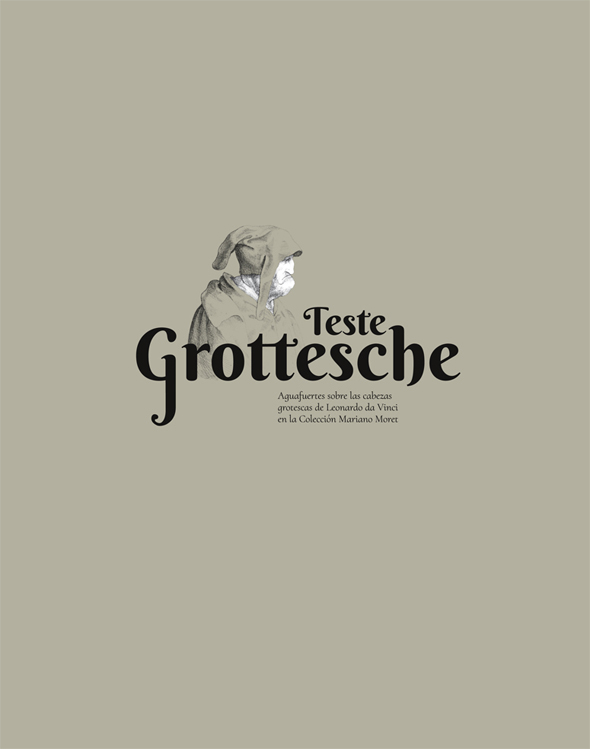 Authors: Mariano Moret María del Mar Albero Muñoz ISBN: 978-84-482-6423-9 Language: Spanish and Valenciano Measures: 30 x 24 cm. Binding: Paperback Number of pages: 144
Authors: Mariano Moret María del Mar Albero Muñoz ISBN: 978-84-482-6423-9 Language: Spanish and Valenciano Measures: 30 x 24 cm. Binding: Paperback Number of pages: 144_________________________________________________________________________________________________________________
CURRENT EXHIBITIONTeste Grottesche Etchings after Leonardo da Vinci Grotesque Heads in the Mariano Moret Collection Valencia Fine Arts Museum
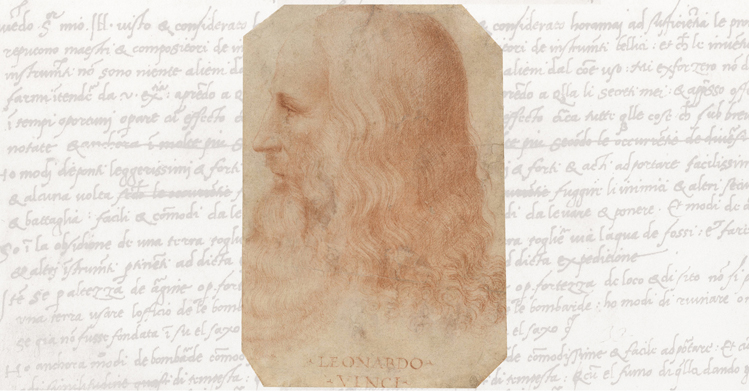
The Valencia Fine Arts Museum has scheduled a cycle of four conferences as a complementary activity to the exhibition Teste Grottesche. Etchings after Leonardo da Vinci Grotesque Heads in the Mariano Moret Collection. The conferences are sponsored by Sbeem and will take place on January 14, 21 and 28 and February 4 at 6:30 p.m. in the Museum Salón de Actos. Admission is free.
January 14, 6:30 p.m. Lecture by Mariano Moret (Curator of the exhibition): Wenzel Hollar y el Conde de Arundel: coleccionando a Leonardo da Vinci.
January 28, 6:30 p.m. Lecture by María de Mar Albero (Universidad de Murcia): “Rostros, espejos del alma”: La expresión de las emociones y la fisiognomía según Leonardo da Vinci, los seguidores de El Bosco y Giovanni B. Azzolino.
February 4, 6:30 p.m. Lecture by Mariano Moret (Curator of the exhibition): En búsqueda del Leonardo perdido: La danza morisca de Daniel Hopfer y sus antecedentes en la obra de Leonardo da Vinci.
February 11, 6:30 p.m. Lecture by Carles Magraner (Director of Capella de Ministrers): Leonardo da Vinci y la música grotesca.
________________________________________________________________________________________________________________
CURRENT EXHIBITION
Teste Grottesche Etchings after Leonardo da Vinci Grotesque Heads in the Mariano Moret Collection Valencia Fine Arts Museum
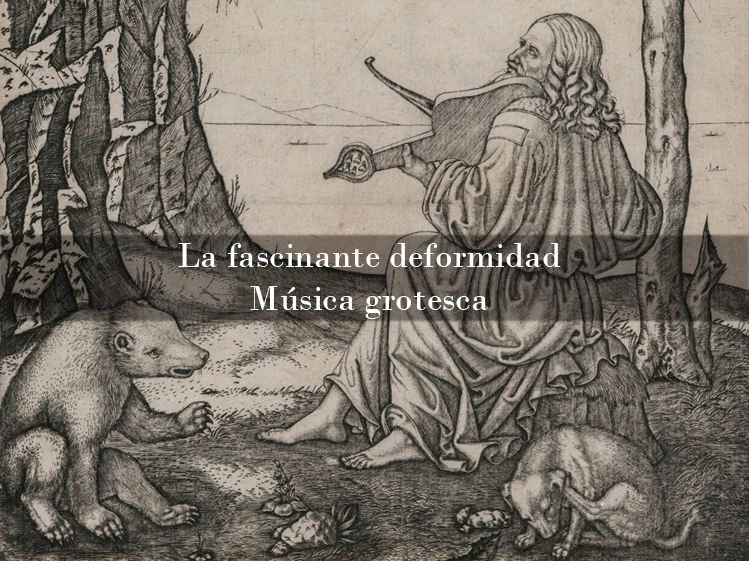
15/12/2019
La fascinante deformidad. Música grotesca
Concert by Capella de Ministrers on the occasion of the exhibition Teste Grottesche. Etchings after Leonardo da Vinci Grotesque Heads in the Mariano Moret Collection. The concert program has been specially designed for the occasion by the musicologist Pepe Rey who will also offer a conference on this repertoire on January 21. The concert includes the voices of Delia Agúndez, Hugo Bolívar, Jorge Morata and Antonio Sabuco, the instrumentalists Carles Magraner, Robert Cases and Pau Ballester and the dancer and actor Toni Aparisi.
_______________________________________________________________________________________________________________
NEW EXHIBITION OPENING
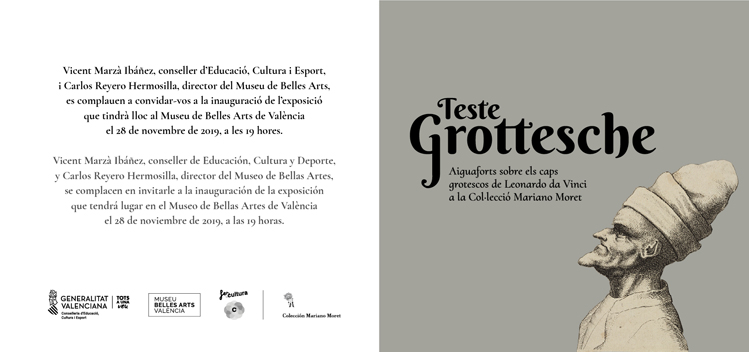
Teste Grottesche Etchings after Leonardo da Vinci Grotesque Heads in the Mariano Moret Collection
València Fine Arts Museu November 28, 2019 - March 1, 2020
____________________________________________________________________________________
CURRENT EXHIBITION
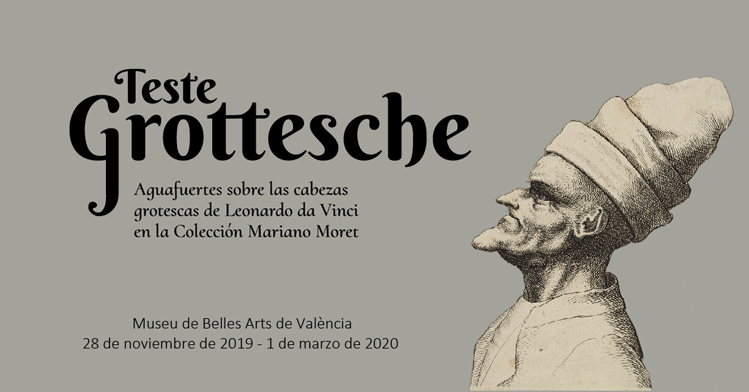
Teste Grottesche Etchings after Leonardo da Vinci Grotesque Heads in the Mariano Moret Collection
València Fine Arts Museu November 28, 2019 - March 1, 2020
The Mariano Moret Collection holds a small but exceptional group of prints derived from Leonardo da Vinci drawings, which makes it unique in Spain. In some cases, as in the etchings of Wenzel Hollar, the relationship with the works of the Florentine genius is direct. They copy Leonardo's well-known drawings which were part of the collection of Thomas Howard, 14th Earl of Arundel, at the time of the creation of the prints in the 17th century. Most of these extraordinary drawings, exceptional testimony of Leonardo's mastermind, currently belong to the Royal Collection and are preserved in the Royal Library at Windsor Castle. In other cases, Leonardo's original drawings were lost, so Hollar relied on old copies made by some disciples that were very close to Leonardo, such as his favorite pupil Francesco Melzi.
The Morris Dancers by Daniel Hopfer is another example of a linked print from the Mariano Moret Collection with the work of Leonardo da Vinci. Although evident, this dependence is not as obvious as in Hollar's etchings, since the original drawing that could serve Hopfer as a model to make his print is not preserved.
In this sense, while the exhibition shows some little-known and largely unpublished works, an attempt has been made to unravel the dependency network that connect them to each other, looking for the original sources that could inspire them.
Teste Grottesche exhibition presentation video
____________________________________________________________________________________
THE EXHIBITION KLEINMEISTER OF THE MARIANO MORET COLLECTION IN PRINT QUARTERLY
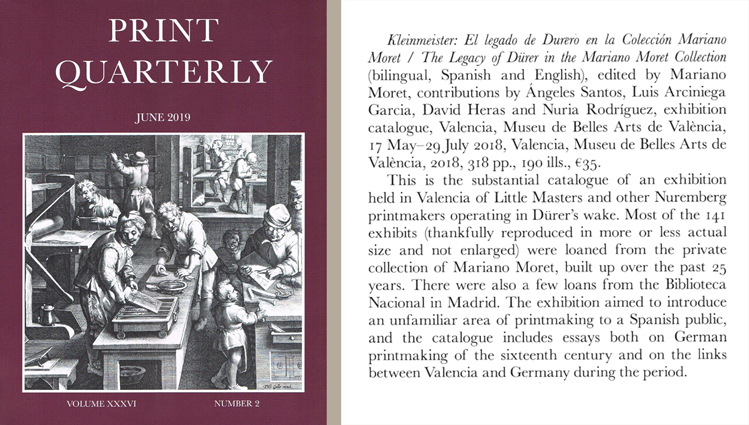
The exhibition Kleinmeister. El legado de Durero en la Colección Mariano Moret in the last issue (june 2019) of Print Quarterly.
____________________________________________________________________________________
THEME & VARIATIONS: MANTEGNA AND BELLINI CHRIST´S DESCENT INTO LIMBO
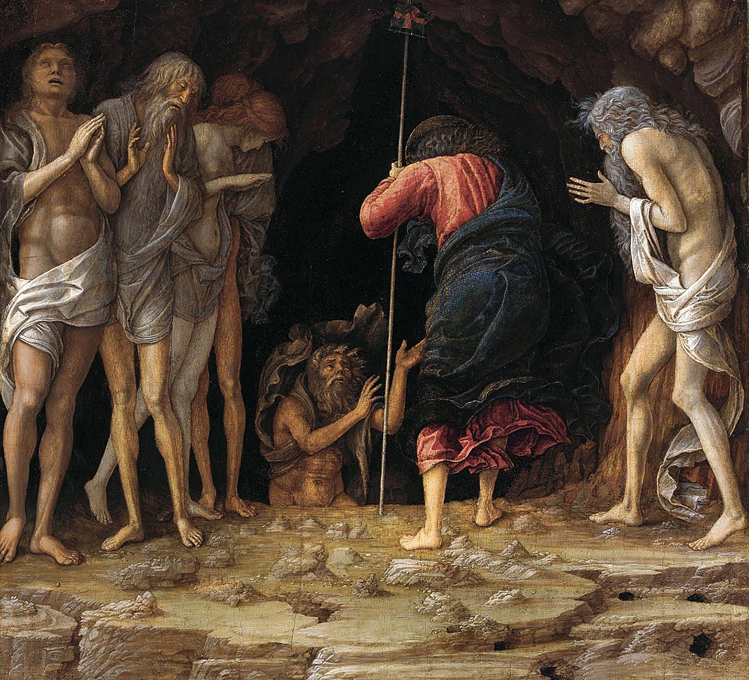 Andrea Mantegna. Christ's Descent Into Limbo. Tempera and gold on panel, 1492. Private collection
Andrea Mantegna. Christ's Descent Into Limbo. Tempera and gold on panel, 1492. Private collection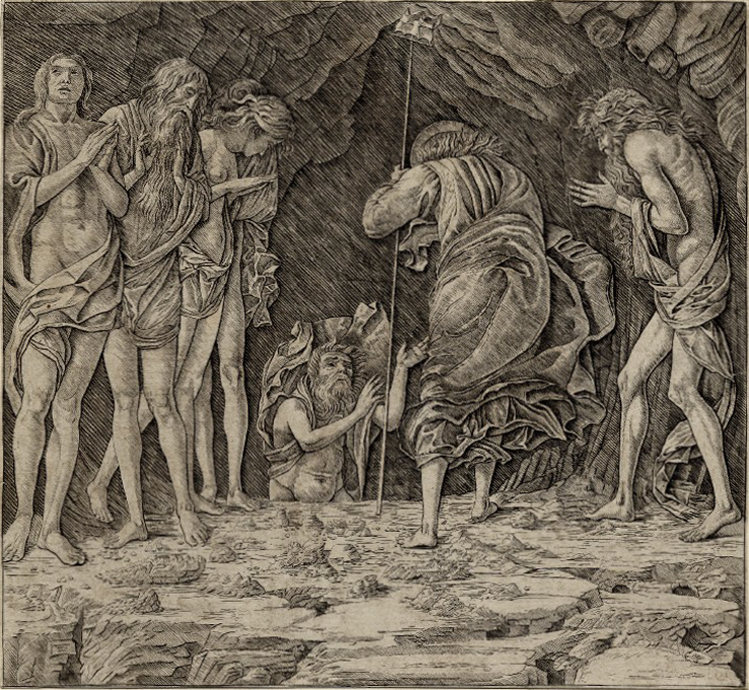 After Andrea Mantegna. Christ descending into Limbo. Engraving, 1490-1520. British Museum
After Andrea Mantegna. Christ descending into Limbo. Engraving, 1490-1520. British Museum 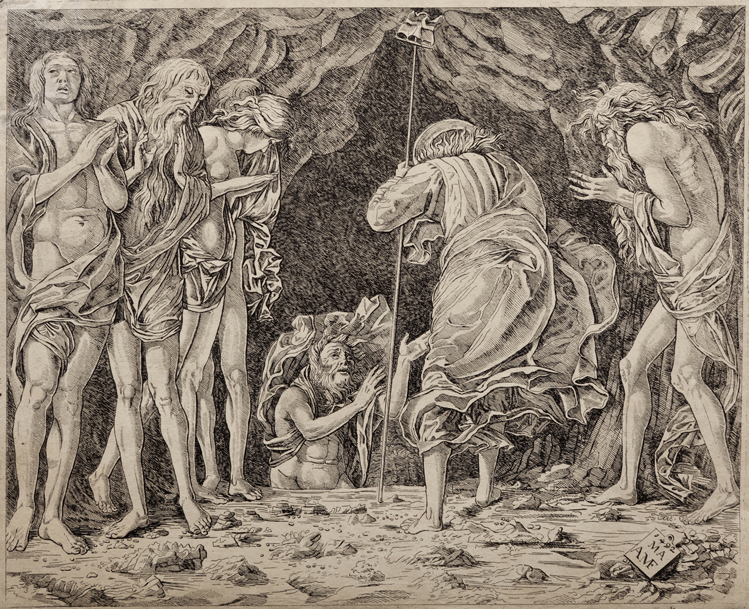 Follower of Andrea Mantegna. Christ descending into Limbo. Engraving, c.1492. Colección Mariano Moret
Follower of Andrea Mantegna. Christ descending into Limbo. Engraving, c.1492. Colección Mariano Moret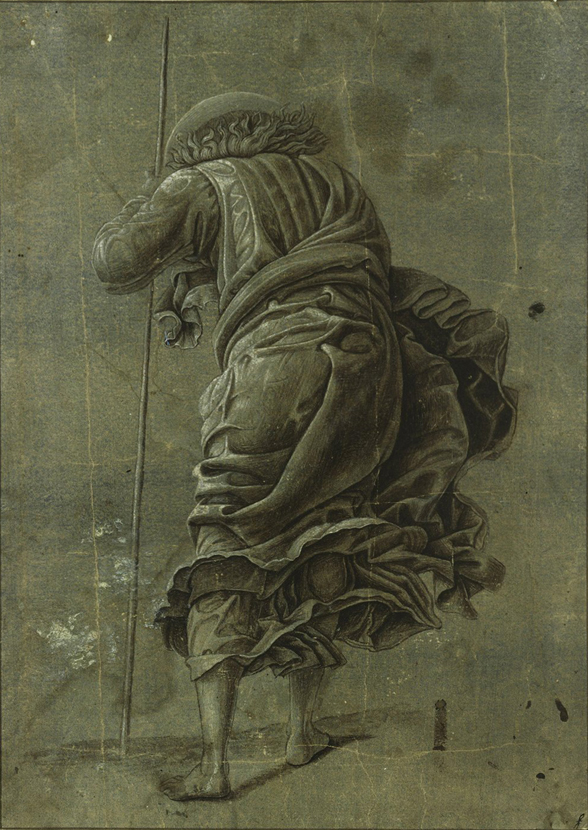 Circle of Andrea Mantegna. The Descent into Limbo. Brown and dark grey wash, heightened with white, on blue prepared paper, c. 1490. Staatliche Museen zu Berlin, Kupferstichkabinett
Circle of Andrea Mantegna. The Descent into Limbo. Brown and dark grey wash, heightened with white, on blue prepared paper, c. 1490. Staatliche Museen zu Berlin, Kupferstichkabinett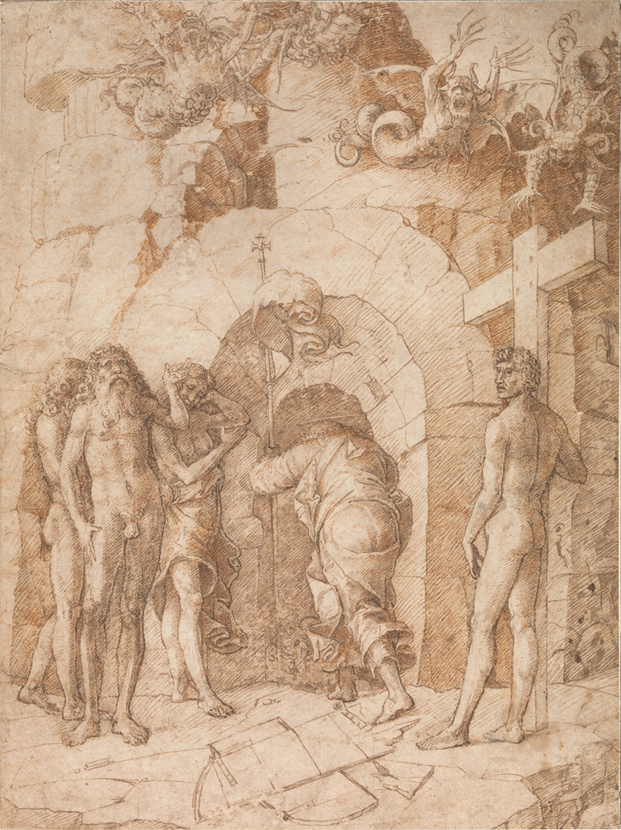 Circle of Andrea Mantegna. The Descent into Limbo. Pen and brown ink, brown wash, c. 1450. Metropolitan Museum of Art
Circle of Andrea Mantegna. The Descent into Limbo. Pen and brown ink, brown wash, c. 1450. Metropolitan Museum of Art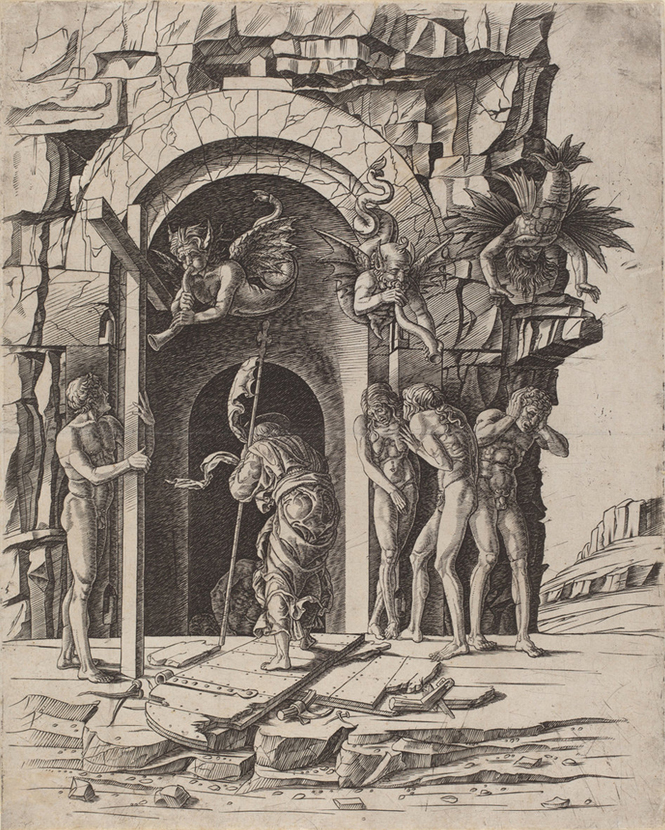 Workshop of Andrea Mantegna (attributed to Andrea Zoan). Descent into Limbo. Engraving, c. 1475. National Gallery of Art
Workshop of Andrea Mantegna (attributed to Andrea Zoan). Descent into Limbo. Engraving, c. 1475. National Gallery of Art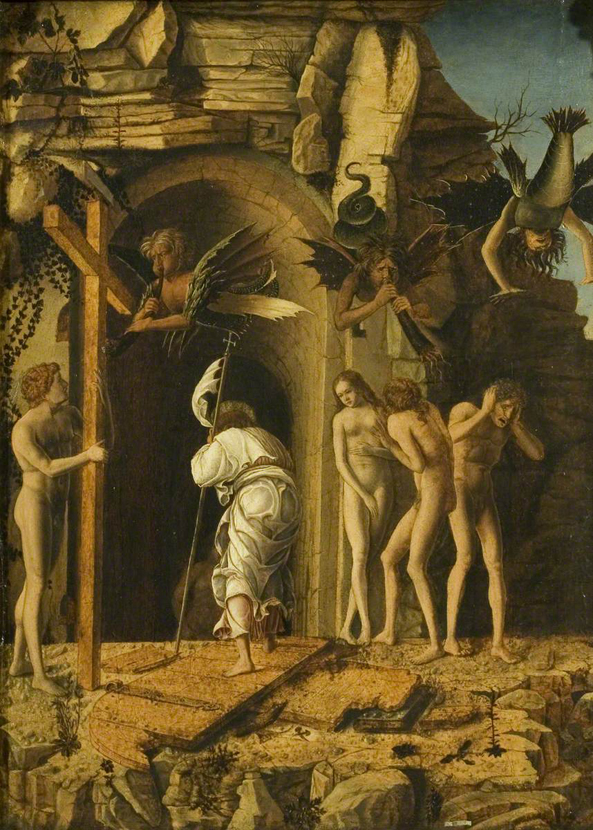 Giovanni Bellini. The Descent of Christ into Limbo. Oil on vellum on panel, c. 1475-1480. Bristol Museum & Art Gallery
Giovanni Bellini. The Descent of Christ into Limbo. Oil on vellum on panel, c. 1475-1480. Bristol Museum & Art Gallery ____________________________________________________________________________________
THE MARIANO MORET COLLECTION IN FIG BILBAO
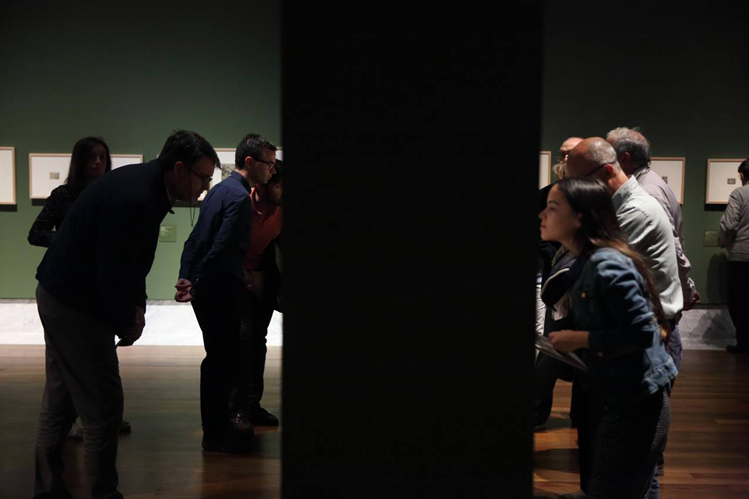
A selection of prints from the exhibition Kleinmeister. The Legacy of Dürer in the Mariano Moret Collection, which was recently shown at the Valencia Fine Arts Museum, will be on display from November 15 to 18 at FIG Bilbao, the Art on Paper Festival that will once again make the Basque capital the epicenter of Printmaking in Europe. Visitors to the festival can also enjoy the specially designed augmented reality and virtual reality multimedia contents that will be accessible through tablets and VR glasses present in the exhibition.
____________________________________________________________________________________
DÜRER AND THE PROPORTIONS OF HUMAN BODY
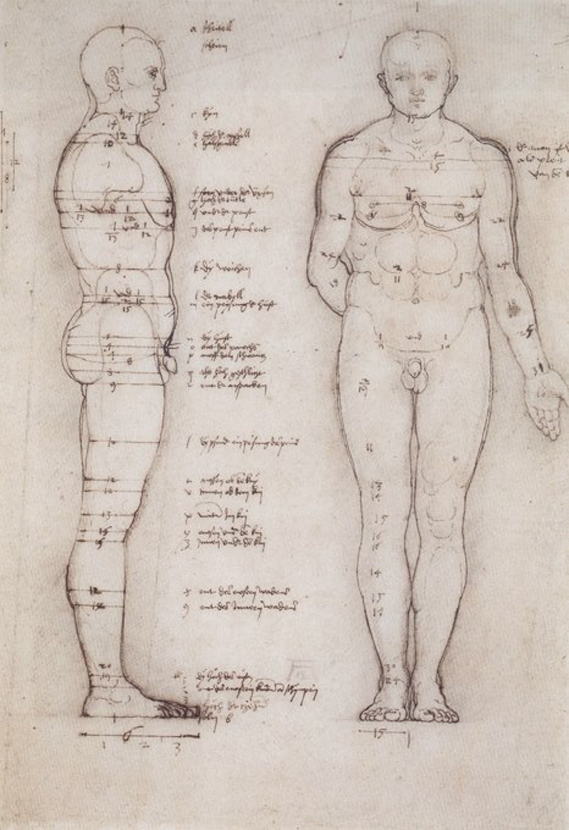
Albrecht Dürer. Male Nude. Pen and brown ink, c.1513. Albertina
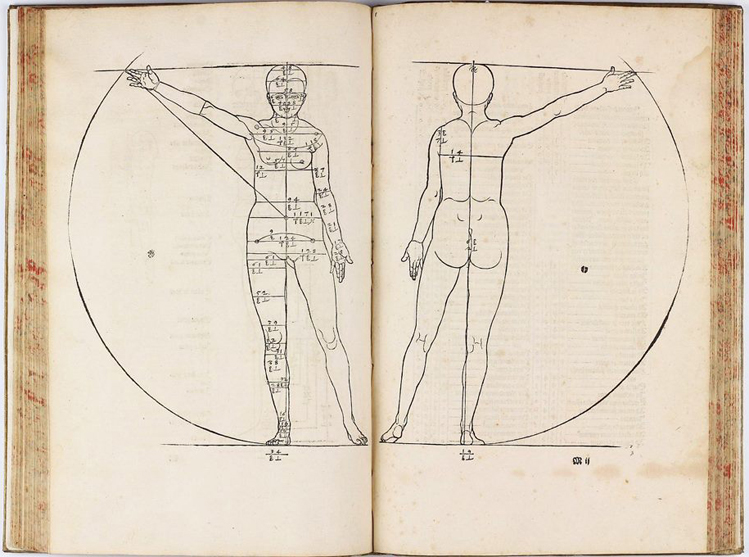
Albrecht Dürer. De Symmetria Partium in Rectis Formis Humanorum Corporum, 1538
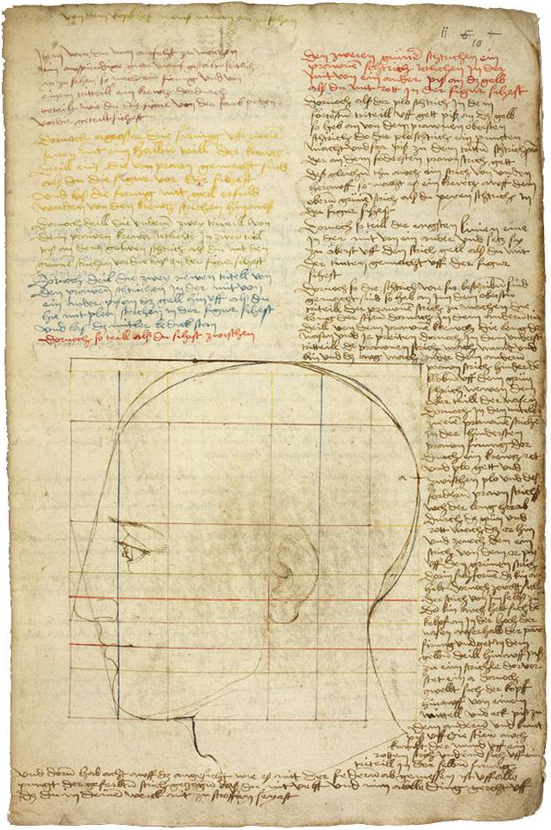
Albrecht Dürer. Construction of an ideal head. Pen and brown ink, 1500. Germanisches British Library, MSS Add Sloane 5230,10v.
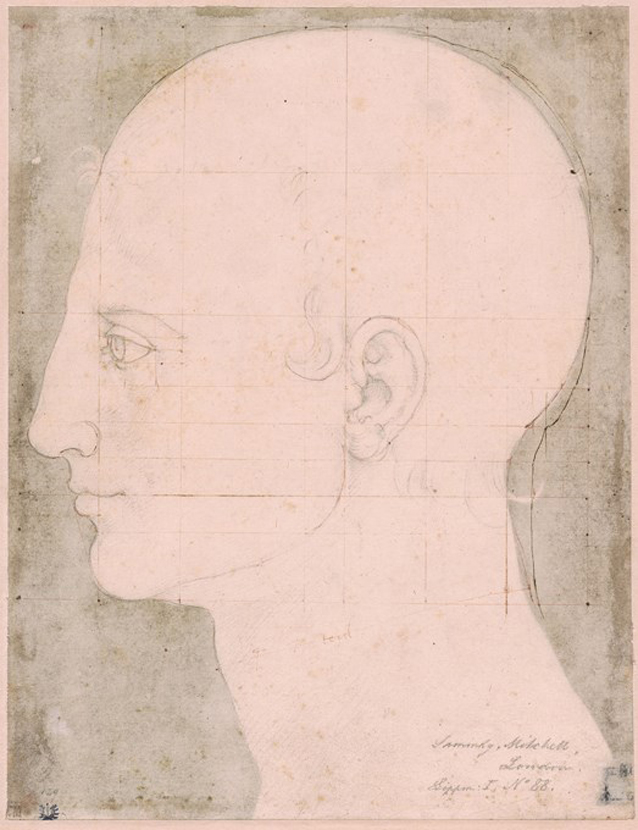
Albrecht Dürer. Constructed Head of a Man in Profile (verso). Pen and brown ink and dark brown wash, c.1512. Morgan Library & Museum
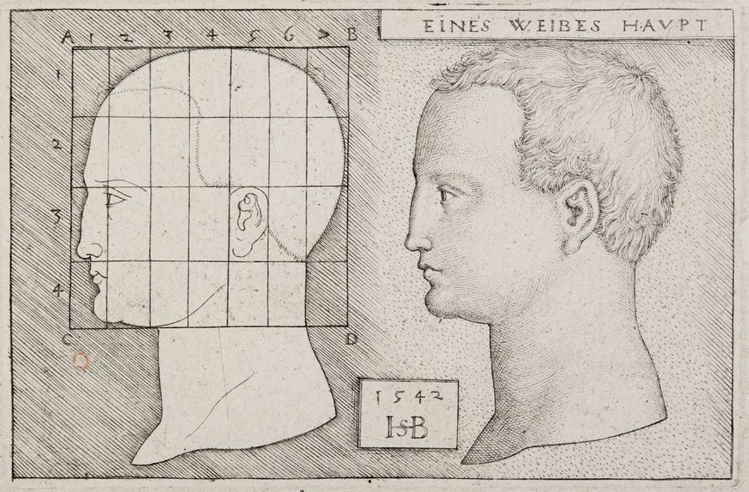
Hans Sebald Beham. Eines Weibes Haupt. Engraving, 1542. Colección Mariano Moret
____________________________________________________________________________________
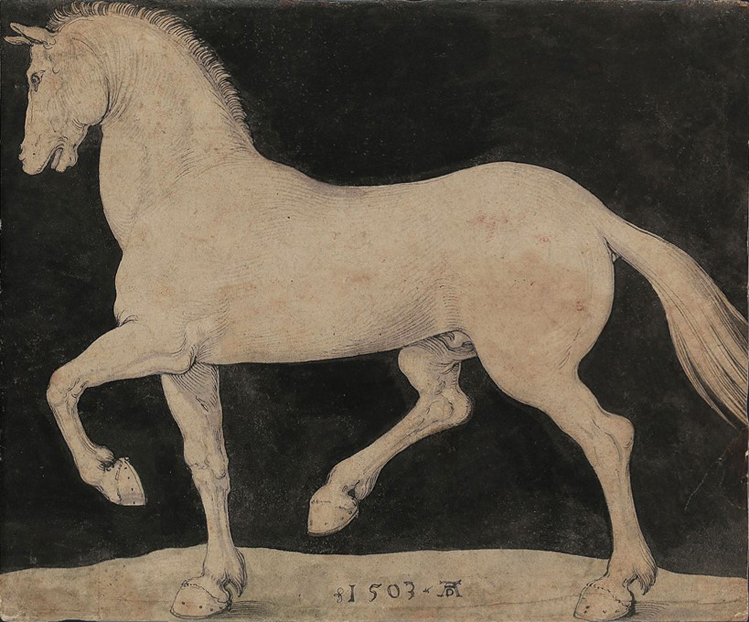 Albrecht Dürer. Horse. Pen and ink on basic black cover, 1503. Wallraf-Richartz Museum
Albrecht Dürer. Horse. Pen and ink on basic black cover, 1503. Wallraf-Richartz Museum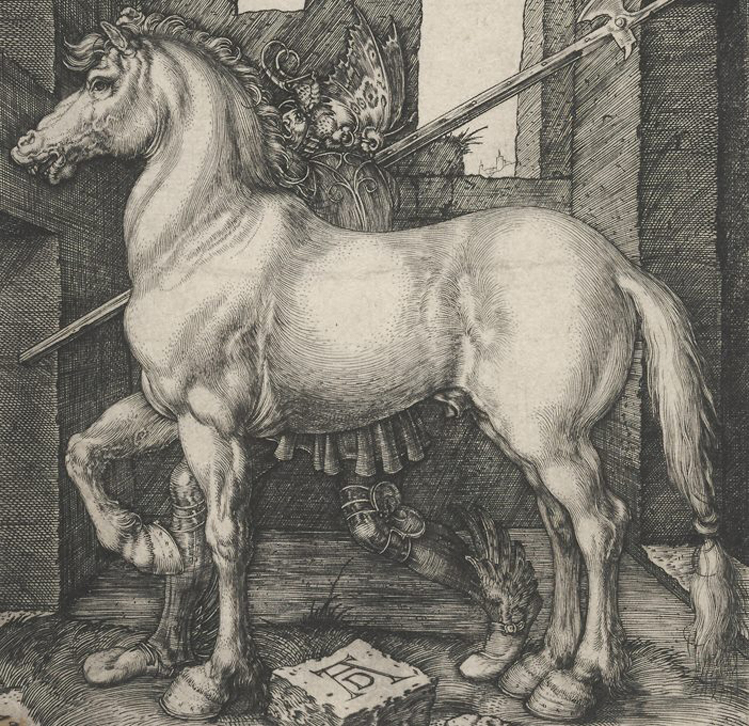 Albrecht Dürer. The Little Horse (detail). Engraving, 1505. Biblioteca Nacional de España
Albrecht Dürer. The Little Horse (detail). Engraving, 1505. Biblioteca Nacional de España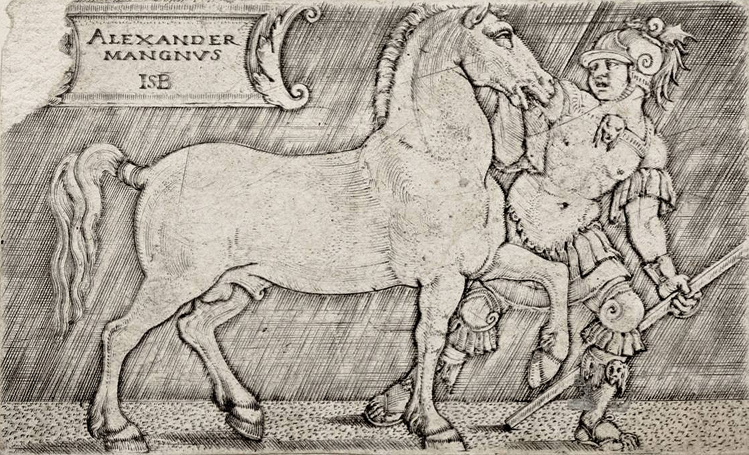 Hans Sebald Beham. Alexander the Great. Engraving, c.1531–1550. Colección Mariano Moret
Hans Sebald Beham. Alexander the Great. Engraving, c.1531–1550. Colección Mariano Moret ____________________________________________________________________________________
CURRENT EXHIBITION
Kleinmeister. The Legacy of Dürer in the Mariano Moret Collection València Fine Arts MuseumOn the occasion of the exhibition Kleinmeister. The Legacy of Dürer in the Mariano Moret Collection, an english catalogue has been published. You can buy the catalogue online at LLIG shop.
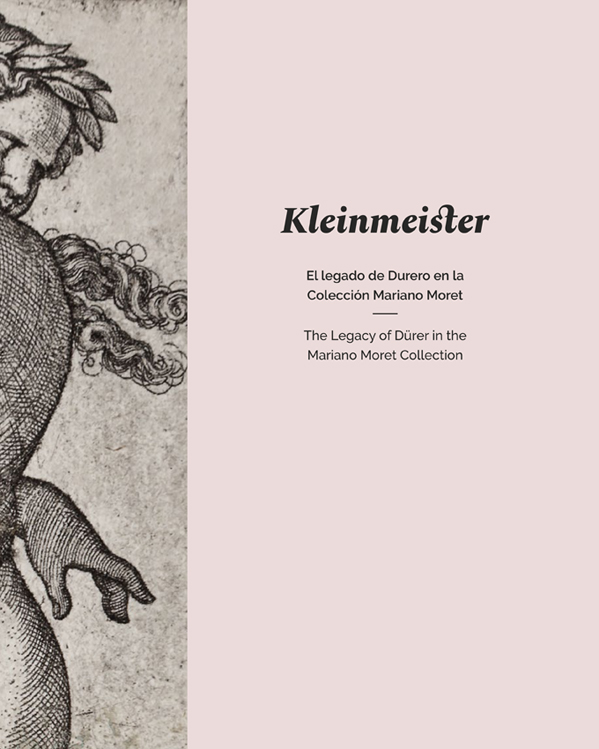
____________________________________________________________________________________
DÜRER´S HELMS
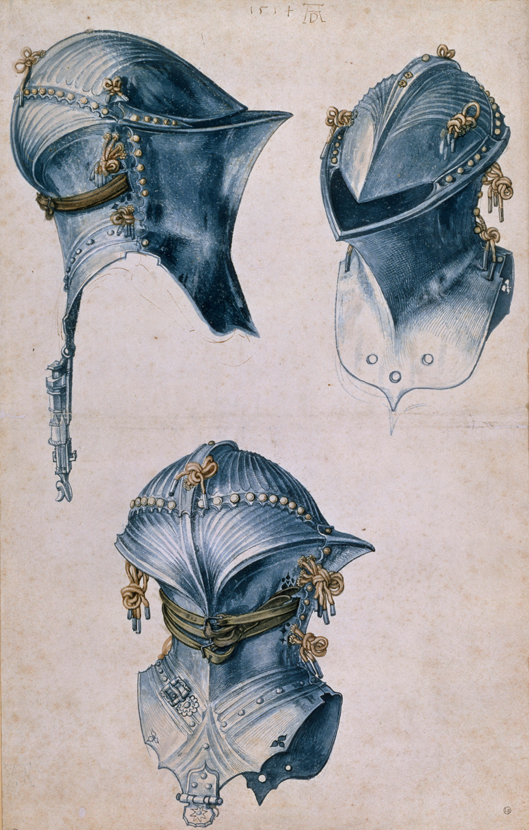 Albrecht Dürer. Three Studies of a Helmet. Pen, ink and watercolour, 1503. Musée du Louvre
Albrecht Dürer. Three Studies of a Helmet. Pen, ink and watercolour, 1503. Musée du Louvre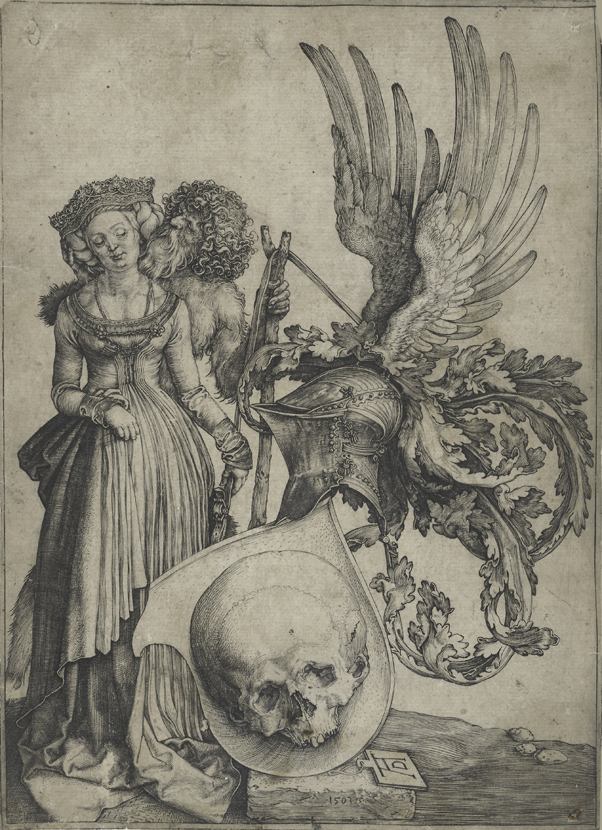 Albrecht Dürer. Coat of arms with a Skull. Engraving, 1503. Biblioteca Nacional de España
Albrecht Dürer. Coat of arms with a Skull. Engraving, 1503. Biblioteca Nacional de España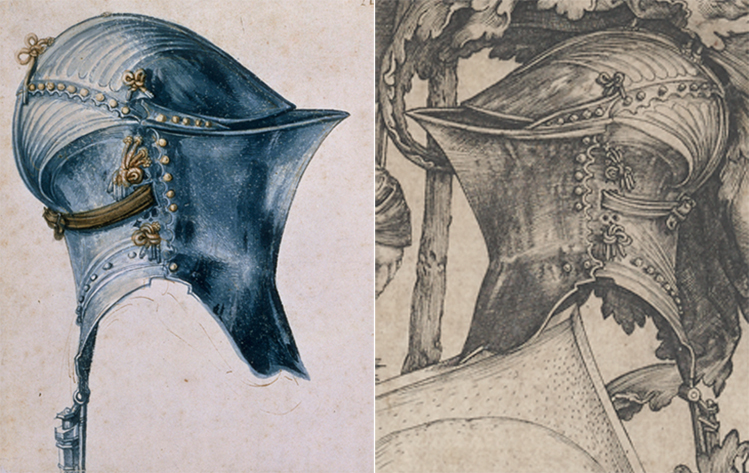 Albrecht Dürer. Three Studies of a Helmet (detail). Pen, ink and watercolour, 1503 Musée du Louvre. Albrecht Dürer. Coat of arms with a Skull (detail). Engraving, 1503. Biblioteca Nacional de España
Albrecht Dürer. Three Studies of a Helmet (detail). Pen, ink and watercolour, 1503 Musée du Louvre. Albrecht Dürer. Coat of arms with a Skull (detail). Engraving, 1503. Biblioteca Nacional de España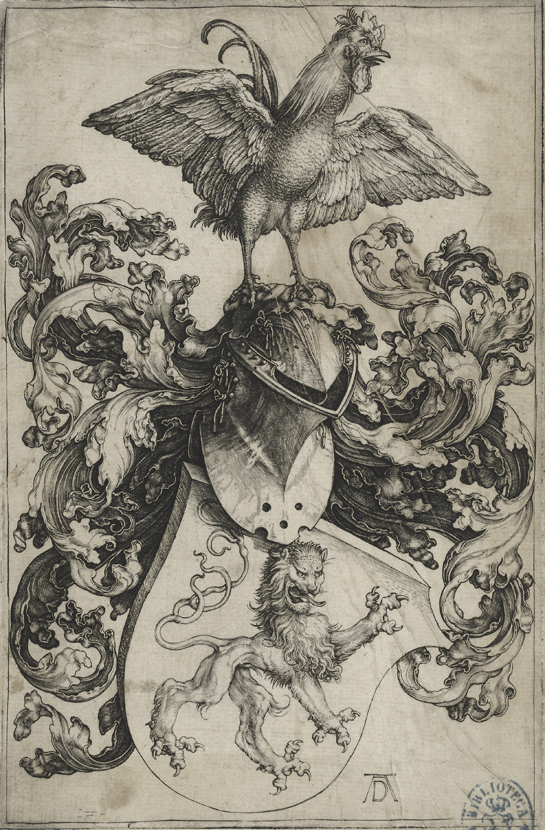 Albrecht Dürer. Coat of arms with a Lion and a Cock. Engraving, c.1500. Biblioteca Nacional de España
Albrecht Dürer. Coat of arms with a Lion and a Cock. Engraving, c.1500. Biblioteca Nacional de España 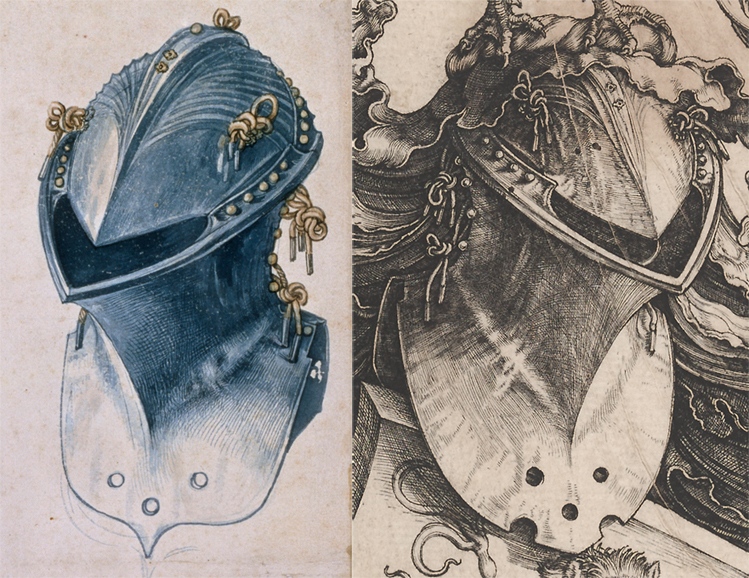 Albrecht Dürer. Three Studies of a Helmet (detail). Pen, ink and watercolour, 1503. Musée du Louvre Albrecht Dürer. Coat of arms with a Lion and a Cock (detail). Engraving, c.1500. Biblioteca Nacional de España
Albrecht Dürer. Three Studies of a Helmet (detail). Pen, ink and watercolour, 1503. Musée du Louvre Albrecht Dürer. Coat of arms with a Lion and a Cock (detail). Engraving, c.1500. Biblioteca Nacional de España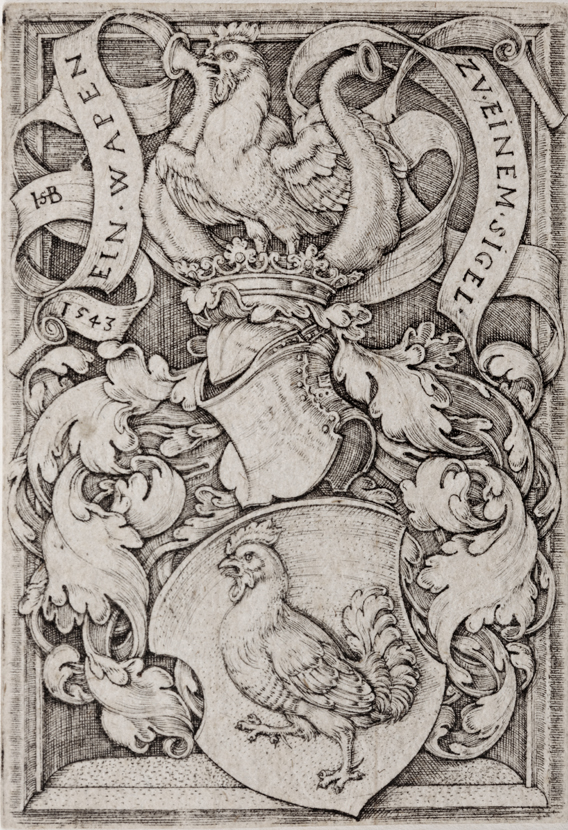 Hans Sebald Beham. Coat of Arms with a Cock. Engraving, 1543. Colección Mariano Moret
Hans Sebald Beham. Coat of Arms with a Cock. Engraving, 1543. Colección Mariano Moret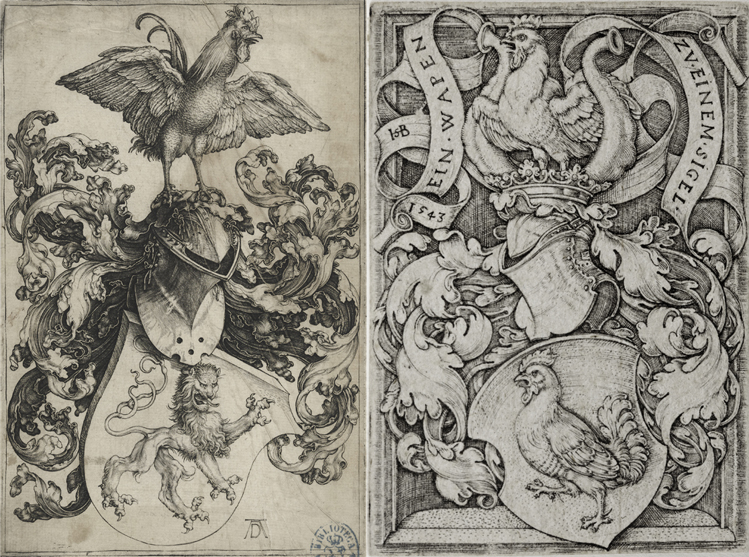 Albrecht Dürer. Coat of arms with a Lion and a Cock. Engraving, c.1500. Biblioteca Nacional de España Hans Sebald Beham. Coat of Arms with a Cock. Engraving, 1543. Colección Mariano Moret
Albrecht Dürer. Coat of arms with a Lion and a Cock. Engraving, c.1500. Biblioteca Nacional de España Hans Sebald Beham. Coat of Arms with a Cock. Engraving, 1543. Colección Mariano Moret ___________________________________________________________________________________
CURRENT EXHIBITION
Kleinmeister. The Legacy of Dürer in the Mariano Moret Collection València Fine Arts MuseumThe Kleinmeister exhibition in Ars Magazine: link to the article
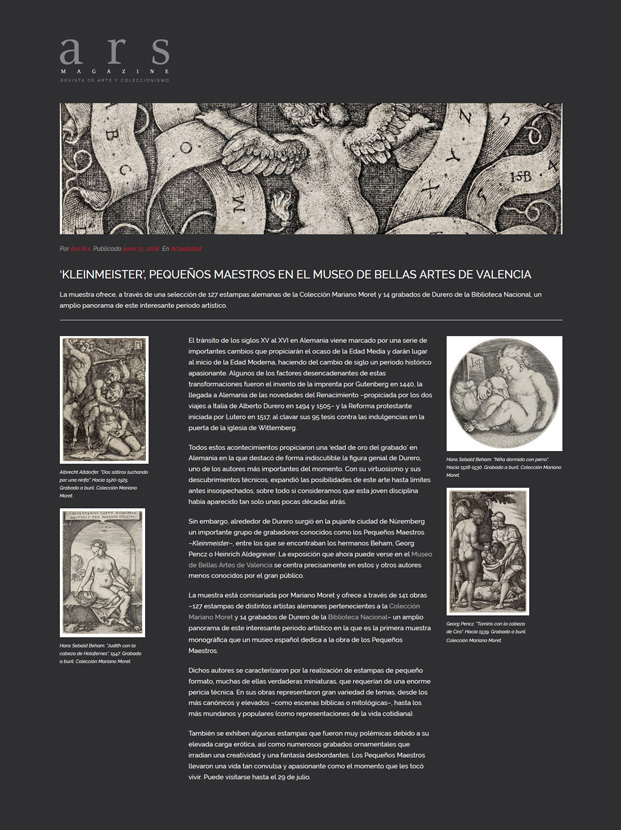
_____________________________________________________________________________________
CURRENT EXHIBITION
Kleinmeister. The Legacy of Dürer in the Mariano Moret Collection València Fine Arts MuseumLittle Masters’ prints can be regarded as products of the most advanced technology of the first half of the sixteenth century, since they were made possible by the breakthroughs in optics which facilitated production of the magnifying lenses that were an indispensable requirement for executing works on such a small scale. The last section of the Kleinmeister exhibition is therefore devoted to presenting Old Master prints through the medium of museographic resources at the forefront of twenty-first-century technology. For this purpose an application for mobile devices has been specially created for this exhibition, making it possible to access a range of augmented reality and virtual reality content. This content is also accessible in the exhibition room through tablets and VR goggles, enabling visitors to immersively enter a sixteenth-century print workshop or to participate actively in the engraving, inking and printing processes of some of the prints included in the exhibition. The aim is to provide an attractive and educational way of bringing Old Master prints closer to the general public, and especially to a younger audience, which is very receptive to these technologies.
Free download Kleinmeister/Colección Mariano Moret App in App Store Free download Kleinmeister/Colección Mariano Moret App in Google Play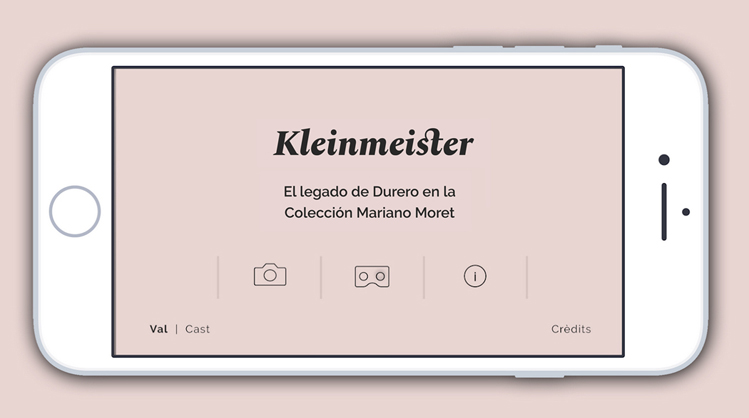
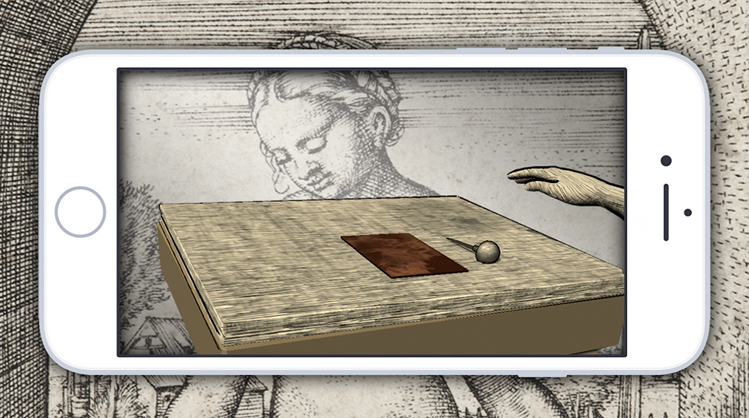
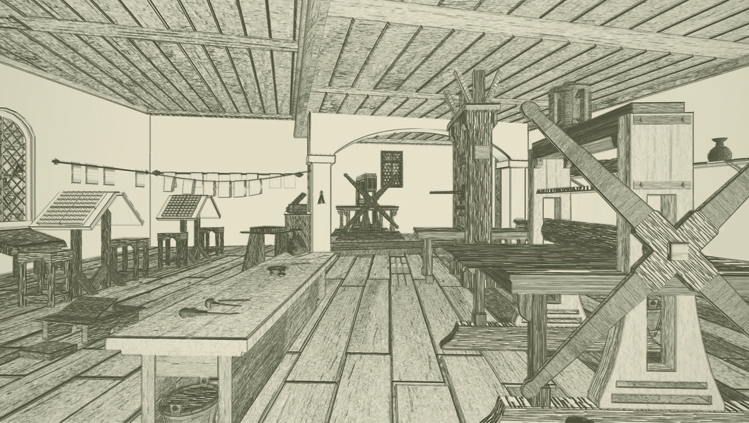
____________________________________________________________________________________
CURRENT EXHIBITION
Kleinmeister. The Legacy of Dürer in the Mariano Moret Collection València Fine Arts Museum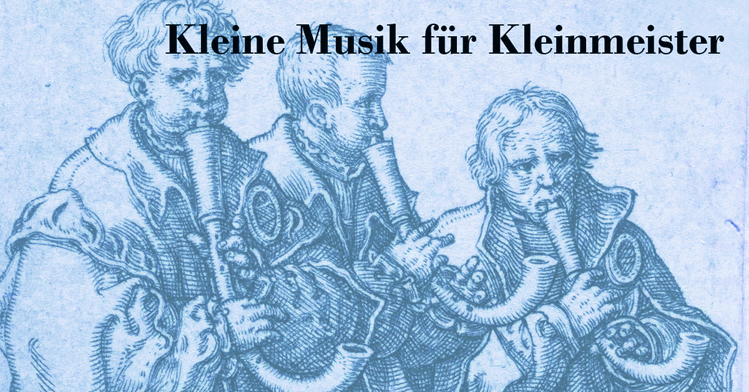
27/05/2018
Kleine Musik für Kleinmeister
Concert by Capella de Ministrers with a program of German Renaissance music specially created for the exhibition Kleinmeister. The legacy of Dürer in the Mariano Moret Collection. Little songs by Ludwig Senfl, Michael Praetorius, Melchior Vulpius, Johann Walter, Tielman Susato, Heinrich Isaac, Caspar Othmayr and Leonhard Lechner. Kleine Musik für Kleinmeister. Little music for the Little Masters.
The concert will take place in the Ambassador Vich's Courtyard. Admission is free until full capacity is reached.
The Ambassador Vich's Courtyard is a Renaissance cortile built around 1525 with Genoa marble for the palace of Jerónimo Vich y Valterra, ambassador of Ferdinand the Catholic in Rome. Located in Valencia, it is one of the first Renaissance buildings of the Iberian Peninsula.
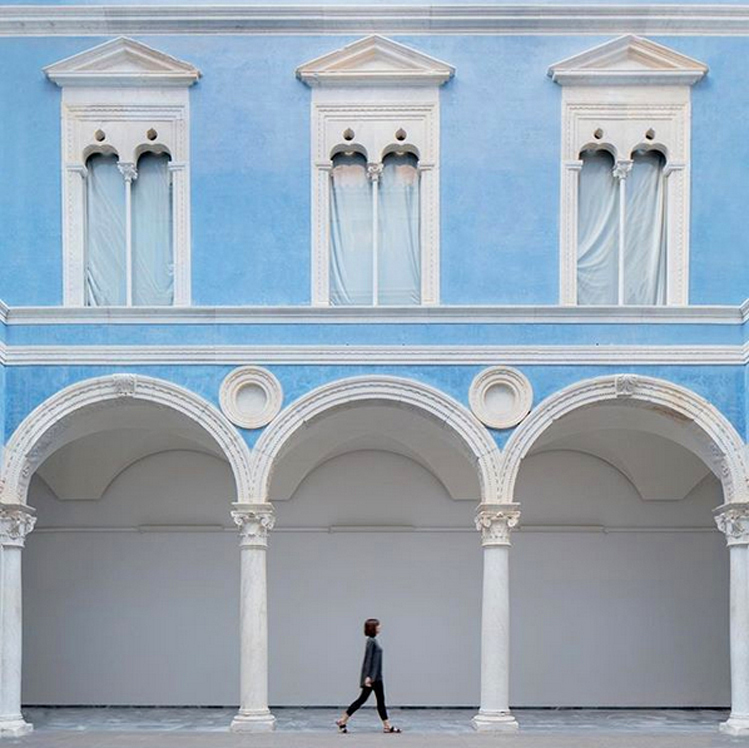
Ambassador Vich's Courtyard. València Fine Arts Museum
____________________________________________________________________________________
CURRENT EXHIBITIONKleinmeister. The Legacy of Dürer in the Mariano Moret Collection València Fine Arts Museum
17/05/2018
Exhibition inaugural event. Kleinmeister: The Legacy of Dürer in the Mariano Moret Collection.
On May 17, the Kleinmeister exhibition was inaugurated at the València Fine Arts Museum. The inauguration was attended by the Honorary Consul of Germany in Valencia, D. Gaspar Ripoll, the director of the València Fine Arts Museum, Mr. Jose Ignacio Casar Pinazo, Mrs. María José Navarro Toledo, President of Asociación de Amigos del Museo de Bellas Artes de València and Mr. Mariano Moret, curator of the exhibition and lender of a large part of the exhibited works. Among the numerous audience was a broad representation of the world of Valencian art and culture, among which we must highlight the President of the Royal Academy of Fine Arts of San Carlos, Mr. Manuel Muñoz Ibáñez, Mr. Carles Magraner, President of the CdM Capella de Ministrers Foundation, Mr. Felipe Jerez, Director of the Department of Art History of the Universitat of València, Mr. José Galindo, Dean of the Faculty of Fine Arts of the Universitat of València and Mr. Ricardo Forriols, Director of the Cultural Activities Department of the Universitat de Politècnica de València.
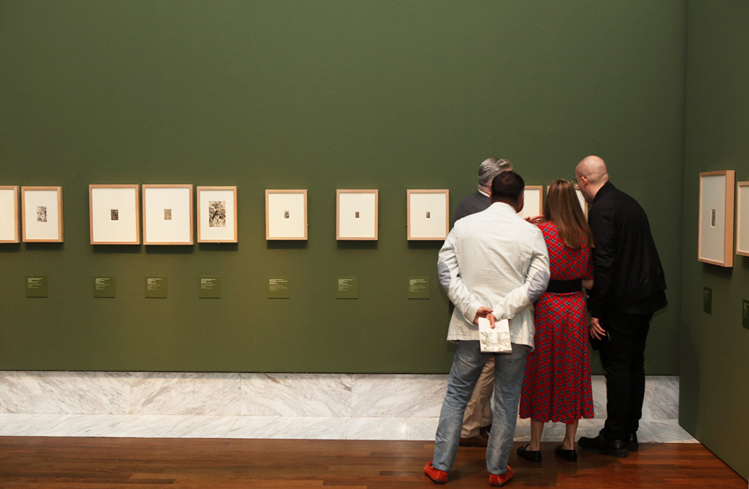 Photo Eduardo Alapont
Photo Eduardo Alapont ____________________________________________________________________________________
CURRENT EXHIBITION
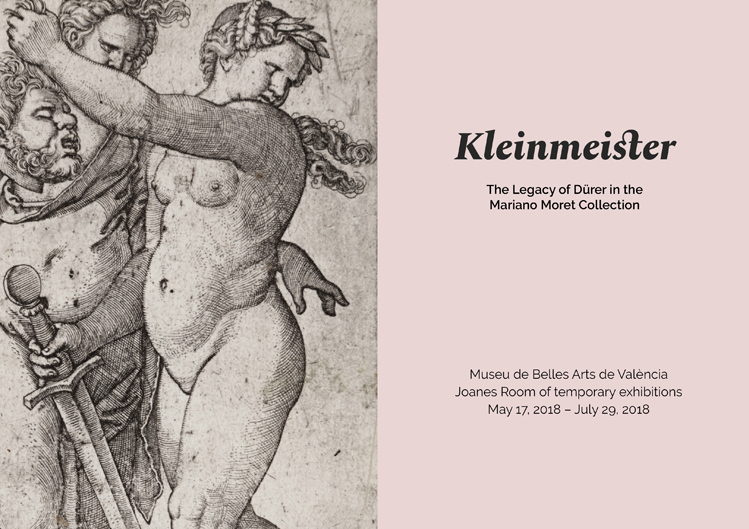
Kleinmeister. The Legacy of Dürer in the Mariano Moret Collection
València Fine Arts Museum Joanes Room of temporary exhibitions May 17, 2018 - July 29, 2018The transition from the fifteenth to the sixteenth century in Germany was marked by a series of important changes which brought the Middle Ages to a close and ushered in the Early Modern era, making the years around the turn of the century a fascinating period in history. Some of the factors that sparked off these transformations were the invention of printing by Gutenberg in 1440, the arrival in Germany of the innovations of the Renaissance, facilitated by Albrecht Dürer’s two journeys to Italy in 1494 and 1505, and the Protestant Reformation set in motion by Luther in 1517 when he nailed his 95 theses against indulgences to the door of the church in Wittenberg. All these events helped to bring about a golden age of printmaking in Germany, whose presiding genius was incontestably Dürer, one of the most important printmakers in history. His virtuosity and revolutionary technical discoveries expanded the possibilities of this art to previously unsuspected limits, especially when we consider that this young artistic discipline had emerged only a few decades before. Around Dürer, in the thriving city of Nuremberg, arose an important group of printmakers known as the Little Masters (Kleinmeister), who included the Beham brothers, Georg Pencz and Heinrich Aldegrever. These artists also contributed decisively to the brilliance of that crucial period in the history of printmaking. The Little Masters were characterised by producing prints in small formats, many of them true miniatures, which required enormous technical skill to execute. They depicted a wide variety of subjects in their works, from the most canonical and elevated, such as biblical or mythological scenes, to the most worldly and popular, such as representations of everyday life which gave rise to some of the first genre scenes in the history of art. Among their works we also find prints that were highly controversial for their markedly erotic content, as well as numerous ornament prints which radiate exuberant creativity and fantasy. The lives of the Little Masters, true citizens of their time, were as turbulent and enthralling as the age in which they found themselves living, and this shines through in their artistic creations, adding to their appeal.
Through 141 works — 127 prints by various German artists belonging to the Mariano Moret Collection and 14 by Dürer from the Biblioteca Nacional de España — the Kleinmeister exhibition offers a wide-ranging overview of this fascinating period of art history. This is the first time a Spanish museum has devoted an exhibition exclusively to the work of the Little Masters.
It also presents an important series of prints by the Hopfers, a family of printmakers credited with inventing etching. This complex intaglio technique was to be the form of expression favoured by future geniuses of printmaking such as Rembrandt, Piranesi and Goya.
____________________________________________________________________________________
PAUL ANDROUET DU CERCEAU ORNAMENTAL FLOWERS AND FRENCH JEWELRY IN THE 18TH CENTURY
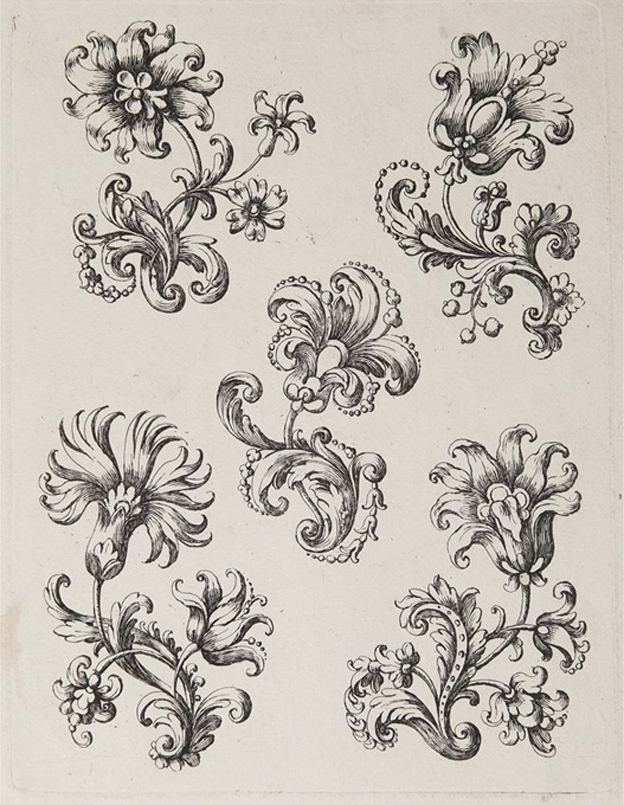 Paul Androuet du Cerceau. Bouquets de Fleurs a la Persienne. Etching, c.1670-1690. Colección Mariano Moret
Paul Androuet du Cerceau. Bouquets de Fleurs a la Persienne. Etching, c.1670-1690. Colección Mariano Moret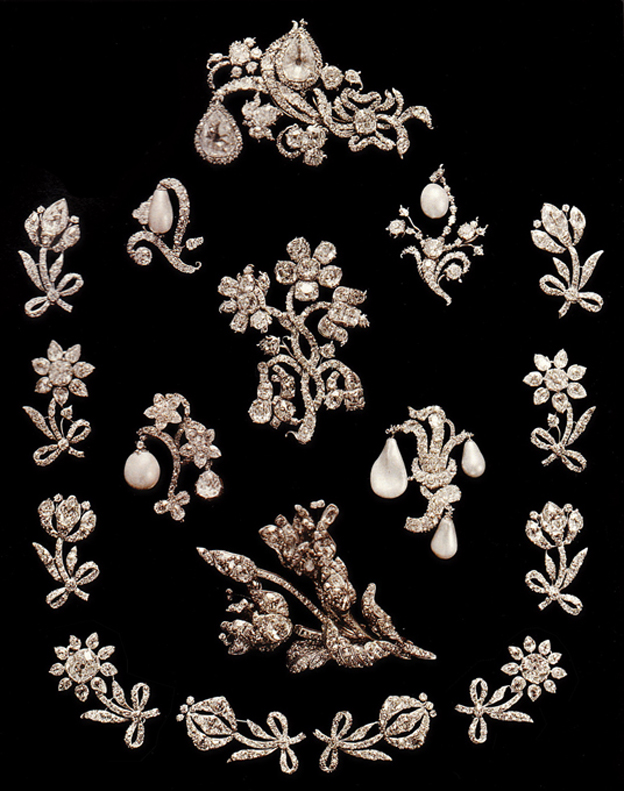 Antique pieces of jewellery including solid silver flowers typical of the decorations that were sewn on the clothes of Russian empresses. In the centre are aigrettes set with diamonds and pearls, c.1770. The Jewels of the Romanovs. Stefano Papi
Antique pieces of jewellery including solid silver flowers typical of the decorations that were sewn on the clothes of Russian empresses. In the centre are aigrettes set with diamonds and pearls, c.1770. The Jewels of the Romanovs. Stefano Papi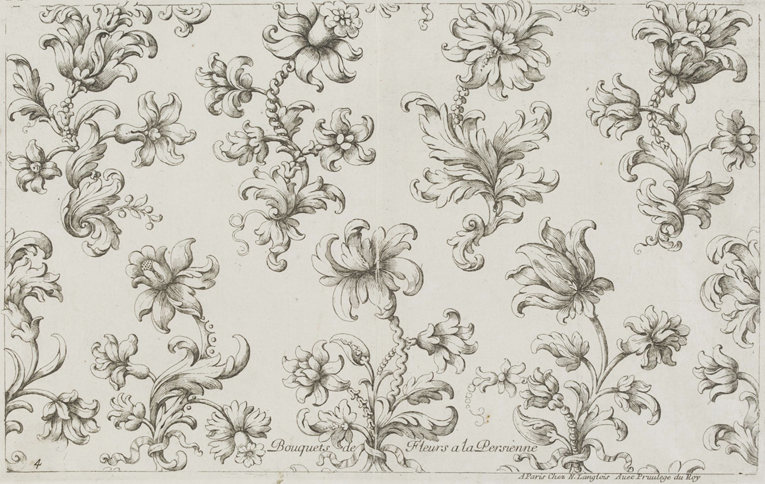 Paul Androuet du Cerceau. Bouquets de Fleurs a la Persienne. Etching, c.1670-1685. Victoria and Albert Museum
Paul Androuet du Cerceau. Bouquets de Fleurs a la Persienne. Etching, c.1670-1685. Victoria and Albert Museum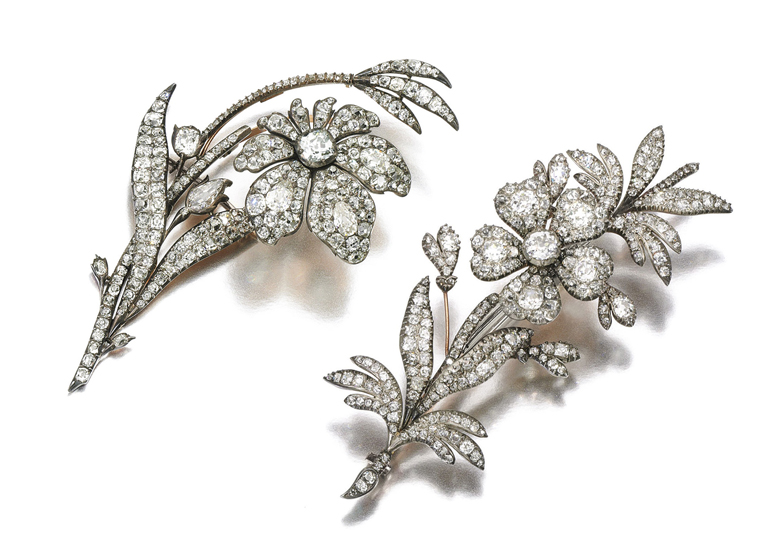 Moving 'trembleuse' diamond flower brooches, c.1800
Moving 'trembleuse' diamond flower brooches, c.1800_____________________________________________________________________________________
The Mariano Moret Collection has embarked in the last two years on an ambitious acquisitions program that has resulted in a very important increase of the funds that compose the collection. Works as important as the 35 prints of Toonneel des Wereldts Ontdeckende De Ongestuymigheden in Ydelheden (Sample of the Vanity and the Variety of the World) by Pieter Bruegel, unique in a Spanish collection, the Morris Dancers by Daniel Hopfer, various rare prints by Lucas van Leyden as The Suicide of Lucretia, Woman with the Hind and The Surgeon, among others, as well as two important groups of German Renaissance prints and ornamental prints, all them make the Mariano Moret Collection the reference collection in Spain for the study of capital artists such as Lucas van Leyden and the Little Masters, as well as for the investigation of some topics associated with the diffusion of the printed image as the Ornamental Print and the Weibermacht or the Power of women:
Aldegrever, Heinrich. A foot soldier holding a fire pan and a bucket Aldegrever, Heinrich. Ornamental design with two putti standing at the base of a vase Androuet du Cerceau, Paul. Five embroidery designs consisting of stylized flowers Anonymous. Ornamental frieze with pastoral scenes Anonymous. Ausschneidebogen' wth riverside landscapes (2 plates) Anonymous. Two heads of Antique warriors Beham, Hans Sebald. A peasant at market Beham, Hans Sebald. A sleeping girl with a dog Beham, Hans Sebald. Triumf der edelen sighaften Weiber Beham, Hans Sebald. Eines Weibes Haupt Beham, Hans Sebald (after). Eight nude children Beham, Hans Sebald. Ornament panel with a male grotesque half-length figure Beham, Hans Sebald. David and Abishag Binck, Jacob. The witch attacking the devil Bourguet, Jean. Grotesque figures with ornaments design in blackwork Boyvin, René (attributed to). Design for ewer Callot, Jacques. Les Gobbi (5 plates) Callot, Jacques (after). Les Gobbi (9 plates) Callot, Jacques (after). Various independant scenes (2 plates) de Bry, Johann Theodor. Emblemata Saecularia (4 plates) de Bry, Theodor. A gunner besides an empty banderole and heraldic shield Demachy, Pierre (after). El Bolero de Wit, Frederick. Triumph of David Dugourc, Jean Démosthène. Le Feau Galestruzzi, Giovanni Battista. Trofei di Polidoro disegnati dall'originale (3 plates) Goya, Francisco de. The Drunkards (after Velázquez) Hoefnagel, Joris. Scarabei umbra Hopfer, Daniel. Design for an ornate cupboard Hopfer, Daniel. Ten friezes arranged horizontally with vine, masks, etc. Hopfer, Daniel. Ornament panel with various ceiling designs Hopfer, Daniel. Upright ornament panel with two peacocks Hopfer, Daniel. Carnival Hopfer, Daniel. Design for the capital and base of a column Hopfer, Hieronymus. The three prisoners Hopfer, Lambrecht. Christ crowned with thorns Jacquard, Antoine. Dial of watch dial with mythological scene Le Pautre, Jean. Study of ceiling decoration with Aeneas fleeing Troy Maglioli, Giovanni Andrea. Sea monster with a water fowl in its mouth Monogrammist AP. Plate depicting lower part of a Roman pilaster Monogrammist BL. Two panels with grotesque figures Monogrammist RDS. Christ before Caiaphas Muntinck, Adriaen. Two ornamental borders with insects and birds of different species Parrocel, Joseph. Flight into Egypt Pencz, Georg. Burying the dead Pencz, Georg. Judith with the head of Holofernes Pfeffel, Johann Andreas I. Designs for Jewelry and book cover Pfeffel, Johann Andreas I. Festoon design with flowers and bows Saly, Jacques. Vase decorated with two tritons Schmidt, Christoph. Ornament with eagle and other birds among foliage Solis, Virgil. Ornament panel with two Sirens Solis, Virgil. Leaf ornament panel Solis, Virgil. The death of Samson Solis, Virgil. Dancers and Musicians (6 plates) Toutin, Jean. A king holding sword and shield design in blackwork with pea pods van Doetechum, Johannes and Lucas after Pieter Bruegel. Toonneel des Wereldts... (35 plates) van Leyden, Lucas. The Raising of Lazarus van Leyden, Lucas. Woman with the Hind van Leyden, Lucas. Herod and Herodias van Leyden, Lucas. The Suicide of Lucretia van Leyden, Lucas. The Surgeon van Leyden, Lucas. Ornament with two Dolphins van Leyden, Lucas (after). Judas Thaddaeus van Leyden, Lucas (after). St. Peter Vauquer, Jean (after). Design for watchcase with scene of Joseph and Potiphar's wife Vico, Enea. Grotesque panel all´antica Wolgemut, Michael. The Heavenly Chorus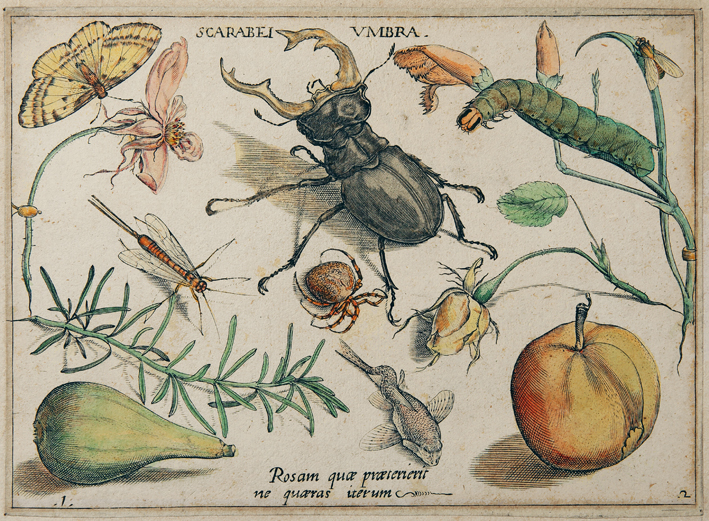 Jacob Joris Hoefnagel. Scarabei umbra. Hand-coloured engraving, 1592. Colección Mariano Moret
Jacob Joris Hoefnagel. Scarabei umbra. Hand-coloured engraving, 1592. Colección Mariano Moret___________________________________________________________________________________
THEME & VARIATIONS: GRYLLUS
Pliny the Elder uses the word Gryllus in his Natural History for a class of grotesque figures first used in painting by Antiphilus of Alexandria who painted a figure in a ridiculous costume, known jocosely as the Gryllus. The word Gryllus is commonly used to denote any grotesque monster which is made up by several human and animal heads. It can be a combination of animal and man, or dualities of male and female, old and young. A transmutation of souls, manifested into a single magical entity. These fantastic devices were more than mere artists' fancies and were used as Talismans and Amulets according to the ideas they portrayed, being sometimes Astrological in their significance and at other times representative of some form of Grecian or Roman religion. Plutarch writes that these composite objects were fixed up to ward off witchcraft and the evil effects of the first glance of the Evil Eye, it being thought that if the mischief-working eye could be diverted from the object to be protected on to the strange and ridiculous figures represented by the Grylli the glance would be absorbed and its effects destroyed.
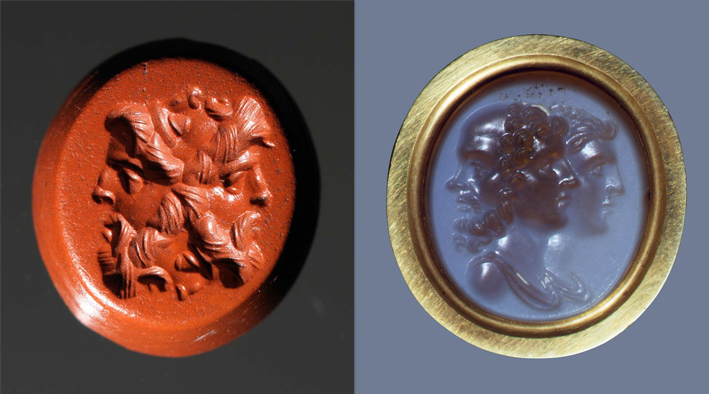 Gryllus. Four heads conjoined. Carnelian intaglio. Roman Imperial 1st-2nd century AD. Michael C. Carlos Museum Gryllus. Heads of Silenus, a Satyr and a Maenad. Onyx intaglio. France, 17th century The State Ermitage Museum
Gryllus. Four heads conjoined. Carnelian intaglio. Roman Imperial 1st-2nd century AD. Michael C. Carlos Museum Gryllus. Heads of Silenus, a Satyr and a Maenad. Onyx intaglio. France, 17th century The State Ermitage Museum 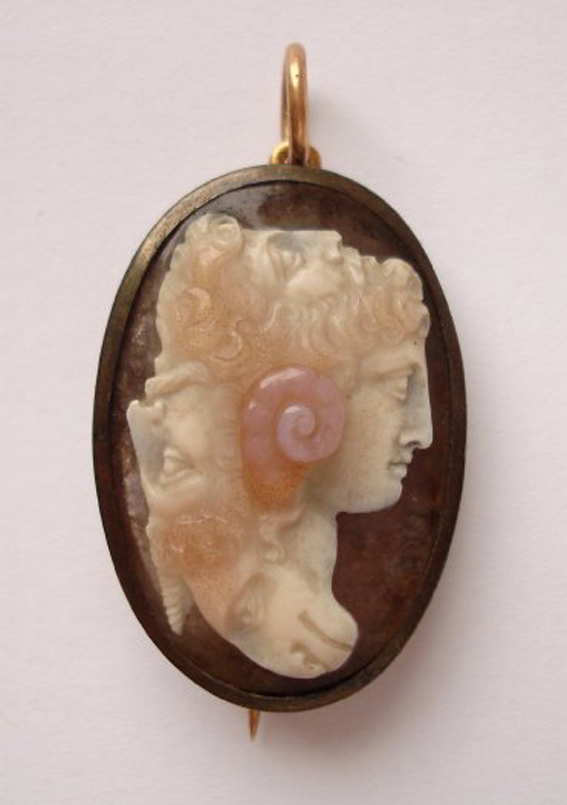 Gryllus. Four heads conjoined. Sardonyx cameo, 16th century. British Museum
Gryllus. Four heads conjoined. Sardonyx cameo, 16th century. British Museum 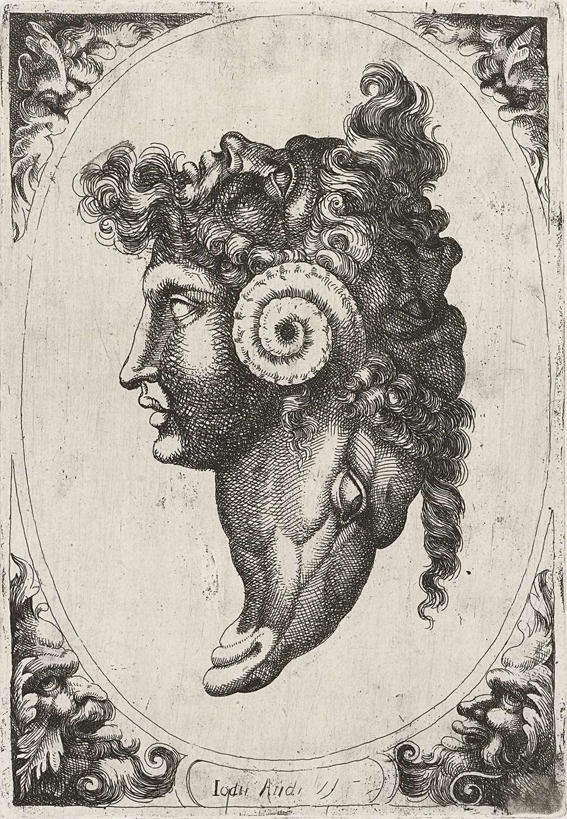 Giovanni Andrea Maglioli. Composition of three faces and a ram´s head. Etching, c. 1580-1610. Rijksmuseum
Giovanni Andrea Maglioli. Composition of three faces and a ram´s head. Etching, c. 1580-1610. Rijksmuseum 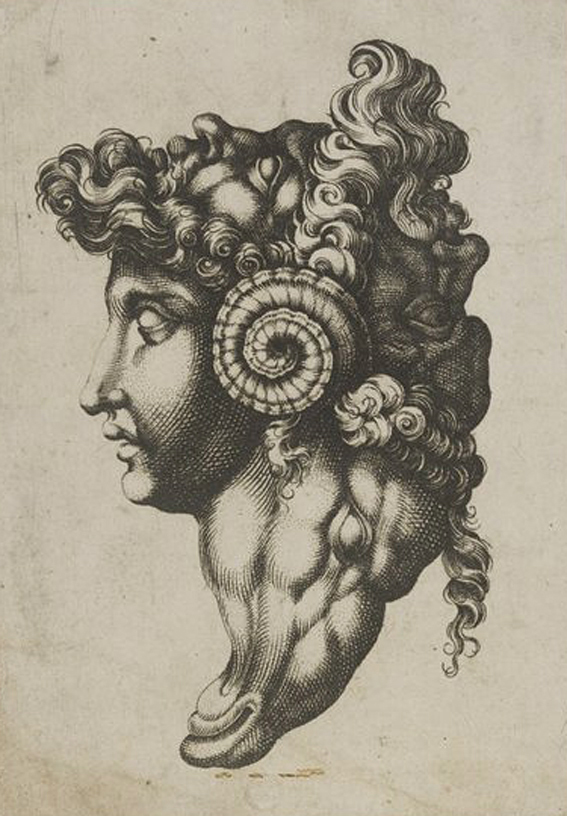 Giovanni Andrea Maglioli. Archimboldesque head. Engraving, c. 1580-1610. Victoria and Albert Museum
Giovanni Andrea Maglioli. Archimboldesque head. Engraving, c. 1580-1610. Victoria and Albert Museum 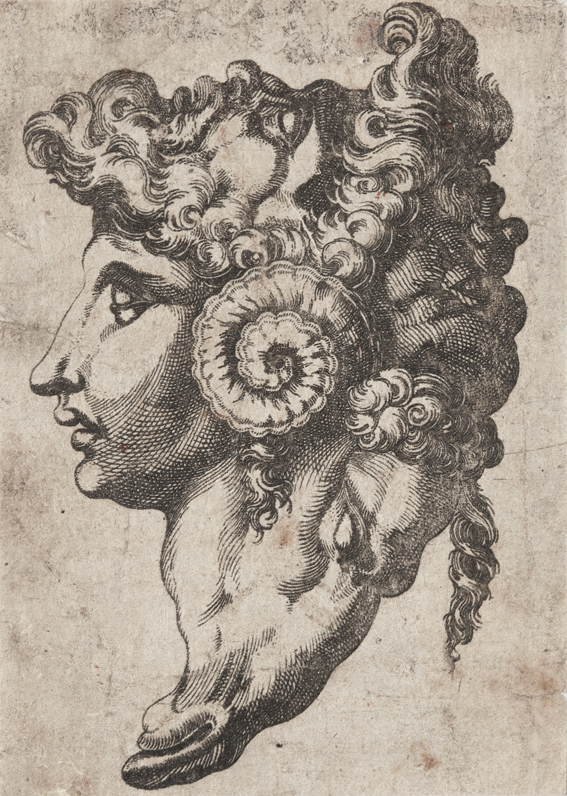 (?) Giovanni Andrea Maglioli. Gryllus. Engraving, c. 1580-1610. Colección Mariano Moret
(?) Giovanni Andrea Maglioli. Gryllus. Engraving, c. 1580-1610. Colección Mariano Moret 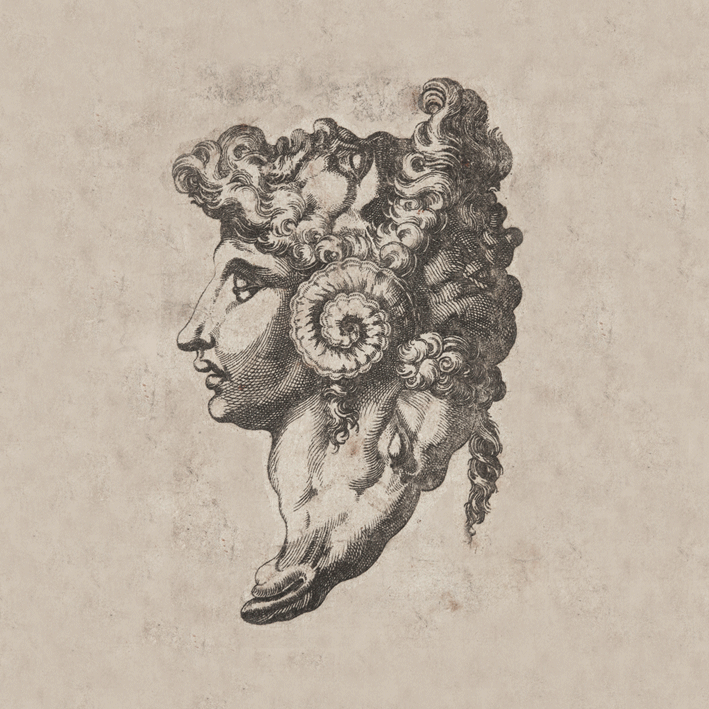
________________________________________________________________________________________________________________
THEME & VARIATIONS: THE APOSTOLATE OF SAN VICTORIÁNThe Diocesan Museum of Barbastro-Monzón shows a series of 14 anonymous paintings representing the Twelve Apostles, Christ Savior and the Virgin Mary. The paintings come from the Monastery of San Victorián and were painted in the 17th century by an anonymous artist. It is a series that accurately reproduces some of the engravings from the Creed series by Hendrik Goltzius.
Link to the Barbastro-Monzón Docesan Museum
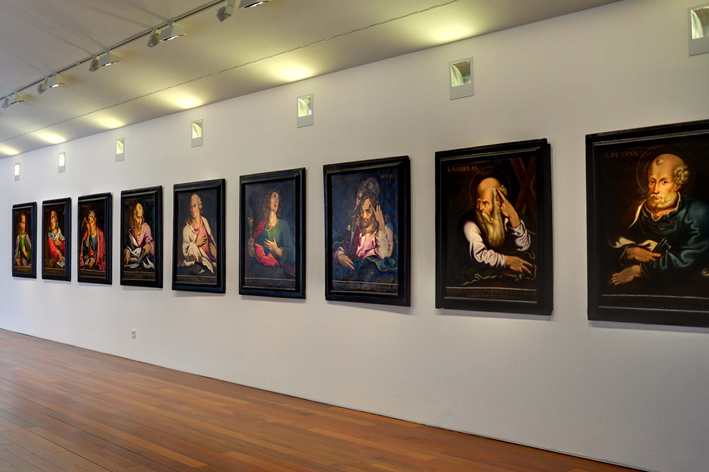 Anonymous. The Apostolate of San Victorián, c.1660. Museo Diocesano de Barbastro-Monzón
Anonymous. The Apostolate of San Victorián, c.1660. Museo Diocesano de Barbastro-Monzón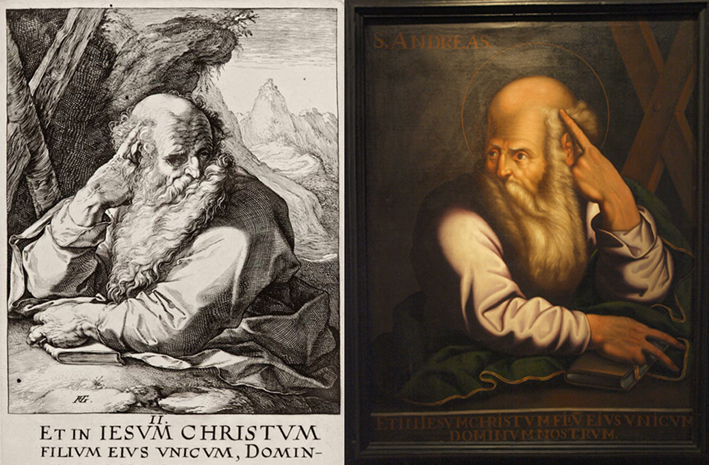 Hendrik Goltzius. St Andrew. Engraving, 1589. Colección Mariano Moret Anonymous. St Andrew. Oil on canvas, c.1660. Museo Diocesano de Barbastro-Monzón
Hendrik Goltzius. St Andrew. Engraving, 1589. Colección Mariano Moret Anonymous. St Andrew. Oil on canvas, c.1660. Museo Diocesano de Barbastro-Monzón 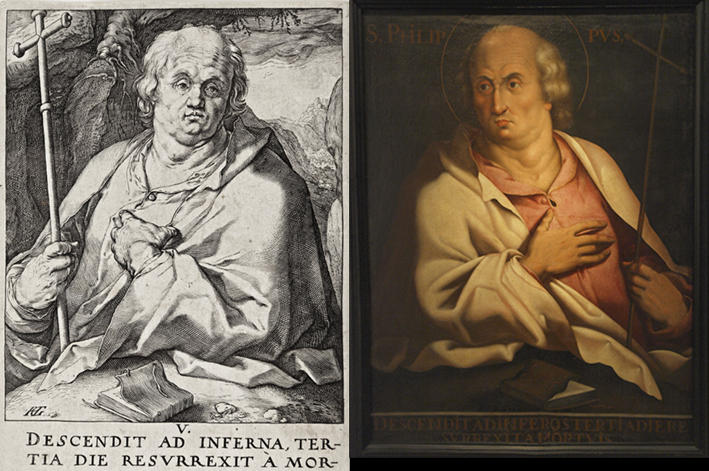 Hendrik Goltzius. St Philip. Engraving, 1589. Colección Mariano Moret Anonymous. St Philip. Oil on canvas, c.1660. Museo Diocesano de Barbastro-Monzón
Hendrik Goltzius. St Philip. Engraving, 1589. Colección Mariano Moret Anonymous. St Philip. Oil on canvas, c.1660. Museo Diocesano de Barbastro-Monzón
_______________________________________________________________________________________________________________
#AskACurator DAY 2017If you have ever had a burning question about the Mariano Moret Collection, now is your chance to ask. We are excited to be among more than 1400 museums from 57 countries participating in #AskACurator Day on Sept 13 2017. Tweet your questions to @ColeccionMMoret and make sure to use the #AskACurator hashtag.
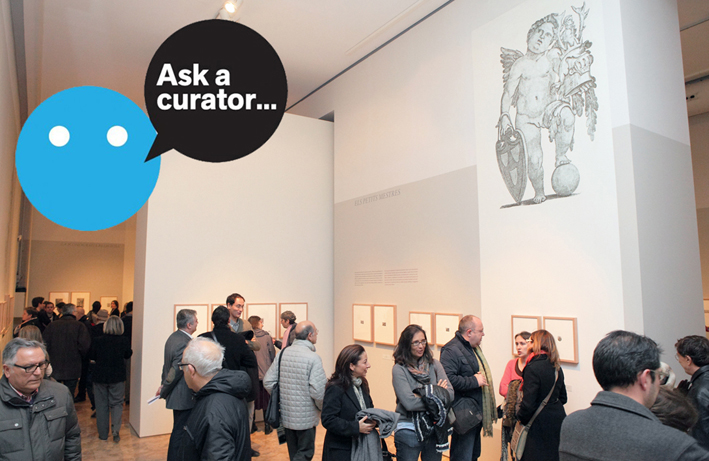
_______________________________________________________________________________________________________________
CURRENT EXHIBITION ANZO. Isolation IVAM, Institut Valencià d'Art Modern. G7 Gallery Valencia, June 29 to November 05, 2017The Mariano Moret Collection has loaned three Anzo works to a major retrospective of the artist at the IVAM.
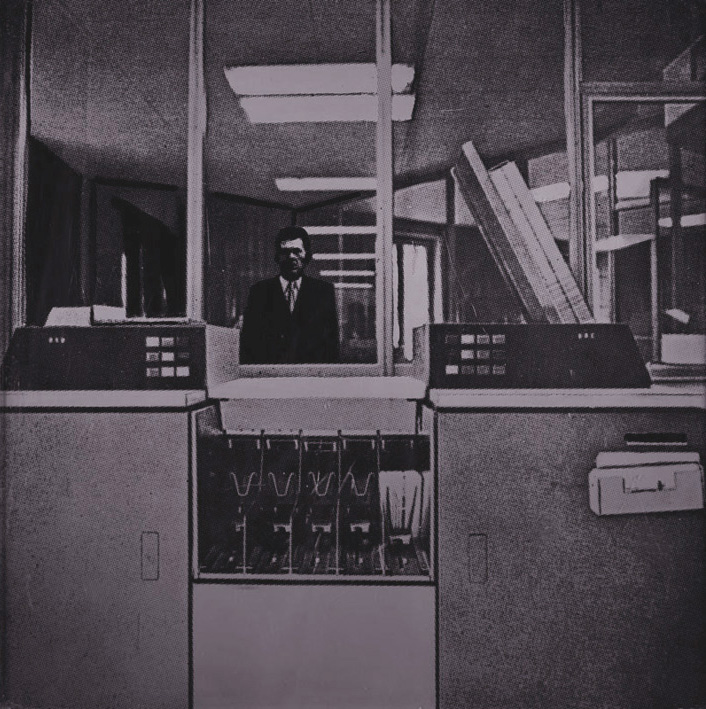 ANZO (José Iranzo Almonacid). Isolation 78. Photo lithography, 1971. Colección Mariano Moret
ANZO (José Iranzo Almonacid). Isolation 78. Photo lithography, 1971. Colección Mariano Moret 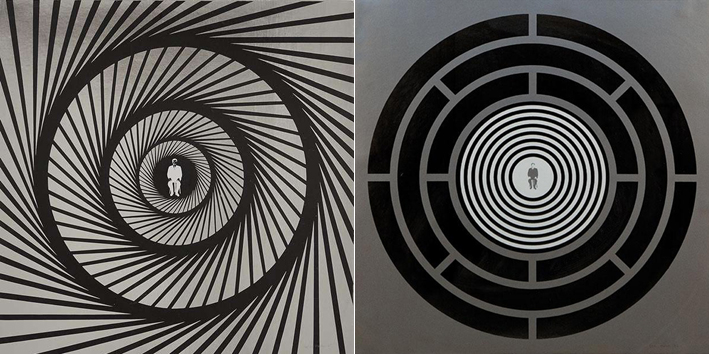 ANZO (José Iranzo Almonacid). Isolation S-17. Screen printing on silver metallic paper, 1973. Colección Mariano Moret ANZO (José Iranzo Almonacid). Isolation S-16. Screen printing on silver metallic paper, 1974. Colección Mariano Moret
ANZO (José Iranzo Almonacid). Isolation S-17. Screen printing on silver metallic paper, 1973. Colección Mariano Moret ANZO (José Iranzo Almonacid). Isolation S-16. Screen printing on silver metallic paper, 1974. Colección Mariano Moret
_______________________________________________________________________________________________________________
THEME & VARIATIONS: WEIBERMACHT OR THE POWER OF WOMENThe richness and variety of the works that compose the Mariano Moret Collection allows diverse approaches to it from various plot lines and from different points of view. To this end, we have created several thematic sections that allow a deeper knowledge of the collection, in addition to the classification of works by schools. The first thematic sections are Ornament and Weibermacht or the Power of Women, and soon they will be added more thematic units.
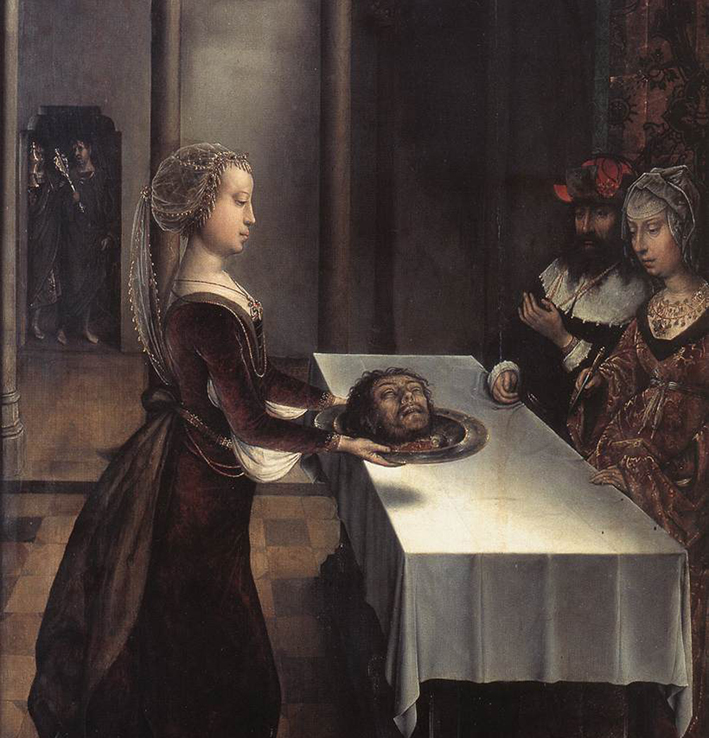 Juan de Flandes. Herodias' Revenge (detail). Oil on panel, 1496. Museum Mayer van den Bergh
Juan de Flandes. Herodias' Revenge (detail). Oil on panel, 1496. Museum Mayer van den Bergh 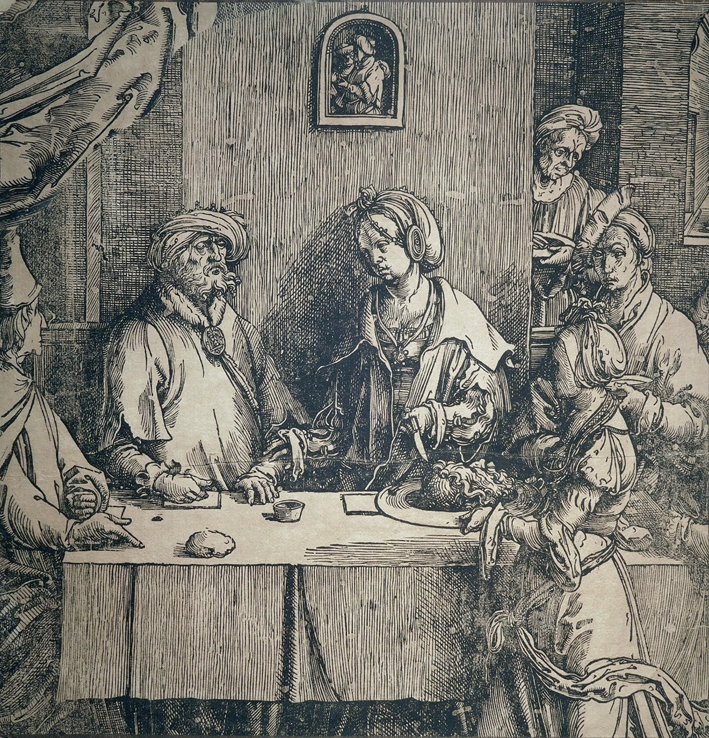 Lucas van Leyden. Herod and Herodias (detail). Woodcut, c.1512. Colección Mariano Moret _______________________________________________________________________________________________________________ THE ENIGMATIC QMS MONOGRAM
Lucas van Leyden. Herod and Herodias (detail). Woodcut, c.1512. Colección Mariano Moret _______________________________________________________________________________________________________________ THE ENIGMATIC QMS MONOGRAM This rare engraving by Theodor de Bry is the only known print that presents the mysterious monogram QMS, a signature that has not been deciphered.
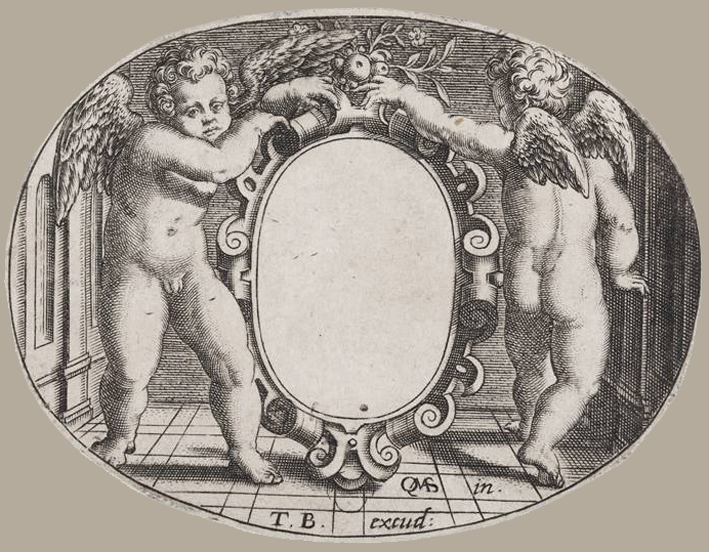 Theodor de Bry. Two genii holding an escutcheon. Engraving, c.1580-1598. Colección Mariano Moret
Theodor de Bry. Two genii holding an escutcheon. Engraving, c.1580-1598. Colección Mariano Moret  Francois Brulliot. Dictionnaire des monogrammes, marques figurées, lettres initiales, noms, abrégés. Munich, 1882
Francois Brulliot. Dictionnaire des monogrammes, marques figurées, lettres initiales, noms, abrégés. Munich, 1882 
Engravings, etchings and woodcuts by old and modern masters being part II of the Levy collection to be sold at unrestricted public sale on March 29th and 30th, 1916 under the management of the American Art Association Art Galleries. Madison Square South. New York
__________________________________________________________________________________________________________ THEME & VARIATIONS: JOSEPH INTERPRETATING PHARAOH´S DREAMS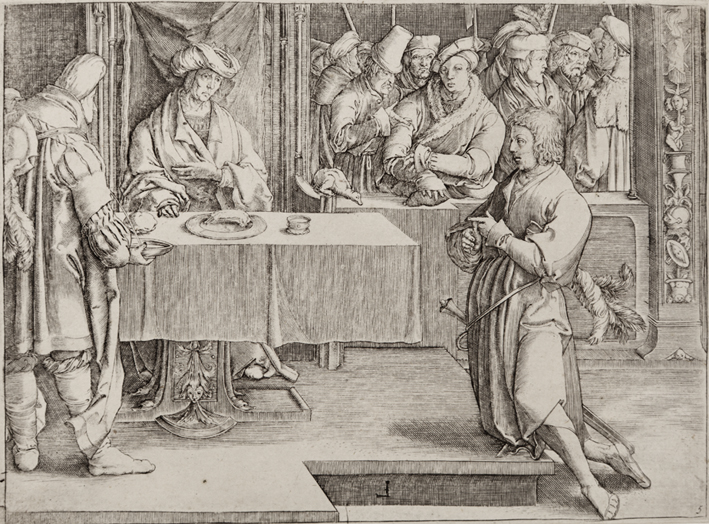 Anonymous reverse copy after Lucas van Leyden. Joseph interpreting Pharaoh's dreams. Engraving, c. 1520-1540. Colección Mariano Moret.
Anonymous reverse copy after Lucas van Leyden. Joseph interpreting Pharaoh's dreams. Engraving, c. 1520-1540. Colección Mariano Moret. 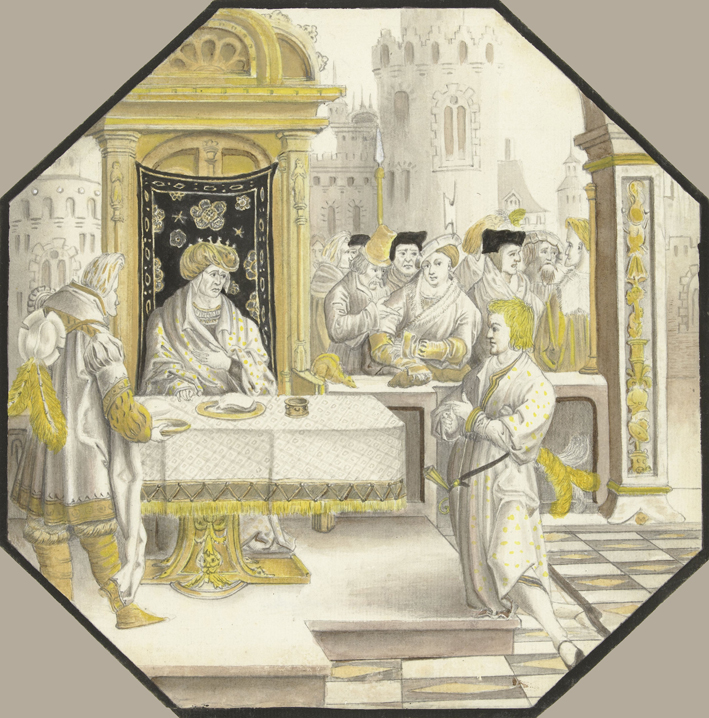 Anonymous draughtsman after Lucas van Leyden. Joseph interpreting Pharaoh's dreams (design for stained glass).Pen and brown ink, with watercolour, c.1512. Rijksmuseum _________________________________________________________________________________________________________ THEME & VARIATIONS: LUCAS VAN LEYDEN AT WINDSOR CASTLE
Anonymous draughtsman after Lucas van Leyden. Joseph interpreting Pharaoh's dreams (design for stained glass).Pen and brown ink, with watercolour, c.1512. Rijksmuseum _________________________________________________________________________________________________________ THEME & VARIATIONS: LUCAS VAN LEYDEN AT WINDSOR CASTLE 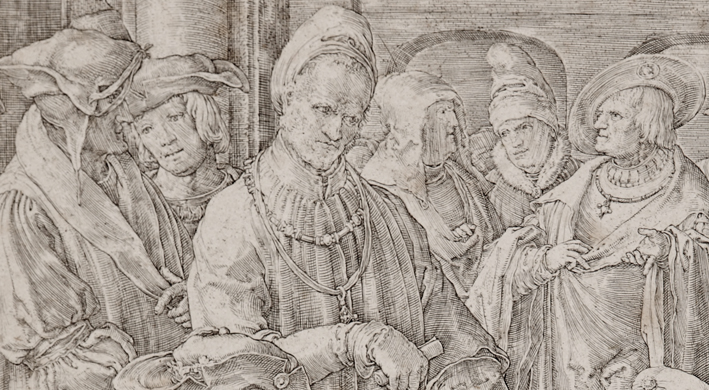 Anonymous reverse copy after Lucas van Leyden. Joseph interpreting Pharaoh's dreams (detail). Engraving, c.1520-1540. Colección Mariano Moret.
Anonymous reverse copy after Lucas van Leyden. Joseph interpreting Pharaoh's dreams (detail). Engraving, c.1520-1540. Colección Mariano Moret. 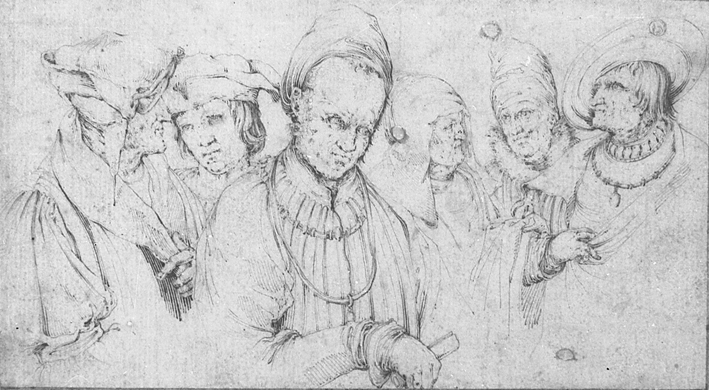 After Lucas van Leyden. Six almost half-length male figures. Pen and brown ink, c.1518. Royal Collection Trust,Windsor Castle _________________________________________________________________________________________________________ GOD IS IN THE DETAILS: THE ARNOLFINI PATTENS
After Lucas van Leyden. Six almost half-length male figures. Pen and brown ink, c.1518. Royal Collection Trust,Windsor Castle _________________________________________________________________________________________________________ GOD IS IN THE DETAILS: THE ARNOLFINI PATTENS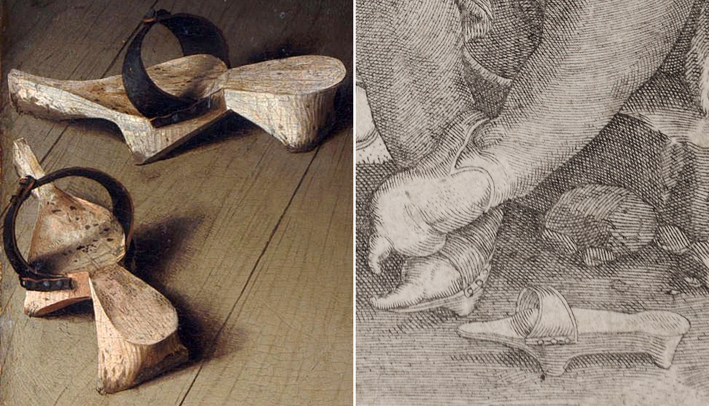 Jan van Eyck. The Arnolfini Portrai (detail). Oil on panel, 1434. The National Gallery
Jan van Eyck. The Arnolfini Portrai (detail). Oil on panel, 1434. The National Gallery Anonymous copy after Lucas van Leyden. The Musicians (detail). Engraving, c.1524. Colección Mariano Moret _________________________________________________________________________________________________________ THEME & VARIATIONS: THE PASSION BY LUCAS VAN LEYDEN
 Lucas van Leyden. Christ before Annas. Hand-colored engraving in a Prayer Book, 1521. Rijksmuseum Lucas van Leyden. Christ before Annas, from The Passion series. Engraving, 1521. Colección Mariano Moret
Lucas van Leyden. Christ before Annas. Hand-colored engraving in a Prayer Book, 1521. Rijksmuseum Lucas van Leyden. Christ before Annas, from The Passion series. Engraving, 1521. Colección Mariano Moret 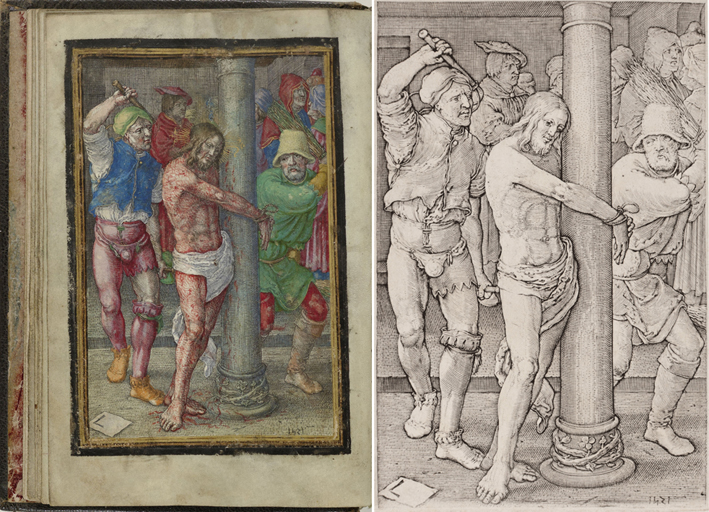 Lucas van Leyden. The Flagellation. Hand-colored engraving in a Prayer Book, 1521. Rijksmuseum Jan Harmensz Muller after Lucas van Leyden. The Flagellation, from The Passion series. Engraving, c.1615-1620. Colección Mariano Moret
Lucas van Leyden. The Flagellation. Hand-colored engraving in a Prayer Book, 1521. Rijksmuseum Jan Harmensz Muller after Lucas van Leyden. The Flagellation, from The Passion series. Engraving, c.1615-1620. Colección Mariano Moret 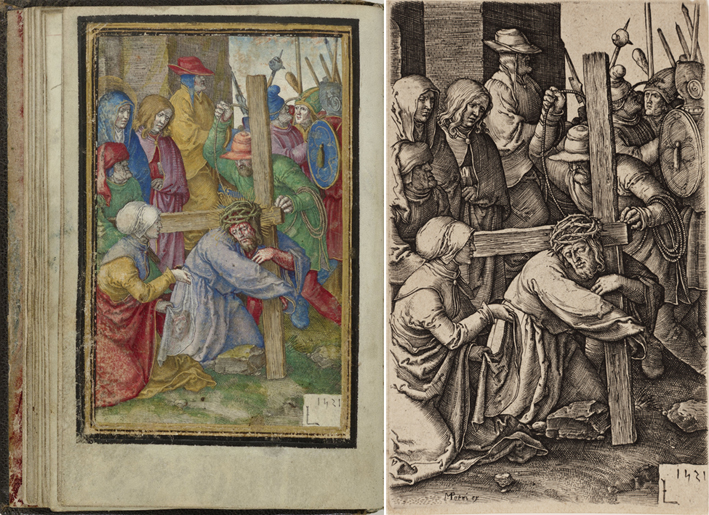 Lucas van Leyden. Christ Carrying the Cross. Hand-colored engraving in a Prayer Book, 1521. Rijksmuseum Lucas van Leyden. Christ Carrying the Cross, from The Passion series. Engraving, 1521. Colección Mariano Moret
Lucas van Leyden. Christ Carrying the Cross. Hand-colored engraving in a Prayer Book, 1521. Rijksmuseum Lucas van Leyden. Christ Carrying the Cross, from The Passion series. Engraving, 1521. Colección Mariano Moret 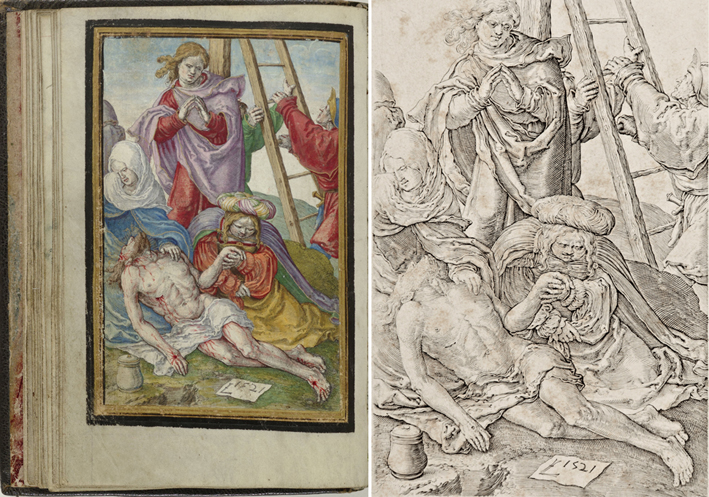 Lucas van Leyden. Descent from the Cross. Hand-colored engraving in a Prayer Book, 1521. Rijksmuseum Jan Harmensz Muller after Lucas van Leyden. Descent from the Cross, from The Passion series. Engraving,c.1615-1620. Colección Mariano Moret ________________________________________________________________________________________________________ THEME & VARIATIONS: THE MUSICIANS BY LUCAS VAN LEYDEN
Lucas van Leyden. Descent from the Cross. Hand-colored engraving in a Prayer Book, 1521. Rijksmuseum Jan Harmensz Muller after Lucas van Leyden. Descent from the Cross, from The Passion series. Engraving,c.1615-1620. Colección Mariano Moret ________________________________________________________________________________________________________ THEME & VARIATIONS: THE MUSICIANS BY LUCAS VAN LEYDEN 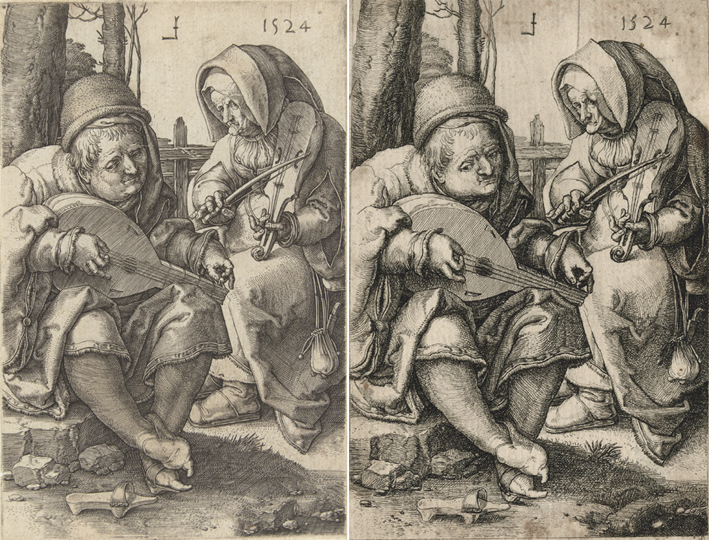 Lucas van Leyden. The Musicians. Engraving, 1524. Rijksmuseum Anonymous copy after Lucas van Leyden. The Musicians. Engraving, c.1550-1600. British Museum
Lucas van Leyden. The Musicians. Engraving, 1524. Rijksmuseum Anonymous copy after Lucas van Leyden. The Musicians. Engraving, c.1550-1600. British Museum 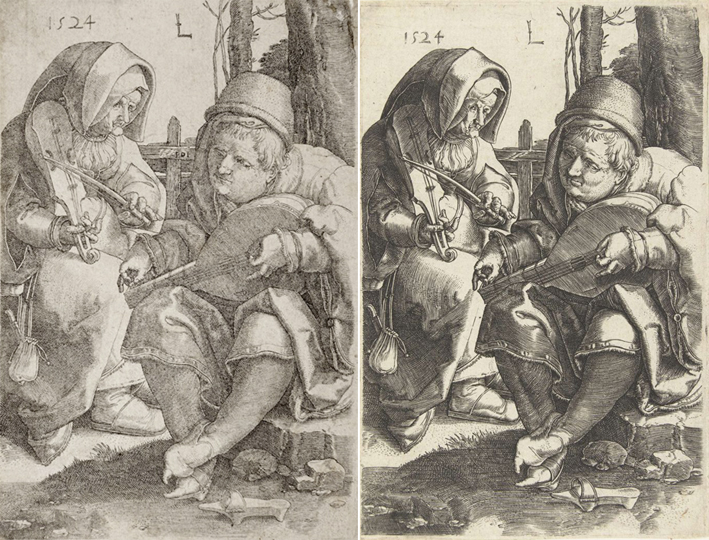 Anonymous reverse copy after Lucas van Leyden. The Musicians. Engraving, c.1524. Colección Mariano Moret Jan Harmensz Muller (manner of) after Lucas van Leyden. The Musicians. Engraving, c.1581-1628. Rijksmuseum
Anonymous reverse copy after Lucas van Leyden. The Musicians. Engraving, c.1524. Colección Mariano Moret Jan Harmensz Muller (manner of) after Lucas van Leyden. The Musicians. Engraving, c.1581-1628. Rijksmuseum 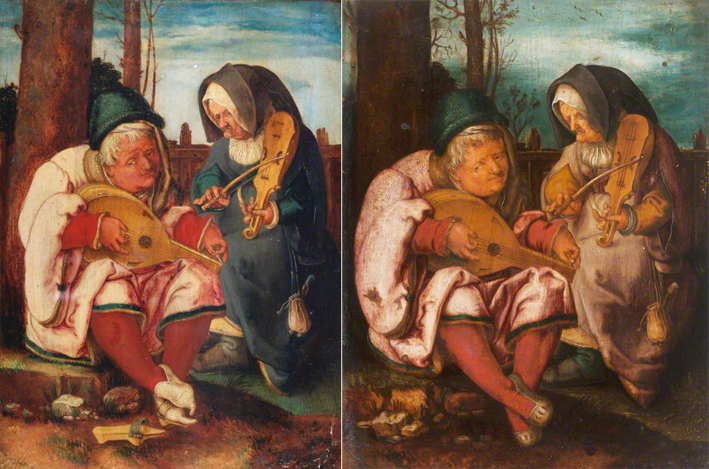 Anonymous after Lucas van Leyden. Musicians: An Old Man and an Old Woman. Oil on panel,c.1500-1599. Victoria and Albert Museum Anonymous after Lucas van Leyden. An Elderly Man and Woman playing Stringed Musical Instruments.Oil on copper, c.1500-1599. Dorneywood House
Anonymous after Lucas van Leyden. Musicians: An Old Man and an Old Woman. Oil on panel,c.1500-1599. Victoria and Albert Museum Anonymous after Lucas van Leyden. An Elderly Man and Woman playing Stringed Musical Instruments.Oil on copper, c.1500-1599. Dorneywood House 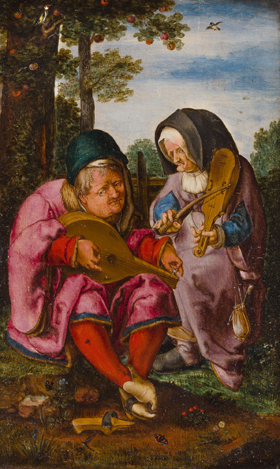 Anonymous after Lucas van Leyden.The Old Musicians. Oil on panel, c.1550.Karl & Faber _________________________________________________________________________________________________________
Anonymous after Lucas van Leyden.The Old Musicians. Oil on panel, c.1550.Karl & Faber _________________________________________________________________________________________________________ THE COMMANDER OF WISDOM
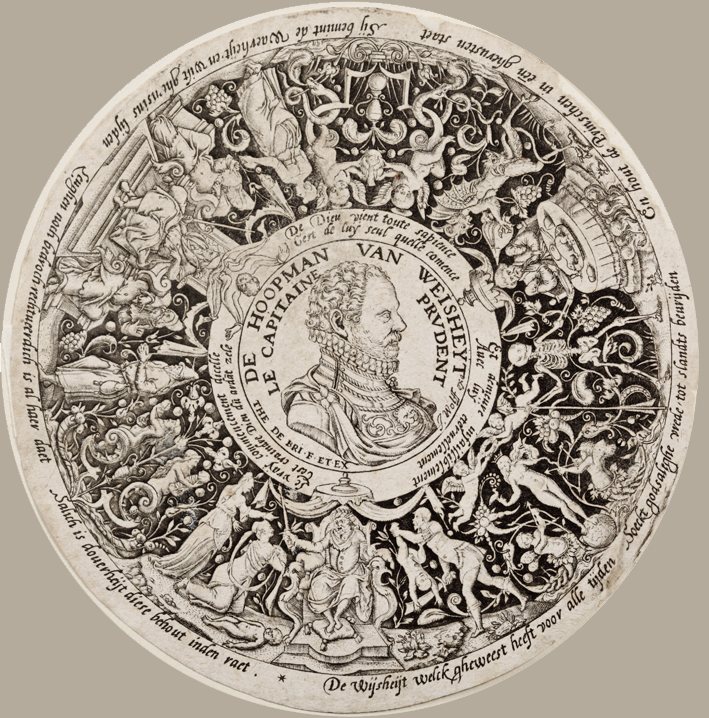 Theodor de Bry. Design for an engraved tazza with a portrait of William I of Orange as Commander of Wisdom. Engraving, c.1588. Colección Mariano Moret
Theodor de Bry. Design for an engraved tazza with a portrait of William I of Orange as Commander of Wisdom. Engraving, c.1588. Colección Mariano MoretThis design for an engraved tazza with a portrait of William I of Orange as Commander of Wisdom was engraved by Theodor de Bry as an exercise in political propaganda in which the figure of William of Orange-Nassau, leader of the Dutch troops who revolted against the Spanish Crow during the reign of Philip II, is praised. Together with the effigy of the rebel captain, his virtues are represented by various allegories.
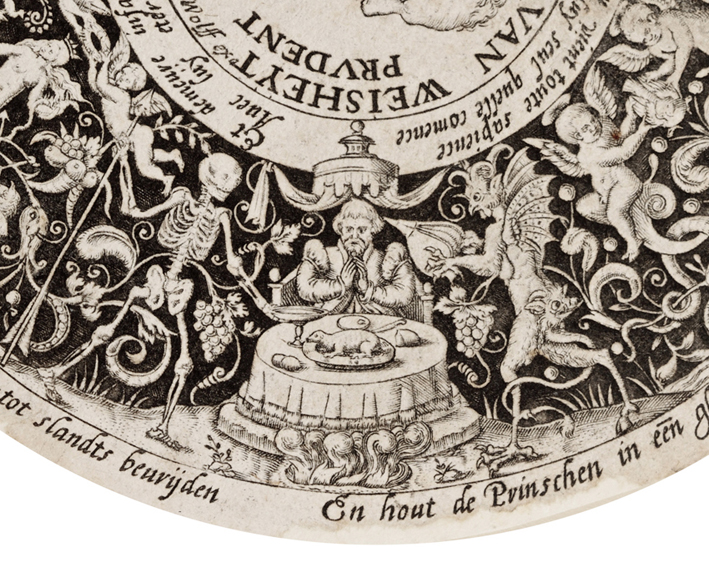 The Commander of Wisdom
The Commander of WisdomThe Commander of Wisdom is an allegory of the pious Prince who, through his devotion, overcomes Death and Temptation.
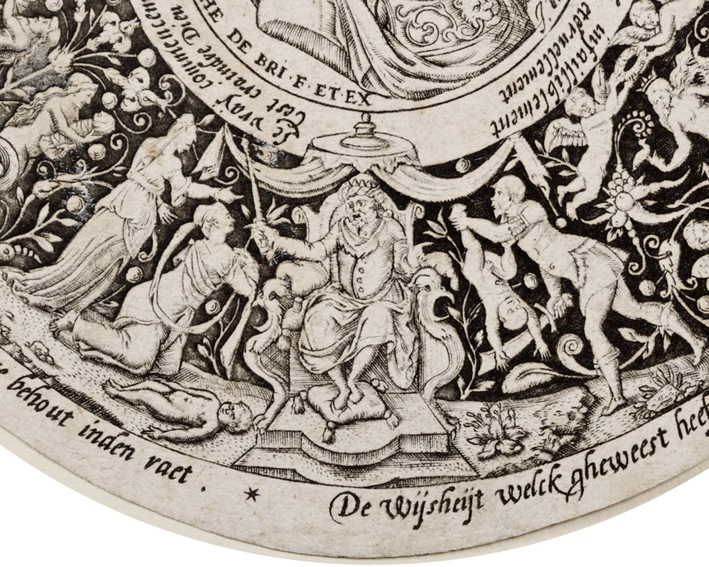 The Judgement of Solomon
The Judgement of Solomon The Judgment of Solomon is a story from the Hebrew Bible in which King Solomon of Israel ruled between two women both claiming to be the mother of a child by tricking the parties into revealing their true feelings. It has become an archetypal example of argument to moderation and that of an impartial judge displaying wisdom in making a ruling: Two mothers living in the same house, each the mother of an infant son, came to Solomon. One of the babies had died, and each claimed the remaining boy as her own. Calling for a sword, Solomon declared his judgment: the baby would be cut in two, each woman to receive half. One mother thought the ruling fair, but the other begged Solomon, "Give the baby to her, just don't kill him!" The king declared the second woman the true mother, as a mother would even give up her baby if that was necessary to save its life.
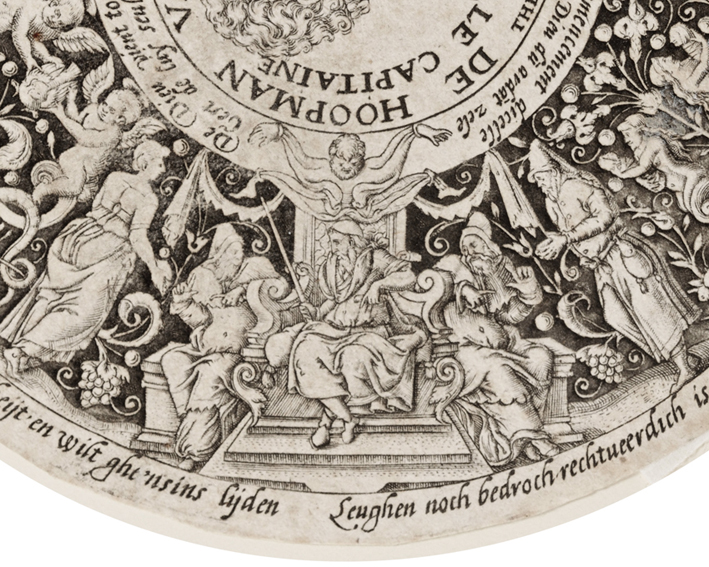 The Judgement of Cambyses
The Judgement of CambysesThe Judgement of Cambyses. According to Herodotus, Sisamnes was a corrupt judge under Cambyses II of Persia. He accepted a bribe and delivered an unjust verdict. As a result, the king had him arrested and flayed alive. His skin was then used to cover the seat in which his son would sit in judgment.
________________________________________________________________________________ THEME & VARIATIONS: CHRIST´S DESCENT INTO LIMBO
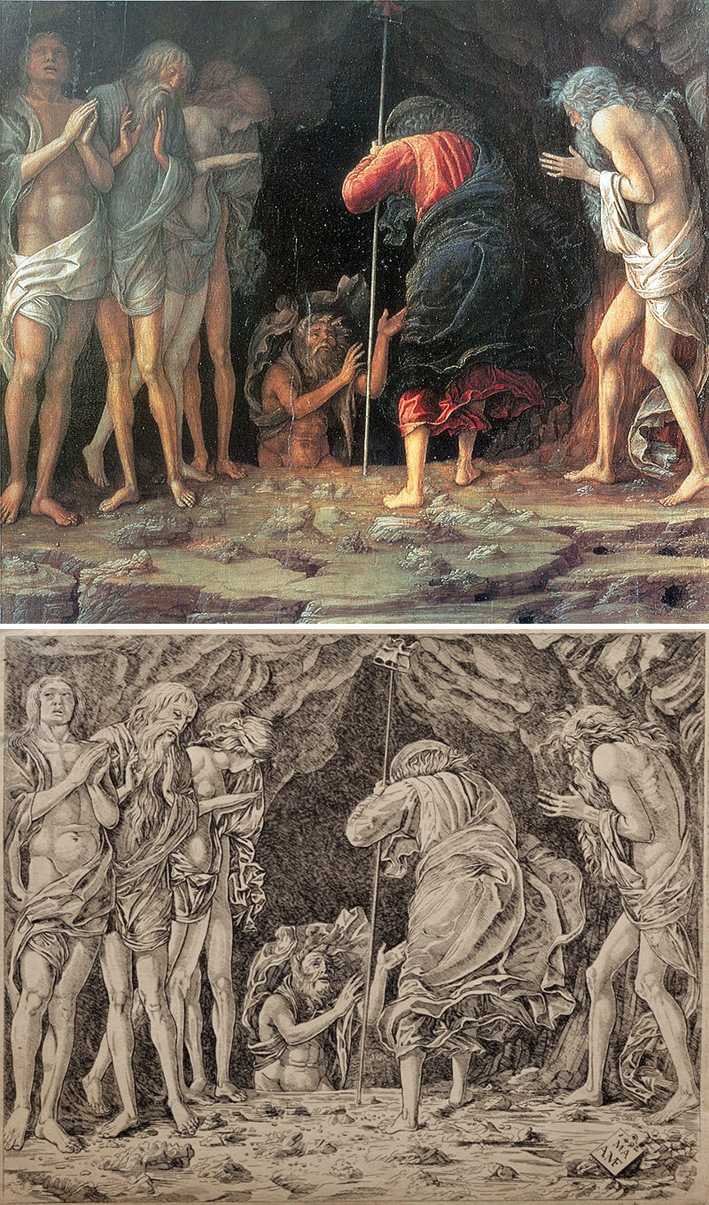 Andrea Mantegna. Christ's Descent Into Limbo, 1492. Ex-collection of Barbara Piasecka Johnson. Sotheby´s Follower of Andrea Mantegna. Christ's Descent Into Limbo, c.1492. Colección Mariano Moret _______________________________________________________________________________
Andrea Mantegna. Christ's Descent Into Limbo, 1492. Ex-collection of Barbara Piasecka Johnson. Sotheby´s Follower of Andrea Mantegna. Christ's Descent Into Limbo, c.1492. Colección Mariano Moret _______________________________________________________________________________1517 TO 2017. FIVE CENTURIES OF PRINTMAKING
This year our prints Two Putti in Circles and Sts Paul and Peter with the Vernicle celebrate 500 years. Five centuries provoking admiration, emotion and devotion through the elegance and virtuosity of Lucas van Leyden's burin.
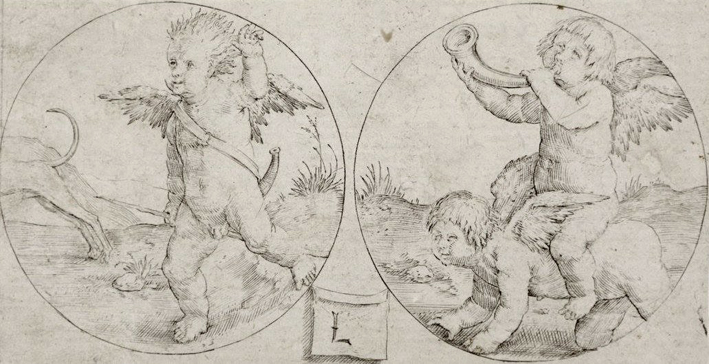 Lucas van Leyden. Two Putti in Circles. Engraving, 1517. Colección Mariano Moret
Lucas van Leyden. Two Putti in Circles. Engraving, 1517. Colección Mariano Moret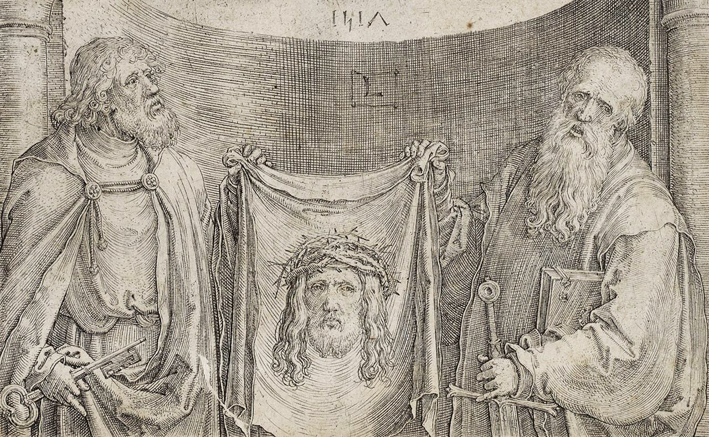 Lucas van Leyden. Sts Paul and Peter with the Vernicle. Engraving, 1517. Colección Mariano Moret
Lucas van Leyden. Sts Paul and Peter with the Vernicle. Engraving, 1517. Colección Mariano Moret_______________________________________________________________________________
CHRISTMAS 2016
Season´s greetings.
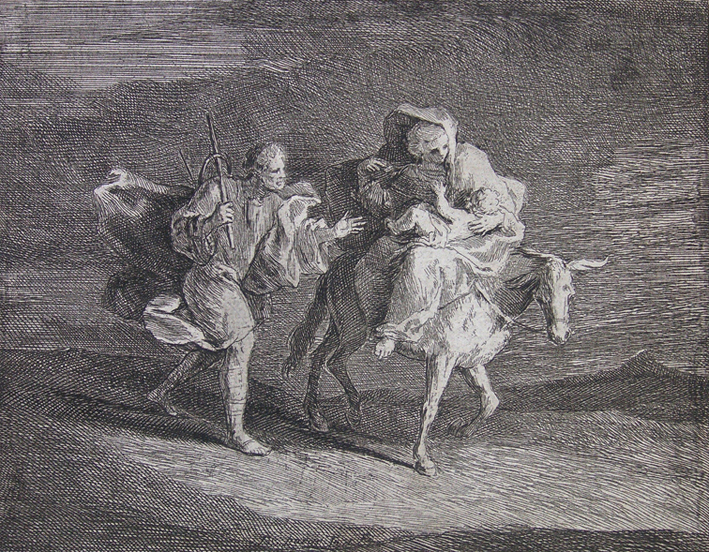 Joseph Parrocel. The flight into Egypt. Etching, c.1680. Colección Mariano Moret
Joseph Parrocel. The flight into Egypt. Etching, c.1680. Colección Mariano Moret_______________________________________________________________________________
CURRENT EXHIBITION
War, Violence and Death in the Mariano Moret Collection Paraninfo Hall. Universidad de Cantabria
14-12-2016
THEME & VARIATIONS: ROYAL SUICIDE
In the Mariano Moret Collection we have two prints of Dido, the queen of Carthage who, according to Virgil's Aeneid, committed suicide when abandoned by her beloved Aeneas. In other versions, Dido, agrees to Aeneas' pretensions of marriage in the fear that he will retaliate against her and her people, but before the wedding, she takes her life by sinking a dagger in her chest.
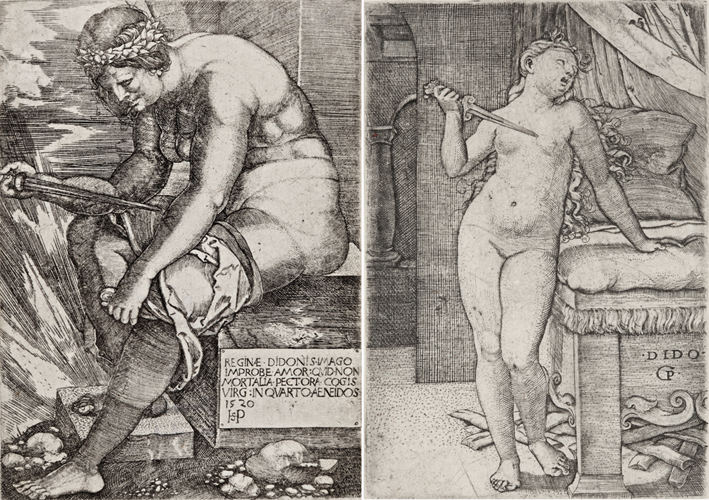 Hans Sebald Beham. Dido. Engraving, 1520. Colección Mariano Moret
Hans Sebald Beham. Dido. Engraving, 1520. Colección Mariano Moret Georg Pencz (?).The death of Dido. Engraving, c. 1535-1580. Colección Mariano Moret
_______________________________________________________________________________
CURRENT EXHIBITION
War, Violence and Death in the Mariano Moret Collection Paraninfo Hall. Universidad de Cantabria
11-12-2016
THEME & VARIATIONS: MAN AGAINST MAN
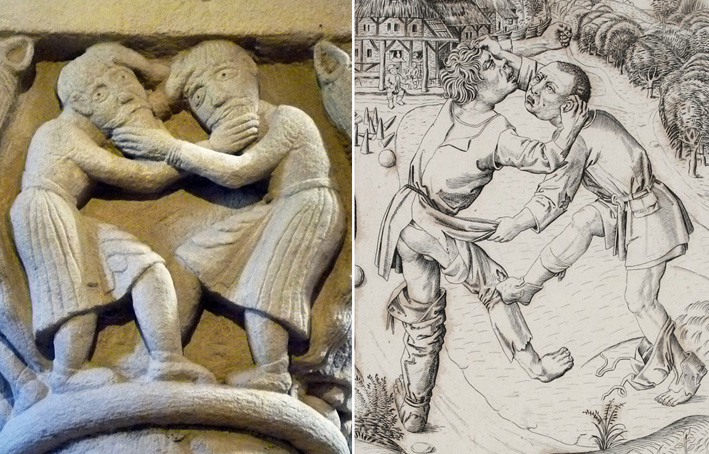 Romanesque capital depicting two wrestling men (detail), c.1200. Prieuré Ste-Trinité. Anzy-le-Duc
Romanesque capital depicting two wrestling men (detail), c.1200. Prieuré Ste-Trinité. Anzy-le-Duc Monogrammist FVB. Two peasants quarrelling over a game of skittles (detail). Engraving, c.1475-1500. Colección Mariano Moret
_______________________________________________________________________________
CURRENT EXHIBITION
War, Violence and Death in the Mariano Moret Collection Paraninfo Hall. Universidad de Cantabria
07-12-2016
YOUNG MAN WITH A SKULL
This Vanitas by Hendrick Hondius I is a copy of another print by Lucas van Leyden (Young Man with a Skull) that Hondius thought it was a Lucas´ self-portait. For that reason the text by Dominicus Lampsonius below:
LUCÆ LEIDANO PICTORI, ET SCULPTORI Tu quoque Durero non par, sed proxime, Luca, Seu tabulas pingis, seu formas sculpis ahenas, Ectypa reddentes tenui miranda papyro, Haud minimam in partem (si qua est ea gloria) nostrae Accede, et tecum natalis Leida, Camoenae. D. Lampsonius.
TO LUCAS VAN LEYDEN, PAINTER AND SCULPTOR You too, not equal, but nearest to Dürer, whether you be painting pictures, or sculpting bronze forms which provide marvellous plates for the thin paper, take (if there is any glory in this) a place – not the least important – in our Muse’s work, along with your native Leyden. D. Lampsonius
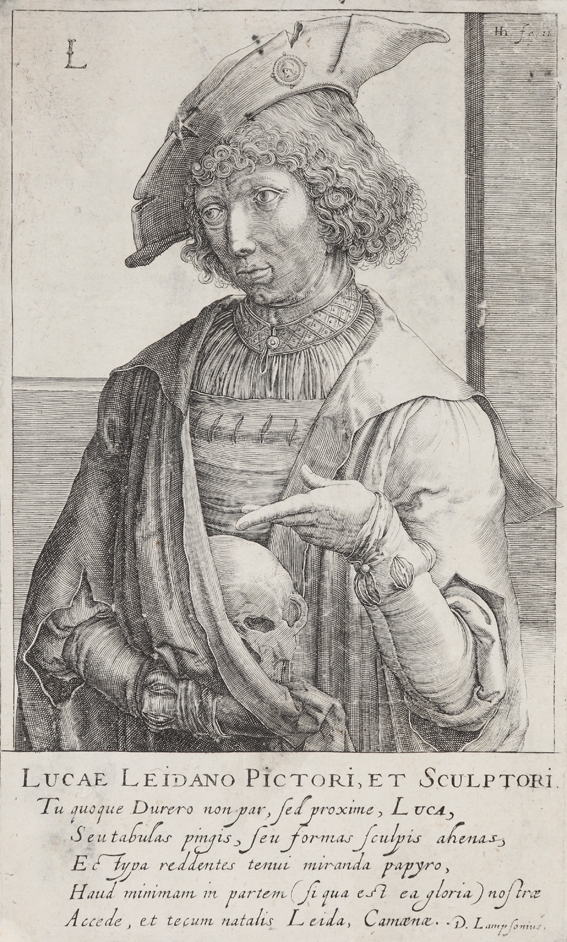 Hendrick Hondius I. Lucae Leidano Pictori, et Sculptori. Engraving, c.1610. Colección Mariano Moret
Hendrick Hondius I. Lucae Leidano Pictori, et Sculptori. Engraving, c.1610. Colección Mariano Moret_______________________________________________________________________________
CURRENT EXHIBITION
War, Violence and Death in the Mariano Moret Collection Paraninfo Hall. Universidad de Cantabria
29-11-2016
THE JUSTICE OF HERKINBALD
Herkinbald was a judge from Brussels that cut his nephew´ throat because he had violated a woman. His bishop denied Herkinbald the last sacrament of Holy Communion after he refused to confess the murder of his nephew. However, Herkinbald miraculously then received the sacramental bread directly on his tongue before dying, signifying that the justness of his nephew’s killing was acknowledged by God.
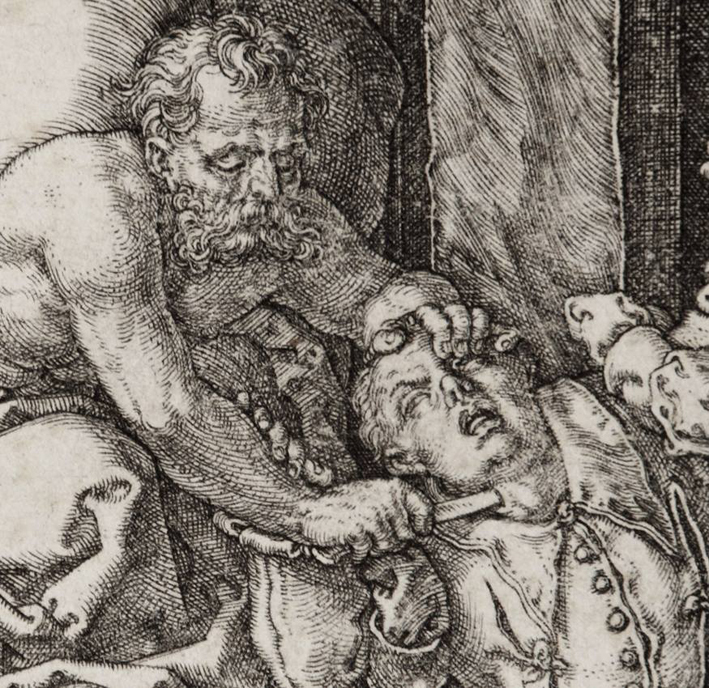 Heinrich Aldegrever. Herkinbald killing his nephew (detail). Engraving, 1553 Colección Mariano Moret
Heinrich Aldegrever. Herkinbald killing his nephew (detail). Engraving, 1553 Colección Mariano Moret_______________________________________________________________________________
CURRENT EXHIBITION
War, Violence and Death in the Mariano Moret CollectionParaninfo Hall. Universidad de Cantabria
26-11-2016
THREE BATTLE SCENES
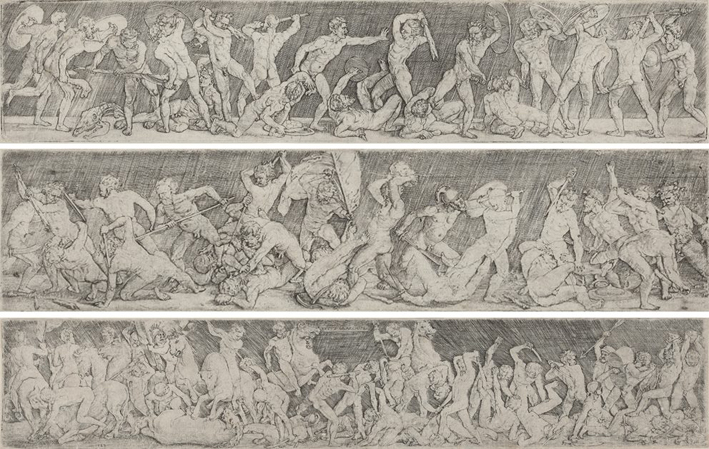 Barthel Beham. Battle of eighteen nude men. Engraving, c.1528. Colección Mariano Moret
Barthel Beham. Battle of eighteen nude men. Engraving, c.1528. Colección Mariano Moret Barthel Beham. Battle for the banner. Engraving, c.1528. Colección Mariano Moret
Barthel Beham. Battle of Titus Gracchus. Engraving, 1528.Colección Mariano Moret
_______________________________________________________________________________
CURRENT EXHIBITION
War, Violence and Death in the Mariano Moret CollectionParaninfo Hall. Universidad de Cantabria
21-11-2016
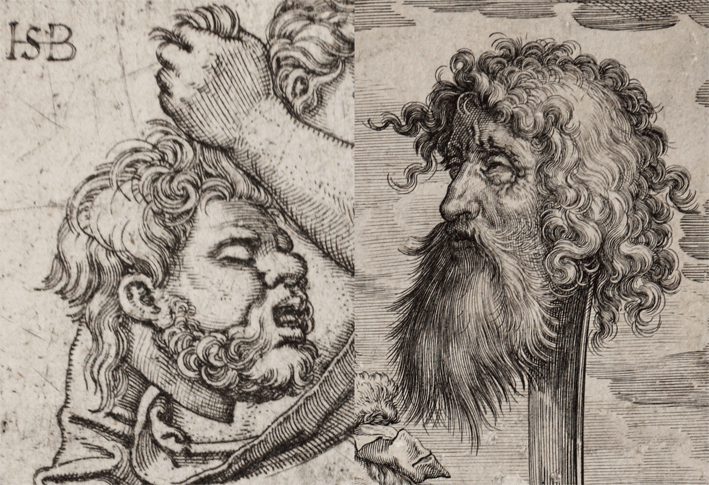
_______________________________________________________________________________
CURRENT EXHIBITION
War, Violence and Death in the Mariano Moret Collection
Paraninfo Hall. Universidad de Cantabria
17-10-2016
The Área de Exposiciones of the Universidad de Cantabria has designed an educational program for the first quarter of the 2016-2017 course around the exhibition War, Violence and Death in the Mariano Moret Collection. From October 17 to December 17, schools can request a guided visit to the exhibition in which students will be introduced to engraving and etching techniques through the exhibited Old Master Prints, whose topics include contents as the representation of violence in mythology and in religious iconography as well as some aspects concerning war in European history.
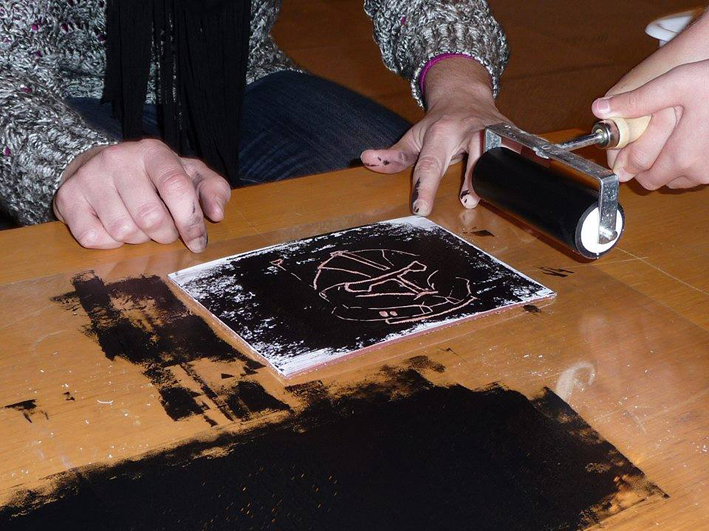
_______________________________________________________________________________
CURRENT EXHIBITION
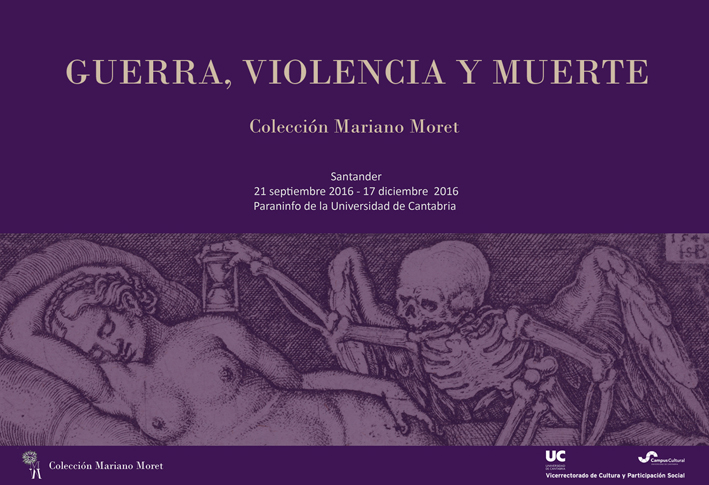
War, Violence and Death in the Mariano Moret Collection
The beauty of the terrible. The excitement of the fearsome. The attraction of the unfathomable.
Paraninfo Hall. Universidad de Cantabria Santander, September 21, 2016 to December 17, 2016
XXI Congress of Art History Palacio de la Magdalena, Santander, September 20, 2016 to September 23, 2016
Figures that die. Figures that kill. For love, for hate, for justice, for vengeance, for defending a territory or an ideal. Death, its threat, power and victory over the men is the common theme and thread of the 68 works pertaining to the Mariano Moret Collection that have been selected for this exhibition. German, Dutch and Italian engravings that show violence, war, and death through works by Aldegrever, Altdorfer, the Beham brothers, Georg Pencz, Marcantonio Raimondi, Lucas van Leyden and other important engravers from the 15h, 16th and 17th centuries. Scenes in which the influence of Humanism, neoplatonic ideas and the new aesthetic universe that looks into antiquity and revolves around the representation of the human essence are visible. Violence shown through passion, beauty, memories of the antiquity, mythological stories and characters. Images that censure sinful acts and sometimes seem an invitation to sin. Alluring kidnappings, sensual suicides, attractive bodies fighting, murderers who love or lovers who kill. War, violence and death together or separately, have a significant presence in men, art, and in the engravings of the Mariano Moret Collection. Works of art that take us to a tumultuous period of conflicts unable to be resolved, wars and warriors, religious schisms, extinct ancient Gods that are recovered by art to transmit messages or simply show images of an almost sinful violence. The excitement, tension and dramatic intensity which are implicit in many of these themes lend them strength, beauty and a unique charm.
The exhibition War, Violence and Death in the Mariano Moret Collection is a satellite event to the XXI Congress of Art History. A catalogue has been published on the occasion of the exhibition.
The author of the catalogue text is Nuria Blaya, Professor of Art History at Florida Universitaria.
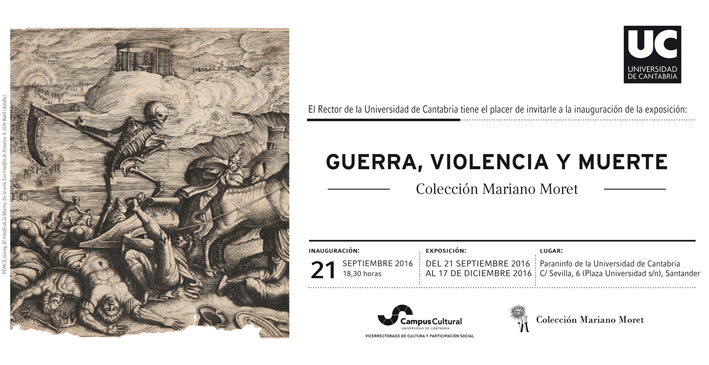
__________________________________________________________________________
THEME & VARIATIONS: LUCAS VAN LEYDEN SELF-PORTRAIT
This drawing by Dürer with a Portrait of a man (British Museum) was formerly thought to represent the famous Dutch artist, Lucas van Leyden whom Dürer met in Antwerp and of whom he recorded making a drawing in silverpoint in June 1521 (Lille, Musée des Beaux-Arts), but the features of this sitter are quite different to those in the silverpoint drawing. The mistaken identity goes back at least to the seventeenth-century etching Self-Portrait of the Artist (Colección Mariano Moret), made after a design based on the present drawing and much reduced in scale, which Bartsch classified as a print by Lucas van Leyden. This print has a false monogram and the date 1525, and is inscribed, "Effigies lucae Leidensis. Propria manu incidere".
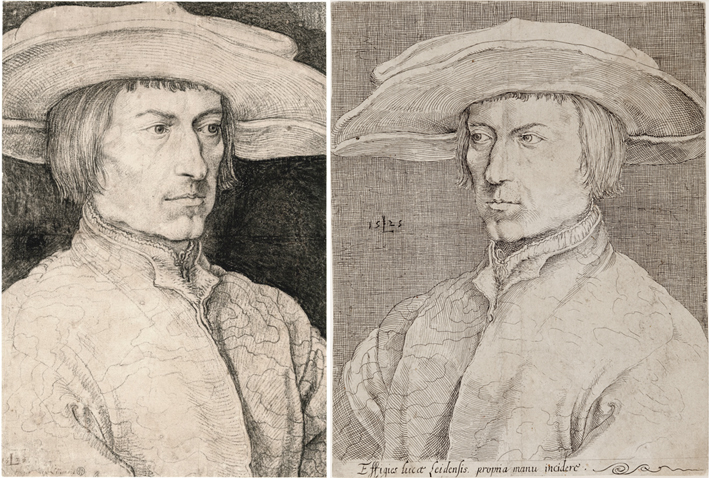 Albrecht Dürer. Portrait of a man. British Museum
Albrecht Dürer. Portrait of a man. British Museum Jan h. Muller?. Lucas van Leyden self-portrait. Colección Mariano Moret
_______________________________________________________________________________
THE MARIANO MORET COLLECTION YOUTUBE CHANNEL
Subscribe to the Mariano Moret Collection YouTube channel and enjoy the world of Old Master Prints through the Commented Works videos produced by the Bilbao Fine Arts Museum.

________________________________________________________________________________
THEME & VARIATIONS: RENAISSANCE GERMAN SCUPTURE FROM THE BODE-MUSEUM
Through the sculptures from the Bode-Museum that are part of the exhibition The Last Gothic Flames, currently exhibited at the Museo Nacional de Escultura in Valladolid, It can be seen the enormous influence that had the Renaissance printmaking in coetaneous German sculpture.
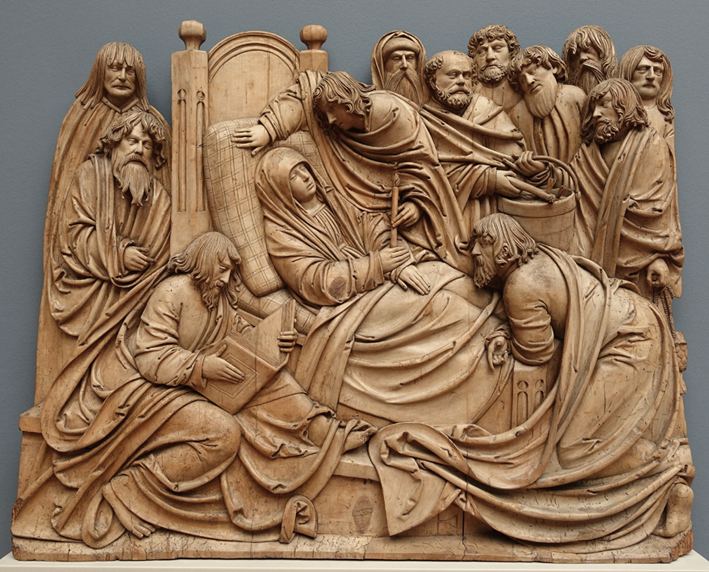 Hans Thoman. The death of the Virgin. Linden wood, c.1520. Bode-Museum
Hans Thoman. The death of the Virgin. Linden wood, c.1520. Bode-Museum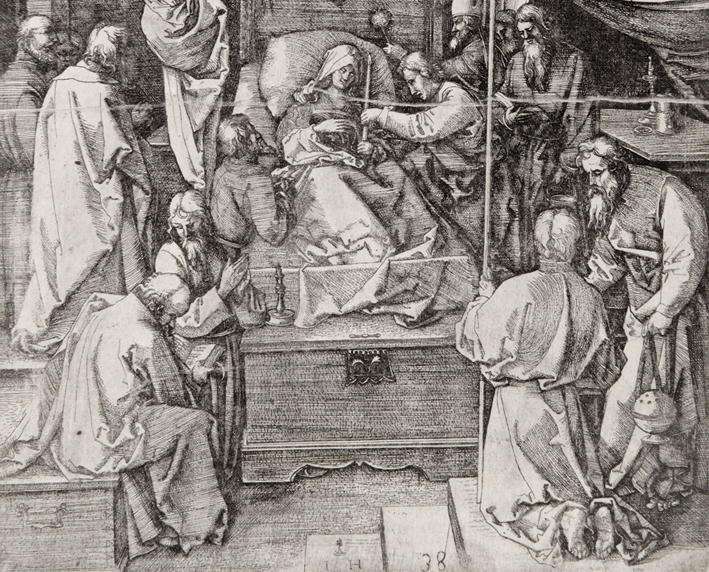 Hieronymus Hopfer. The death of the Virgin (detai). Etching, c.1528-1563. Colección Mariano Moret
Hieronymus Hopfer. The death of the Virgin (detai). Etching, c.1528-1563. Colección Mariano Moret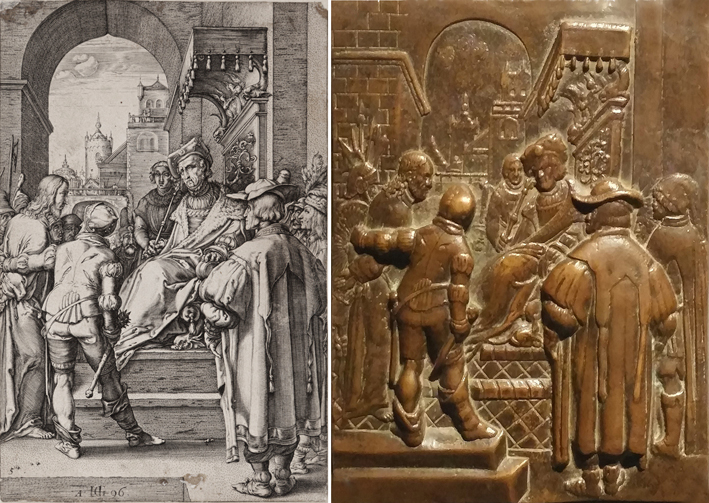 Hendrik Goltzius. Christ before Pilate. Engraving, 1596. Colección Mariano Moret
Hendrik Goltzius. Christ before Pilate. Engraving, 1596. Colección Mariano Moret Anoymous. South of Germany. Christ before Pilate. Bronze, c.1600. Bode-Museum
_______________________________________________________________________________
RECENT ACQUISITIONS JUNE 2016
The Mariano Moret Collection has developed recently an ambitious acquisitions program with the objectives to complete and improve their collections of prints of the Little Masters and Lucas van Leyden. Another major objective has been to create an ornamental prints collection:
Martin Schongauer (copy after c.1550). Ornament with an owl and other birds Anonymous Italian Master c.1560. Gryllos: conjoined heads of a youth, a bearded man, a satyr, and a ram Lucas van Leyden. St Mark Lucas van Leyden. St Mary Magdalene in the Desert Lucas van Leyden. Sts Paul and Peter with the Vernicle Lucas van Leyden. St James the Lesser Lucas van Leyden. Triton and Siren in Tendrils Lucas van Leyden (copy after). Christ before Annas Lucas van Leyden (copy after). The Annunciation Hans Sebald Beham. A mask on a shield held by two putti Hans Sebald Beham. Design for the base and capital of a Corinthian column Hans Sebald Beham. The impossible Hans Sebald Beham. St James the Great Hans Sebald Beham. Temperance Hans Sebald Beham. Death and the sleeping woman Hans Sebald Beham. Hercules abducting Iole Hans Sebald Beham. Hercules killing Nessus Hans Sebald Beham. Lichas presenting Hercules with the poisoned tunic Georg Pencz. The conversion of St Paul Monogrammist IB. The heart forged by Hope, Envy, Tribulation and Tolerance Heinrich Aldegrever. A standard-bearer Heinrich Aldegrever. Nude children dancing under a canopy Heinrich Aldegrever. Grotesque ornament panel with a bat above a trophy and two satyrs holding dragonflies Heinrich Aldegrever. Triton carrying off a male and female on a black background Gilich Kilian Proger. Leaf ornament fillet with a putto Daniel Hopfer. Roman majuscule alphabet Daniel Hopfer. Ornament panel with various ceiling designs Daniel Hopfer. Two upright ornament panels with half-designs for candelabra Daniel Hopfer. Three horizontal leaf ornament friezes Virgil Solis. Frieze with eight busts Virgil Solis. Four acrobats Monogrammist HL (Hans Leinberger?, Hans Loy?, Hans Leu?, Heinrich Lautensack, Hans Schlaiß?). Cupid riding a snail Cherubino Alberti. Vase with a scene of pagan devotion Cherubino Alberti. Vase with a battle of ichthyocentaurs Cherubino Alberti. Vase with two naked putti carrying a festoon Christoph Jamnitzer. Grotesque with three equestrian genii Christoph Jamnitzer. Grotesque with four heads in elaborate headdress Hans Janssen. Oval with foliage arabesques Hendrik Hondius the Elder. Young Man with a Skull (Portrait of Lucas van Leyden) Johan Theodor de Bry. Emblemata Secularia. QUOD BENE DII VERTANT SPORTAM TEXIM ISTAM Johan Theodor de Bry. Emblemata Secularia. TENDIM.HOS LAQUEUS PRO NUTU. ET SOLIM. ILLOS Johan Theodor de Bry. Emblemata Secularia. HOS RITUS CELEBRANT EPICURI DE GREGE PORCI Johan Theodor de Bry. Emblemata Secularia. ASPICE UT INGENTES SUSPENDAT SIMIA RUGAS
Johan Theodor de Bry. Emblemata Secularia. IMPROB, EST SI QUIS ALIENA INCOMODA RIDET Johan Theodor de Bry. Emblemata Secularia. QUO MAGE FUMOSOS FOCUS EST, MIN IGNE CORUSCAT Johan Theodor de Bry. Emblemata Secularia. OMNIA VINDCIT AMOR, ET NOS CEDAMUS AMORI Johan Theodor de Bry. Emblemata Secularia. UT TE NOSSE QUEAS, HOC PROVIDUS INSPICE SPECLUM Johan Theodor de Bry. Emblemata Secularia. A nobleman raising a goblet besides an empty heraldic shield Johan Theodor de Bry. Emblemata Secularia. A noble dame besides an empty heraldic shield Johan Theodor de Bry. Emblemata Secularia. DESIDIAM IGNAVI SEQUIMUR, LENTUMQ SOPOREM Johan Theodor de Bry. Emblemata Secularia. A noble dame in a sedan chair with an empty escutcheon on the door Johan Theodor de Bry. Emblemata Secularia. PROIICIO AMPVLLAS, MONTESQ PACISCOR IN AVRO Johan Theodor de Bry. Emblemata Secularia. MUSICA MORTALES RECREAT DIVOSQ BEATOS Johan Theodor de Bry. Emblemata Secularia. HEU NIMIUM VAECIS ERRANT CONNUBIA FATIS Johan Theodor de Bry. Emblemata Secularia. DUCERET UT VETULAM IUVENIS, FACIT AMPLACRAMENA Nicolaas de Bruyn. The Massacre of the Innocents Gerrit Visscher. Oval design for clock face with Aeneas carrying Anchises, four key bows and three blackwork clock handles Vicente Victoria. St Mary Magdalene Stefano della Bella. Horizontal ornament panel of eight vases Jean Berain. Grotesque panel with Hercules fighting Antaeus and other figures Jean Berain. Ornament panel with arabesques Gottfried Stein. Grotesque ornament panel with Venus and Cupid Johann Adam Delsenbach.Three grotesque ornament panels with the Forge of Vulcan Jacques François Joseph Saly. Vase decorated with bucranium and two putti Jacques François Joseph Saly. Vase decorated with two tritons and other marine figures Jacques François Joseph Saly. Vase decorated with two standing satyrs Jean Baptiste Guelard. Le Maître d'École (The School Master) Francisco de Goya. Los Borrachos (The Drunkards) after Velázquez Jean Démosthène Dugourc. Le Feau (Arabesques. Fire)
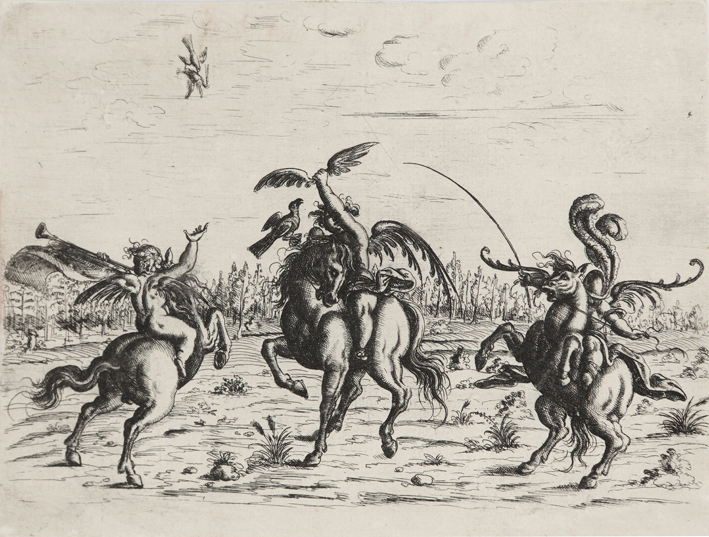 Christoph Jamnitzer. Grotesque with three equestrian genii. Colección Mariano Moret
Christoph Jamnitzer. Grotesque with three equestrian genii. Colección Mariano Moret_______________________________________________________________________________
THEME & VARIATIONS. DRAGONS AND SEA MONSTERS
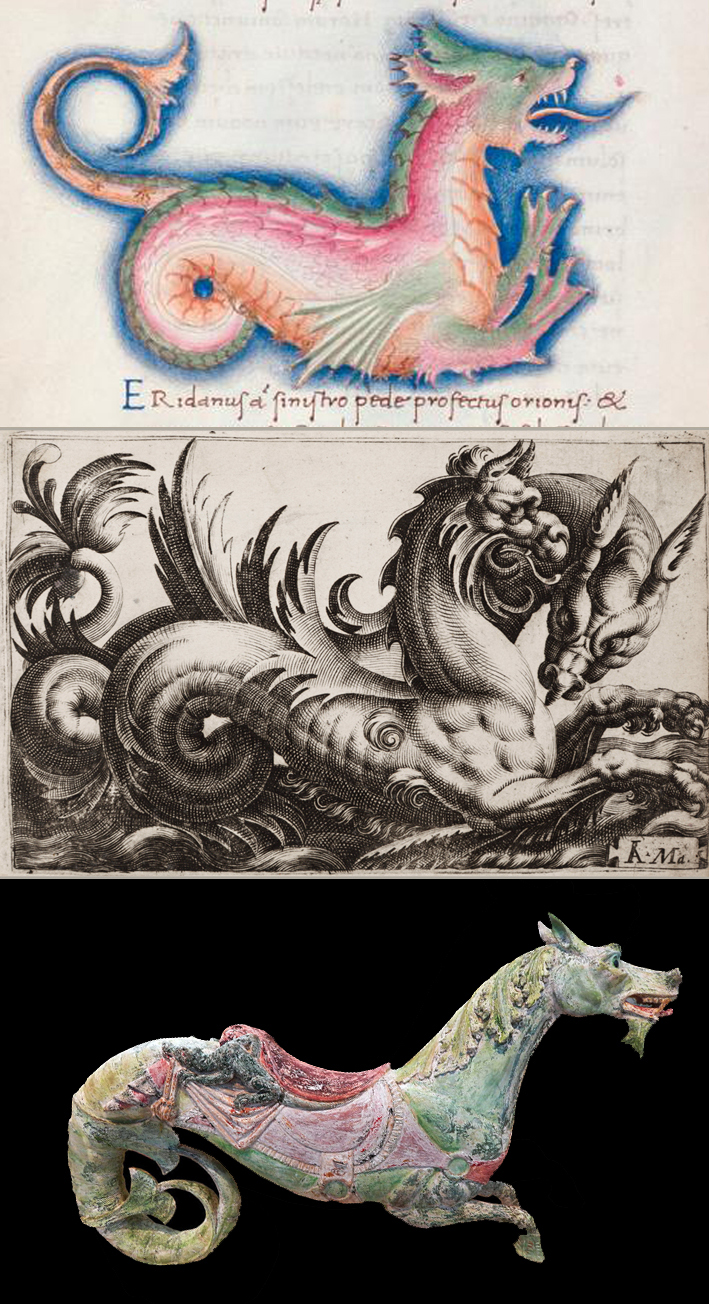 Hyginus. Dragon. illuminated manuscript. De sideribus tractatus, c.1465-1480, Ms. 28, Spencer Collection, New York Public Library
Hyginus. Dragon. illuminated manuscript. De sideribus tractatus, c.1465-1480, Ms. 28, Spencer Collection, New York Public Library Giovanni Andrea Maglioli. Two sea monsters riding the waves. Engraving, c.1580. Colección Mariano Moret
E. Joy Morris, Philadelphia Toboggan Company. Carousel Sea Monster. Carved and painted basswood, c.1899
_______________________________________________________________________________
THEME & VARIATIONS: HEINRICH ALDEGREVER VERSUS LEONE LEONI AND POMPEO LEON
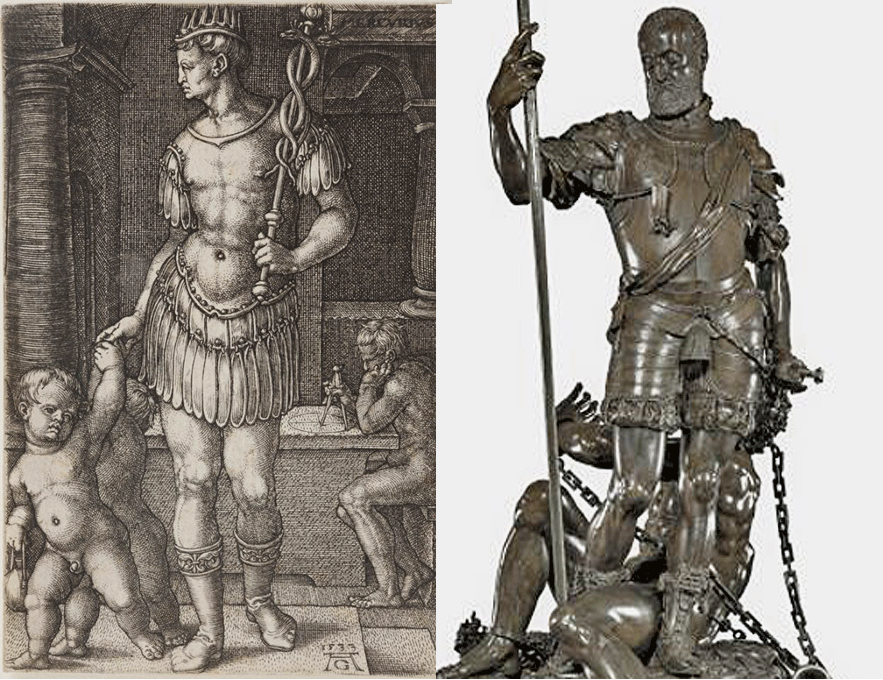 Heinrich Aldegrever. Mercury. Engraving, 1533. Colección Mariano Moret
Heinrich Aldegrever. Mercury. Engraving, 1533. Colección Mariano Moret Heinrich Aldegrever. Jupiter. Engraving, 1533. Colección Mariano Moret
Leone and Pompeo Leoni.The Emperor Charles V Restraining Fury, 1551-1553. Museo Nacional del Prado
_______________________________________________________________________________
THE MUSICIANS
"Life imitates art far more than art imitates Life". - Oscar Wilde
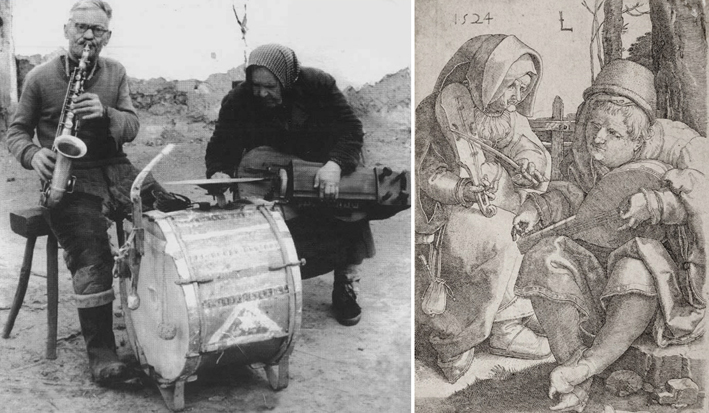 Anonymous reverse copy after Lucas van Leyden. The Musicians. Engraving, c.1524. Colección Mariano Moret
Anonymous reverse copy after Lucas van Leyden. The Musicians. Engraving, c.1524. Colección Mariano Moret_______________________________________________________________________________
WORLD BOOK DAY 2016
This year we celebrate World Book Day 2016 sharing the links of our catalogue Grabados Maestros. La huella de Durero y Lucas ven Leyden en la Colección Mariano Moret at some os the most important and pestigious libraries in the world:
Universitat de València. Biblioteca Històrica. Valencia Biblioteca Valenciana Nicolau Primitiu: Valencia Biblioteca Nacional de España. Madrid Biblioteca del Museo Nacional del Prado. Madrid
Real Biblioteca. Patrimonio Nacional. Madrid Instituto del Patrimonio Cultural de España. Madrid CSIC Centro Superior de Investigaciones Científicas. Madrid
Museu Nacional d´Art de Catalunya. Barcelona
Bibliothèque Sainte-Geneviève. Paris Kunsthistorisches Institut in Florenz, Max-Planck-Institut. Florence Bayerische Staatsbibliothek. Munich Universitätsbibliothek Erlangen-Nürnberg. Erlangen New York Public Library. New York Watson Library at the Metropolitan Museum. New York Harvard University Library. Cambridge, MassachusettsGetty Research Institute Library. Los Angeles

_______________________________________________________________________________
PACHECO. THEORIST, ARTIST, MASTER
The print Christ praying on the Mount of Olives by Hendrik Goltzius, belonging to the funds of the Mariano Moret Collection, appears published on page 212 of the catalogue Pacheco. Teórico, artista, maestro edited by the Seville Fine Arts Museum on the occasion of the exhibition dedicated to the great Sevillian painter, who was master, teacher and father-in-law of Velázquez.
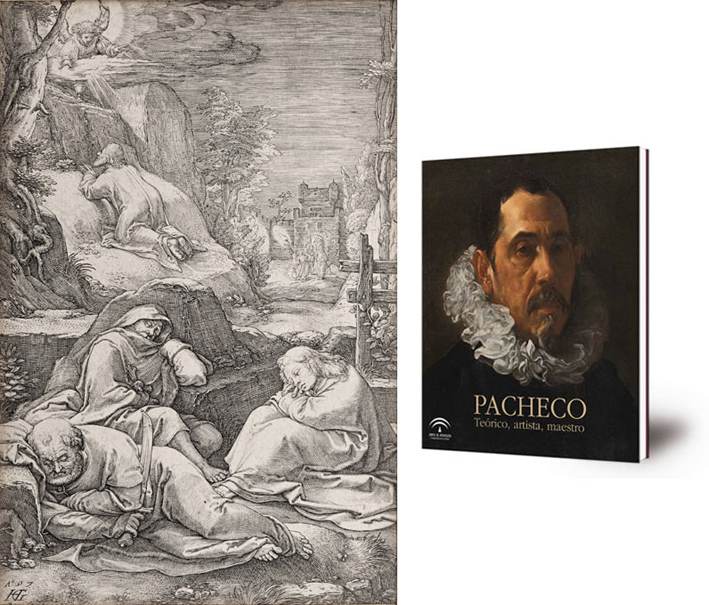
_______________________________________________________________________________
THEME & VARIATIONS: PUNISHMENT OF NIOBE
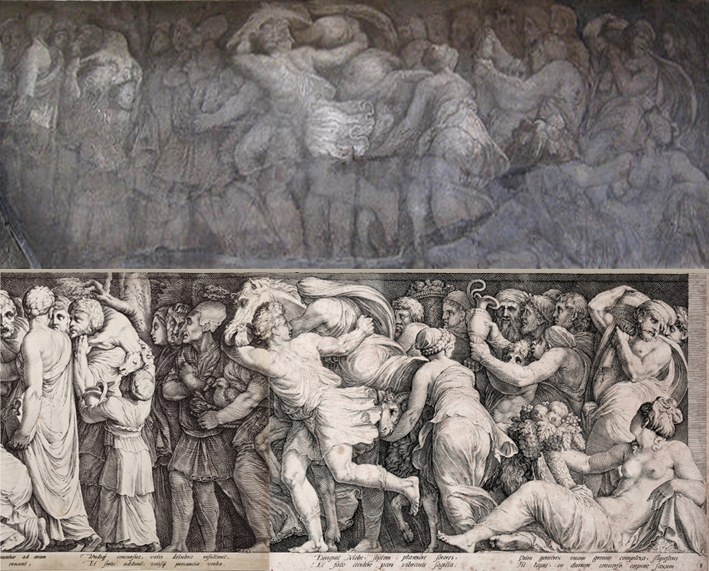 Polidoro da Caravaggio and Maturino da Firenze. The History of Niobe. Fresco painting from the façade of the Palazzo Milesi, Rome, 1526
Polidoro da Caravaggio and Maturino da Firenze. The History of Niobe. Fresco painting from the façade of the Palazzo Milesi, Rome, 1526 Jan Saernredam, after Polidoro da Caravaggio and Hendrick Goltzius. Punishment of Niobe. Plates 7 and 8. Engraving, 1594. Colección Mariano Moret
_______________________________________________________________________________
URUMO´S MUARÉ NOTEBOOK
Urumo´s notes in his Muaré Notebook regarding his visit to the exhibition Master Prints from the Mariano Moret Collection (La Nau. November 2012 - February 2013).
Link to the blog De vuelta con el cuaderno
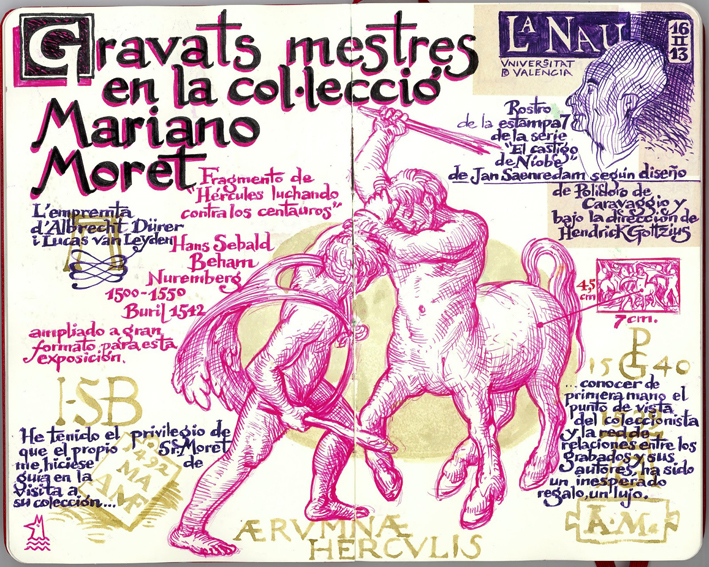
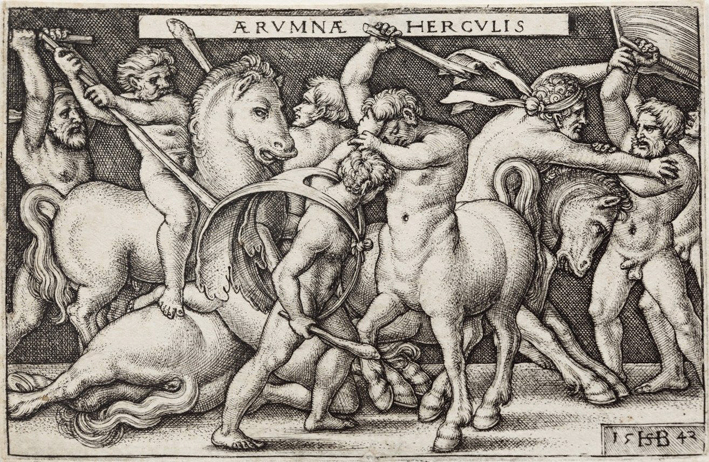 Hans Sebald Beham. Hercules fighting the centaurs. Engraving, 1542. Colección Mariano Moret
Hans Sebald Beham. Hercules fighting the centaurs. Engraving, 1542. Colección Mariano Moret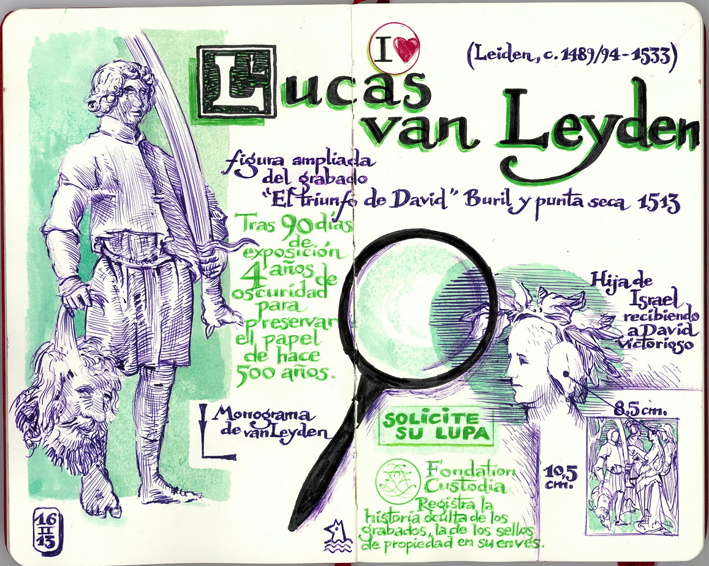
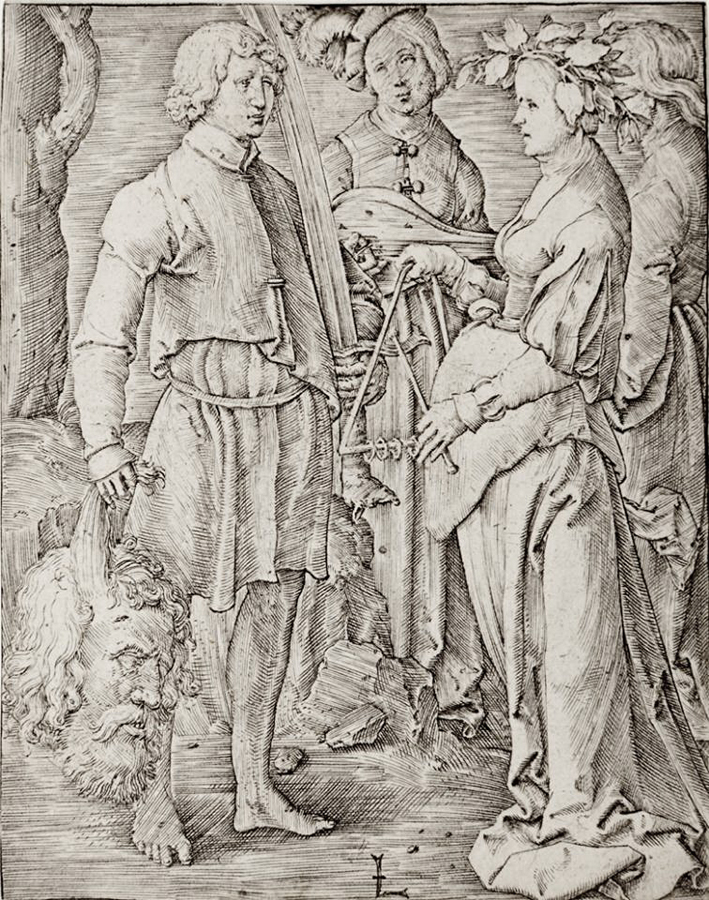 Lucas van Leyden. Triumph of David. Engraving and dry point, 1513. Colección Mariano Moret
Lucas van Leyden. Triumph of David. Engraving and dry point, 1513. Colección Mariano Moret_______________________________________________________________________________
THEME & VARIATIONS: LUCAS VAN LEYDEN, AN ARTIST BETWEEN GOTHIC AND RENAISSANCE ART
Although Lucas van Leyden is a fully Renaissance artist, in his prints are still noticeable traces of Gothic style, like the traditional pose and drapery scheme of the Schöne Madonnen. Graceful silhouettes, ‘hanchement’ or s-curve stance, a calm charm and, famously, a voluminous drapery style characterised by cascading folds became the leitmotivs of these Beautiful Madonnas.
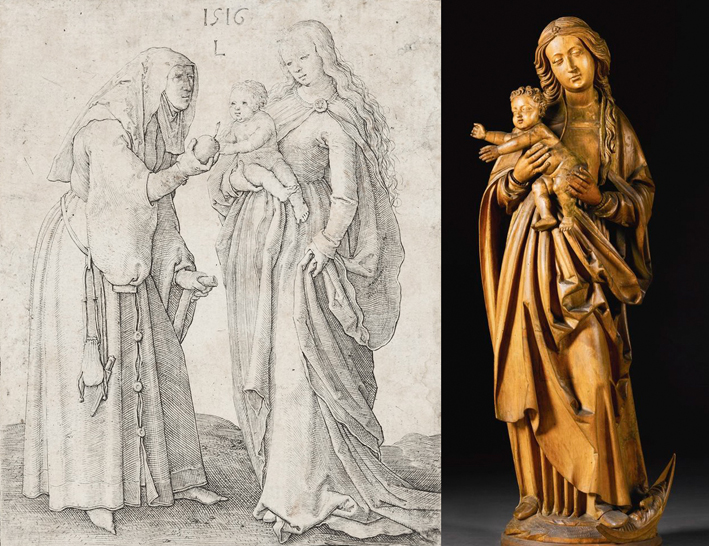 Lucas van Leyden. The Virgin with Child and St Anna.Engraving, 1516. Colección Mariano Moret
Lucas van Leyden. The Virgin with Child and St Anna.Engraving, 1516. Colección Mariano Moret Workshop of Hans Gieng. Virgin and Child. Limewood, c.1530. Sotheby´s
Lucas van Leyden was regarded as an innovative artist because of his graphic work and the introduction of Italian Renaissance iconography in the Netherlands. He was famous for his prints that were sold with great success, thus helping to spread the new Renaissance style throughout Europe.
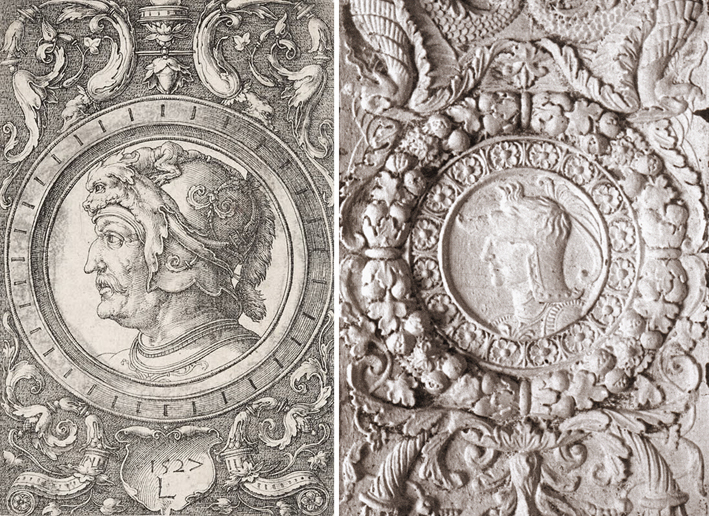 Lucas van Leyden. Ornament with the Head of Soldier. Engraving, 1527. Colección Mariano Moret
Lucas van Leyden. Ornament with the Head of Soldier. Engraving, 1527. Colección Mariano Moret Plaster ornament with grotesque decoration (c.1550) from one of the ceilings at the Counts of Oliva Palace. Demolished in 1947. (Photo: E. Fischer and V. Lauritzen, 1917)
_______________________________________________________________________________
DESCUBRIR EL ARTE
Current exhibition The shadow of the burin is extended in Descubrir el Arte

_______________________________________________________________________________
ARS MAGAZINE
Current exhibition The shadow of the burin is extended in Ars Magazine
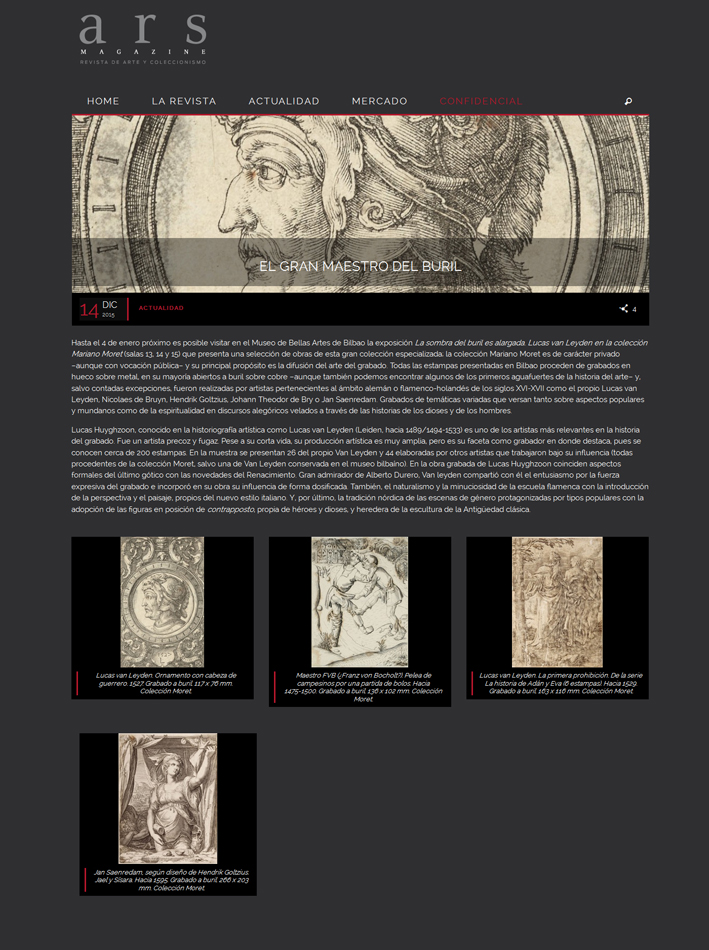
_______________________________________________________________________________
RECENT ACQUISITIONS JANUARY 2016
This etching by Vicente Victoria, recently acquired in Cologne, is the first Spanish print of the Mariano Moret Collection. St Mary Magdalene was etched by Victoria in Rome in the last quarter of the 17th century.
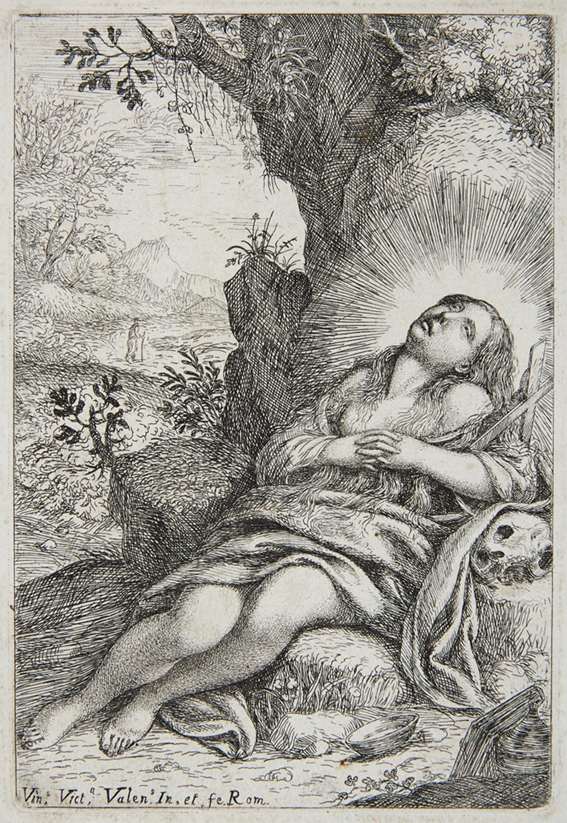 Vicente Victoria. St Mary Magdalene. Etching, c.1673-1712. Colección Mariano Moret ________________________________________________________________________________________________________ 2016
Vicente Victoria. St Mary Magdalene. Etching, c.1673-1712. Colección Mariano Moret ________________________________________________________________________________________________________ 2016At the Mariano Moret Collection we are working intensively in numerous projects to make 2016 an extraordinary year: the beginning of a new collection of Spanish Old Master Prints, an ambitious policy of acquisitions intended mainly to enrich our funds of Ornamental Prints, the celebration of a new exhibition for the month of September and the publication of a new catalog. We hope to share them all with you
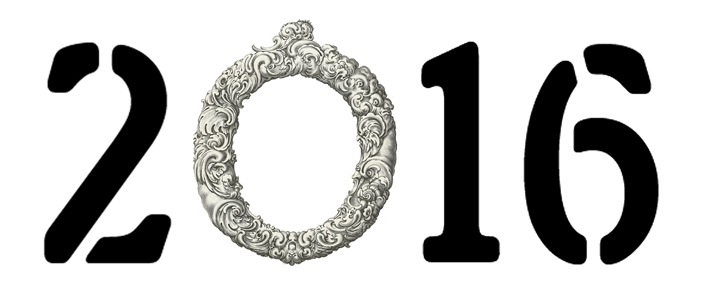 _________________________________________________________________________________________________________ A COLLECTION OF OLD MASTER PRINTS AND TWO OUTSTANDING MUSEUMS
_________________________________________________________________________________________________________ A COLLECTION OF OLD MASTER PRINTS AND TWO OUTSTANDING MUSEUMS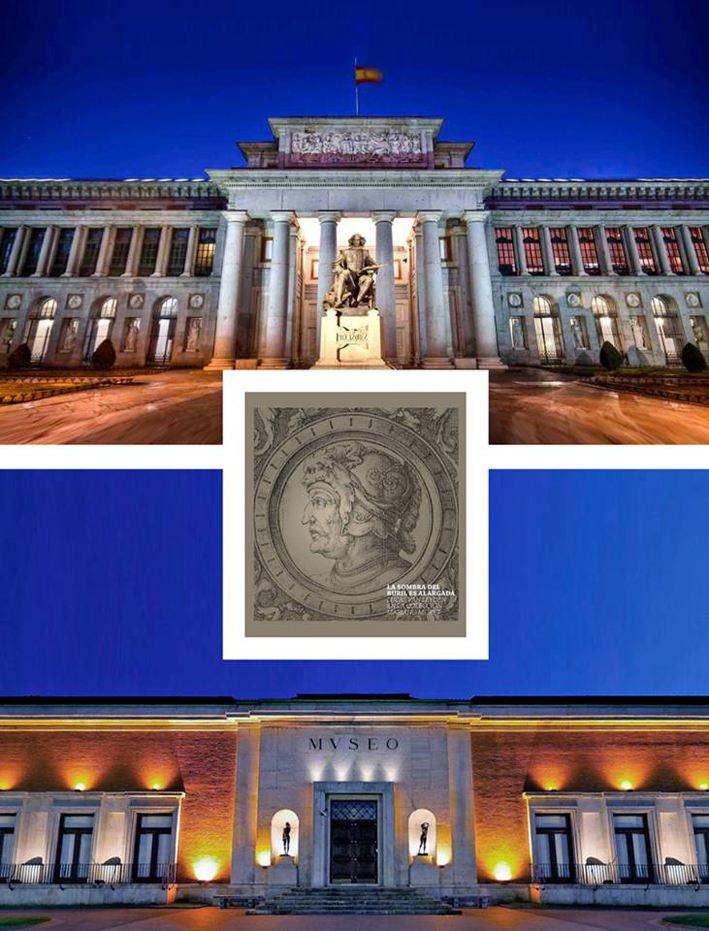 2015 was an amazing year for the Mariano Moret Collection. In 2015 we have shown a part of the Collection at the Bilbao Fine Arts Museum in the first exhibition devoted to Lucas van Leyden held in Spain. On the occasion of the exhibition it has been published a catalogue that is the first monographic book published in Spanish language dedicated to Lucas van Leyden oeuvre. José Juan Pérez Preciado, Assistant curator of Flemish and Northern European Paintings at the Prado Museum, is the author of The text of this catalogue.
2015 was an amazing year for the Mariano Moret Collection. In 2015 we have shown a part of the Collection at the Bilbao Fine Arts Museum in the first exhibition devoted to Lucas van Leyden held in Spain. On the occasion of the exhibition it has been published a catalogue that is the first monographic book published in Spanish language dedicated to Lucas van Leyden oeuvre. José Juan Pérez Preciado, Assistant curator of Flemish and Northern European Paintings at the Prado Museum, is the author of The text of this catalogue._________________________________________________________________________________________________________ CURRENT EXHIBITION
The shadow of the burin is extended. Prints by Lucas Van Leyden from the Mariano Moret Collection Bilbao Fine Arts Museum
24/11/2015
After its premiere at FIG Bilbao 2015, these 4 engravings, the latest acquisitions from our collection, are already in the room at the Bilbao Fine Arts Museum in which are incorporated into the exhibition The shadow of the burin is extended. Prints by Lucas Van Leyden from the Mariano Moret Collection.
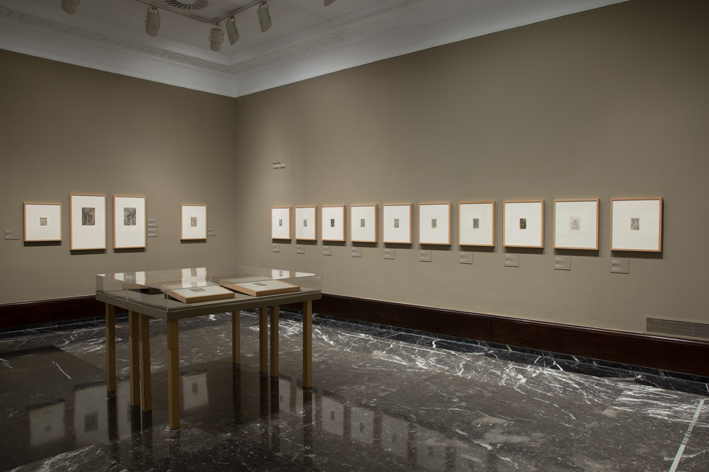
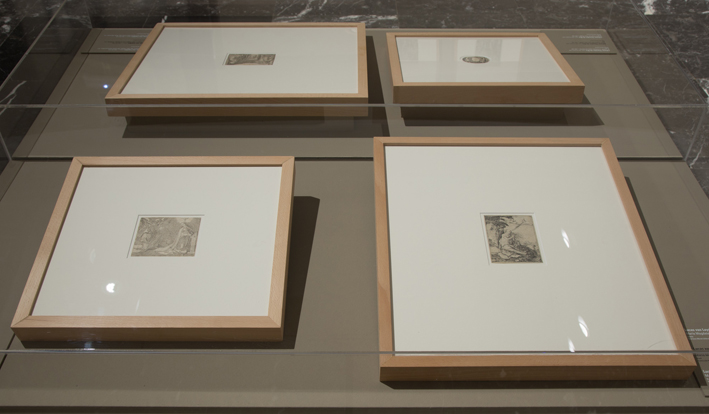
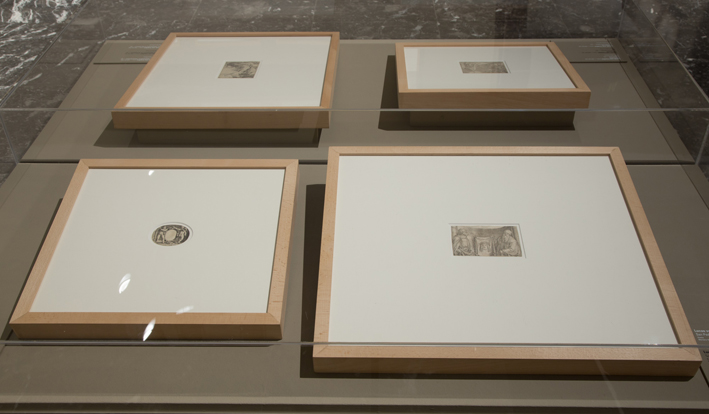
RECENT ACQUISITIONS NOVEMBER 2015
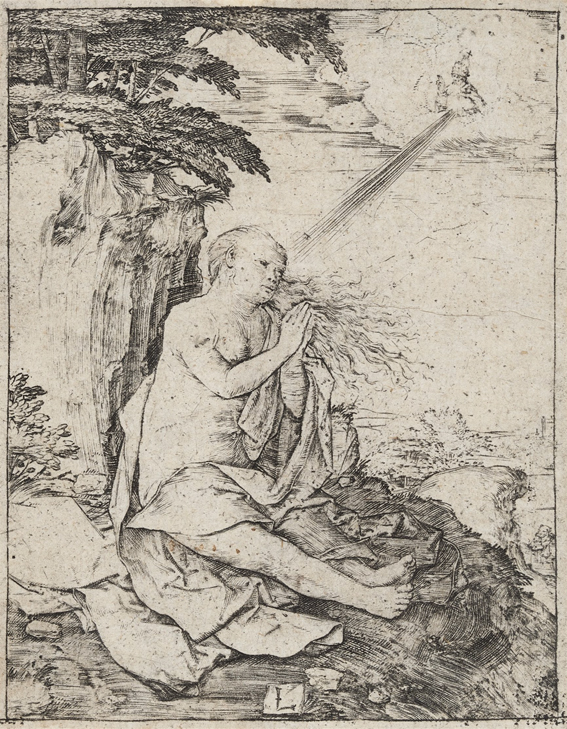 Lucas van Leyden. St Mary Magdalene in the Desert. Engraving, c.1506.Colección Mariano Moret
Lucas van Leyden. St Mary Magdalene in the Desert. Engraving, c.1506.Colección Mariano Moret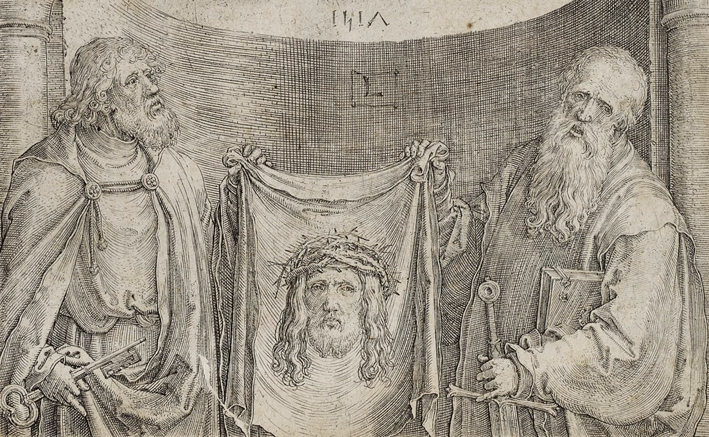 Lucas van Leyden. Sts Paul and Peter with the Vernicle. Engraving, 1517. Colección Mariano Moret
Lucas van Leyden. Sts Paul and Peter with the Vernicle. Engraving, 1517. Colección Mariano Moret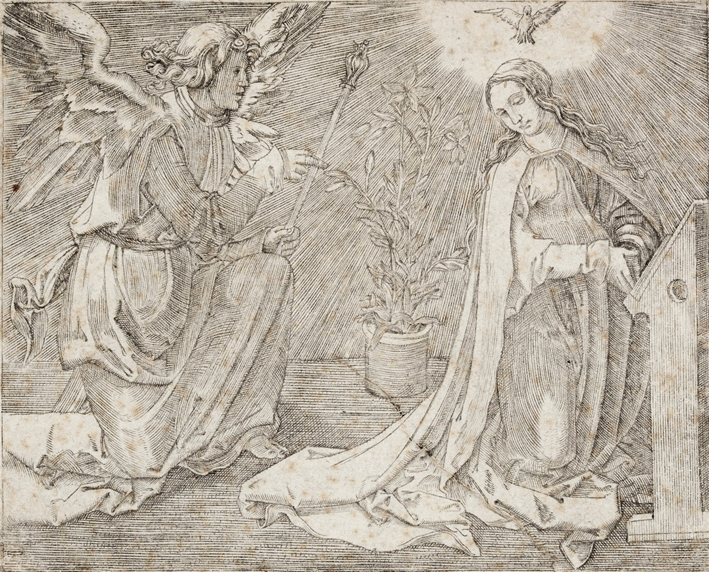 Anonymous copy after Lucas van Leyden. The Annunciation. Engraving, c.1516. Colección Mariano Moret
Anonymous copy after Lucas van Leyden. The Annunciation. Engraving, c.1516. Colección Mariano Moret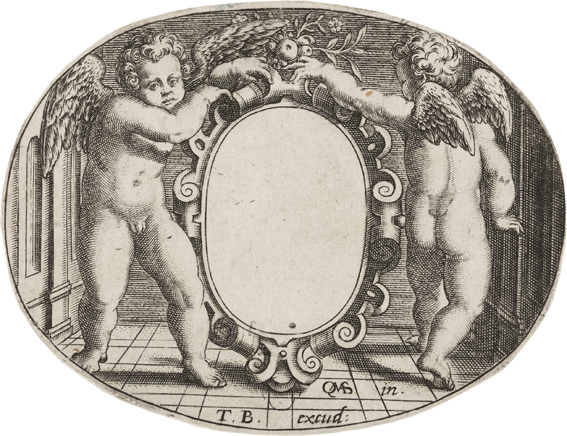
Theodor de Bry. Two genii holding an escutcheon. Engraving, c.1580-1598. Colección Mariano Moret
_______________________________________________________________________________
CURRENT EXHIBITION
The shadow of the burin is extended. Prints by Lucas Van Leyden from the Mariano Moret Collection Bilbao Fine Arts Museum
19/11/2015
FIG Bilbao 2015
FIG Bilbao is the print and art on paper festival that in only four editions has become an international reference. From 19 to 22 November, Bilbao becomes the European capital of the stamp and art on paper. The fourth edition of FIG Bilbao takes place in various venues throughout the city: the Euskalduna Palace, the Bilbao Fine Arts Museum, Bizkaia Aretoa UPV/EHU, the Guggenheim Museum Bilbao, the Ria de Bilbao Maritime Museum, the Deusto University Library and the COAVN. The Mariano Moret Collection is present at FIG Bilbao 2015 participating in multiple activities and presenting four new acquisitions that complement our collection on Lucas van Leyden.
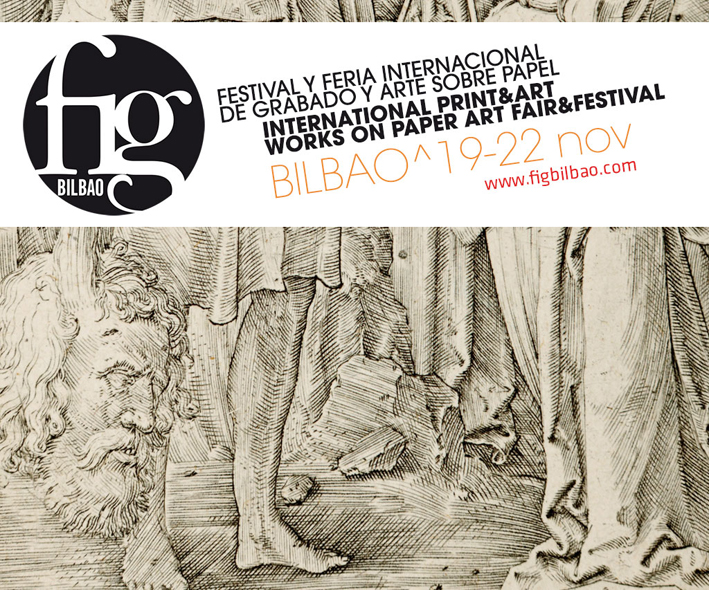
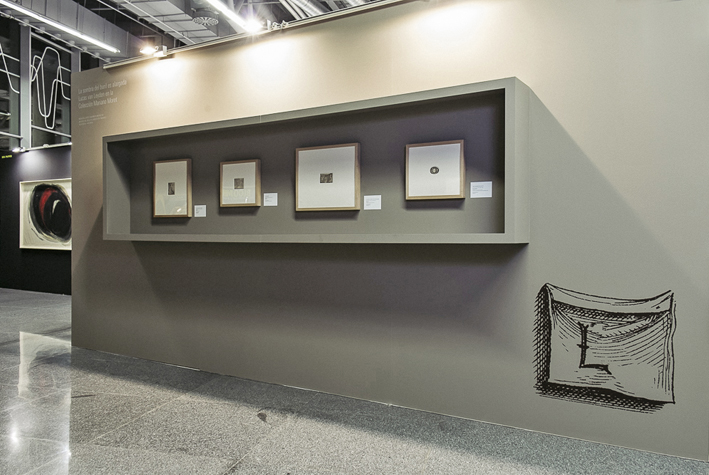
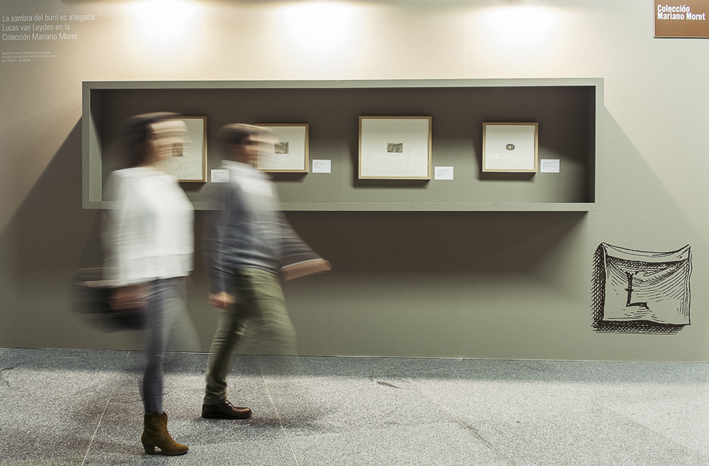
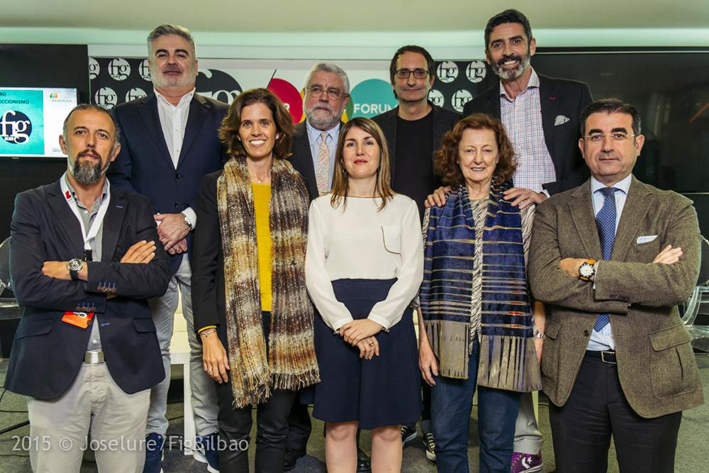
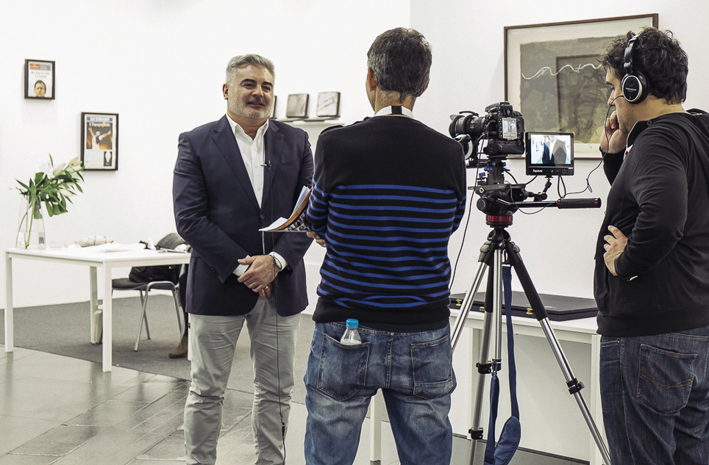
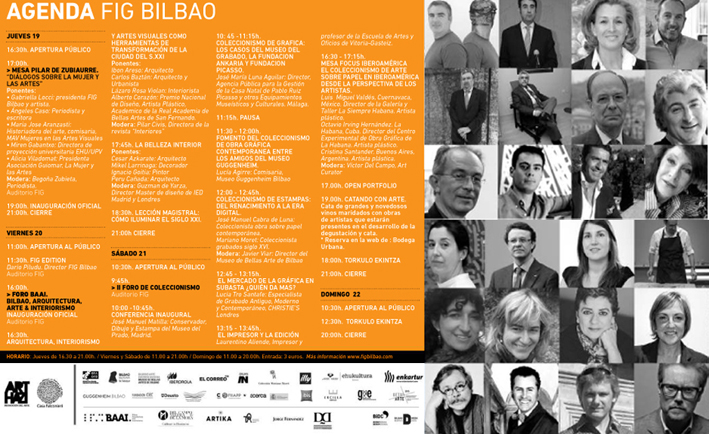 Photo Joselure/FIGBilbao
Photo Joselure/FIGBilbao__________________________________________________________________________________________________________ CURRENT EXHIBITION
The shadow of the burin is extended.Prints by Lucas Van Leyden from the Mariano Moret Collection. Bilbao Fine Arts Museum Bilbao Fine Arts Museum
On the occasion of the exhibition The shadow of the burin is extended. Prints by Lucas van Leyden from the Mariano Moret Collection, a catalogue has been published. This catalogue is the first monographic book published in Spanish language dedicated to Lucas van Leyden oeuvre. José Juan Pérez Preciado, Assistant curator of Flemish and Northern European Paintings at the Prado Museum, is the author of the text of the exhibition catalogue.
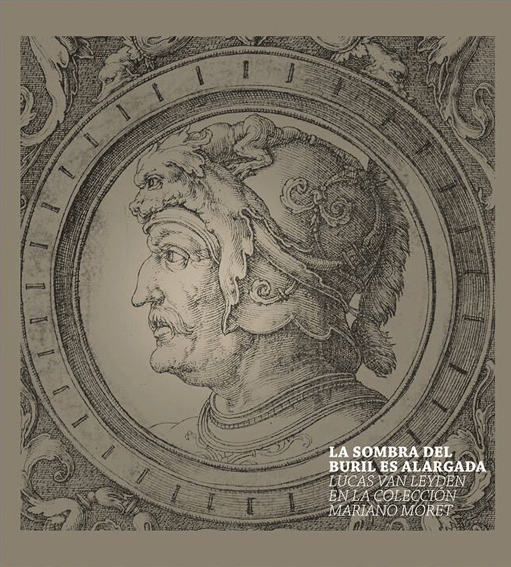
Author: José Juan Pérez Preciado ISBN: 978-84-608-2425-1 Language: Spanish Measures: 21 x 21 cm Binding: Paperback with flaps Number of pages: 216
_______________________________________________________________________
CURRENT EXHIBITION
The shadow of the burin is extended. Prints by Lucas Van Leyden from the Mariano Moret Collection. Bilbao Fine Arts Museum
20/10/2015
Exhibition inaugural event. The shadow of the burin is extended. Prints by Lucas van Leyden from the Mariano Moret Collection.
The exhibition was opened by the Bilbao Mayor, Juan María Aburto, in the presence of the Bizkaia General Deputy, Unai Rementeria, the Bilbao Culture Councilor, Nekane Alonso, the Bilbao Fine Arts Museum Director, Javier Viar, the lender, Mariano Moret, the curator, Víctor del Campo, the President of FIG Bilbao, Iñaki Alonso and the Honorary Consul of the Netherlands, Antonio Bereincua in front of a large audience.
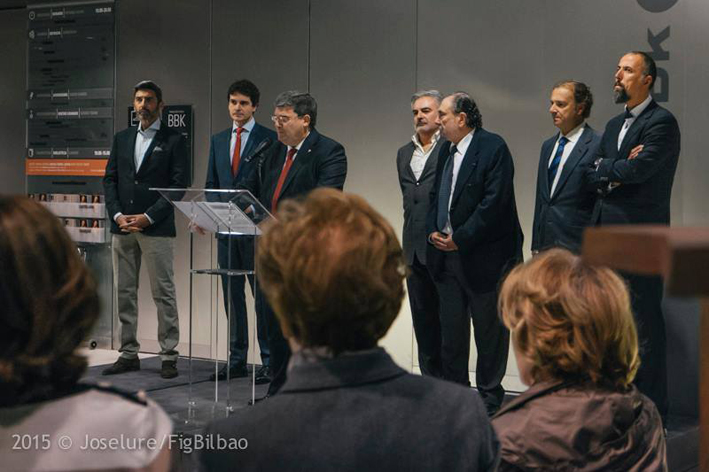
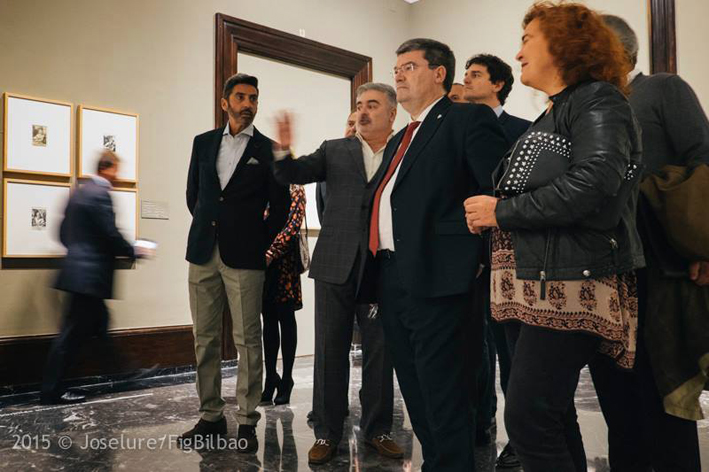
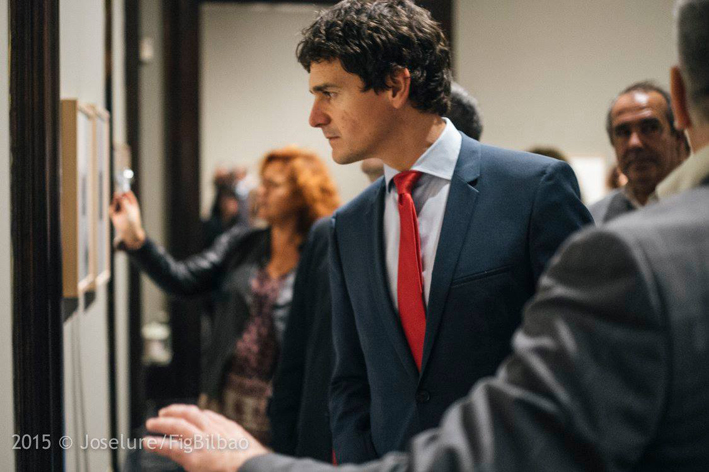
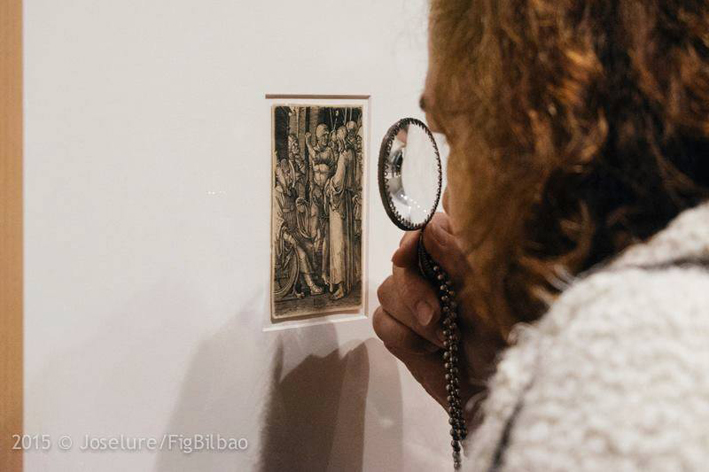
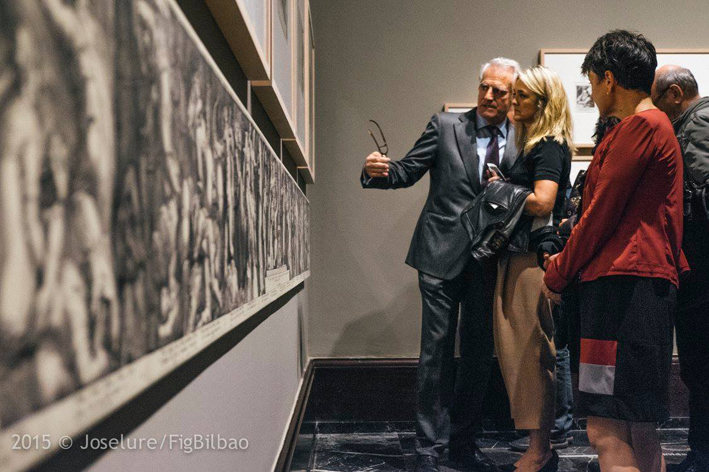 Photo Joselure/FIGBilbao
Photo Joselure/FIGBilbao__________________________________________________________________________________________________________ CURRENT EXHIBITION
The shadow of the burin is extended. Prints by Lucas Van Leyden from the Mariano Moret Collection Bilbao Fine Arts Museum
19/10/2015
Conference and private tour of the exhibition for the Friends of the Bilbao Fine Arts Museum
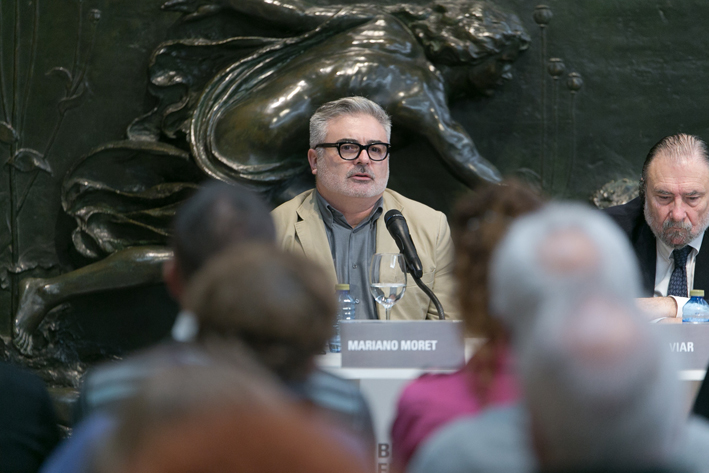
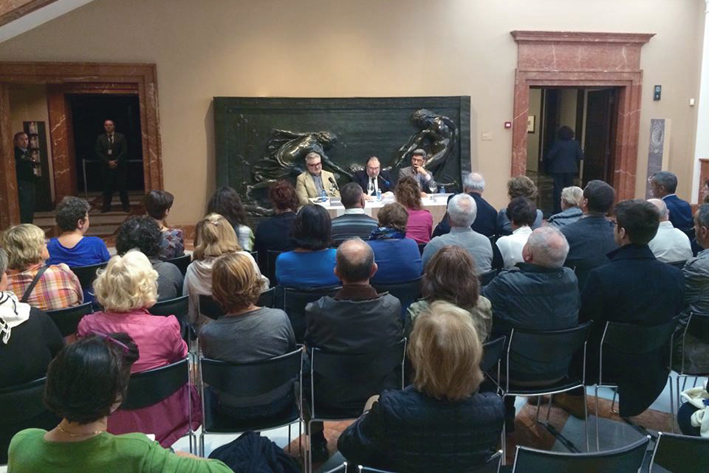
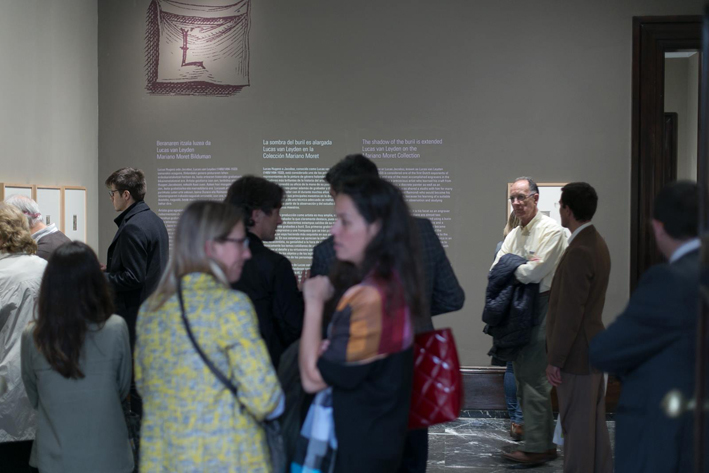
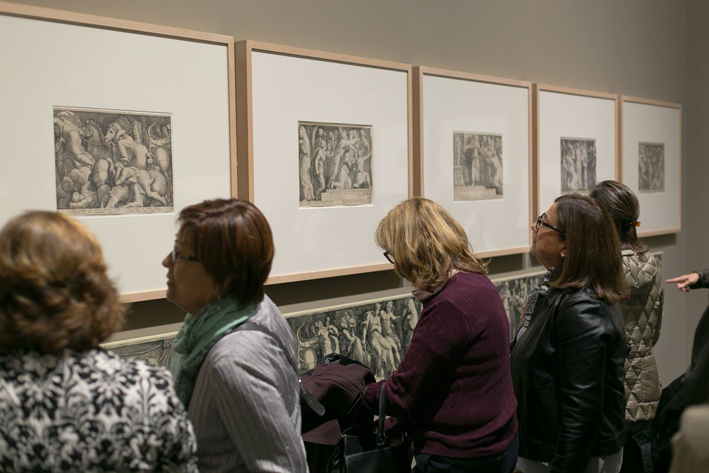
_______________________________________________________________________________
CURRENT EXHIBITION
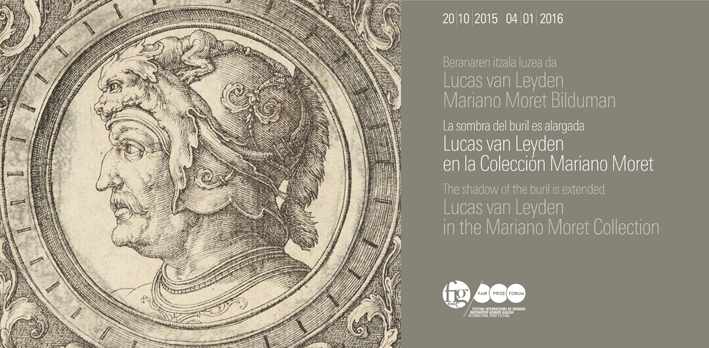
The shadow of the burin is extended. Prints by Lucas Van Leyden from the Mariano Moret Collection
69 prints from the Mariano Moret Collection and another one print from the Museum collection are on display at the first monographic exhibition on Lucas van Leyden held in Spain.
Museo de Bellas Artes de Bilbao Rooms 13, 14 and 15
October 20, 2015 to January 4, 2016 Organiser and sponsor: FIG Bilbao
The exhibition focuses on the first of the Dutch engravers, Lucas Huyghzoon, better known as Lucas van Leyden (Leyden, c. 1489/1494-1533). The exhibition includes 70 prints made by The Durch master and other major artists who, in the 16th and 17th centuries, were influenced by him. All works featured come from the valuable Mariano Moret Collection, except one by Lucas van Leyden in the Museum's own collection of works on paper. Of the 70 prints, 26 are Lucas van Leyden originals, while the others (44) are by artists who either copied the master's prints or created original works themselves. On the roster of artists are Hendrick Goltzius, Jan Saenredam, Jan Muller, Nicolaes de Bruyn and Pierre Firens.
Lucas van Leyden was born in Leyden (Low Countries) in 1489 or 1494 (the available sources do not agree) and died in 1533. He started young, painting his first picture early on, before moving on, shortly afterwards, to the engraving. Despite his relatively short life, his artistic output was large; where he really excelled was as an engraver, as we know of nearly 200 prints on religious and allegorical themes by him. He apparently learnt the idiom and technique of engraving by first producing small works, in which at times his skill clearly fails him, particularly in anatomical descriptions and the use of space. Even so, those early prints had an expressive force and spontaneity that was gradually attenuated throughout his career, as his technique became increasingly accomplished.
Prints selected for this exhibition reveal Lucas van Leyden's elegant line, the stunning finesse of his work with the burin, his love of detail and his virtuosity in capturing the qualities and textures of objects and fabrics, characteristics common to artists of the northern schools. His style is noted in particular for the originality and complexity of the compositions, the subtlety of the almost transparent silvered tones, the delicacy of his elegant figures, the richness of the description of the robes andvestments the characters wear, and many other details besides.
In the engravings of Lucas van Leyden the mystery and elegance of late Gothic combine with the developments ushered in by the Renaissance. An admirer of Albrecht Dürer, van Leyden shared with him an enthusiasm for the force of expression of the engraving, although the Dutchman tried to ration Dürer's influence in his work. He also mixed the naturalism and thoroughness of the Flemish school with the introduction of perspective and landscape, developments proper to the new Italian style. And, finally, the northern tradition of genre scenes featuring popular types with figures placed in contrapposto, usually reserved for heroes and gods, and heir to the sculpture of classical Antiquity. Lucas van Leyden's work surprised and delighted contemporary and later artists alike, who sought to make these features their own and pay tribute by trying to emulate them or copying them in their own engravings. This was certainly the case with Jan Muller and Hendrick Goltzius and their follower Jan Saenredam, as is clear to see in their prints.
On the occasion of the exhibition The shadow of the burin is extended. Prints by Lucas van Leyden from the Mariano Moret Collection, a catalogue has been published. José Juan Pérez Preciado, Assistant curator of Flemish and Northern European Paintings at the Prado Museum, is the author of the text of the exhibition catalogue. This catalogue is the first monographic book published in Spanish language dedicated to Lucas van Leyden oeuvre.
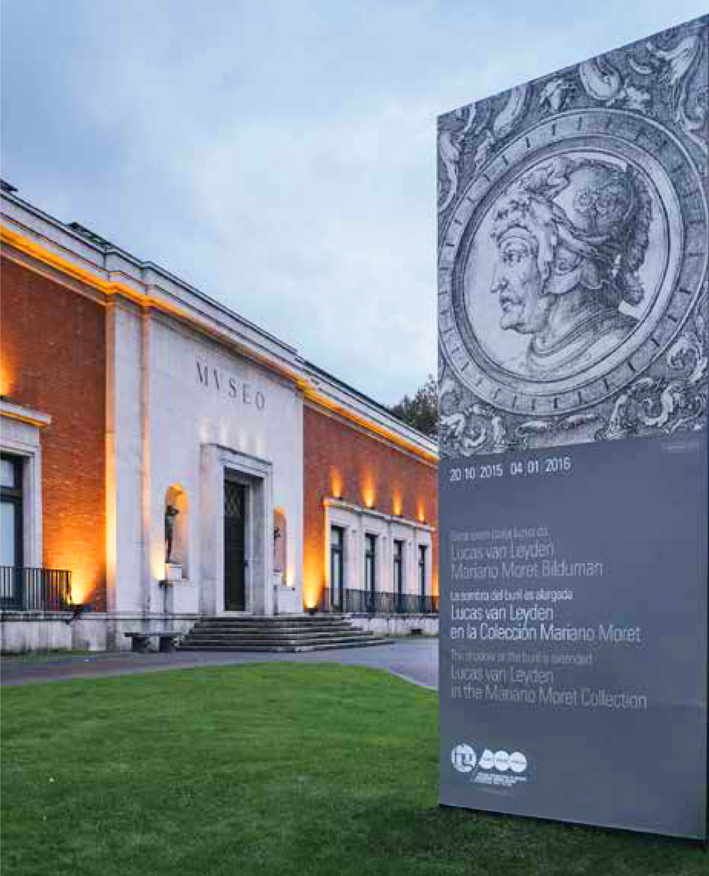
_______________________________________________________________________________
INTAGLIO PRINTMAKING IN DIDEROT & D´ALEMBERT ENCYCLOPÉDIE
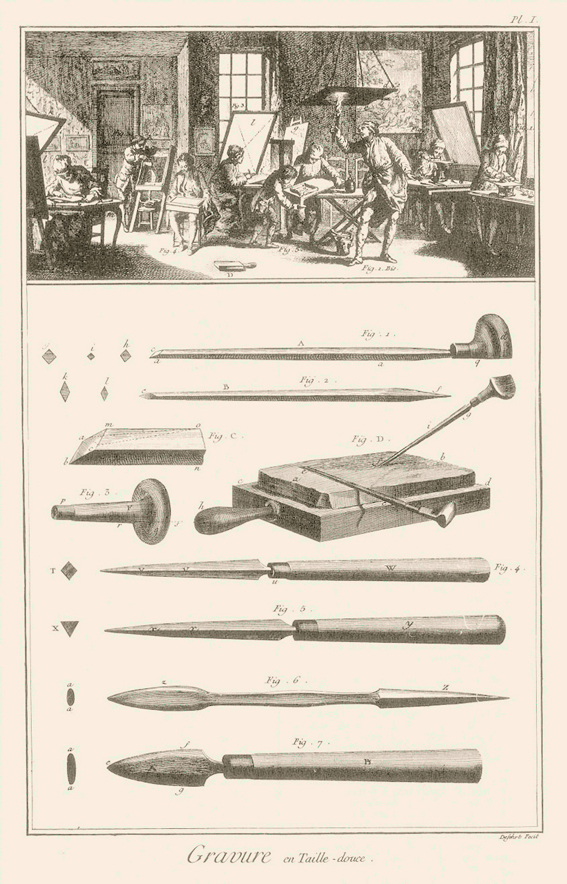 Gravure en taille-douce. Plate I
Gravure en taille-douce. Plate I 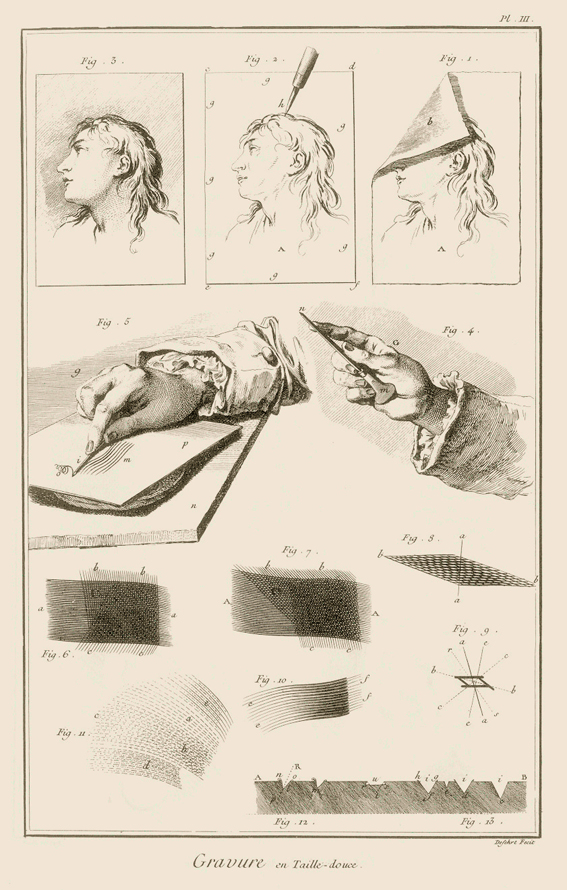 Gravure en taille-douce. Plate III
Gravure en taille-douce. Plate III 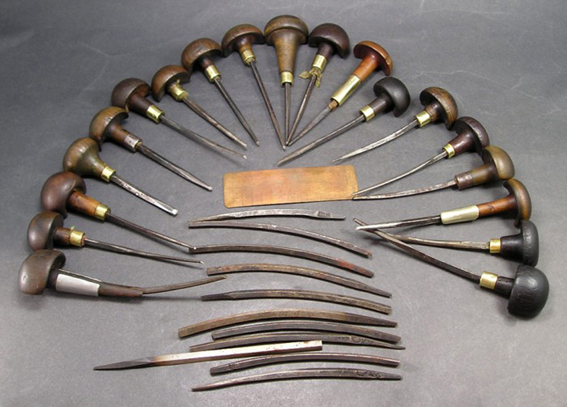 Set of hand graver tools
Set of hand graver tools 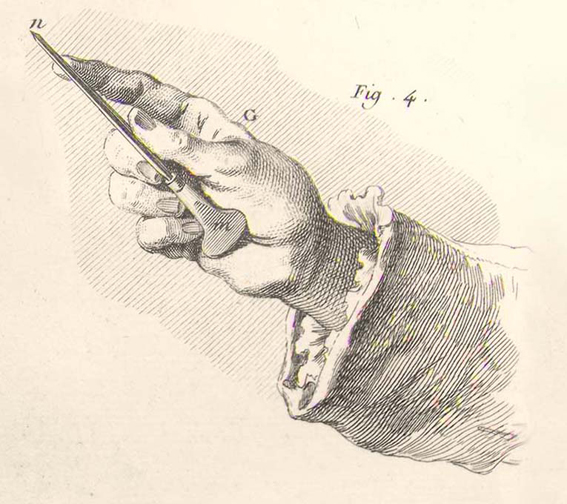 Gravure en taille-douce. Plate III, Figure 4
Gravure en taille-douce. Plate III, Figure 4 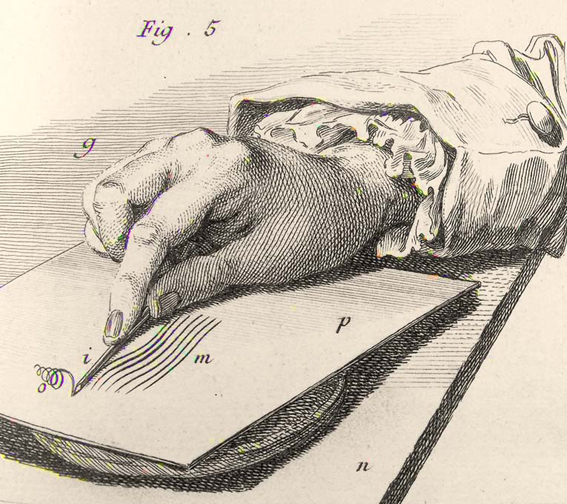 Gravure en taille-douce. Plate III, Figure 5
Gravure en taille-douce. Plate III, Figure 5 _______________________________________________________________________________
RECENT ACQUISITIONS JULY 2015
 Monogrammist IB. Twelve gladiators fighting. Engraving, c.1523-1530. Colección Mariano Moret
Monogrammist IB. Twelve gladiators fighting. Engraving, c.1523-1530. Colección Mariano Moret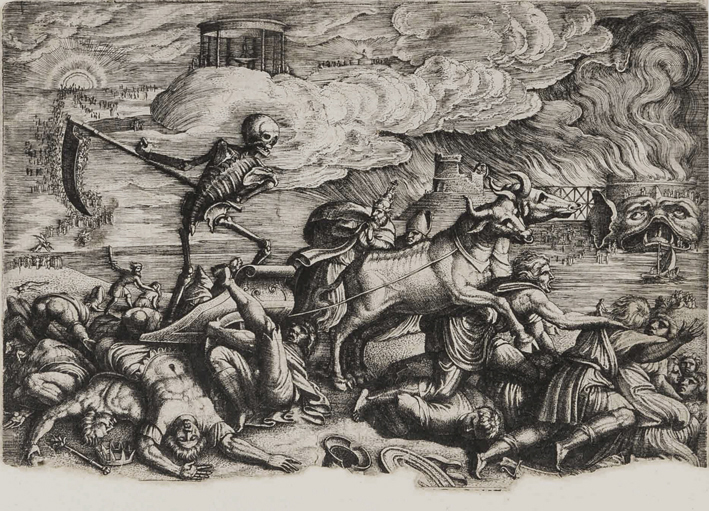 Georg Pencz. The triumph of death. Engraving, c.1539. Colección Mariano Moret
Georg Pencz. The triumph of death. Engraving, c.1539. Colección Mariano Moret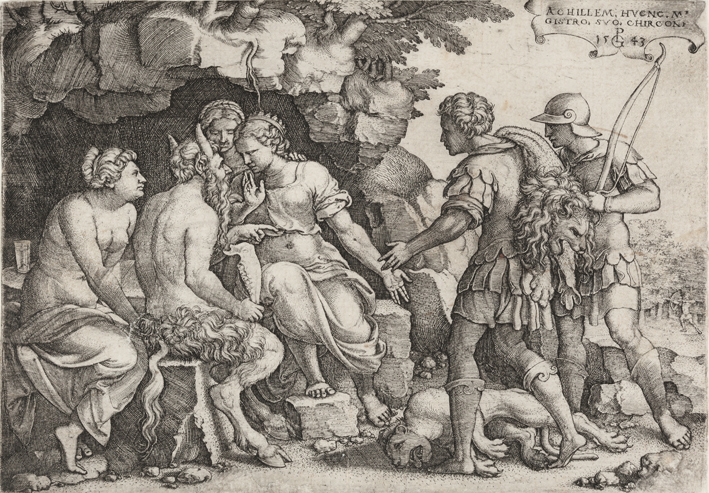 Georg Pencz. Thetis y Cheiron. Engraving, 1543. Colección Mariano Moret
Georg Pencz. Thetis y Cheiron. Engraving, 1543. Colección Mariano Moret_______________________________________________________________________________
THEME & VARIATIONS: THE NUDE STANDARD BEARER
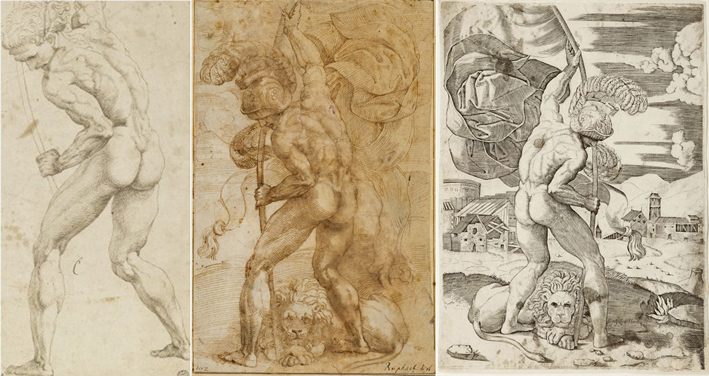 After Raphael Sanzio. Naked man standing, holding a flag pole. Musée du Louvre
After Raphael Sanzio. Naked man standing, holding a flag pole. Musée du LouvreWorkshop of Raphael Sanzio. A nude standard-bearer. Musée des Beaux-Arts, Rennes
Marcantonio Raimondi. A nude standard-bearer. Colección Mariano Moret
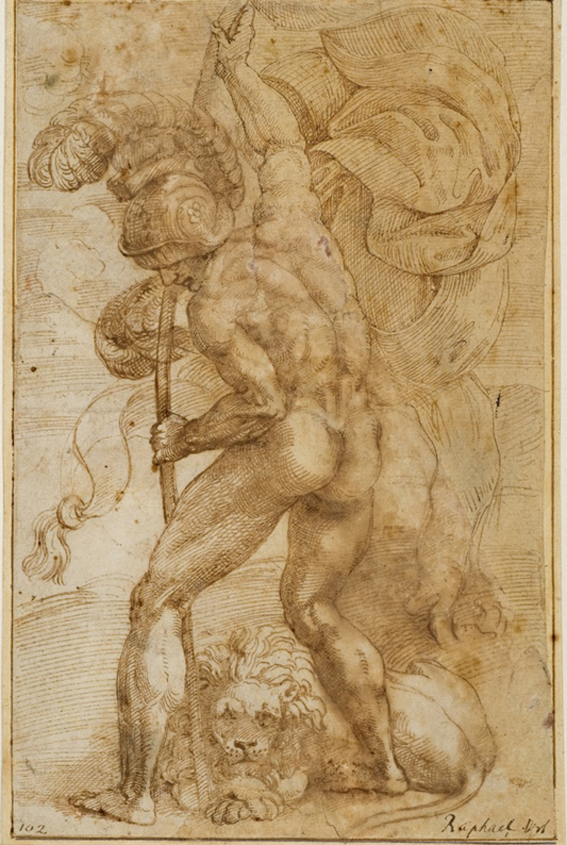 Workshop of Raphael Sanzio. A nude standard-bearer. Pen and brown ink, c.1516. Musée des Beaux-Arts, Rennes
Workshop of Raphael Sanzio. A nude standard-bearer. Pen and brown ink, c.1516. Musée des Beaux-Arts, Rennes 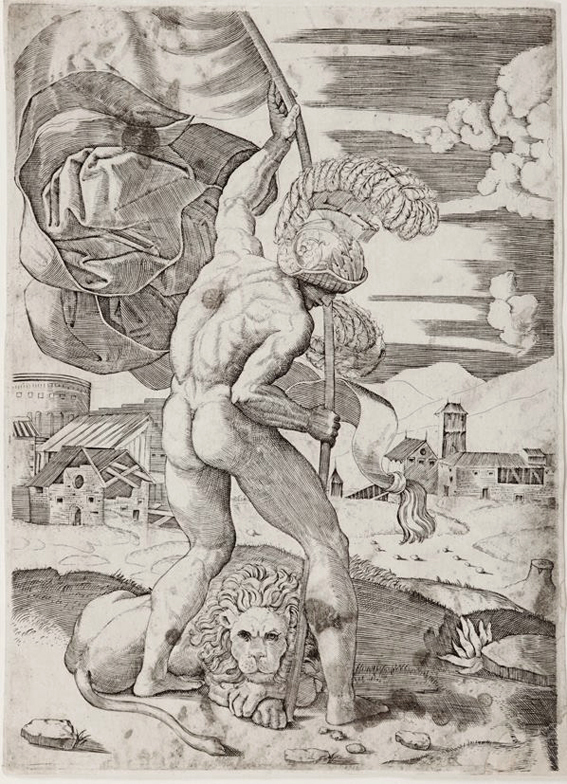 Marcantonio Raimondi. The nude standard bearer. Engraving, c.1515-1520. Colección Mariano Moret
Marcantonio Raimondi. The nude standard bearer. Engraving, c.1515-1520. Colección Mariano Moret______________________________________________________________________________
RECENT ACQUISITIONS JULY 2015
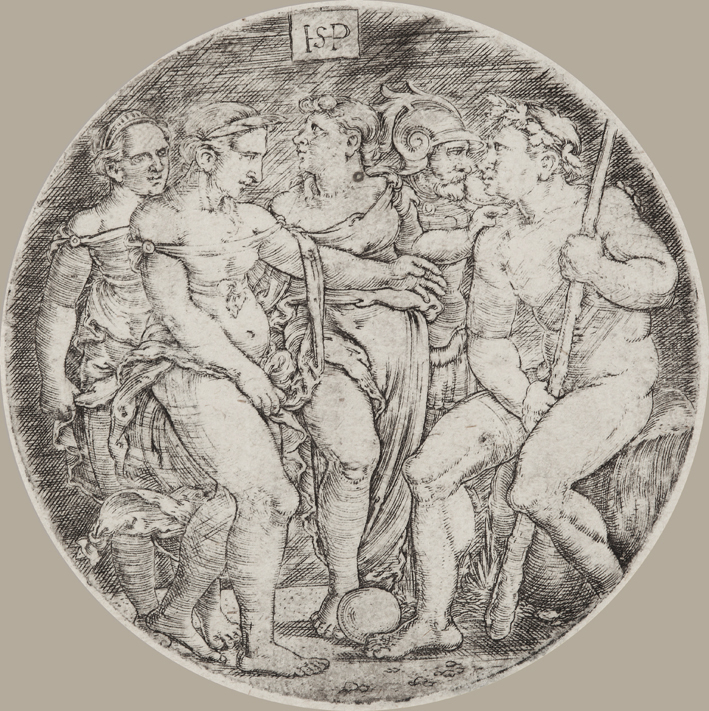 Hans Sebald Beham. The judgement of Paris. Engraving, c.1518-1530. Colección Mariano Moret
Hans Sebald Beham. The judgement of Paris. Engraving, c.1518-1530. Colección Mariano Moret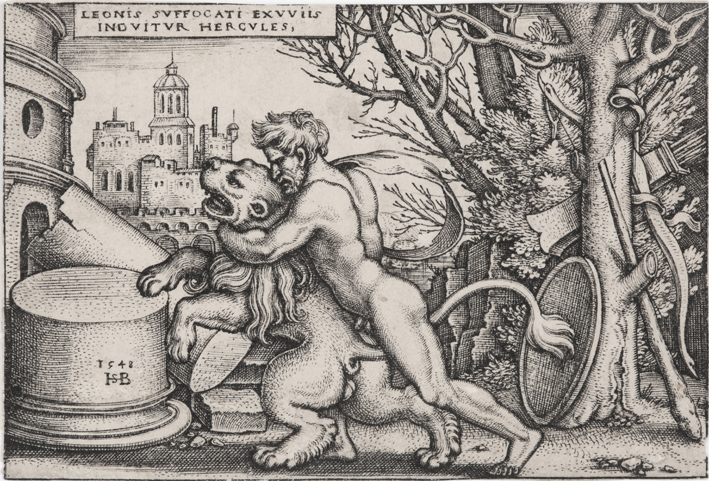 Hans Sebald Beham. Hercules killing the Nemean lion. Engraving, 1548. Colección Mariano Moret
Hans Sebald Beham. Hercules killing the Nemean lion. Engraving, 1548. Colección Mariano Moret______________________________________________________________________________
THEME & VARIATIONS: PUNISHMENT OF NIOBE
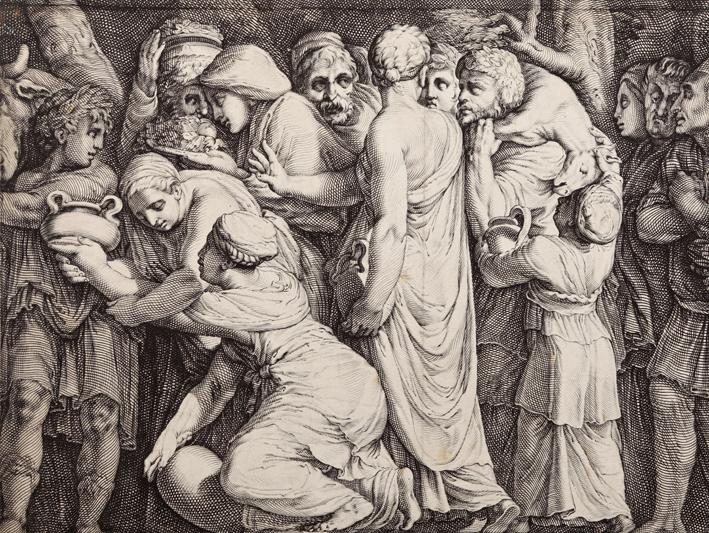 Jan Saenredam. Punishment of Niobe (detail). Engraving, 1594. Colección Mariano Moret
Jan Saenredam. Punishment of Niobe (detail). Engraving, 1594. Colección Mariano Moret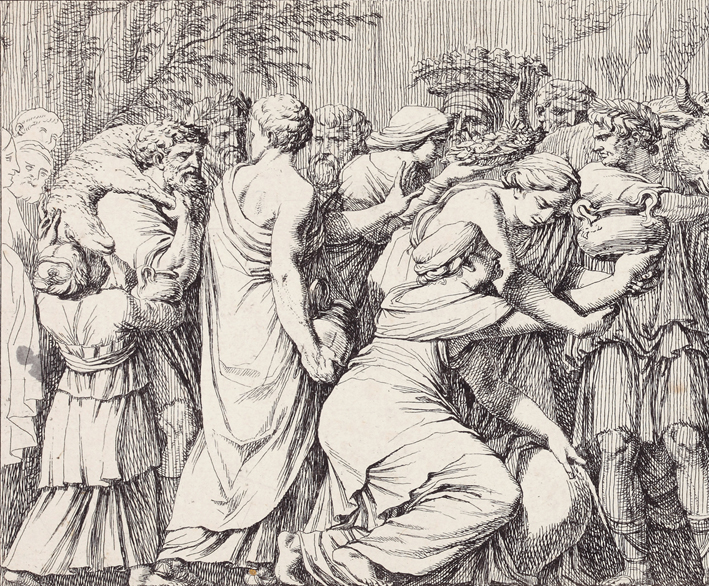 Giovanni Battista Galestruzzi. Punishment of Niobe (detail). Etching, 1656. Colección Mariano Moret
Giovanni Battista Galestruzzi. Punishment of Niobe (detail). Etching, 1656. Colección Mariano Moret______________________________________________________________________________
THEME & VARIATIONS: THE VIRGIN WITH CHILD AND ST ANNA
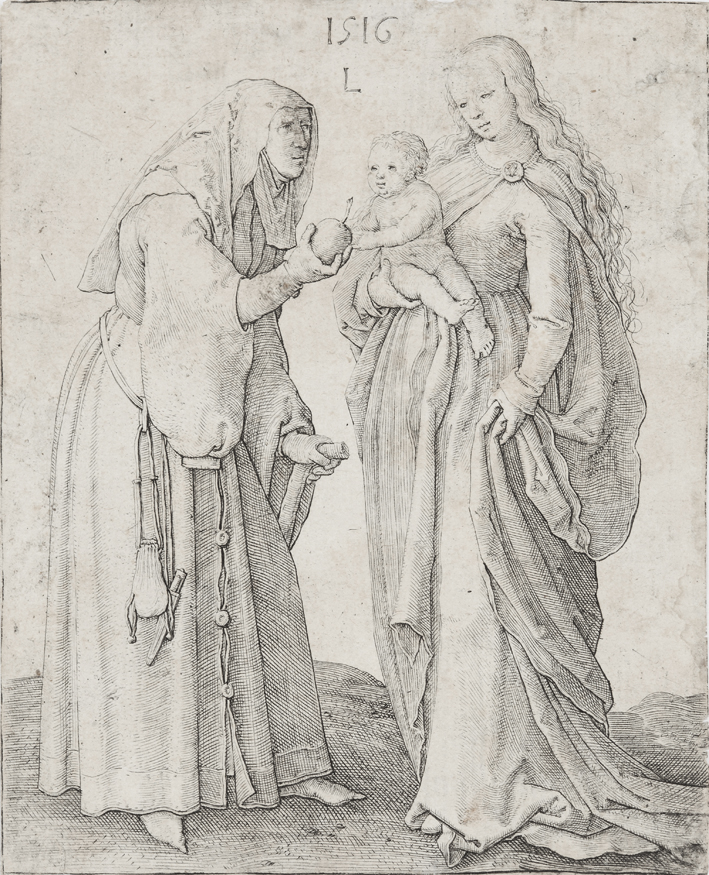 Lucas van Leyden. The Virgin with Child and St Anna. Engraving, 1516.Colección Mariano Moret
Lucas van Leyden. The Virgin with Child and St Anna. Engraving, 1516.Colección Mariano Moret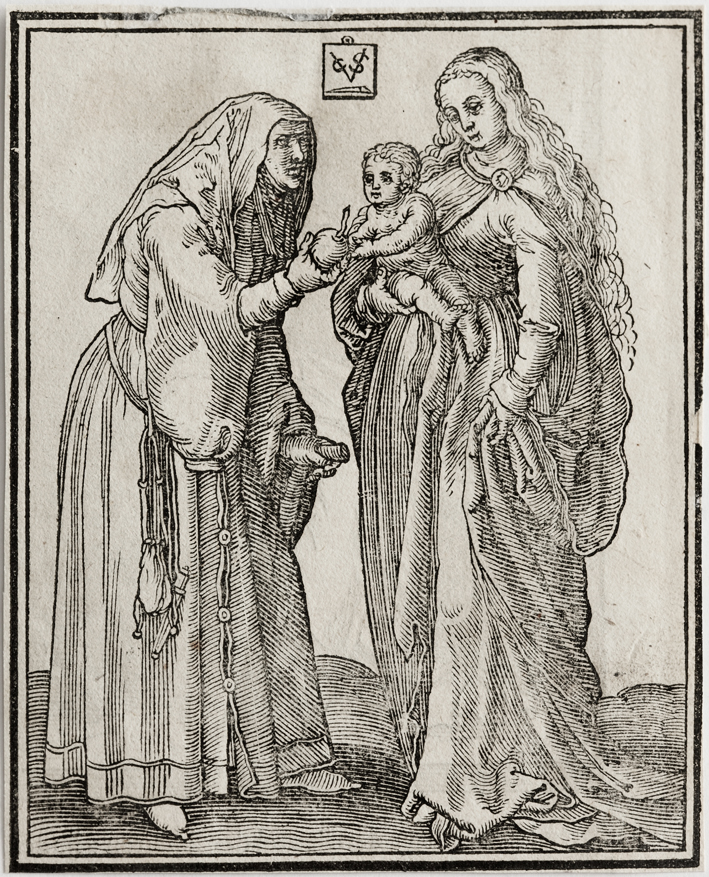 Christoffel van Sichem. The Virgin with Child and St Anna. Woodcut, 1645.Colección Mariano Moret
Christoffel van Sichem. The Virgin with Child and St Anna. Woodcut, 1645.Colección Mariano Moret_______________________________________________________________________________
OUR CATALOG GRABADOS MAESTROS AT THE LIBRARY OF THE FONDATION CUSTODIA IN PARIS:
Link to Grabados Maestros catalog
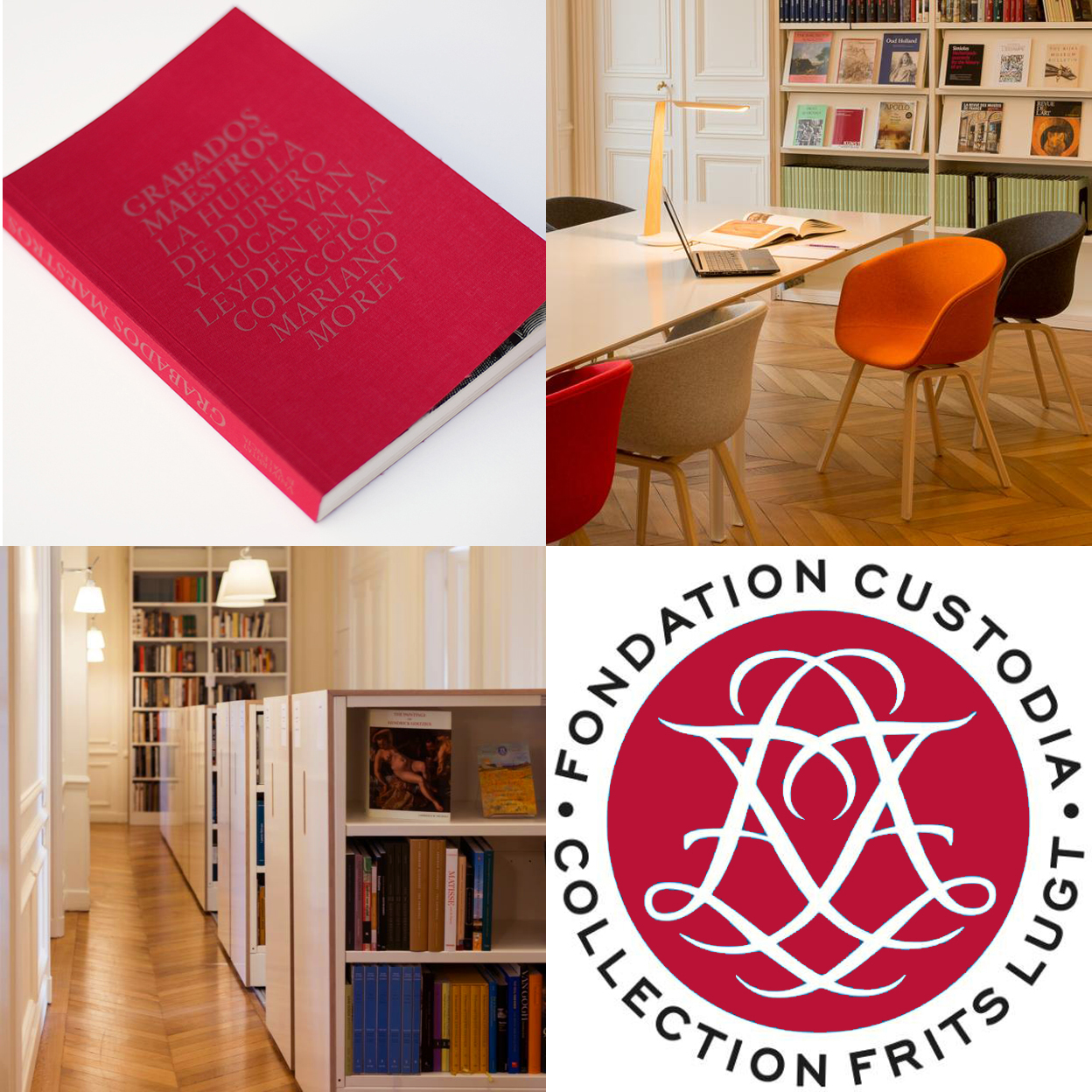
_______________________________________________________________________________
THEME & VARIATIONS: MARCUS CURTIUS
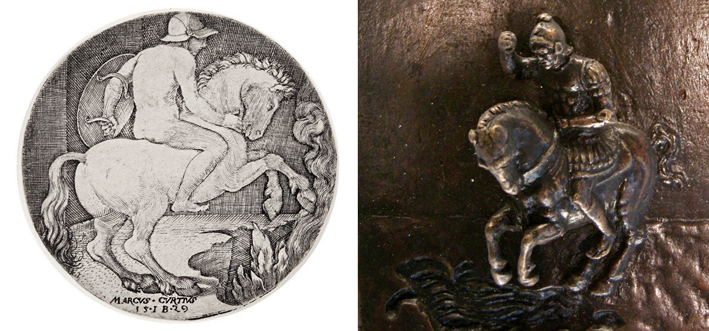 Monogrammist IB. Marcus Curtius. Engraving, 1529. Colección Mariano Moret
Monogrammist IB. Marcus Curtius. Engraving, 1529. Colección Mariano Moret Andrea Briosco, called Riccio. The Death of Marcus Curtius. Bronze. Sotheby´s
_______________________________________________________________________________
RECENT ACQUISITIONS JANUARY 2015
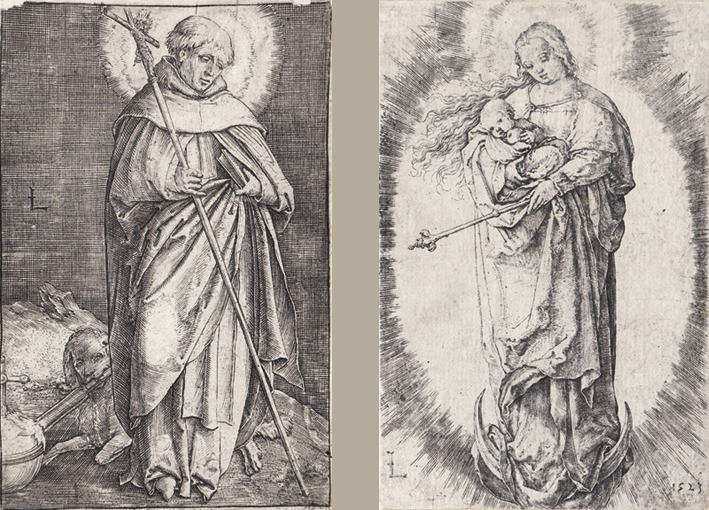 Lucas van Leyden. St Dominic. Engraving, c.1514. Colección Mariano Moret
Lucas van Leyden. St Dominic. Engraving, c.1514. Colección Mariano Moret LÑucas van Leyden. The Virgin with Child on the Crescent. Engraving, 1523. Colección Mariano Moret
_______________________________________________________________________________
THEME & VARIATIONS: JUDITH AND HOLOFERNES
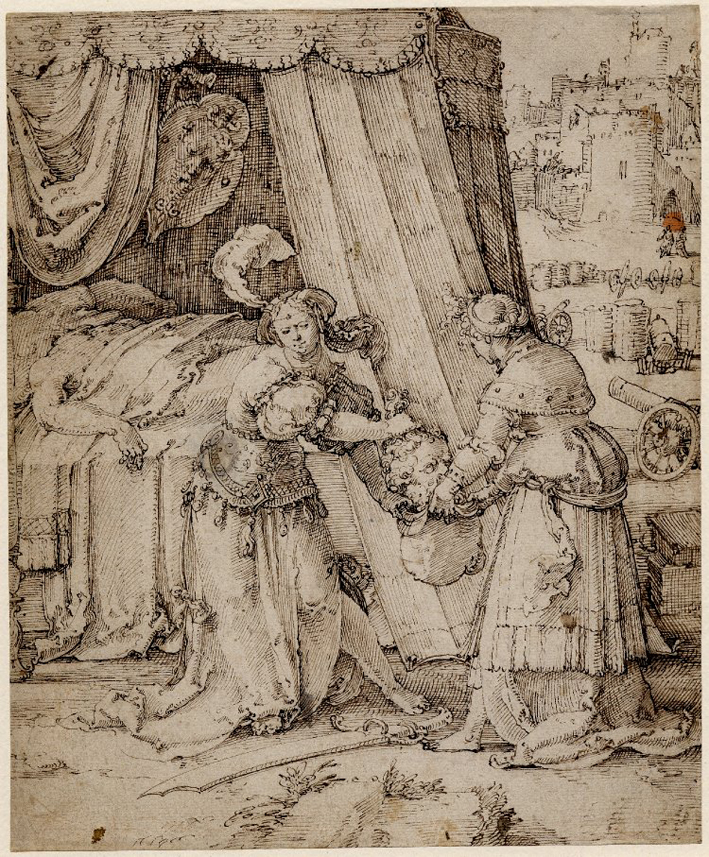 Lucas van Leyden. Judith and Holofernes. Pen and brown ink, c.1525. British Museum
Lucas van Leyden. Judith and Holofernes. Pen and brown ink, c.1525. British Museum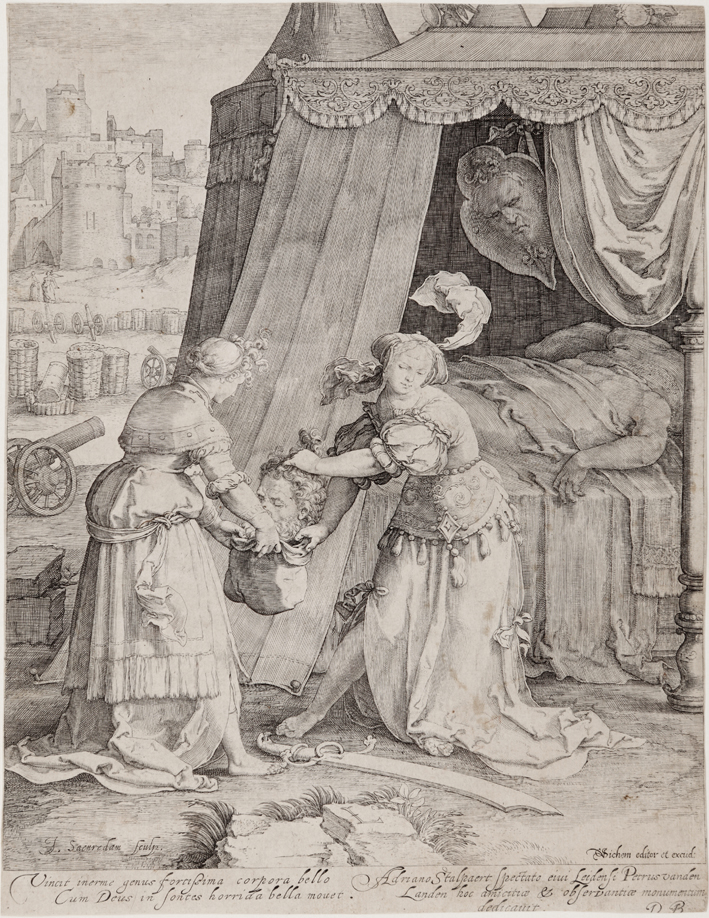 Jan Saenredam. Judith and Holofernes. Engraving, c.1600.Colección Mariano Moret
Jan Saenredam. Judith and Holofernes. Engraving, c.1600.Colección Mariano Moret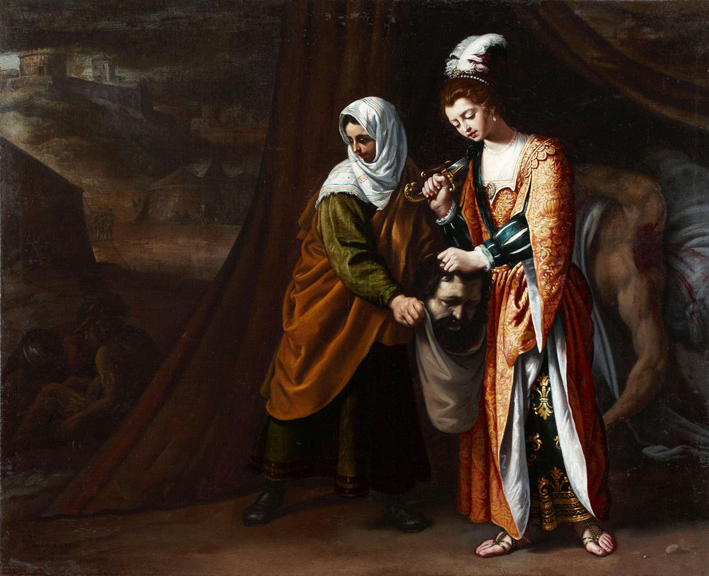 Pedro Nuñez del Valle. Judith and Holofernes. Oil on canvas, 1630. Galería Caylus
Pedro Nuñez del Valle. Judith and Holofernes. Oil on canvas, 1630. Galería Caylus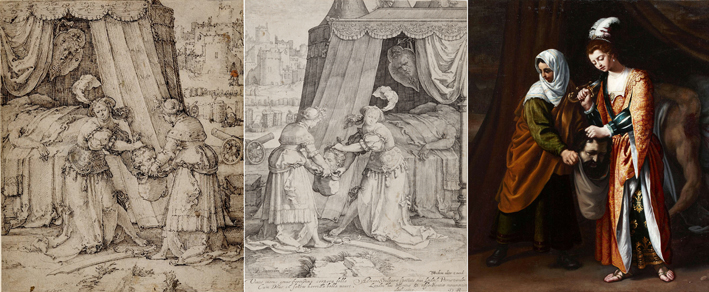 Lucas van Leyden. Judith and Holofernes. British Museum
Lucas van Leyden. Judith and Holofernes. British MuseumJan Saenredam. Judith and Holofernes. Colección Mariano Moret
Pedro Nuñez del Valle. Judith and Holofernes. Galería Caylus
_______________________________________________________________________________
THEME & VARIATIONS: JAEL AND SISERA
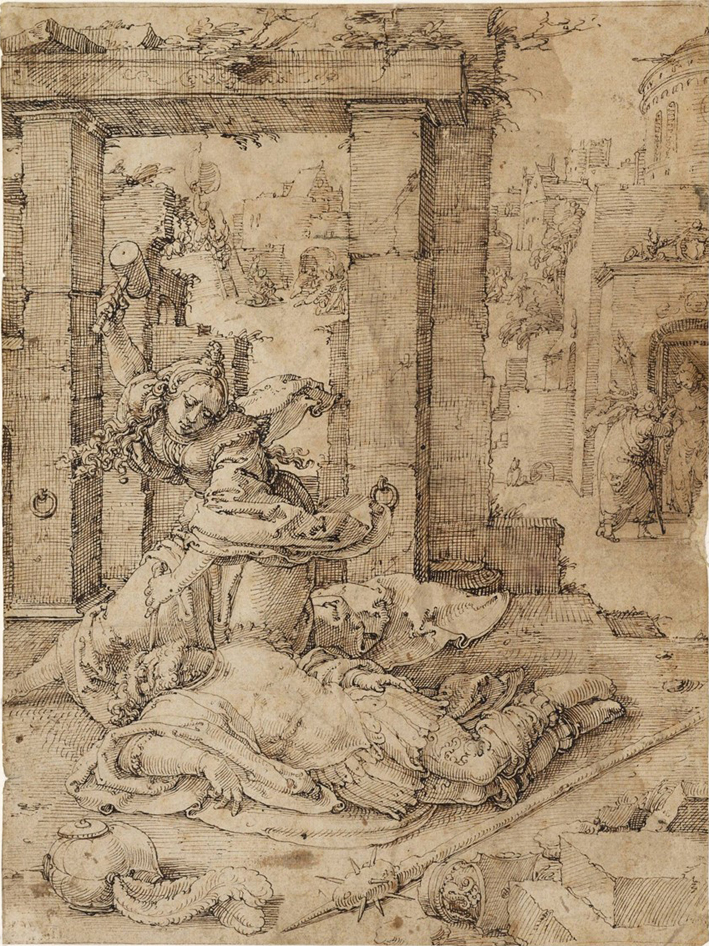 Lucas van Leyden. Jael Killing Sisera. Pen and brown ink, c.1525. Museum Boijmans Van Beuningen
Lucas van Leyden. Jael Killing Sisera. Pen and brown ink, c.1525. Museum Boijmans Van Beuningen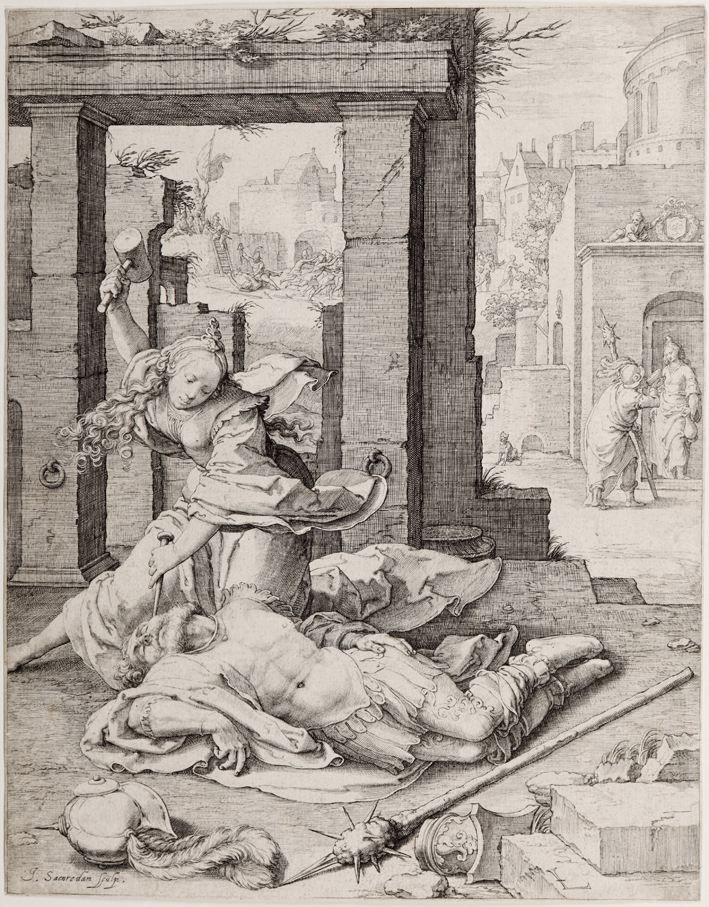 Jan Saenredam. Jael and Sisera. Engraving, c.1600. Colección Mariano Moret
Jan Saenredam. Jael and Sisera. Engraving, c.1600. Colección Mariano Moret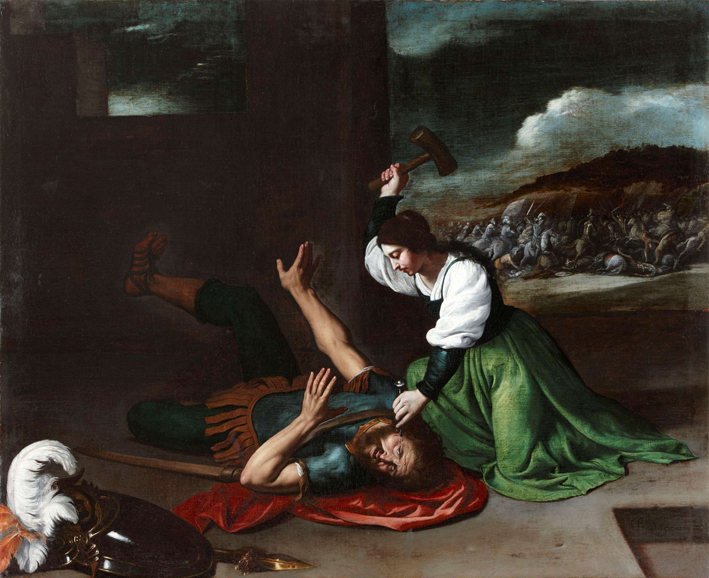 Pedro Nuñez del Valle. Jael and Sisera. Oil on canvas, 1630. Galería Caylus
Pedro Nuñez del Valle. Jael and Sisera. Oil on canvas, 1630. Galería Caylus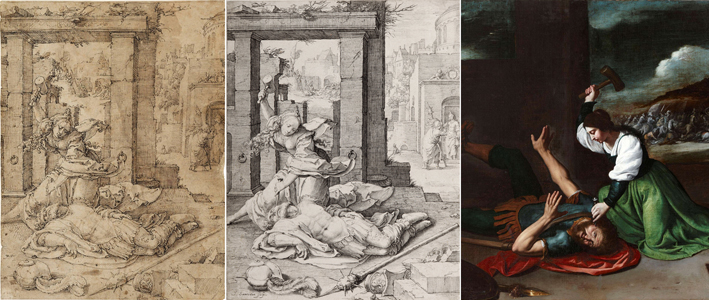 Lucas van Leyden. Jael and Sisera. Museum Boijmans Van Beuningen
Lucas van Leyden. Jael and Sisera. Museum Boijmans Van BeuningenJan Saenredam. Jael and Sisera. Colección Mariano Moret
Pedro Nuñez del Valle. Jael and Sisera. Galería Caylus
_______________________________________________________________________________
RECENT ACQUISITIONS JANUARY 2015
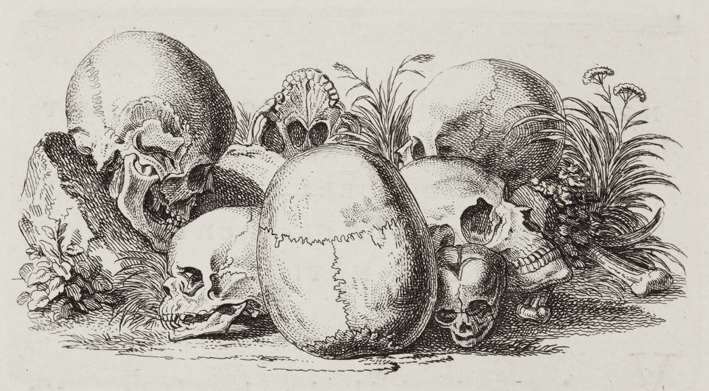 Johann Rudolph Schellenberg. Still life with skulls (Vanitas). Etching, c.1775. Colección Mariano Moret
Johann Rudolph Schellenberg. Still life with skulls (Vanitas). Etching, c.1775. Colección Mariano Moret_______________________________________________________________________________ THEME & VARIATIONS: GOLTZIUS´ HAND
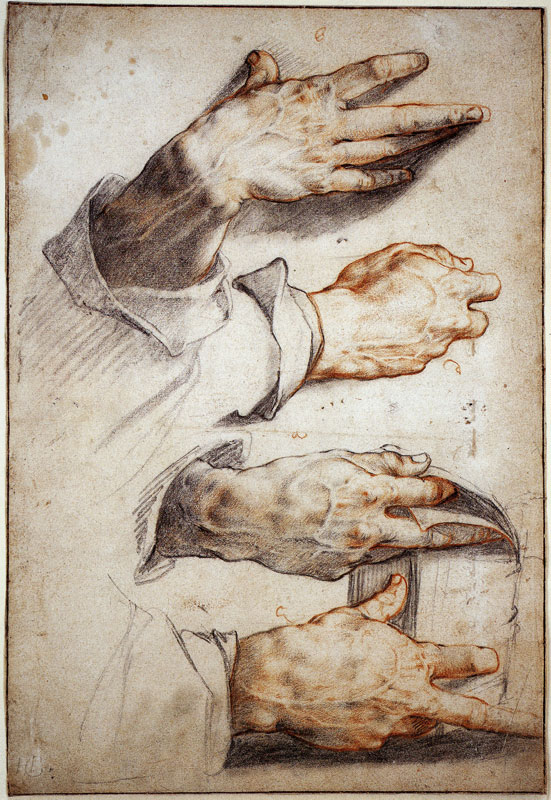 Hendrik Goltzius. Four Studies of Goltzius' Right Hand. Black and red chalk drawing, c.1588. Städelsches Kuntsinstitut
Hendrik Goltzius. Four Studies of Goltzius' Right Hand. Black and red chalk drawing, c.1588. Städelsches Kuntsinstitut 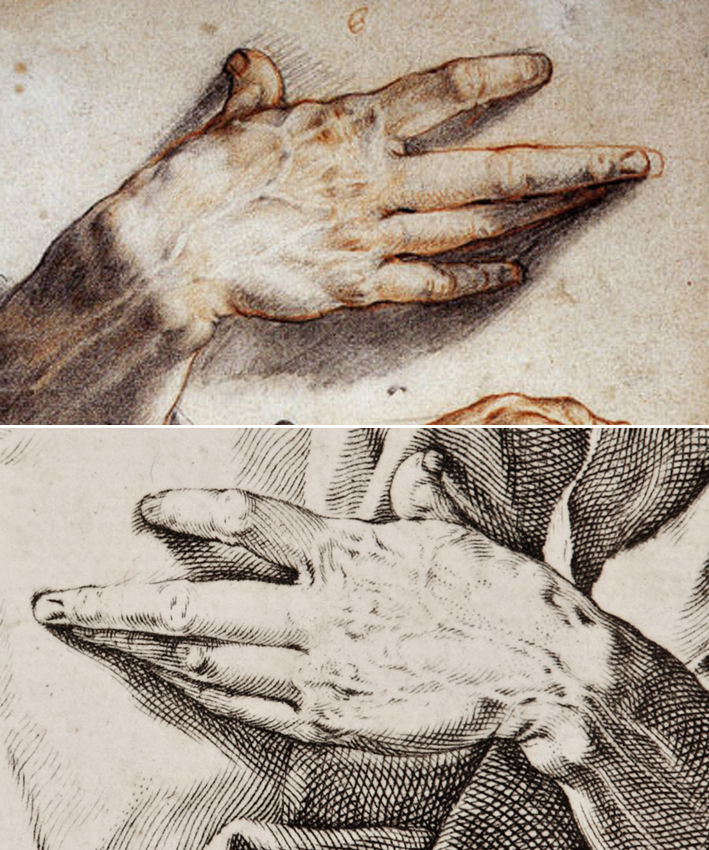 Hendrik Goltzius. Detail of Four Studies of Goltzius' Right Hand. Black and red chalk drawing, c.1588. Städelsches Kunsinstitut
Hendrik Goltzius. Detail of Four Studies of Goltzius' Right Hand. Black and red chalk drawing, c.1588. Städelsches KunsinstitutHendrik Goltzius. Detail of St Jude. Engraving, 1589. Colección Mariano Moret
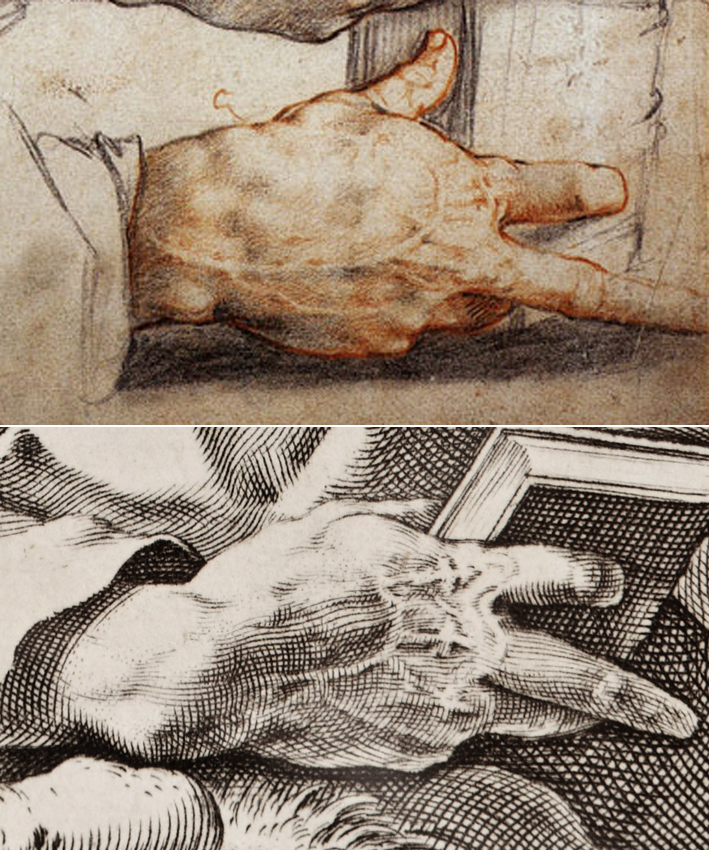 Hendrik Goltzius. Detail of Four Studies of Goltzius' Right Hand. Black and red chalk drawing, c.1588. Städelsches Kunsinstitut
Hendrik Goltzius. Detail of Four Studies of Goltzius' Right Hand. Black and red chalk drawing, c.1588. Städelsches KunsinstitutHendrik Goltzius. Detail of St Jude. Engraving, 1589. Colección Mariano Moret _______________________________________________________________________________________________________ RECENT ACQUISITIONS JANUARY 2015
Georg Pencz. Sextus Tarquinius raping Lucretia. Engraving, c.1546-1547. Colección Mariano Moret
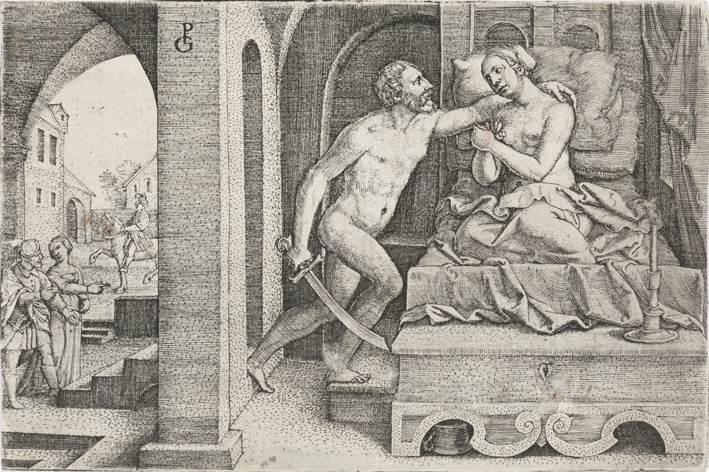
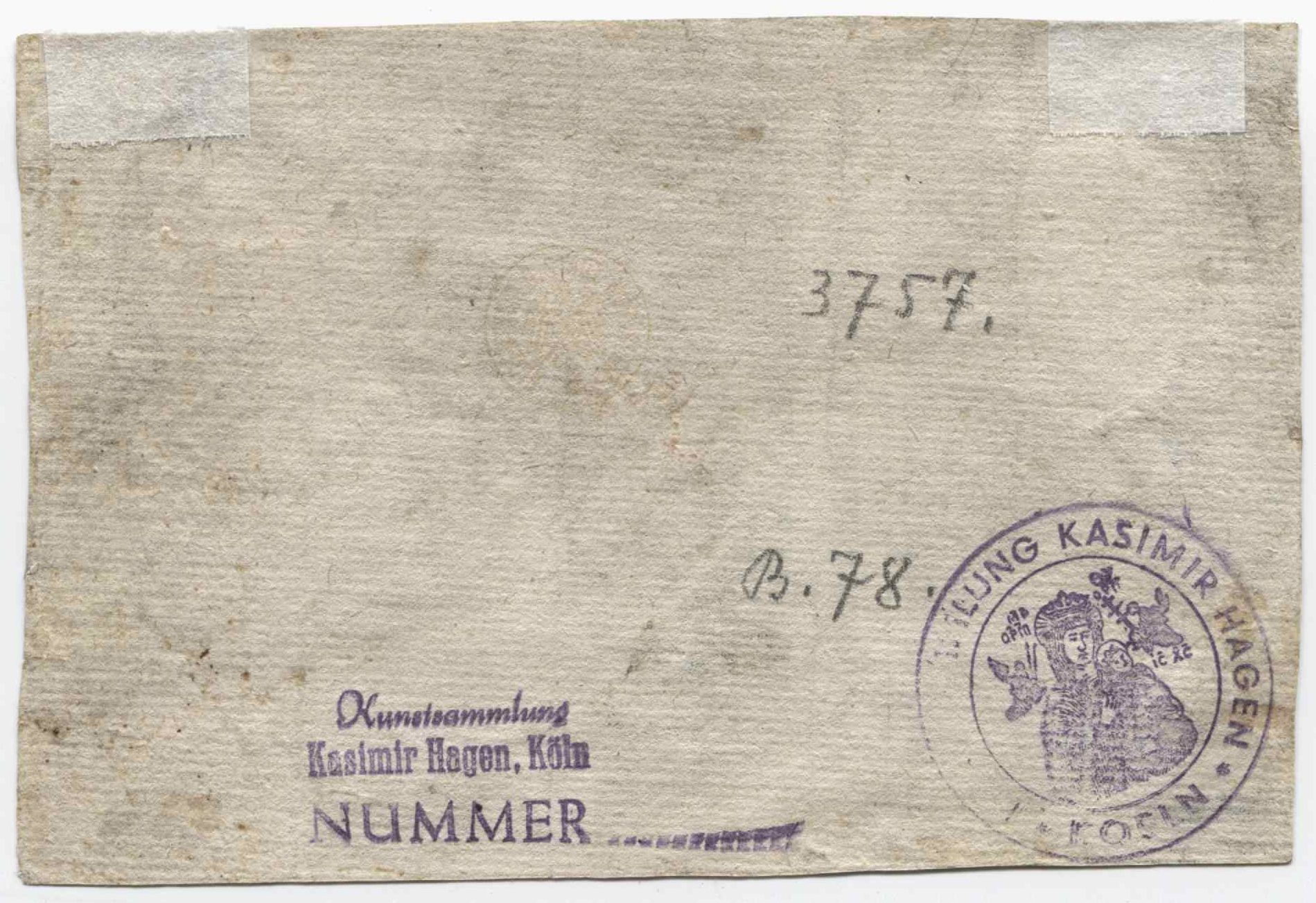 Kasimir Hagen collector´s mark on the reverse
Kasimir Hagen collector´s mark on the reverse_______________________________________________________________________________
THEME & VARIATIONS: HERCULES WRESTLING ANTAEUS
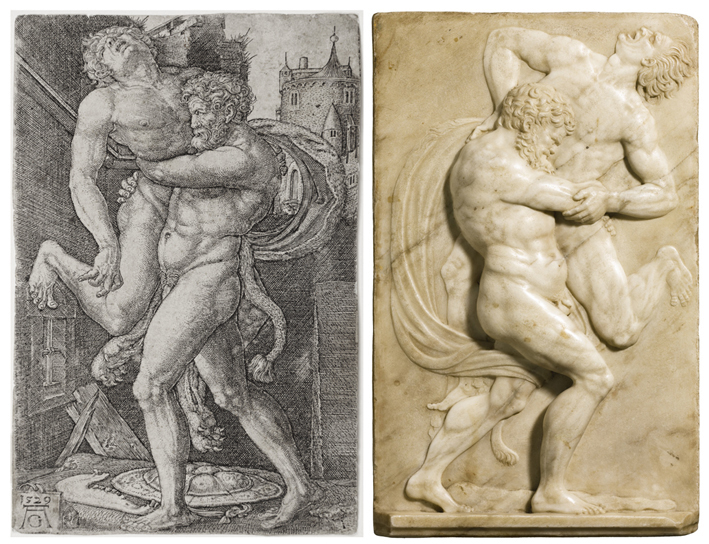 Heinrich Aldegrever. Hercules wrestling Antaeus. Engraving, 1529. Colección Mariano Moret
Heinrich Aldegrever. Hercules wrestling Antaeus. Engraving, 1529. Colección Mariano Moret Giovanni Bandini ?. Hercules wrestling Antaeus. White marble, c.1560-1590. Sotheby´s
_______________________________________________________________________________________________________
Notice. Image Use
The use of non-Mariano Moret Collection images as part of the Mariano Moret Collection catalogue adheres to the Code of Best Practices in Fair Use for the Visual Arts (College Art Association, February 2014). Efforts have been made to obtain images and permission from the owners / rights holders of these images, and they are used to support academic arguments about related works of art in the Mariano Moret Collection. The Mariano Moret Collection catalogue is for educational use and is available free-of-charge to anyone. For more information on the Code of Best Practices in Fair Use for the Visual Arts, please see College Art Association’s website: http://www.collegeart.org/fair-use/.
